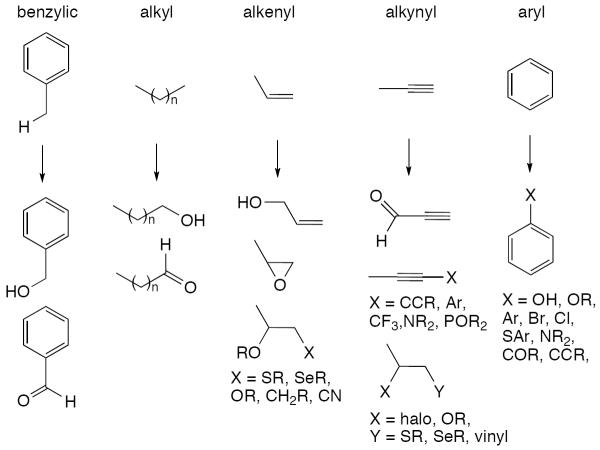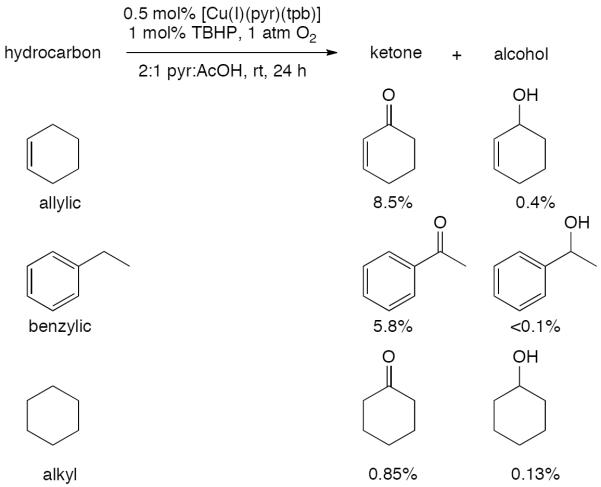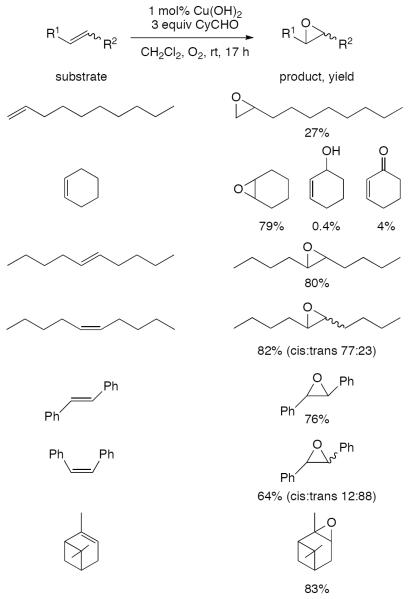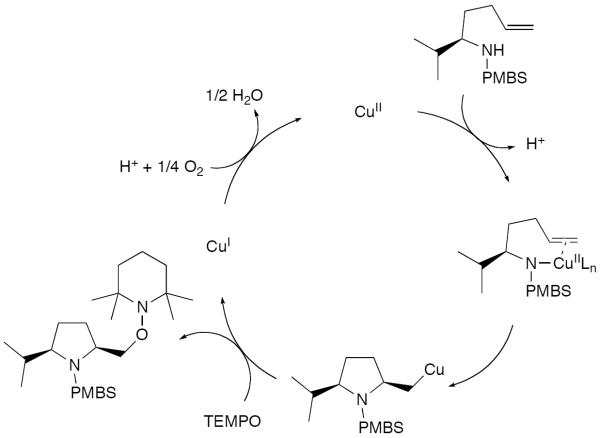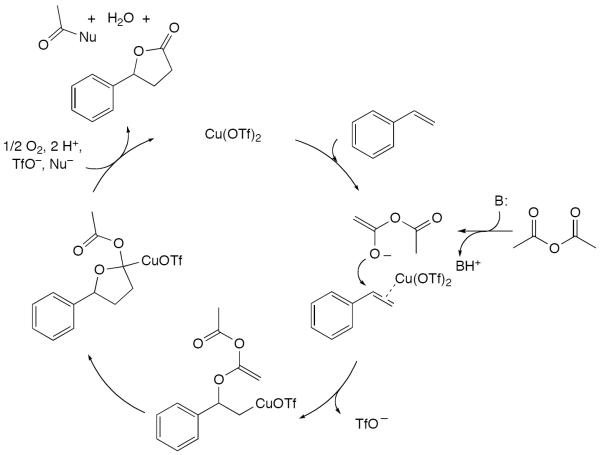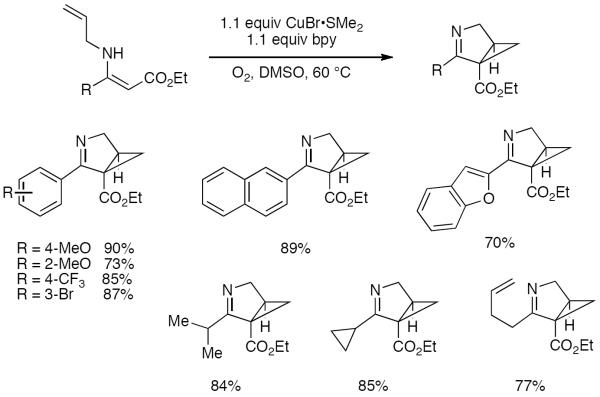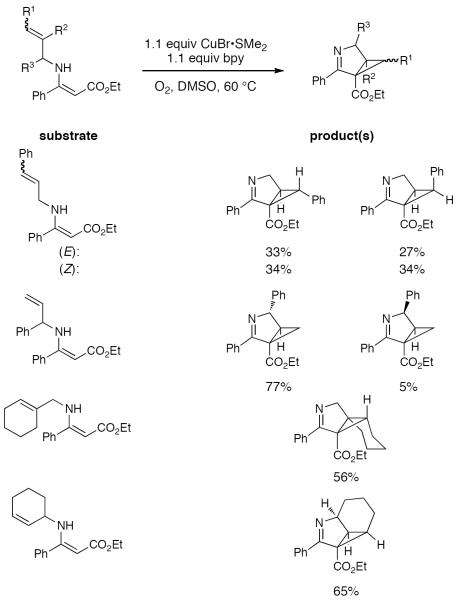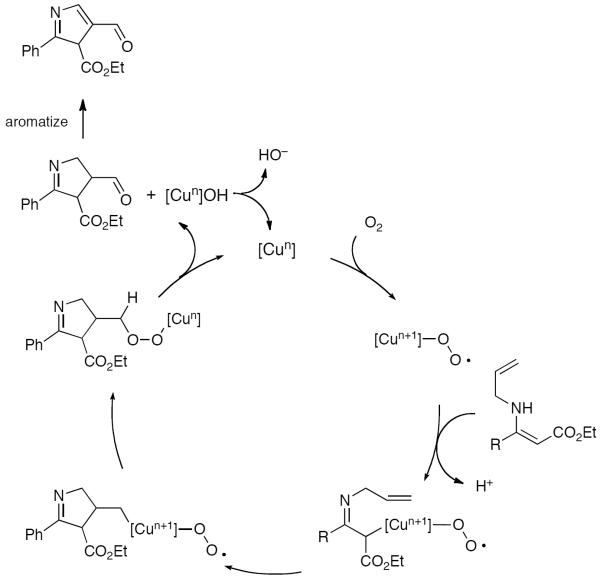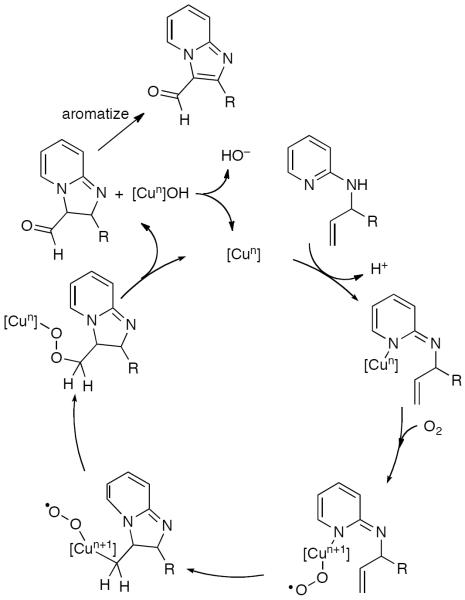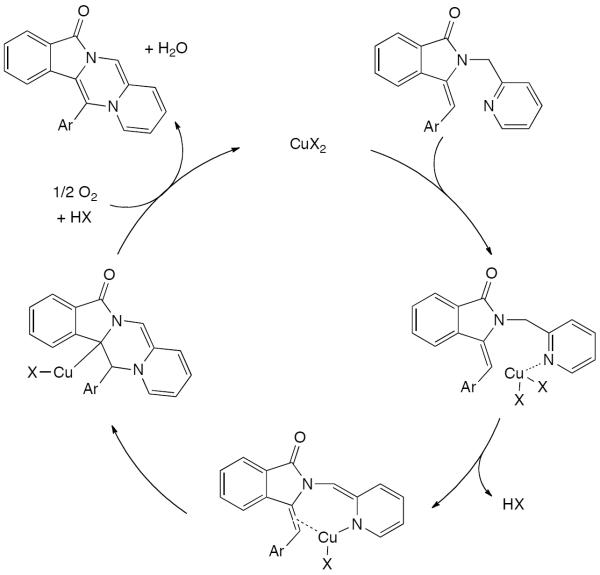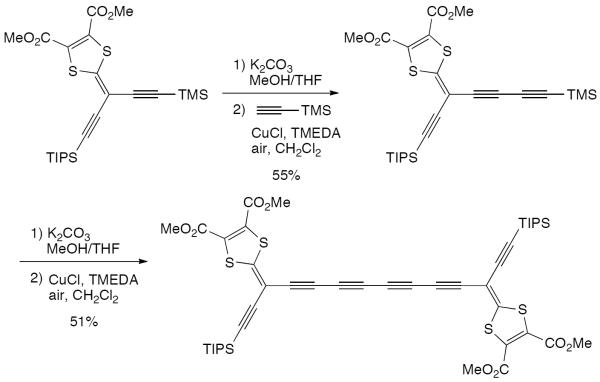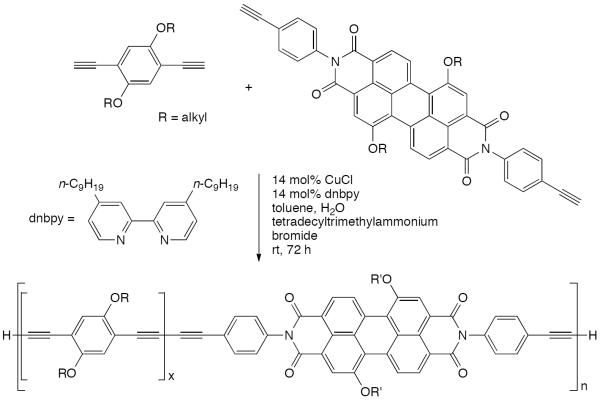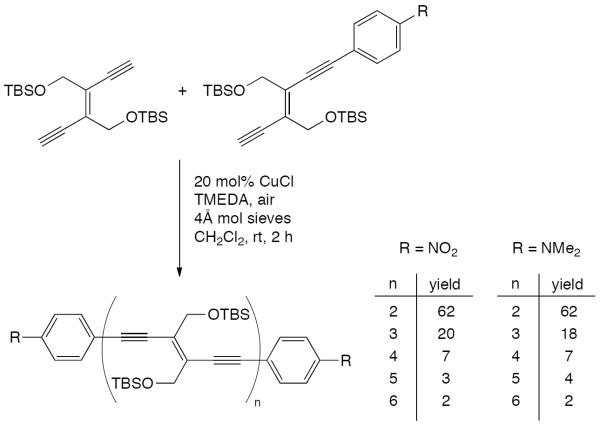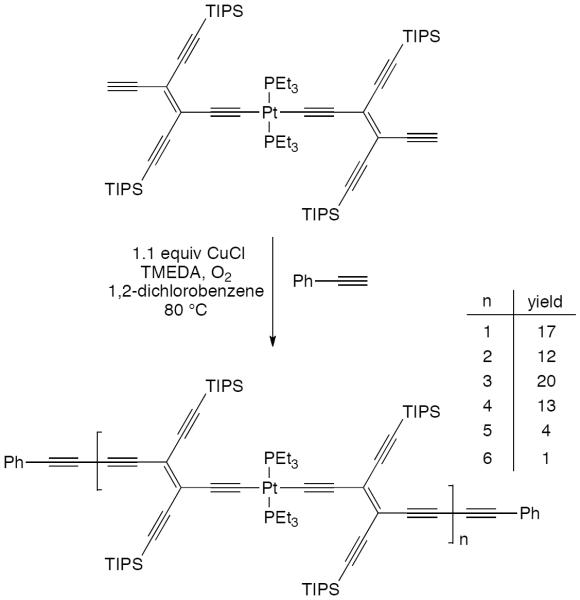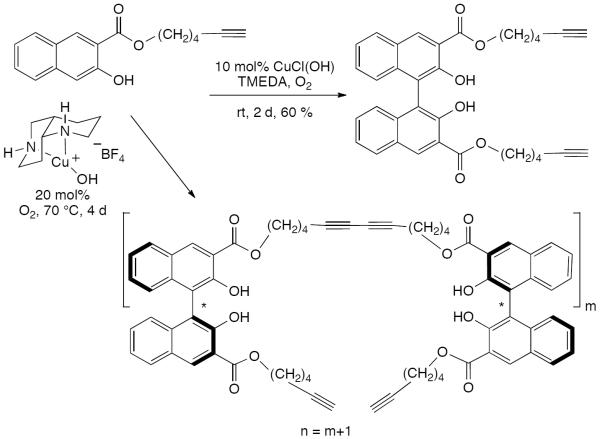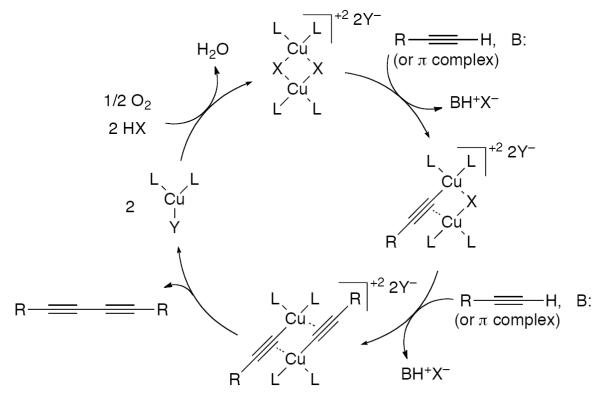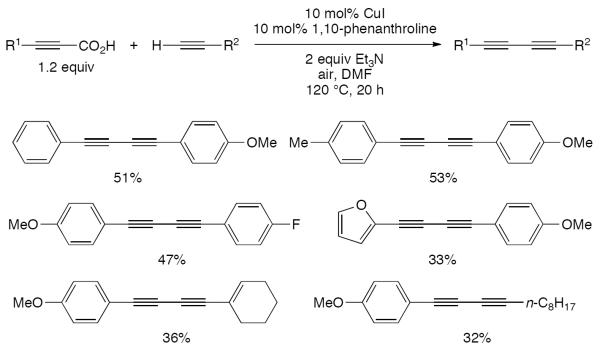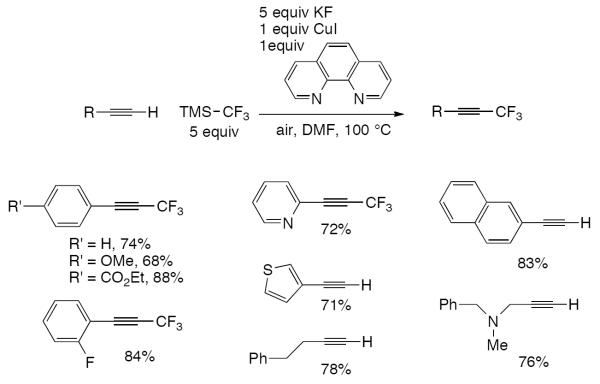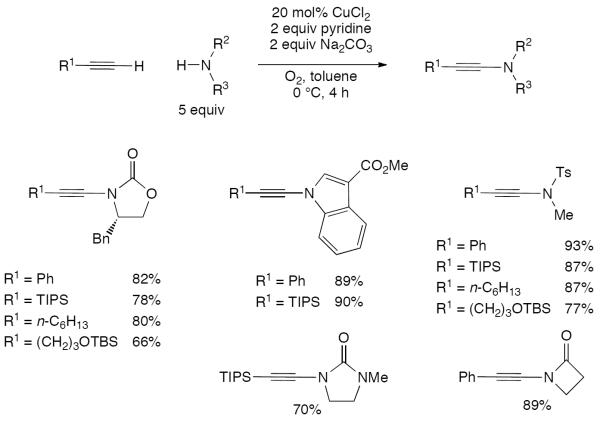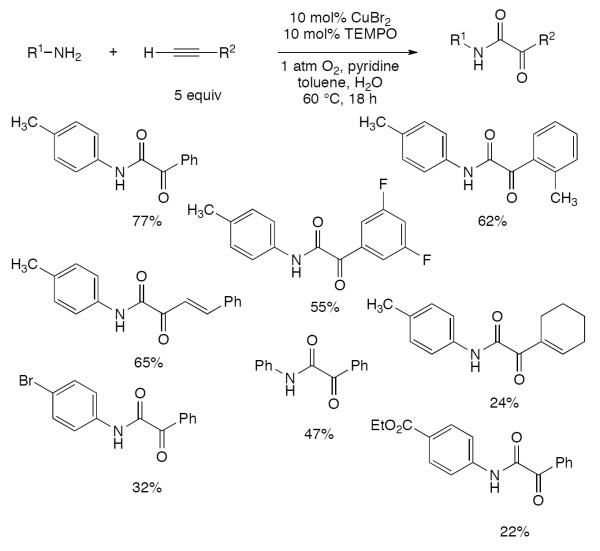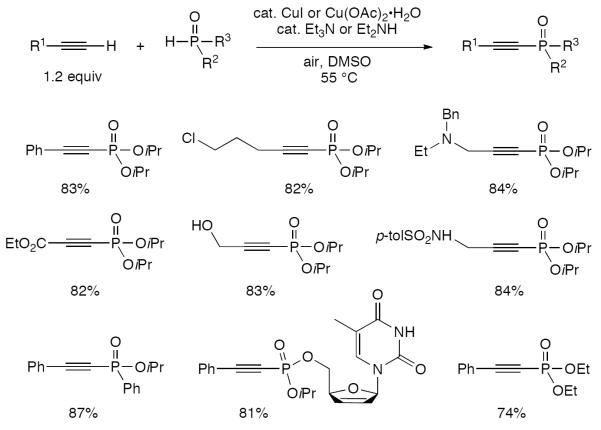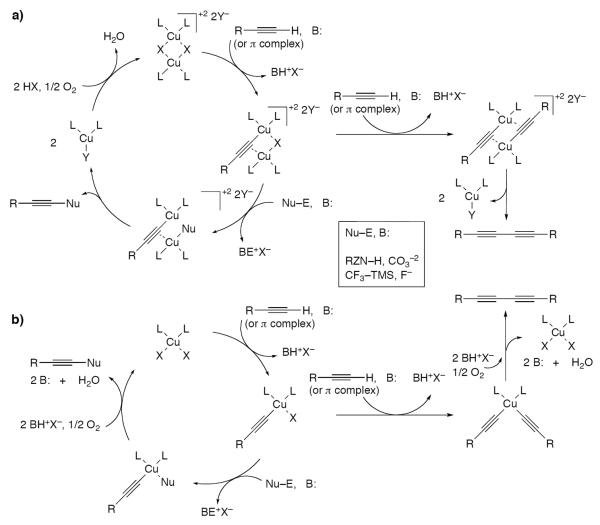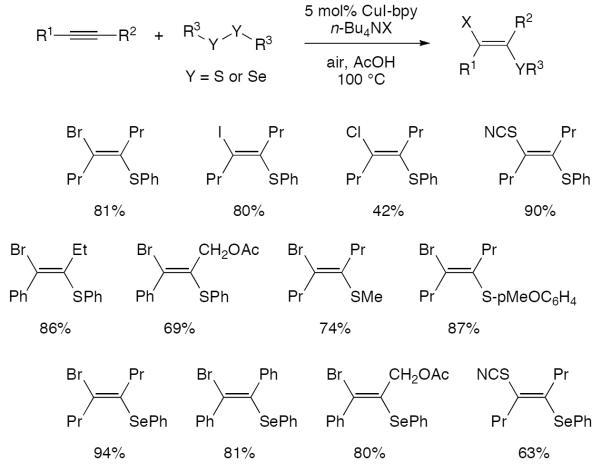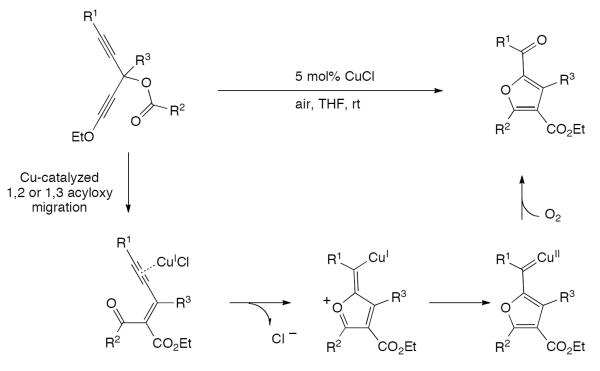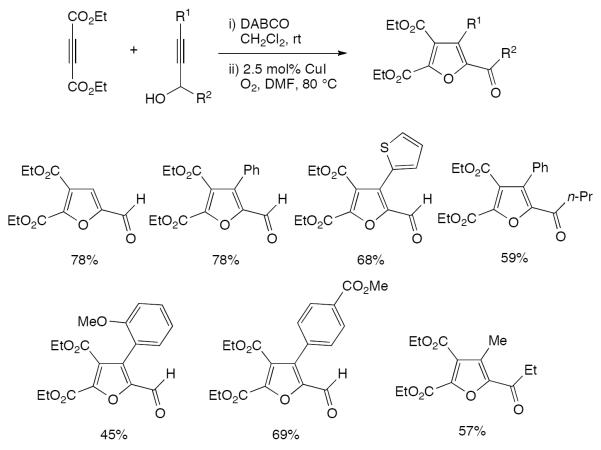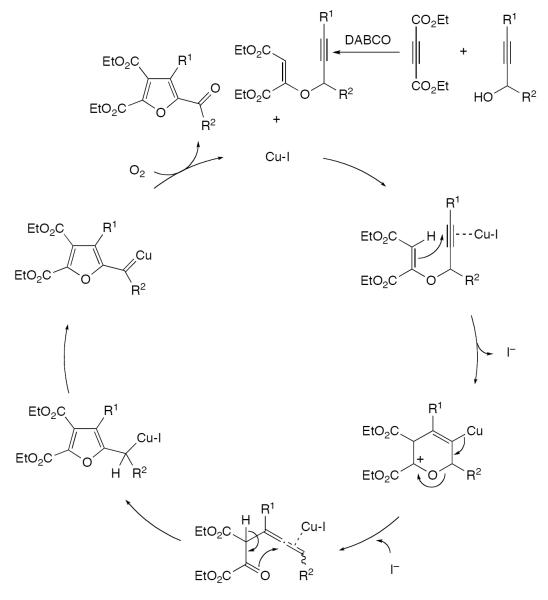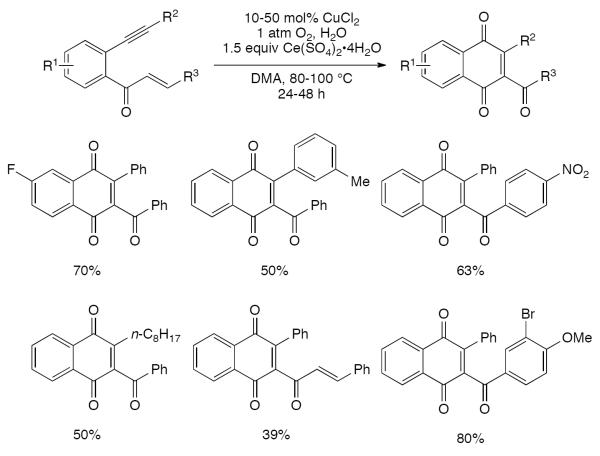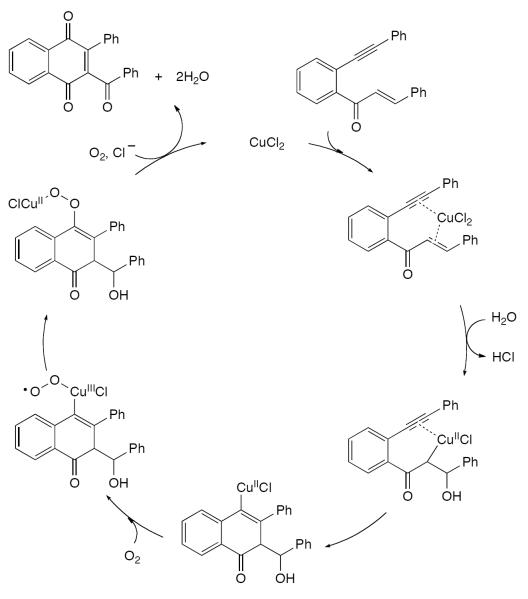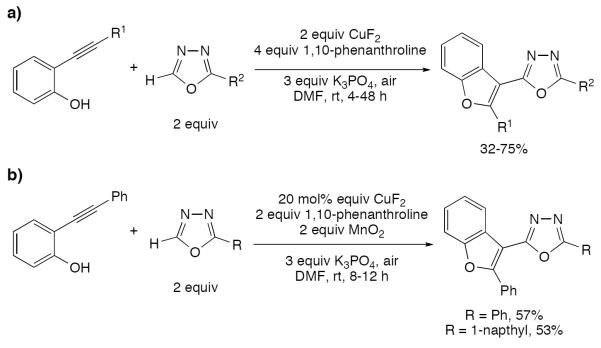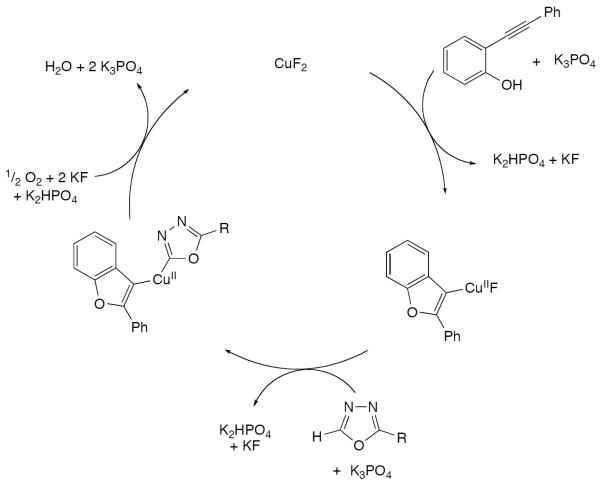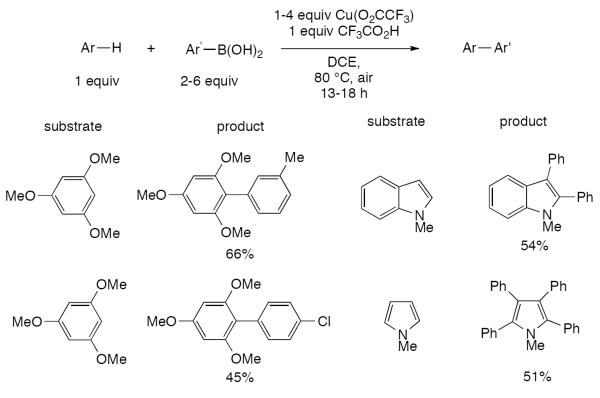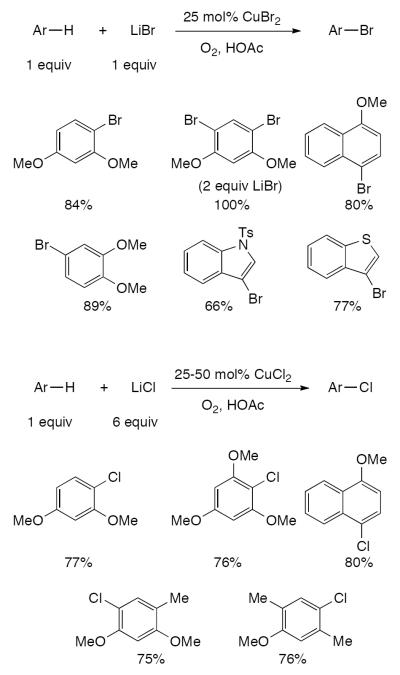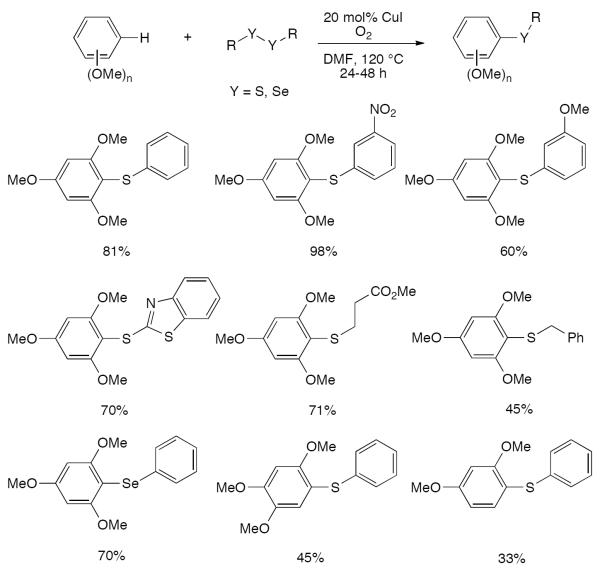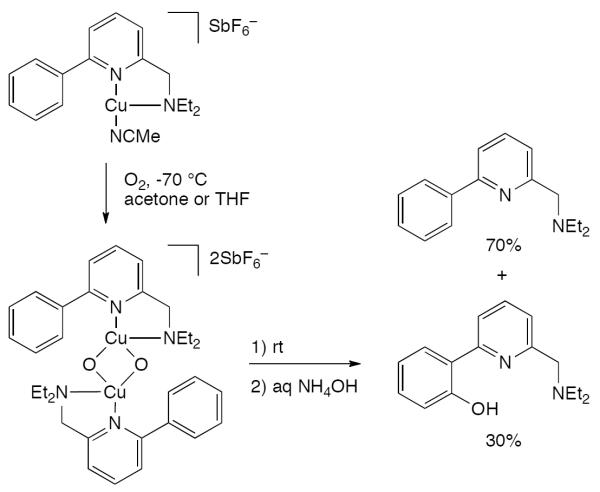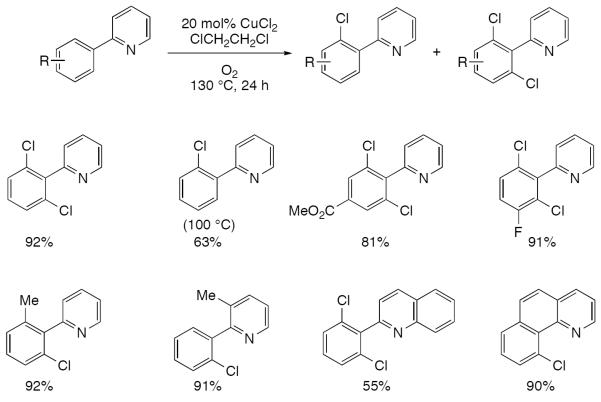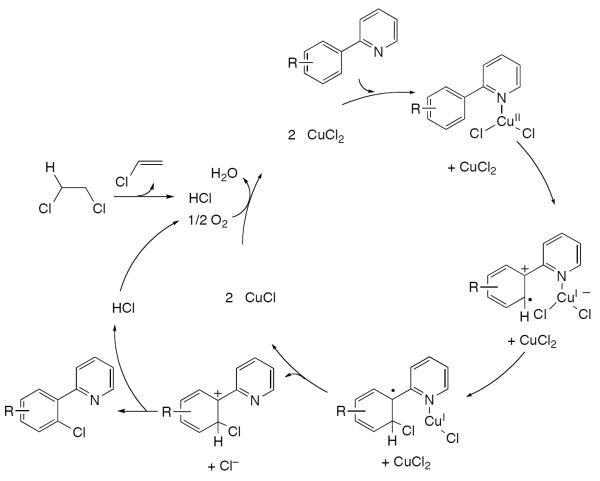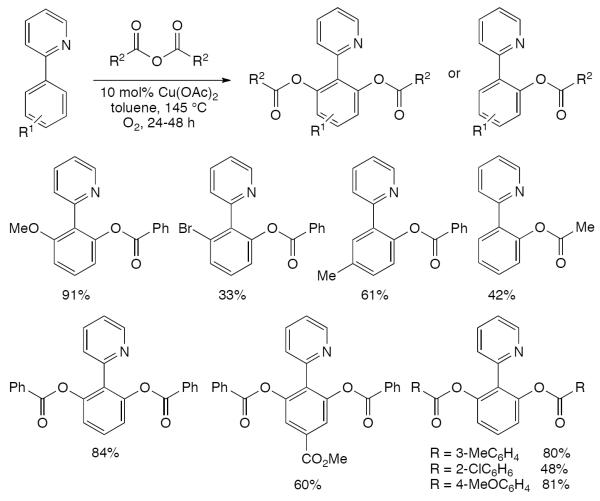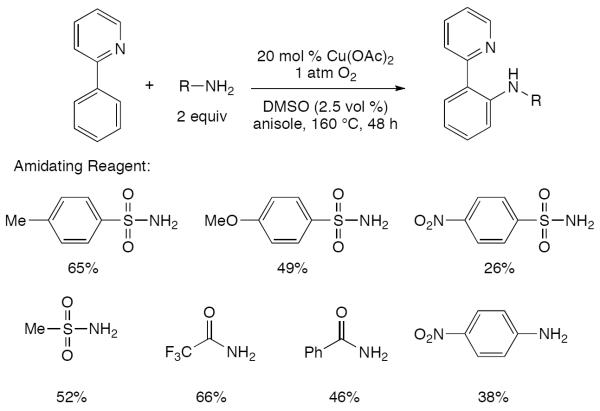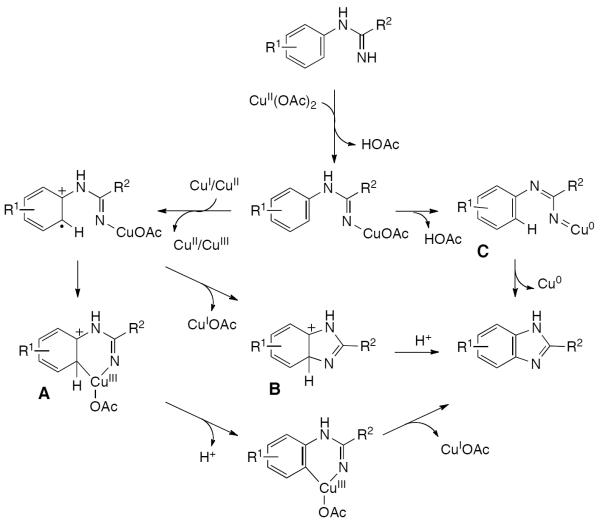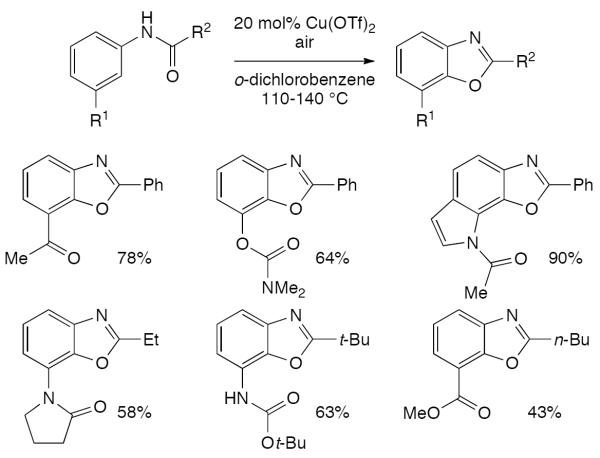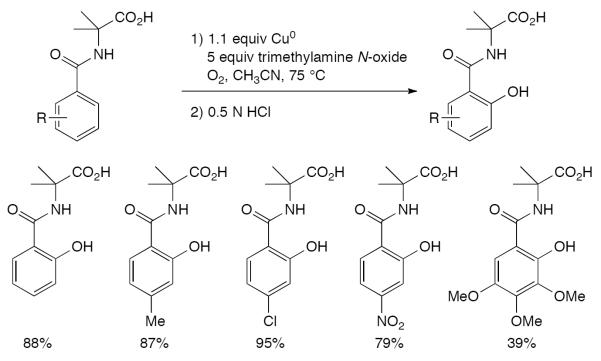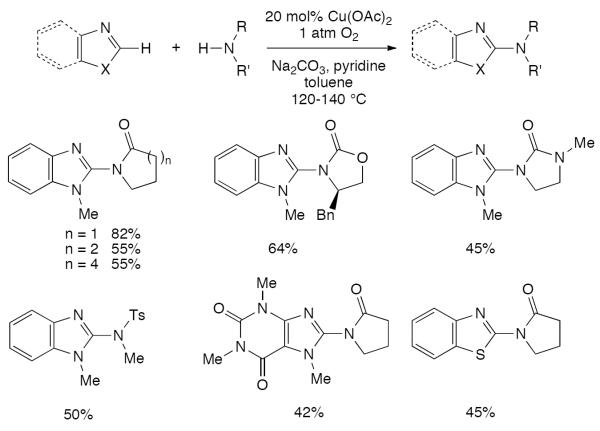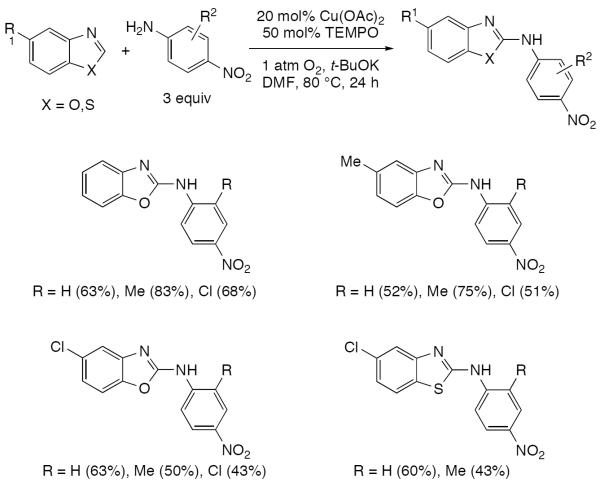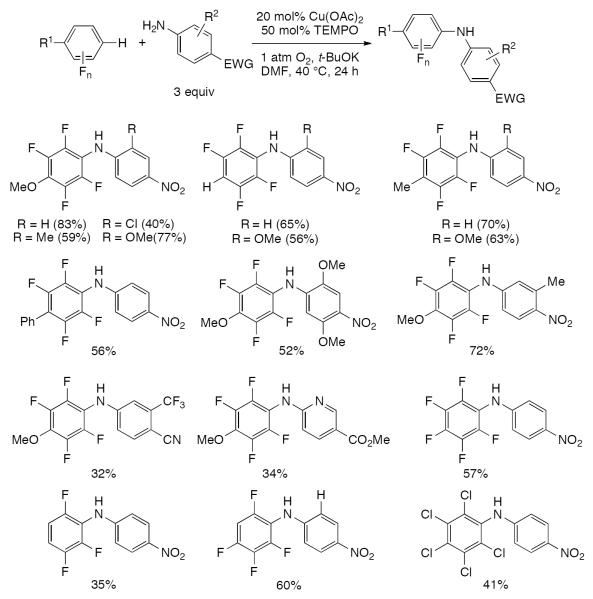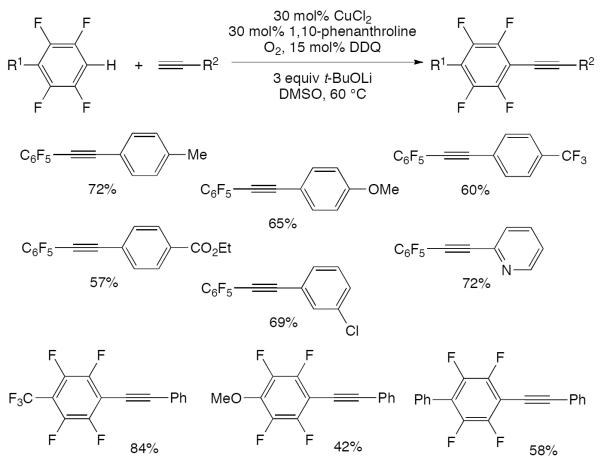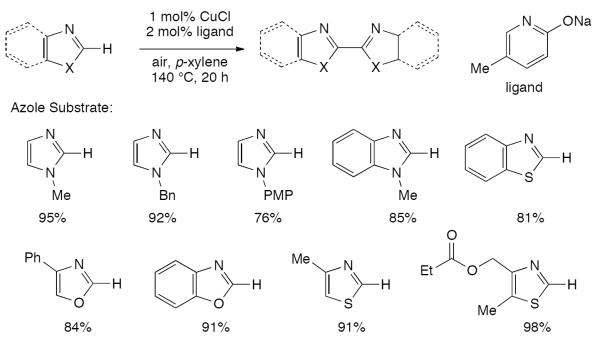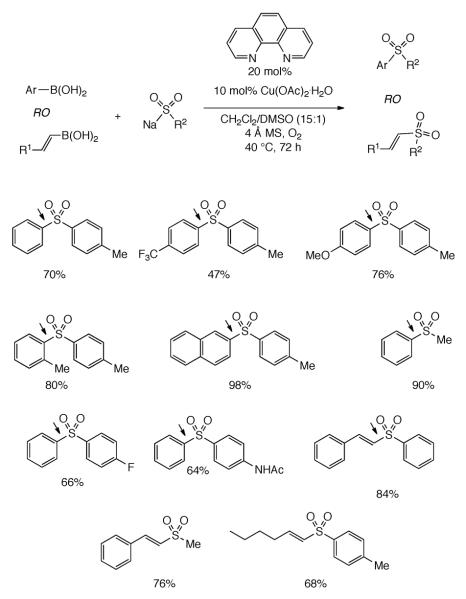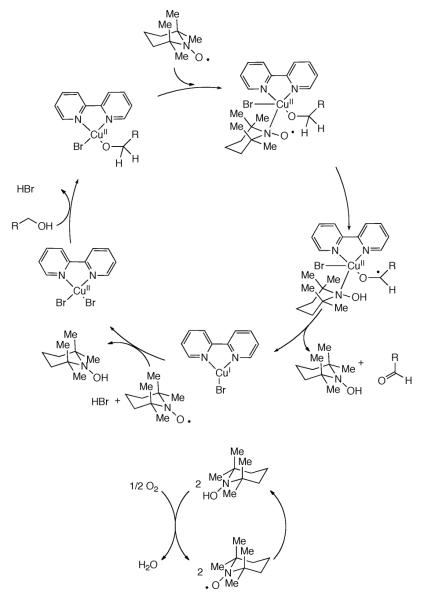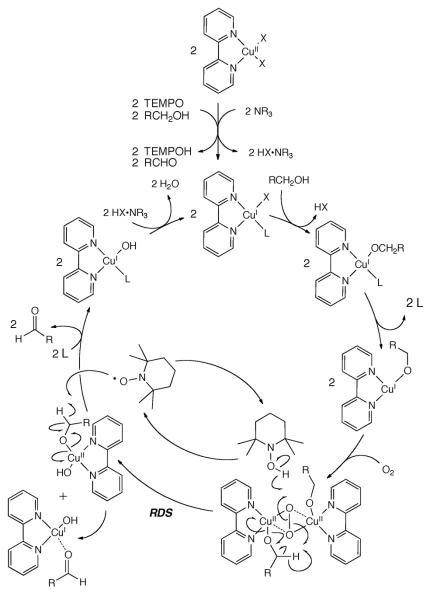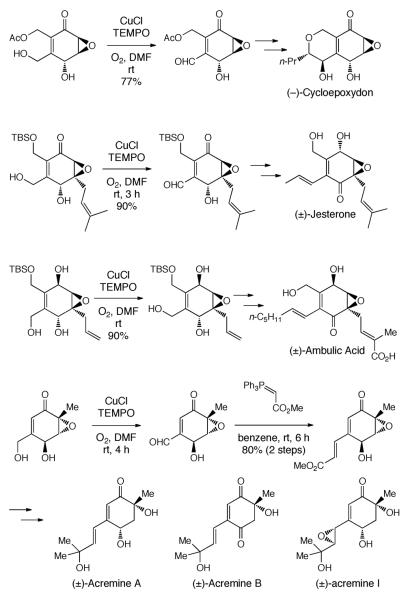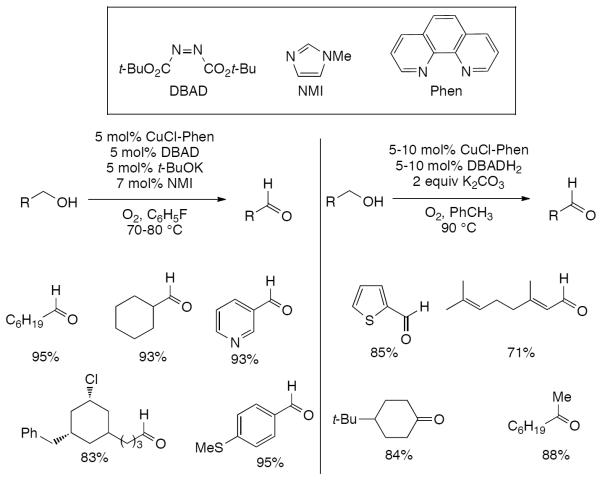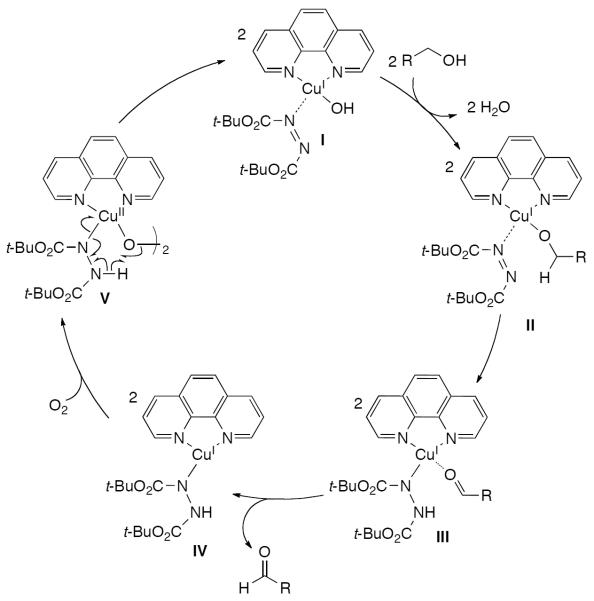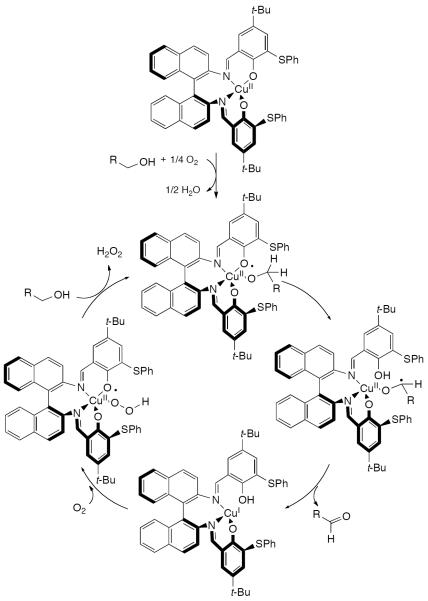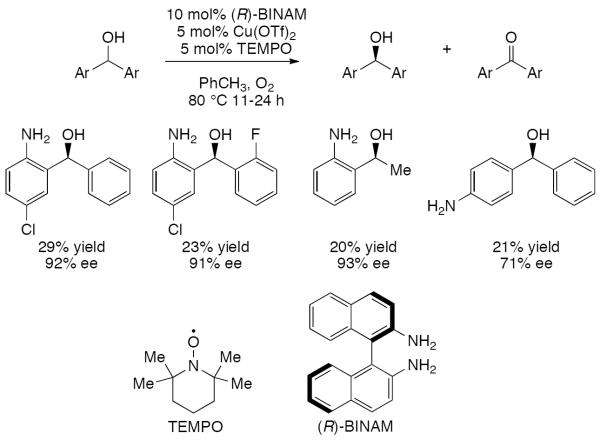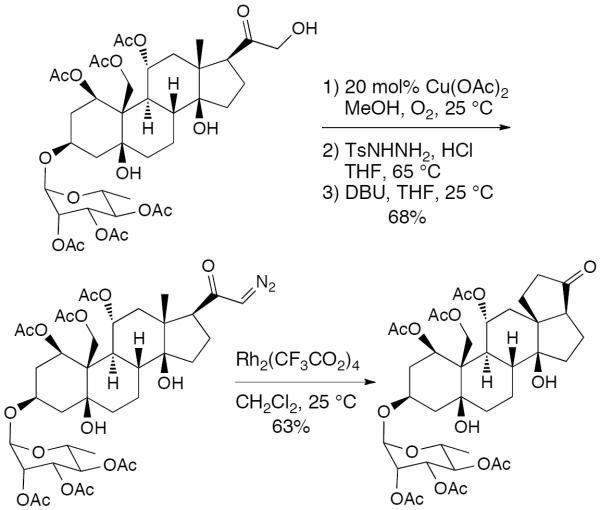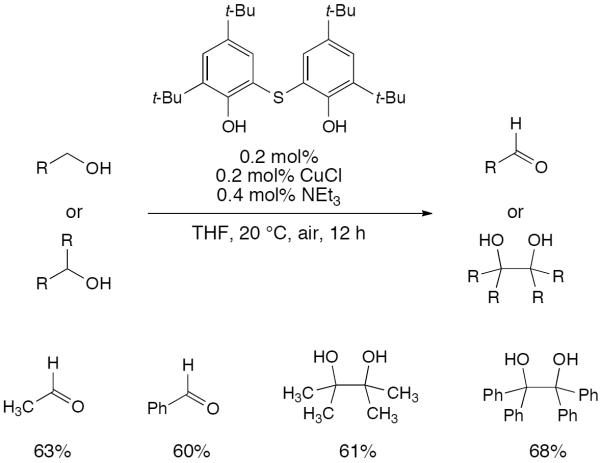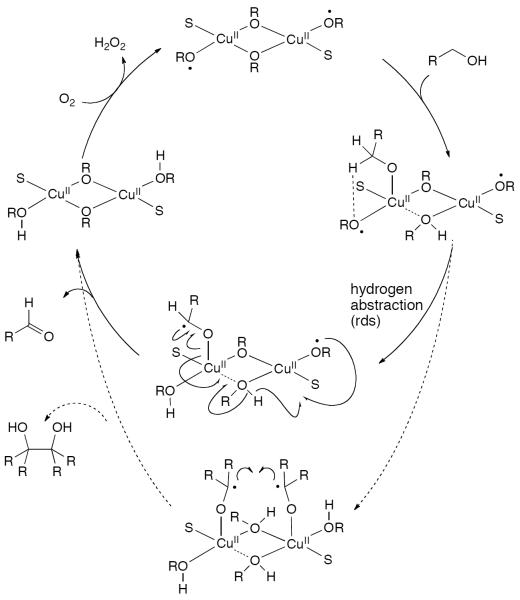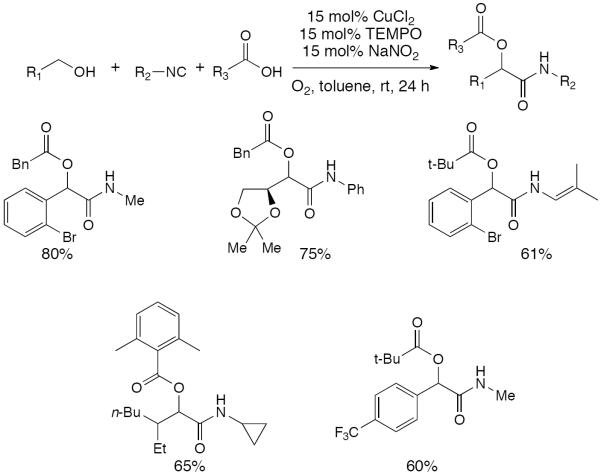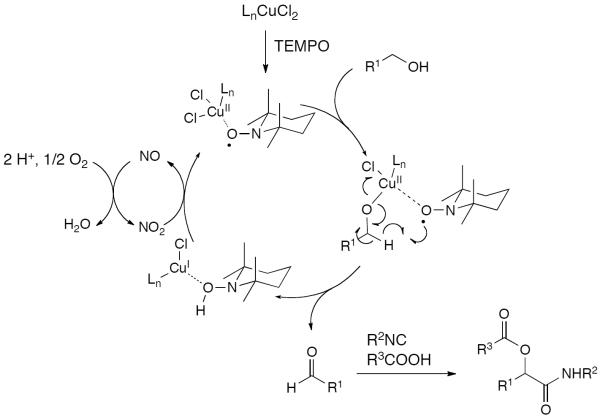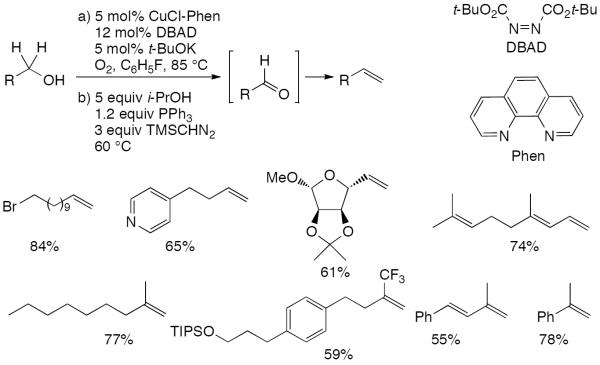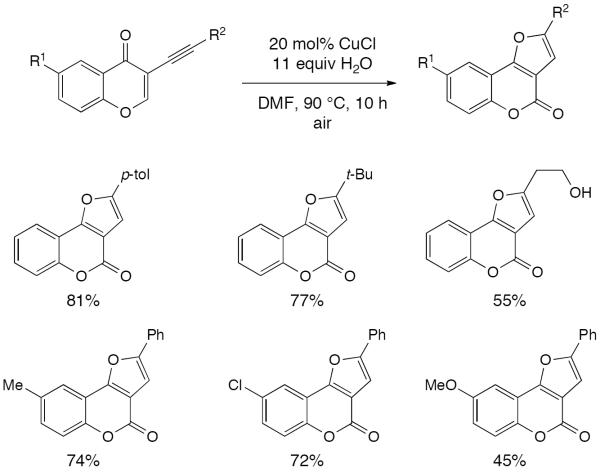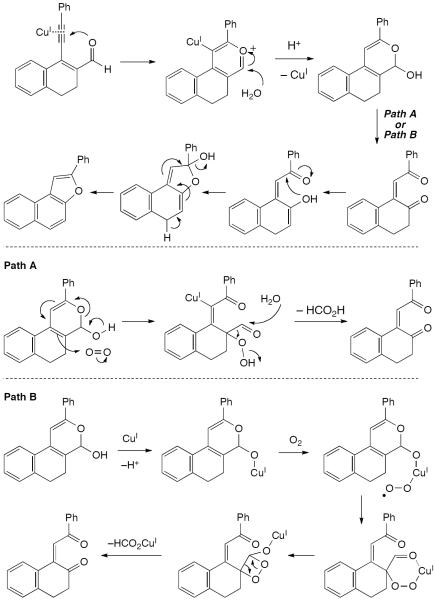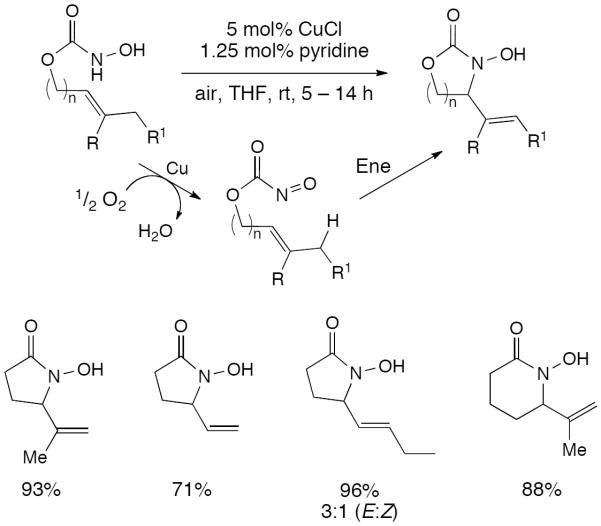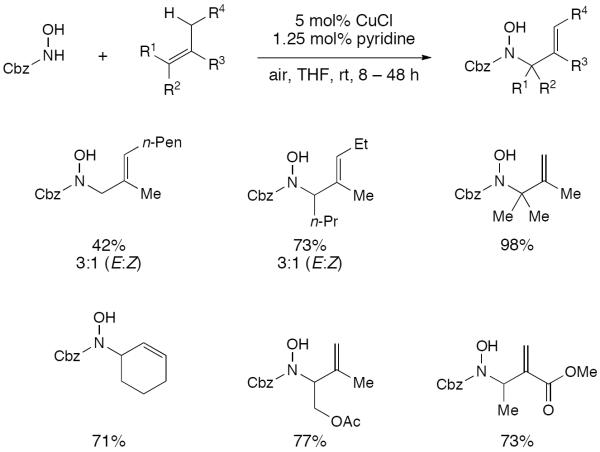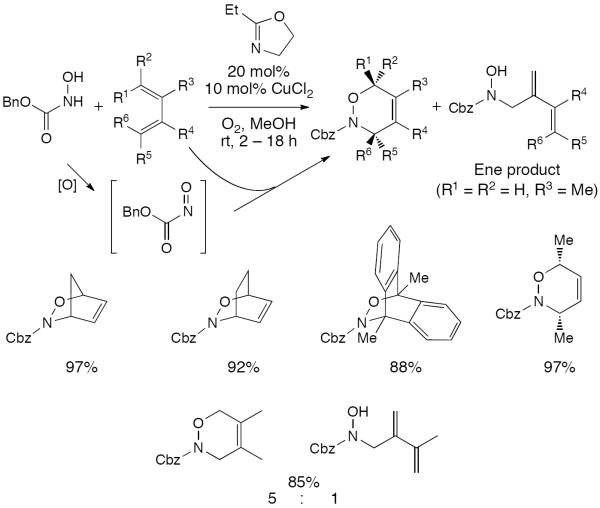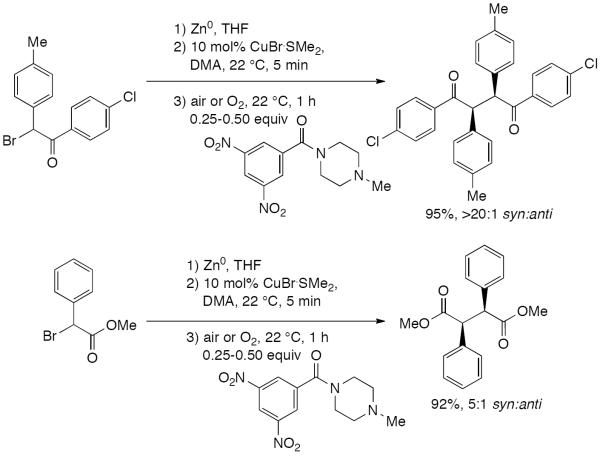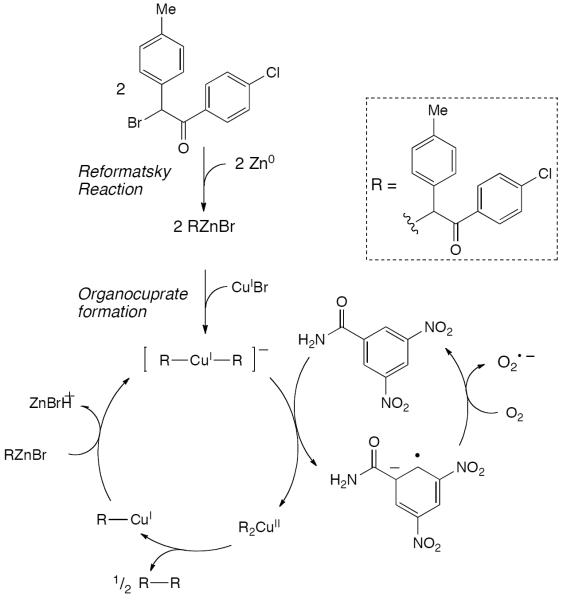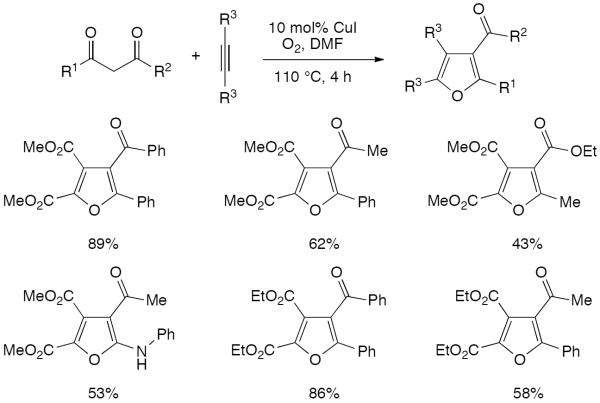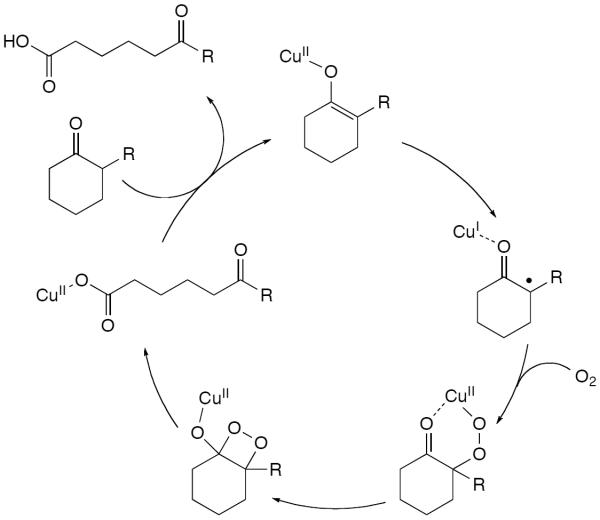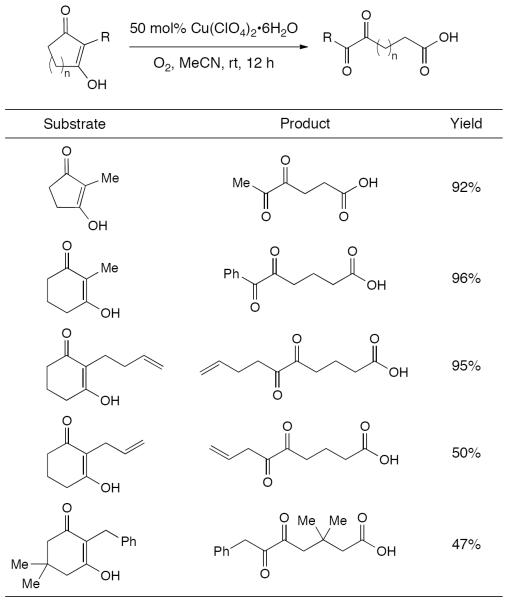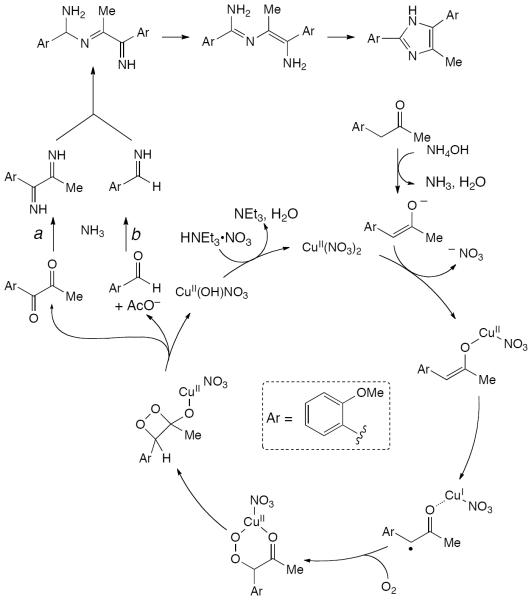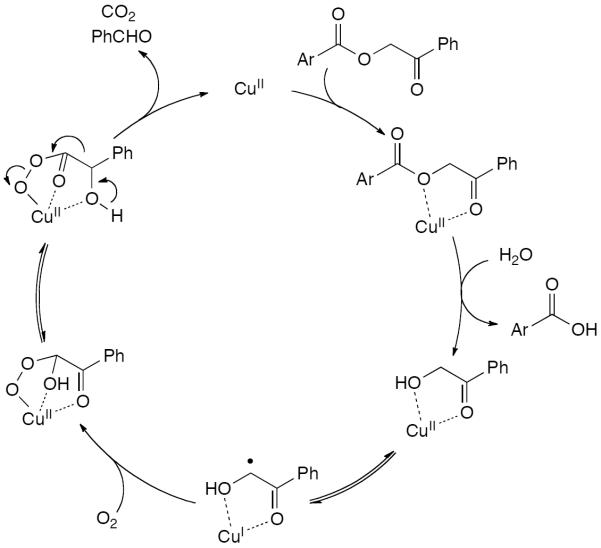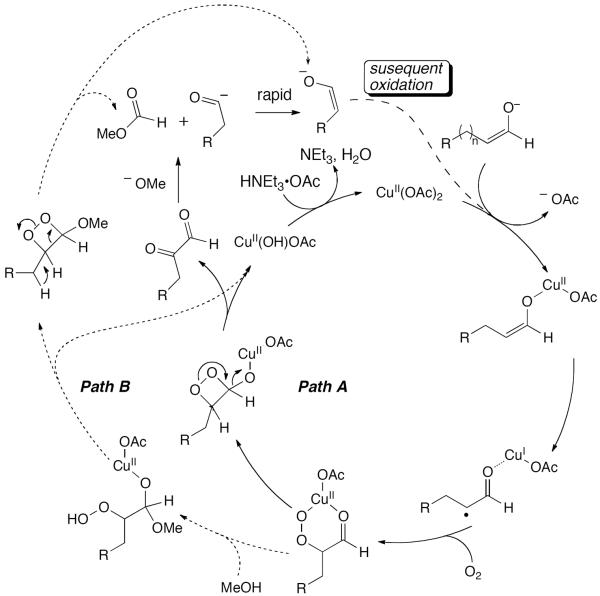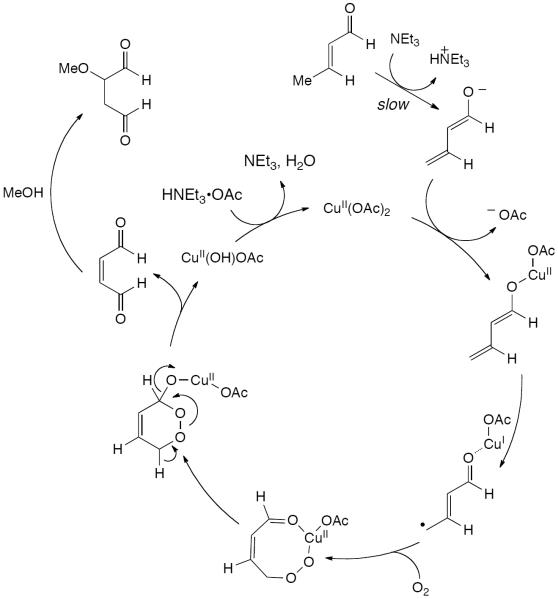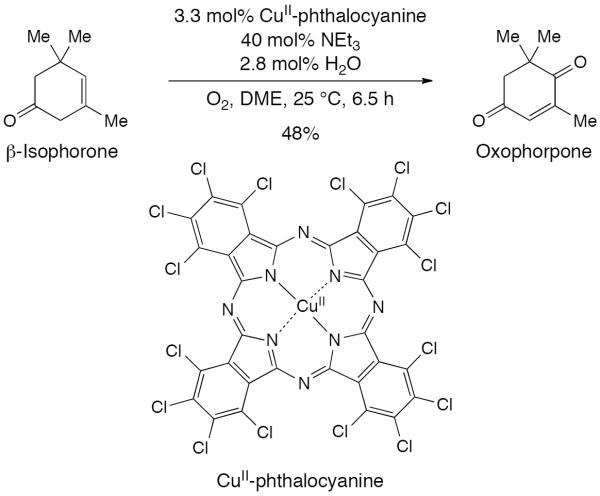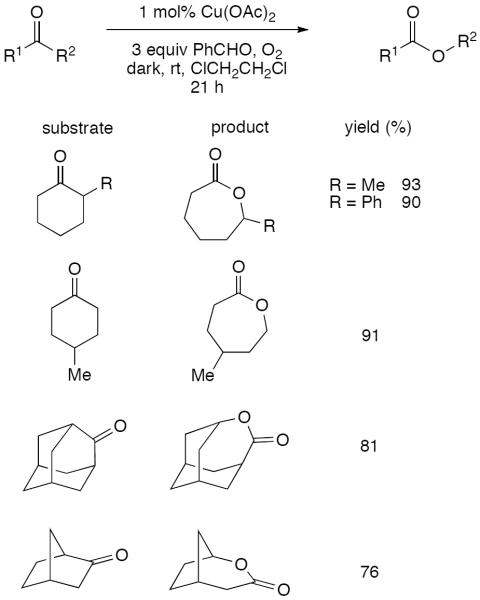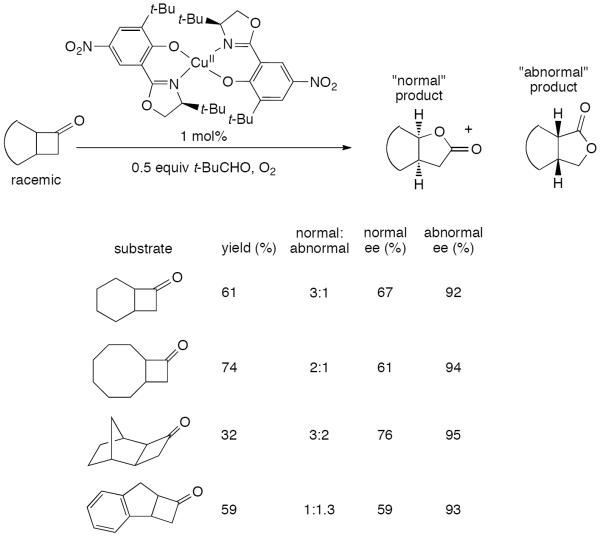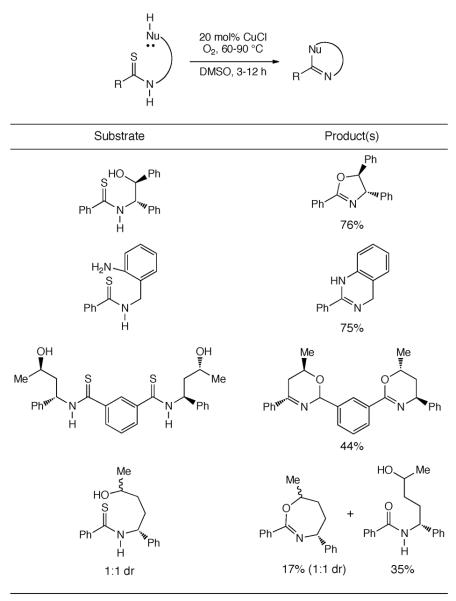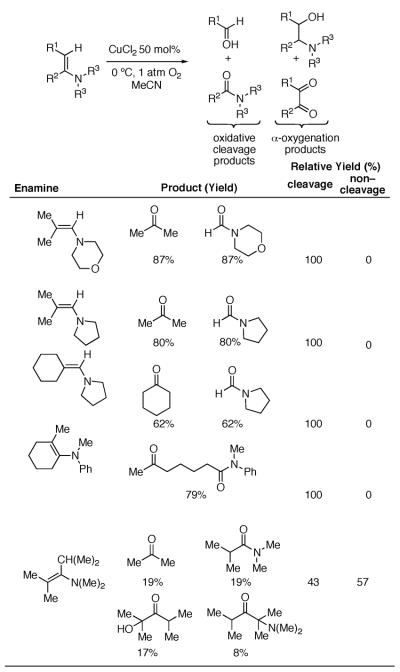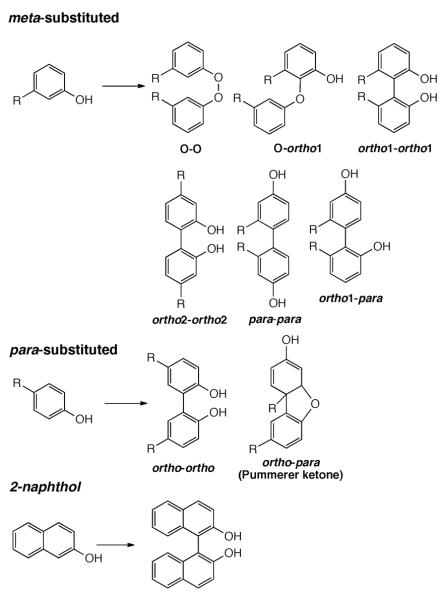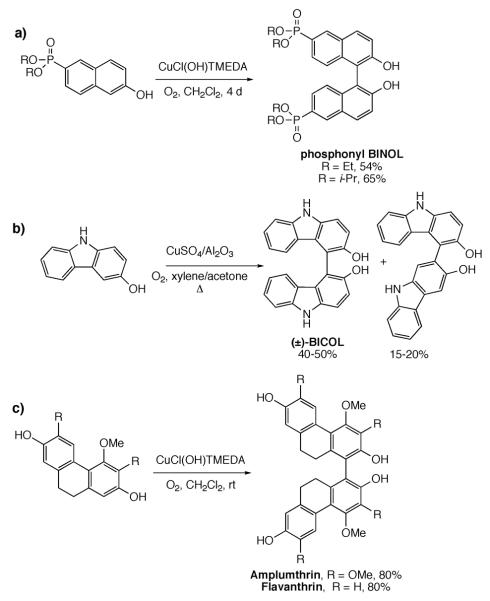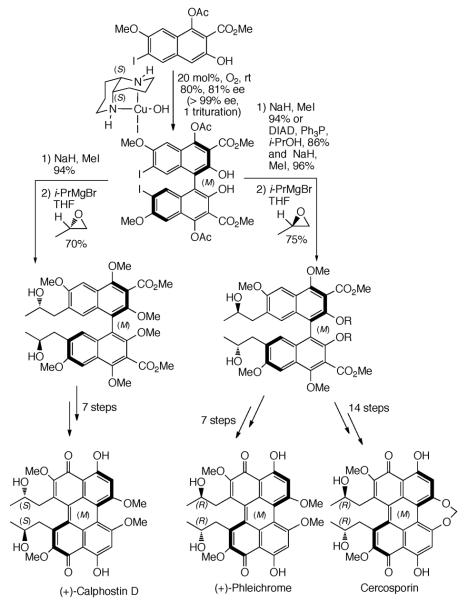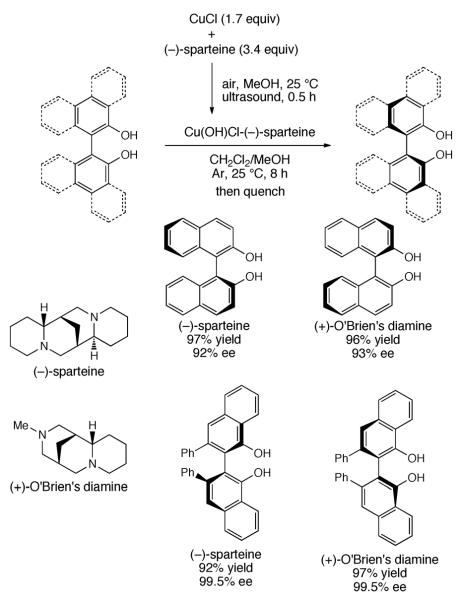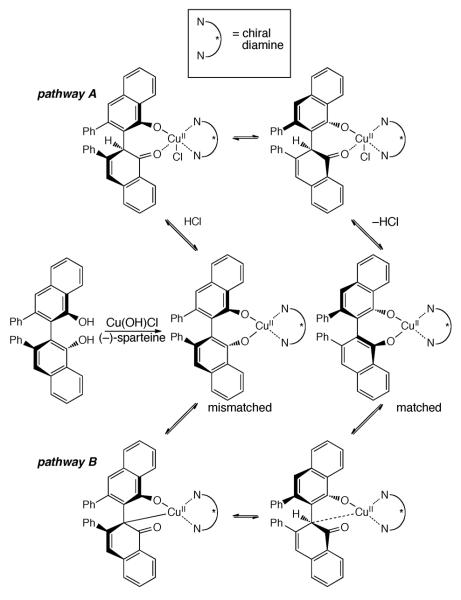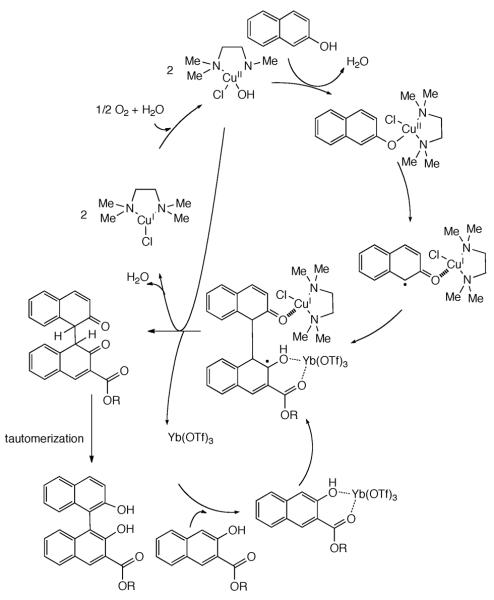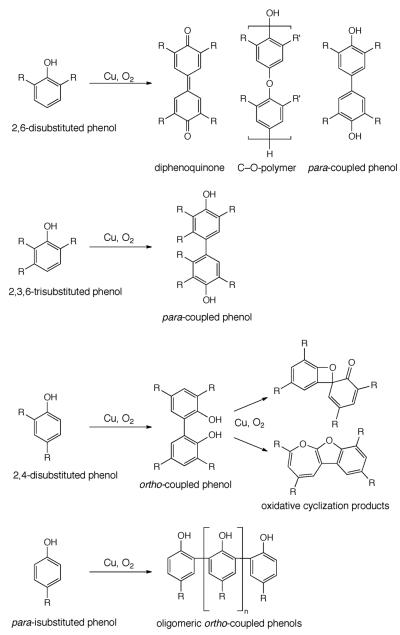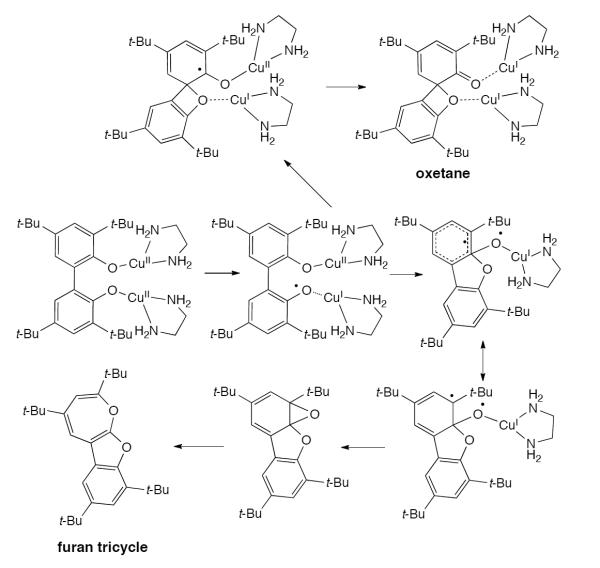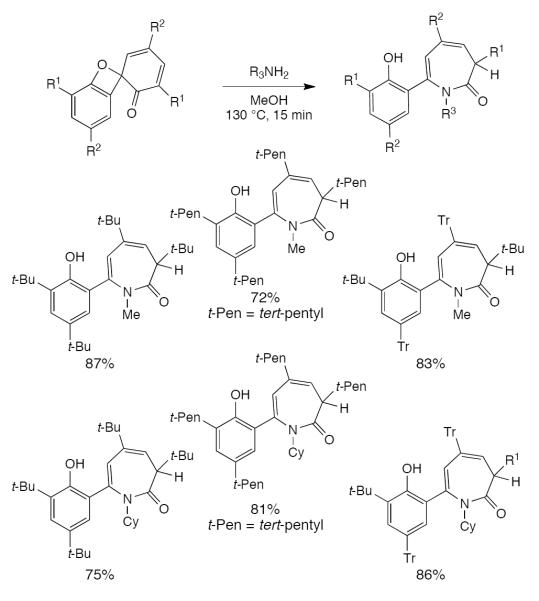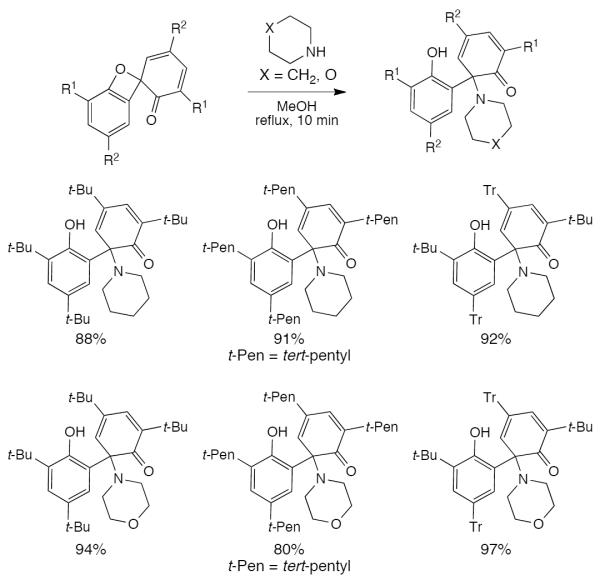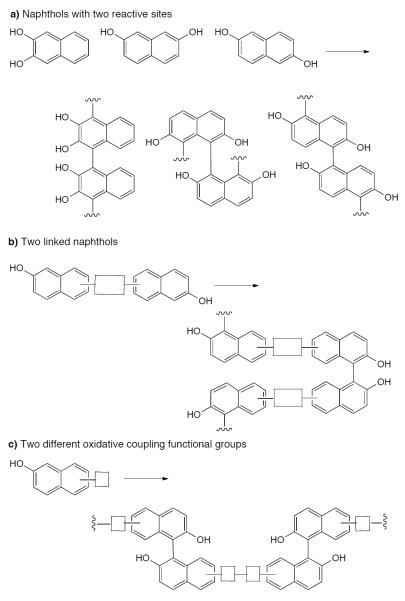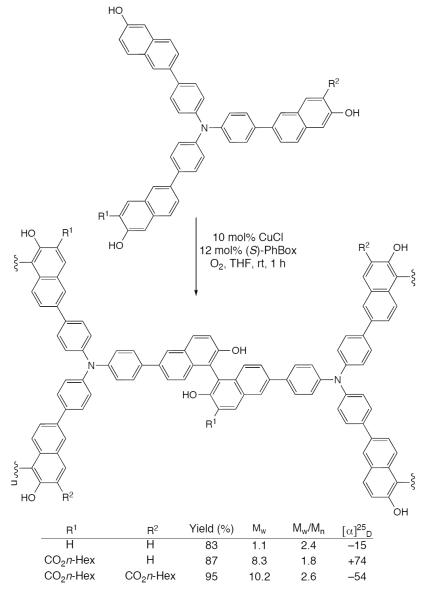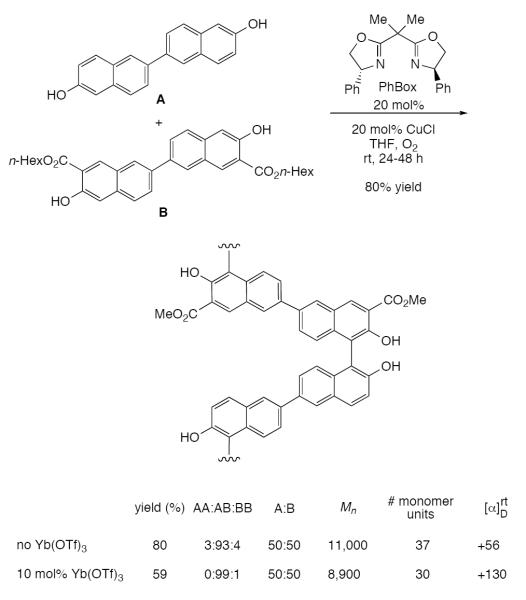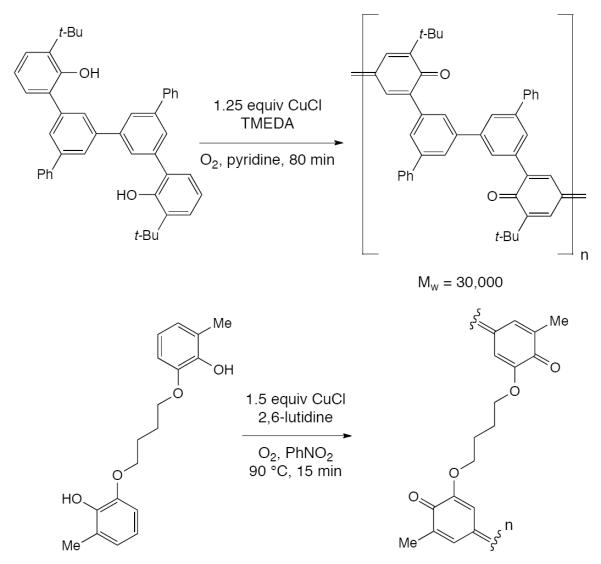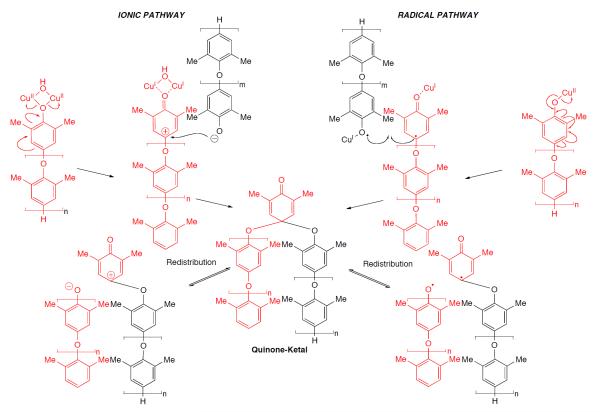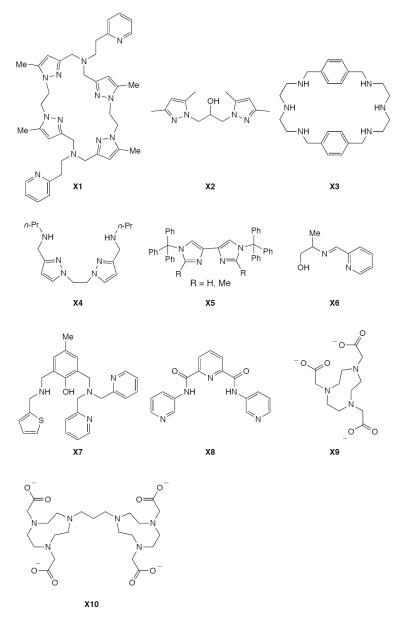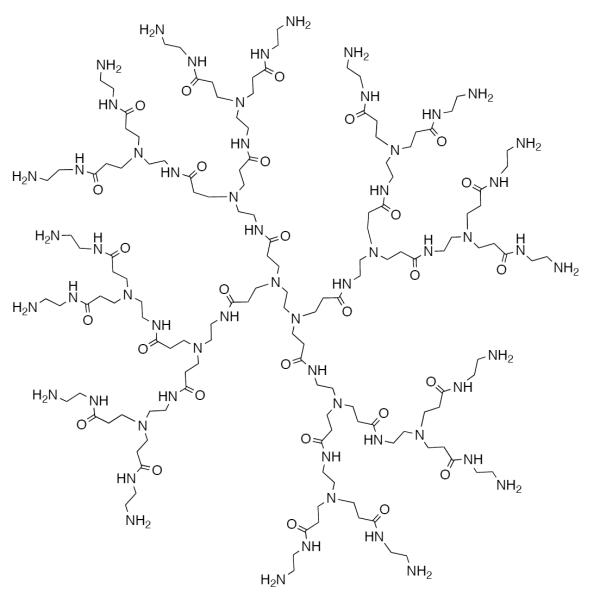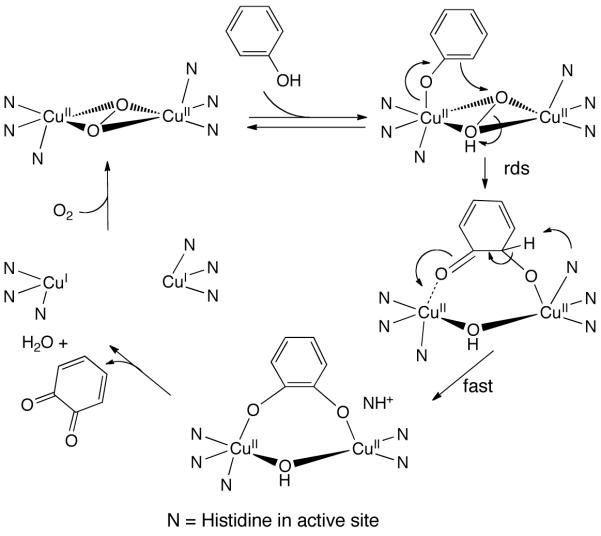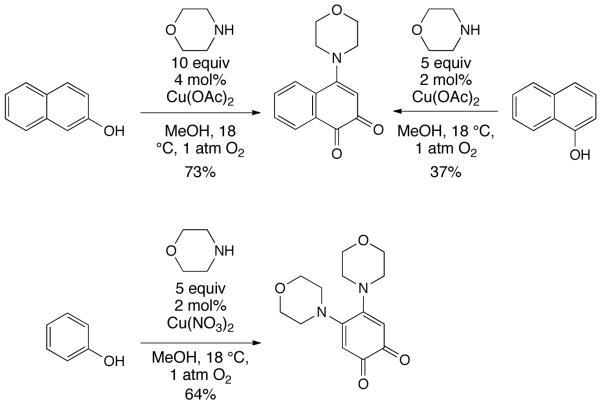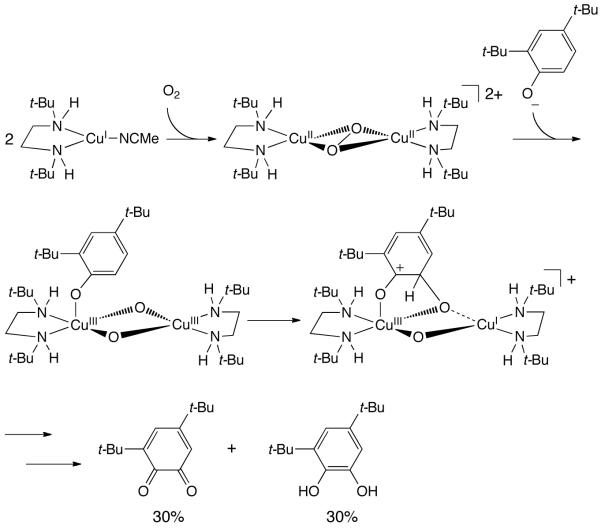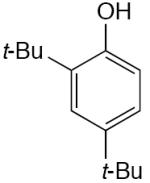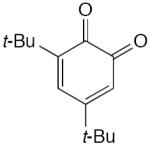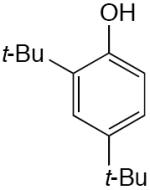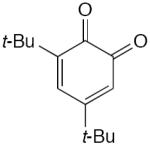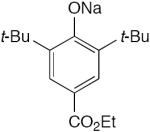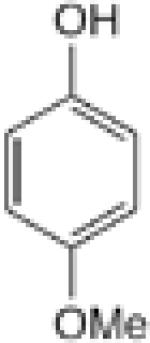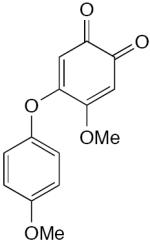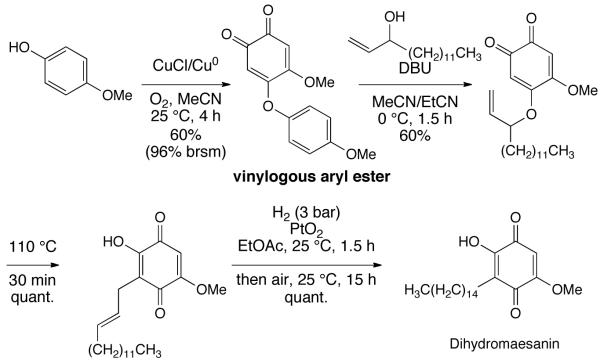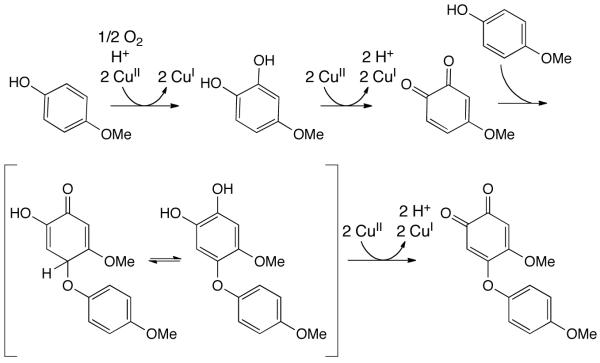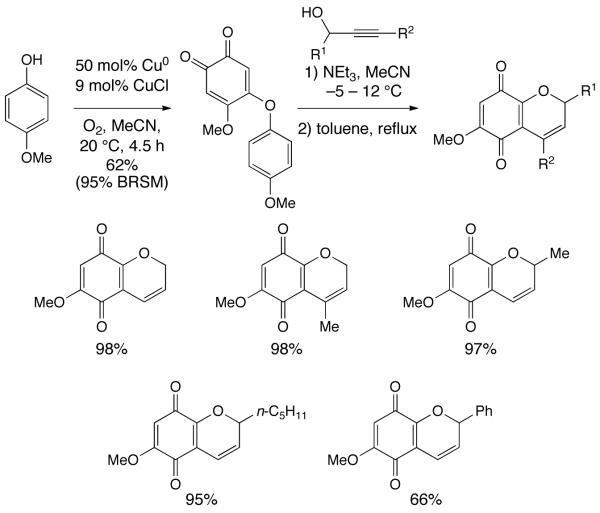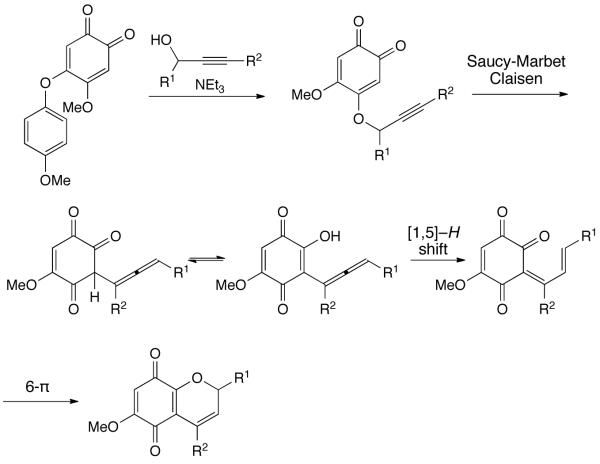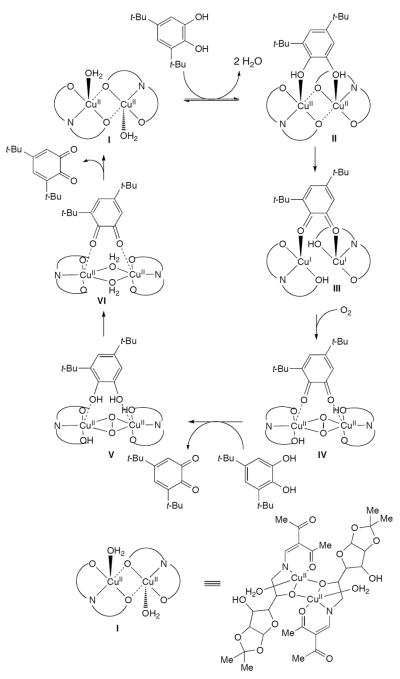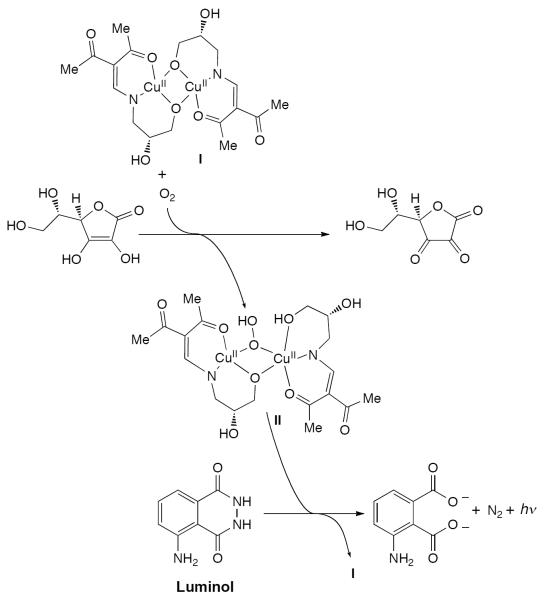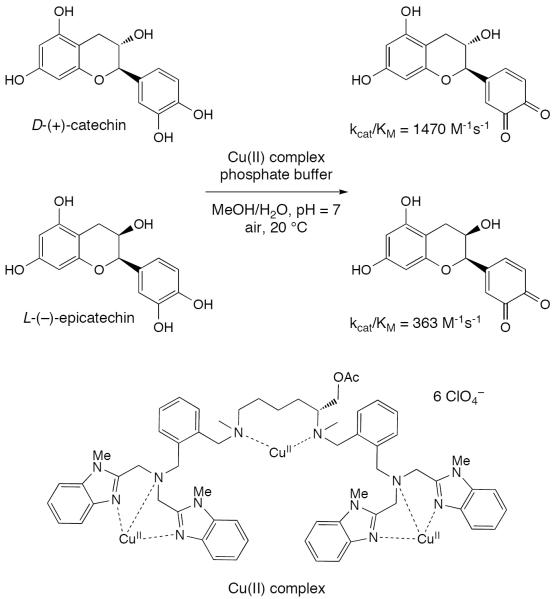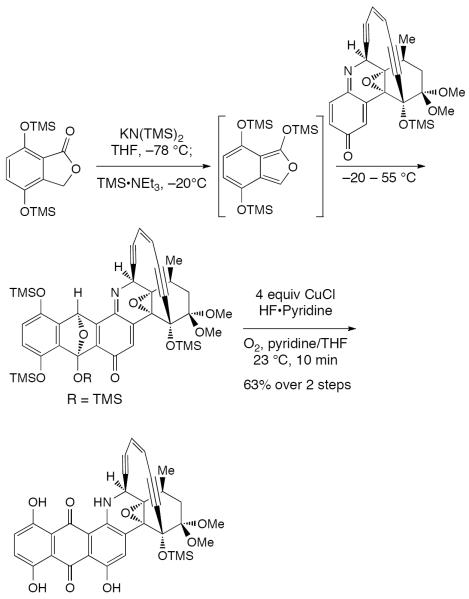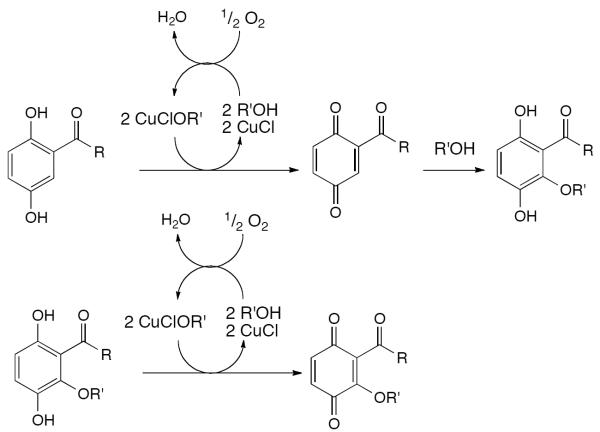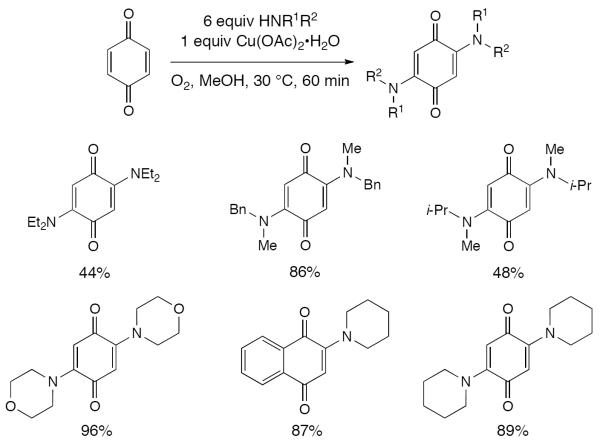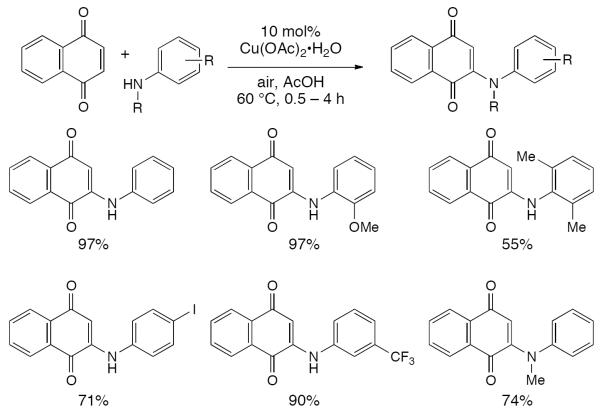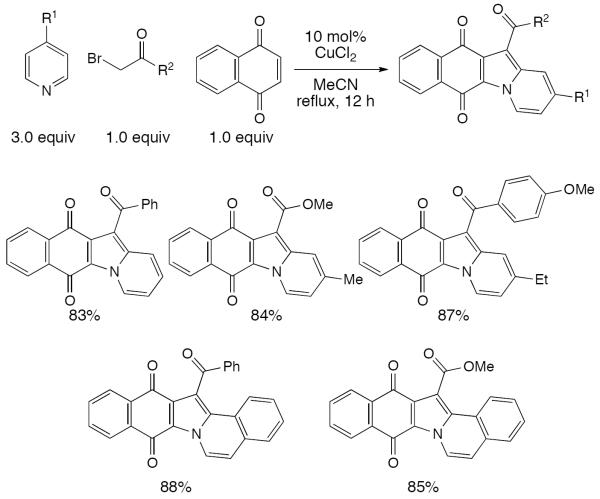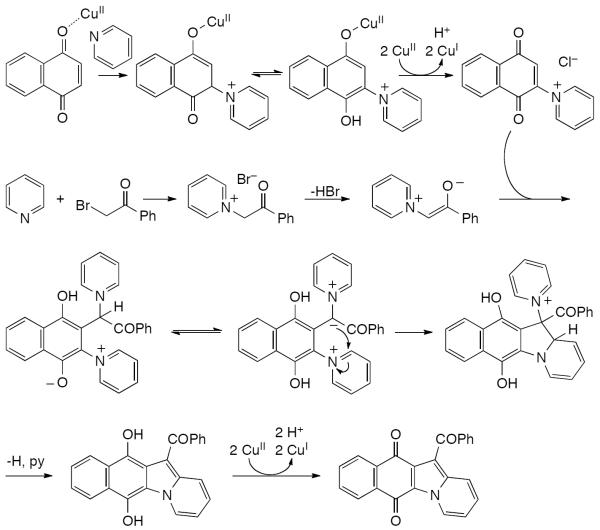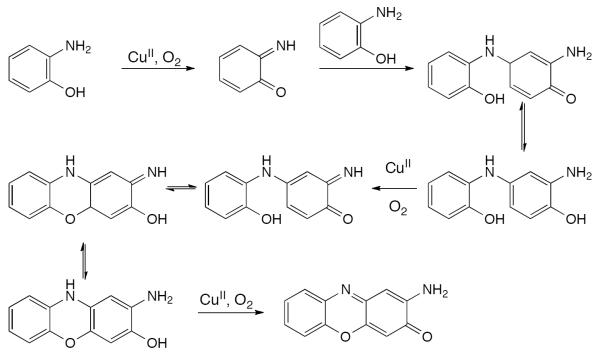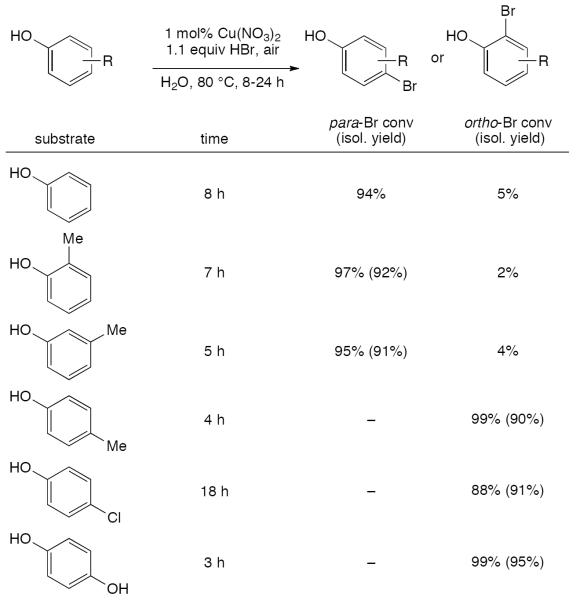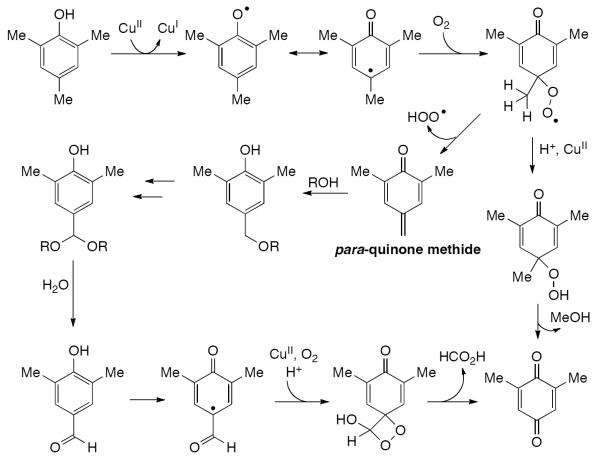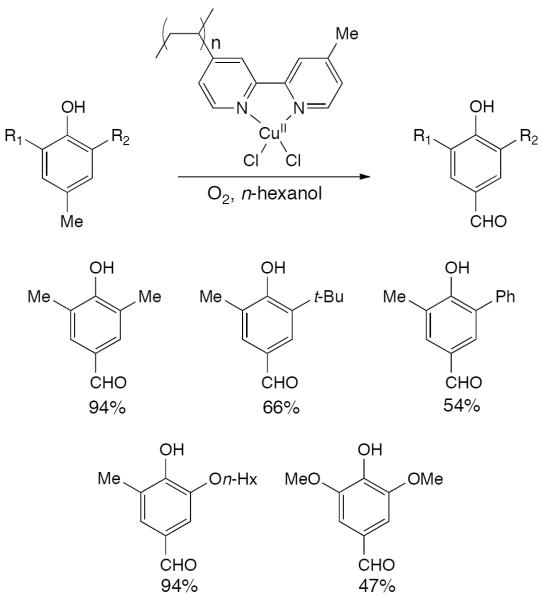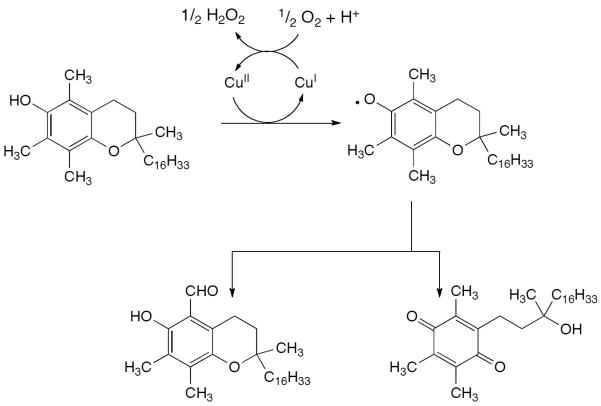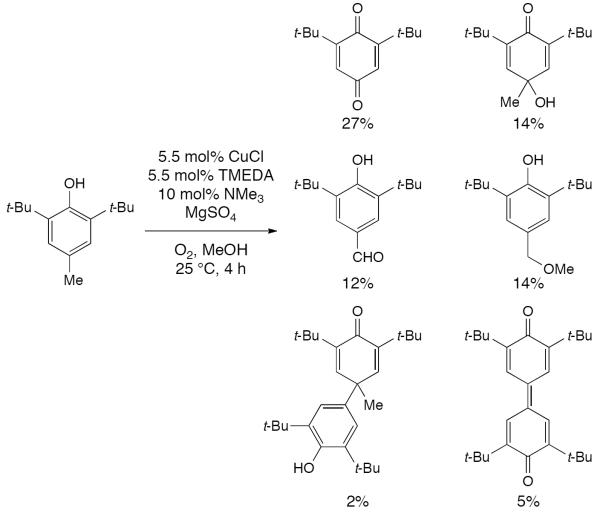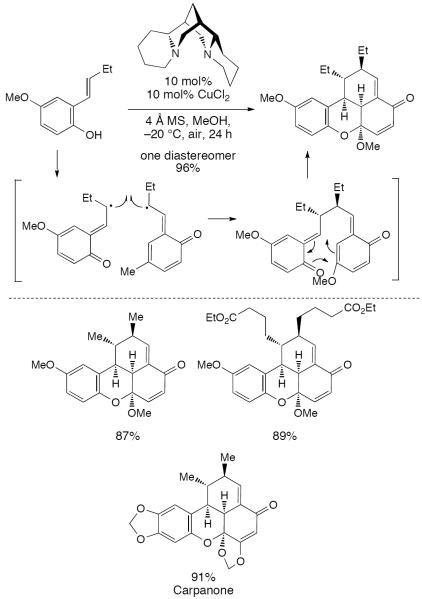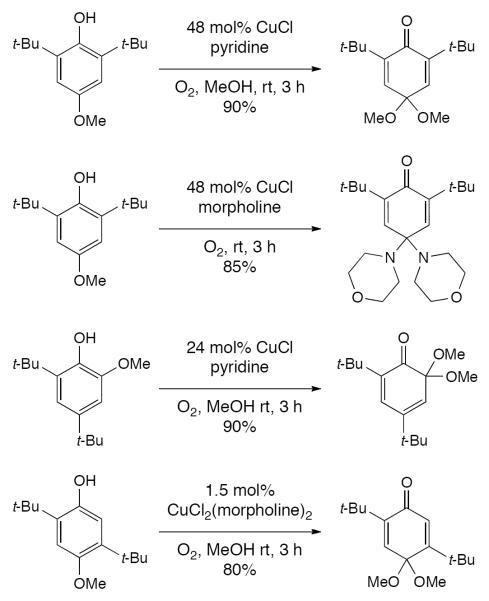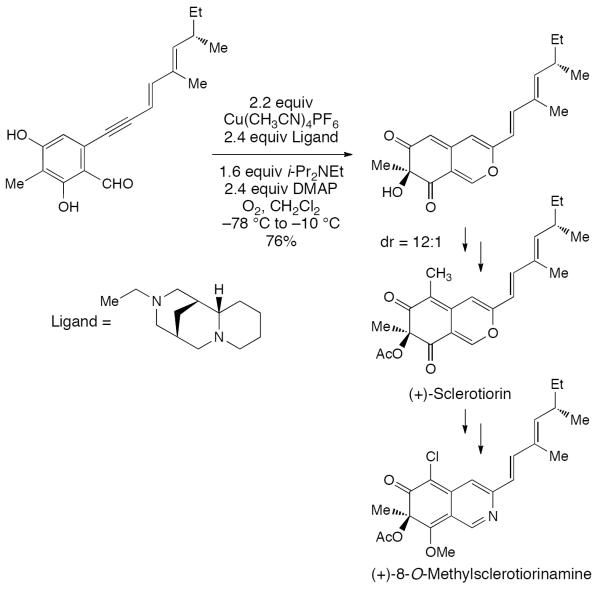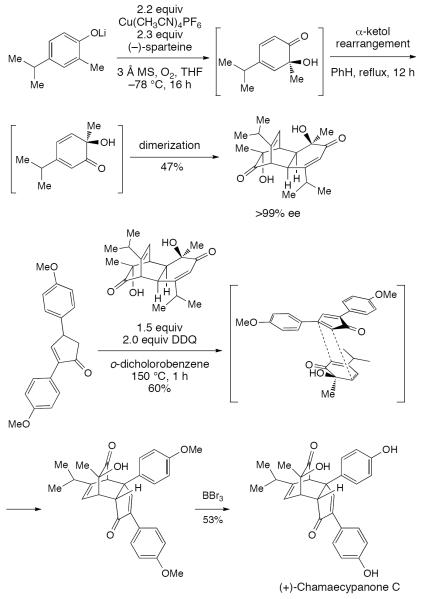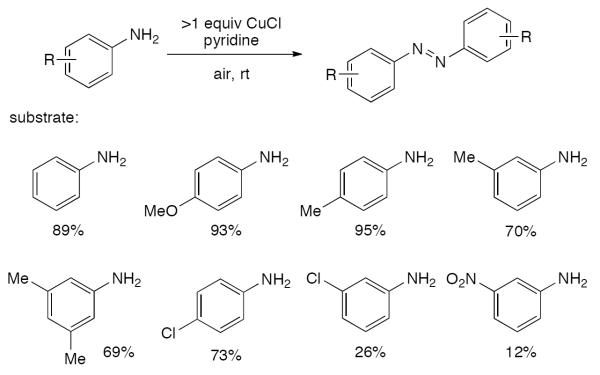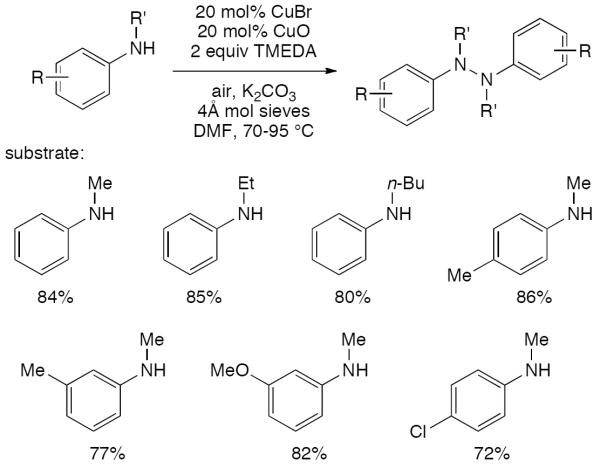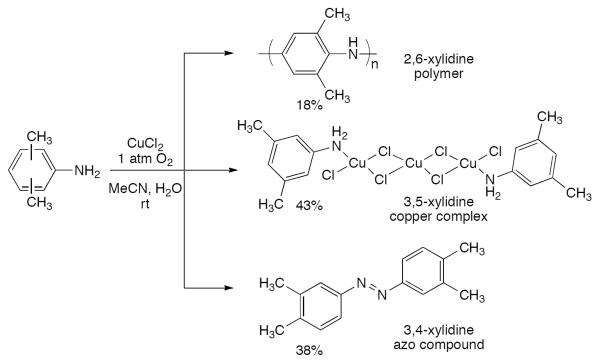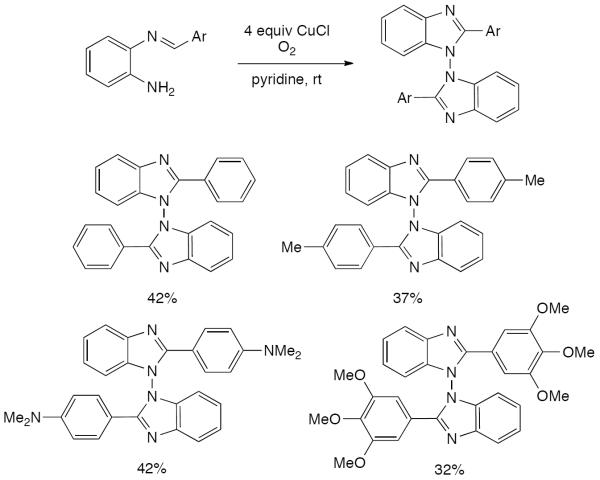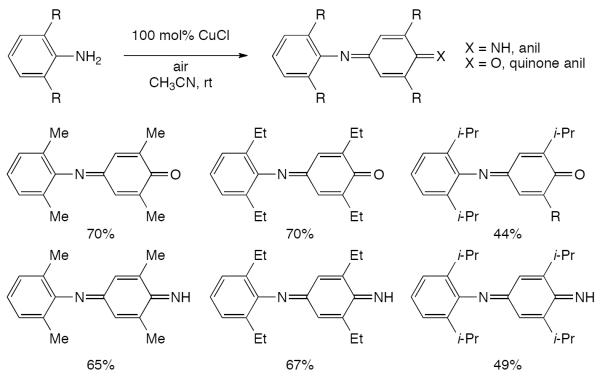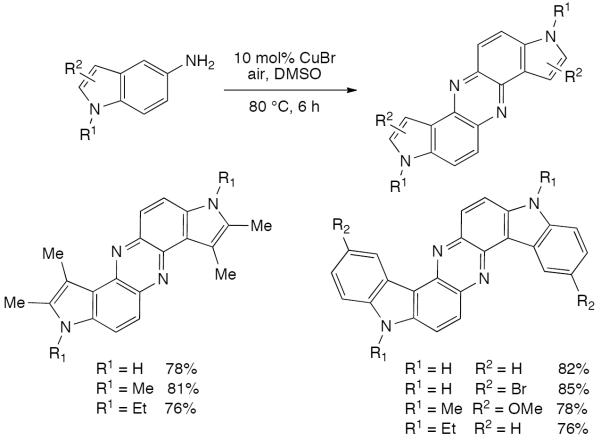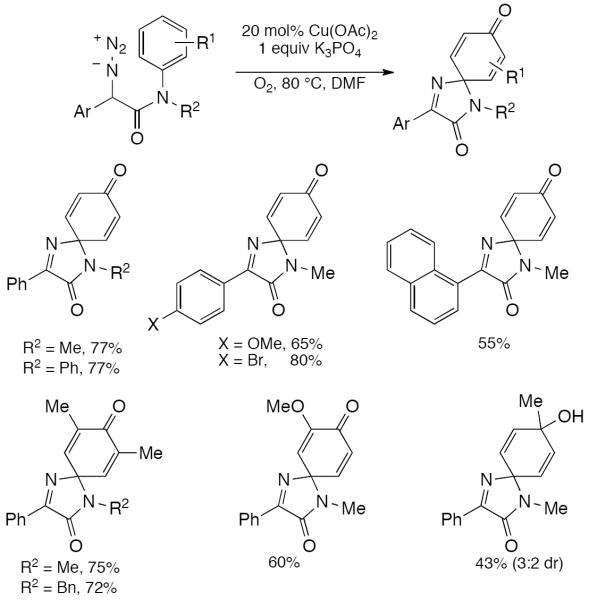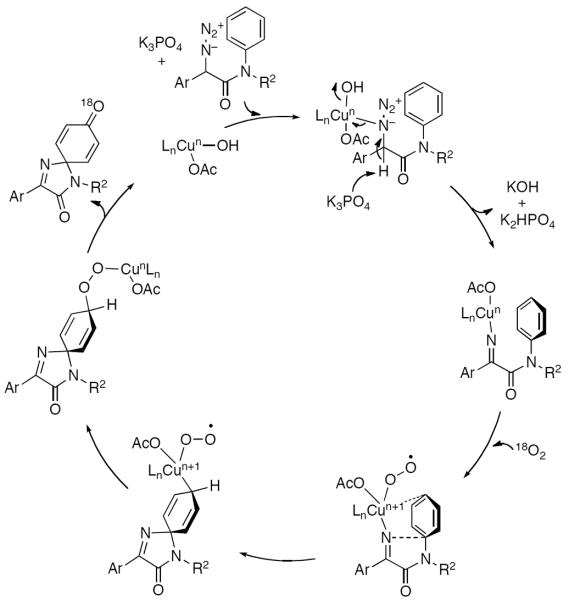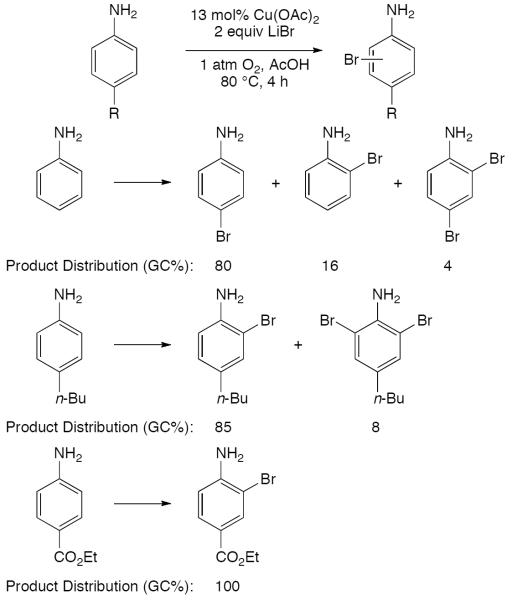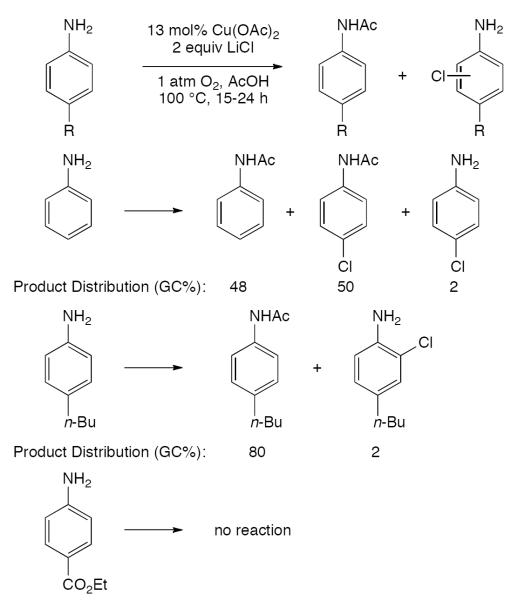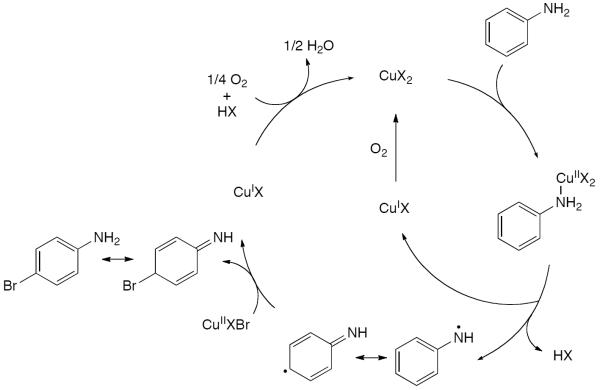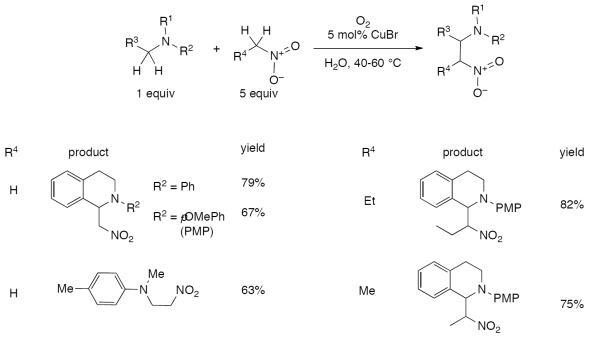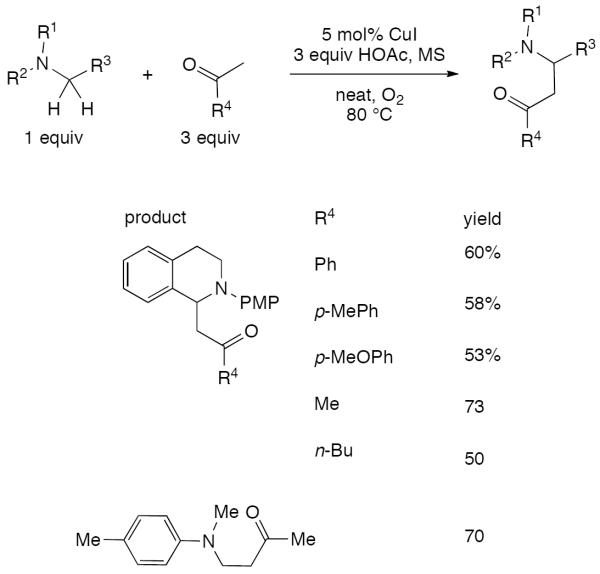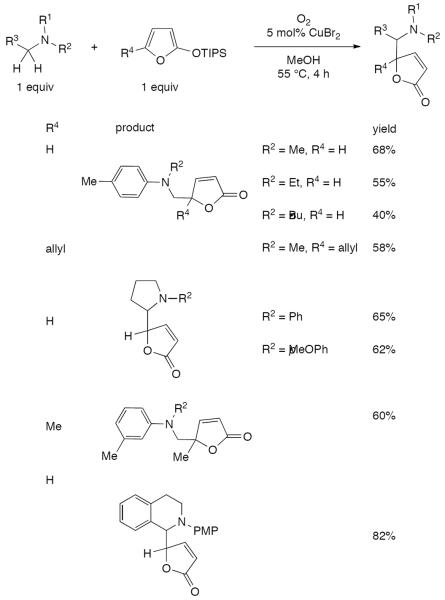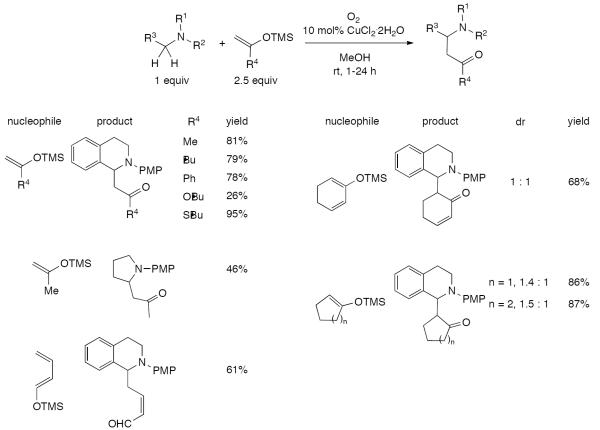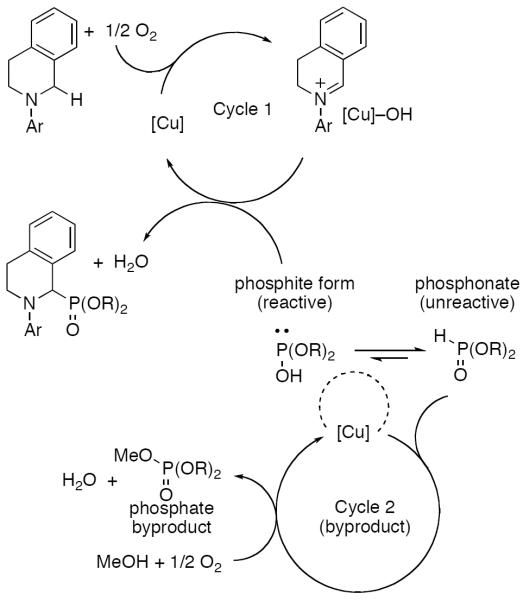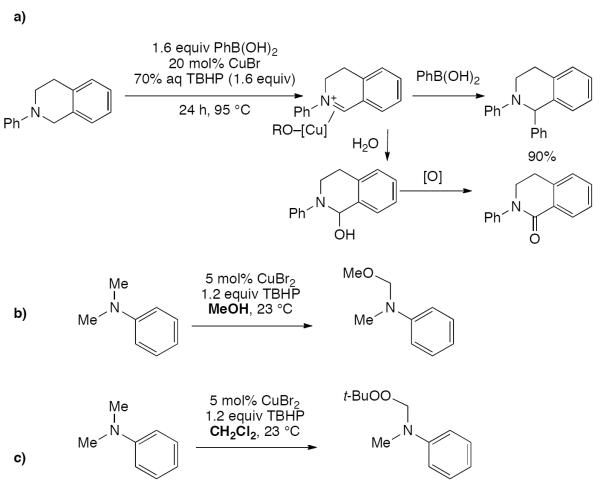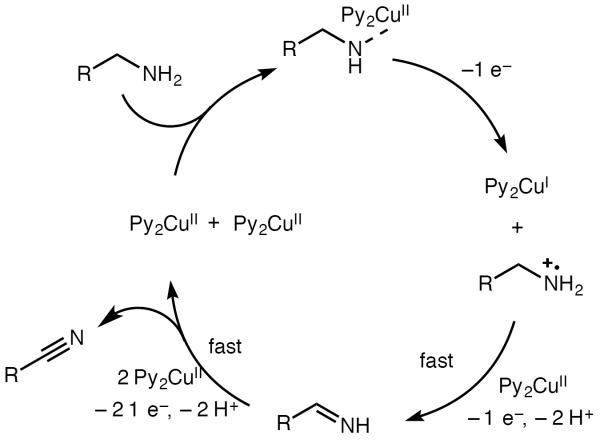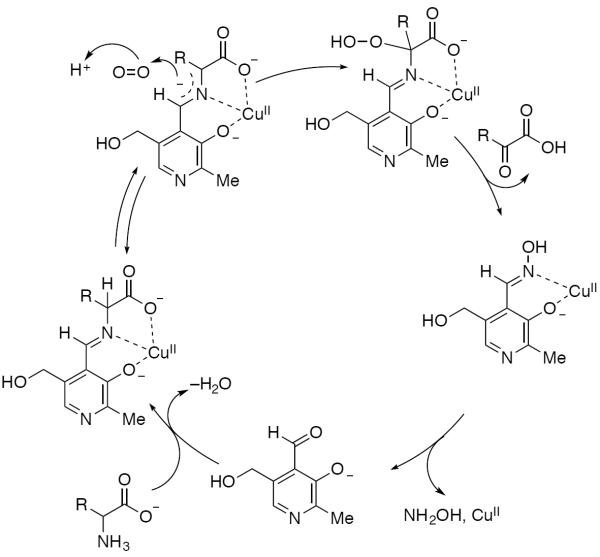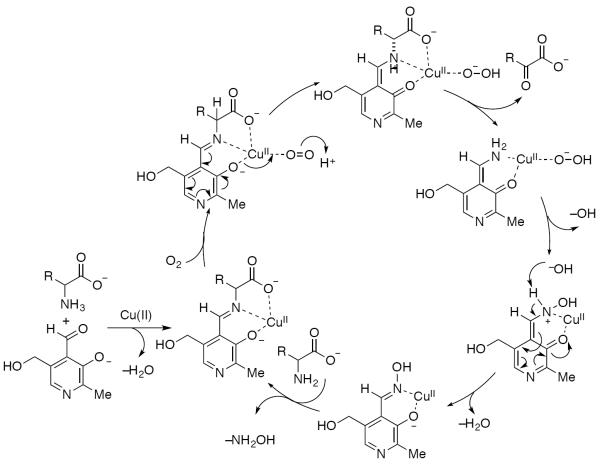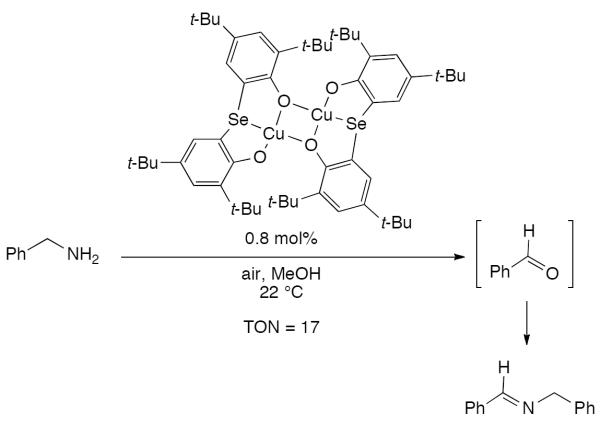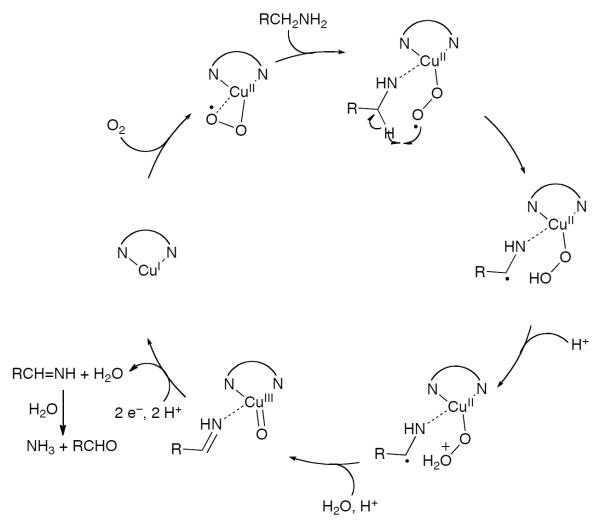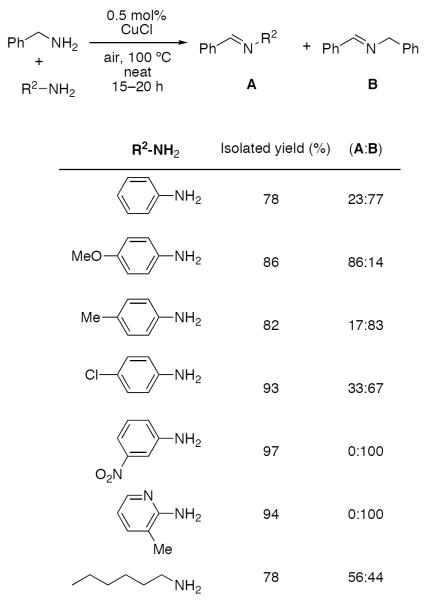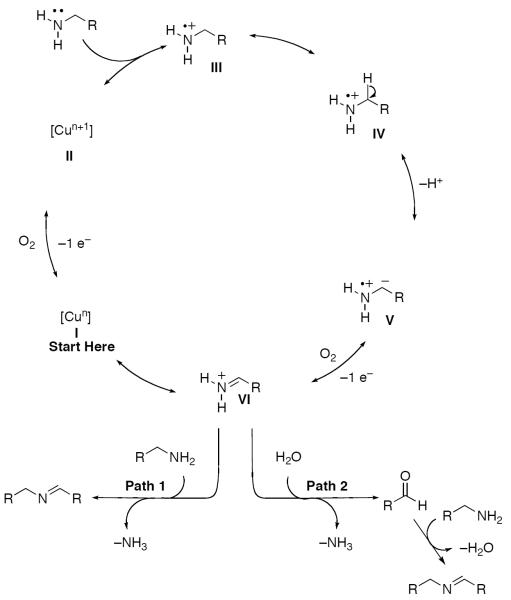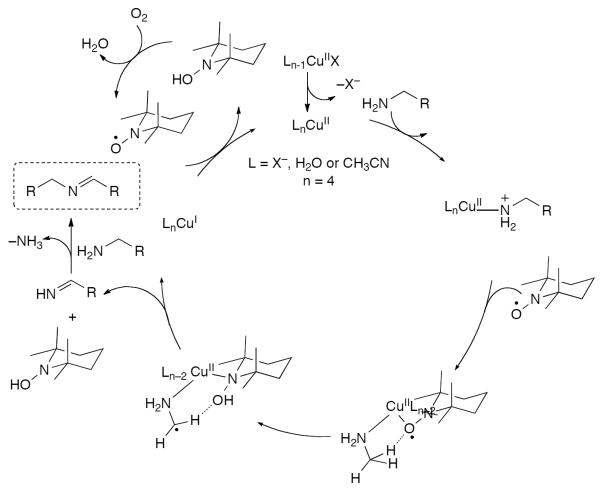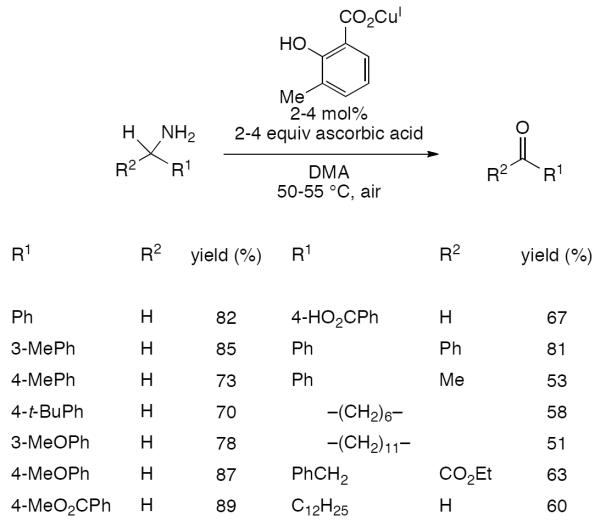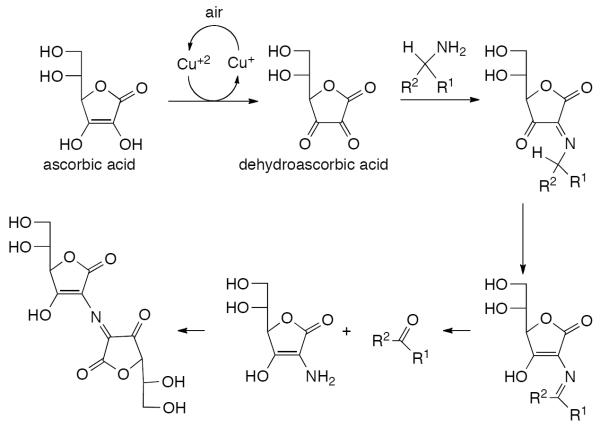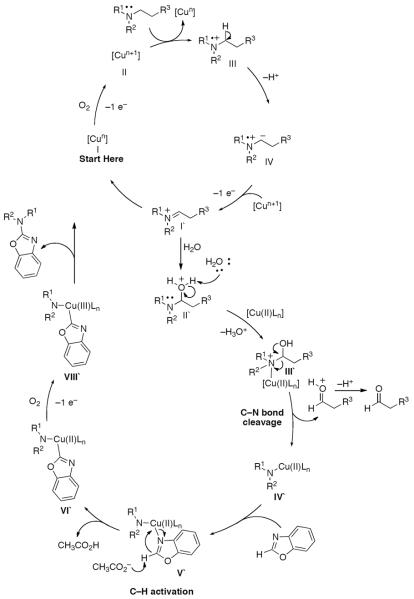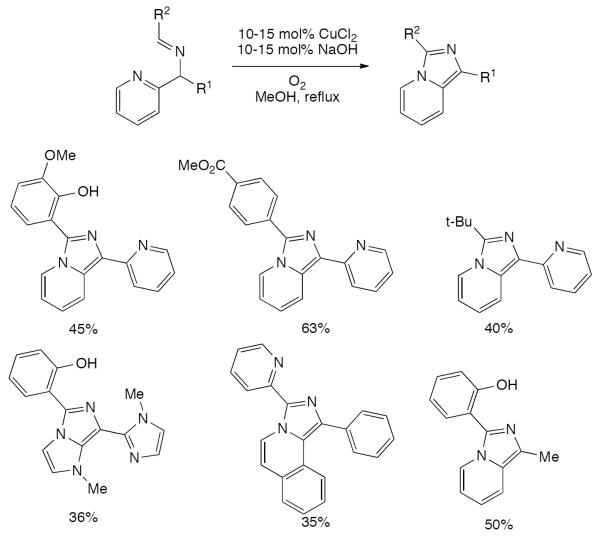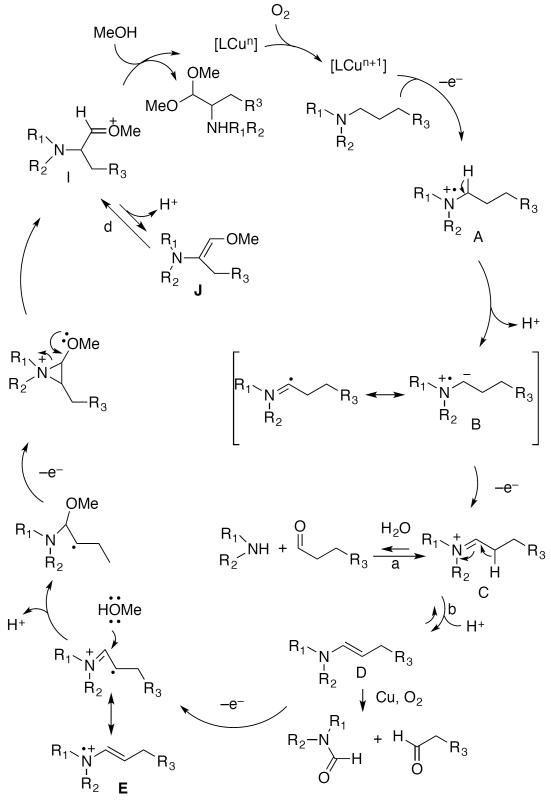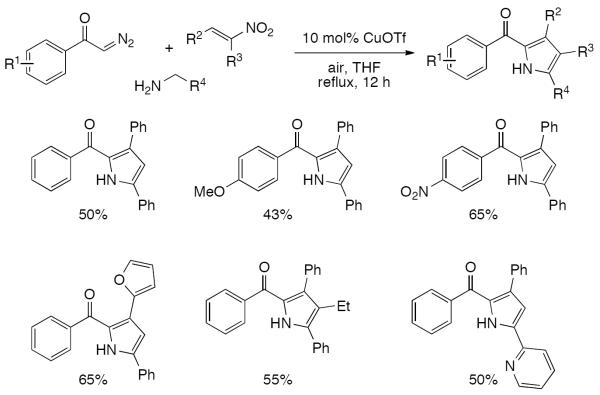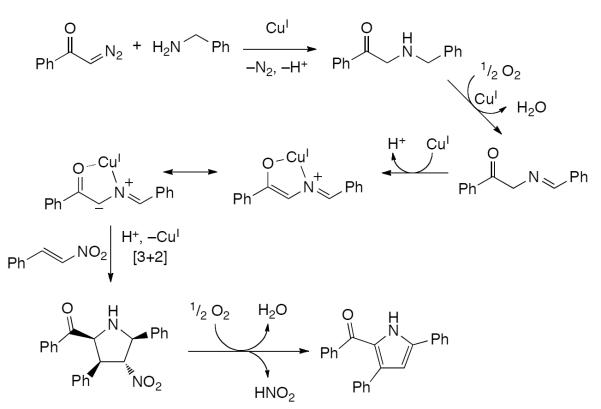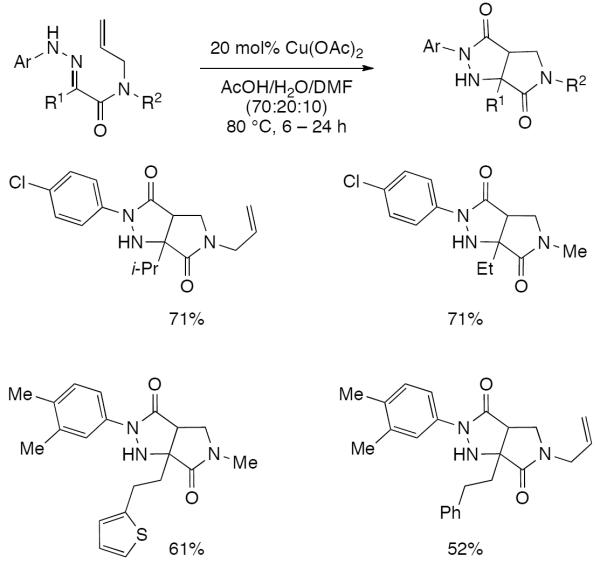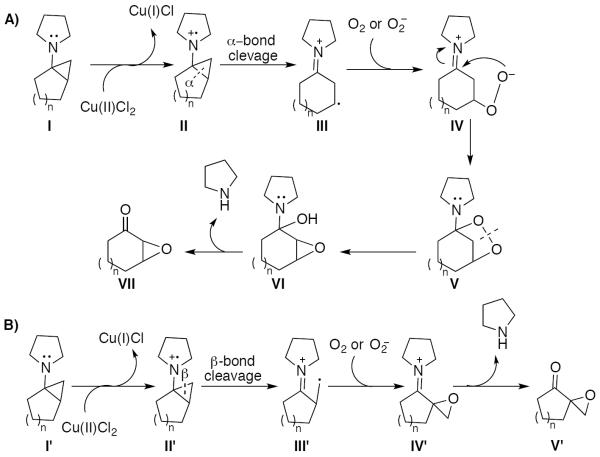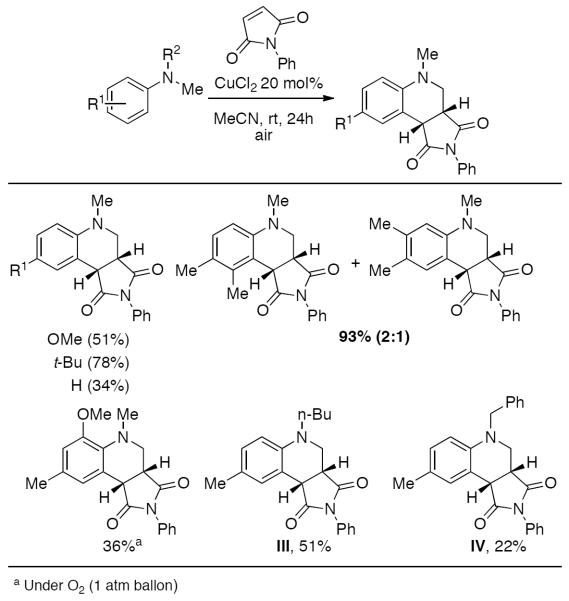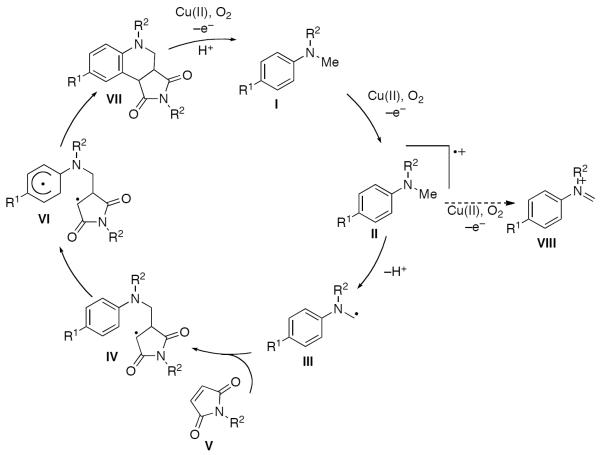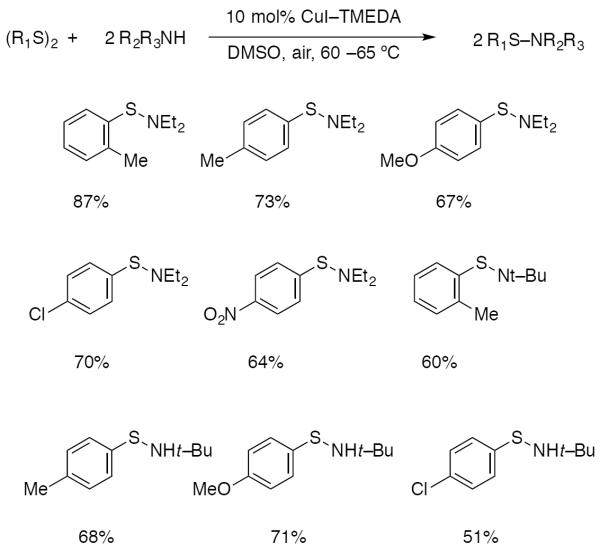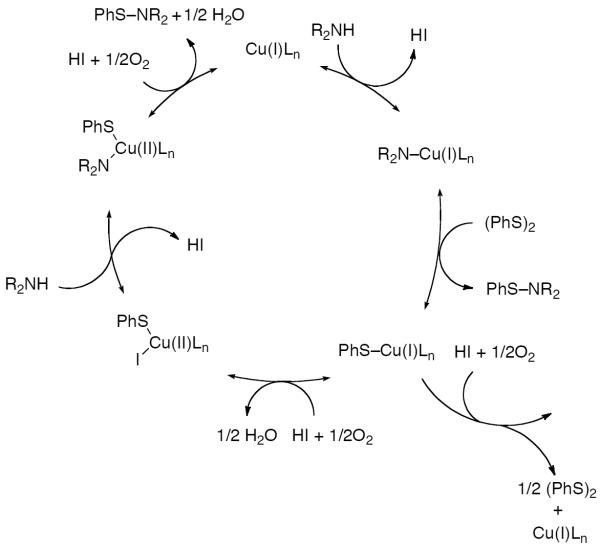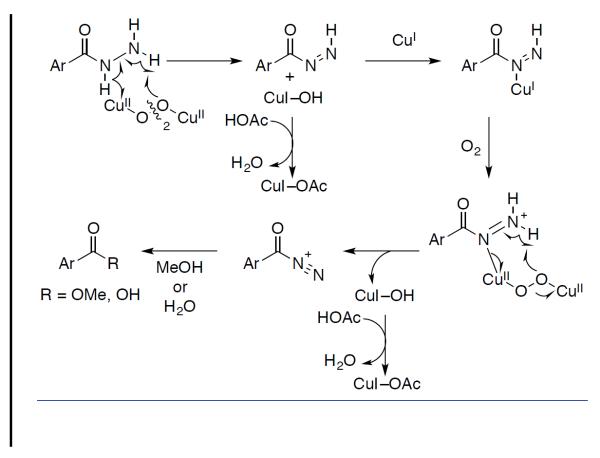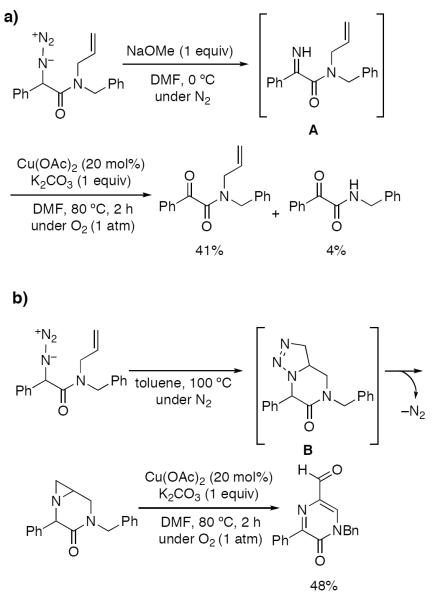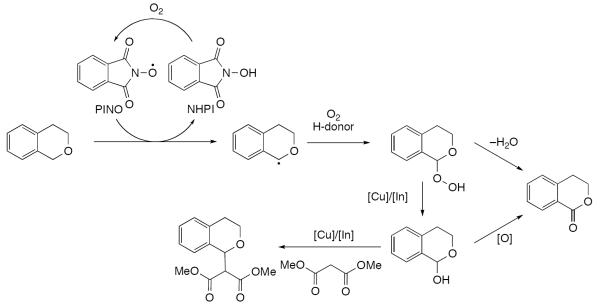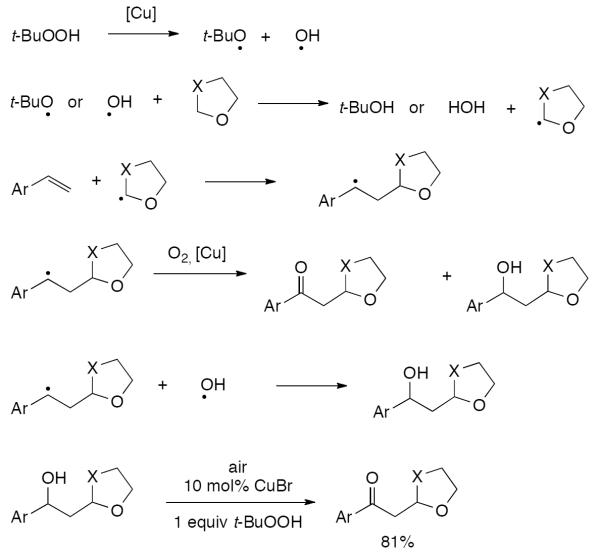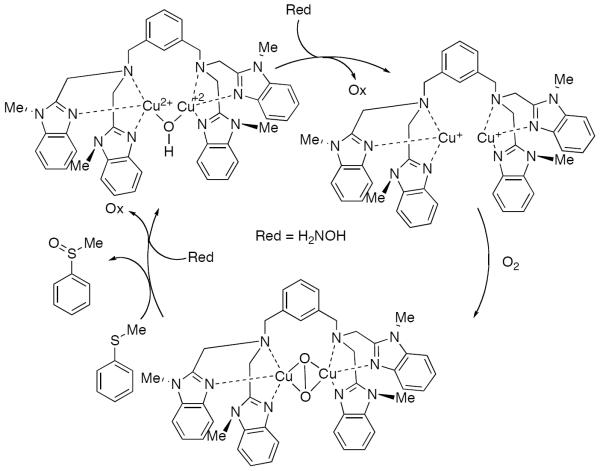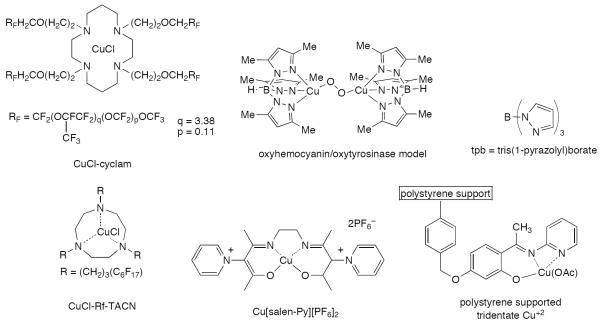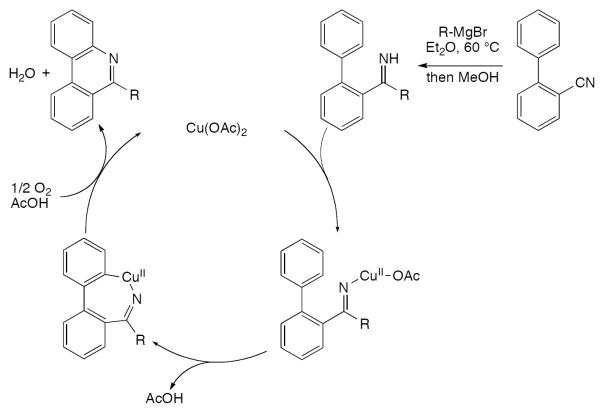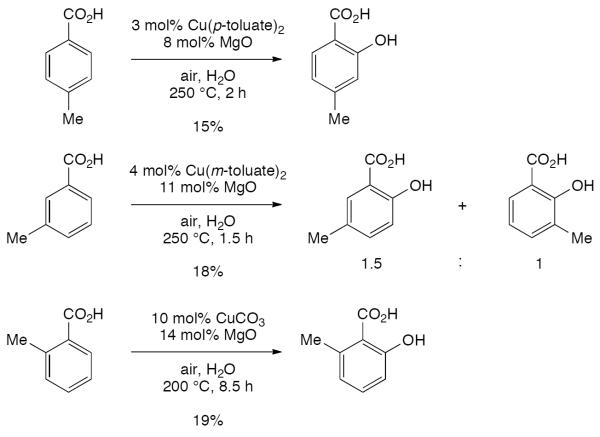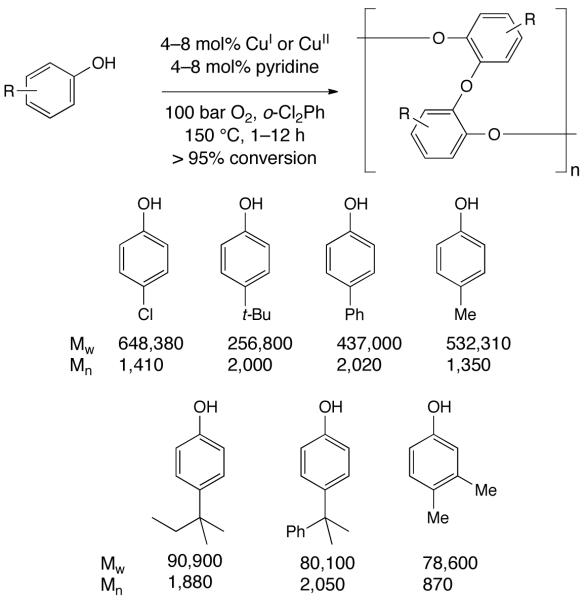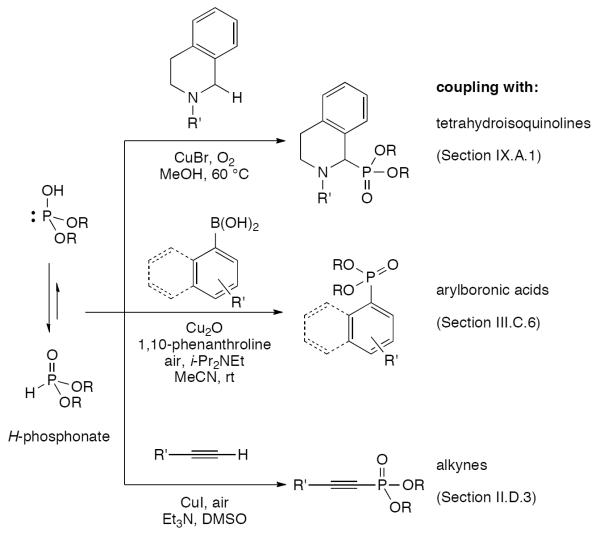I. Introduction and Scope
The chemistry of copper is extremely rich because it can easily access Cu0, CuI, CuII, and CuIII oxidation states allowing it to act through one-electron or two-electron processes. As a result, both radical pathways and powerful two-electron bond forming pathways via organmetallic intermediates, similar to those of palladium, can occur. In addition, the different oxidation states of copper associate well with a large number of different functional groups via Lewis acid interactions or π-coordination. In total, these feature confer a remarkably broad range of activities allowing copper to catalyze the oxidation and oxidative union of many substrates.
Oxygen is a highly atom economical, environmentally benign, and abundant oxidant, which makes it ideal in many ways.1 The high activation energies in the reactions of oxygen require that catalysts be employed.2 In combination with molecular oxygen, the chemistry of copper catalysis increases exponentially since oxygen can act as either a sink for electrons (oxidase activity) and/or as a source of oxygen atoms that are incorporated into the product (oxygenase activity). The oxidation of copper with oxygen is a facile process allowing catalytic turnover in net oxidative processes and ready access to the higher CuIII oxidation state, which enables a range of powerful transformations including two-electron reductive elimination to CuI. Molecular oxygen is also not hampered by toxic byproducts, being either reduced to water, occasionally via H2O2 (oxidase activity) or incorporated into the target structure with high atom economy (oxygenase activity). Such oxidations using oxygen or air (21% oxygen) have been employed safely in numerous commodity chemical continuous and batch processes.3
However, batch reactors employing volatile hydrocarbon solvents require that oxygen concentrations be kept low in the head space (typically <5–11%) to avoid flammable mixtures, which can limit the oxygen concentration in the reaction mixture.4,5,6 A number of alternate approaches have been developed allowing oxidation chemistry to be used safely across a broader array of conditions. For example, use of carbon dioxide instead of nitrogen as a diluent leads to reduced flammability.5 Alternately, water can be added to moderate the flammability allowing even pure oxygen to be employed.6 New reactor designs also allow pure oxygen to be used instead of diluted oxygen by maintaining gas bubbles in the solvent, which greatly improves reaction rates and prevents the build up of higher concentrations of oxygen in the head space.4a,7 Supercritical carbon dioxide has been found to be advantageous as a solvent due its chemical inertness towards oxidizing agents and its complete miscibility with oxygen or air over a wide range of temperatures.8 An number of flow technologies9 including flow reactors,10 capillary flow reactors,11 microchannel/microstructure structure reactors,12 and membrane reactors13 limit the amount of or afford separation of hydrocarbon/oxygen vapor phase thereby reducing the potential for explosions.
Enzymatic oxidizing systems based upon copper that exploit the many advantages and unique aspects of copper as a catalyst and oxygen as an oxidant as described in the preceding paragraphs are well known. They represent a powerful set of catalysts able to direct beautiful redox chemistry in a highly site-selective and stereoselective manner on simple as well as highly functionalized molecules. This ability has inspired organic chemists to discover small molecule catalysts that can emulate such processes. In addition, copper has been recognized as a powerful catalyst in several industrial processes (e.g. phenol polymerization, Glaser-Hay alkyne coupling) stimulating the study of the fundamental reaction steps and the organometallic copper intermediates. These studies have inspiried the development of nonenzymatic copper catalysts. For these reasons, the study of copper catalysis using molecular oxygen has undergone explosive growth, from 30 citations per year in the 1980s to over 300 citations per year in the 2000s.
A number of elegant reviews on the subject of catalytic copper oxidation chemistry have appeared. Most recently, reviews provide selected coverage of copper catalysts14 or a discussion of their use in the aerobic functionalization of C–H bonds.15 Other recent reviews cover copper and other metal catalysts with a range of oxidants, including oxygen, but several reaction types are not covered.16 Several other works provide a valuable overview of earlier efforts in the field.17 This review comprehensively covers copper catalyzed oxidation chemistry using oxygen as the oxidant up through 2011. Stoichiometric reactions with copper are discussed, as necessary, to put the development of the catalytic processes in context. Mixed metal systems utilizing copper, such as palladium catalyzed Wacker processes, are not included here. Decomposition reactions involving copper/oxygen and model systems of copper enzymes are not discussed exhaustively. To facilitate analysis of the reactions under discussion, the current mechanistic hypothesis is provided for each reaction. As our understanding of the basic chemical steps involving copper improve, it is expected that many of these mechanisms will evolve accordingly.
II. Reactions of Hydrocarbons
Enzymatic copper-dioxygen derived species are highly effective in aliphatic and arene C-H bond hydroxylations with examples including dopamine β-monooxygenase, peptidylglycine α-amidating monooxygenase, and particulate methane monooxygenase. Much effort has focused on biomimetic versions, attempting to achieve the high selectivity and reactivity of these enzymatic systems with small molecule copper catalysts and oxygen, typically via radical intermediates. While considerable progress has been made, general, selective functionalization of C-H groups is not yet efficient as a standard synthetic procedure for a range of structures. Both selectivity and reactivity remain as significant challenges. In the section below, the progress to date for oxygenation of different classes of hydrocarbons, including benzylic, alkyl, alkenyl, alkynyl, and aryl (Scheme 1), is outlined.
Scheme 1.
Copper-catalyzed oxidations of hydrocarbons.
II.A. Benzylic Oxidation
Benzylic oxidation is aided by the much weaker benzylic C–H bond, aiding in processes involving radical abstraction. Consequently, conditions are generally milder than those seen for alkane or arene oxidation. Oxidation occurs through two primary mechanisms. In acidic or activated substrates, deprotonation can occur, followed by single electron oxidation to form the key radical species that then reacts with molecular oxygen. As demonstrated below, these processes can be highly efficient, but are inherently limited in scope. In unactivated substrates, the benzylic radical species is formed directly via hydrogen abstraction. These operations typically require more forcing conditions, and efficiency and selectivity remain significant obstacles. For both modes of oxidation, controlling the degree of oxygenation is critical since the acid, aldehyde, or alcohol can be produced. As of yet there is no general catalyst available for a broad range of substrates. However, a variety of different copper catalysts have been devised that operate on electron-poor or electron-rich substrates.
II.A.1 Oxygenation of Acidic Benzylic Positions
Highly acidic benzylic substrates undergo oxidation more readily by virtue of the greater acidity allowing facile oxidation via benzyl anion. Although the scope of these transformations is fairly narrow, several useful cases with copper catalysts have been reported. For example, efficient conversion of nitrotoluene to nitrobenzoic acid (Scheme 2a) has been demonstrated in the presence of sodium hydroxide and a copper phthalocyanine catalyst under 2 MPa of oxygen.18 High selectivity was observed, with only trace amounts of the alcohol and the aldehyde formed. The process was later demonstrated to proceed in an ionic solvent (Scheme 2b).19 Although slightly higher temperature was necessary, simple acidification of the aqueous layer conveniently provided the pure product and allowed recycling of the ionic liquid solvent, lending the process amenable to large scale industrial applications. Notably, other metal catalysts gave superior results in this transformation and only one substrate was demonstrated with the copper catalyst.
Scheme 2.
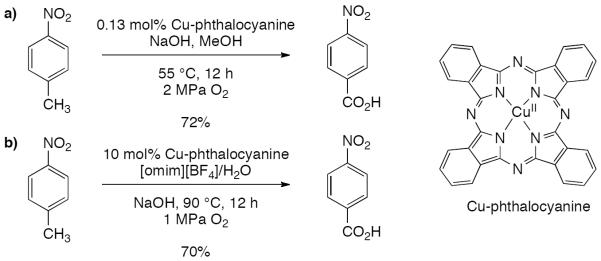
Selected oxidations of nitrotoluene.
In an early report by Allara20, fluorene was readily oxidized to fluorenone at room temperature using Cu(OBz)(OMe) with triethylenetetraamine (trine) as a ligand and pyridine/MeOH as solvent. Despite only moderate conversion, excellent selectivity (200:1) of corresponding ketone to homocoupled 9,9'-bifluorene was observed (Scheme 3). The proposed mechanism proceeds through oxidation of the fluorenyl anion by copper, coupling of the radical with molecular oxygen, and decomposition of the resulting peroxide by base deprotonation to give the ketone product. Kinetic studies using 9,9'-didueterofluorene indicated that the rate-limiting step was deprotonation of the substrate. Although the oxidation proceeded in the presence of base (NaOMe) and oxygen, the addition of copper catalyzed increased the rate by ~500 fold.
Scheme 3.

Copper(II)-catalyzed oxygenation of fluorene.
Activated substrates can also be oxidized without strongly basic conditions via a similar system as for unactivated systems (see next Section II.A.2). A striking example by Züberbuhler and coworkers centers the facile copper-mediated oxidation of bis(1-methyl-benzimiazol-2-yl)methane (Scheme 4).21 Full conversion to the respective ketone is effected using just 0.2 mol% Cu(ClO4)2 at room temperature under 1 atm O2.
Scheme 4.

Oxidation of bis(1-methyl-benzimiazol-2-yl)methane.
Little incorporation of 18O at the carbonyl carbon was observed when performing the reaction in a vast excess of D218O, indicating that dioxygen is supplying the ketone oxygen. While Co+2 displayed comparable catalytic activity, Fe+2, Fe+3, Zn+2, Ni+2, and Mg+2 did not significantly increase the rate over background. Significantly, addition of either base or acid strongly inhibited the reaction. No product was detected when subjecting 1,2-dimethylbenzimidazole or any higher bis(1-methyl-benzimidazolyl)alkanes to the reaction conditions, illustrating the necessity of the doubly pseudobenzyilic position. Despite these limitations to the generality of the oxidation, the method was also effectively adapted to bis(2-pyridyl)methanes.22 One mechanism that is consistent with the data for this reaction is formation a benzylic radical intermediate that undergoes reaction with dioxygen. On the other hand, deprotonation and subsequent anion oxidation is also viable and is most likely occurring for those systems that incorporate strong bases (Scheme 2, Scheme 3). For those cases without base (Scheme 4, Scheme 5), metal-assisted deprotonation has been raised as a possibility.22
Scheme 5.
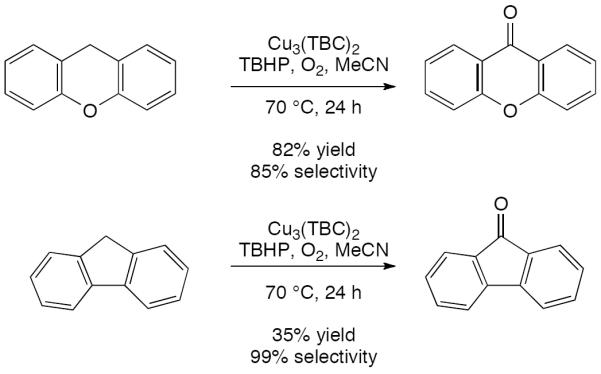
Cu3(TBC)2 catalyzed oxidation of xanthene and fluorene.
Garcia and coworkers tested the oxidation of xanthene, another doubly benzylic system, using a metal organic framework composed of 1,3,5-benzenetricarboxylate (BTC).23 Although the most selective metal was found to be Fe+2, Cu3(BTC)2 also provided the ketone product at 70 °C in good yield and usable selectivity (Scheme 5). Under the same conditions, fluorene could also be converted to fluorenone in moderate conversion but excellent selectivity. The catalysts were easily recovered and could be reused after drying with minimal loss in activity.
II.A.2 Oxygenation of Unactivated Benzylic Substrates
Benzylic oxygenation of simple hydrocarbons using molecular oxygen represents a highly desirable process, particularly on an industrial scale. Enzymatic systems are capable of performing such oxidations very well24, and biomimetic systems have been identified. For example, Karlin and coworkers have recently reported the synthesis of a dicopper(II)-μ-1,2-peroxo complex at low temperatures (−80 °C).25 Allowing the complex to warm to ambient temperature in the presence of a toluene or ethylbenzene caused thermal decomposition of the complex with concomitant benzylic oxidation. Experiments using complexes formed with 18O2 demonstrated that oxygen incorporation occurred from molecular oxygen. A copper peroxo complex stable at room temperature was similarly reported using tetraamine tripodal ligands.26 Reaction of the complex with toluene at room temperature yielded benzaldehyde in 20% yield. Despite the impressive activity of these biomimetic systems, turnover has yet to be achieved.
Several examples using copper catalysis to achieve oxygenation of aliphatic substrates have been reported, yet both conversion and selectivity remain significant challenges on unactivated substrates. An important aspect is that the initial oxygenation product, the hydroperoxide or peroxide anion, can readily convert to the alcohol and ketone in the presence of a metal catalyst. Consequently, a mixture of oxygenated products, including peroxide, alcohol, and carbonyl compounds are often obtained.
While several investigations have probed the oxidation of benzylic compounds that do not proceed via anionic intermediates27, the exact mechanism is currently unknown. The complete inhibition of the reaction in the presence of radical trapping agents suggests a radical chain pathway. Alternately, direct hydroxylation by metal oxo insertion into the benzylic C–H bond, mimicking the oxidation of alkanes by cytochrome P450, would also be consistent with this finding. However, the hydroperoxide intermediates have been demonstrated28,29 in many cases, pointing away from this theory. The subsequent metal-catalyzed degradation to the alcohol and ketone products are well-established.
Based on these observations, the key benzyl radical intermediate reacts with molecular oxygen to form the peroxo radical, which continues propagation via benzylic hydrogen abstraction (Scheme 6). The radical initiation can occur via several modes. In some cases, reaction occurs in the absence of an obvious radical initiator. The high temperatures and long induction periods in these examples point to a thermolytic radical formation. Alternatively, several radical initiators have been employed in the presence of a copper catalyst. Commonly, a peroxide is employed, although a sacrificial aldehyde, which converts to the peroxide in situ under the reaction conditions, may also be used. In these cases, homolytic cleavage of the peroxide would provide a radical that could initiate the radical chain reaction. However, in the presence of a copper catalyst, reaction of the peroxides with the copper is likely to occur more rapidly giving rise to a [CuIII–O·] species, which, in turn, initiates the reaction via benzylic hydrogen abstraction.28 Consistent with these theories, other radical initiators/mediators such as H2O2, t-BuOOH, AIBN, and ACBN have been used in conjunction with copper catalysts. In a different paradigm, a stabilized N–O radical mediator such as N-hydroxyphthalimide (NHPI) has been used as a radical mediator, which is reoxidized by the copper catalysts.30 In some of these reactions, it is highly likely that more than one pathway operates (e.g., [CuIII–O·] and peroxyl radical).
Scheme 6.
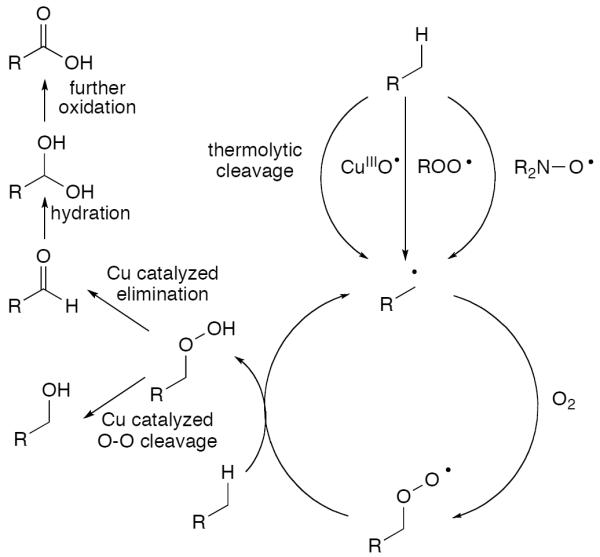
General mechanism for benzylic oxidation of unactivated substrates.
Table 1 displays the results of oxidation on a variety of unactivated benzylic substrates. As illustrated, the success of the reaction varies based on substrate and initiator. Oxidation of several substrates has been achieved with varied success without utilizing a clear initiator. For example, Gardner demonstrated the heterogeneous oxidation of p-xylene, a challenging substrate, simply using CuBr and catalytic LiBr, but very high temperature and O2 pressure were required to achieve even low conversion (Table 1, entry 2).31 While the aldehyde was obtained as the major product, overoxidation to the acid as well as diaryl products were observed. Interestingly, other substrates demonstrated very poor selectivity using these conditions, and toluene was converted almost exclusively to benzyl bromide. Oxidation of cumene to cumyl hydroperoxide represents an industrially significant process that accounts for the majority of the global production of both phenol and acetone.32 A selective oxidation of cumene was reported by Cheng and coworkers, in which Cu(OAc)2 on Chelex® was used as a heterogeneous catalyst in the absence of a radical initiator (Table 1, entry 12).33 Although only minor conversion is observed, the hydroperoxide is formed in almost perfect selectivity, with only trace (<1%) alcohol detected (Scheme 7).
Table 1.
Benzylic oxidation of unactivated hydrocarbons.
| product distribution (%) | |||||||||
|---|---|---|---|---|---|---|---|---|---|
| entry | substrate | radical initiator | catalysta | conditions | conv (%) | hydroperoxide | alcohol | carbonyl | ref |
| 1 | Toluene | HPPDO | CuCl2 | 4.9 atm O2, | 71 | 4:94b | 43 | ||
| 2 | p-Xylene | none | CuBr | cat LiBr, 7.8 atm O2, 150 °C, 2 h | 20 | 88c | 31 | ||
| 3 | Ethylbenzene | aldehyde | CuCl2, 18-Crown-6 | 1 equiv MeCHO, 1 atm O2, CH2Cl2, 24 h, rt | 8.5 | 24 | 76 | 34a | |
| 4 | peroxide | [CuI(pyr)(tpb)] | 1 mol% TBHP, 1 atm O2, 1:2 AcOH:pyr, rt, 24 h | 5.8 | 1 | 99 | 35 | ||
| 5 | Indane | aldehyde | Cu(OAc)2 | 1 equiv MeCHO, MeCN/CH2Cl2, rt, 36 h | 35 | 23 | 77 | 42 | |
| 6 | aldehyde | Cu(TPIP)2 | 6 equiv isobutyraldehyde, O2 DCE, rt, 4 h | 49 | 63 | 12 | 24 | 28 | |
| 7 | aldehyde | CuCl2, 18-Crown-6 | 1 equiv MeCHO, 1 atm O2, CH2Cl2, 70 °C, 24 h, rt | 36 | 31 | 69 | 34a | ||
| 8 | Tetralin | none | [Cu(CTZ)2Cl2]2 | 35 atm air, 100 °C, 9 h | 57 | 25 | 75 | 36 | |
| 9 | none | Cu(2-pymo)2 | 1 atm air, 90 °C, 48 h | 52 | 2 | 26 | 71 | 37 | |
| 10 | aldehyde | CuCl2, 18-Crown-6 | 1 equiv MeCHO, 1 atm O2, CH2Cl2, 70 °C, 24 h, rt | 37 | 25 | 75 | 34a | ||
| 11 | peroxide | Cu(OH)2 | cat H2O2, 14.6 atm O2, i-PrOH/DMA, cat FeCl3, 90 °C, 30 min |
49 | 21 | 79 | 38 | ||
| 12 | Cumene | none | Cu(OAc)2 on Chelex | 0.9 atm O2, 80 °C, 12 h | 5.4 | 99 | 33 | ||
| 13 | AIBN | Cu(acac)2, NHPI | 3 mol% AIBN, 1 atm O2, MeCN, 60 °C, 4.5 h | 72 | 19 | 63 | 15 | 30 | |
| 14 | ACBN | Cu(acac)2, NHPI | 3 mol% ACBN, 1 atm O2, benzonitrile, 90 °C, 3 h | 29 | 4 | 26 | 57 | 30 | |
| 15 | Cyclohexyl-benzene | none | α,β,γ,δ-tetraanthracyl-porphinato-copper(II) | 13.6 atm O2, 115 °C, 4.9 h | 14 | 99d | 39, 40 | ||
See Chart 1 for ligand structures.
4:94 benzaldehyde:benzoic acid.
Acid and diaryls were the other major products.
Includes oxidation products at other positions of the cyclohexyl ring.
Scheme 7.

Cumene oxidation with a copper catalyst and oxygen.
Orlinska and Zawadiak attempted the oxidation of more complex substrates, 4,4'-diisopropylbiphenyl and 2,6-diisopropylnaphthalene, using CuCl2 and n-Bu4NBr under oxygen.41 Monoalcohol and peroxide dimers were the major products, along with smaller amounts of ketone, monohydroperoxide, and bishydroperoxide. Trace amounts of substrate underwent oxidation at both benzylic positions.
Oxidations in which a peroxide or aldehyde (which converts to peroxyacid under the reaction conditions) are present in addition to a copper catalyst are often able to avoid the induction periods and high temperatures otherwise associated with these processes. For example, extremely high turnovers (TON = 54,500) have been observed in the room temperature oxidation of indane using copper(II) acetate (0.0006 mol%) in conjunction with acetonitrile, which can function as a ligand, and 1 equivalent of acetaldehyde (Table 1, entry 5).42 Moderate conversion was observed, with indanone as the major product (Scheme 8).
Scheme 8.

Indane oxidation with an aldehyde additive.
Use of N–O radical mediators have also been reported. For example, Orlinska and coworkers studied the oxidation of cumene in the presence of a variety of metals, a radical initiator, and NHPI (Table 1, entry 13–14).30 Interestingly, NHPI in the absence of a metal cocatalyst afforded cumyl hydroperoxide in moderate conversions but excellent selectivity (>99%). Addition of metal salts changed the product distribution, presumably from catalyzing the decomposition of the initial hydroperoxide adduct. Copper was found to be the most effective, affording either the alcohol or rearranged ketone as the major product depending on solvent and temperature. Notably, much higher conversion but poorer selectivity was observed in the oxygenation of cumene when NHPI, radical initiator, and Cu(acac)2 were employed in comparison to the heterogeneous Cu(OAc)2 on Chelex system (Table 1, entry 12–13).
Recently, the selective oxidation of toluene to benzoic acid was reported through the use of a modified NHPI structure in conjunction with CuCl2 (Table 1, entry 1).43 Although elevated temperatures and pressures are used, good conversion to the acid is afforded along with only a minor amount of intermediate benzaldehyde (Scheme 9). The increased activity of the HPPDO catalyst in comparison to NHPI may be attributed to the electron-withdrawing nature of the pyrazine, which creates a more reactive N–O radical. Moreover, a metal additive was demonstrated to bind to the pyrazine nitrogens, further increasing destabilizing the radical and increasing the rate. Copper was found to be the most effective in terms of both conversion and selectivity.
Scheme 9.

Selective oxidation of toluene with N–O radical mediator.
II.A.3 Directed Benzylic Oxidation
A recent report by Chiba and coworker details an effective aerobic benzylic oxidation that operates by employing an ortho-imine as a directing group (Scheme 10).44 The imine is generated in situ via Grignard addition to nitrile-containing substrates followed by protonation with MeOH. Treatment of the imine intermediate with Cu(OAc)2 and 1 atm O2 affords the diketone products upon acidic workup. In certain cases, quenching the reaction with pH 9 buffer afforded the N,O-ketal. The authors further demonstrated the synthetic utility of the method through direct transformation of the products to phthalazines (one-pot) or isoindolines (two-pot). Interestingly, subjecting 2-cyclohexylbenzonitrile to the reaction conditions afforded an aminoperoxide product in good yield, and the structure was secured by X-ray crystallographic analysis (Scheme 11). Performing the reaction under 18O2 provided the diacylbenzene product with labeled oxygens in both carbonyls, suggesting that H218O is produced during the reaction to hydrolyze the imine. The proposed reaction mechanism proceeds through a key iminyl copper species, which reacts with molecular oxygen to form a peroxycopper intermediate (Scheme 12). An intramolecular 1,5-H-shift can give rise to a benzylic peroxycopper species, which releases the active copper species and affords the ketoimine precursor to either diketone or N,O-ketal products.
Scheme 10.
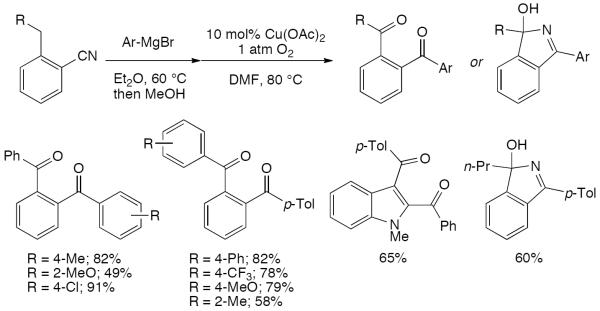
Directed benzylic oxidation.
Scheme 11.

Directed oxygenation to form an aminoperoxide.
Scheme 12.
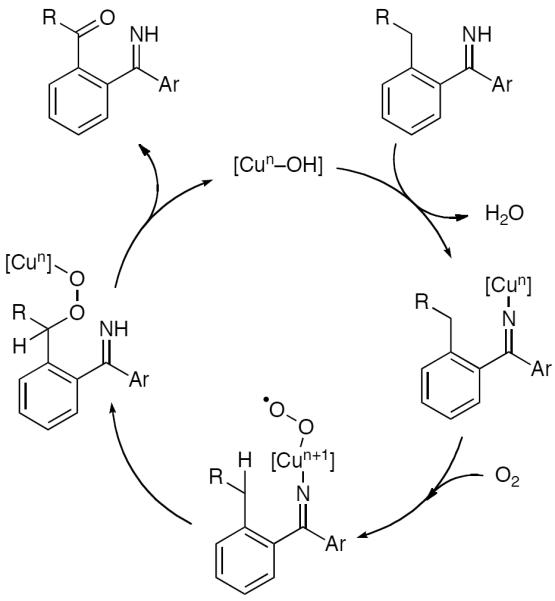
Mechanism for imine-directed benzylic oxidation.
II.A.4 Generation of Nitriles from Benzylic Substrates (Ammoxidation)
The oxidation of hydrocarbons in the presence of both molecular oxygen and ammonia to form nitriles is known as ammoxidation.45 This reaction is a critical industrial process for the production of allylic and benzylic nitriles, such as benzonitrile, acetonitrile, and acrylonitrile.46 As ammoxidation is typically performed using flow reactors, it is not amenable to small, laboratory-scale purposes, and the forcing conditions required generally preclude all but the simplest of substrates. Additionally, the combination of oxygen (an oxidant) with ammonia (a reductant) means that controlling the relative reactivity is crucial.
While several investigations of ammoxidation using copper catalysts have been reported, selectivity, conversion, and scope remain problematic. For example, Solinas and coworkers studied the ammoxidation of 1-methylnaphthalene in the presence of copper impregnated Na-Mordenite as a solid support catalyst (Scheme 13).47 The copper additive was found to increase conversion while only slightly modifying selectivity. However, even at 350 °C only slight conversion was observed with an 85% selectivity of oxidation at the benzylic position. The process afforded a mixture of products, with significant amounts of both the aldehyde and nitrile forming. In accord with the proposed mechanism involving an aldehyde intermediate (see below), formation of nitrile products was only observed when aldehydes were also detected.
Scheme 13.

Ammoxidation using Cu-impregnated mordenite.
Using Cu impregnated zeolites (Cu-H-ZSM-5) under NH3/O2 at 400 °C and 450 °C, para-xylene has been shown to react more quickly than meta-xylene (~90% selectivity) giving rise to para-tolylnitrile.48 A broader investigation by Chon and Kim surveyed a series of metal impregnated ZSM5 zeolite catalysts in the ammoxidation of benzylic hydrocarbons.49 Compared to the other metals tested (Mn2+, Co2+, Ni2+, Zn2+, Ag+1), Cu2+ was found to be the most active and selective. At 400 °C, good conversions were obtained, particularly for more electron-rich substrates, as is consistent with a process involving formation of benzylic radicals (Scheme 14). However, this high temperature led to significant demethylation, presumably via decarboxylation of an overoxidized carboxylic acid intermediate. While substituted toluenes generally formed considerable amounts of dealkylation products, picolines yielded the corresponding nitriles in excellent conversion and selectivity.
Scheme 14.
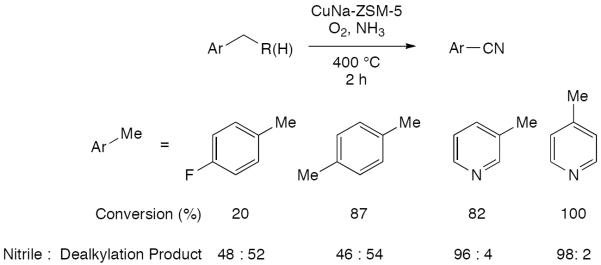
Ammoxidation using CuNa-ZSM-5.
When the reaction was performed using benzyl alcohol, benzylamine, or benzaldehyde as the substrate, benzonitrile was formed in >90% selectivity with full conversion. Additionally, no conversion of toluene in the absence of oxygen flow was detected up to 500 °C. These results support a general mechanism similar to that described in Section II.A.2, in which the key benzyl radical combines with molecular oxygen. Condensation of the intermediate aldehyde with ammonia affords an N–H imine (Scheme 15), which upon further oxidation would provide the nitrile product (see Section V.B and Section IX.A.4). The exact mechanism for the final oxidation remains unclear, but oxidation via an N,O-acetal is plausible.
Scheme 15.

General mechanism of ammoxidation.
II.B. Alkane Oxidation
Aerobic oxidation of alkanes employing copper catalysts shares many of the characteristics of benzylic analogs. Owing to the higher C–H bond strength in alkanes, more forcing conditions are required. As a result, control of regioselectivity is challenging and formation of overoxidized and elimination products is common. Current efforts are primarily focused on the conversion of base hydrocarbon building blocks into their more oxygenated analogs, vital industrial processes. An important, and highly studied case, is the conversion of cyclohexane to cyclohexanone, a key precursor to caprolactam. Commercially, this process is achieved via aerial oxidation using pressurized air at ~160 °C in the presence of a homogeneous cobalt catalyst, providing a mixture of cyclohexanone, cyclohexanol, and cyclohexyl hydroperoxide as approximately 70–90% of the product at <6% conversion.50 Table 2 provides an overview of the reported oxidations of alkanes using copper catalysts, organized by substrate.
Table 2.
Alkane oxidation with copper catalysts.
| product distribution (%) | ||||||||
|---|---|---|---|---|---|---|---|---|
| entry | substrate | radical initator | catalysta | conditions | conv (%) | ketone | alcohol | ref |
| 1 | Cyclohexane | none | CuSO4·5H2O on functionalized silica | Zn0, AcOH, 1 atm O2, 24 h, rt | 0.6 | 90 | 10 | 60 |
| 2 | none | Cu0 on functionalized silica | Zn0, AcOH, 1 atm O2, 24 h, rt | 1.3 | 85 | 15 | 60 | |
| 3 | none | Cu nanoparticles on TiO2 | 20 atm O2, 120 °C, 24 h | 11.5 | 92 | 8 | 55 | |
| 4 | none | Cu nanoparticles on γ-Al2O3 | 20 atm O2, 120 °C, 24 h | 13.7 | 58 | 42 | 55 | |
| 5 | none | Cu nanoparticles on Fe2O3 | 20 atm O2, 120 °C, 24 h | 14.2 | 34 | 66 | 55 | |
| 6 | none | 1:2 CuCl2:1,10-phenanthroline | 2 equiv K2CO3, MeCN, air, rt, 72 h | 24.4 | 100 | 0 | 58 | |
| 7 | aldehyde | CuCl2, 18-crown-6 | 1 equiv MeCHO, 1 atm O2, CH2Cl2, 70 °C, 24 h | 4.1 | 76 | 24 | 34a | |
| 8 | aldehyde | Cu(OH)2 | 3 equiv MeCHO, 1 atm O2, CH2Cl2, rt, 17 h | 4.5 | 58 | 38 | 53 | |
| 9 | aldehyde | CuIICl16Pc-AM(PS) | 3 equiv PhCHO, MeCN, 1 atm O2, 50 °C | 9.4 | 68 | 32 | 61 | |
| 10 | peroxide | CuI(pyr)(tpb) | 1 mol% TBHP, 1 atm O2, 1:2 AcOH:pyr, rt, 24 h | ~1 | 87 | 13 | 35 | |
| 11 | peroxide | Cu(en)2(NO3)2 | 11 mol% TBHP, 25 bar O2, 70 °C, 24 h | 4.9 | 26 | 43b | 52 | |
| 12 | peroxide | Cu(OPiv)2 | 11 mol% TBHP, 25 bar O2, 70 °C, 24 h | 5.0 | 28 | 38c | 52 | |
| 13 | peroxide | CuII(H2O)4(arhpd)2 | 10 equiv H2O2, HNO3, MeCN/H2O, air, rt 6 h | 19.8 | 10.9 | 8.9d | 62 | |
| 14 | halogen lamp irradiation | CuCl2·2H2O | 1 atm O2, 13 °C, MeCN, 18 h | 58 | 22 | 24 | 57c | |
| 15 | Cycloheptane | peroxide | Cu@SiCN | 2 mol% TBHP, 20 bar air, 80 °C, 75 h | 6.0 | 68 | 25 | 54 |
| 16 | Cyclooctane | aldehyde | CuCl2, 18-crown-6 | 1 atm O2, MeCHO, CH2Cl2, 70 °C, 24 h | 4.6 | 80 | 20 | 34a |
| 17 | aldehyde | Cu(OH)2 | 3 equiv MeCHO, 1 atm O2, CH2Cl2, rt, 17 h, | 9.9 | 88 | 9 | 53 | |
| 18 | peroxide | Cu(fod)2 | 18 mol% TBHP, 60 °C, 24 h, air | 6.0 | 38 | 14e | 51 | |
| 19 | peroxide | Cu(fod)2 | 18 mol% TBHP, 60 °C, 24 h, Ar | 11.3 | <2 | <1e | 51 | |
| 20 | peroxide | Cu(fod)2 | 18 mol% TBHP, 60 °C, 24 h, O2 | 13.4 | 77 | 19e | 51 | |
| 21 | peroxide | Cu@SiCN | 2 mol% TBHP, 20 bar air, 80 °C, 75 h | 13.9 | 73 | 16 | 54 | |
| 22 | Cyclodecane | peroxide | Cu@SiCN | 2 mol% TBHP, 20 bar air, 80 °C, 75 h | 16.0 | 74 | 19 | 54 |
| 23 | Adamantane | aldehyde | Cu(OH)2 | 3 equiv MeCHO, 1 atm O2, CH2Cl2, rt, 17 h | 29 | 3 | 92f | 53 |
| 24 | peroxide | [CuI(pyr)(tpb)] | 10 mol% TBHP, 1 atm O2, 1:2 AcOH:pyr, rt, 24 h | ~2.5 | 26 | 74g | 35 | |
| 25 | n-Hexane | aldehyde | CuCl2, 18-crown-6 | 1 atm O2, MeCHO, CH2Cl2, 70 °C, 24 h | 2.4 | 91h | 9 | 34a |
| 26 | n-Decane | aldehyde | CuIICl16Pc-AM(PS) | 3 equiv PhCHO, MeCN, 1 atm O2, 50 °C | 15.4 | 100i | 61 | |
See Chart 2 for ligand structures.
Also 28% cyclohexene.
Also 26% cyclohexene.
Mixture of alcohol and hydroperoxide.
Remainder of product is cyclohexene.
Approximately 93:7 of 1-adamantol:2-adamantol.
Approximately 98:2 of 1-adamantol:2-adamantol.
Afforded oxidation products in an approximately 1:1 ratio at the 2- and 3-positions.
Mixture of decanones.
The mechanism for copper-catalyzed oxidation of alkanes (Scheme 16) is similar to that proposed for benzylic substrates (see Section II.A.2). Initial hydrogen abstraction can occur by a thermolytic process, although a peroxide initiator (often in the form of an aldehyde precursor) is more common. The resulting alkyl radical can react with molecular oxygen to form a peroxy radical and enter the propagation cycle. The hydroperoxide can undergo copper-catalyzed elimination or O–O bond scission to form the ketone or alcohol products, respectively.
Scheme 16.
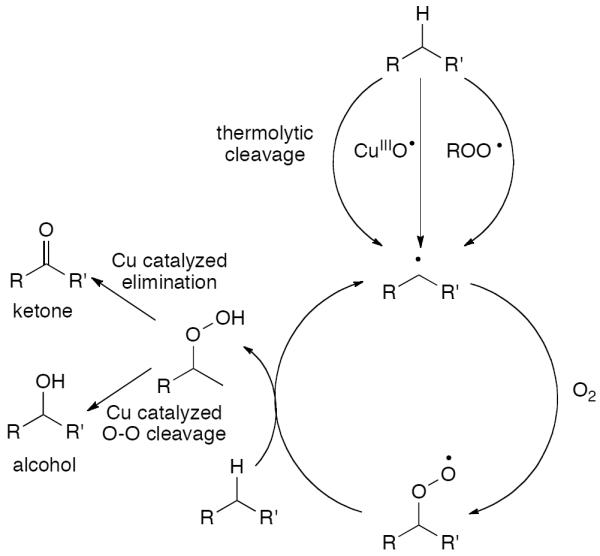
General mechanism for alkane oxidation.
A series of investigations in hydrocarbon functionalization led by Sir Derek Barton involved the use of copper catalyst in the oxidation of alkanes.51 The oxidation of cycloctane with TBHP and homogeneous Cu(fod)2 (fod = 2,2-dimethyl-6,6,7,7,8,8,8-heptafluoro-3,5-octanedionate) under an oxygen atmosphere afforded the ketone in moderate selectivity along with the alcohol and elimination product in low conversions at 60 °C (Scheme 17). Performing the reaction under air or argon drastically changed the product distribution, with the latter nearly exclusively affording the alkene.
Scheme 17.

Oxidation of cyclooctane under various atmospheres.
A later report by Schuchardt and coworkers details the oxidation of cyclohexane with the use of Fe(III) or Cu(II) catalysts and peroxide initiator under pressurized O2 and heat.52 The iron catalysts were found to generate significant quantities of overoxidized adipic acid product, which deactivated the catalyst. Copper provided less overoxidized product, but produced an unselective mixture of ketone, alcohol, alkene, in addition to minor amounts of adipic acid, glutaric acid, cyclohexenol, and cyclohexenone, illustrating the difficulty in controlling these reaction systems (Table 2, entries 11–12). In 1993, Murahashi and coworkers reported the simple oxidation of hydrocarbons using Cu(OH)2 and several equivalents of acetaldehyde as a peroxide precursor.53 At room temperature and 1 atm O2, low conversion to mixtures of ketone and alcohol was observed for cyclohexane, cyclooctane, and adamantane (Table 2, entries 8,17,23). Interestingly, the addition of 18-crown-6 to this copper(II) system was later found to provide much higher activity, allowing extremely high TONs, albeit with still low conversion (Scheme 18).34 The crown ether ostensibly functions via coordination to the copper catalyst, stabilizing an oxo-copper species responsible for initial hydrogen abstraction from the alkane. These assertions are strengthened by the isolation and X-Ray analysis of the crown ether-CuCl2 complex.
Scheme 18.

Copper-crown ether catalyzed oxygenation of alkanes.
Several studies incorporating copper-modified solid supports for heterogeneous oxidation of alkanes have also been reported. For example, Kempe and coworkers recently reported the reaction of cycloalkanes under air with copper-modified SiCN ceramics (Cu@SiCN).54 Oxidation afforded the ketone as the major product, and larger cycloalkanes afforded greater conversions, with cyclohexane affording almost no conversion at all (Scheme 19). The catalysts were formed through the cross-linking of cupper-coordinated poly(oraganosilazanes), and were able to be recycled with only a small loss of activity.
Scheme 19.
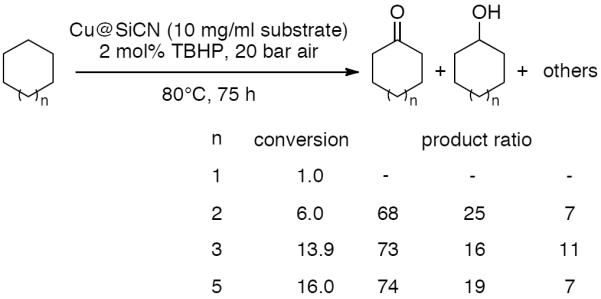
Oxidation of cycloalkanes with copper-modified ceramic.
While the use of a peroxide or peroxide precursor is most common, thermolytic initiation can also occur under more forcing conditions. Copper nanoparticle-doped solid supports were tested for the catalytic oxidation of cyclohexane in the absence of a radical initiator.55 At 20 atm O2 and 120 °C, low conversions (~11–14%) were observed and titanium dioxide was the most selective support, though alumina demonstrated opposite selectivity toward the alcohol (Table 2, entries 3–5). Immobilized copper(II) catalysts on a fiberglass solid support have been studied in cyclohexane oxidation using hydrogen peroxide and molecular oxygen, although selectivities and yields were not reported.56 Interestingly, a series of studies have demonstrated that irradiation with visible light aids initiation in the oxidation of a variety of simple hydrocarbons using copper and oxygen.57 In one report employing CuCl2 as the catalyst, moderate conversion was achieved at comparatively mild conditions (1 atm O2 and 13 °C), yet poor selectivity between the alcohol and ketone products remains an issue, as well as formation of other side products, including alkyl chloride (Table 2, entry 14). In an isolated case, the system of CuCl2, 1-10-phenanthroline, and 2 equivalents of potassium carbonate was reported to oxidize cylohexane to cyclohexanone with 100% selectivity at rt under air (Table 2, entry 6).58 The ratio of phenanthroline ligand to copper was found to be critical to both conversion and selectivity. Though the role of the base is not clear, it is speculated to aid in the initial hydrogen abstraction to allow such facile oxidation. The importance of base in alcohol oxidation, and particularly potassium carbonate, has been reported.59
As demonstrated above, studies on alkane oxygenation are largely restricted to simple and symmetric hydrocarbons due to the lack of selectivity afforded by present systems. Schönecker and coworkers have, in contrast, demonstrated a highly selective hydroxylation of steroidal motifs using a copper and molecular oxygen.63 In this system, an 2-iminopyridyl moiety is effectively used as a directing group, forming a bidentate copper(II) complex. After reduction to copper(I) by benzoin and triethylamine, the complex reacts with molecular oxygen to ultimately afford the β-hydroxylated product after decomplexation and hydrolysis of the directing group.
Working with very simple substrates, a biomimetic oxidation employing a highly active bis(μ-oxo) dicopper species on a zeolite support was found to be effective by Groothaert and coworkers.64 While the process was not catalytic, methane was selectively oxidized to methanol at 398 K and ethane was oxidized to a 4:1 mixture of ethanol:acetaldehyde in just 2 minutes at ambient temperature. The above two examples, while requiring stoichiometric copper species, demonstrate the potential power of mild, selective alkane C–H oxygenation. Development of catalytic variants possessing similar control and reactivity would represent a significant advance in the field.
II.C. Alkene Oxidation
II.C.1. Allylic Oxidation
As was the case for propargylic systems (see preceding section), aerobic oxygenation of allylic systems is complicated by the potential for the unsaturated portion (i.e., the alkene) to also react. Many catalysts and oxidants have been examined to achieve this transformation,65 which has broad utility both in the production of commodity chemicals and in the synthesis of pharmaceuticals and natural products. The use of oxygen as the oxidant in this transformation is still difficult although some examples have been documented.
Typical allylic oxidations using copper and oxygen occur through either thermolytic or peroxide initiated hydrogen abstraction at the allylic position, generally under milder conditions than those for the corresponding alkyl or benzylic substrates (see Sections II.A and II.B). As for the oxidations in the preceding sections, selective formation of the potential oxygenation products (alcohol, carbonyl, peroxide) remains challenging although copper catalysts have been identified that give good conversion and high levels of selectivity.
A key substrate for allylic oxidation is propylene, which is employed in the current process for acrolein production using various multicomponent mixed metal catalysts.66 Studies of copper oxides in a flow reactor for this transformation indicate competing combustion, particularly when the catalyst was oxidized before use.67,68 Even without pre-oxidation, a ratio of ~52:44 acrolein:CO2 was observed, with small amounts of acetaldehyde and propionaldehyde also detected.68 A copper phthalocyanine catalyst on a silica matrix at low loading (<0.1 wt %) has been reported to catalyze the conversion of propene and oxygen to acrolein at 475–500 °C with approximately 50% selectivity and 10% yield.69 A more highly studied substrate is cyclohexene, the oxidation products of which are precursors to many commodity chemicals. Table 3 contains a summary of this transformation with copper catalysts using oxygen.
Table 3.
Allylic oxidation of cyclohexene.
| product distribution (%) | ||||||||
|---|---|---|---|---|---|---|---|---|
| entry | radical initator | Catalysta | conditions | conv (%) | ketone | alcohol | epoxide | ref |
| 1 | peroxide | CuCl-cyclam | 1 mol% TBHP, 1 atm O2, rt, 8 h perfluorohexane | 6 | 75 | 25 | 0 | 70 |
| 2 | peroxide | CuCl-Rf-TACN | 1 mol% TBHP, 1 atm O2, rt, 24 h, perfluoroheptane | 5 | 78 | 22 | 0 | 71 |
| 3 | peroxide | Cu+2 on SBA 15 | 1 equiv H2O2, 1 atm O2, 60 °C, 27 h, MeCN | 84 | 48 | 46 | 1b | 72 |
| 4 | peroxide | CuI(pyr)(tpb) | 1 mol% TBHP, 1 atm O2, 1:2 AcOH:pyr, rt, 24 h | 26 | 91 | 19 | 0 | 35 |
| 5 | peroxide | Cu-polyphthalocyanine | 1 mol% cumyl peroxide, pyridine | – c | 73 | |||
| 6 | none | oxyhemocyanin/oxytyrosinase model | 1 atm O2, CHCl3, rt, 2 h | 6 | 48 | 50 | 2 | 74 |
| 7 | none | Cu[salen-Py][PF6] | 1 atm O2, 78 °C, 22 h, MeCN | 100 | 63 | 31 | 5d | 75 |
| 8 | none | polystyrene supported tridentate Cu+2 | 1 atm O2, 70 °C, 10 h | 52 | 41 | 33 | 2e | 76 |
| 9 | none | CuMOF [Cu(bpy)(H2O)2(BF4)2(bpy)] | 1 atm O2, neat, 45 °C, 15 h | 8 | 7 | 4 | 2f | 77 |
See Chart 3 for ligand structures.
5% diol observed.
Exact conversion and distribution not reported. At lower temperatures, hydroperoxide is the major product, with alcohol and ketone principally forming as the temperature is increased. The alcohol entry typically represents the sum of peroxide and alcohol products generation in the reaction.
~95% allylic selectivity.
24% peroxide observed.
87% peroxide observed.
A report by Quici and coworkers explored the fluorous biphasic oxidation of hydrocarbons using a copper catalyst prepared by N-perfluoroalkylation of the commercially available 1,4,8,11-tetraazacyclotetradecane (Table 3, entry 1).70 In this reaction, the metal catalyst is soluble in perfluorohexane solvent, while the cyclohexene substrate and oxygenated products are immiscible, allowing convenient recycling of the catalytic system. Use of 1 mol % TBHP as an initiator provided a 3:1 mixture of cyclohexenone to cyclohexenol in 6% conversion at ambient temperature (Scheme 21). Notably, no competitive reactivity of the alkene was observed. Under the same conditions, cyclooctane provided less than 1% conversion, demonstrating the higher reactivity of allylic C–H bonds. Further work by Fish and coworkers identified a fluorous-phase copper catalyst able to be recovered and recycled in the oxidation of cyclohexenone (Table 3, entry 2).71
Scheme 21.
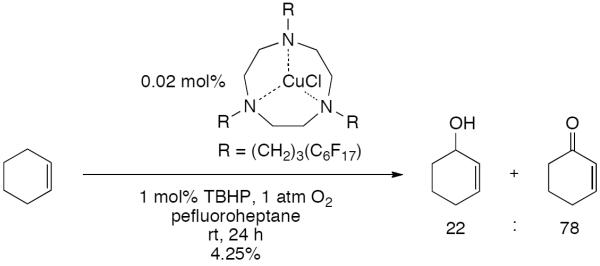
Allylic alkene oxidation with a tetraazacyclotetradecane copper catalyst.
Copper-salen complexes attached to various mesoporous or amorphous silica supports have been tested in the oxidation of cyclohexene (Table 3, entry 3).72 These catalysts provided high conversions at 60 °C with a peroxide initiator and oxygen atmosphere. However, the alcohol and ketone products were produced in a nearly 1:1 ratio for all copper catalysts tested. Interestingly, high allylic selectivity was achieved even using stoichiometric H2O2 initiator.
An example of an oxyhemocyanin/oxytyrosinase model compound capable of selective allylic oxidation of cyclohexene is outlined in Scheme 22 (Table 3, entry 6).74 The significance of the ligand sphere is particularly evident here in comparison to other copper systems that result in epoxidation of alkenes (see Section II.C.2). Labeling experiments confirmed exogenous oxygen as the source of oxygen atoms in the product rather than from the catalyst peroxo ligand.
Scheme 22.
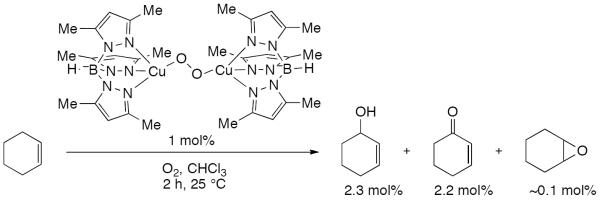
Allylic alkene oxidation with an oxyhemocyanin/oxytyrosinase model compound.
The oxidation of a series of hydrocarbon has been tested using a tris(pyrazolyl)borate-copper complex employing catalytic TBHP and an oxygen atmosphere.35 The results of these studies provide a useful comparison of the reactivity and selectivity of representative secondary alkyl, benzylic and allylic substrates under identical conditions (Scheme 23). In each case, ketone is the predominant product, with smaller amounts of alcohol also forming. Notably, no competitive alkene reactivity (epoxide formation) was reported for cyclohexene, and very high ketone selectivity was observed for ethylbenzene. The conversions are expectedly dissimilar, with a general reactivity trend of allylic>benzylic>>alkyl observed. The particular reticence of the unactivated alkyl C–H bond toward oxidation is clearly observed.
Scheme 23.
Comparative oxidation of secondary hydrocarbons.
While the above studies are pertinent with regard to industrial processes, poor selectivity found in current methods precludes allylic oxidation in the routine functionalization of complex alkenes. Nonetheless, allylic oxidation is a powerful synthetic transformation, and a copper catalytic system using oxygen under milder conditions would possess many advantages over reported reagents and catalysts, which rely on toxic metals or costly oxidants.78
II.C.2. Epoxidation of Alkenes
Catalytic oxidations of alkenes with molecular oxygen under mild conditions is a significant goal. Though copper containing oxygenase enzymes can effect successful epoxidation,24a,79 small molecule copper catalysts have been much less explored in the context of epoxidation (Table 4) due to the potential to undergo competing allylic oxidation (Section II.C.1).
Table 4.
Copper-catalyzed epoxidation of alkenes.
| entry | substrate | catalysta | conditions | conv (%) | epoxide selectivity (%) | ref |
|---|---|---|---|---|---|---|
| 1 | Propylene | Cu nanoparticles on SiO2 | 1 atm O2, 225 °C | 0.25 | 53 | 80 |
| 2 | Propylene | CuNO3 on KOAc modified SBA-15 | 1 atm O2, 225 °C | 0.4 | 59 | 81 |
| 3 | Propylene | K+-CuOx-SiO2 | 1 atm O2, 250 °C | 2.3 | <33 | 82 |
| 4 | Cyclohexene | Cu(OH)2 | 3 equiv CyCHO, 1 atm O2, CH2Cl2, rt, 17 h | 100 | 79a | 34b |
| 5 | Cyclohexene | Cu2+ on functionalized silica | 3.4 equiv i-PrCHO, 1 atm O2, rt, 6 h | 80 | 99 | 83 |
| 6 | Cyclohexene | CuCl16Pc on modified MCM-41 | 3 equiv i-PrCHO, 1 atm O2, MeCN, 40 °C, 8 h | 80 | 96 | 84 |
| 7 | 1-Decene | Cu(OH)2 | 3 equiv CyCHO, 1 atm O2, CH2Cl2, rt, 17 h | 32 | 84b | 34b |
| 8 | 1-Decene | CuCl16Pc on modified MCM-41 | 3 equiv i-PrCHO, 1 atm O2, MeCN, 40 °C, 8 h | 44 | 92 | 84 |
| 9 | trans-5-Decene | Cu(OH)2 | 3 equiv CyCHO, 1 atm O2, CH2Cl2, rt, 17 h | 83 | 96b | 34b |
| 10 | cis-5-Decene | Cu(OH)2 | 3 equiv CyCHO, 1 atm O2, CH2Cl2, rt, 17 h | 96 | 85b | 34b |
| 11 | Styrene | CuCl16Pc on modified MCM-41 | 3 equiv i-PrCHO, 1 atm O2, MeCN, 40 °C, 8 h | 100 | 74 | 84 |
| 12 | trans-Stilbene | Cu(OH)2 | 3 equiv CyCHO, 1 atm O2, CH2Cl2, rt, 17 h | 93 | 82b | 34b |
| 13 | cis-Stilbene | Cu(OH)2 | 3 equiv CyCHO, 1 atm O2, CH2Cl2, rt, 17 h | 81 | 79b | 34b |
| 14 | Norbornene | Cu-amidrazone | 1 atm O2, THF, 70 °C, 24 h | 83 | 100 (exo) | 85 |
| 15 | α-Pinene | Cu(OH)2 | 3 equiv CyCHO, 1 atm O2, CH2Cl2, rt, 17 h | 100 | 83b | 34b |
| 16 | Cyclohex-2-enol | Cu(OH)2 | 3 equiv CyCHO, 1 atm O2, CH2Cl2, rt | 99 | 55b | 34b |
| 17 | Cyclohex-2-en-1-yl acetate | Cu(OH)2 | 3 equiv CyCHO, 1 atm O2, CH2Cl2, rt | 33 | 58b | 34b |
See Chart 4 for ligand structures.
Based on GLC yield of epoxide.
Propylene oxide is an important synthetic intermediate in the chemical industry. Currently, methods for production of propylene oxide face environmental issues due to the nature of the catalyst and oxidants or due to poor selectivity, which requires separations that generate many byproducts. The catalytic epoxidation of propylene by a “green” oxidant such as molecular oxygen would be highly desirable. Some success has been seen with copper catalysts on solid supports80–82 that display stable behavior when using O2 as the oxidant; however, a large proportion of the substrate is still converted to other byproducts (Table 4, entries 1–3). Unlike most conditions for alkene epoxidation (see below), the absence of cooxidant additives implicates copper oxygen intermediates as the reactive species. An incomplete understanding of these species has limited development of improved catalysts.
An example demonstrating the potential of copper with higher alkene homologues is outlined in Scheme 24. 34b,53 Using an aldehyde cooxidant, the process works well for di- and trisubstituted alkenes producing very little of the allylic C-H insertion products.
Scheme 24.
Epoxidation of alkenes with a copper catalyst.
With copper and oxygen, the aldehyde cooxidant is believed to form peroxy acids. The epoxidation mechanism appears to involve both peroxy acids and radical species (Scheme 25). The latter is consistent with the formation of mixtures of epoxide diastereomers when utilizing cis alkenes as subststrates (Scheme 24). The high ratio of hydroxyl directed cis-epoxidation seen with the copper catalyst, however, is very similar to that observed with MCPBA (meta-chloroperoxybenzoic acid) supporting the intervention of a peroxy acid (Scheme 26). The acetate protected version give predominantly the trans-epoxide, again similar to MCPBA (Scheme 26). Both peroxy acids and radical species appear to form under the reaction conditions, with the former accounting for product formation except when the substrates can stabilize radical intermediates (i.e. the stilbenes, Scheme 24).
Scheme 25.
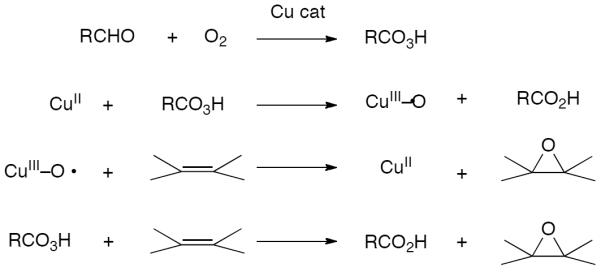
Mechanism of epoxidation of alkenes with a copper catalyst.
Scheme 26.
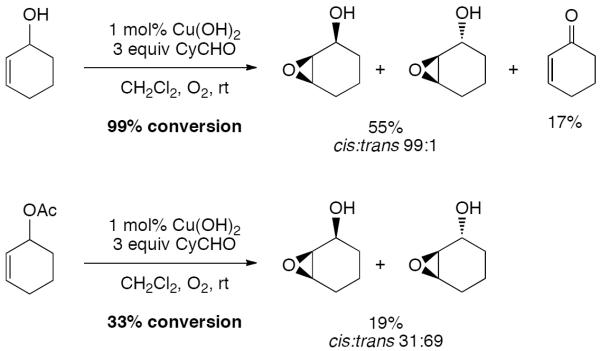
Substrate directed copper catalyzed epoxidation.
Other sources of copper have been investigated in similar epoxidations of styrene, cylcohexene, and decene utilizing air/O2 and an aldehyde with limited success.86 The most promising system at this time is comprised of a copper perchlorophthalocyanine (CuCl16Pc) complex, the activity of which is greatly improved by placement in the channels of HSi-MCM-41 molecular sieves (Scheme 27).84 Notably, this system gave superior results with molecular oxygen vs TBHP (tert-butylhydroperoxide) as the oxidant. The electron-withdrawing effect of the chloro substituents on the phthalocyanine stabilizes the reduction of the copper species thereby facilitating oxidation of the substrates. The hydrophobic nature of the cavities containing the copper catalyst in the HSi-MCM-41 molecular sieves further facilitates the oxidation reaction.
Scheme 27.
Copper perchlorophthalocyanine catalyzed epoxidation.
A key drawback to the above reaction formulation is the presence of radical generating species similar to those employed in allylic C-H functionalization (see Section II.C.1 above). These species are responsible for the allylic alcohol and allylic ketone byproducts. In an elegant series of studies, Lambert and coworkers demonstrated that a copper surface preoxidized with molecular oxygen provided the epoxides in high selectivity with several substrates including butadiene, styrene, and even β-methyl styrene.87 These studies show that the high selectivities in copper catalyzed alkene epoxidation with oxygen are possible if alternate radical reaction pathways can be suppressed.
Apart from flow reactor experiments with propylene, copper catalyzed epoxidations typically utilize stoichiometric aldehyde as a peracid precursor. In an interesting departure from this pattern, the epoxidation of norbornene with a copper amidrazone catalyst and oxygen has been reported in the absence of aldehyde or peroxide (Scheme 28).85 Complete selectivity to the exo product is reported in high conversion as detected by GC. Due to the bicyclic structure, the corresponding allylic radical cannot undergo resonance stabilization; as a consequence, allylic oxidation is not competitive. Hypothetically, the higher temperatures in this reaction might allow formation of a copper-oxo species, which acts as the oxygenating source in the absence of typical peracid.
Scheme 28.

Epoxidation of norbornene in the absence of aldehyde or peroxide.
The investigation of epoxidation employing copper and oxygen has overwhelmingly focused on simple hydrocarbon substrates. However, a unique report by Capdevielle and coworkers describes the selective epoxidation of tetrahydropyridines with Cu0, oxygen, and acetic acid (Scheme 29).88 Under the reaction conditions, the epoxide is opened with acetic acid to form the α-hydroxyacetate products. The authors propose a copper(II) oxo as the active species. When the N-oxide of the substrate was prepared, the same product was obtained with stoichiometric Cu(II) under nitrogen. These conditions putatively gives rise the same active copper(II) oxo species. Although stoichiometric copper is required and conversions are low, the reaction is notable due to the high selectivity in the presence of another oxidizable functional group.
Scheme 29.
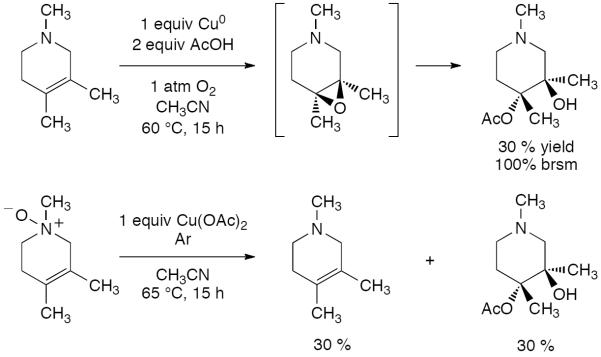
Selective epoxidation of tetrahydropyridines.
II.C.3. Oxidative Difunctionalization of Alkenes
Oxidative difunctionalization has been more broadly applied to alkynes (see Section II.D.4), but several examples with can also be found with alkenes. These transformations typically commence with addition of a heteroatom-copper species across a double bond and subsequent oxidative displacement of the copper. Examples of initiating heteroatoms and pseudoheteroatoms include oxygen, nitrogen, sulfur, selenium, and cyanide. In select reactions, radical-mediated processes may also occur. Formation of polyperoxide polymers has also been shown, for example, by oxidation of styrene.89
An early report by Owton and coworkers first detailed the catalytic hydroxysulfenylation of alkenes, a process that previously required stoichiometric lead(IV) salts.90 Simple alicyclic and aliphatic alkenes were found to react with disulfides in the presence of catalytic copper acetate under air to afford the corresponding 1,2-hydroxysulfides (Scheme 30). However, only arylsulfides containing a nitrogen coordinating group afforded product, and yields were poor to moderate. The proposed mechanism proceeds via copper chelation of the amine and adjacent sulfur, weakening the disulfide bond and accelerating nucleophilic attack by the alkene. The resulting cation is trapped by trifluoroacetate, which is subsequently cleaved to the free hydroxyl group under the reaction conditions (see below).
Scheme 30.

Hydroxysulfenylation of alkenes with disulfides containing proximal directing groups.
Later work by Taniguchi greatly expanded the utility of this process, discovering that a 2,2'-bipyridyl copper(I) iodide catalyst no longer required a coordinating group on the aryl disulfide (Scheme 31).91 This method afforded the anti-1,2-acetoxysulfenylated products in a good yield for a large substrate scope. In addition to disulfides, diselenides could also be used to good effect (for a similar reaction with alkynes see Section II.D.4).
Scheme 31.
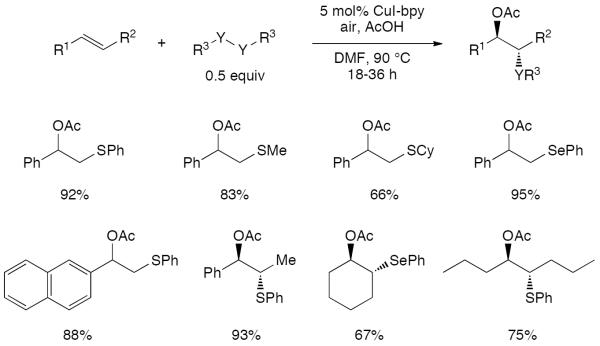
Acetoxysulfenylation of alkenes.
The mechanism for this reaction proceeds via initial copper coordination to the disulfide, facilitating nucleophilic attack by the alkene (Scheme 32). The resulting sulfonium ion is then trapped by acetic acid, releasing the acetoxysulfenylated product. Oxidation of the PhSCu(I) with oxygen regenerates the Cu(I)X catalyst and disulfide to close the catalytic cycle while also allowing both “halves” of the disulfide to react. Support for this mechanism is demonstrated by the finding that preformed PhSCu(I) converts to (PhS)2 in good yield under the acidic reaction conditions. When the reaction of styrene with (PhS)2 was attempted under a nitrogen atmosphere, only trace amount of product was observed.
Scheme 32.

Mechanism for the acetoxysulfenylation of alkenes.
In a recent paper, Taniguchi has also reported the direct, catalytic preparation of alkenyl sulfones via oxidative coupling of alkenes and sulfinate salts (Scheme 33).92 Although high temperatures are required, a variety of alkyl and aryl alkenes reacted with bipyridyl copper(I) iodide under air with sulfinate salts to provide the alkenyl sulfones in good yield. Interestingly, when KI was omitted from the reaction, small but significant amounts of β-ketosulfone was detected. Both terminal and internal alkenes could be utilized, with only (E)-isomers forming regardless of initial alkene geometry. Although the reaction is reported to proceed via radical mechanism, alternative pathways, including halonium formation, may also be postulated. For similar reactions with alkynes, see Section II.D.4.
Scheme 33.
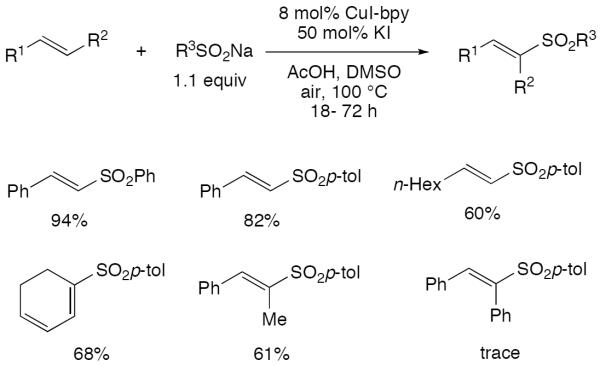
Oxidative sulfonylation of alkenes.
The reaction is reported to proceed via a radical mechanism in which the sulfinate salt is initially oxidized by a copper species. However, Ratnasamy93 and Stahl94 have reported the oxidation of bromide to bromine with copper and oxygen in the mechanism for oxidative oxybromination of arenes (see Section II.E.2). A similar oxidation here would lead to iodine and alternate mechanisms. Further study is needed to delineate the detailed steps of this process.
Alkenes can also react with nitrogen nucleophiles in aminofunctionalization reactions. A useful review of asymmetric aminofunctionalization of unactivated alkenes was reported in 2009.95 Chemler and coworkers described a diasteroselective synthesis of pyrrolidines via intramolecular copper-mediated aminooxygenation of alkenes.96 In this process, intramolecular aminocupration of the alkene is followed by oxidative trapping with TEMPO to afford the aminooxygenated products. Specifically, α-substituted 4-pentenyl sulfonamides with copper(II) ethylhexanonate [Cu(EH)2] yielded 2,5-cis-pyrrolidines in excellent diastereoselectivity (dr > 20:1) with excellent yields, while γ-substitution provided 2,3-trans-pyrrolidines in moderate diastereoselectivity (dr ~ 3:1) (Scheme 34). Further oxidation of the TEMPO moiety with m-CPBA can afford the pyrrolidyl aldehyde motif, as was demonstrated in a succinct formal synthesis of (+)-monomorine.
Scheme 34.
Aminoxygenation of alkenes with stoichiometric copper.
An extension of the method was later reported in which catalytic copper could be employed under oxygen to afford substituted pyrrolidine and cyclic urea products from the corresponding alkenylsulfonamides (Scheme 35) and N-allylureas (Scheme 36).97 Again, excellent (>20:1) diastereoselectivity was observed for α-substituted substrates. Generally, the use of Cu(OTf)2 with an achiral bisoxazoline ligand was found to provide higher yields and diastereoselectivities than use of Cu(EH)2 alone for β- or γ-substituted pentenylsulfonamides. In addition to studying ligand and nitrogen substituent effects on diastereoselectivity, enantioselective desymmetrization reactions were successful when a bulky sulfonamide group was employed (Scheme 37).
Scheme 35.
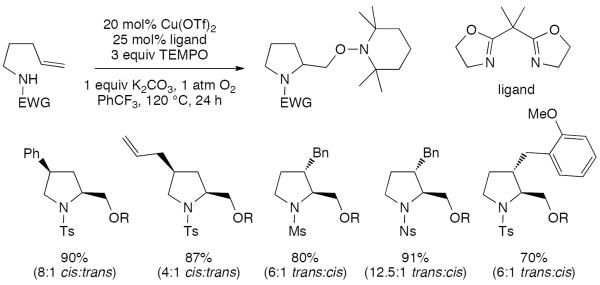
Aminooxygenation of alkenes with catalytic copper and oxygen.
Scheme 36.
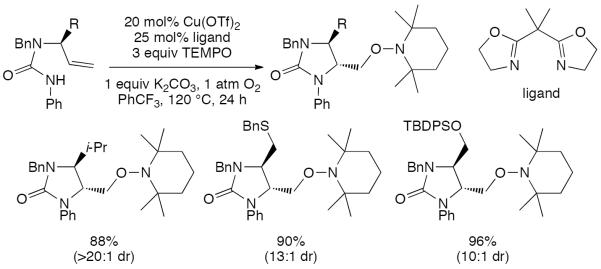
Catalytic aminooxygenation of alkenes to form cyclic ureas.
Scheme 37.

Catalytic asymmetric desymmetrization via aminooxygenation.
The proposed mechanism proceeds with initial coordination and deprotonation of the sulfonamide to the copper species followed by syn-aminocupration (Scheme 38). Subsequent homolytic cleavage of the Cu–C bond affords a Cu(I) species and a primary radical, which is readily trapped with TEMPO. Reoxidation of the Cu(I) to Cu(II) by oxygen regenerates the active catalyst.
Scheme 38.
Mechanism for the catalytic aminooxygenation of alkenes.
An enantioselective variant of the aminooxygenation of alkenes utilized Cu(OTf)2 with a chiral bisoxazoline ligand to afford the corresponding indoline and pyrrolidine products in excellent yield and high optical purity (Scheme 39).98 While TEMPO alone could trap the proposed alkyl-copper intermediate in addition to acting as the terminal oxidant, performing the reaction under oxygen was necessary for complete conversion to the pyrrolidine products.
Scheme 39.
Asymmetric catalytic aminooxygenation of alkenes.
A catalytic copper and oxygen system has been described for the novel synthesis of γ-lactones through a formal oxidative [3+2] addition between alkenes and anhydrides (Scheme 40).99 This novel difunctionalization employs Cu(OTf)2 under oxygen to afford a wide array of functionalized lactones using inexpensive anhydrides, such as acetic anhydride, as carboesterification agents. High yields were observed for a large array of terminal alkenes. Internal alkenes however, were not tolerated, and use of secondary anhydrides, such as propionic anhydride, afforded the products in a 1:1 syn:anti ratio. Alternate oxidants such as DDQ and TBHP were found to provide only benzaldehyde and recovered starting material when styrene was the substrate.
Scheme 40.
Carboacetoxylation of alkenes with anhydrides.
Mechanistic studies using stereospecifically deuterium-labeled styrene established a syn-oxycupration process (Scheme 41). Addition of a TEMPO or BHT did not noticeably affect the reaction, lending evidence to a non-radical pathway. A potential mechanism for the reaction involves initial oxycupration via attack of the enolate form of the anhydride with the alkene. In this instance, the carbocuprate then undergoes carbometalation of a second alkene to generate the cyclic system. Oxidative decomposition generates the product and regenerates the catalytic copper species.
Scheme 41.
Potential mechanism for the carboacetoxylation of alkenes.
Chiba and coworkers have described a unique method for the intramolecular cyclopropanation of alkenes utilizing stoichiometric copper and oxygen.100 Specifically, treatment of N-allyl enamine carboxylates with CuBr•SMe2, 2,2-bipyridine, and oxygen under mild heating affords 3-azabicyclo[3.1.0]hex-2-enes in high yield. Overall, the transformation represents addition of two carbons across a double bond. Various aryl and alkyl substituents are tolerated on the enamine (Scheme 42) and allyl (Scheme 43) moieties. Notably, substrates containing cyclic allyl groups afforded highly strained tricyclic products in good yield. The reaction of both (Z) and (E)-N-phenylallyl substrates afforded an approximately 1:1 mixture of diastereomers, providing evidence of a stepwise process.
Scheme 42.
Cyclopropanation of N-allyl enamine carboxylates.
Scheme 43.
Cyclopropanation of substituted N-allyl enamine carboxylates.
The reaction occurs sluggishly in the absence of oxygen, providing only small amounts of cyclized product. Oxygen is therefore proposed to initially react with copper(I) to form a copper(II)peroxo species. After initial coordination to the substrate (Scheme 44), carbocupration of the allyl group affords a five-membered ring and an alkyl-copper bond. Formation of a metallocyclobutane, via deprotonation and ligand exchange, could then afford the tricyclic product via carbon-carbon bond forming reductive elimination.
Scheme 44.
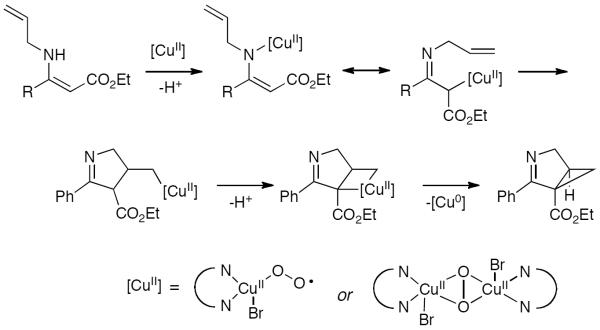
Mechanism for the cyclopropanation of N-allyl enamine carboxylates.
Interestingly, simple addition of potassium carbonate to the previously described method provides orthogonal reactivity, avoiding the cyclopropanation pathway and instead undergoing carbooxygenation of the allyl double bond. This complementary process utilizes catalytic Cu(OAc)2 to afford 4-formylpyrroles from N-allyl enamine carboxylate in moderate yield (Scheme 45). Formation of 4-ketopyrroles by terminal substitution of the allyl moiety was not tolerated, affording complex mixtures. However, a variety of 4-benzoylpyrroles could be formed from substituted N-propargyl enamine carboxylates via alkyne carbooxygenation (see Section II.D.4).
Scheme 45.

Carbooxygenation of N-allyl enamine carboxylates to afford 4-formylpyrroles.
Although the role of potassium carbonate in controlling product selectivity remains inconclusive, the authors propose a mechanism beginning with formation of a peroxycopper adduct with the enamine substrate(Scheme 46). Carbocupration of the N-allyl double bond affords a cyclized intermediate with a pendant alkyl-peroxycopper species. Subsequent isomerization and elimination of a reduced copper species installs the aldehyde moiety. Oxidative aromatization then forms the 4-formylpyrrole product. Subjecting an N-3,3-dimethylallyl enamine substrate to the reaction conditions provided 2-phenylpyrrole-3-carboxylate in 24% yield (Scheme 47). Formation of this product may be explained by C–C bond cleavage to form acetone and a reduced copper species, lending support for a mechanism involving a peroxide intermediate.
Scheme 46.
Carbooxygenation mechanism for N-allyl enamine carboxylates.
Scheme 47.

Fragmentation mechanism under carbooxygenation conditions
Recently, Zhu and coworkers treated N-(1-phenylallyl)-2-aminopyrazine with a copper(II) species and oxygen, anticipating a copper-promoted C–H amination of the double bond and oxidative aromatization.101 However, a heterocyclic aldehyde was formed instead via an aminooxygenation process. This reaction was found to be general for a wide range of N-allyl-2-aminopyradines, providing the aldehyde products in good to moderate yields (Scheme 48). Under slightly different conditions, N-allylamidines provided the imidizolyl aldehyde products in more modest yields.
Scheme 48.
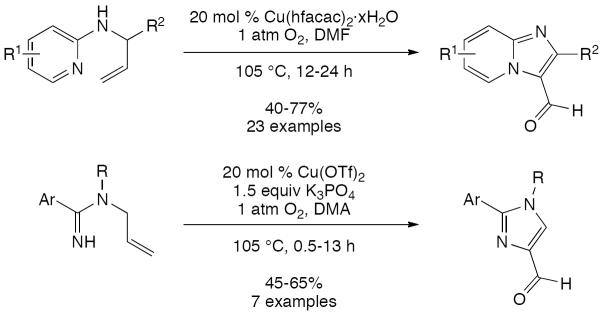
Aminooxygenation of N-allyl-2-aminopyridines and N-allylamidines.
Mechanistic studies ruled out formal benzylic C–H or alcohol oxidation following ring closure as a potential pathway. Addition of TEMPO yielded no carbon-TEMPO adduct, and no reaction was observed when performing the reaction with superstoichiometric copper under argon. Using an 18O2 atmosphere provided the product with 95% isotopic incorporation, precluding adventitious water as the oxygen source. On the basis of the above results, a mechanism is proposed (Scheme 49) in which initial coordination of the pyridyl ring to copper is followed by deprotonation. The subsequent adduct reacts with dioxygen to form a peroxycopper intermediate. Aminocupration of the alkene generates an alkyl-copper intermediate, which, upon rearrangement and elimination of a reduced copper hydroxide species, yields the aldehyde product.
Scheme 49.
Aminooxygenation mechanism of N-allyl-2-aminopyridines.
In a related system, a direct intramolecular C–H amination of pyridines with alkenes has been reported to provide complex N-heterocycles in good yields.102 Specifically, pyridyl substituted 3-methyleneisoindolin-1-ones were treated with catalytic copper(II) trifluoroacetate under air to afford the polycyclic N-heterocycles in good yield (Scheme 50). Limitations to the method include little allowance for structural changes in the substrate and the requirement of several equivalents of pivalic acid.
Scheme 50.

Oxidative alkene C–H amination to afford complex N-heterocycles.
The mechanism of the transformation proceeds through initial chelation of the pyridyl moiety with copper and subsequent deprotonation (Scheme 51). In marked contrast to the aforementioned reactions, the proposed aminocupration results in an internal, tertiary carbon–copper bond, although an oxidative radical cyclization may also be envisioned. Further oxidation then provides the conjugated alkene.
Scheme 51.
Mechanism for cyclization of pyridyl substituted 3-methyleneisoindolin-1-ones.
A series of studies by Teyssie and coworkers focused on the copper-catalyzed difunctionalization of vinylogous substrates, and particularly butadiene. In these systems, reaction at the termini of the substrates is presumably mediated by conjugation. A primary investigation focused on the oxidative diacetoxylation of butadiene.103 Optimized conditions consisting of Cu(OAc)2, LiBr, and acetic acid/acetic anhydride solvent provided a mixture of 3,4 and 1,4-diacetoxybutene in ~60% yield along with 5% monoacetoxybutenes (Scheme 52). In nearly all of these trials, the diacetoxybutene regioisomers were isolated in an approximate 1:1 ratio due to a slow isomerization pathway under the reaction conditions. High pressures of oxygen were necessary to diminish formation of monoacetoxylation product. The use of LiBr was found to be necessary for catalytic activity. Both epoxybutene and dihalobutenes, postulated intermediates for the reaction, were tested under the reaction conditions. Although the epoxide intermediate provided isomer ratios similar to the primary reaction, other potential pathways and intermediates, including a bromonium species, cannot be excluded.
Scheme 52.

Oxidative diacetoxylation of butadiene.
Interestingly, when the aforementioned diacetoxylation conditions were applied to 1,5-diphenylbutadiene, 2,5-diphenylfuran was isolated in good yield (Scheme 53).104 The unique nature of this substrate ostensibly favors an oxidative vinylogous cyclization pathway. A possible mechanism may proceed via attack of a peroxo-copper species on the benzylic position, forming a radical stabilized through extended conjugation. This intermediate can then close to the furan through O–O bond scission and subsequent rearomatization.
Scheme 53.

Oxidative vinylogous cyclization.
Oxidative dicyanation of butadiene, a similar reaction, was later investigated and found to be a more regioselective process.105 Using a combination of copper(I) bromide and copper(I) iodide with hydrogen cyanide could produce 1,4-dicyanobutene in 60% yield (Scheme 54). Unfortunately, the process appears restricted to butadiene: reaction of 1,3-pentadiene yielded <17% of dicyanated product. The fact that radical traps did not retard the reaction and that a halide source was critical for high conversion, suggest the intermediacy of a halonium pathway.
Scheme 54.

Oxidative vinylogous dicyanation of butadiene.
II.D. Alkyne Oxidation
II.D.1. Propargylic Oxidation
Aerobic oxidation of propargylic substrates is complicated by competitive alkyne reaction pathways as well as potential overoxidation to carboxylic acid products. One system that overcomes these challenges utilizes NHPI in conjunction with a copper(II) catalyst to selectively oxidize propargylic substrates to the corresponding conjugated carbonyl products (Scheme 55).106 While NHPI alone can catalyze the reaction of certain substrates, the addition of the copper catalyst significantly enhances reactivity, allowing for lower reaction temperatures, as well as playing a key role in the final oxidation of the initial propargylic alcohol to the ketone product. Presumably, the mechanism proceeds via formation of the NHPI radical (for example, see Scheme 6).
Scheme 55.
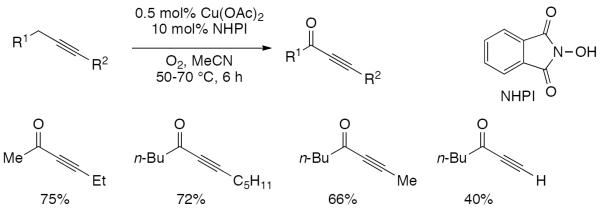
Oxygenation of alkynes to α,β-acetylenic ketones.
II.D.2. Glaser-Hay Reaction
The copper-catalyzed dimerization of terminal alkynes to form 1,3-diynes is a facile C–C bond forming process. It has been employed in numerous applications, including the construction of linear π-conjugated acetylenic oligomers and polymers, the synthesis of natural products, and the polymerization of diacetylenes. A comprehensive review by Cadiot and Chodkiewisz appeared in 1969,107 as well as a further review by Diederich in 2000.108 A general review of hydrocarbon couplings was published in 2010.109 In this section, the development of the Glaser-Hay coupling is presented with representative examples, and a comprehensive overview of couplings from 2000–2011 is provided.
The origin of the Glaser-Hay reaction dates back to 1869, when Carl Glaser formed the copper(I) salt of phenylacetylene upon treatment with a copper(I) and ammonia (Scheme 56).110 Upon exposure to air, the homocoupled 1,3-diyne was isolated. It was not until 1956 that Eglinton and Galbraith improved the synthetic viability of the reaction by reporting the homogeneous coupling of alkynes using stoichiometric copper(II)acetate in the presence of pyridine and methanol.111 The use of catalytic copper and oxygen to effect the oxidative homocoupling of terminal alkynes was published in a landmark advance by Hay in 1962.112
Scheme 56.
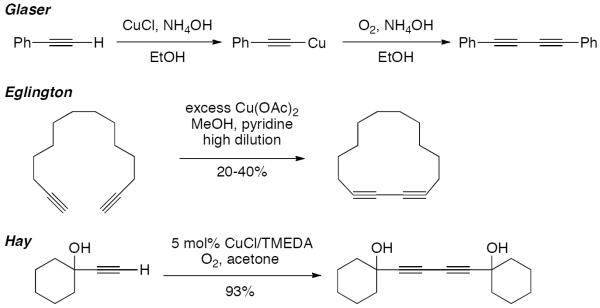
Evolution of the Glaser-Hay process.
The bidentate tertiary amine ligand N,N,N',N'-tetramethylethylenediamine (TMEDA) provides enhanced solubility to the reactive copper intermediate, and the classical Hay conditions (CuCl, TMEDA, and oxygen) continue to be widely used. These mild conditions typically provide high yields. The reaction conditions permit many functional groups to be employed including unprotected hydroxyls (see Scheme 56 above). The poor ability of alkynes to transfer from copper in conjugate addition means that enones and carbonyls are also compatible. Homocoupling predominates even with mixtures of alkynes. The appearance of an Organic Syntheses description is a manifestation of the high reliability of the process (Scheme 57).113
Scheme 57.

Preparative scale Hay coupling.
Several studies to further optimize and expand alkyne dimerization have been reported. For example, Beifuss and co-workers undertook a systematic study of ligand and base effects on the homocoupling of various acetylenes.114 While TMEDA was again demonstrated to be the ligand of choice, addition of one equivalent of hindered base further improved the reaction efficiency. Specifically, DBU was effective for aryl acetylenes and DABCO for alkyl acetylenes. The authors attribute this difference in the latter case due to the decreased acidity of the acetylenic proton.
A recent study has demonstrated that the addition of a equimolar amount of a Ni(0) catalyst to standard Hay conditions greatly increases reaction rate in homocoupling and heterocoupling of terminal alkynes.115,116 The authors demonstrate that nickel undergoes redox with oxygen as the oxidant, while Cu forms copper acetylides that transmetallate to nickel. A similar cooperative behavior has also been reported with iron117 and palladium118for alkyne coupling.
Wan and coworkers demonstrated the use of piperidine and toluene as alternative conditions for the dimerization of aryl and alkyl terminal alkynes.119 High yields were obtained for a variety of substrates, although higher temperatures were necessary in comparison to classical conditions. In an effort to identify a “greener” modification of the Hay coupling, Chen and coworkers reported solvent-free conditions, using just 3 mol% CuCl and 3 mol% pyridine in air.120 Both alkyl and aryl acetylenes were homocoupled in good yield, although higher temperatures were required in comparison to typical conditions. Similarly, polyethylene glycol can be used as an environmentally benign reaction medium.121 And, ionic liquids have been employed with the classical Hay catalyst (CuCl, TMEDA, O2, rt).122 These solvents have the advantage of being easily recyclable after extraction of the product with an organic solvent.
Heterogeneous catalysis has been applied to the Hay coupling. Examples of supported catalysts include supported copper hydroxide on titania123 and cuprous chloride-doped zeolites.124 Although these systems afford good yields of homocoupled products without added ligand, greatly elevated temperatures (100–110 °C) are required. A homogeneous copper-containing silicotungstate catalyst has also been reported to effect the Hay coupling.125 The catalyst could be recycled via precipitation, and no added ligand was necessary. However, similar to the heterogeneous and ligand-free catalysts, greatly increased temperatures were necessary. The use of ball milling alkyl or aryl alkynes with KF-Al2O3 and CuI catalyst has also been reported to provide the corresponding diyne products in good yield.126 This process avoids the use of both solvent and ligand.
Numerous dimerizations via Glaser-Hay coupling have been implemented (see Table 5). In the context of natural product synthesis, the method proved key in approaching the caryoynencins, which contain 1,3,5,7-octatetraynes and show potent antibacterial activity. Specifically, the conjugated polyynes are highly unstable, polymerizing readily, and present a significant synthetic challenge. The mild nature of Hay alkyne dimerization afforded the requisite tetrayne in high yield en route to the caryoynencins (Scheme 59).127
Table 5.
Glaser Hay dimerization reactions.
| entry | substrate | conditions | yield(%) | ref |
|---|---|---|---|---|
| 1 |
|
8 mol% Cu(OAc)2·H2O, TMEDA, acetone, air, rt, 2h | 91 | 145 |
| 2 |
|
CuCl, TMEDA, O2, MeOH, THF | 81a | 130 |
| 3 |
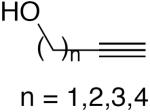
|
5 mol% CuI, TMEDA, DME, O2, 55 °C, overnight | ≥90 | 146 |
| 4 |
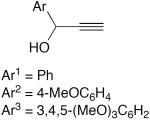
|
15 mol% CuCl, 30 mol% pyridine, MeOH, O2, rt | Ar1 = 91 | 147 |
| Ar2 = 93 | ||||
| Ar3 = 75 | ||||
| 5 |
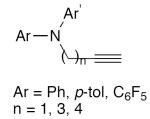
|
10 mol% CuCl, TMEDA, MeOH, air, rt, 24 h | 60–72 | 148 |
| 6 |

|
10 mol% CuI, TMEDA, O2, acetone, rt, 3 h | 84–100 | 149 |
| 7 |

|
CuCl, TMEDA, air, CHCl3 | 94 | 150 |
| 8 |
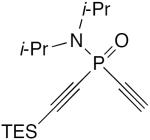
|
10 mol% CuI, 20 mol% TMEDA, acetone, air, rt | 67 | 151 |
| 9 |
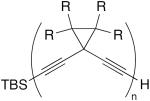
|
3 equiv CuCl, TMEDA, acetone, O2, 1 h, rt | 76 (n = 3, R = Me) | 152 |
| 86 (n = 3, R = H) | ||||
| 95 (n = 6, R = H) | ||||
| 10 |
|
4 mol% CuCl, TMEDA, acetone, O2, rt, 6 h | 84 | 153 |
| 11 |

|
14 mol% CuCl, TMEDA, acetone, O2, rt, 4 h | 52 | 154 |
| 12 |

|
CuCl, TMEDA, CH2Cl2, O2 | 50a (n = 2) | 155 |
| 44a (n = 3) | ||||
| 19a (n = 4) | ||||
| 13 |
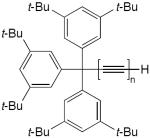
|
CuCl, TMEDA, CH2Cl2, O2 | 92 (n = 2) | 156 |
| 66 (n = 3) | ||||
| 97 (n = 4) | ||||
| 14 |
|
40 mol% CuCl, pyridine, air, 24 h, rt | 95 | 157 |
| 15 |

|
25 mol% CuCl, pyr, air, 40 °C, 1.5 h | 60 | 158 |
| 16 |

|
1 equiv CuCl, TMEDA, CH2Cl2, air, 30 °C, 2–4 h | 99 | 159 |
| 17 |

|
6.3 equiv CuCl, TMEDA, CH2Cl2, air, rt, 12 h | 91 | 160 |
| 18 |

|
CuCl, TMEDA, CH2Cl2, air | 68 | 161 |
| 19 |
|
CuCl, TMEDA, air, acetone, rt, overnight | 43 | 162 |
| 20 |
|
12 mol% CuCl, TMEDA, chlorobenzene, O2, rt, 3d | 50 | 163 |
| 21 |
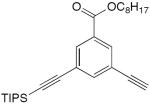
|
4.8 equiv CuCl, TMEDA, acetone, O2, rt, 48 h | 88 | 164 |
| 22 |
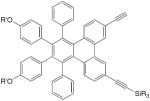
|
CuCl, TMEDA, CH2Cl2, O2, rt, 24 h | 91 | 165 |
| 23 |

|
30 mol% CuCl, O2, DMF, rt, 12 h | 26 | 166 |
| 24 |
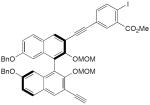
|
CuCl, TMEDA, O2, CH2Cl2, rt | 99 | 167 |
| 25 |

|
1 equiv CuCl, TMEDA, CH2Cl2, O2, rt, 4 h | 60 | 168 |
| 26 |

|
5 mol% CuCl, TMEDA, toluene, 65 °C, 1.5 h | 45 | 169 |
| 27 |

|
catalytic CuCl(OH)·TMEDA, CH2Cl2, O2, rt, overnight | 57 | 170 |
| 28 |

|
20 mol% CuCl, pyr, O2, rt, 24 h | 86 | 171 |
| 29 |

|
30 mol% CuCl, TMEDA, O2, acetone, rt, 48 h | 89 | 172 |
| 30a |

|
4 equiv CuI, TMEDA, CH2Cl2, O2, rt | 96a (n= 1) | 173 |
| 78a (n = 2) | ||||
| 68a (n = 3) | ||||
| 31 |

|
CuCl, TMEDA, CH2Cl2, rt, O2 | R1 = 87 | 174 |
| R2 = 68 | ||||
| 32 |

|
4 equiv CuCl, TMEDA, CH2Cl2, O2, rt | 32a (n =2) | 175 |
| 20a (n = 3) | ||||
| 34a (n = 4) | ||||
| 34a (n = 5) | ||||
| 22a (n = 7) | ||||
| (cyclic dimers) | ||||
| 33 |

|
CuCl, TMEDA, O2, CH2Cl2 | R1 = 70 | 176 |
| R2 = 86 | ||||
| R3 = 54 | ||||
| 34 |

|
CuCl, TMEDA, air, CH2Cl2, rt, 6 h | 70 | 177 |
| 35 |

|
5 equiv CuCl, TMEDA, O2, CH2Cl2 | 64a | 178 |
| 36 |
|
CuCl, TMEDA, O2, CH2Cl2 | R1 = 65a | 132 |
| R2 = 55a | ||||
| R3 = 69a | ||||
| 37 |
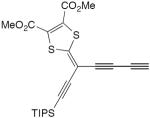
|
CuCl, TMEDA, air, CH2Cl2, rt | 51a | 132 |
| 38 |

|
CuCl, TMEDA, air, CH2Cl2 | 48a | 132 |
| 38 |
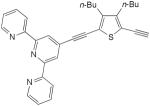
|
10 equiv CuCl, 5 equiv CuCl2, O2, DMF, rt, 4d | 82 | 179 |
| 39 |

|
CuCl, TMEDA, air, DCE, 50 °C | 91 | 180 |
| 40 |

|
2.8 equiv CuCl, TMEDA, CHCl3, O2, rt | 68 | 181 |
| 41 |

|
50 mol% CuCl, TMEDA, air, CH2Cl2, rt | 86 | 182 |
| 42 |
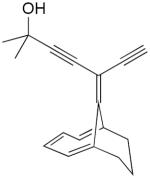
|
CuCl, TMEDA, acetone, air, 17 h, rt | 93 | 183 |
| 43 |
|
2.6 equiv CuCl, TMEDA, CH2Cl2, air, overnight | 93 | 184 |
| 44 |
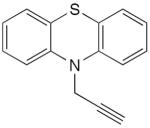
|
10 mol% CuCl, TMEDA, O2, isopropanol, acetone, rt, 5 h | 81 | 185 |
| 45 |

|
20 mol% CuCl, 20 mol% TMEDA, acetone, O2, 35 °C, 1.5 h | 82 | 186 |
| 46 |

|
14 mol% CuCl, pyr, air, 40 °C, 6.5 h | 36 | 187 |
| 47 |
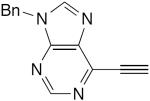
|
20 mol% CuCl, TMEDA, DME, rt, air, overnight | 59 | 188 |
| 48 |

|
CuCl, TMEDA, O2, CH2Cl2, rt | 81 | 189 |
| 49 |

|
10 mol% CuI, pyrrolidine, air, rt | 48–90 | 190 |
| 50 |

|
1.1 equiv CuCl, air, TMEDA, acetone, rt, 5 h | 64 | 191 |
| 51 |

|
3.6 equiv CuCl, TMEDA, CH2Cl2, O2, rt, overnight | 83 | 192 |
| 52 |
|
2.5 equiv CuCl, TMEDA, CH2Cl2, air, rt, 15 min | yield not reported | 193 |
| 53 |

|
0.5 mol% CuCl, DBU, pyridine, O2, 3 h, 45 °C | 96 | 194 |
| 54 |
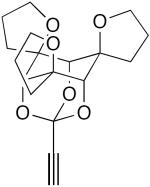
|
1 equiv CuCl, TMEDA, CH2Cl2, air, 4 h, rt | 100 | 195 |
| 55 |
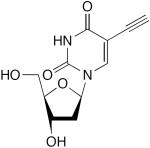
|
2 equiv CuCl, TMEDA, O2, H2O, rt 3 d | 68 | 196 |
| 56 |

|
CuCl, TMEDA, DMF, O2, 40 °C, 4 h | 99 | 197 |
| 57 |

|
CuCl, TMEDA, acetone, O2, rt, 4h | 96 | 198 |
| 58 |

|
30 mol% CuCl, TMEDA, DMF, O2, 40 °C, 2 h | 86 (X = O) | 199 |
| 83 (X = S) | ||||
| 59 |

|
42 mol% CuCl, TMEDA, acetone, O2, rt, | 25 | 200 |
| 60 |

|
50 mol% CuCl, TMEDA, acetone, O2, 4 h, rt | 95 | 201 |
| 61 |

|
superstoich. CuCl, TMEDA, acetone, air, rt, 1.5 h | 60 (R = Cr) | 202 |
| 55 (R = W) | ||||
| 62 |
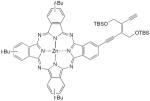
|
1 equiv CuCl, TMEDA, CH2Cl2, O2, 4Å mol sieves, 12 h, rt | 75 | 203 |
| 63 |

|
1.05 equiv CuCl, DBU, pyridine O2, 45 °C, 2h | >72 (n = 2) | 204 |
| >87 (n = 4) | ||||
| (cyclic dimer) | ||||
| 64 |

|
11 mol% CuCl, pyridine, O2, rt, 30 h, 32% | 32 (cyclic dimer) | 205 |
| 65b |

|
7.5 equiv CuI, TMEDA, CH2Cl2, air, rt | 51 (cyclic dimer) | 206 |
| 66 |

|
CuCl, TMEDA, air, CH2Cl2, rt, 18 h | 72 (mixture of four diastereomer ic cyclic dimers) | 207 |
| 67 |

|
2 equiv CuCl2, TMEDA, acetone, O2, rt, 5 h | 32 (cyclic dimer) | 208 |
| 68 |

|
CuCl, TMEDA, CH2Cl2, air, 0 °C | 71a (cyclic trimer) | 209 |
Substrate coupled directly after deprotection from silyl-protected precursor.
For cyclodimerization of a similar substrate with excess copper catalyst see ref 210.
Scheme 59.
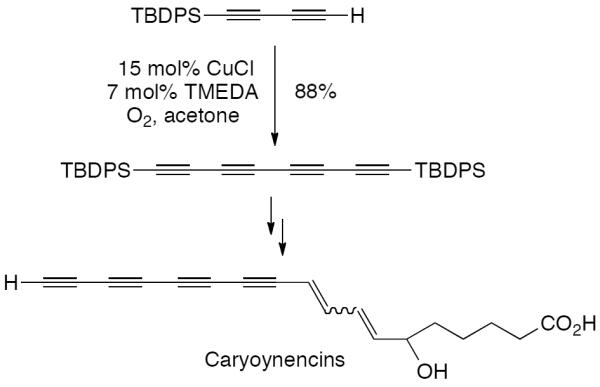
Glaser-Hay coupling en route to the caryoynencins.
Perhaps more than any other area, the Glaser-Hay coupling has become a critical process in supermolecular chemistry. The controlled formation of diacetylene linkages allows access to an array of well-defined molecular architectures such as molecular rods, macrocycles, and extended π-conjugated systems.128 Possible applications of such advanced materials include nonlinear optical devices and molecular photochemical switches. Tykwinski and coworkers have explored extended π-conjugated materials based on the iso-polydiacetylene and iso-polytriacetylene linkages.129 These unique systems, which lack arene linkers, are assembled by Sonagashira coupling of vinyl triflates with 1-silylalkynes and Hay dimerization upon strategic silyl group removal. The products possess interesting structural, optical, and electronic properties.
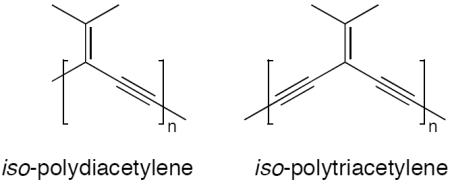
More recently, the dibrominated iso-polytriacetylene has been used in studies towards the realization of carbyne.130 Treatment with 2 equivalents of n-BuLi triggers a Fritsch-Buttenberg-Wiechell Rearrangement to form the silyl-protected triacetylene intermediate (Scheme 60). Subsequent silyl deprotection and tandem Hay coupling forms the hexa-acetylenic dimer in excellent yield. This strategy was used to construct linear polyynes of up to ten consecutive acetylene linkages, structures typically unobtainable due to the sensitivity of the substrates.
Scheme 60.

Rearrangement/Hay dimerization to form a linear polyyne.
Extended tetrathiafulvene-based molecules have received considerable attention due to their unique redox properties and potential use as organic conducting and nonlinear optical materials.131 An iterative Glaser-Hay process has been used to synthesize thiafulvene units with polyacetylene linkers (Scheme 61).132 The method first extends the initial monoalkyne by methanolic cleavage of the more labile silyl protecting group and ensuing Glaser-Hay cross-coupling with TMS-acetylene (see section II.D.3). Treatment of the resulting TMS-diyne under similar deprotection/oxidation conditions affords the extended thiafulvene structure in good yield.
Scheme 61.
Extended tetrathiafulvene synthesis via Hay couplings.
Provided that the ring size permits digonal carbon centers, the Glaser-Hay reaction is also useful for macrocyclization.133 For example, spontaneous trimerization of a chiral binaphthalenediyne under the Hay reaction conditions generated receptors for pyranoside binding (Scheme 62).134 Some tetramer was also observed in this process. Templated cycloisomerizations have been used to good effect to better control oligomer sizes in other systems.135
Scheme 62.
Cyclooligomerization via Hay coupling.
Intramolecular alkynyl coupling can also be utilized as an effective macrocyclization technique. High dilution promotes the already predisposed substrates toward intramolecular ring closure over competitive oligomerization processes. This concept has been applied to the formation of an all-carbon macrocyclic poly-enyne conjugated system formed by initial alkynyl silane deprotection followed by classic Hay conditions (Scheme 63a).136 A fully conjugated macrocycle containing a pyridyl ring was formed in a similar manner via silyl deprotection of an extended enyne system and intramolecular Hay coupling using several equivalents of copper (Scheme 63b).137 In a final example, an oligomeric arenediyne system is subjected to sequential silane deprotection and Hay conditions (Scheme 63c).138 This process induces multiple intramolecular Hay cyclizations, affording a linearly-fused benzodehydro[12]annulenes.
Scheme 63.

Substrates used in desilylation-Hay intramolecular macrocyclization.
The Glaser-Hay reaction can also be employed to form polymers and is remarkably tolerant of functionality (see Table 7). For example, terminal alkynes in organotransition metal complexes undergo copper-catalyzed couplings. Bunz has employed Hay conditions to prepare molecular rods incorporating cyclopentadienyl π-complexes that have interesting material properties (Scheme 64).139
Table 7.
Glaser Hay oligomerization and polymerization reactions.
| entry | substrate | conditions | yield | ref |
|---|---|---|---|---|
| 1 |

|
CuCl, pyr, nitrobenzene, O2, rt, 40 h | yield not reported Mw = 3000 |
215 |
| 2 |
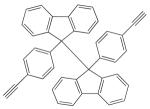
|
CuCl, pyr, nitrobenzene, O2, rt, 40 h | yield not reported Mw = 12000 |
215 |
| 3 |

|
2 mol% CuCl, pyr, O2, 35°C, 24 h | 85 | 216 |
| 4 |

|
30–40 mol% CuCl, TMEDA, pyr, O2 | 86 (R = H) 82 (R = n-Bu) 45 (R = On-Bu) |
217 |
| 5 |

|
14 mol% CuCl, 4,4'-dinonyl-2,2'-bipyridine, 1 mol % tetradecyltrimethyl- ammonium bromide, toluene, H2O, air, rt, 48 h | yield not reported Mw = 76000 |
140 |
| 6 |

|
14 mol %CuCl, 4,4'-dinonyl-2,2'-bipyridine, 1 mol % tetradecyltrimethyl- ammonium bromide, toluene, H2O, air, rt, 72 h | yield not reported Mw = 10000 |
140 |
| 7 |
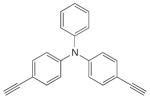
|
CuCl, pyr, O2,45 °C, 40 min | 63 | 218 |
| 8 |
|
12 mol% CuCl, 12 mol% TMEDA, pyr, DMF, O2, rt, 17 h | 99 conv. (n = 8) |
219 |
| 9 |
|
31% CuCl, pyr, toluene, O2, rt, 72 h | 80 | 220 |
| 10 |
|
6 mol% CuCl, TMEDA, 1,2-dichlorobenzene, O2,75 °C, 2 h | 100 | 221 |
| 11 |
|
CuBr, bpy, THF, O2, rt, 48h | yield not reported | 222 |
| 12 |

|
CuCl, TMEDA, CH2Cl2, air, rt | 28a (dimer) 14a (trimer) 6a (tetramer) |
223 |
| 13 |
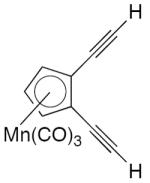
|
CuCl, TMEDA, O2, acetone, 30 °C, 2 h | 68 | 139 |
| 14 |
|
CuCl, DBU, pyr, O2, 45°C, 5 h | yield not reported n(average) = 8 |
194 |
| 15 |
|
20 mol% CuCl, TMEDA, o-dichlorobenzene, air, 50 °C, 15 min | 80 (copolymer) | 224 |
| 16 |
|
24 mol% CuCl, TMEDA, o-dichlorobenzene, air, 55 °C, 1.5 h | 37 (copolymer) | 225 |
| 17 |

|
CuCl,4,4'-dinonyl-2,2'-bipyridine, 1 mol % tetradecyltrimethyl-ammonium bromide, toluene, H2O, air, | yield not reported Mw = 95000 (copolymer) |
140 |
Substrate coupled directly after deprotection from silyl-protected precursor.
Scheme 64.
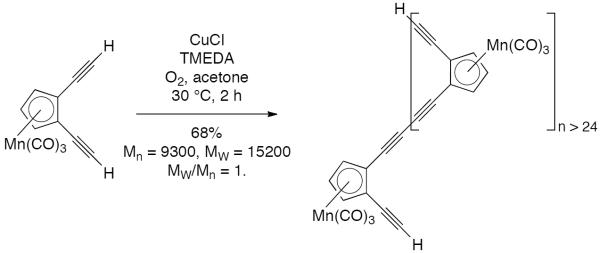
Hay coupling of stable organometallic adducts to form polymers.
Mecking and co-workers reported copolymerization under Hay conditions of arenediynes with modified alkyne-containing dyes to give polymers with interesting photoluminescent properties.140 Using 4,4'-dinonyl-2,2'-bipyridine as an amphiphilic ligand, allowed successful microemulsion copolymerization under biphasic conditions to afford a perylenediimide-containing nanoparticle polymer with fluorescent properties (Scheme 65).
Scheme 65.
Copolymerization with biphasic Glaser-Hay conditions.
Different bis- and mono-alkynes can be combined resulting in an oligomeric/polymeric backbone capped with nonreacting termini (see Table 6). The amount and timing of the addition of the endcapping monoalkyne allows some control over chain length. For example, Diederich and coworkers have prepared a series of conjugated materials containing “donor-donor and acceptor-acceptor endfunctionalized poly(triacetylene)oligomers)” using this method.141 With (E)-1,2-diethynylethene and tetraethynylethene sub-units, statistical mixtures of extended conjugative oligomers (Scheme 66).142
Table 6.
Glaser Hay cross-coupling reactions with endcaps.
| entry | substrate | endcapa | conditions | yield (%) | ref |
|---|---|---|---|---|---|
| 1 |
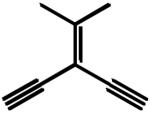
|
|
CuCl, TMEDA, O2, CH2Cl2, rt | 60b | 173a |
| 2 |

|
|
1.7 equiv CuCl, TMEDA, CH2Cl2, O2 | 81b | 178 |
| 3 |
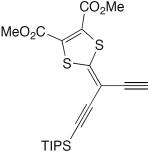
|
|
CuCl, TMEDA, air, CH2Cl2 | 55b | 132 |
| 4 |
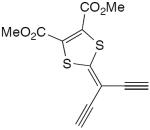
|

|
CuCl, TMEDA, O2, CH2Cl2 | 40b | 132 |
| 5 |

|
|
CuCl, TMEDA, CH2Cl2, air | 60 | 211 |
| 6 |
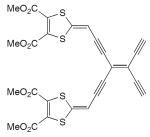
|
|
CuCl, TMEDA, CH2Cl2, air | 18b | 212 |
| 7 |

|
|
1.1 equiv CuCl TMEDA, O2 1,2-dichlorobenzene 80 °C | 67 (mixture of oligomers with n = 2–6) | 143 |
| 8 |

|
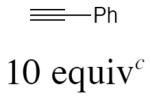
|
CuCl, TMEDA, CH2Cl2, O2, rt | 64 (along with 7% end-capped dimer) | 192 |
| 9 |

|
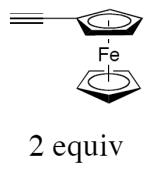
|
1.6 equiv Cu(OAc)2, pyr, O2, 90 °C | 46 | 213 |
| 10 |

|
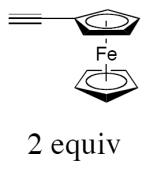
|
1.6 equiv Cu(OAc)2, pyr, O2, 90 °C | 44 | 213 |
| 11d |

|

|
20 mol% CuCl, TMEDA, CH2Cl2, air, 4Å mol sieves, rt, 2 h | 94 (R = NO2, mixture of oligomers n = 2–6) | 142 |
| 93 (R = NMe2, mixture of oligomers n = 2–6) |
Unless noted, a vast excess (10–90 equivalents) of the endcap alkyne was used.
Substrate coupled directly after deprotection from silyl-protected precursor.
Performing the reaction with 1 equiv phenylacetylene afforded nearly equal amounts of endcapped monomer, dimer, and trimer.
For related examples of enediyne oligomerization in lower yields see ref 214.
Scheme 66.
Oligomerization and end-capping of an ene-dyne via Hay coupling.
A similar process was conducted in the oligomerization of a platinum-linked octayne with phenylacetylene (Scheme 67).143 To promote longer chain length oligomers, addition of the monoalkyne endcap was delayed until later in the course of the reaction. The hexameric molecular rod was determined to be over 12 nm in length, and a nearly complete lack of π-electron delocalization across the system demonstrated the insulative properties of the platinum centers.
Scheme 67.
Oligomerization and end-capping of a platinum octayne via Hay coupling.
In addition to polymerizing bisalkynes, it is also possible to oxidative couple two different functional groups under Glaser-Hay condition with complete chemoselectivity. Upon treatment of an alkyl alkyne-containing naphthol with standard, achiral Glaser-Hay catalyst, the oxidative biaryl coupling was demonstrated to occur selectively over Hay coupling (Scheme 68).144 With higher temperatures, a chiral 1,5-aza-cis-decalin copper catalyst was able to perform the asymmetric oxidative biaryl coupling in tandem with the Glaser-Hay alkynyl coupling to afford an enantioenriched binaphthyl polymer with excellent chemoselectivity. Significantly, when as aryl alkyne was incorporated into the naphthol structure, the Hay process was found to occur faster than the naphthol coupling. Overall the relative reaction rates of various moieties with the chiral copper catalyst followed the order: benzyl cyanides >> aryl alkynes > electron-rich 2-naphthols > electron-deficient 2-naphthols > alkyl alkynes. No cross-reactivity of the phenol with the alkyne coupling was observed in any case.
Scheme 68.
Tandem asymmetric oxidative biaryl coupling/Glaser-Hay coupling.
Surprisingly few mechanistic investigations of copper catalyzed alkyne couplings have been reported, given their wide applicability in synthesis, and the potential for improved conditions that a more complete mechanistic understanding could provide. Most work has focused on the stoichiometric versions (Glaser and Eglinton, see Scheme 56), and several hypotheses remain regarding specific oxidation states and structures of the copper intermediates. The available evidence largely supports at least two mechanisms in which deprotonation either precedes or accompanies metal complexation, depending on the reaction conditions. Acidic conditions (pH = 3) decrease the rate of coupling, but activity can be recovered with a copper(I) salt. This observation supports the theory that the copper initially coordinates to the alkyne to form a Cu(I) π-complex, activating the alkyne for deprotonation. In contrast, the coupling is faster under basic conditions and for more acidic terminal alkynes, indicating the possibility of a direct deprotonation pathway. ESR studies on basic solutions detected only copper(II) species, supporting the rapid reoxidation of copper(I) to copper(II). In contrast, this reoxidation is significantly slower under acidic conditions, again indicating alkyne complexation to facilitate deprotonation. With mixtures of alkynes, homocoupled products are formed (see Section II.D.3), making a radical mechanism unlikely, as statistical distributions would be expected. In conjunction with a second order rate dependence on alkyne concentration, the above data supports a mechanism for alkyne dimerization as illustrated in Scheme 69.
Scheme 69.
Mechanism of the Hay version of alkyne dimerization.
A recent DFT study indicated that reaction of two copper acetylide units with molecular oxygen to form a dicopper-dioxygen complex is the key step.226 However, a mechanism involving three copper ions (two Cu(I) and one Cu(II)) for each alkyne unit in the rate-limiting oxidative dimerization step has also been proposed.227 Evidently, a clear understanding of the copper-mediated oxidative coupling of alkynes remains incomplete.
II.D.3. Cross Coupling with Alkynes
The cross coupling of an alkyne with another species is difficult as homocoupling via Glaser-Hay reaction is typically favored (see Section II.D.2). The synthesis of unsymmetrical diynes has been achieved to great success via Cadiot-Chodkiewicz coupling conditions (Scheme 70).228 However, this nonoxidative, copper-catalyzed process requires a prefunctionalized bromoalkyne coupling partner. Consequently, successful development of oxidative cross-coupling of alkynes would potentially access these unsymmetrical diynes in a more direct manner.
Scheme 70.

General example of Cadiot-Chodkiewicz heterocoupling.
Utilizing Hay conditions with two similar alkynes, formation of cross-coupling products can be favored by substrate stoichiometry. Many reports have exploited this concept by employing a vast excess of a less costly alkyne component (see Table 6).119,120 A general method for the cross-coupling of arylacetylenes was recently studied by Kesavan and Balaraman.229 After screening a variety of copper catalysts and bases for the homocoupling of phenylacetylene, the optimized conditions were tested on the cross-coupling of a series of simple aryl and alkyl acetyelenes (Scheme 71). Good to excellent yields of the cross-coupled diynes were afforded using Cu(OAc)2·H2O, piperidine, and air at room temperature. However, a five-fold excess of one of the alkyne partners were required, and, as expected, large amounts of homodimer were also formed.
Scheme 71.

Oxidative cross coupling of alkynes.
A recent example by Schrader and coworkers demonstrates the alkyne-alkyne cross-coupling of more complex substrates useful for artificial signal transduction (Scheme 72).230 Their construction of these transmembrane structures utilized a cross-coupling under Hay conditions to afford the diynes in moderate yield. Cadiot-Chodciewiczk conditions were reported to provide complex mixtures and low yields (<30%) of the unsymmetric dimer. Employing an excess of the simpler alkyne with several equivalents of copper and ligand resulted in much more satisfactory yields for a variety of elaborated terminal alkynes (Scheme 72).
Scheme 72.
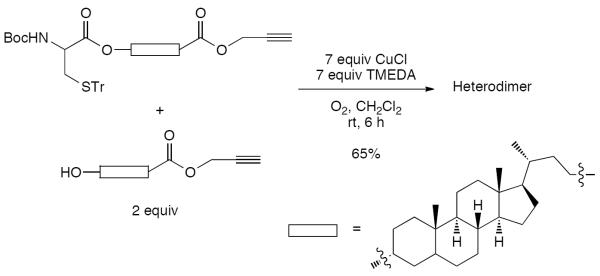
Cross-coupling of complex alkynes.
Another example of complex alkynyl cross-coupling was reported in the synthesis of functionalized oligodeoxynucleotides.196 The reported method allows post-synthetic modification of resin-supported oligodeoxynucleotides containing a terminal alkyne unit with a variety of functionalized alkynes via copper-catalyzed coupling. Specifically, alkynyl modified fluorescein, biotin, and anthroquinone tags were coupled with the resin-bound substrate, and subsequently deprotected with concentrated ammonium hydroxide (Scheme 73).
Scheme 73.
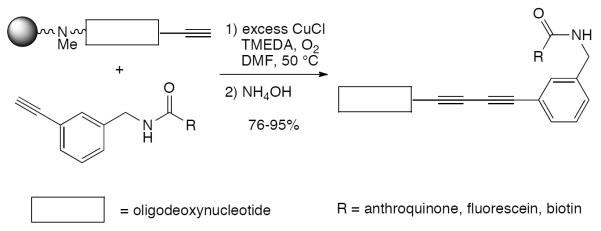
Cross-coupling of resin-bound oligodeoxynucleotides.
For the direct cross-coupling of alkynes, the strategy of using an excess of one partner is the state of the art. However, coupling of alkynyl acids and terminal alkynes via a copper-catalyzed decarboxylative cross-coupling leads to unsymmetric diynes with higher efficiency (Scheme 74).231 In comparison to the previous cross-couplings, only a slight excess of the priopiolic acid is used. However, high temperatures are required, the acids are restricted to aryl and styrylpriopolic acids, and yields are moderate to poor. The process can be considered a green variant of the Cadiot-Chodciewiczk coupling, which employs a haloalkyne. Here the only byproducts of the coupling are carbon dioxide and water instead of hydrochloric acid.
Scheme 74.
Decarboxylative cross-coupling of alkynyl acids and alkynes.
Cross-coupling reactions with a variety of non-alkynyl nucleophiles has also been demonstrated. An interesting cross coupling of alkynes with trifluoromethyl anions has been reported (Scheme 75).232 Formation of the alkyne homodimer proved to be highly favorable and was suppressed by slow addition of the alkyne to the trifluoromethyl anion, “CuCF3” which was generated in situ by combining TMS-CF3 with CuI/phenanthroline and KF. The phenanthroline profoundly affects the product distribution. Its role may include stabilization of the CuCF3 adduct by chelation and increasing the electron density at copper to promote Cu(II) or Cu(III) formation. In this case, the replacement of air with O2 shifted the outcome to the homodimer entirely. While some oxygen is required for the oxidation portion, a high concentration appears to quench the “CuCF3” intermediate.
Scheme 75.
Oxidative cross coupling of alkynes and the trifluoromethyl anion.
Stahl and coworkers accomplished the cross coupling of alkynes with amides in the presence of a moderately strong base (Na2CO3) which presumably assists in deprotonation of the amide (Scheme 76).233 Accordingly, effective nucleophiles in the reactions exhibit a pKa in the range of 15–23 (DMSO). Interestingly, not all substrates with a pKa in this range, including pyridone (17.0) and acetanilide (21.5), are effective. The competitive homodimerization byproduct could be reduced to <5% by utilizing 5 equivalents of the nitrogen nucleophile and by slow addition of the alkyne to the reaction mixture over 4 h. Another process, which may proceed in a similar manner, via alkynyl amines, is outlined in the Section II.D.4 below (see Scheme 92).
Scheme 76.
Oxidative amination of terminal alkynes.
Scheme 92.
Tandem oxidative amination/diketonization of primary anilines and terminal alkynes.
A novel, oxidative construction of C–P bonds was discovered by Han and coworkers when air was introduced while performing copper(I)-mediated hydrophosphorylation of alkynes.234 Rather than providing the expected alkenylphosphrous compounds, reaction of alkynes and H-phosphonates with a copper(I) catalyst in the presence of oxygen provided the corresponding alkynylphosphonates in excellent yield (Scheme 77). Both copper(I) and copper(II) sources were found to facilitate the reaction. A large variety of aryl and alkyl alkynes are tolerated under the reaction conditions. Similarly, complex phosphonates were incorporated in good yield; secondary phosphine oxides, however, were oxidized to the phosphinic acid. Notably, an excess of one of the coupling partners is not necessary in the reaction.
Scheme 77.
Oxidative cross coupling of alkynes with H-phosphonates.
Recently, reports of alkynyl-aryl coupling under copper and oxygen catalysis have emerged (see Section II.E.4). For example, aryl and heteroaryl alkynes can be coupled with polyfluoroarenes in good yield with catalytic copper(II) salts under mild conditions. Additionally, oxazoles have been shown to be capable coupling partners with aryl and alkyl alkynes, affording the conjugated products in moderate yields. In these alknyl-aryl couplings, excess amounts of arene substrate are necessary to minimize the favored Hay dimerizations.
The cross-couplings described in this section may proceed via a bimetallic mechanism similar to that of the Hay alkyne dimerization (see Scheme 69) as outlined in Scheme 78a. In this pathway, the redox couple is between two Cu(II) and two Cu(I). On the other hand, most of the mechanistic work on the coupling of alkynes with other partners (aryl, trifluoromethyl, nitrogen nucleophiles, and phosphonates) points to the alternate pathway in Scheme 78b. Presumably, the mixed copper dimer complex is less stable due to one less π-bonding interaction. In the monometallic pathway, the alkynyl copper species forms first. Subsequent coordination of the nucleophilic coupling partner and oxidation provides a provides a Cu(III) species, which undergoes reductive elimination to a Cu(I) species which is rapidly reoxidized to a Cu(II) intermediate. In both of the proposed pathways, the primary competing process is diyne formation. Consequently, a selective process for cross-coupling must effectively compete with the facile insertion of copper into the C–H bond of an alkyne.
Scheme 78.
Possible alkyne-anion coupling mechanisms.
Additional mechanistic studies of these transformations would provide a useful framework with which to develop improved alkyne cross coupling methods with a broader range of nucleophiles. Further challenges include lowering the amount of excess coupling partner as well as reducing copper catalyst loading.
II.D.4. Oxidative Difunctionalization of Alkynes
The following reactions incorporate functionality at both “termini” of an alkyne. Although difunctionalization with two heteroatoms is common, C–C bond construction followed by a final oxidative C–heteroatom formation can also occur.
In extension to studies on alkene oxidative difunctionalization (see Section III.C.3), Taniguchi has reported the halosulfenylation of internal alkynes.235 This process utilizes copper (I) iodide, 2,2'-bipyridyl, and a tetralkylammonium halide to provide the corresponding trans-haloalkenyl sulfide. Good yields could be obtained for bromides and iodides, whereas chloride was incorporated in low yield. Additionally, both “halves” of the disulfide could be used. A later report236 expanded the substrate scope, demonstrating the use of both disulfides and diselenides, and CsCl and tetrabutylammonium isothiocyanide as successful chloride and isothyocyanide sources, respectively (Scheme 79). The synthetic utility of the method was further demonstrated with a short synthesis of (Z)-tamoxifen, an estrogen antagonist effective against metastatic breast cancer (Scheme 80).
Scheme 79.
Halosulfenylation of alkenes.
Scheme 80.
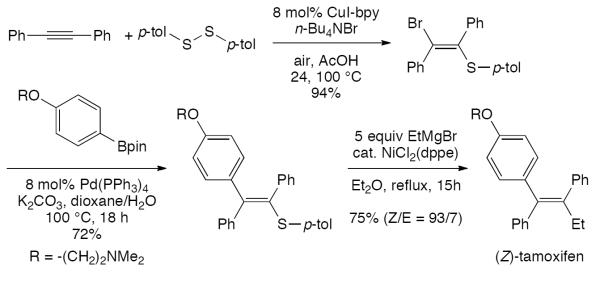
Synthesis of (Z)-tamoxifen.
The mechanism for the transformation (Scheme 81) mirrors that described earlier for the acetoxysulfenylation of alkenes (see Scheme 32). It may also be speculated, particularly due to the sensitivity of halide source utilized, that the reaction proceeds through a halonium intermediate, followed by oxidative sulfide/selenide coupling.
Scheme 81.
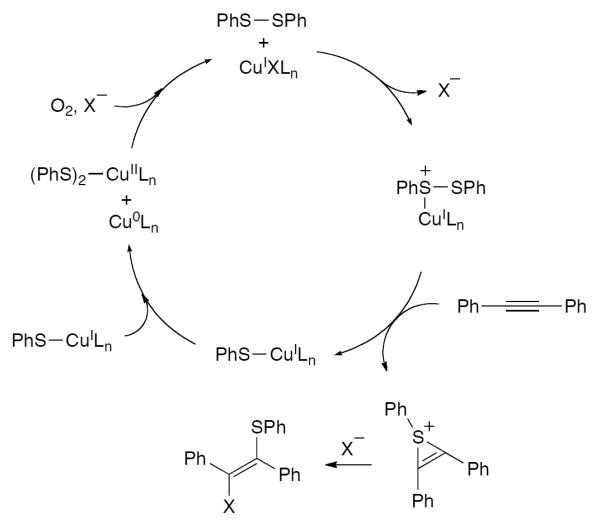
Mechanism of the halosulfenylation of alkynes.
Alkynes can undergo a related process when treated under identical conditions with a sulfinate salt and potassium halide (see Section II.C.3).92 The process allows quick access to (E)-β-haloalkenyl sulfones from terminal alkynes in good to moderate yields (Scheme 82). Internal alkynes containing substitution larger than a methyl group (e.g. diphenylacetylene) provided only trace product. Although the reaction is reported to proceed via radical mechanism, alternative pathways, including halonium formation, may also be postulated.
Scheme 82.

Oxidative halosulfonylation of alkynes.
In a key report by Barluenga and coworkers, the copper-catalyzed cyclization of bis-propargylic esters to regioselectively form substituted furans was investigated.237 The reaction was presumed to proceed through formation of a copper carbene intermediate following cyclization. When the reaction was carried out under air, moderate yields of the oxidized 2-acylfuran products were formed (Scheme 83).
Scheme 83.
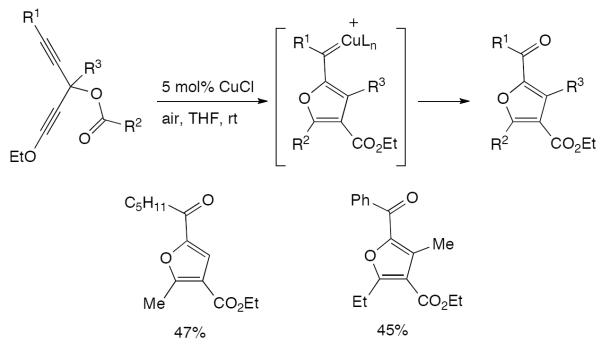
Tandem copper-catalyzed cycloisomerization/oxidation of bis-propargylic esters.
The reaction is proposed to proceed through an initial copper-catalyzed isomerization process that is believed to be a 1,2- or 1,3-acyloxy migration238 to afford an α,β,γ,δ-unsaturated carbonyl (Scheme 84). Copper-promoted 5-exo-dig addition of the carbonyl oxygen to the alkyne forms a vinyl copper(I) species that can isomerize to a copper(II) carbene. Subsequent oxidation with molecular oxygen generates the resultant ketone. Although the copper(II) carbene did not give rise to any cyclopropanated products upon treatment with alkenes, incorporation of silicon and germanium hydrides occurred in a tandem process. Similarly, performing the reaction with several equivalents of ethyl diazoaceate provided the carbon-carbon double bond providing support for the intermediacy of the copper(II) carbene.
Scheme 84.
Oxidative formation of 2-acylfurans from bis-propargylic esters.
The oxidation of copper carbenes to afford 2-acylfurans was later effected via intermolecular cyclization/oxidation sequence using alkynols and an activated alkyne (Scheme 85).239 The process performs well with small loadings of CuI under oxygen to afford ketone or aldehyde-containing furans in good yields from readily available starting materials. Although variation of the alkynol was well tolerated, the activated alkyne is limited specifically to diethyl but-2-ynedioate.
Scheme 85.
Intermolecular oxidative formation of 2-acylfurans.
Subsequent work demonstrated that copper(I) oxide nanoparticles were much more effective catalysts in the reaction, allowing for lower reaction temperatures (50 °C) and different alkyne acceptors to be utilized, such as ethyl phenylpropynoate.240 Supporting the presence of a carbene intermediate, addition of ethyl 2-diazoacetate yielded the anticipated vinylfuran formed in 32% yield.
The first step in the process is a base-catalyzed conjugate addition of the alcohol into the activated ester (Scheme 86). Subsequently, a 6-endo dig carbocupration occurs followed by elimination to form an allenyl intermediate. Further enolization and oxycupration yields the furan core. Generation of the copper carbene and oxygenation by molecular oxygen leads to the final product. Notably, no product is observed in the absence of an oxygen atmosphere. With deuterated alkynol (R-OD), no deuterium incorporation was detected in the products.
Scheme 86.
Possible mechanism of the intermolecular oxidative formation of 2-acylfurans.
An intramolecular oxidative carbocyclization reaction to form 1,4-naphthoquinones was recently reported by Li and coworkers.241 Moderate yields were obtained when employing CuCl2 under oxygen and mild heating. Addition of a cooxidant (i.e. cerium sulfate) noticeably improved the yields, although no product was formed in the absence of either oxygen or copper catalyst. Interestingly, this process incorporates oxygen atoms from both water and molecular oxygen, as well as using oxygen as the terminal oxidant. A wide variety of functionality is tolerated under the reaction conditions, affording elaborated 1,4-naphthoquinones from the corresponding 1,6-enyne substrates (Scheme 87).
Scheme 87.
Oxidative cyclization to form 1,4-naphthoquinones.
Labeling studies using H218O indicated that the exocyclic oxygen derives water, whereas the naphthoquinone oxygen derives from molecular oxygen. No incorporation of ethyl 2-diazoacetate was observed under the optimized reaction conditions, pointing away from a carbene-forming mechanism. A pathway involving addition of water across the alkyne was refuted by the fact that the ketone substrate expected from this transformation did not form the naphthoquinone product. Addition of TEMPO or 1,1-diphenylethene greatly inhibited the reaction, suggesting a radical mechanism may be operating. Based on the above experiments, a potential mechanism can be postulated (Scheme 88). Addition of water to the enyne affords a putative copper(II) enolate, which can subsequently undergo carbocupration with the proximal alkyne. Reaction of the resulting cyclized product with molecular oxygen forms a peroxocopper(III) species. After rearrangement and elimination, the alcohol intermediate is further oxidized to form the fully conjugated 2-keto-1,4-benzoquinones. Expelled Cu(OH)Cl reacts with HCl to regenerate the catalytic species.
Scheme 88.
Mechanism for the oxidative formation of 1,4-naphthoquinones.
An example of copper-catalyzed oxidative cyclizization of alkynes has recently been described by Chiba and coworkers.100 Specifically, 4-benzoylpyrroles are formed in good yield from N-propargyl enamine carboxylates upon exposure to CuCl2, DABCO, and oxygen (Scheme 89). Several aryl alkynes containing aryl and alkyl substitution on the enamine were tolerated under the reaction conditions. The reaction may proceed via a similar mechanism as described for the carbooxygenation of N-allyl enamaine carboxylates (Section II.C.3, see Scheme 46). After initial formation of a peroxycopper adduct with the substrate, subsequent carbocupration of the alkyne affords a cyclized alkyl-peroxycopper intermediate. Isomerization and elimination of a reduced copper species then affords the 4-benzoylpyrrole product.
Scheme 89.
Carbooxygenation of N-propargyl enamine carboxylates to afford 4-benzoylpyrroles.
Miura and coworkers have reported a novel construction of biaryl heterocycles through a tandem oxycupration/oxidative coupling process.242 Specifically, 2-alkynylphenols react with 1,3,4-oxadiazoles using (1,2-phenanthroline)CuF2 and base at room temperature to afford the biheteroaryl products in good to moderate yield (Scheme 90a). The ratio of 2:1 copper:ligand was found to be crucial to reaction efficiency. Although the majority of the report focuses on the use of superstoichiometric copper, the use of catalytic copper has been demonstrated to provide products in slightly lower yield when using MnO2 as a cooxidant (Scheme 90b). Even with MnO2, oxygen was found to be necessary, as reaction under nitrogen gave poor yields. However, a strict oxygen atmosphere also provided poorer efficiency in comparison to air.
Scheme 90.
Tandem oxycupration/oxadiazole coupling with superstoichiometric copper.
A possible mechanism for the reaction (Scheme 91) proceeds via initial oxycupration of the alkyne following copper coordination. Copper-assisted deprotonation of the oxadiazole with K3PO4 affords a vinyl-aryl-copper(II) species. Oxidatively induced reductive elimination provides the biheteroaryl product and subsequent oxidation of the copper regenerates the copper(II) species.
Scheme 91.
Possible mechanism for the oxycupration/oxadiazole coupling.
The first reported synthesis of a-ketoamides via diketonization of alkynes has been reported by Jiao and coworkers.243 This process oxidatively couples a primary aniline with a terminal alkyne using catalytic copper(II)bromide and TEMPO under oxygen. Further reaction with dioxygen forms the dicarbonyl species (Scheme 92). Aryl, heteroaryl, and vinyl alkynes provide the products in good yield, whereas alkyl alkynes did not give product. Electron-rich primary anilines afforded higher reaction efficiency than electron-poor substrates, and no product was observed when alkyl amines were used.
Although addition of several equivalents of water was found to improve the yield, labeling studies identified molecular oxygen as the source of both oxygen atoms in the ketoamide products. EPR studies also indicated the presence of a peroxo radical as a key reaction intermediate. With the above information, a possible reaction pathway (Scheme 93) can be postulated beginning with initial deprotonative coordination of the aniline to copper. Subsequent aminocupration of the alkyne yields a vinyl copper(II) species that can undergo homolytic cleavage, resulting in a stabilized benzylic radical. Reaction with molecular oxygen, cyclization, and further oxidation by either TEMPO or oxygen then releases the ketoamide product. An alternative mechanism, in which an oxidative coupling of the aniline to the alkyne forms an ynamine similar to the couplings of amides to alkynes (see Section II.D.3), may also be possible. Subsequent oxidation of the ynamine by copper and oxygen would then lead to the diketone.
Scheme 93.
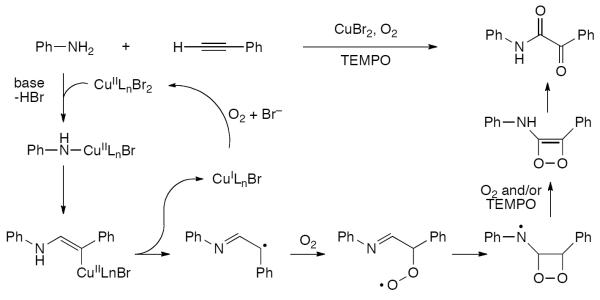
Possible mechanism for oxidative amination/diketonization.
II.E. Arenes
Oxidative C–H insertion reactions of arenes has garnered a considerable amount of attention, and much progress has been seen with palladium catalysts. However, use of inexpensive metal catalysts, such as copper, in combination with oxygen, is a highly attractive alternative. Many recent discoveries have provided a strong foundation for the utility of this approach. Although considerable mechanistic evidence supports the viability of copper C–H insertion to afford an aryl copper intermediate,244 arene oxidations with copper reported in the literature encompass a range of potential mechanisms that can be broadly divided into three categories: 1) nucleophilic attack of the arene on an electrophilic metal, 2) reaction of the arene via a radical cation with a substituent coordinated to copper, or 3) C–H insertion. Pertinent reviews involving C–H bond functionalization of hydrocarbons245 and arenes246 have been recently published, as well as a review on copper-mediated oxygen insertion reactions.247
II.E.1. Arene Hydroxylation
This section focuses on the introduction of an hydroxyl substituent onto arenes via oxygenation. Sections below discuss other oxidative oxidative C–H insertions of arenes. Oxygenative C–H functionalization of hydrocarbons typically proceed via radicals. As such, functionalization of the strong arene C–H bonds presents a significant challenge since other benzylic or alkyl centers possess weaker C–H bonds and will react competitively or preferentially. Therefore, the main target for arene oxygenation is the direct conversion of benzene to phenol. Due to the industrial significance of phenol as a key commodity chemical, an efficient preparation from benzene using an inexpensive catalyst and oxygen would provide an attractive alternative to the current three-step process from cumene.
A patent by Dow Chemical Company in 1968 described the generation of phenol from benzene using a copper(I) source under oxygen and acidic conditions in 7.5% yield with respect to copper.248 Similar yields of phenol were later reported by Sasaki and coworkers using dilute aqueous sulfuric acid, CuCl, and oxygen at room temperature (Scheme 94).249 Hydroquinone also forms in significant quantities, along with smaller amounts of catechol.
Scheme 94.

Copper-mediated oxygenation of benzene.
Copper serves as a reductant in this process, reacting with oxygen under acidic conditions to form hydroxyl radicals. Copper(II), confirmed to be inactive as a catalyst, is generated through the process. The mechanism presumably proceeds through attack of the hydroxide radical on benzene to afford a hydroxycyclohexadienyl radical (Scheme 95). One electron oxidation and rearomatization affords the phenol product. Alternatively, formation of hydroquinone byproduct can occur through reaction of the radical intermediate with molecular oxygen, as observed in an 18O2 labeling study.250 Additional support for this mechanism was found in the high selectivity of phenol in the absence of oxygen and using hydrogen peroxide as the hydroxyl radical precursor.
Scheme 95.
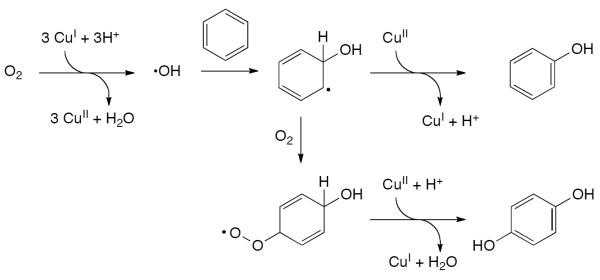
Postulated mechanism for the copper-mediated oxygenation of benzene.
Additional studies have focused on identifying reducing conditions for copper(I) regeneration, including electrochemically251 or with ascorbic acid (Scheme 96),252 and conditions to affect the phenol/hydroquinone ratio.253
Scheme 96.

Copper-mediated oxygenation of benzene with a coreductant.
Several heterogeneous and supported copper-containing catalysts have been tested in this transformation in both liquid254 and gas phase.255 Unfortunately, conversions remain low and selectivity remains problematic, with very low yields of phenol (<10%) even in the presence of a coreductant. Mixtures of O2/H2 can be used in the gas phase reaction for oxygenation and reduction of copper(II), respectively. However, both conversion and selectivity remain poor, and combustion products are primarily formed.
When treated under similar reaction conditions, toluene is converted to a mixture of benzyl alcohol, benzyl chloride, benzaldehyde, benzoic acid, methylhydroquinone in addition to all three crescol isomers.256
II.E.2. Reactions Involving Nucleophilic Arenes
Oxidative functionalization of arenes occurs in certain cases wherein the arene acts as a nucleophile. Expectedly, highly electron-rich arenes are common substrates in these processes. An example of such nucleophilic coupling was reported in the cross coupling of arylboronic acids with arenes using the very electrophilic Cu(OCOCF3)2 reagent and oxygen (Scheme 97).257 This transformation proceeds via attack of the nucleophilic arene onto Cu(OCOCF3)2 to form an aryl-copper(II) species and an equivalent of CF3CO2H. Transmetallation with the arylboronic acid followed by oxidatively induced reductive elimination then affords the biaryl product and a reduced copper species. Stoichiometric amounts of copper were necessary for useful yields, as low turnover was observed with catalytic copper. Other copper salts, including very electrophilic Cu(OTf)2, were found to be ineffective for the transformation. Interestingly, no homocoupling of either arene or boronic acid substrates were detected (for homocoupling of arylboronic acids see Section III.C.5.). A range of biaryl products was afforded through this method in moderate to good yields. Notably, multiple C-H bond arylations were possible when indoles or pyrroles were used as the arene nucleophile (right half of Scheme 97).
Scheme 97.
Oxidative coupling of nucleophilic arenes with aryl boronic acids.
Raja and Ratnasamy reported an early investigation of oxyhalogenation utilizing a zeolite-supported copper phthalocyanine catalyst and oxygen.93 In their study, several simple arenes were subjected to oxidation using oxygen with a catalytic amount of TBHP as initiator, and either bromide or chloride as the halogen. Both reactivity and selectivity proved particularly challenging: toluene yielded mixtures of ortho- and para-monohalogenation, polyhalogenation, as well as significant amounts of benzylic oxidation products. Substrates lacking benzylic functionality, such as anisole, aniline, and phenol, provided mixtures of halogenated products. The regiochemical product distribution observed when treating toluene with Br2 was very similar to that observed under the oxyhalogenation conditions, lending support to an electrophilic aromatic substitution mechanism. Spectroscopic detection of Br3− ion provided further evidence towards the copper-catalyzed oxidation of bromide to molecular bromine.
A more recent report by Stahl and coworkers reports the efficient substitution of electron-rich arenes with halides using catalytic copper(II) halides and oxygen (Scheme 98).94 Notably, both LiBr and LiCl can be utilized to regioselectively afford the corresponding aryl bromide or chloride, although more forcing conditions are required in the latter case. As previously described, the mechanism for bromination is believed to operate through formation of Br2 and electrophilic aromatic substitution. Alternatively, chlorination is postulated to occur through a single electron oxidation of the arene and subsequent reaction with a chlorine source. In both cases, the possibility of a copper(III) intermediate, however, cannot be definitively ruled out.
Scheme 98.
Copper catalyzed oxidative halogenation of non-phenols.
A regioselective oxybromination of arenes using water as solvent can be effected using as little as 1 mol % Cu(NO3)2 as the catalyst (Scheme 99).258 While this method was largely explored with phenolic substrates (see Section VII.I.1.), anisole was found to selectively afford the para-monobrominated product in 95% isolated yield. Toluene, a less activated substrate, also displayed excellent conversion and selectivity under the mild reaction conditions, whereas arenes containing electron-withdrawing substituents, such as chlorobenzene or nitrobenzene, were unreactive. The reported method offers an environmentally benign and atom-economical approach for halogenation of arenes.
Scheme 99.
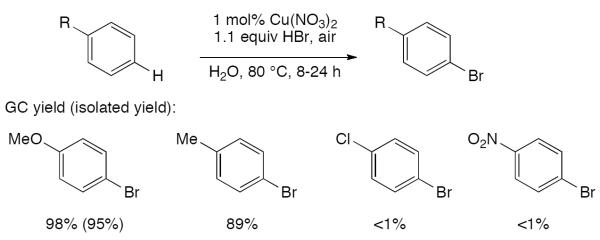
Aqueous copper catalyzed oxidative bromination of non-phenols.
The direct oxidative fluorination of arenes has met with more limited success. A notable report by Subramanian and Manzer describes the use of CuF2 as a catalyst and fluorinating agent for the oxidative fluorination of benzene to fluorobenzene (Scheme 100).259 The gas-phase reaction is performed at high temperatures, and provides approximately 30% conversion at 550 °C with very high levels of selectivity to fluorobenzene (>95%). When conversion begins to decrease, the copper catalyst is regenerated by treatment with HF and oxygen at 400 °C. The described process offers an inexpensive and more environmentally benign alternative for the formation of aryl C–F bonds in comparison to the classical Balz-Schiemann reaction. These conditions are also reported to be suitable for the synthesis of other fluoroaromatics.260 Exact mechanistic details of this oxyfluorination method remain undetermined.
Scheme 100.

Gas-phase oxyfluorination of benzene.
The synthesis of aryl sulfides through an aerobic oxidative coupling of highly electron-rich arenes with disulfides has been accomplished using a copper catalyst (Scheme 101).261 Copper(I) iodide with oxygen were found to be the most effective catalyst and oxidant, respectively. Aryl, alkyl, benzylic, and allylic disulfides were successfully employed, and diselenides could also be used to generate the corresponding aryl selenide. Notably, both “halves” of the disulfide and diselenides starting materials were consumed in the reaction. Trimethoxyarenes proved suitable arene substrates while dimethoxyarenes provided lower yields.
Scheme 101.
Copper catalyzed oxidative thiolation of electron-rich arenes.
Radical inhibitors, such as BHT and TEMPO, did not inhibit the reaction, suggesting a non-radical pathway. Replacement of the disulfide with preformed PhSCu(I) provided the product in good yields under oxygen, indicating its potential intermediacy in the reaction. The authors propose a mechanism in which the arene substrate reacts with the copper catalyst to form a copper(I) aryl species. Subsequent reaction with the disulfide affords product and a copper(I)thiolate complex. Oxidation and reaction with arene substrate forms a copper(II) species, which, upon reductive elimination and reoxidation affords the second unit of product and regenerates the active catalyst. However, a mechanism similar to that for oxidative sulfenylation of alkynes and alkenes (see Sections II.C.3. and II.D.4.) may also be postulated, in which the copper catalyst initial coordinates to the disulfide. This activated complex is subsequently attacked by the nucleophilic arene to provide product and a copper(I)sulfide species. Disproportionation, and oxygen mediated reductive elimination regenerates the initial copper catalyst as well as a molecule of disulfide. Further mechanistic studies are needed to distinguish between these alternatives.
II.E.3. Directed Insertion of Arenes
Coordinating groups have proven remarkably effective in directing the position of substitution in palladium catalyzed oxidative arene insertion chemistry. A similar effect has been observed in copper catalyzed oxidative insertion chemistry. Perhaps the most widely used directing group is the 2-pyridyl moiety. In 1999, Tollman and coworkers reported the synthesis of a copper complex with a 2-(diethylaminomethyl)-6-phenylpyridine ligand (Scheme 103).262 Exposure to oxygen gave rise to a bis(μ-oxo)dicopper species, which upon thermal decomposition and decomplexation afforded the ortho-hydroxylated ligand. Although the process was ligand specific, stoichiometric in copper, and low-yielding, the report set an important precedent of directed oxidative functionalization of arenes using a 2-pyridyl moiety.
Scheme 103.
Arene hydroxylation of a bis(μ-oxo)dicopper complex.
Yu and coworkers have described a catalytic oxidative chlorination of arenes using a pyridyl directing group with CuCl2 with oxygen (Scheme 104).263 Bis-ortho-chlorination was typically observed, unless an ortho position was blocked or steric hindrance was significant. Other copper sources and nucleophiles were also investigated.
Scheme 104.
Copper catalyzed directed chlorination of 2-pyridylarenes.
Catalytic acetoxylation was effected using catalytic Cu(OAc)2 with Ac2O/AcOH as solvent, providing a mixture of mono- and bis-acetoxylated products (Scheme 105). Although bromination, iodination, cyanation, alkoxylation, hydroxylation, thiolation, and amination were achieved in poor to moderate yields, stoichiometric amounts of Cu(OAc)2 were required.
Scheme 105.

Copper catalyzed directed acetoxylation of 2-phenylpyridine.
The reaction is proposed to proceed via a radical cation intermediate after coordination of CuCl2 to the ortho-pyridyl group (Scheme 106). Subsequent trapping of the radical with the nearby CuCl2 accounts for the regioselection as well as the fact that biphenyl does not react under these conditions. The reaction is first order in substrate and copper catalyst, consistent with rate determining formation of a radical cation if formation of the pyridyl complex is not highly favorable, a likely event since the reaction is conducted under acidic conditions (HCl produced from dichloroethane). Additional evidence for the proposed mechanism is found in the absence of an isotope effect when using an ortho-deuterated substrate as well as the slower reactivity of electron poor arenes.
Scheme 106.
Putative mechanism of the directed chlorination of 2-pyridylarenes.
Later work by Cheng and coworkers expanded the oxidative acyloxylation of arenes using the 2-pyridyl directing group.264 Notably, the reported method utilizes only three equivalents of anhydride and toluene as solvent (Scheme 107). Again, the bis-ortho-functionalized product predominates unless steric blocking is introduced. Although high heat is necessary (145 °C in a sealed tube), ester, halogen, cyano, and ether functionality are tolerated on the aryl-pyridine substrate. Methanesulfonyl anhydride did not provide any product. In contrast to the previously discussed mechanism (Scheme 106), a different pathway was proposed based on the observation that 2 mol% of radical inhibitors TEMPO or BHT did not suppress the reaction. Instead, a mechanism involving formation of a metalated aryl-copper(III) species is postulated. Reductive elimination would afford the acyloxylated product along with a copper(I) species, which can be reoxidized by oxygen to copper(II) and close the catalytic cycle. However, it is not clear that 2 mol% of a radical inhibitor would be sufficient to complete suppress the process outlined in Scheme 106. If rate-limiting metalation is occurring, deuterium labeling studies would provide further support for this mechanism.
Scheme 107.
Directed oxidative acyloxylation of 2-pyridylarenes.
Subsequent work demonstrated the use of acyl chlorides as anhydride precursors, thereby expanding the scope of available acyloxy coupling partners (Scheme 108).265 Interestingly, the authors observed high ortho-chlorination yields when the added base was changed from t-BuOK to Li2CO3 (Scheme 109). This change in reactivity is not yet fully understood.
Scheme 108.
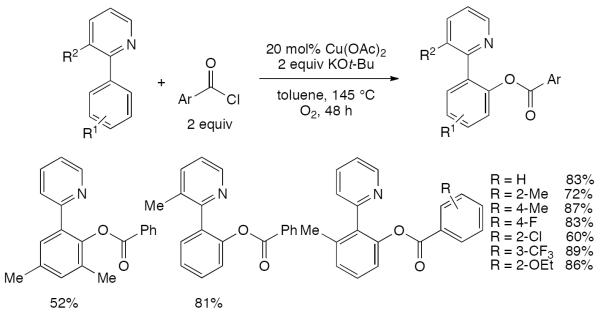
Directed oxidative acyloxylation using acyl chlorides.
Scheme 109.
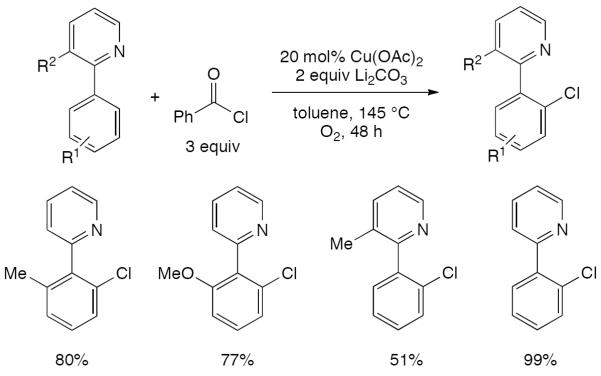
Directed oxychlorination using benzoyl chloride.
Catalytic amidation of 2-phenylpyridine has been described with a variety of nitrogen nucleophiles using Cu(OAc)2 and oxygen (Scheme 110).266 Notably, the reaction is completely regioselective as well as selective for the monosubstituted products. Solvent was observed to be critical to achieving catalytic turnover, with a mixture of anisole and small amounts of DMSO able to overcome product inhibition. Sulfonamides, carboxamides, and p-nitroaniline were found to serve as successful amidating reagents. Variation of the arylpyridine substrate was not reported. A similar mechanism to that outlined in Scheme 106 is proposed.
Scheme 110.
Directed oxidative amidation of 2-phenylpyridine.
Ortho-nitration of arylpyridines can be effected using AgNO3 with Cu(OAc)2 and oxygen (Scheme 111).267 Again, solvent was found to be critical in developing a catalytic process. Examination of nitrating sources showed AgNO2 to be nearly as effective, whereas Fe(NO3)2 provided no product, and NaNO3 instead gave rise to the ortho-hydroxylated product. Mono-ortho-nitrated products were afforded in moderate to excellent yield for a variety of substrates using this method. Replacement of the 2-pyridyl group with pyrimidine, pyrazole, and thiazole did provide the ortho-nitration product, but in lower efficiencies (Scheme 112). In contrast, 3-pyridyl and 4-pyridylarenes did not yield any of the product, demonstrating the necessity of a proximal nitrogen directing group.
Scheme 111.
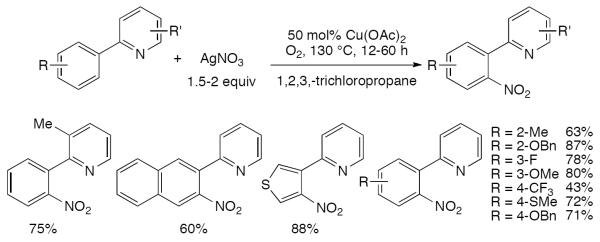
Directed ortho-nitration using a pyridyl directing group.
Scheme 112.
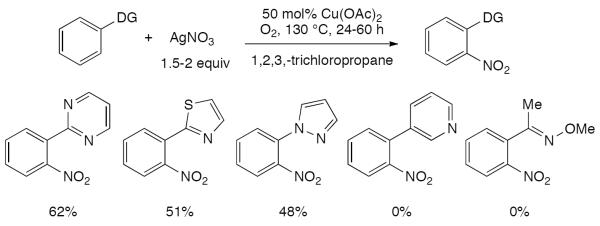
Copper-mediated nitration with varying directing groups.
Employing an ortho-deuterated substrate exhibited a significant kinetic isotope effect (kH/kD = 6.5, supporting a mechanism operating differently than was reported for directed ortho-chlorination (Scheme 106). Additionally, stoichiometric TEMPO completely inhibited the reaction, indicating a radical pathway. In light of these experiments, a possible mechanism is postulated to proceed via initial coordination of a copper(II) species to the directing group, with ligand exchange occurring either before or after coordination (Scheme 113). Nitration can then proceed through a 4-centered transition state involving aryl C–NO2 bond formation with concomitant generation of a Cu(II)(OH)(OAc) species. The proposed process, however, starts and ends with copper (II) and does not account for the necessity of dioxygen even though a different product distribution is seen under a nitrogen atmosphere. Further mechanistic studies are needed to elucidate the exact role of dioxygen as well as the significant solvent effects.
Scheme 113.

Proposed mechanism for directed ortho-nitration with a pyridyl directing group.
Copper-catalyzed oxidative formation of phenanthridine derivatives has been reported using biaryl-2-carbonitriles.268 The process utilizes an N-H imine (for imine oxidations see Section V.F.), generated from nucleophilic addition of a Grignard reagent to the nitrile, as the directing group for aryl C–H bond substitution (for a related imine-directed benzylic C–H oxygenation, see Scheme 10). Several copper salts were found to facilitate the oxidative bond formation, while other metals such as palladium, cobalt, iron, and manganese provided only the Grignard addition products. The reaction tolerated aryl and alkyl Grignards, including sterically encumbered reagents. However, the oxidative cyclization was greatly inhibited by electron-rich aryl Grignards, perhaps lowering the electrophilicity of copper (see below). Phenanthridines with halogen, ether, fluoro, and trifluoromethyl substitution were synthesized in good to excellent yields.
Performing the reaction with stoichiometric copper under a nitrogen atmosphere provided only 21% yield of the cyclized product, indicating that molecular oxygen plays a critical role. A potential mechanism for the reaction proceeds via initial addition of the Grignard reagent to the nitrile and protonation with methanol. After generation of an iminyl copper(II) species with the resulting N-H imine, intramolecular electrophilic aromatic substitution can ultimately form a copper(II) metallocycle. Molecular oxygen may help facilitate reductive elimination of the cyclized product, in addition to reoxidation of the copper species to close the catalytic cycle.
Tetrahydropyrimidine, a cyclic amidine, can also be effective as a directing group for oxidative arene C–H functionalization.269 For example, treatment of 2-phenyl-1,4,5,6-tetrahydropyrimidine with one equivalent of H2O and Cu(OAc)2 under oxygen afforded the ortho-hydroxylated product in good yield after trapping with triphosgene (Scheme 116). Amidation could also be achieved, using either BocNH2 or TsNH2 and trapping as the cyclic carbamate after treatment with triphosgene. The reaction did not proceed when the pyrimidine nitrogen was methylated. Similarly, replacement with imidazole or dihydroimidazole moieties abrogated reactivity. Even though oxygen empirically provided higher reaction efficiencies, stoichioimetric amounts of copper catalyst were required for the transformation. The reaction was proposed to proceed through a single electron oxidation mechanism, similar to that for 2-pyridyl-directed hydroxylation (see Scheme 106).
Scheme 116.
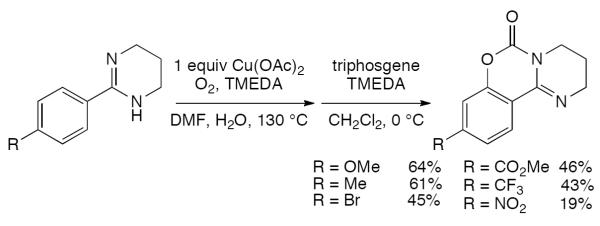
Arene hydroxylation using a cyclic amidine directing group.
Buchwald and coworkers reported an intramolecular oxidative cyclization to afford benzimidazoles employing Cu(OAc)2 in the presence of oxygen (Scheme 117).270 In this case, aryl amidines serve as effective directing groups for oxidative formation of the aryl C–N bond. Successful cyclization was only observed for with amidines containing hindered R2 substituents. The described method employs inexpensive reagents and produces only water as byproduct.
Scheme 117.
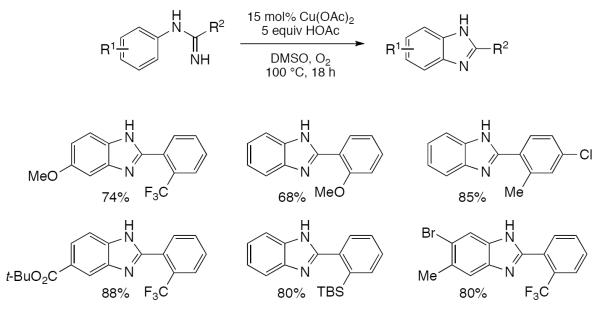
Amidine-directed oxidative intramolecular C-H insertion into arenes.
The exact mechanism of these types of transformations remains undefined. Three possible pathways, all which initially form an initial copper adduct with concomitant deprotonation, are outlined in Scheme 118. Pathways A and B proceed via one-electron oxidation of the aryl ring to form a radical cation. Attack of the radical on copper can form a metallocyclic copper(III) species, as shown in pathway A. Reductive elimination then affords product and a reduced copper. In pathway B, the radical cation directly reacts with the nitrogen of the amidine to displace Cu(I)OAc and benzimidazole product upon rearomatization. Finally, pathway C invokes a copper nitrene intermediate, which may proceed either via direct insertion of nitrogen into the C–H bond, or through electrocyclic ring closure and [1,3] hydride shift. Further investigations are necessary to obtain a more accurate mechanistic understanding.
Scheme 118.
Possible mechanisms for the directed oxidative insertion.
A formally similar process has been reported in the synthesis of benzoxazoles from acylanilines.271 The method employs Cu(OTf)2 under air and high temperatures to effect a regioselective oxidative C–O bond formation and afford the cyclized products in good to excellent yield (Scheme 119). Coordinating groups at the meta-position, such as acetate, 2-pyrrolidinone, or pyrazole groups, also direct the C-H insertion and selectively provide the more hindered 2,7-substituted benzoxazoles (Scheme 120); the observed selectivity is attributed to the formation of a doubly coordinated copper intermediate. The authors propose a mechanism proceeding via metallocycle formation and reductive elimination consistent with pathway A in Scheme 118.
Scheme 119.
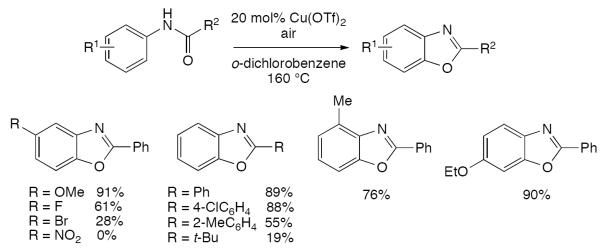
Directed oxidative cyclization of acylanilines.
Scheme 120.
Oxidative cyclization of acylanilines with meta-coordinating groups.
Electronic effects from substituents on the starting anilide greatly affected the rate and yield, with electron-rich substrates reacting much faster. In line with this observation, the authors propose initial coordination of the copper catalyst to the amide and subsequent electrophilic aromatic substitution to form a cyclometallated copper(II) species (see Scheme 118, Path A). Reductive elimination and reoxidation of the copper provides the cyclized product and closes the catalytic cycle.
In 2002, Stack and coworkers described a triazamacrocyclic copper(II) complex, which, under anaerobic conditions, disproportionated to afford a stable Cu(III) species and had undergone C–H insertion of the nearby arene bond.244a Stahl and coworkers later reported the coupling of this aryl-copper(III) complex with acidic nitrogen272 as well as oxygen273 nucleophiles in what, overall, represents an oxidative arene C–H functionalization (Scheme 121). Similarly, Wang has reported similar reactivity of a copper(III) complexes of azacalixaromatics using a variety of nucleophiles including halide, cyanide, thiocyanide, carboxylate, alkoxide, and phenoxide (Scheme 122).274
Scheme 121.

Arene C–N and C–O bond formation of an aryl-copper(III) macrocycle.
Scheme 122.
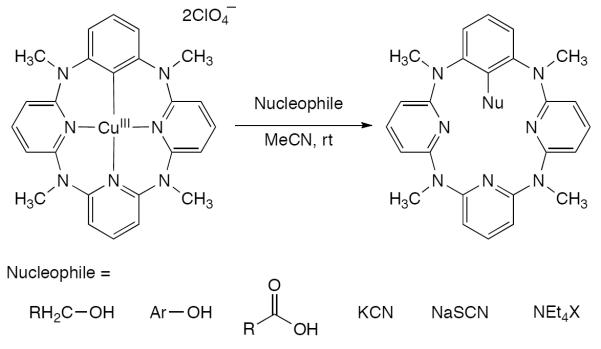
Arene functionalization of a copper(III)-azacalix[1]arene[3]pyridine complex.
In a significant advance, catalytic arene oxidative functionalization was realized in a system where the copper(III) complex could be spectroscopically detected (Scheme 123).275 Using the aza-crown macrocyclic system with a copper(II) source and oxygen, oxidative functionalization of the arene C–H bond with suitable nucleophiles such as methanol or pyridone could be effected catalytically and in high yield.
Scheme 123.
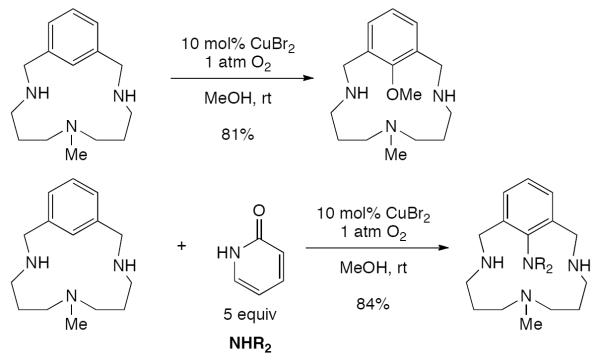
Catalytic C–N and C–O functionalization of a triaza-macrocyclic arene.
Although the described method offers limited synthetic utility due to the necessity of the macrocyclic “auxiliary”, it provides a highly useful platform for mechanism studies. Kinetic data revealed the reaction to be first-order in Cu catalyst and substrate and zero-order in pO2, indicating that the rate-limiting step(s) involve the macrocycle and copper, while the oxidation processes are comparatively fast. Separate mechanistic studies of the reductive elimination of Cu(III)macrocyclic species have been reported.276 With additional data from UV-Vis and EPR spectroscopy, a proposed reaction pathway was postulated beginning with initial complexation of the macrocycle with copper(II) (Scheme 124). Disproportionation and concomitant C–H activation affords a copper(III) arene intermediate as well as a copper(I) species that can be oxidized by oxygen to reenter the cycle. After ligand exchange with the nucleophile, the copper(III) species undergoes reductive elimination to afford the functionalized arene product. In these transformations, oxygen acts as the terminal oxidant to regenerate copper(II) from copper(I) produced from both disproportionation and reductive elimination processes.
Scheme 124.
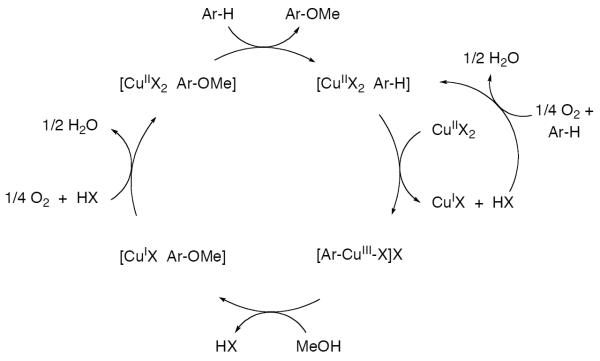
Proposed mechanism for the oxidative functionalization using an aza-macrocycle.
As early as the 1840's, accounts of the pyrolysis of benzoic acid in the presence of copper salts reported the formation of small amounts of phenyl benzoate.277 Later studies with similar experiments identified salicylic acid and phenol in addition to the benzoate.278 This carboxylate-directed hydroxylation process remained largely unexplored until a series of patents emerged from the California Research Corporation and Dow Chemical Company in the 1950's, which reported the synthesis of phenols from benzoic acids using copper salts at high temperatures.279 Traditionally, phenol is produced along with acetone via cumene oxidation.32 The synthesis of phenol from inexpensive toluene via initial cobalt-catalyzed oxidation to benzoic acid was of particular industrial interest as a means to generate phenol decoupled from acetone production. Subsequent reports in the literature280 more fully detailed what is now known as the Dow Phenol Process.281 Treatment of benzoic acid with catalytic copper(II) benzoate, steam, and oxygen at temperatures in excess of 200 °C provided phenol via an oxidative decarboxylation process. Water, in the form of steam or generated in the oxidation of the Cu(I) salts with oxygen, is necessary to hydrolyze the initially formed phenyl ester. Aqueous conditions using CuSO4 have also been reported (Scheme 125).282 As phenol can be further oxidized under the harsh reaction conditions, it is necessary to remove it as it forms from the reactor, which is typically achieved through distillation. A continuous flow system of high temperature water utilizing CuO and oxygen has also recently been reported for this process (Scheme 126).283
Scheme 125.

Oxidative decarboxylation of benzoic acid.
Scheme 126.

Oxidative decarboxylation in a high temperature water continuous flow system.
By using stringent aprotic conditions, the process could be conducted without decarboxylation to afford the salicylic acid intermediate (Scheme 127).284 However, conversions were low, and only one example was shown to perform with catalytic copper in the presence of oxygen.
Scheme 127.
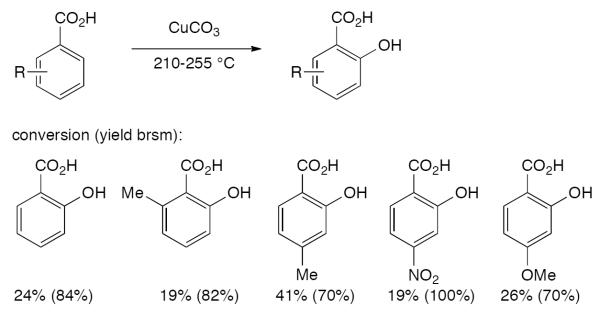
Oxidation of benzoic acids to form salicylic acids.
Application of the process to toluic-acids also led to the expected phenolic products.280b Slightly lower yields are observed due to competitive oxidation of the benzylic position and formation of ester products. Significantly, both ortho- and para-toluic acid provided the expected meta-cresols as the sole products, while meta-toluic acid yielded a 1.5:1 mixture of para- and ortho- cresol. The observed regioselectivity indicated an ortho-functionalization process, rather than reaction at the ipso-carbon. Unfortunately, application to more advanced substrates is limited due to the harsh reaction conditions, under which most functionality, undergoes competitive reaction.285,286
Several studies have been performed to probe the mechanism of this transformation. Buijs reported a thorough review as well as additional analysis of the mechanism in 1999.287 Key contributions were made by Schoso and coworkers, using 14C-labeled benzoic acid to demonstrate that at least 99% of the reaction proceeds through oxygenation at the ortho-position relative to the carboxyl group.288 A few years later, Furukawa performed the reaction with 18O-labeled benzoic acid.289 Analysis showed nearly complete incorporation of 18O at the phenol, indicating benzoic acid as the oxygen source and not water or oxygen. Both radical inhibitors and radical promoters had only small effects on reaction performance in terms of conversion and selectivity.290 An early mechanistic proposal put forth by Toland involved nucleophilic attack of a nearby carboxylate at the ortho-position of another molecule of benzoate along with two-electron oxidation to form copper(0) and expulsion of CO2.280a Although copper metal was not detected in the reaction, it was postulated that rapid reaction with a copper(II) salt formed two copper(I) species. Schoo, and later Kaeding, propose a homolytic radical cage mechanism, involving two single-electron oxidations.291 The process proceeds via homolytic cleavage of the benzoyl-copper bond and subsequent formation of the aryl-oxygen bond (Scheme 129). Further oxidation and elimination affords the initial ortho-ester product. Hydrolysis and decarboxylation affords the phenol. While this outline has become the most-accepted mechanistic path for the reaction, Buijs has more recently described the reaction as a two-electron oxidation of a dinuclear copper(II) benzoate paddlewheel structure. Subsequent electrophilic aromatic substitution of the resulting benzyloxy cation with benzoic acid affords the initial product.287 Additional studies are necessary to delineate a definitive mechanistic account.
Scheme 129.
Possible mechanism for the oxidative decarboxylation of benzoic acid.
Reinaud and coworkers reported the selective ortho-hydroxylation of arenes using an N-methylalanine amide as a directing group.292 The process utilizes stoichiometric metallic copper(0) under oxygen as well as several equivalents of trimethylamine N-oxide (TMAO) to afford the corresponding salicylamides after acid decomplexation (Scheme 130). Methylation of the amide did not afford product, indicating the importance of amide chelation in the mechanism. Oxygen is necessary for formation of the copper(II) salt of the carboxylate starting material, while TMAO is necessary for the hydroxylation. These roles are confirmed through observation of the copper(II) complexation, but no product formation under oxygen in the absence of TMAO. Similarly, reaction with Cu(OH)2 and TMAO under nitrogen affords the ortho-hydroxylated products, albeit at a slower rate. Substitution of the arene showed pronounced electronic effects on reactivity. Electron-withdrawing substituents significantly accelerated hydroxylation, with the opposite effect observed for electron-donating substituents. Decreased amide acidity is proposed to account for these observations.
Scheme 130.
Ortho-hydroxylation of N-methylalanine benzamides.
The reaction was later investigated by Comba and coworkers, who observed that additional methylene spacers either between aryl and amide or amide and carboxylate provided none of the hydroxylated product, indicating the specific nature of the directing group.293 An X-ray structure of the copper intermediate was identified as a 5-membered amidate-copper complex with two TMAO ligands. This structure was notably highly preorganized for oxygen transfer from copper to the ortho-arene carbon. The reaction is postulated to proceeded via formation of a 5-member copper(II) amidate complex (Scheme 131). Oxidation of the copper with TMAO would then form an oxycopper(III) species. Subsequent oxygenation of the aromatic ring and intramolecular hydrogen transfer would afford the product as its copper(II) salt.
Scheme 131.
Possible mechanism for ortho-hydroxylation of N-benzoyl-2-methylalanine.
II.E.4. Functionalization of Acidic Arene Positions
The use of copper catalysts with oxygen to functionalize acid sites of arenes is an area that has garnered significant attention in recent years. Use of preformed aryl anions is discussed in Section III.A. Here, certain types of arenes undergo oxidative functionalization either via an SNAr pathway of via copper insertion into acidic positions. These types of oxidative functionalization are divided below by the different nucleophilic classes: nitrogen nucleophiles (amines, anilines, amides, sulfonamides, and sulfoximines - see also Sections VIII and IX), thiols (see also Section XII), and alkynes (see also Section II.D.3). Alternately, homocoupling can occur to yield biaryl compounds via C–C bond formation. To date, arenes able to undergo this type of reactivity are largely limited to azoles and polyfluorarenes, with the majority of reports focusing on the former.
The coupling of a variety of nitrogen species with azoles at the 2-position has been reported using catalytic Cu(OAc)2 under oxygen at high temperature (Scheme 132).294 A screen of several bases revealed NaOAc, a very weak base, to be the most effective. While not critical for product formation, the addition of a phosphine ligand, PPh3, was found to improve the yield. Suppression of the favored azole homocoupling pathway was achieved by using 4 equivalents of the nitrogen nucleophile. Under these conditions, secondary amines, anilines, and sulfonamides could be coupled with (benzo)thiazoles, benzoxazoles, and benzimidazoles in moderate to good yields.
Scheme 132.
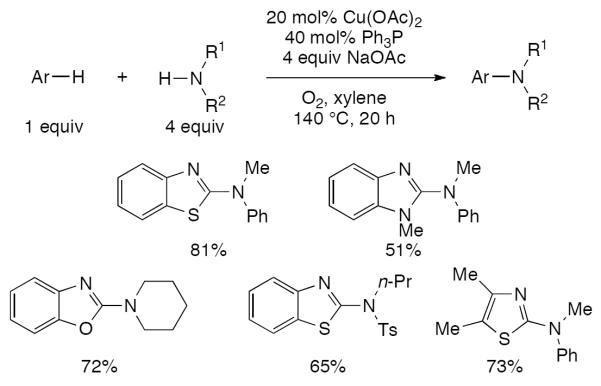
Copper-catalyzed coupling of azoles with amine nucleophiles.
Schreiber and coworkers independently reported a related method employing similar reaction conditions.295 Secondary amides, ureas, carbamates, and sulfonamides gave the desired heterocoupled products in good yield (Scheme 133). Primary nitrogen nucleophiles required the use of stoichiometric amounts of copper to due product complexation. While homodimerization of the aryl substrate was often observed, this process was suppressed by addition of 5 equivalents of coupling partner. In addition, the coupling of a small number of tetrafluorobenzenes with 2-pyrrolidinone was achieved in modest yield (Scheme 134).
Scheme 133.
Copper-catalyzed coupling of azoles with acidic nitrogen nucleophiles.
Scheme 134.
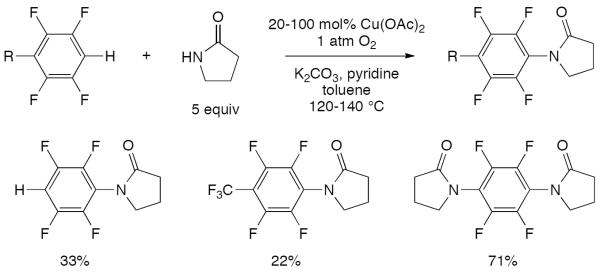
Copper-mediated coupling of polyfluoroarenes with 2-pyrrolidinone.
Coupling of azoles with sulfoximines using catalytic copper catalyst under air has been reported (Scheme 135).296 In sharp contrast to the preceding reactions, the present transformation is conducted at room temperature, and the nitrogen nucleophile is used as the limiting reagent. Other copper salts such as Cu(OTf)2 or CuI could be used with similar results while addition of amine ligands such as TMEDA showed a deleterious effect. Good yields were achieved with 1,3,4-oxadiazoles, benzoxazoles, and benzothiazoles, but other heteroarenes were unsuccessful. The mildness of the reaction allowed for coupling of an enantioenriched sulfoximine with complete retention of configuration. Use of stoichiometric copper(II) acetate under nitrogen afforded only trace amounts of product, indicating the role of molecular oxygen as more than a terminal oxidant.
Scheme 135.
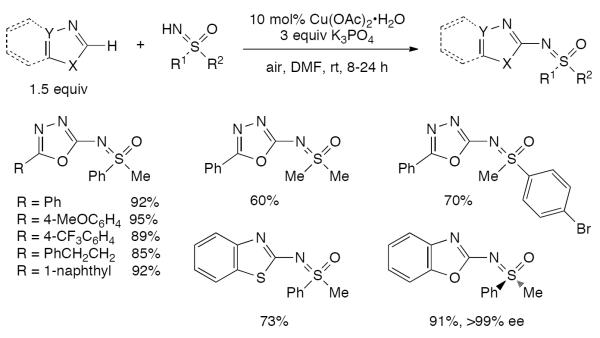
Copper-catalyzed sulfoximination of azoles.
The process was extended to incorporate several polyfluoroarenes as the aryl coupling partner (Scheme 136). Highly acidic substrates were necessary as illustrated by only minimal conversion of 1,2,4,5-tetrafluorobenzene under the reaction conditions.
Scheme 136.
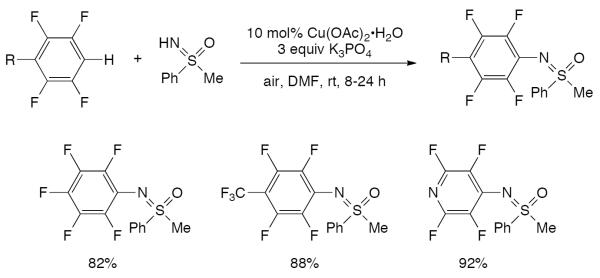
Copper-catalyzed sulfoximination of polyfluoroarenes.
The coupling of benzoxazoles with secondary amines has recently been described to occur under acidic conditions (Scheme 137).297 The reaction uses Cu(OAc)2 and oxygen and relatively mild heating, to afford the coupled products in good yield. Other heteroarenes or nitrogen nucleophiles were unsuccessful. While an acid additive was not crucial for reaction efficiency, addition of 2 equivalents of acetic acid slightly increased the yield rather than having any deleterious effect.
Scheme 137.

Coupling of benzoxazoles and secondary amines under acidic conditions.
Similar conditions were found to effect amination of benzoxazoles with DMF or N,N-diethylformamide via a decarbonylation of these solvents (Scheme 138). Interestingly, use of dimethylacetamide also afforded the dimethylamine product, albeit in low yield (30%), demonstrating that deacetylation may be feasible.
Scheme 138.

Decarbonylation and oxidative coupling of benzoxazoles with formamides.
Another method for C-H insertion of azoles employs a copper catalyst in conjunction with catalytic TEMPO and molecular oxygen (Scheme 139).298 This system requires the use of highly acidic para-nitroanilines as a nitrogen coupling partner in combination with a stronger base (t-BuOK) to effect heterocoupling with benzoxazoles or benzothiazoles in good to moderate yields. Since more electron-rich amine substrates can be employed in arene functionalization in the absence of TEMPO (see Scheme 132, Scheme 133), the use of electron-poor anilines is necessary in this case to resist alternate oxidation pathways with TEMPO. Support for this hypothesis was established by the oxidative formation of hydrazobenzene when aniline was subjected to these reaction conditions (see Section VIII.B). The exact roles of TEMPO and molecular oxygen are not well understood. However, TEMPO appears to serve in a catalytic function, since 90% was recovered at the end of the reaction. Additionally, the combination of both TEMPO and oxygen yielded superior results than with either oxidant alone. The absence of trapped intermediates suggests a non-radical pathway. See below for additional mechanistic discussion.
Scheme 139.
Copper/TEMPO catalyzed C–H insertion into azoles.
Polyhaloarenes also proved effective aryl coupling partners in this process. Increased reactivity in comparison to azoles was observed, allowing lower reaction temperatures and a broader range of electron-poor anilines to be employed (Scheme 140). The substrate scope, however, is still limited to highly fluorinated arenes (four fluorine substituents are necessary to achieve good yields) or pentachlorobenzene and highly electron-deficient anilines.
Scheme 140.
Copper/TEMPO catalyzed C–H insertion into perhaloarenes.
Azoles can also be coupled with sulfur nucleophiles. The first such example detailed the use of catalytic copper to couple benzoxazoles with thiophenols (Scheme 141) or diaryl disulfides (Scheme 142) under oxygen to afford the corresponding aryl thioethers in moderate yield.299 The thiophenols are postulated to form disulfides under the reaction conditions via oxidation by the copper(II) catalyst. Conducting the reaction using PhSCu as the substrate/catalyst afforded the product in moderate yield, lending evidence to its involvement in the mechanism. Reaction in the absence of oxygen yielded no product. Electron-withdrawing groups on the thiophenol strongly inhibited the reaction, suggesting sulfide nucleophilicity and oxidatizability as important considerations.
Scheme 141.
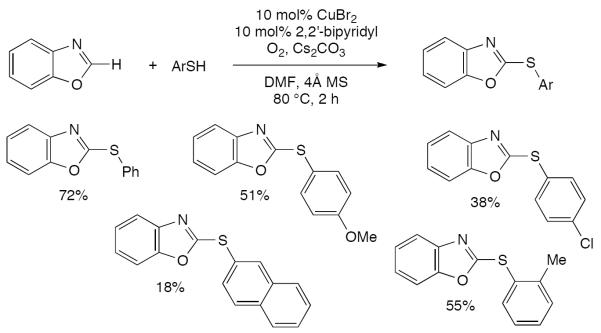
Catalytic oxidative thiolation of benzoxazoles with thiophenols.
Scheme 142.
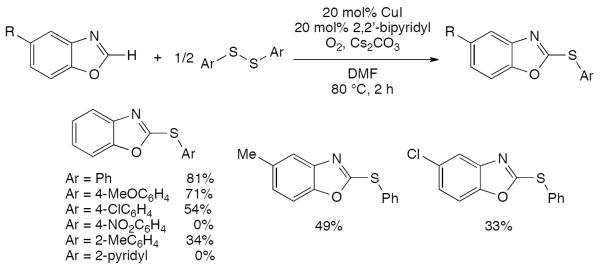
Catalytic oxidative thiolation of benzoxazoles with disulfides.
Later work expanded the scope of thiol coupling to include additional azole heteroarenes as well as primary and secondary alkyl thiols (Scheme 143).300 The described method, however, required use of stoichiometric amounts of CuO in addition to Cu(OAc)2 at high temperatures to achieve useful product yields. Interestingly, performing the reaction in an oxygen atmosphere afforded lower yields in comparison to air. Poorer yields were also observed with use of the corresponding disulfide in place of the thiol.
Scheme 143.
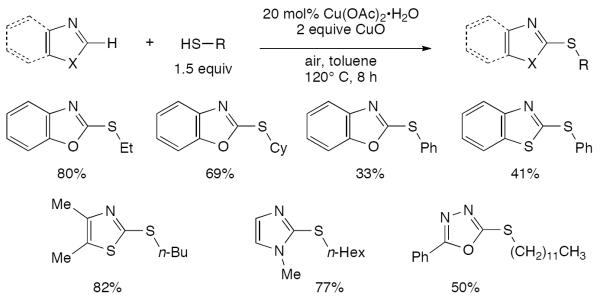
Copper-mediated thiolation of azoles with alkyl and aryl thiols.
Stoichiometric amounts of CuI with a bipyridyl ligand and oxygen afforded 2-mercaptobenzothiazoles in good yield from the corresponding thiols and benzothiazoles (Scheme 144).301 Other heteroarenes, including thiazoles, benzimidazoles, and indoles also successfully afforded the thioether products. Similar to the method above (Scheme 143), an oxygen atmosphere decreased reaction efficiency. However, use of oxygen/nitrogen mixes with oxygen percentages lower than that of air gave significantly less product. The particular sensitivity to oxygen was attributed to facile disulfide byproduct formation.
Scheme 144.
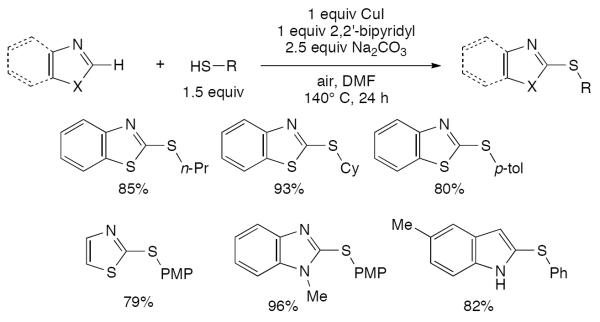
CuI/bipyridyl-mediated thiolation of azoles with alkyl and aryl thiols.
In addition to nitrogen and sulfur nucleophiles, alkynes can also be heterocoupled with acidic arenes. For example, the direct alkynylation of polyfluoroarenes can occur using catalytic CuCl2, 1,10-phenanthroline as ligand, and oxygen under very mild temperatures (Scheme 145).302 In order to promote heterocoupling and suppress the favored Glaser-Hay coupling (see Section II.D.2) of the alkyne, a significant excess (5 equiv) of arene is utilized. Use of weak bases such as NaHCO3 and K3PO4 led only to diyne byproduct, while the stronger base t-BuOLi was capable of deprotonating the arene to afford the desired product. A catalytic amount of DDQ was found to improve yield by minimizing diyne formation, although its exact role remains unclear. Under these conditions, a variety of aryl or heteroaryl alkynes could be coupled with pentafluorobenzene and tetrafluoroarenes in moderate to good yields. Di- and tri-fluorobenzenes were unreactive due to the increased arene acidity. Notably, no arene homocoupling is reported.
Scheme 145.
Oxidative coupling of polyfluoroarenes with aryl and heteroaryl alkynes.
Miura and coworkers concurrently discovered a very similar conditions for arene-alkyne coupling while investigating the nickel(II)-catalyzed coupling of terminal alkynes with azoles.303 When attempting to extend the method to coupling with polyfluoroarenes, no product was observed using nickel catalysts. However, catalytic Cu(OTf)2 with 1,10-phenanthroline and strong base under air provided the coupled products in moderate yield (Scheme 146). The method is limited to aryl alkynes, with electron-rich substrates performing better than electron-poor substrates. Similar to the method in Scheme 145, an excess of polyfluoroarene is employed to promote cross-coupling over the Hay process.
Scheme 146.
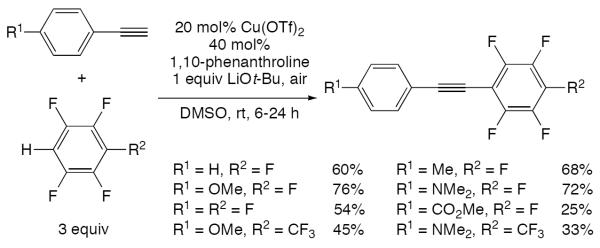
Cross-coupling of alkynes with polyfluoroarenes.
An example of direct cross-coupling of alkynes and azoles has also been reported.304 Specifically, 1,3,4-oxadiazoles react with terminal alkynes to afford the heterocoupled product in good yields using copper(II) chloride under an oxygen atmosphere (Scheme 147). Additionally, 5-aryloxazoles could also be employed, although the more forcing conditions were necessary, and the products were formed in more modest yields (Scheme 148). In both cases, the alkyne was slowly added to an excess of heteroarene to minimize the favored Hay product. Use of catalytic amounts of copper catalyst in the presence of a diamine ligand was shown to effect the coupling in moderate yield (Scheme 149).
Scheme 147.

Cross-coupling of alkynes with 1,3,4-oxadiazoles.
Scheme 148.
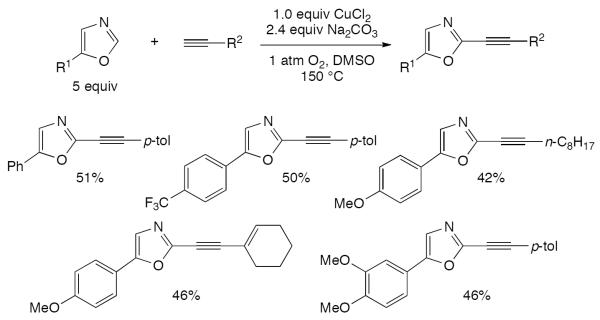
Cross-coupling of alkynes with 5-aryloxadiazoles.
Scheme 149.

Catalytic cross-coupling of alkynes with 1,3,4-oxadiazoles.
In the absence of other coupling partners, the formation of C–H insertion intermediates with copper and acidic arenes can occur twice. The resulting diaryl copper species can undergo reductive elimination to afford the corresponding homocoupling product. For an example of the same reaction using strong base (i.e., i-PrMgCl) see Section III.A.2.
Mori and coworkers have reported the homocoupling of azoles at high temperature using Cu(OAc)2 and Ag2CO3 under oxygen (Scheme 150).305 Although the exact role of the silver salt is unknown, the authors speculate it serves as a base to form the bisazole-copper(II) species. Substitution at the 1-position of benzimidazoles proved important, as electron-withdrawing groups were not tolerated. This trend may suggest that coordination through the 3-nitrogen is necessary for reactivity.
Scheme 150.

Oxidative dimerization of azoles with Cu(OAc)2 and Ag2CO3.
Bao and coworkers described a similar system for the homocoupling of azoles simply utilizing Cu(OAc)2 and air at high temperature (Scheme 151).306 The reported method affords good yields of the corresponding biaryl products from a variety of azoles, although only methyl and benzyl group functionality is demonstrated. When two different azoles are subjected to the reaction conditions, a statistical mixture of products is obtained.
Scheme 151.
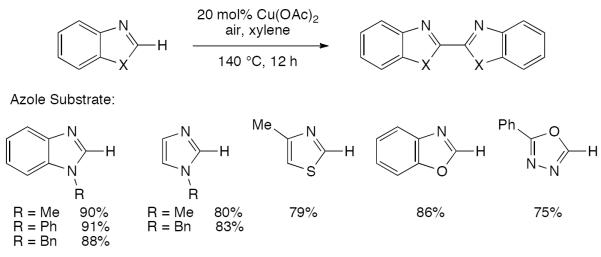
Oxidative dimerization of azoles with Cu(OAc)2.
Homocoupling of azoles can also be effected using a copper(I) pyridonate catalyst to afford the corresponding products in high yield (Scheme 152).307 Notably, excellent yields are observed for a variety of heteroarenes including benzimidazoles, thiazoles, benzothiazoles, oxazoles, and benzoxazoles with as little as 1 mol% CuCl with 2 mol% ligand. A screen of ligand structure revealed electron-donating groups on the pyridonate structure to be the most active. No cross-coupling of the ligand to afford the C–N or C–O coupled products is reported.
Scheme 152.
Oxidative dimerization of azoles with a copper-pyridonate catalyst.
The reactions described in this section are widely reported to operate through a mechanism involving C-H activation at the acidic site of the arene (Scheme 153). Formation of the initial copper-aryl species proceeds through ligand substitution with a deprotonated arene substrate. In cases involving azoles, deprotonation may be facilitated by copper binding to substrate. Similar deprotonation and ligand exchange can occur with either a different nucleophile (leading to heterocoupling) or another molecule of arene (leading to homodimerization) to afford the critical aryl-copper-nucleophile intermediate. A reductive elimination process may occur with the aid of molecular oxygen to afford the coupled product and regenerate the initial copper complex. Methods involving either homocoupling or heterocoupling in the presence of strong bases are likely to proceed through this pathway, and observation of preferable homodimerization of arene in the absence of large excess of nucleophile supports this pathway.
Scheme 153.
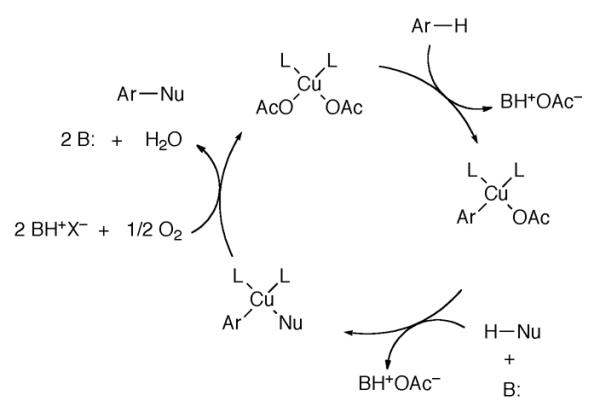
Deprotonative mechanism for the copper-catalyzed coupling of acidic arenes with nucleophiles.
In certain cases, initial coordination of the nucleophile to copper may occur prior to arene. For example, in the coupling of azoles with thiols (Scheme 144), mechanistic investigations as well as DFT studies revealed the initial reactive species to be a copper-thiolate complex, rather than a copper-azole species.301 A specific example of this ambivalent mode of reactivity can be seen in the heterocoupling of polyfluoroarenes with alkynes (Scheme 145). The reaction presumably proceeds via initial copper-facilitated deprotonation of the polyfluoroarene and formation of an aryl-copper(II) species (Scheme 154). Subsequent deprotonation and ligand exchange with the alkyne then forms the key aryl-copper(II)-alkyne complex, which undergoes reductive elimination to afford the product. Alternatively, copper(II)-alkyne formation may occur first. Ensuing deprotonation and coordination of either additional alkyne or perfluoroarene can afford the Glaser-Hay diyne or heterocoupled product, respectively.
Scheme 154.
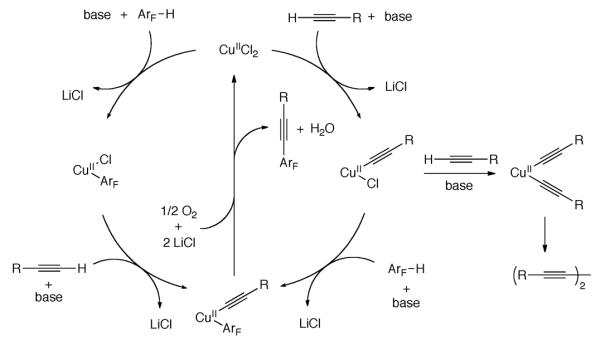
Mechanistic pathways for the coupling of polyfluoroarenes with alkynes.
An alternative possible mechanism, involving nucleophilic aromatic addition, must also be considered, particularly in the presence of neutral or acidic conditions, where deprotonative coordination of the arene is unlikely. Under these conditions, protonation or copper-chelation may activate azoles at the 2-position towards direct nucleophilic attack (Scheme 155). Simple copper-catalyzed rearomatization would then afford the coupled product. A recent oxidative coupling of benzoxazoles with nitrogen nucleophiles using stoichiometric amounts of silver salts under acidic conditions is reported to occur through such a mechanism.308 Although couplings involving polyfluoroarenes typically occur under relatively basic conditions, a SNAr type pathway could potentially occur via oxidation of the Meisenheimer complex resulting from nucleophilic attack onto the electron-deficient arene (Scheme 156). Indeed, direct displacement of fluoride in polyfluoroarenes by nitroanilines was observed for certain substrates, lending support to this pathway.298
Scheme 155.

Nucleophilic aromatic substitution pathway for azole couplings.
Scheme 156.

Nucleophilic aromatic substitution type pathway for polyfluoroarene couplings.
For reactions with mild bases (i.e. KOAc, pKa HOAc in DMSO = 12.3), it is unclear whether deprotonation of the arenes (pKa azoles in DMSO = 24–27309, pKa pentafluorobenzene ≈ 26–29310) is favorable relative to a SNAr pathway, especially when coupling with strong nucleophiles such as thiols.
In addition to the synthetic value of these copper catalyzed arene C-H functionalizations, these reports illustrate that the role of stoichiometric copper additives in similar palladium catalyzed oxidative C-H bond transformations may not simply be limited to that of a reoxidant for palladium(0).
III. Reaction of Carbanions and Carbanion Equivalents
III.A. Alkyl, Aryl, and Alkenyl Anion Coupling
III.A.1 Anion Couplings Using Stoichiometric Copper
A seminal report by Whitesides and coworkers established that organolithiums readily undergo homocoupling after formation of a copper(I) ate complex oxidation with O2 (Equation 1).311 In this instance, coupling of mixed ate complexes gave a mixture of products (Equation 2). However, the homocoupling proved preparatively useful for the coupling of primary and secondary alkyl, vinyl, alkynyl, and aryl groups, while Grignard reagents and tertiary alkyl groups gave poorer yields (Scheme 157).
 |
Equation 1 |
 |
Equation 2 |
Scheme 157.
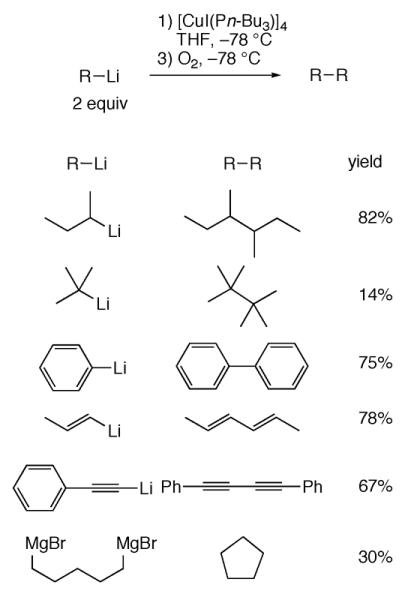
Coupling of mixed diarylcyanocuprates using oxygen.
Heterocoupling was later achieve by Lipshutz and coworkers, who discovered that the controlled formation of diary1 higher order cuprates leads to consistently high levels of unsymmetrical ligand coupling. For example, preformation of PhCu(CN)Li in 2-methyl tetrahydrofuran, cooling to −125 °C, and then introduction of o-MeOPhLi at this lowered temperature leads to the higher order reagent Ph(o-MeOPh)Cu(CN)Li. Upon exposure of such reagents at this temperature to ground-state molecular oxygen, good yields of the unsymmetrical biaryl Ar-Ar' can be realized (Scheme 158).312 Several different types of aryl ligands have been examined, including naphthalenes and heteroaryls, to assess the generality of this method.
Scheme 158.
Coupling of mixed diarylcyanocuprates using oxygen.
Pyridyl cuprates gave poor selectivities in the above process. This deficiency could be remedied by tethering the two aryl lithiums to be coupled as outlined in Scheme 159.312a
Scheme 159.

Coupling of tethered diarylcyanocuprates using oxygen.
Asymmetric cross couplings with a chiral tether also work well. For example the dibromide in Scheme 160 readily underwent intramolecular cross coupling to afford the product with S helical stereochemistry as a single diastereomer.313 This technique has proven a generally useful for obtaining axial chiral compounds.314
Scheme 160.
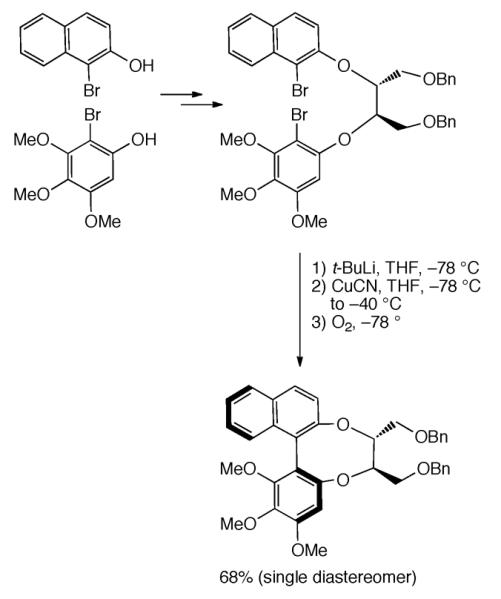
Asymmetric coupling of mixed diarylcyanocuprates using a chiral tether.
An example of this oxidative coupling in total synthesis can be found in the atropodiastereoselective synthesis of calphostin A, one of the perylenequinone natural products (Scheme 161).315 Halogen-metal exchange of an enantiomerically pure (R)-naphthyl bromide with n-BuLi followed by treatment CuCN and TMEDA afforded the higher order cuprate. Treatment of this species with dry, precooled oxygen gas at −78 °C afforded the corresponding 1,l'-binaphthalene in 68% yield as an 8:l mixture of diastereomers about the axis of chirality. Although excellent atropdiastereoselectivity was observed in this biaryl coupling, the absolute configuration of the newly formed axis of chirality was opposite to that required for synthesis of the calphostins. Beginning with the opposite (S)-enantiomer then yielded the (S,S,Sa)-product that was ultimately converted into calphostin A.
Scheme 161.
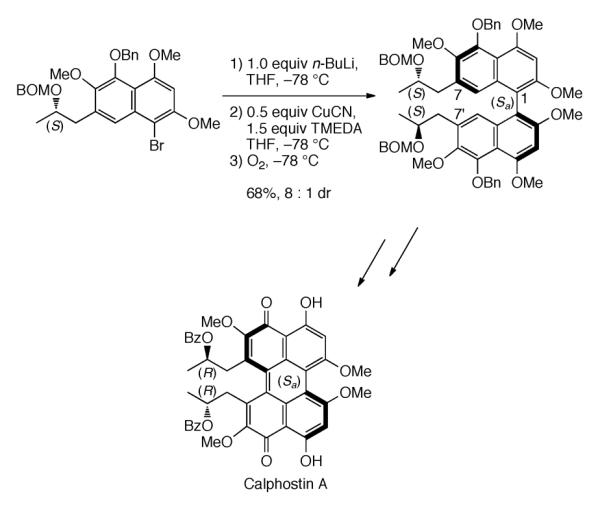
Oxidative diarylcyanocuprate coupling en route to calphostin A.
III.A.2 Anion Couplings Using Catalytic Copper
In a significant advance, conditions have been found where pregenerated anions can be oxidatively coupled using a substoichiometric amount of a copper catalyst. For example, aryl zinc reagents generated from aryl halides and zinc(0) undergo highly efficient homocoupling in the presence of 10 mol% CuBr, air or O2, and 20–50 mol% of a dinitroarene (Scheme 162).316 The methodology was found to be applicable to a wide range of aryl, heteroaryl, vinyl and benzyl bromides. Particularly noteworthy is the dimerization can tolerate the presence of ketones, a functional group that would not be compatible with arylmagnesium halides or aryl lithiums even at low temperature. In further contrast to the higher order cuprate couplings described above, low temperatures are not required.
Scheme 162.
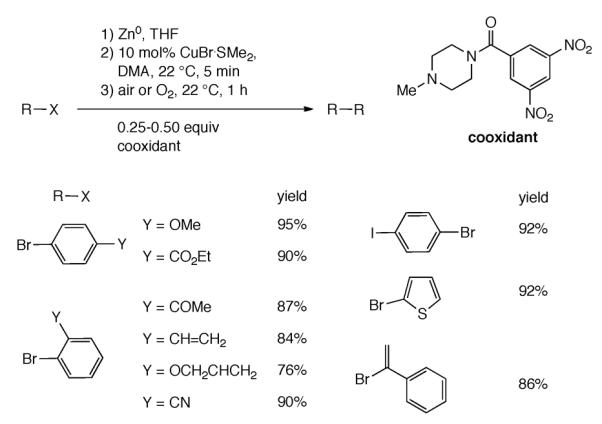
Copper catalyzed reaction of aryl and alkenyl zincs with oxygen.
This new method was also found to be useful in the synthesis of a medium sized rings in high yields (Scheme 163).316 Tethered aryl halides were effectively cyclized to form 10-membered rings. A total synthesis of buflavine, an Amaryllidaceae alkaloid with anti-serotonin properties, was also accomplished and shows that the method readily accommodates unsymmetrical substrates.
Scheme 163.

Copper catalyzed intramolecular coupling of aryl zincs.
For the transformations in Scheme 162 and Scheme 163, the use of an inert atmosphere compromised the yield which could be recovered if more of the dinitroarene cooxidant was used or if the reaction mixture was placed under an atmosphere of dry air or molecular oxygen. When an oxygen atmosphere was used without the arene oxidant present then significant quantities of phenolic products were produced. If the reaction mixture was rigorously degassed, then substoichiometric quantities of the cooxidant were ineffective. The use of styrene and allyl substrates points away from a simple radical termination mechanism. These results suggest that the radical anion of the cooxidant is able to catalyze the reduction of molecular oxygen and compete with the formation of undesired products in such reactions (Scheme 164). Aryl zinc halides are not oxidized at an appreciable rate under the reaction conditions which is consistent with this mechanism.
Scheme 164.
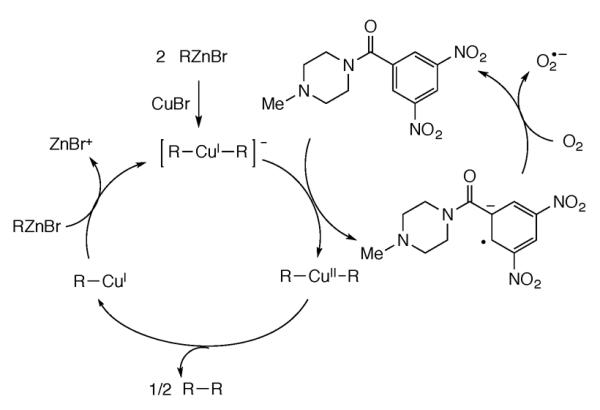
Aryl zinc coupling with catalytic copper and a cooxidant.
In the above cases, the arylzinc reagent needs to be preformed prior to treatment with the copper/cooxidant/O2 combination. A system combining in situ deprotonation with oxidative dimerization has been studied by Daugulis and coworkers.317 Building upon prior results using copper(I) catalyst to couple aryl anions generated in situ with aryl iodides, a reaction was attempted without the use of an aryl iodide to determine if oxygen could effect an oxidative coupling of two equivalents of the anion (Scheme 165). While a good amount (56%) of aryl anion coupling was observed, a significant amount (38%) of the corresponding phenol also formed.
Scheme 165.

Copper catalyzed reaction of aryl lithium with oxygen.
Reasoning that this phenol arose from trapping of the in situ formed aryl lithium with oxygen, other bases were investigated. Ultimately, it was found that hindered amide anions with LiCl and/or ZnCl2 additives gave rise to an aryl anion species that was less prone to oxygenation and more likely to form a copper adduct that would undergo oxidative coupling (Scheme 166).317
Scheme 166.
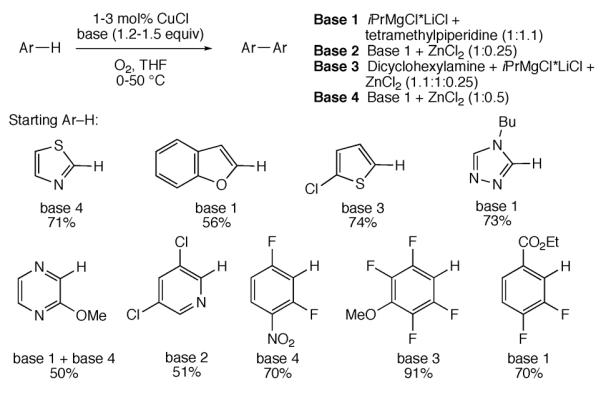
In situ deprotonation, symmetric dimerization with catalytic copper.
See also Section II.E.4 for functionalization of acidic arenes under less basic conditions (conjugate acid pKa <18). In these cases, similar mechanisms are proposed to those outlined above except that the aryl anion is not preformed. Rather, deprotonation is closely coupled to copper coordination.
III.B. Benzyl and Allyl Anion Coupling
The oxidative coupling of zinc reagents using a copper catalyst, oxygen, and dinitroarene cooxidant as outlined in Scheme 162–Scheme 164 above also proved applicable to other readily formed organozincs including allyl zinc reagents. Notably, the coupling proceeded to provide predominately a “head-to-tail” coupling rather than either of the two possible symmetrical coupling products (Scheme 167).316
Scheme 167.
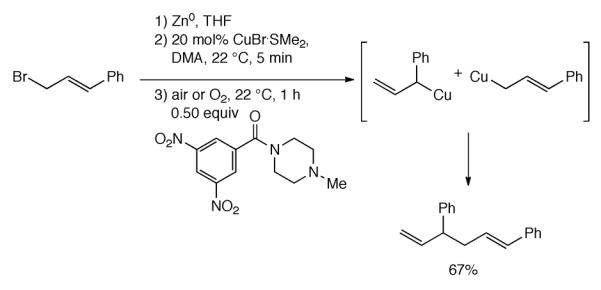
Copper catalyzed reaction an allyl zinc with oxygen.
III.C. Couplings with Boronic Acids
Independent reports by Chan,318 Evans,319 and Lam320 utilizing stoichiometric copper reagents to effect formation of aryl C–N and C–O bonds in 1998 transformed the field of heteroatom arylation reactions. These developments led to new mild methods for C–N, C–O, and C–S bond forming reactions, which have proven to have broad generality (Scheme 168). In addition, copper catalysts have been shown useful in C-C bond formation by the oxidative union of two boronic acids.
Scheme 168.
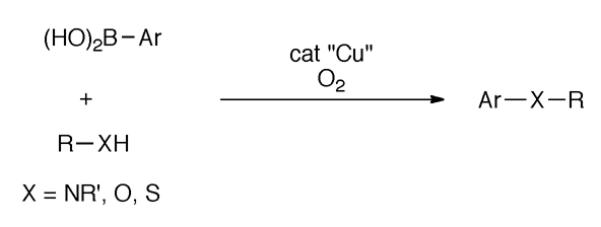
Boronic acids in copper catalyzed oxidative bond formation with oxygen, nitrogen, and sulfur nucleophilic substrates.
III.C.1. C-N Bond Formation
A major advance in the field of oxidative coupling with boronic acids was reported by Collman and coworkers.321 Recognizing that the readily available Cu(OH)Cl(TMEDA) catalyst had been successfully employed in aerobic oxidative coupling of 2-naphthols,322 this same catalyst was employed in this oxidative transformation leading to a copper-catalyzed modified Ullmann reaction (Scheme 169). This system was successfully employed and optimized for the cross-coupling reaction of aryl boronic acids with imidazoles. While the copper catalyzed N–arylations with the related aryllead species had been reported earlier, the reactions of the boronic acids proceeded under milder conditions and without the use of toxic lead species.323
Scheme 169.
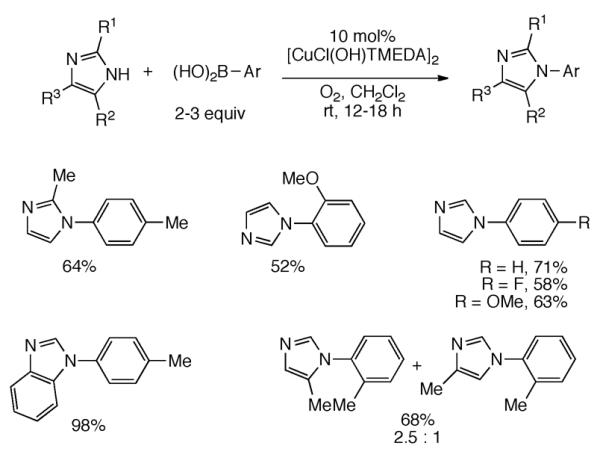
Copper catalyzed coupling of arylboronic acids with azaheterocycles.
Since the discovery of Collman and coworkers of copper catalyzed N-arylations, numerous nitrogen compounds have been employed with an array of boronic acid derivatives. A reactivity pattern for heterocycles (carbazole > imidazole > indole ~ pyrrole > triazole >> tetrazole) in N-arylation reactions has emerged based on nucleophilicity, complexing ability of catalyst, and acidity.324e
While boronic acid precursors permit heterocycle N-arylations to proceed at lower temperatures relative to the metal-catalyzed N-arylation of aryl halides, the formation of the hindered C-N biaryls remains a challenge,324 but recent efforts indicate that very hindered C-N biaryls can indeed be generated under mild conditions.325 A collection of the various permutations include the use of various copper catalysts in combination with many different boron substrates (aryl, fluorinated aryl, heteroaryl, alkenyl, dienyl, and cyclopropyl boronic acids; aryl boronic esters; aryl and alkenyl trifluoroborates; aryl boronates; aryl boronate esters; aryl boroxines; tetraaryl borates; aryl bismuths, aryl leads; aryl and alkenyl trimethoxysilanes) and nitrogen nucleophiles (ammonia, primary and secondary alkyl amines, hydroxyl amine, azide, anilines, amides, carbamates, urea, imides, sulfonamides, sulfoximines, and heterocycles). In addition to the examples above and the table below, several very good reviews have appeared describing the oxidative copper catalyzed C-N bond formation with boronic acids.324 This transformation has been particularly useful in the synthesis of heterocyclic medicinal chemistry agents.324
Recently, the first example of copper-catalyzed cyanate cross-coupling with arylboronic acids has been reported, which provides an alternate entry to carbamates after condensation with an alcohol.373 The reaction requires the presence of oxygen suggesting a copper mediated oxidative process is occurring. Moderate to good yields were obtained for both electron rich and electron poor boronic acids (Scheme 170). Notably, base and ligand additive are not required for this transformation. Pinacol arylboronates are less reactive (48%) than arylboronic acids (75%), and bis–substituted arylboronic acids did not react. (Scheme 171) outlines the proposed mechanism.
Scheme 170.
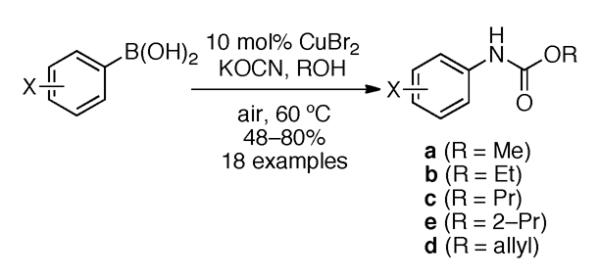
Cyanate coupling with aryl boronic acids.
Scheme 171.

Mechanism of the copper catalyzed cyanate coupling.
In early work, a mechanism postulated by Evans for the coupling of aryl boronic acids with phenols319 was proposed by Collmann321. While the reaction does proceed under air, better yields are seen under O2, implicating dioxygen in the turnover step of the catalytic cycle. A number of mechanism studies have been undertaken to clarify this observation, revealing four potential mechanisms. Early studies by Stahl and coworkers revealed an isolable copper(III) aryl species which would combine with an acidic nitrogen species to generate an N-aryl (Scheme 172).272 More acidic nitrogen species reacted more rapidly suggesting that the nitrogen nucleophile undergoes deprotonation before or during the rate-limiting step of the reaction.
Scheme 172.
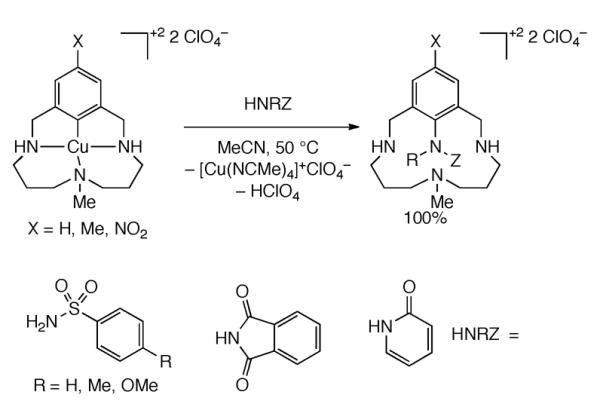
Isolated Cu(III) intermediates that undergo N-arylation.
These results, along with the kinetic data and electronic effects, are consistent with at least two different mechanisms for C-N bond formation: (1) a three-centered C-N reductive elimination from an (unobserved) CuIII(aryl)(amidate) intermediate (Scheme 173) or (2) bimolecular nucleophilic attack of an amidate at the aryl carbon to displace the aryl-Cu bond.272 Support for the former is found in a report from Buchwald and coworkers on a related copper catalyzed coupling reaction.374 Specifically, evidence is outlined indicating coordination of the nitrogen nucleophile to the Cu center prior to C-N bond formation
Scheme 173.
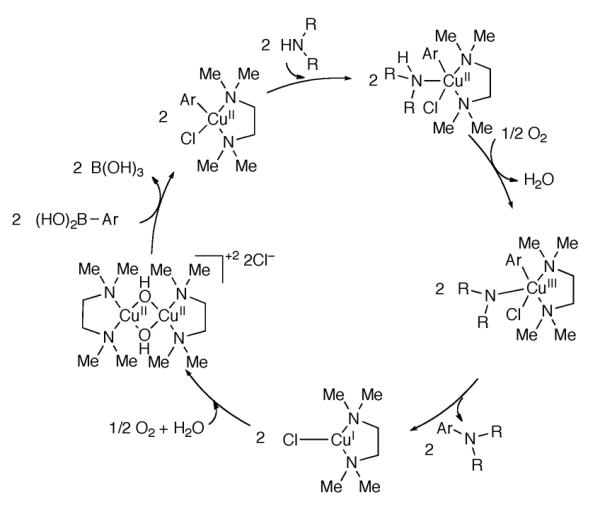
Proposed mechanism for the copper catalyzed N-arylation.
An alternative mechanism has been suggested implicating coordination of the amine prior to transmetallation with the aryl boronic acid (Scheme 174).336,375 More recently a multi–technique approach employing several spectroscopic methods was used in an effort to elucidate the mechanism for the copper(II)–catalyzed N–arylation of imidazole.375 Evidence includes isolation of five out of the six intermediates (all except III) providing support for the mechanism outlined in (Scheme 174).
Scheme 174.
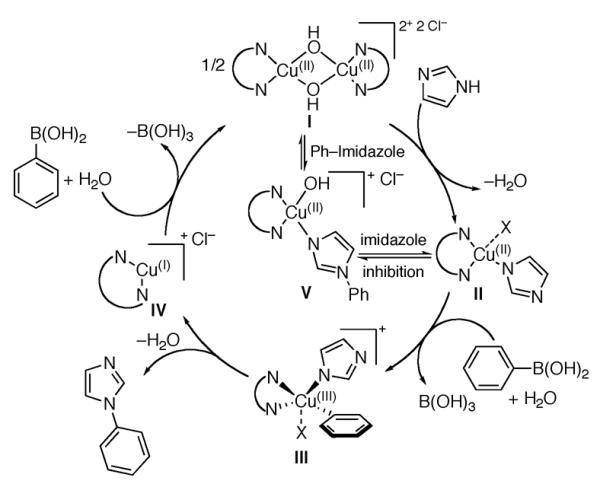
Alternate mechanism for the copper catalyzed N-arylation.
Intermediate II was isolated and was proven to be kinetically competent upon exposure to phenyl boronic acid. The formation of a mononuclear (TMEDA)Cu(II)(imidazole)(X) intermediate was also determined to be the first selectivity determining step. Exclusive C–C homocoupling was obtained when phenyl boronic acid was added first to stoichiometric Cu(II) dimer while selective C–N coupling was observed when the order of addition was reversed. Experiments with increasing amounts of imidazole or phenylimidazole product added to the reaction mixture resulted in a decrease of the reaction rate, further suggesting facile coordinate with the catalyst, in this case resulting in inhibition. This evidence strongly suggests that Cu complex reacts fast with the imidazole in the selectivity–determining step.
First, imidazole reacts with dimer I forming monomer II, which subsequently undergoes transmetallation with phenyl boronic acid. Reductive elimination of the Cu(II)(imidazole)(phenyl) intermediate III affords the phenyl imidazole product and a Cu(I) species. The Cu(I) species is then reoxidized to the dinuclear and mononuclear Cu(II) species by phenylboronic acid and water. Previously, the authors demonstrated the presence of water was essential while dioxygen was not required for C–N coupling to occur.336 The proposal that the phenyl boronic acid acts as an oxidant requires the uphill formation of a highly reactive boron hydride reagent in the presence of a highly reactive copper(III) species. Since the reaction was conducted under an air atmosphere, and oxidation by dioxygen cannot be excluded. An alternate mechanism involving the disproportionation of the Cu(II) intermediate III to Cu(III) and Cu(I) species, outlined in (Scheme 175), could not be ruled out based on the experimental results.
Scheme 175.

Disproportionation N-arylation mechanism.
All of the catalytic cycles described above are plausible, and the actual reaction trajectory may change depending on the basicity/nucleophilicity of donor. However, the facility of C-C homo coupling strongly supports an initial association of the nitrogen donor, whether before or after deprotonation. For example, deprotonation may only occur after transmetallation. Additional experiments and kinetic studies are required to fully understand these transformations.
III.C.2. C-O Bond Formation
With the realization of C-N coupling using a copper catalyst under aerobic conditions321 (see Section II.C.1 above), the next frontier became a simple catalytic procedure for oxidative coupling of alcohols with aryl boronic acids given that the version with stoichiometric copper proceeded readily using variety of phenols and N-hydroxysuccinimides.318,319,324b, 376 A catalytic protocol utilizing a stoichiometric chemical oxidant to regenerate the copper catalyst has been reported. However the optimal oxidant used in the reaction varied depending on the nucleophile and competitive oxidation of the boronic acids was problematic.328e
The first examples of copper promoted C–O bond formation using arylboronic acids were reported by Chan in 1998. Triarylbismuth arylating reagents could be replaced with arylboronic acids to form heteroatom–carbon bonds using stoichiometric amounts of Cu(OAc)2 and excess base. Only four examples were shown between 3,5–tert-butylphenol or 2-iodophenol and substituted arylboronic acids generating the diaryl ethers in 40–78% yield. The yields of the reactions were found to be dependent on nature of substrate, substitution of the arylboronic acid, and base (pyridine or triethylamine).318 Acyclic and cyclic arylboronate esters were also shown to arylate 3,5–tert-butylphenol, but in poorer yields (< 50%).376
The first example utilizing catalytic amount of Cu(OAc)2 was reported in 2001 by Lam.328e Four different conditions were explored for the O-arylation of 3,5-tert-butylphenol with Cu(OAc)2 (Scheme 176). Several oxidants (oxygen, pyridine N-oxide, 2,2,6,6-tetramethyl-1-piperidinyloxy (TEMPO), N-methylmorpholine oxide, sodium perborate, (1R)-(10-camphosulfonyl)oxaziridine, potassium ferricyanide, and m-chloroperbenzoic acid) were examined. Over oxidation of the phenylboronic acid was problematic for most of the oxidants surveyed other than pyridine N-oxide and TEMPO. On the other hand, catalytic Cu(OAc)2 with oxygen provided the highest yields for O-arylation (79%). Notably, the conditions employed by Collman using catalytic [Cu(OH)·TMEDA]2Cl2 for the N–arylation of imidazole were not effective for O-arylation.
Scheme 176.
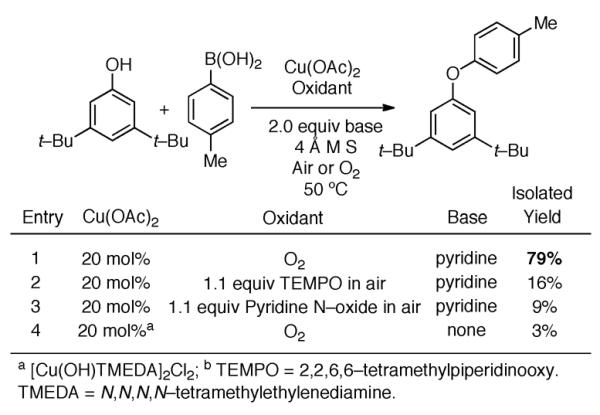
Catalytic O-arylation.
Progress in copper mediated C–O bond formation has thrived with discovery that a broad range of oxygen nucleophiles, besides phenol, can be used. For example, carboxylic acids, aliphatic alcohols, aryloximes, carboxylic acids, silanols, and N–hydroxyphthalimide have been cross-coupled successfully. A collection of the various permutations including the use of different copper sources, bases, and boron substrates are summarized in Table 9. A few of these methods are discussed below. The reader is also directed to several very good reviews on the topic.324
Table 9.
O-Arylation with aryl boronic acid derivatives.
| Coupling Partner | Copper Source | Nuc | Base | Conditions | Number of examples | Yield | Ref | |
|---|---|---|---|---|---|---|---|---|
|
Catalytic Copper
| ||||||||
| 1a | Aryl boronic Acid | Cu(OAc)2 10 mol% |
Phenol | Pyridine | 50 °C, O2 DMF |
1 | 79% | 328e |
| 2a | Cu(OAc)2 (0.5 equiv) |
Phenol | Et3N | H2O2 (30%) 4 Å MS |
7 | 55–90% | 377 | |
| 3a | Cu(OAc)2 20 mol% |
Aryloxime | Pyridine 3.0 equiv | 4 Å MS, DCE, 24–36 h, air, rt | 12 | 81–34% | 378 | |
| 4 | Cu(OTf)2 40 mol% |
Carboxylic Acid | Urea 1.0 equiv | Ethyl Acetate, 60°C, air, 12h | 25 | 51–98% | 379 | |
| 5a | Aryltrifluoroborate salts | Cu(OAc)2·H2O 10 mol% |
Aliphatic ROH | 20 mol% DMAP | O2 4 Å MS, CH2Cl2, rt 24 h | 29 | 30–95% | 380 |
| 6 | Vinyl boronic acid | Cu(OAc)2 10 mol% |
Phenol | 2.0 equiv Et3N | O2, DMF, 50 °C or N-pyridine oxide, air, DMF, 50 °C | 2 | 6–12% | 346 |
| 7 | Vinyl pinacolborates | 0.5 equiv Cu(OAc)2 |
Silanols | 4.0 equiv Et3N | 4.0 equiv 3–hexyne 1.0 equiv pyridine N–oxide 1 atm O2, 50 °C |
15 | 28–72% | 397 |
| 8a | Alkenyltrifluorobor ate Salts | Cu(OAc)2·H2O 10 mol% |
Aliphatic ROH (2-furfuryl alcohol) | 20 mol% DMAP | O2 4 Å MS, CH2Cl2, rt 24 h | 2 | 55–61% | 380 |
|
| ||||||||
|
Stoichiometric and Excess Copper
| ||||||||
| 9 | Arylboronic Acid | Cu(OAc)2 (1.0 equiv) |
Phenol | Et3N | CH2Cl2, rt, N2, 48 h | 5 | 5<–54% | 381 |
| 10a | Arylboronic Acid | Cu(OAc)2 (1.0 equiv) |
Phenol | pyridine | 4 Å MS, O2, rt, CH2Cl2 | 1 | 80% | 382 |
| 11a | Arylboronic Acid | Cu(OAc)2 1.0 equiv |
Phenol | NEt3 5.0 equiv | 4 Å MS, CH2Cl2, rt | 6 | 39–94% | 383 |
| 12a | Aryl Boronic acid | Cu(OAc)2 (1.0 equiv) |
Phenol | DMAP | 4 Å MS, CH2Cl2, rt, air | 2 | 35%–55 | 384 |
| 13a | 4–(trifluoromethyl)ben zeneboronic acid | Cu(OAc)2 1.1 equiv |
Phenol | NEt3 5.0 equiv | 4 ÅMS, CH2Cl2, rt, 18 h air | 1 | 57% | 385 |
| 14a | Arylboronic acids | 1.0 equiv CuCl or Cu(OAc)2 |
N–Hydroxyph thalimide | 1.1 equiv pyridine | 4 Å MS, 1,2-dichloroethane air 24–48 h, rt | 15 | 37–90% | 386 |
| 15a | Arylboronic Acids | Cu(OAc)2 (1.0 equiv) |
Hydroxyqui nolin–4(1H)–one | Pyridine 5.0 equiv | 4 Å MS, CH2Cl2, 24–48 h, rt, air | 8 | 40–53% | 387 |
| 16a | Arylboronic Acids | Cu(OAc)2 (1.0 equiv) |
aromatic oximes | Pyridine 2.0 equiv | 4 Å MS, rt, | 24 | 28–66% | 388 |
| 17a | Pinacol Arylboronic ester | Cu(OAc)2 2.0 equiv |
Phenol | Et3N 10 equiv | 4 Å MS 10 equiv MeOH, CH2Cl2, 22 °C , 5 h |
1 | 50% | 389 |
| 18 | 2,4,6–Trivinylcyclotriboro xane–pyridine complex | Cu(OAc)2 1.0 equiv |
Phenol | Pyridine 10 equiv | CH2Cl2, rt, 24 h, air | 12 | 70–92% | 390 |
| 19a | Halopyridylboronic esters | Cu(OAc)2 (1.0 equiv) |
Halopyridin ol Phenol | Pyridine 5.0 equiv | 4 Å MS, rt, 4 d | 7 | 11–79% | 391 |
Molecular sieves (MS), dimethyl formamide (DMF),
Among other nucleophiles, the coupling of water with arylboronic acids had proved very difficult due to competing oxidation of the phenol products. A highly efficient protocol for this process utilizing Cu(SO)4 and 1,10-phenanthroline ligand was reported by Hu in 2010 (Scheme 177).392 Organotrifluoroborate salts and arylboronate derivatives also afforded the hydroxylated product in moderate to good yields (75–87% yield). The formation of aryl boronic acid was not detected when the organoboron esters were examined (organoboron ester do not just hydrolyze). The authors speculate the hydroxylation occurs via a monopotassium trihydroxy(4–methoxy)–phenyl borate salt intermediate. This hypothesis was supported by synthesizing this intermediate which converted to the product in 90% yield when subjected to the reaction conditions. The yields improved in the presence of ligand suggesting that Cu2O was not a catalytically active species. The authors speculated that a Cu(I) and Cu(II) redox couple is required since the efficiency of the reaction decreased in the absence of oxygen. Based upon the literature, we propose the mechanism outlined in (Scheme 178).
Scheme 177.
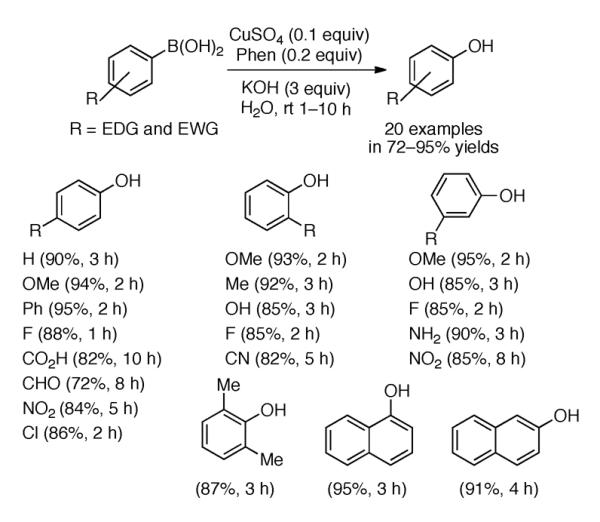
Oxidative hydroxylation of aryl boronic acids.
Scheme 178.
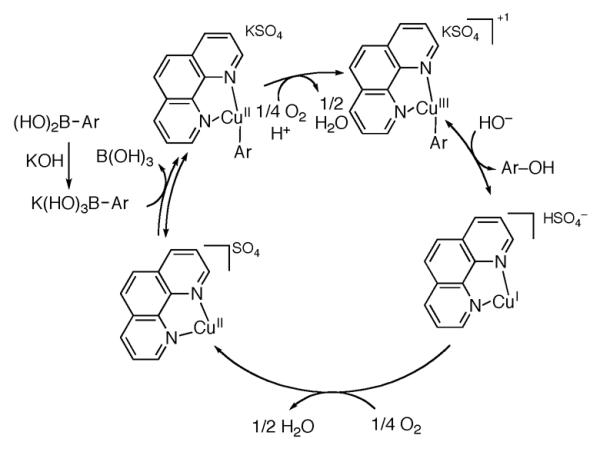
Outline of proposed mechanism for oxidative hydroxylation of arylboronic acids.
Another recent example of copper-catalyzed hydroxylation of arylboronic acids was conducted in water using an amphiphilic surfactant.393 Notably, the phenol product was not detected when the reaction was conducted using 5 mol% of CuCl2 under an oxygen atmosphere in water; the addition of the surfactant was critical for formation of the phenol. In contrast to the case above, this protocol does not require the use of a ligand or base additive providing a milder approach. Oxygen was crucial for reactivity. The reaction rate decreased significantly under air, and no product formed under an argon atmosphere. A wide range of functional groups including alkoxycarbonyl, acetyl, cyano, and halogens (Scheme 179) can be incorporated. Using H218O as the solvent revealed that the phenolic oxygen arises from water, not oxygen, consistent with observations made by Evans319 and Lam.320
Scheme 179.
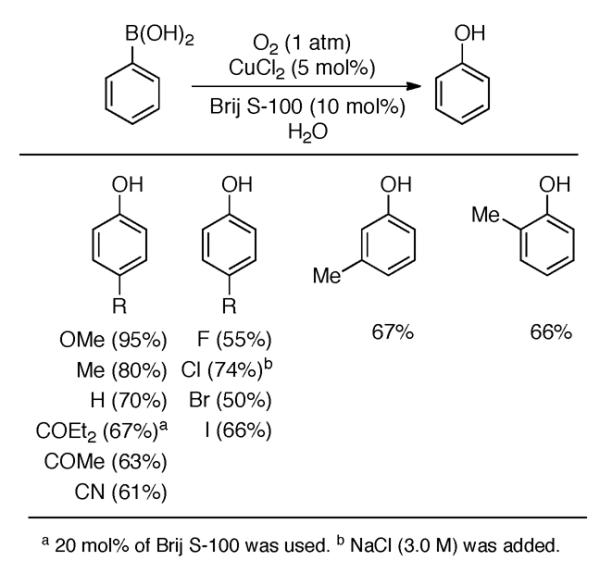
Substrate scope oxidative hydroxylation of various arylboronic acids.
Cheng and co–workers reported the first protocol employing benzoic acid derivatives as the O–donor for O–arylation of phenyl boronic acids utilizing catalytic amounts of Cu(OTf)2 (Scheme 180 and Scheme 181).394 This method provides a milder protocol for the synthesis of benzoate derivatives without resorting to strongly basic conditions. Heteroaromatic carboxylic acids reacted with high yields while ortho–substituted aryl boronic acids did not react. To rule out hydroxylation of the arylboronic acid to the phenol followed by condensation to the benozate ester, phenol and phenyl boronic acid were subjected to the reaction conditions; trace ester (less than 1%) was formed.
Scheme 180.
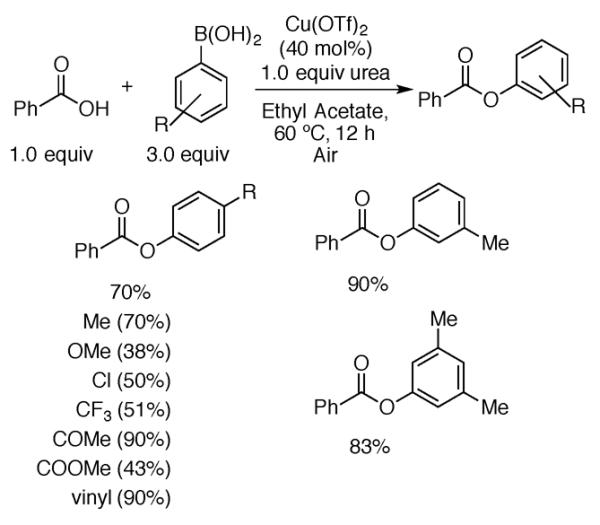
O-Arylation of benzoic acid with various aryl boronic acids.
Scheme 181.
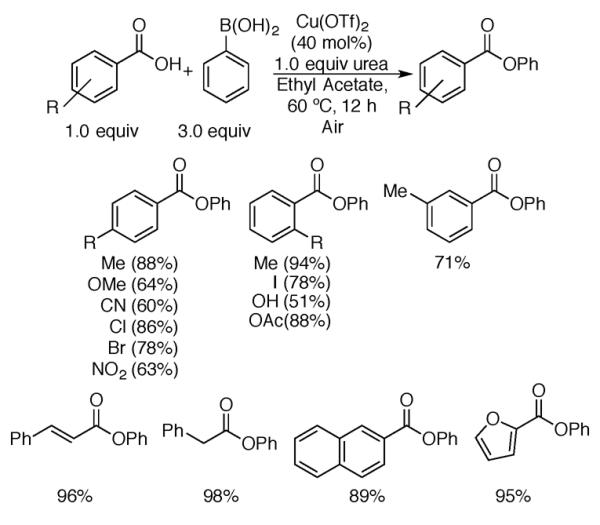
O-Arylation of various benzoic acids with phenyl boronic acids.
In 2010, Merlic and co-workers reported an inexpensive, mild, and stereospecific method for the synthesis of vinyl ether products by cross coupling pinacol vinyl boronate esters with aliphatic alcohols using Cu(OAc)2 at ambient temperature, (Scheme 182).395 Although the method employs excess copper avoiding the need of added oxidant such as air, this work will be described since it is preparatively useful for the synthesis of vinyl ether substrates. In contrast to other previously reported C–O bond forming reactions, vinyl pinacol boronate coupling partners were optimal while other boronate esters, boronic acids, boroxines, and boranes were sluggish (19–59% yield). Only 1.0 equiv of coupling partner is required and water was found to be detrimental. These conditions are compatible with acidic, basic, nucleophilic, oxidative, and radical conditions. The addition of triethylamine improves the yield by quenching acetic acid minimizing protodeboronation of the pinacol vinyl boronate, (Scheme 182). A mechanism is proposed based on the works of Evans319 and Stahl398 (Scheme 183). Transmetallation of the pinacol boronate to Cu(II) initiates the reaction. Next, a ligand exchange from the Cu(OAc)2 with the alcohol forms Cu(II) species. Disproportionation with a second equivalent of Cu(OAc)2 forms a Cu(III) speices. Reductive elimination forms the vinyl ether substrate and one equivalent of CuOAc.
Scheme 182.
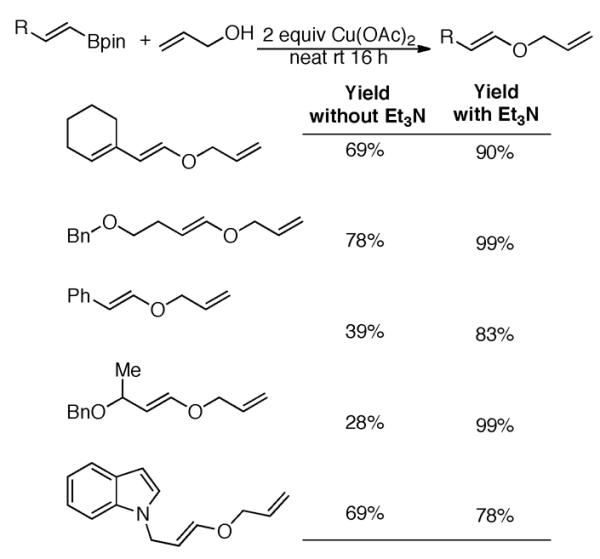
Pinacol vinyl boronate coupling.
Scheme 183.

Proposed mechanism pinacol vinyl boronate coupling.
While developing a protocol for the synthesis of alkoxydienes, it was also discovered that alkene and alkynes could be used as a π-ligands for oxidative copper cross coupling with vinyl boronates.396 Overall, superior yields were observed using Cu(OAc)2, 4.0 equiv of a 3-hexyne additive, and neat alcohol (37–80%) (Scheme 184). While catalytic amounts of copper could be used, higher yields were consistently obtained with stoichiometric amounts of copper.
Scheme 184.

Pinacol vinyl boronate coupling with an alkyne additive.
Building on previous work, Merlic and co-workers have reported the first example of a copper catalyzed oxidative coupling of silanols with pinacol vinyl boronates to afford enol silyl ethers (Scheme 185).397 The method is distinctive to classical enol ether synthesis in that the C–O bond is formed rather than the Si–O bond via O–silylation of carbonyl derivatives. The importance of pyridine N–oxide and oxygen is unclear, and removing either reagent leads to poor yields. Substrates with acid and base labile functional groups could also be coupled in moderate yields. Notably, the coupling of vinylboronate containing both an alcohol and ketone functional groups was silylated selectively in 43% and 44% yield respectively (no evidence of alcohol coupling was observed). Aryl silyl ethers could also be synthesized from the corresponding silanols and aryl pinacol boronate (65% yield). The authors speculate the mechanism may be analogous to the mechanism of copper based couplings with alcohols.
Scheme 185.
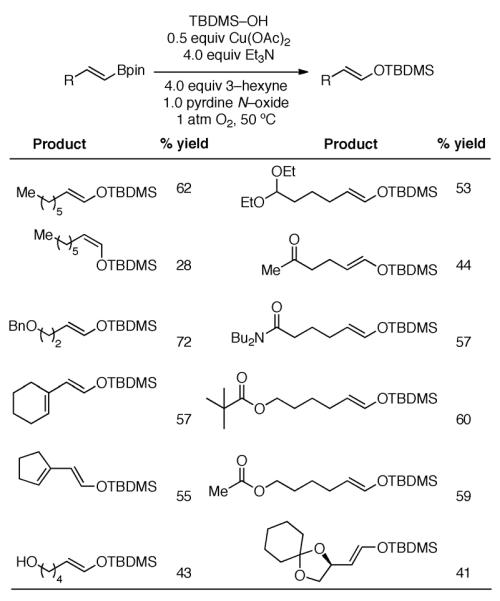
Formation of silyl enol ethers from vinyl boronates.
Investigation of the mechanism of the etherification reaction by Stahl co-workers revealed that, under rigorously anaerobic conditions, a 2:1 Cu(II):product stoichiometry occurs.398 Further kinetic and structural experiments supported transmetallation of the aryl group to copper as the turnover-limiting step, and that most of the copper in solution existed as copper(II) with weak ligands. On this basis the mechanism in (Scheme 186) was proposed for this transformation.
Scheme 186.

Proposed mechanism of copper catalyzed etherification with boronic acids.
Stahl and co-workers have also examined C–O bond formation between oxygen nucleophiles (carboxylic acids, phenols, and alcohols) and a well defined macrocyclic aryl–Cu(III) complex.273 The order of reactivity observed for the stoichiometric reactions of the oxygen nucleophiles with the macrocyclic aryl–Cu(III) complex was: carboxylic acids > phenols > alcohols. Studies examining the dependence of the reaction rate on the concentration of the nucleophile, evaluating of the effect of pKa, and identifying the Cu(III)-nucleophile adducts are outlined. A positive slope was observed for the Brønsted correlation of carboxylic acids indicating less acidic acids react faster, and a negative slope was observed for para-substituted phenols except for p-nitrophenol, which behaved similar to carboxylic acid nucleophiles. Lastly, UV-visible spectroscopy data suggested the presence of a ground-state interaction between the macrocyclic aryl-Cu(III) complex and the more acidic carboxylic acids and phenols. Based on the findings outlined above, a pre-equilibrium of the carboxylic acid nucleophile and Cu(III)aryl macrocycle is proposed, which can be stabilized by hydrogen bonding of the acidic H to the acetonitrile solvent, intermediate II (Scheme 187). Subsequent deprotonation of the nucleophile affords intermediate III, which then undergoes reductive elimination to form the C–O bond and Cu(I) species. The authors rationalized that more acidic nucleophiles are able to undergo deprotonation more rapidly enhancing their ability to coordinate.
Scheme 187.
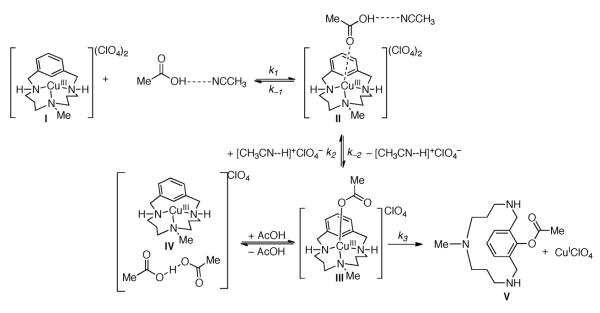
Mechanism proposed for alkoxylation of a Cu(III)-aryl species.
A polymer supported Cu(OAc)2 catalyst has been evaluated for C–O coupling of phenols with phenylboronic acids.399 The polymer supported version was less efficient (yields never exceeded 50%). The catalyst could be recovered from the reaction; however, the catalytic activity decreased significantly upon recycling.
Other reagents asides from boronic acids have been investigated in etherification and the bismuth reagents have proved to be suitable for the etherification for a wide range of alcohols including tertiary alcohols (Scheme 188).400 This mild transformation, which proceeds at ambient temperature, is particularly mild tolerating chelating substrates and various functionality including ketone, carboxylic ester, amide, tertiary amine, and silyloxy groups. Downsides are that only one aryl group transfers from the Ph4BiF reagent and its preparation requires several steps.
Scheme 188.
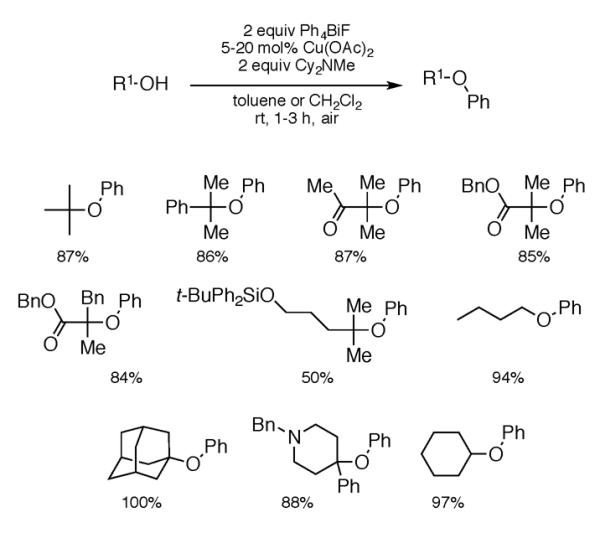
O-Arylation using a phenyl bismuth reagent.
III.C.3. C-S Bond Formation
As was the case for the C-N and C-O bond forming reactions, initial C-S bond forming reactions employed stoichiometric copper reagents (Scheme 189).401 Turnover in this transformation was difficult since the copper(II) species proposed to be involved (see Scheme 173 above) can oxidize thiols. To circumvent this problem, a pre-activated N-thiol substrate has been employed.402 While catalytic copper conditions could be achieved, this change perturbed the reaction so that it was not an oxidative transformation and oxygen is not required.
Scheme 189.

Cross–coupling of cyclohexane thiol.
The use of oxidized sulfur species was shown to be more successful. In a mild copper-based protocol, aryl and vinyl sulfones were synthesized via the cross coupling of aryl and vinyl boronic acids with sodium sulfinate salts (Scheme 190).403 Catalytic amounts of copper(II) acetate with 1,10-phenanthroline as ligand were employed in the presence of 4 Å molecular sieves. In the case of aryl boronic acids, the major side products in the reactions were symmetric copper-based cross-couplings to biaryls, and phenols and biaryl ethers from oxygenation reactions.
Scheme 190.
Copper catalyzed sulfonylation (arrow indicates the bond formed).
The use of disulfides has also been successful for the synthesis of unsymmetrical disulfides. Taniguchi described the first example of oxidatively coupling disulfides with boronic acids utilizing copper salts to synthesize unsymmetrical monosulfides in 2006.404,405 Several copper(I) and copper(II) sources provided good yields with bipyridine ligands, while amine and phosphine ligands were not efficient. Aryl, alkyl, and alkenyl boronic acids could be coupled efficiently (Scheme 191). The alkyl boronic acids required longer reaction times, and di-n-butyl sulfide proceeded in low yield.
Scheme 191.

Aryl– or alkylation of disulfides.
To gain an understanding of the mechanism, PhSCu was treated with 4–MePhB(OH)2 (Experiment A, Scheme 192), the product was formed in moderate yields suggesting that PhSCu is an intermediate. In the absence of oxygen, less then <10% of the desired product was detected (Experiment B, Scheme 192).
Scheme 192.
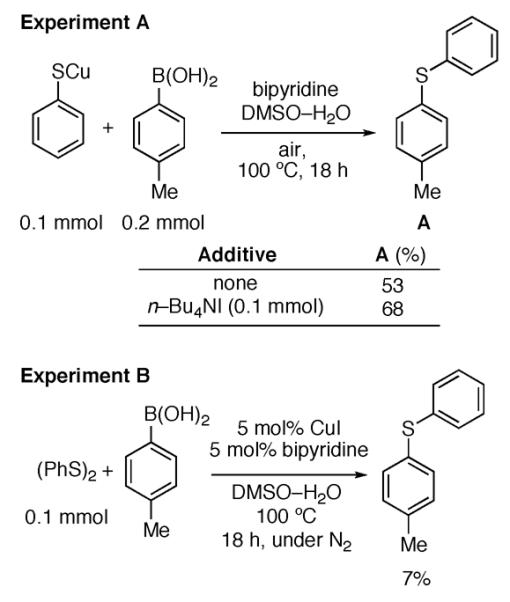
Experiments for mechanistic studies.
Two mechanisms have been proposed based on the observed results (Scheme 193). In cycle A, the Cu(I)L2 species (I) undergoes transmetallation with arylboronic acid to form a Cu(I)R2L species (VI). This Cu(I)R2L species (VI) undergoes a metathesis reaction with the R1SR1 to form R1SCu(I)L species (III) and the desired product R1SR2 species (VII). The R1SCu(I)L species (III) is subsequent oxidized by oxygen to Cu(II) (IV), which then undergoes transmetallation with a second equivalent of arylboronic acid to form Cu(II)R1R2 species (V). This species is undergoes oxidative expulsion of the disulfide product and regenerates the Cu(I)L2 species (I) catalyst. For Cycle B, the disulfide coordinates to the Cu(I)L2 species (I) and undergoes transmetallation to form 1.0 equiv R1SR2 species (VII) as well as R1SCu(I)L species (II), which intersects the catalytic cycle A. The formation of discrete Cu(III) intermediates are not proposed for the formation of C–S bond.
Scheme 193.
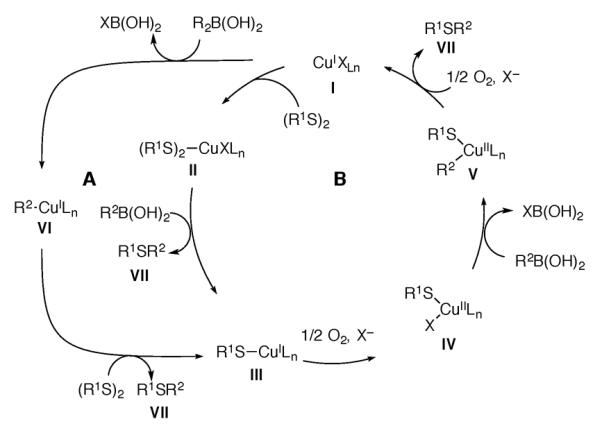
Mechanisms for copper catalyzed thiolation of disulfides with aryl boronic acids.
A selective arylation of 1,2-bis(o-amino-1H-pyrazolyl) disulfides with arylboronic acids using 1,10–phenanthroline ligand and catalytic amounts of copper was achieved in moderate to excellent yields (Scheme 194).406 Notably, selective S–C bond formation was achieved in the presence of a free amine group. N–Arylated products were not observed by GC–MS. The use of oxygen is necessary for the reaction to occur. Arylboronic acids with electron donating and withdrawing groups are suitable substrates while alkyl boronic acids failed to react. A 1:2 mixture of water and dimethyl sulfoxide was optimal and the yields decreased to < 50% in the absence of water. The first example of cross coupling of a disulfide with a heteroaryl boronic acid was also achieved in a 60% yield.
Scheme 194.
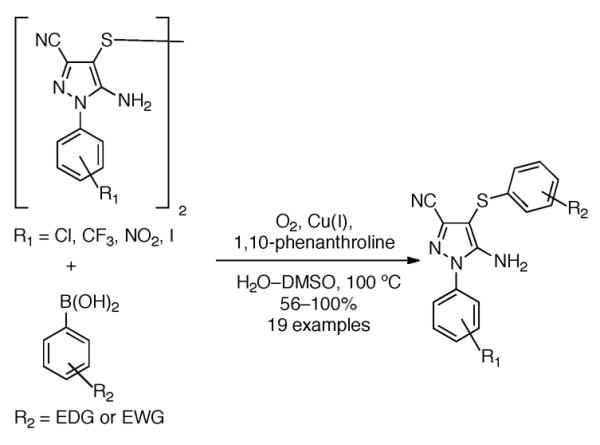
S–Arylation in the presence of an amino group.
A protocol to generate unsymmetrical fluorinated arylsulfides was reported via cross coupling of aryl– and aliphatic disulfides with tris(fluorophenyl)boroxines in the presence of CuI and 1,10-phenanthroline under an oxygen atmosphere (Scheme 195).407 The presence of a ligand and oxygen are necessary for the reaction to occur. Notably, this process is efficient with aryldisulfides containing unprotected hydroxy or amino groups.
Scheme 195.
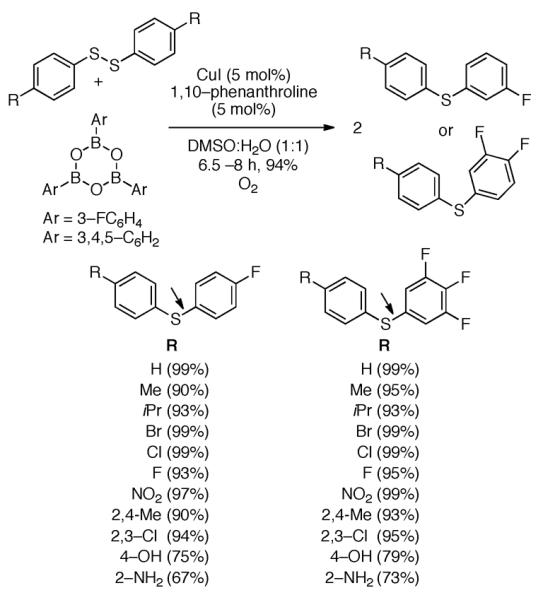
Synthesis of unsymmetrical fluorinated arylsulfides (arrow indicates C–S bond formed).
A by–product was generated in addition to the desired product when 1,2–dibenzyldisulfide was employed (Scheme 196a). The benzylic site of the initial cross-coupling product is expected to be highly reactive. Indeed, debenzylation of this compound generated a new disulfide, which underwent further coupling (Scheme 196b). As a consequence, dibenzyl disulfide is a surrogate for elemental sulfur, allowing incorporation of two new aryl groups.
Scheme 196.
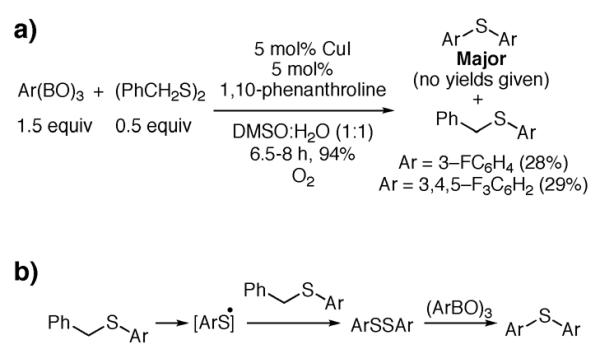
Byproducts in the cross-coupling of dibenzyl disulfide with aryl boroxine.
III.C.4. C-Se and C-Te Bond Formation
Another emerging application of copper-mediated C–heteroatom bond formation has been the use of organoselenium and tellurium as synthetic reagents for oxidative cross coupling chemistry. Huang and co-workers reported the first example of cross coupling arylboronic acids with diphenyl– diselenide and ditellurides utilizing catalytic amounts of copper.408 The reaction proceeds well with 5–15 mol% catalyst loading while yields decrease with 1 mol% copper catalyst, (Scheme 197). Highly hindered arylboronic acid substrates reacted efficiently. A limitation to this method is that ditellurides are unstable due to oxidation by oxygen, and must be conducted under an inert atmosphere. Organotrifluoroborate salts and vinylboronic acids may be used to cross couple. This reaction can be carried out in ionic liquids such as BmimBF4 with recovery of the copper catalyst without loss of activity (5 repetitive cycles may achieved).
Scheme 197.
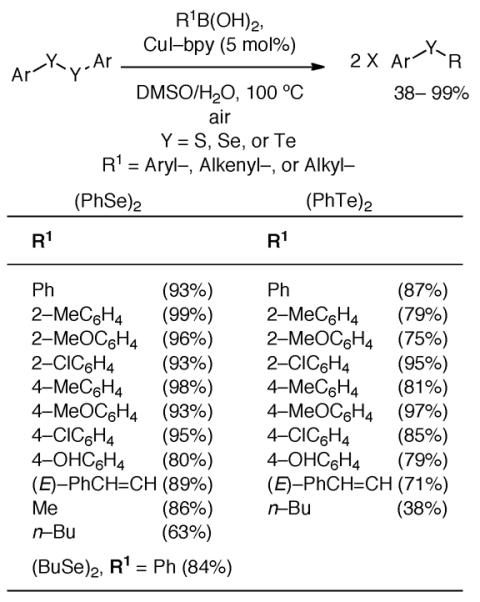
Scope in generating selenides and tellurides.
Taniguchi also demonstrated that unsymmetrical diorgano-selenides and ditellurides could be easily prepared from cross coupling aryl– or alkylboronic acids with diselenide and ditellurides (Scheme 197).405 Absence of bipyridine ligand decreased yields while TMEDA (58%) and triphenylphosphine (4%). Alkenyl and alkyl boronic acids are tolerated the later required longer reaction times than arylboronic acids.
Efforts to understand the mechanism of this transformation began by investigating the role of oxygen. A reaction using CuI or CuCl2 with (PhS)2 and 4–MeC6H4B(OH)2 in the absence of oxygen provided the desired product in 7% (CuI) or 3% (CuCl2) yield indicating the presence of oxygen is essential. Next, PhSCu was prepared and subjected to the reaction conditions with 4–MeC6H4B(OH)2 the sulfide was obtained in 53% yield indicating PhSCu may be an intermediate. The yield of this same reaction was increased to 68% yield when n–Bu4NI was used as the anion source of PhSCu(II) after oxidation of PhSCu(I) (other salts such as KI and LiI yielded the same results 63% and 68% respectively)
Therefore, it was concluded the reaction requires oxygen and demonstrated that PhSCu(I) can react with boronic acid via the formation of PhSCu(II)X by oxidation of PhSCu(I) in the presence of oxygen. A reaction mechanism has been proposed and is identical to the mechanism proposed for cross coupling of diaryl sulfides, (Scheme 193), except the heteroatom for the diorganochalcogenide in this case is substituted for Se or Te.
Similarly to other C–heteroatom bond forming reactions, other organoboron derivatives were used as alternative coupling partners for boronic acids. Alves and co–workers were able to cross couple aryltrifluoroborates with diarylditellurides using similar reactions conditions mentioned above, (Scheme 198).409 Catalyst loading could be reduced from 10 mol% to 5 and 1 mol% without decreasing yields. In contrast to Taniguchi protocol, this reaction is sensitive to electronic effects of the aromatic ring of the trifluoroborate salts. Potassium heteroaryl trifluoroborates could also be used and afforded the product in good yields. The authors suggest the reaction proceeds through the mechanism proposed by Taniguchi.
Scheme 198.
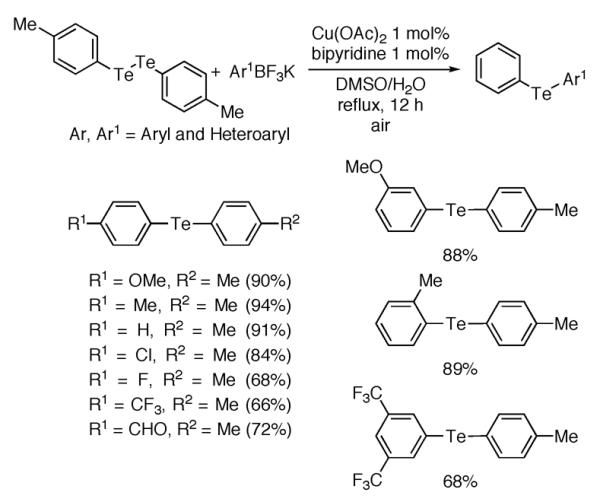
Forming unsymmetrical tellurides.
III.C.5. C-C Bond Formation
The first report of the oxidative dimerization of arylboronic acids came from Demir in coworkers in 2003 showing that Cu(OAc)2 under oxygen was effective.410 While most of the examples utilized high catalyst loading (50 mol%), lower loadings worked well (Scheme 199) except with ortho-substituted substrates. This process is not as facile as the related C-N, C-O, and C-S bond forming reactions since the homodimers are typically not reported as a major byproduct in these other processes.
Scheme 199.
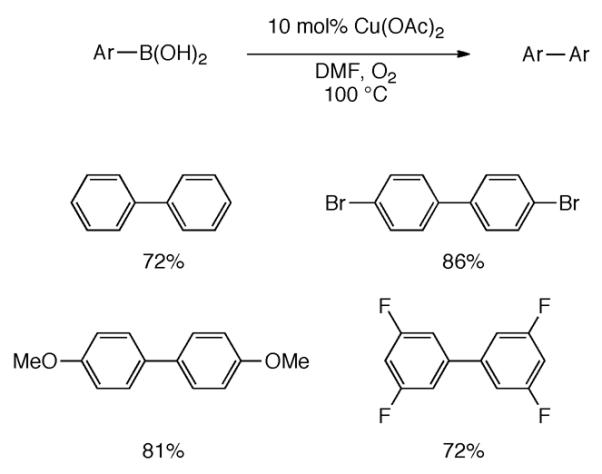
Oxidative dimerization of arylboronic acids.
In 2009, an improved protocol for oxidative dimerization was reported relying on catalysts that would facilitate transmetallation.411 Ultimately, the copper(II) bis-μ-hydroxo adduct with a phenanthroline ligand proved the most effective providing the dimeric products under ambient conditions with as little as 2 mol% of the copper catalyst (Scheme 200).
Scheme 200.
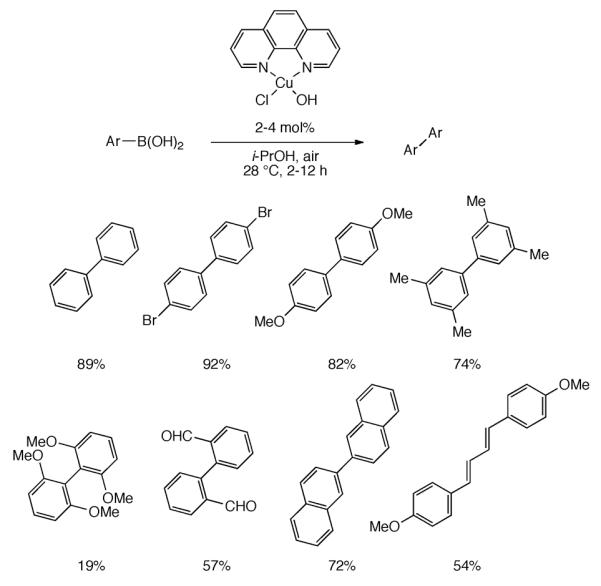
Oxidative dimerization of arylboronic acids with a copper(II) bis-μ-hydroxo catalyst.
In contrast to the mechanisms proposed above for C-N and C-O bonding formation (see Sections III.C.1 and III.C.2) involving a Cu(III) to Cu(I) redox event, Yamamoto and Kirai proposed a bimetallic mechanism involving two Cu(II) to Cu(I) redox events (Scheme 201).411 This sequence was proposed in order to accommodate the most ready pathway for aryl boronic acid incorporation via exchange of a hydroxyl ligand.
Scheme 201.
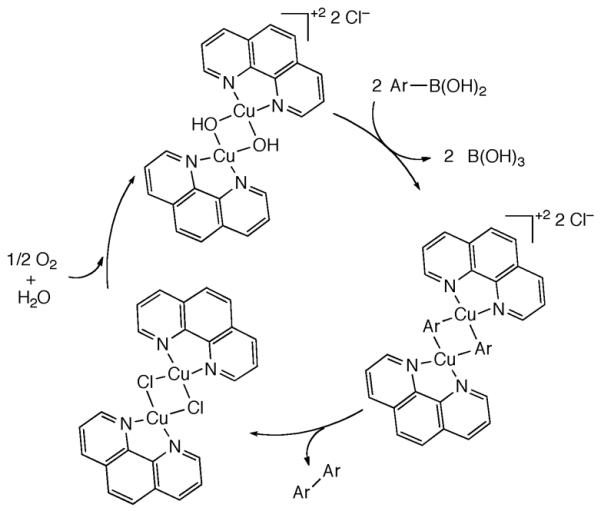
Potential mechanism for oxidative dimerization of aryl boronic acids.
Another recent example, which illustrates the potential for oxidative homodimerization to occur during other desired couplings, can be seen in Scheme 202.337 While pentafluorophenyl boronic acid underwent clean aryl amination with anilines (see Section III.C.1), alkylamines gave rise to a quite different product resulting from oxidative dimerization followed by amination of one of the fluorides. This reaction pathway is supported by formation of the final product from isolated homodimer and none from the independently generated pentafluoroaniline compounds.
Scheme 202.
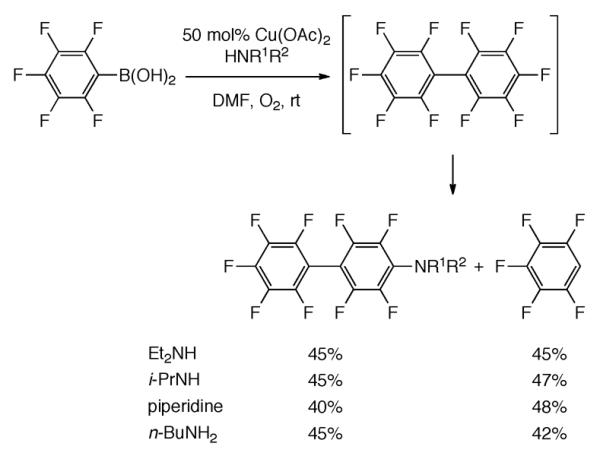
Tandem oxidative dimerization/amination of an aryl boronic acid.
A selective C–H bond arylation of arenes with aryl boronic acids was also reported for the synthesis of biaryls.257 Several electron rich arenes were cross coupled with arylboronic acids using a Cu(OCOCF3)2 catalyst under an ambient atmosphere (Scheme 203), presumably via directed insertion of copper into the arene C–H bond.
Scheme 203.
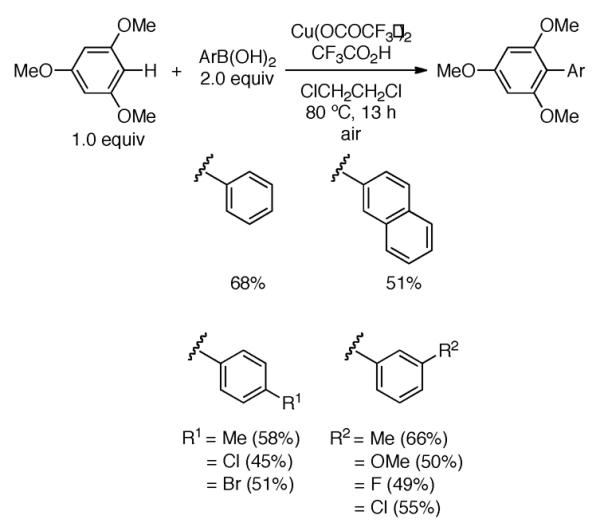
C–H Arylation with various arylboronic acids.
Notably, homocoupling of the arylboronic acids did not occur; in this case, the reaction was selective for cross coupling. The copper source for this reaction was important as not all copper sources promoted the reaction. The presence of oxygen in not required for this transformation to occur; however, a significant increase in the rate was observed under an oxygen atmosphere. Multiple arylations could also be achieved for N-methyl indole and N-methyl pyrrole heterocycles in 54–51% yields respectively. Inductively coupled plasma-atomic emission spectrometry experiments confirmed this transformation is not mediated by trace palladium. Efforts to reduce the catalyst loading led to decreased yield thus limiting this methodology to the use of stoichiometric amounts of copper salt.
A tandem process has been reported by Liebeskind and coworkers wherein a nonoxidative C-C bond forming reaction to generate a ketone from a thioester and an aryl boronic acid is accompanied by oxidative coupling of the resultant thiolate with an aryl boronic acid (Scheme 204).386 While detailed mechanistic studies to elucidate the nature of this interesting transformation remain to be undertaken, information from studies on the processes described above suggests the catalytic cycle outlined in (Scheme 205) which is in accord with all the data described.
Scheme 204.
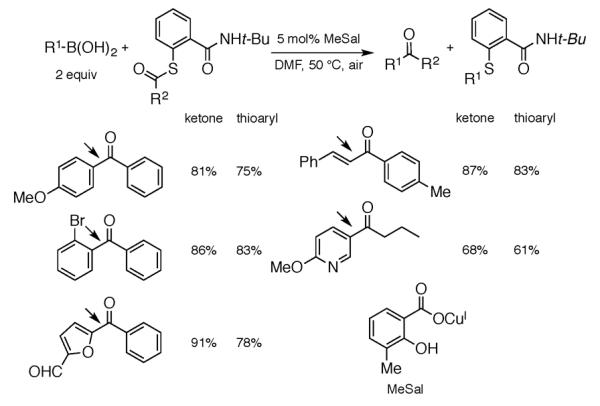
Tandem copper catalyzed C-C and C-S bond formation (arrow indicates the bond formed).
Scheme 205.
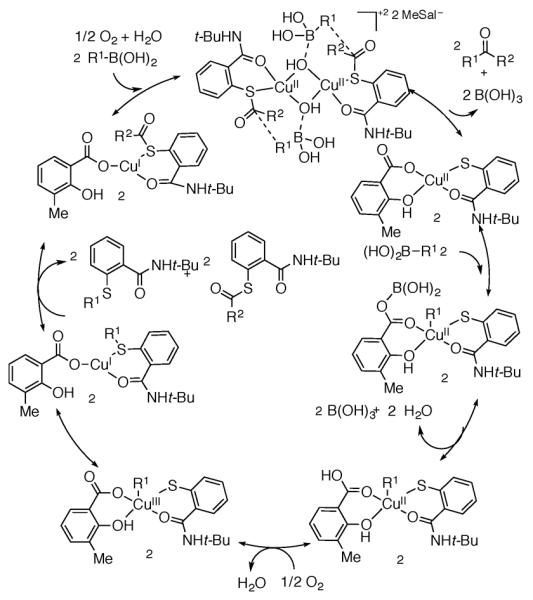
Possible mechanism for tandem copper catalyzed C-C and C-S bond formation.
More recently, copper catalyzed C(sp2)–C(sp) bond formation via aerobic oxidative arylation of terminal alkynes with aryl boronic acids has been reported.412 Depending on the type of alkyne substrate used, pyridine or a pyridine additive is employed in the presence of catalytic copper under an air atmosphere at ambient temperature to afford the internal alkynes in good yields, (Scheme 206). Terminal alkynes with an alkyl chain bearing a hydroxyl or protected amine could also be cross-coupled in moderate yields (Scheme 207).
Scheme 206.
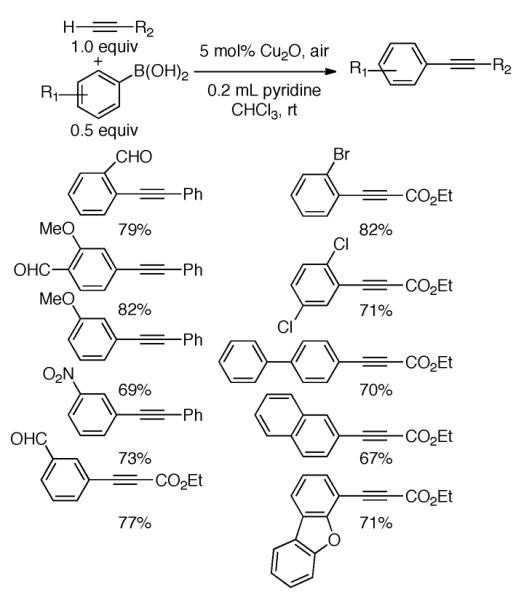
Oxidative coupling of ester- and aryl-substituted terminal alkynes with aryl boronic acids.
Scheme 207.
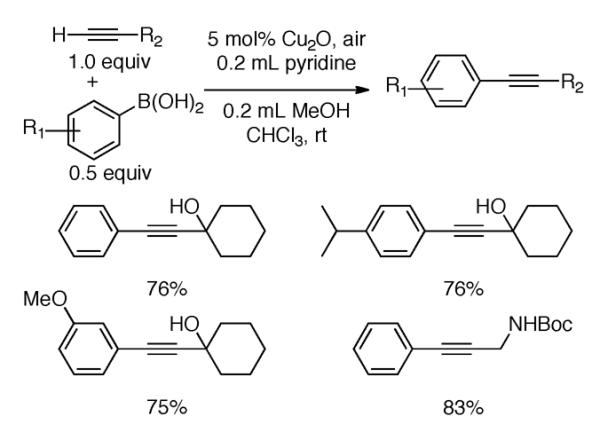
Oxidative coupling of hydroxyl- and amino-functionalized terminal alkynes with aryl boronic acids.
Similarly Kobayashi and co-workers were able to cross couple alkynes with aryl boronic acids using low concentrations of copper salts (0.15–3.0 mol%) in a mixture of 2,6-lutidine and methanol, (Scheme 208).413 The concentration of copper catalyst was found to dramatically influence the amount of homo coupling observed, higher concentrations led to increased homo coupling of both the alkyne and the aryl boronic acid. Interestingly, 2,6-lutidine was the only pyridine derivative found to effectively catalyze the cross coupling reaction while other amine bases such TMEDA led to the undesired homo coupling side products.
Scheme 208.

Cross coupling of alkynes with aryl boronic acids.
III.C.6. C-P Bond Formation
Further exploration of the Chan-Lam cross coupling of arylboronic acids have led to the discovery that C–P bond can also be formed under oxidative conditions. Zhuang and co-workers have reported the first example of cross coupling secondary H-phosphonate diesters using catalytic amounts of copper(II)oxide and phenanthroline catalyst in the presence of excess amine base under an oxygen atmosphere to afford aryl phosphonates.414 Phenol and diaryl ether side-products arising from competing oxidation of the arylboronic acids to the phenol and O-arylation were detected. Notably, the yields decreased from 96% to 56% when the reaction was performed under pure oxygen instead of air. The authors rationalized that the use of pure oxygen could accelerate formation of tetraethyl hypodiphosphate, which was detected by 31P NMR. A variety of dialkylphosphonate esters (Scheme 209) and arylboronic acids (Scheme 210) were coupled efficiently although dibenzylphosphonate esters afforded lower yields (54%) due to dealkylation and oxidation side reactions. The more hindered ortho-substituted arylboronic acids coupled in lower yields than para-substituted substrates, a pattern seen in many boronic acid couplings (see above sections). This method provides new directions for formation of C–P bonds.
Scheme 209.
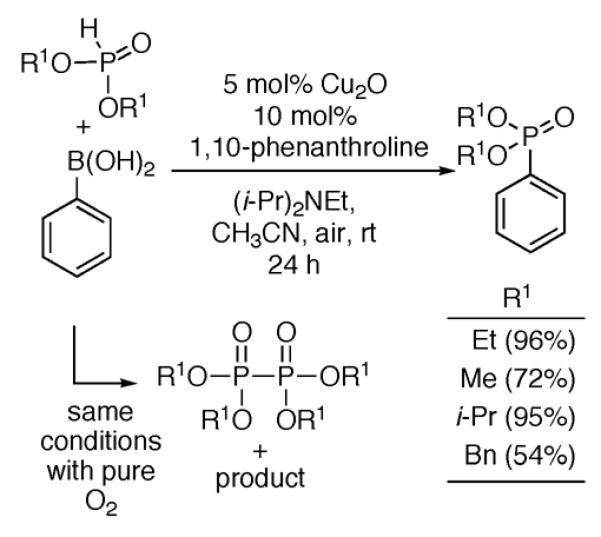
C–P bond formation with various H-phosphonates and formation of hypodiphosphate with pure O2.
Scheme 210.
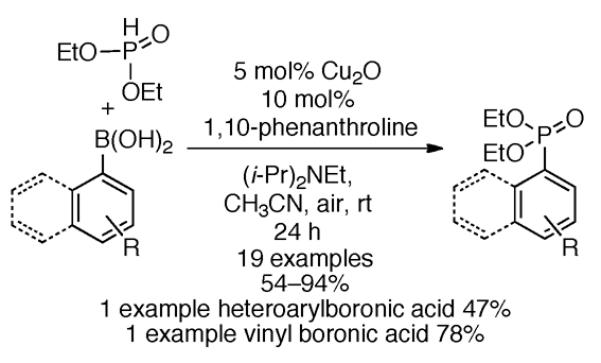
C–P bond formation with various boronic acids.
III.C.7. Summary of Boronic Acid Couplings
Since the initial discoveries in 1998, the synthetic community has become skilled at exploiting the use of small molecule copper catalysts to direct powerful redox chemistry for the formation of new bonds from arylboronic acids. The use of readily available boronic acids, catalytic amounts of copper, weak base, ambient temperatures, and molecular oxygen are notable features of the Chan-Lam coupling methods that make them synthetically valuable. Although tremendous progress has been made in identifying new heteroatom nucleophiles that have improved existing protocol or led to the discovery of new C–heteroatom bond forming methods, there are still limitations that need to be addressed. An understanding of reactivity for each type of substrate is needed to select appropriate reagents without extensive reoptimization, especially for complex structures. There is only one method that allows for the synthesis of hindered heterocycles under mild conditions.325 To date, no asymmetric C–N bond forming and C–O macrocyclizations protocols have been reported using an oxidative copper-mediated cross coupling approach even though natural products containing chiral C–N and C–O bonds are known. Competing oxidation and protodeboronation of the boronic acid has remained a recurring setback in yield optimization and atom economy. A valuable improvement would be identification of oxidative conditions that would disfavor or slow down these types processes. Additional mechanistic studies for these transformations are needed to further expand this chemistry. For example, a basis to determine whether deprotonation will occur before or after coordination of the nucleophile to the copper is needed. An understanding of the transmetallation step and the influence of ligand-copper and ligand-copper-nucleophile interactions on the copper oxidation state would be highly beneficial to expanding the scope.
IV. Reactions of Alcohols
Galactose oxidase (GO) is a copper-containing enzyme that catalyzes the two-electron oxidation of alcohols to aldehydes using molecular oxygen as the terminal oxidant.415 The obvious utility of this type of transformation, coupled with the understanding of the structure and mechanism416 of GO has inspired the design of numerous small molecule catalysts to effect similar transformations. Major challenges to the development of these catalysts include the extension the substrate scope beyond activated (i.e., allylic and benzylic) alcohols, identification of effective co-oxidants, and the identification of simple and inexpensive copper catalysts. The following sections detail various approaches that meet these challenges.
IV.A. Formation of Carbonyls from Alcohols
Four basic paradigms exist for the copper-catalyzed oxidation of alcohols to carbonyls, each varying in the manner in which the hydrogen atom bound to the carbon is abstracted from the coordinated alcohol (Scheme 211). In Mechanism Type I, this hydrogen is abstracted by molecular oxygen coordinated to the copper center. Note that the structure shown in Scheme 211 is an oversimplification of the intricate interplay between copper(II) and molecular oxygen, which is well covered in a recent review by Stack and co-workers.79e Mechanism Type II, pioneered by Semmelhack,417 features a hydrogen radical acceptor, often TEMPO or one of its analogues, as a cofactor. In Mechanism Type III, largely developed by Markó,59,418 a hydrogen anion acceptor serves as a cofactor. Mechanism Type IV is the most analogous to that of galactose oxidase, in which an oxy radical on the ligand itself abstracts a hydrogen radical.
Scheme 211.
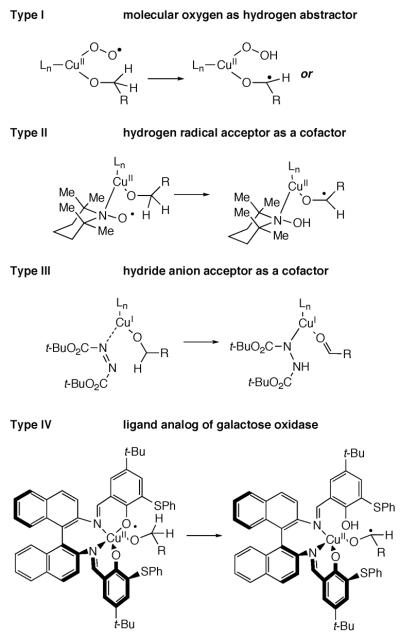
Mechanism paradigms for copper-catalyzed alcohol oxidation.
IV.A.1 Alcohol Oxidation
The reactions of Mechanism Type I represent the aerobic oxidations of alcohols using copper catalysts without any co-oxidant. Abstraction of the hydrogen is performed by a copper-oxygen species,419 the exact nature of which depends heavily on reaction conditions and ligands. The lack of a co-catalyst renders these reactions useful for studies of the interactions between copper and oxygen. Much work has been undertaken to understand the interactions between copper and molecular oxygen, including the manner in which coppexr activates the oxygen to make it available for catalytic oxidations.79e By far and large, these reactions are not synthetically useful since they require forcing conditions and are prone to overoxidation.420 However, their development, which began with the work of Brackman and Gaasbeek in 1966,421 paved the way for the much more mild and general reactions that are discussed below.
One of the many proposed mechanisms is shown in Scheme 212.422,423 The binding of the alcohol to the Cu(I) complex is followed by oxidation of the complex by molecular oxygen to give a μ-peroxo Cu(II) species. Homolysis of the peroxide bond and proton abstraction results in formation of the aldehyde and regeneration of the catalyst. However, other mechanistic studies indicate the presence of H2O2 as a byproduct of the oxidation process.424 This reaction is inhibited by water, a byproduct of the oxidation reaction,425 as well as by tertiary phosphine ligands, likely due to competitive binding at the copper center.426 The oxidation reaction is most effective at pH of 12.6–13.3, indicating that the alcohol must be deprotonated prior to binding to the copper complex.427 Highly oxidized copper(III) complexes have also shown to mediate the oxidation of benzyl alcohol to benzaldehyde, suggesting that these complexes may play a role depending on reaction conditions (Scheme 213).428
Scheme 212.
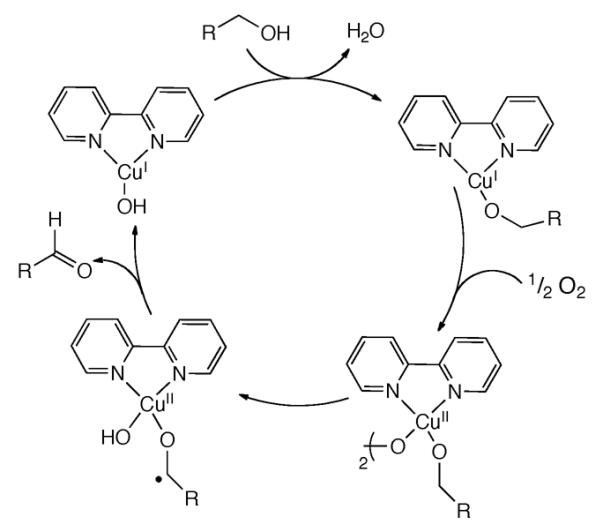
The mechanism of the aerobic alcohol oxidation without co-catalyst.
Scheme 213.

Oxidation of benzyl alcohol with a bis-copper(III) complex.
Since the majority of studies into this mechanism type are kinetic and inorganic investigations, there has been limited study toward expansion of the substrate scope. Nonetheless, this type of process has been shown to have good utility for selected substrates (Table 10). For example, Zhang and co-workers found ligand-free conditions to oxidize benzylic alcohols to benzaldehydes in good yield and with good selectivity (Scheme 214).431 Skibida and co-workers have shown that copper and oxygen catalyze the degradation of polyethylene glycol under basic conditions.429 At high temperatures (250 – 500 °C), γ-Al2O3 supported copper can effect the oxidation of methanol to HCHO, CO, and CO2.430
Table 10.
Oxidation of alcohols with copper catalysts using oxygen.
| Entry | Substrates | Co-oxidant | Ligand/Complex | Additive | Reaction conditions | Yields | # of examples | Ref |
|---|---|---|---|---|---|---|---|---|
| 1 | Benzylic | 1 mol% CuCl2 | 1.2 equiv CsCO3 | Toluene, 40 °C, O2, 12 h | 72–94% | 9 | 431 | |
| 2 | Benzylic 1° Aliphatic |
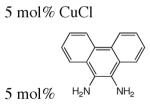
|
0.25 M NaOH | H2O, 100 °C, 10 atm O2, 3 h | 57–99% conv | 5 | 432 | |
| 3 | Propargylic | 10 mol% Cu-nanoparticles 10 mol% bipyridine |
PhMe, air, 80 °C, 8 h | 80–95 | 6 | 433 | ||
| 4 | Benzylic Allylic 1° Aliphatic 2° Aliphatic | Graphite electrode, −0.55 V | 0.03 mol% 2,2'-bisquinoline polymer | 0.15 M LiClO4, 0.05 M Bu4NBF4 | CH2Cl2, air, rt | 85–94% | 5 | 434 |
| 5 | Benzylic | 2 equiv CuCl 2 equiv phen |
2 equiv K2CO3 | Benzene, reflux, O2 | 83–93% | 3 | 435 | |
| 6 | Benzylic | 2 equiv CuCl 2 equiv phen |
2 equiv K2CO3 | Benzene, reflux, O2 | 65–86% | 4 | 436 | |
| 7 | Benzylic | 5 mol% Cu(OAc)2 5 mol% phen |
1:1 DMF/Benz ene, reflux, O2, 2 h | 54–70% | 3 | 437 | ||
| 8 | Benzylic |
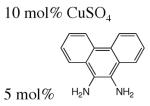
|
NaOH (pH 13.2) | H2O, 80 °C, 10 bar O2, | 54–74% | 5 | 438 |
Scheme 214.
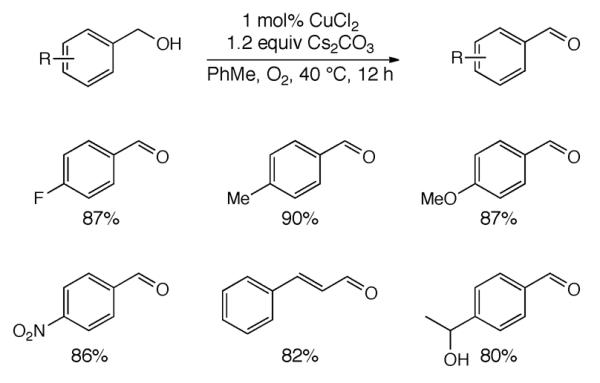
Oxidation of benzylic alcohols catalyzed by CuCl2•CsCO3.
Yao and co-workers demonstrated the utility of copper nanoparticles as a catalyst scaffold for the aerobic oxidation of alcohols.433 Using 2,2'-bipyridine as a ligand, propargylic alcohols were oxidized to ketones in excellent yield (Scheme 215).
Scheme 215.
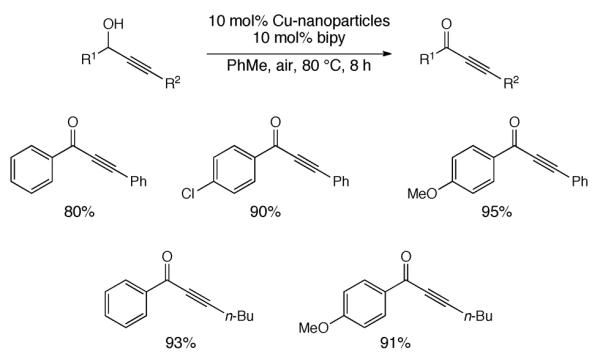
Aerobic oxidation of propargylic alcohols using copper nanoparticles.
A unique oxidative intramolecular cyclization of formyl-N-arylformamides has recently been reported.439 The method employs catalytic CuCl2 under oxygen to induce coupling of aldehyde with the ortho-aryl position, providing an array of indoline-2,3-diones (isatins) in good to excellent yield (Scheme 216). Secondary amides failed to provide more than trace amounts of product, and substrates with strongly electron-withdrawing group at the para-position also gave poor yields. meta-Substituted substrates afforded regioisomeric product mixtures.
Scheme 216.
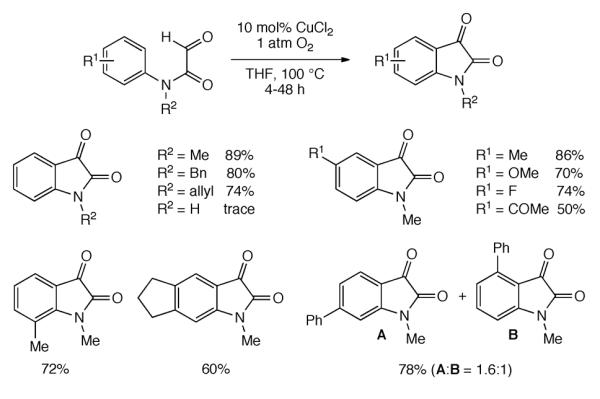
Directed oxidative cyclization to afford isatins.
A small but observable kinetic isotope effect was observed with deutero-substitution for either the ortho-aryl or aldehydic hydrogen. Radical inhibitors such as TEMPO or 1,1-diphenylethylene did not affect the reaction. Consequently, a radical mechanism or a mechanism involving SEAr or chelation-assisted C–H bond cleavage in the rate determining step is unlikely. The authors propose initial insertion into the aldehydic C–H bond to generate an acyl copper(II) intermediate (Scheme 219, Path A). The lack of precedent for this step and for that involving oxidative arene C-H insertion with a Cu(II) to Cu(III) redox couple raises the possibility of an alternate mechanism (Path B), in which a Friedel-Crafts reaction is followed by copper-catalyzed oxidation of the alkoxy intermediate. The authors noted, in the absence of oxygen, significant amounts of the anticipated Friedel-Crafts adduct are formed. A rate-determining copper-catalyzed oxidation of this intermediate would account for the isotope effects, and is also consistent with the mass values and IR stretches reported.
Scheme 219.
Proposed mechanism of the copper-TEMPO aerobic alcohol oxidation.
The second major paradigm in aerobic copper-catalyzed alcohol oxidation utilizes (2,2,6,6-tetramethyl-piperidin-1-yl)oxyl (TEMPO), or an analogue thereof, as a cocatalytic hydrogen radical acceptor. Brackman and Gaasbeek first observed the utility of nitroxyl radicals as promoters of oxidation reactions while studying the oxidation of methanol by cupric complexes.440 These oxidative conditions are very selective for primary alcohols, and much work has been done expanding both the substrate scope and optimizing the copper catalyst and N-oxyl radical co-catalyst (Table 11). Pioneering work by Semmelhack showed that aliphatic, allylic, and benzylic primary alcohols oxidize easily to the aldehyde, but that secondary alcohols require forcing reaction conditions (Scheme 218).417
Table 11.
Aerobic alcohol oxidations employing the copper and N-oxyl radical co-catalytic system.
| Entry | Substrates | Co-oxidant | Ligand/Complex | Additive | Reaction conditions | Yields (%) | # of Ref examples | |
|---|---|---|---|---|---|---|---|---|
| 1 | Benzylic Allylic 1° Aliphatic |
5 mol% TEMPO |
5 mol% Cu(MeCN)4X X = OTf−, BF4−, PF6− 5 mol% bipy |
10 mol% NMI |
MeCN, air, O2, rt | 79–98 | 37 | 441 |
| 2 | Benzylic, Allylic 1° Aliphatic |
10 mol% TEMPO |
10 mol% CuCl | DMF, 25 °C, 1 atm O2, 1–7 h |
85–96 | 8 | 417 | |
| 4 | Benzylic Allylic 1° and 2° Aliphatic |
3.5–10 mol% TEMPO |

|
C8F17Br/PhCl, 90 °C, O2, 1–10h |
69–97 | 21 | 442 | |
| 5 | Benzylic Allylic 1° and 2° Aliphatic |
5 mol% TEMPO |
2.5 mol% [phenCu(μCl)]2Cl2 |
50 mol% K3PO4 or K2CO3 |
MeCN, rt, O2, 2 h | 65–95 | 13 | 443 |
| 6 | Benzylic Allylic 1° Aliphatic |
5 mol% TEMPO |
5 mol% CuBr2 5 mol% bipy |
5 mol% t-BuOK |
2:1 MeCN/H2O, 25 °C, air, 2.5–5 h | 91–100 (conv) | 4 | 444 |
| 7 | Benzylic Allylic 1° Aliphatic |
5 mol% TEMPO |

|
Toluene, 100 °C, O2, 9–26 h |
70–99 | 12 | 445 | |
| 8 | Benzylic 1° Aliphatic |
3.5–10 mol% TEMPO |
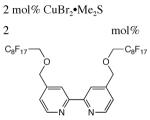
|
PhCl, 90 °C, O2, 6–9 h |
96–100 | 10 | 446 | |
| 9 | Benzylic Allylic 1° Aliphatic |
3 mol% TEMPO |
3 mol% CuBr2 or Cu(OTf)2 3 mol% bipy, |
6 mol% NMI or DBU |
MeCN, rt, 1–5 h, 1 atm O2 | 55–94 | 11 | 447 |
| 10 | Benzylic Allylic 1° Aliphatic |
Built into ligand |
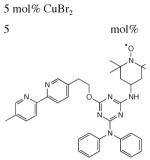
|
5 mol% t-BuOK |
2:1 MeCN/H2O, 50 °C, O2, 3–10h |
61–100 (conv) | 3 | 448 |
| 11 | Benzyilc Allylic 1° Aliphatic |
5 mol% TEMPO |
5 mol% CuBr2 5 mol% bipy |
5 mol% t-BuOK | 2:1 MeCN/H2O, rt, O2, 2–14h |
61–100 (conv) | 4 | 449 |
| 12 | 1° Aliphatic | 50 mol% TEMPO |
50 mol% CuCl |
Visible light | DMF, 25 °C, air, 14–140 h |
50–72 | 5 | 450 |
| 13 | 1° Allylic | 10 mol% TEMPO |
10 mol% CuCl | DMF, O2 rt, 2 h | 75–92 | 6 | 451 | |
| 14 | Benzylic Allylic | 5 mol% TEMPO |
0.5–2.5 mol% Cu(0) powder 2.5–5 mol% bipy |
NaOH (pH 13) |
2:1 MeCN/H2O, 25 °C, O2, 4–30 h |
69–99 (conv) | 5 | 452 |
| 15 | Benzylic Allylic |

|
5 mol% Cu(ClO4)2•H2O 10 mol% DMAP |
[bmpy][PF6], rt, O2, 5 h |
77–92 | 11 | 453 | |
| 16 | Benzylic Allylic |
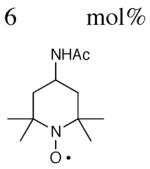
|

|
10 mol% DABCO |
DMSO, rt, O2, 2 h | 71–98 | 9 | 454 |
| 17 | Benzylic Allylic |
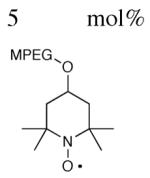
|

|
10 mol% t- BuOK |
2:1 MeCN/H2O, 80 °C, O2, 18 h |
32–100 | 18 | 455 |
| 18 | Benzylic Allylic |
2 mol% TEMPO |
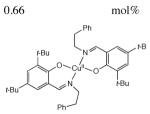
|
Toluene, 60 °C, O2, 1–2 h |
26–100 (conv) | 20 | 456 | |
| 19 | Benzylic Allylic |
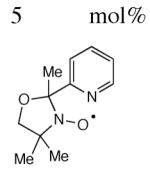
|
5 mol% CuBr2 | 5 mol% t- BuOK |
Air, MeCN/H2O, rt, 84 h |
64–96 | 17 | 457 |
| 20 | Benzylic Allylic |
5 mol% TEMPO |
5 mol% CuCl | [bmim][PF6], 65 °C, O2, 15 h |
50–96 | 12 | 458 | |
| 21 | Benzylic Allylic |
12.5 mol% TEMPO |
10 mol% CuBr2 10 mol% bipy |
10 mol% NaOMe |
2:1 MeCN:H2O, microbubbled air, 30 °C, 12 h |
73–98 (conv) |
7 | 459 |
| 22 | Benzylic Allylic |
3 mol% TEMPO |

|
1:1 MeCN:H2O, O2, 80 °C, 2 h | 83–10 (conv) | 9 | 460 | |
| 23 | Benzylic, allylic |
2° 6 mol% TEMPO |

|
– | Perfluoroheptane/ PhCl O2, 90 °C, 8 h |
60–100 (conv) | 3 | 461 |
| 24 | Benzylic | 5 mol% TEMPO |
1–5 mol% CuSO4 1–5 mol% phen |
NaOH (pH 12.6–13.5) |
H2O, 10 bar O2, 80 °C |
62–100 (conv) |
11 | 462 |
| 25 | Benzylic | 5 mol% TEMPO |
5 mol% CuCl 5 mol% DABCO |
Toluene, 100 °C, O2, 2–24 h |
51–98 | 20 | 463 | |
| 26 | Benzylic |
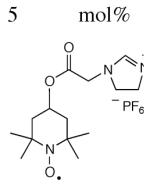
|
5 mol% CuCl | 3 Å MS | [bmim][PF6], 80 °C, O2, 3–9.5 h |
70–91 | 6 | 464 |
| 27 | Benzylic | 5 mol% TEMPO |
5 mol% CuCl | 10 mol% pyridine |
[bmim][PF6], 65 °C, O2, 2–7 h |
71–90 | 7 | 465 |
| 28 | Benzylic |
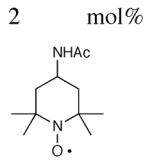
|
1 mol% CuBr 2 mol% DMAP |
Piperylene sulfone, rt, O2, 3–5 h |
84–98 | 9 | 466 | |
| 29 | Benzylic |
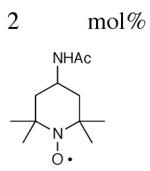
|

|
Neat, 25 °C, O2, 0.5–1 h |
89–96 | 8 | 467 | |
| 30 | Benzylic | 50 mol% TEMPO |
73 mol% Cu3(BTC)2 MOF | 1 equiv Na2CO3 |
MeCN, 75 °C, O2, 22 h |
52–89 | 5 | 468 |
| 31 | Benzylic | 20 mol% resin- supported TEMPO |
20 mol% resin-supported CuCl-Phen |
DMF, air, rt, 24 h | 100 (conv) |
4 | 469 | |
| 32 | Benzylic | 5 mol% TEMPO |
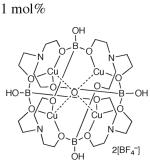
|
33 mol% K2CO3 |
H2O, 50 °C, air, 22–44 h |
68–95 | 4 | 470 |
| 33 | Benzylic | 5 mol% TEMPO |
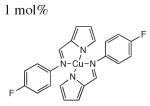
|
0.1 M K2CO3 | H2O, rt, O2, 2–20 h | 68–100 (conv) | 7 | 471 |
| 34 | Benzylic | 5 mol% TEMPO |

|
0.1 M K2CO3 | H2O, 40 °C, air, 6–22 h |
91–99 | 2 | 472 |
| 35 | Benzylic | 5 mol% TEMPO |
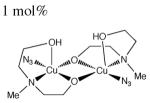
|
0.1 M K2CO3 | H2O, 50 °C, air, 22 h |
29–91 | 5 | 473 |
| 36 | Benzylic | 5 mol% TEMPO |
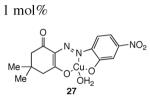
|
0.1 M K2CO3 | H2O, 50 °C, air, 22 h |
48–99 | 5 | 474 |
| 37 | Benzylic | 5 mol% TEMPO |
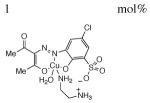
|
0.1 M K2CO3 | H2O, 80 °C, air, 18 h |
74–98 | 5 | 475 |
| 38 | Benzylic | 3 mol% TEMPO |
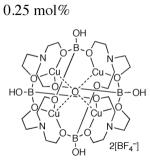
|
2:1 MeCN/H2O, 70 °C, O2, 4–6 h |
54–74 | 4 | 476 | |
| 39 | Benzyl Alcohol | 5 mol% TEMPO |
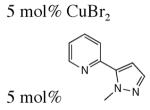
|
5 mol% t- BuOK |
2:1 MeCN/H2O, 50 °C, O2, 24 h |
99% (conv) |
1 | 477 |
| 40 | Benzyl Alcohol |
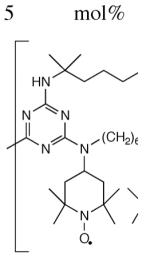
|
10 mol% CuCl | DMF, 25 °C, O2, 1.5 h |
96% (conv) |
1 | 478 | |
| 41 | 4-nitrobenzyl alcohol |
6 mol% TEMPO |
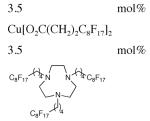
|
C7FI6, 90 °C, O2, 8 h |
96 (conv) |
1 | 71 | |
| 42 | Benzyl Alcohol | Built into ligand |
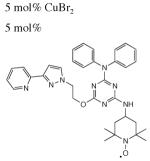
|
5 mol% t- BuOK |
2:1 MeCN/H2O, 50 °C, O2, 24 h |
84 (conv) |
1 | 479 |
| 43 | Benzyl Alcohol | 20 mol% TEMPO |

|
2:1 MeCN/H2O, rt |
TON = 9 h−1 |
1 | 480 | |
Scheme 218.
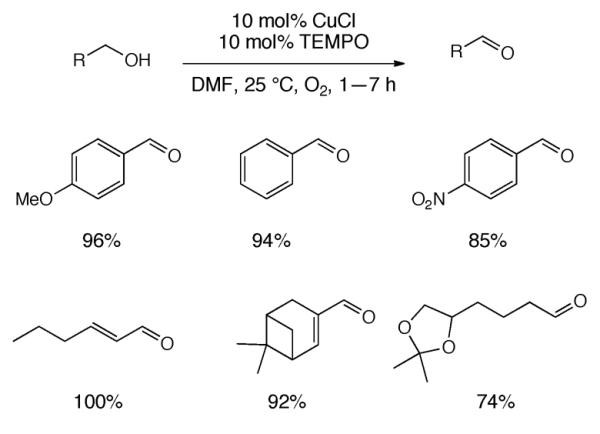
Oxidation of primary alcohols using CuCl and TEMPO.
A proposed mechanism for this transformation is shown in Scheme 219. Both TEMPO and the alcohol coordinate to the copper complex.444 The oxyl radical abstracts a proton from the alcohol, which in turn reduces the copper center to eject the aldehyde. The N-hydroxide thus formed is oxidized to the radical by molecular oxygen, and the active Cu(II) catalyst is regenerated via oxidation by an equivalent of an N-oxy radical. The high selectivity for primary alcohols arises from steric crowding at the copper center, which prevents the coordination of secondary alcohols. An analogous mechanism proposed by Sheldon suggests that the TEMPO is bound via the oxygen rather than the nitrogen;481 an η2-coordination mode (binding to both the oxygen and the nitrogen) has also been proposed.449
A kinetic study of the reaction by Koskinen and co-workers showed the TEMPO and copper co-catalyzed oxidation of alcohols to be first order in TEMPO and second order in copper.447 This led to the proposal of an alternate mechanism (Scheme 220), in which the rate-determining step is the oxidation of one alcohol molecule to the aldehyde by a binuclear copper complex, with concurrent oxidation of TEMPOH to TEMPO and reduction of one copper nucleus to Cu(I). The nitroxyl radical thus formed serves to oxidize a second alcohol molecule, reducing the second copper atom and releasing a second equivalent of aldehyde.
Scheme 220.
Binuclear mechanism for the TEMPO and copper co-catalyzed aerobic alcohol oxidation.
An ESI mass spectrometry study was conducted by Shyu and coworkers on the copper-9,10-phenanthroline-TEMPO co-catalyzed reaction, with the goal of detecting the reactive intermediates proposed in the above reactions.443 Prior to addition of benzyl alcohol, the ESI MS showed the presence of both monomeric and dimeric copper species. Immediately after the addition of benzyl alcohol, only monomeric copper complexes were observed. However, no traces of the alcohol-copper-phen complex or the TEMPO-copper-phen complexes were observed. Also, the authors observed a peak at 1630 cm−1 in the IR spectrum, which the authors attributed to an oxoammonium species II. This led a proposed mechanism (Scheme 221) in which the copper serves only to oxidize the nitroxyl radical I to the oxoammonium species II; in turn, molecular oxygen oxidizes the copper. This reaction mechanism is analogous to that of the TEMPO-NaOCl alcohol oxidation system,482 and is similar to that initially proposed by Semmelhack.417 Computational studies support the reaction involving charged species,483 but these results vary considerably depending on the density functional method. It should be noted that none of the above mechanisms are supported conclusively,484 so it is not unreasonable to expect that different combinations of three mechanisms contribute in some measure depending on the reaction conditions.
Scheme 221.
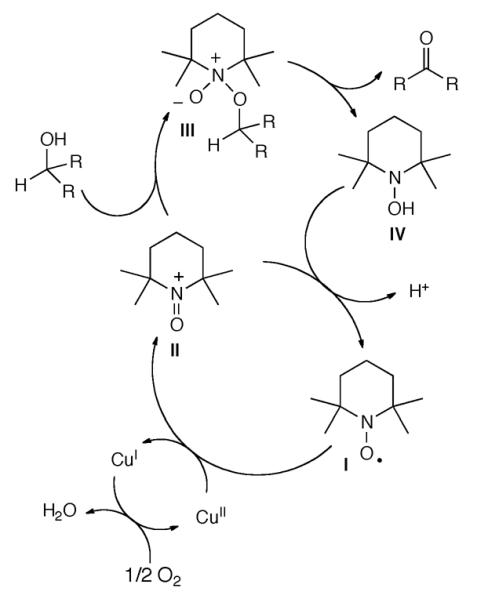
Oxoammonium-mediated mechanism the TEMPO and copper catalyzed alcohol oxidation.
The impressive functional group tolerance and selectivity for primary alcohols was recently demonstrated by Hoover and Stahl (Scheme 222).441 Using 5 mol% copper and 5 mol% TEMPO with 10 mol% N-methylimidazole (NMI), many primary allylic, benzylic, and aliphatic alcohols were oxidized to the corresponding aldehydes in the presence of a variety of functional groups including heterocycles, alkenes, and unprotected 2° alcohols. Limitations of the method were also identified; poor substrates included those with vicinal diols and other chelating groups in close proximity to the reactive alcohol. Substrate competition reactions demonstrate that CuBr2 is more selective than Cu(OTf)2, with the latter giving overoxidation of intermediate hemiacetals to lactones (Scheme 223).
Scheme 222.
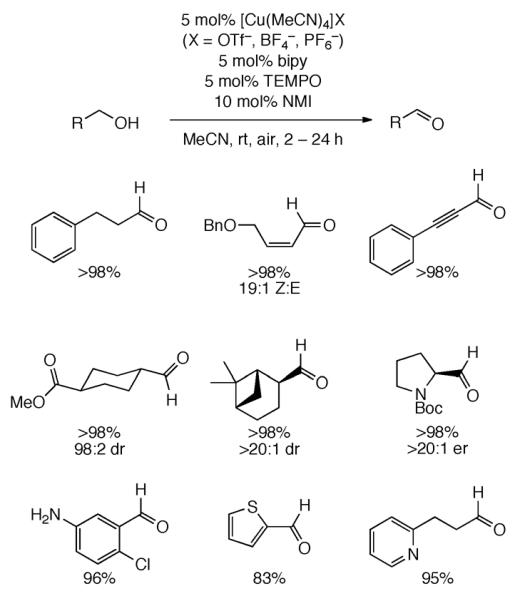
Selected examples in the Cu/TEMPO/NMI-catalyzed aerobic alcohol oxidation.
Scheme 223.
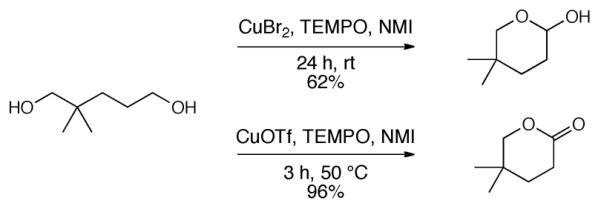
Preference for unhindered alcohols and overoxidation by CuOTf in the Cu/TEMPO/NMI-catalyzed alcohol oxidation.
Raguaskas453 and Gree458 have developed methods for utilizing the Cu/TEMPO oxidation in ionic liquids. Allylic and benzylic alcohols are readily oxidized whereas higher temperatures and longer reaction times are required for primary aliphatic alcohols. The products are extracted using organic solvents, and the copper- and TEMPO-containing ionic liquid can be recycled multiple times without loss of activity.
While investigating the copper-catalyzed aerobic oxidation of sugars using TEMPO, Hoffmann and Gassama saw a rate acceleration when the reaction was exposed to visible light compared to reactions kept in the dark (Scheme 224).450 UV/Vis analysis of the reaction mixture indicated that the irradiated reaction showed a lower concentration of the Cu(II)–TEMPO adduct, suggesting that the light destabilizes this intermediate. Taking advantage of the selectivity of this reaction toward primary alcohols, a tetrahydroxyazapane was synthesized via oxidation of a benzyl glucoside, followed by reductive amination and nucleophilic ring expansion (Scheme 225).
Scheme 224.

Copper and TEMPO-catalyzed aerobic oxidation of sugar derivatives.
Scheme 225.
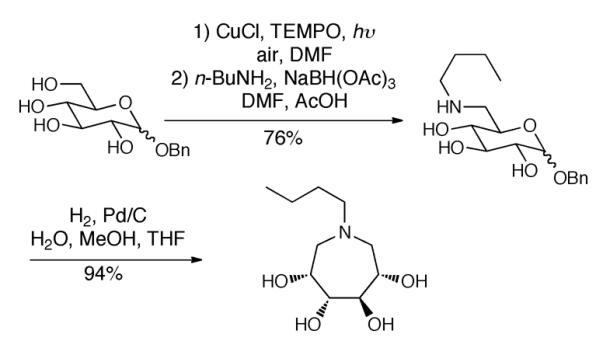
Synthesis of a tetrahydroazapane using the light-activated Cu/TEMPO-catalyzed aerobic alcohol oxidation.
A fluorous biphasic system and a bipyridyl catalyst with perfluorinated side chains effectively catalyzes the oxidation of aliphatic and benzylic alcohols to aldehydes in good to excellent yield (Scheme 226).442 Benzylic and allylic secondary alcohols are also oxidized to ketones; higher loading of TEMPO is needed for aliphatic secondary alcohols. High chemoselectivity is observed in the oxidation of cyclohexanols, with axial alcohols reacting 6–8 times faster than equatorial alcohols.
Scheme 226.
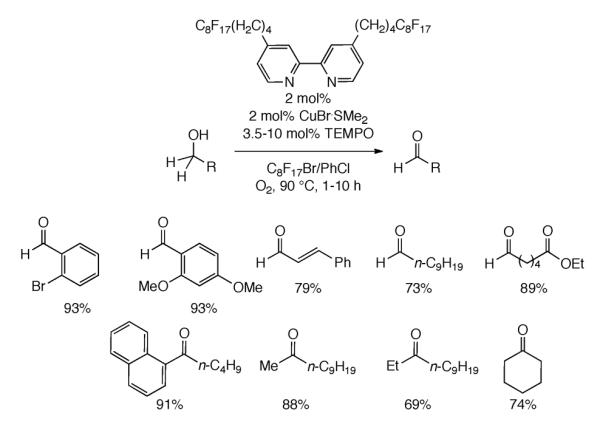
The Cu/TEMPO-catalyzed aerobic oxidation of alcohols using a fluorous biphasic system.
The utility of the Cu/TEMPO-catalyzed aerobic oxidation of alcohols, both in the selectivity and functional group tolerance, has led to its utilization in a number of total syntheses. Essigmann selectively oxidized a benzylic alcohol in the presence of an aliphatic primary alcohol in the synthesis of a known side product of the 2+2 reaction of psoralen (Scheme 227).485
Scheme 227.

Application of the chemoselective Cu/TEMPO-catalyzed alcohol oxidation.
The method has also been applied in the total synthesis of epoxyquinol A and its analogs by Porco and co-workers, in which a primary allylic alcohol was selectively oxidized in the presence of a secondary allylic alcohol with no erosion of enantioselectivity (Scheme 228).486 The aldehyde thus formed undergoes a 6π-electrocyliczation in situ followed by a Diels-Alder cycloaddition. Notably, Dess-Martin periodinane oxidized of both alcohols. Kuwahara and Imada used the same transformation in their total synthesis of epoxyquinol A. The Cu/TEMPO-catalyzed aerobic alcohol oxidation followed by a 6π-electrocyclization-Diels-Alder cascade then yielded the epoxyquinol A (46%) and epoxyquinol B (20%).487
Scheme 228.

The Cu/TEMPO-catalyzed alcohol oxidation in the synthesis of Epoxyquinol A.
The same method was used to elucidate the mechanism of an oxidation in a related system (Scheme 229). Selective oxidation of the allylic alcohol with Cu/TEMPO in oxygen yielded the electrocyclized product, which was then treated with Bobbitt's reagent (4-acetylamino-2,2,6,6-tetramethylpiperidine-1-oxoammonium tetrafluoroborate)488 to yield the lactone, indicating that the 2H-pyran is an intermediate in the original reaction.489
Scheme 229.
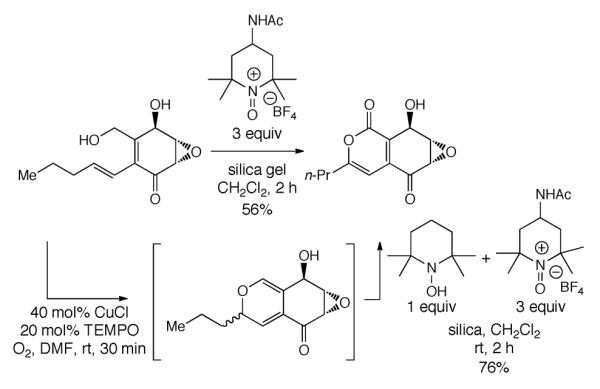
The use of Cu/TEMPO in mechanism elucidation.
The selective oxidation of the primary allylic alcohol in epoxyquinones, epoxyquinols, and epoxy diols is a motif that features prominently in the work of Mehta and co-workers. The versatile method has been employed in the total syntheses of (−)-cycloepoxydon,490 (±)-jesterone,491 (±)-ambulic acid,492 and (±)-acremines A, B, and I (Scheme 230).493 An attempt at the total syntheses of eupenoxide and phomoxide led to a revision of the natural product structures (Scheme 231). The original proposed structures contained cis-diols, but a moderately diastereoselective reduction of the quinol revealed that the trans-diol compounds matched the spectral data.
Scheme 230.
Total syntheses of epoxyquinol natural products.
Scheme 231.
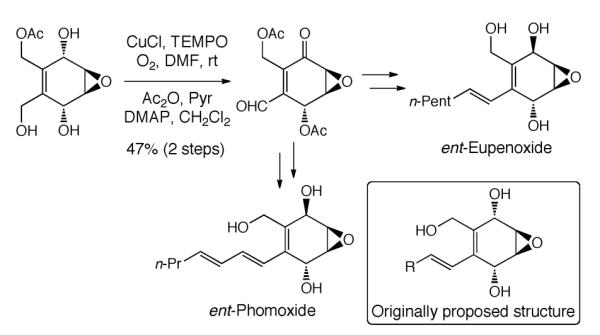
Total synthesis and structure revision of eupenoxide and phomoxide.
Mehta and co-workers have also applied this method to the synthesis of precursors used in a number of dimeric natural products. The final steps of the synthesis of torreyanic acid featured a similar oxidation/6π-electrocyclization/Diels-Alder cascade to that used by Porco and Imada, though it was initiated by DMP instead of Cu/TEMPO (Scheme 232).494 The total syntheses of (+)-panepophenanthrin495 and (+)-hexacyclinol496 originate from the same aldehyde precursor and utilize a [4+2] cycloaddition in the final step (Scheme 233).
Scheme 232.
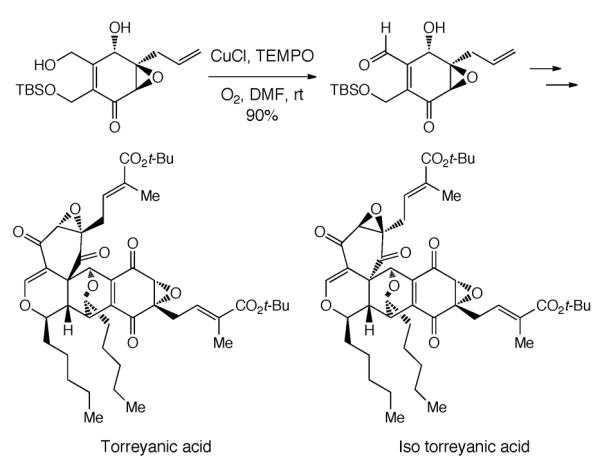
The application of the Cu/TEMPO-catalyzed alcohol oxidation to an intermediate in the total synthesis of torreyanic acid.
Scheme 233.
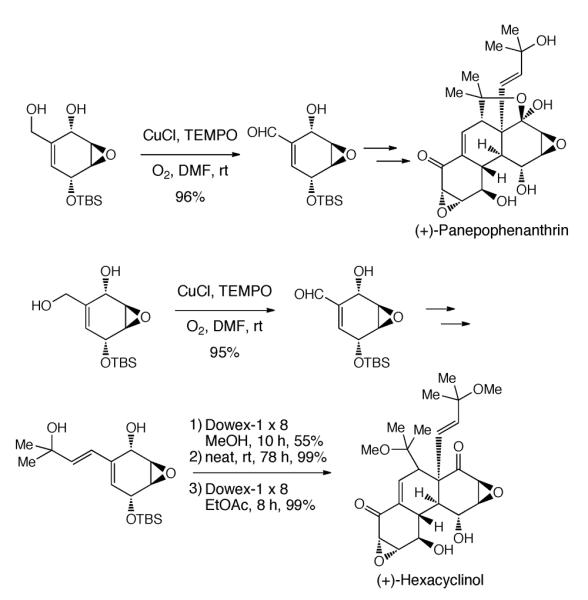
Selective Cu/TEMPO-catalyzed oxidation of alcohols in syntheses of (+)-panepophenanthrin and (+)-hexacyclinol.
An aerobic Cu/TEMPO-catalyzed alcohol oxidation was employed in the synthesis of a simplified analog of the FGH ring of rubrifloradilactone C (Scheme 234).497 Here, the primary allylic alcohol is oxidized to the aldehyde in the presence of a secondary allylic alcohol. The resultant hemiacetal is then oxidized to the lactone. Notably, other oxidants such as MnO2 did not give the desired selectivity. A similar method, oxidation to the aldehyde followed by oxidation of the hemiacetal, was also employed by Nonappa and Maitra in the total synthesis of 16-α-hydroxycholic acid, a component in bile of the shoebill stork (Scheme 235). Cleavage of the lactone with potassium hydroxide furnished the natural product.498
Scheme 234.
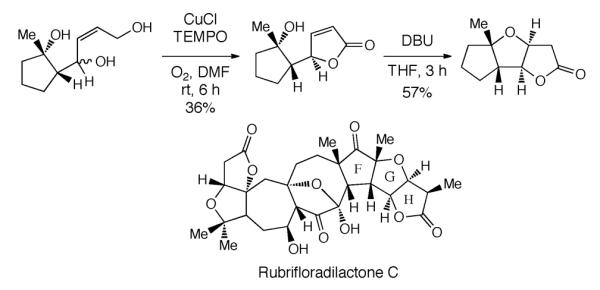
Selective alcohol oxidation in studies toward the synthesis of rubrifloradilactone C.
Scheme 235.
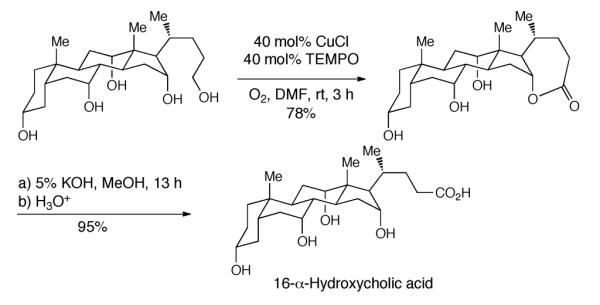
Selective oxidation of a primary alcohol in the presence of secondary alcohols in the synthesis of bile acids.
Aitken and co-workers tested a number of oxidants in their studies toward the synthesis of the southern region of cyclotheonamide C. An aerobic Cu/TEMPO-catalyzed oxidation of the primary allylic alcohol followed by Horner-Wadsworth-Emmons olefination gave the desired unsaturated ester in 55% overall yield (Scheme 236).499
Scheme 236.
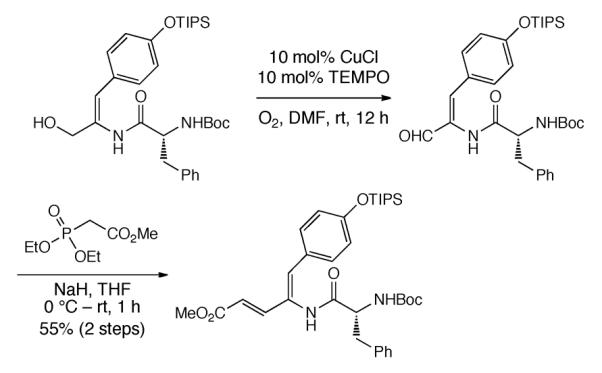
Application of the Cu/TEMPO-catalyzed alcohol oxidation in the studies toward the synthesis of cyclotheonamide C.
Fürstner and co-workers demonstrated the mild nature of the aerobic Cu/TEMPO-catalyzed aerobic alcohol oxidation in the studies toward the total synthesis of iejimalide B.500 The primary allylic alcohol was selectively oxidized without alkene isomerization in the presence of a chiral secondary allylic alcohol (Scheme 237).
Scheme 237.
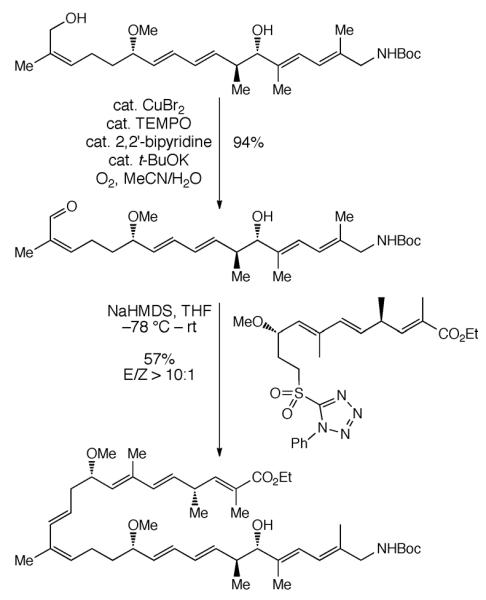
A mild and chemoselective Cu/TEMPO-catalyzed aerobic alcohol oxidation in studies toward the synthesis of iejimalide B.
Christoffers and co-workers employed a Cu/TEMPO-catalyzed alcohol oxidation in the total synthesis of (+)-canangone.501 A Luche reduction of an enantioenriched α-ketolactone yielded the diol in a 1:1 mixture of diastereomers which could be separated easily by column chromatography. Subjection of the separate diastereomers to the oxidation conditions resulted in selective oxidation of the primary alcohol, yielding (+)-(S,S)-canangone and its epimer, allowing for the determination of the absolute configuration of the natural product (Scheme 238).
Scheme 238.
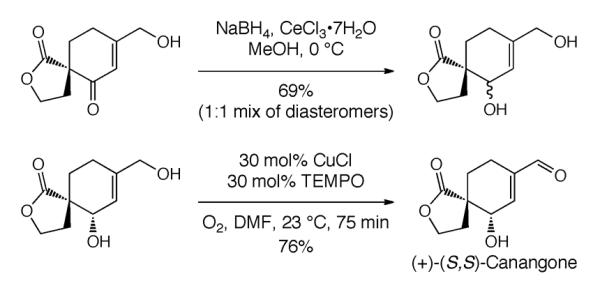
Aerobic Cu/TEMPO-catalyzed alcohol oxidation in the synthesis and determination of absolute configuration of (+)-(S,S)-canangone.
Mechanism Type III represents the most general method for copper-catalyzed aerobic oxidation of alcohols and employs catalytic CuCl with a 1,10-phenanthroline (phen) ligand and a catalytic amount of a diazodicarboxylate (Table 12). Typically di-tert-butyldiazodicarboxylate (DBAD) is employed, though the reduced form (DBADH2) may also be used. The reaction requires a base such as t-BuOK, N-methylimidazole, or K2CO3, unless an ionic liquid is used as the solvent.502 The addition of substoichiometric base prevents racemization of enantioenriched substrates.503 In addition to primary, allylic, and benzylic alcohols, the diazodicarboxylate conditions can also be used for the oxidation of secondary alcohols. Much of the work on developing this method was performed by Markó and co-workers (Scheme 239).418
Table 12.
Aerobic alcohol oxidations employing the copper and diazodicarboxylate co-catalytic system.
| Entry | Substrates | Co-oxidant | Ligand/Complex | Additive | Reaction conditions | Yields (%) | # of Ref examples | |
|---|---|---|---|---|---|---|---|---|
| 1 | Benzylic Allylic 1° and 2° Aliphatic |
5 mol% DBAD | 5 mol% CuCl 5 mol% phen |
2 equiv K2CO3 |
Toluene, 1 atm O2, 79–90 °C, 1–2 h |
78–97 | 9 | 418a |
| 2 | Benzylic Allylic 1° and 2° Aliphatic |
5 mol% DBAD | 5 mol% CuCl 5 mol% Phen |
25 mol% K2CO3 |
PhF, 1 atm O2, 80 °C, 3–8h |
65–93 | 9 | 418b |
| 3 | Benzylic Allylic 1° and 2° Aliphatic |
5 mol% DBAD | 5 mol% CuCl 5 mol% Phen |
2 equiv K2CO3 |
PhMe, 1 atm O2, 90 °C |
65–89 | 9 | 418c |
| 4 | Benzylic Allylic 1° and 2° Aliphatic |
5 mol% DBAD | 5 mol% CuCl 5 mol% Phen |
5 mol% KOt-Bu |
PhF, 1 atm O2, 80 °C, 3–8h |
78–97 | 9 | 503a |
| 5 | Benzylic 1° and 2° Aliphatic |
5 mol% DBADH2 |
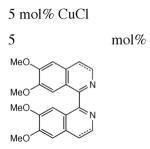
|
[bmim][PF6], 80 °C, O2, 1.5–3 h |
81–99 (conv) |
8 | 502 | |
| 6 | Benzylic 1° Aliphatic |
5 mol% DBAD | 5 mol% CuCl 5 mol% phen 7 mol% NMI |
5 mol% t-BuOK | PhF, 70–80 °C, O2, | 83–95 | 12 | 503b |
| 7 | Allenic | 20 mol% DBAD | 20 mol% CuCl 10 mol% phen 10 mol% bipy |
50 mol% K2CO3 |
PhMe, air (20 atm), 35 °C, 10 h |
61–91 | 10 | 504 |
| 8 | Benzylic |

|
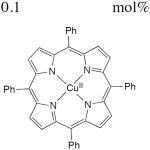
|
o-xylene, O2, 60 °C |
75–99 | 6 | 505 | |
Scheme 239.
Aerobic copper catalyzed alcohol oxidations using a diazodicarboxylate as a cocatalyst.
The reaction proceeds through a Cu(I)/Cu(II) redox cycle (Scheme 240).418c Commencing from a copper(I)-phenanthroline hydroxide complex, ligand exchange produces alkoxy complex II. The oxidation of the alcohol to carbonyl occurs concurrently with reduction of the diazodicarboxylate to a diazadicarboxylate species, generating III. After dissociation of the aldehyde, oxygen converts the Cu(I) complex IV to the Cu(II) μ-peroxo intermediate V. Homolysis of the peroxide bond reduces the copper and oxidizes the co-catalyst to back to the diazodicarboxylate, regenerating the active catalyst I.
Scheme 240.
Mechanism of the copper-diazodicarboxylate aerobic alcohol oxidation.
Mechanism type IV catalysts mimic galactose oxidase, an enzyme that contains a copper catalytic site in which a ligand-stabilized radical is key to the oxidation.415 Much study has been devoted to the mechanism of this enzyme, resulting the catalytic cycle depicted in Scheme 241.416 Key features of the galactose oxidase mechanism include 1) an oxidizable ligand which expands the effective oxidation state of Cu(II) to Cu(III), even though discrete Cu(III) species are not formed, 2) abstraction of a hydrogen radical from the carbon of the bound alcohol substrate, 3) oxidation of the bound carbon radical to the aldehyde by reduction of Cu(II) to Cu(I), and 4) two electron reoxidation of the catalyst with molecular oxygen.
Scheme 241.
Proposed mechanism of the galactose oxidase-catalyzed alcohol oxidation.
The presence of an oxidizing metal and oxidizing ligand in one catalytic entity has inspired a large number of studies toward mimicking this enzymatic reaction with small molecule constructs (Table 13). The bulk of these constructs are complex catalytic entities that will be difficult to implement in preparative procedures. Furthermore, the synthetic utility of these methods has not been explored broadly, with the substrate scope usually described for methanol, ethanol, or benzyl alcohol.
Table 13.
Aerobic alcohol oxidations employing galactose oxidase mimics.
| Entry | Substrates | Co-oxidant | Ligand/Complex | Additive | Reaction conditions | Yield (%) | # of examples | Ref |
|---|---|---|---|---|---|---|---|---|
| 1 | Benzyl Alcohol Ethanol Methanol | – |
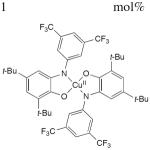
|
90 mol% Bu4NOMe | CH2Cl2, rt, air, 15 h | 72 | 1 | 506 |
| 2 | Benzylic Allylic 1° Aliphatic |
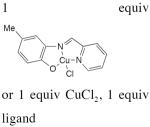
|
t-BuOK | MeCN/H2O, O2, 8 h | 65–92 (conv) | 5 | 507 | |
| 3 | Ethanol Benzyl alcohol | – |
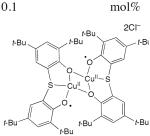
|
0.4 mol% NEt3, | 20° C, THF, 12 h, air | 60–63 | 2 | 508 |
| 4 | Ethanol Benzyl alcohol | – |
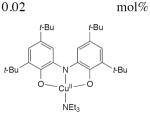
|
20 °C, air, 20 h | 55 | 2 | 509 | |
| 5 | Benzyl Alcohol | – |

|
2 mol% Bu4NOMe | MeCN, rt, air, 10 h | Not given | 1 | 79d,510 |
| 6 | Ethanol iso-propanol hydroxyaceto ne | – |
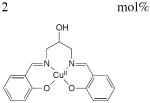
|
0.1 M KOH in EtOH | 40 °C, 1 atm O2, 10 h | Not given | 3 | 511 |
| 7 | Benzyl alcohol | – |
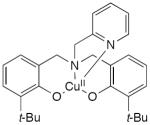
|
cat. KOH | O2 | Not given | 1 | 512 |
| 8 | Methanol | – |

|
O2, CH2Cl2 | Not given | 1 | 513 |
Much work has been done to elucidate the mechanism of these catalysts and establish their relationship to galactose oxidase.514 Stack has shown that the phenol of the ligand illustrated in Scheme 242 acts as the radical species, which abstracts a proton from the coordinated alcohol in the rate-determining step.515 Studies on the galactose oxidase model systems have shown a large kinetic isotope effect for the abstraction of the hydrogen atom.512,512,516 Oxidation to the alcohol is concurrent with reduction of the copper center and is followed by the oxidation of the copper and ligand by molecular oxygen to regenerate the active catalyst. This proposed mechanism is supported by theoretical calculations.517
Scheme 242.
Mechanism of a small molecule galactose oxidase mimic.
IV.A.2. Asymmetric Alcohol Oxidation
With homochiral copper catalysts, selective oxidation of alcohols with oxygen is possible via kinetic resolution or desymmetrization.518 For example, an enantiopure complex derived from (R)-BINAM and Cu(OTf) using TEMPO as the cooxidant and molecular oxygen as the terminal oxidant has been shown to catalyze the kinetic resolution of chiral diarylmethanols (Scheme 243).519 The achiral ketone product can be removed easily, leaving behind the enantioenriched unreacted starting material. While the authors do not report krel values, the enantioselectivities at the given conversions suggest a moderate resolution (krel ~ 5). Sterically hindered ortho-substituted substrates gave better resolution than para-substituted substrates.
Scheme 243.
Asymmetric oxidative kinetic resolution of diarylmethanols.
Using the same catalyst system, Sekar and coworkers performed an asymmetric oxidative kinetic resolution of benzoin compounds (Scheme 244).519,520 Again, the achiral oxidation product, a benzil, is readily removed to reveal the enantioenriched benzoin starting material. The high level of asymmetric induction indicates a high level of enantiodifferentiation, which requires well-defined interactions between the substrate and catalyst. Such a requirement is more consistent with the proposed mechanisms of Sheldon and Koskinen, in which the alcohol coordinates to the copper prior to the oxidation step, rather than the mechanism of Shyu, in which the alcohol does not coordinate to the copper.
Scheme 244.
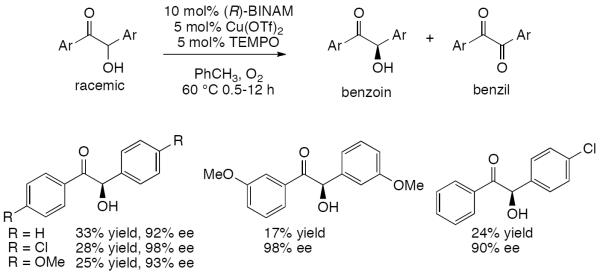
Asymmetric oxidative kinetic resolution of benzils.
IV.B. Oxidation of Diols and α-Hydroxycarbonyls
The copper-catalyzed oxidation of diols to dicarbonyls is difficult, as over-oxidation occurs readily (see Section V.D). Specifically, the resultant glyoxyls are oxidized to aldehydes and carboxylic acids under the same reaction conditions (Table 14, entries 1–7). Reaction yields can be improved with increased reaction time, but product ratios are correspondingly more difficult to control (entries 5 and 6). Copper and oxygen have exhibited more utility in the oxidation of benzoin compounds, due to the fact that reactivity can be modulated through proper selection of copper source. Copper(II) sources tend to give benzil products (entries 8–18),521,522,523,524 while copper(I) sources effect oxidative cleavage to yield carboxylic acids (entries 19–25).525
Table 14.
Oxidation of diols, benzoins, and steroids by copper and molecular oxygen.
| Entry | Substrate | Product | Ligand/Complex | Additive | Reaction conditions | Yield (%) | Ref |
|---|---|---|---|---|---|---|---|
| Oxidation of diols | |||||||
|
| |||||||
| 1 |
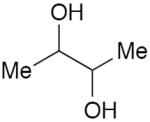
|

|
1 equiv CuCl | pyridine | air, 30°C, 4 h | 50 | 526 |
| 2 |
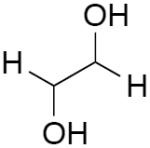
|
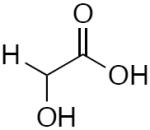
|
1 equiv Cu° | Pyridine | 3 atm O2, rt, 5 h | 60 | 527 |
| 3 |

|

|
1 equiv Cu° | Pyridine | 3 atm O2, rt, 24 h | 90 | 527 |
| 4 |
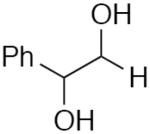
|
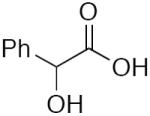
|
1 equiv Cu° | Pyridine | 3 atm O2, rt, 5 h | 88 | 527 |
| 5 |

|

|
1 equiv Cu° | Pyridine | 3 atm O2, rt, 24 h | 70 | 527 |
| 6 |
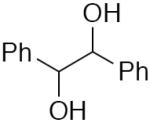
|

|
1 equiv Cu° | Pyridine | 3 atm O2, rt, 5 h | 50 | 527 |
| 7 |
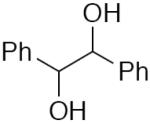
|

|
1 equiv Cu° | Pyridine | 3 atm O2, rt, 24 h | 82 | 527 |
|
| |||||||
| Oxidation of benzoins to benzils | |||||||
|
| |||||||
| 8 |
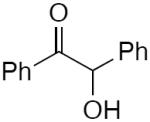
|
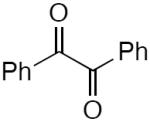
|
2 equiv CuSO4 | Pyridine | Air, H2O, 90 °C, 2 h | 86 | 521 |
| 9 |
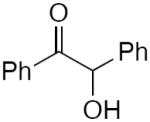
|
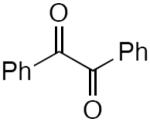
|
2 equiv CuSO4 | Pyridine | Air, H2O, 90 °C, 2 h | 97 | 522 |
| 10 |
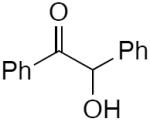
|

|
20 mol% [Cu(CH3CN)4]B F4 | O2, DMSO, 20 °C, 2 h | 88 | 523 | |
| 11 |

|

|
20 mol% [Cu(CH3CN)4]B F4 | O2, DMSO, 20 °C, 2 h | 86 | 523 | |
| 12 |

|

|
20 mol% [Cu(CH3CN)4]B F4 | O2, DMSO, 20 °C, 2 h | 36 | 523 | |
| 13 |

|

|
20 mol% [Cu(CH3CN)4]B F4 | O2, DMSO, 20 °C, 2 h | 61 | 523 | |
| 14 |

|

|
20 mol% [Cu(CH3CN)4]B F4 | O2, DMSO, 20 °C, 2 h | 85 | 523 | |
| 15 |
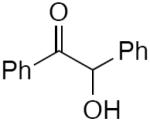
|

|
1 equiv Cu(acac)2 | Air, CH2Cl2, reflux, 4 h | 62 | 524 | |
| 16 |

|

|
3 equiv Cu(acac)2 | Air, CH2Cl2, reflux, 4 h | 60 | 524 | |
| 17 |

|

|
1 equiv Cu(acac)2 | Air, CH2Cl2, reflux, 4 h | 62 | 524 | |
| 18 |

|

|
1 equiv Cu(acac)2 | Air, CH2Cl2, reflux, 4 h | 58% | 524 | |
|
| |||||||
| Oxidative cleavage of benzils | |||||||
|
| |||||||
| 19 |
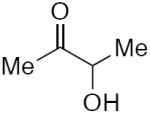
|

|
4 equiv CuCl | Pyridine | air, 30 °C, 4 h | 86 | 526 |
| 20 |
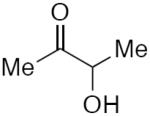
|

|
1 equiv CuCl | Pyridine | O2, 20 °C, 1.5 h | 92 | 525 |
| 21 |
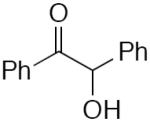
|

|
1 equiv CuCl | Pyridine | O2, 20 °C, 2 h | 96 | 525 |
| 22 |

|
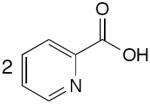
|
1 equiv CuCl | Pyridine | O2, 20 °C, 1.5 h | 88 | 525 |
| 23 |

|

|
1 equiv CuCl | Pyridine | O2, 20 °C, 2.5 h | 92 | 525 |
| 24 |

|

|
1 equiv CuCl | Pyridine | O2, 20 °C, 2 h | 90 | 525 |
| 25 |

|

|
1 equiv CuCl | Pyridine | O2, 20 °C, 2 h | 85 | 525 |
|
| |||||||
| Oxidation of steroids | |||||||
|
| |||||||
| 26 |

|

|
3 mol% Cu(OAc)2 | Air, MeOH, H2O, AcOH, 55 °C, 14 h | Not given | 528 | |
| 27 |
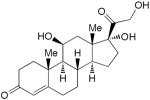
|

|
3 mol% Cu(OAc)2 | Air, MeOH, H2O, AcOH, 55 °C, 14 h | Not given | 528 | |
| 28 |
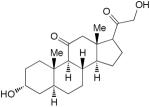
|

|
12.5 mol% Cu(OAc)2 | Air, MeOH, rt, 15 min | 94 | 538 | |
| 29 |

|

|
28 mol% Cu(OAc)2 | Air, MeOH, rt, 1 h | 60 | 529 | |
| 30 |

|

|
50 mol% Cu(OAc)2 | Air, MeOH, rt, 1 h | 95 | 530 | |
| 31 |

|

|
45 mol% Cu(OAc)2 | Air, MeOH, rt, 40 min | 90 | 531 | |
| 32 |

|

|
Cu(OAc)2 | O2, MeOH | 90 | 532 | |
| 33 |

|

|
8 mol% Cu(OAc)2 | Air, MeOH, 1.5 h | 80 | 533 | |
|
| |||||||
| Oxidation of steroids with hydride transfer | |||||||
|
| |||||||
| 34 |

|

|
50 mol% Cu(OAc)2 | Air, MeOH, 1 h | Not given | 534 | |
| 35 |

|

|
Cu(OAc)2 | O2, MeOH | Not given | 535 | |
The mechanism of the oxidation is analogous to that of other alcohols (Scheme 245). The α-hydroxyketone binds to the copper as the enol tautomer to give complex I. Molecular oxygen binds to the copper with concurrent oxidation from Cu(I) to Cu(II).536 Homolysis of the peroxide bridge of II leads to abstraction of the enolic proton to give the radical in III, which donates an electron to copper to give the product.
Scheme 245.
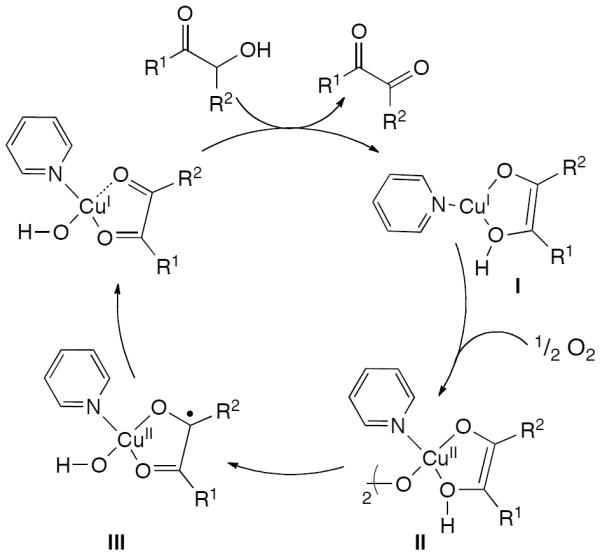
Mechanism of the copper-catalyzed aerobic oxidation of benzoins and hydroxymethylketones.
Lewbart and Mattox reported the serendipitous discovery of copper-catalyzed aerobic steroid oxidations in 1959 after linking the decomposition of cortisone samples to trace copper in the water used in washing their glassware.537 A follow-up study showed that yield of the glyoxyl products increased when air was passed over the reaction and decreased when water was added (Table 14, entries 23–33).538 Treatment of the resulting glyoxyl products with NaOH in methanol gives products arising from intramolecular hydride transfer similar to the Cannizzaro reaction (Scheme 246).539 This two-step process can also effected in one step by means of higher copper catalyst loadings (Table 14, entries 34–35).
Scheme 246.
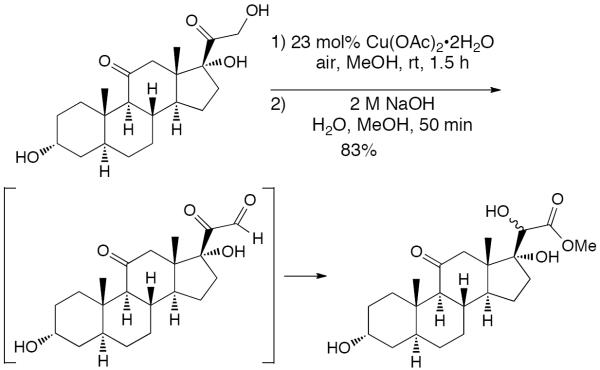
Oxidation of a steroid followed by intramolecular hydride transfer reaction.
Corey and Stoltz used this transformation in their synthesis of annulated derivatives of ouabain for the treatment of heart failure (Scheme 247). Oxidation of the hydroxy ketone gave the α-ketoaldehyde, which was treated with tosyl hydrazine and DBU to give a diazo compound. Rhodiumcatalyzed insertion into the methyl group afforded the desired annulated product.
Scheme 247.
Oxidation of a hydroxy ketone in the synthesis of ouabain derivatives.
Kinoshita found that when α-methylbenzoin is subjected to oxidative conditions an oxidative cleavage occurs to yield a 1:1 ratio of acetophenone and benzoic acid (Scheme 248).526 The reaction is thought to occur via the oxidation of the ketone hydrate (Scheme 249). Oxidation of the copper by oxygen leads to the copper(II) species which is in equilibrium with the diradical species. Homolytic C–C bond cleavage yields the two products. This reaction is analogous to the oxidative cleavage of 1,2-diketones (Section V.D).
Scheme 248.

Oxidative cleavage of α-methylbenzoin with CuCl and molecular oxygen.
Scheme 249.
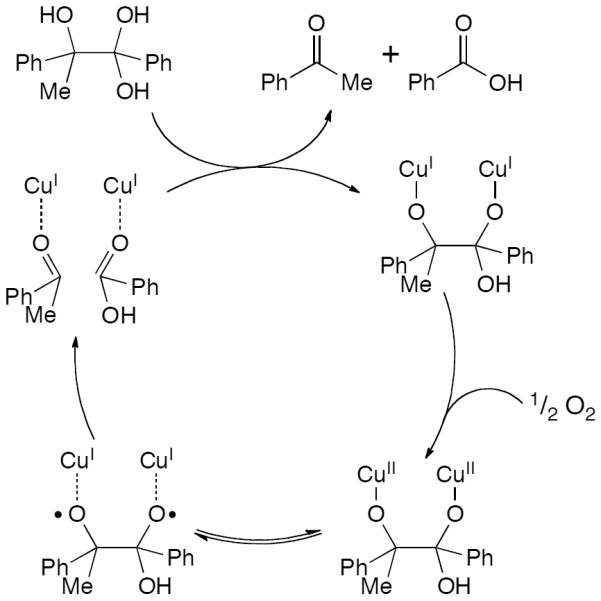
Proposed mechanism for the oxidative cleavage of tertiary benzoins.
A similar oxidative cleavage reaction occurs upon the subjection of lignin model compounds to oxidation conditions with 20 mol% CuCl and 30 mol% TEMPO at high temperature (Scheme 250).540 An aldehyde and a methyl ester are obtained in good yield in this simple system, but the oxidative degradation of a full lignin molecule using copper was not successful. Benzoin methyl ether, which would result from oxidation of the alcohol, was not detected at any point, suggesting that a mechanism similar that that in Scheme 249.
Scheme 250.

Copper-catalyzed aerobic oxidative cleavage of a lignin model substrate.
IV.C. Oxidative C-C Coupling of Alcohols
Using a binuclear copper complex, Chadhuri demonstrated the oxidation of ethanol to acetaldehyde and the oxidation of benzyl alcohol to benzaldehyde.508 However, in the case of isopropanol and diphenylmethanol, homodimer products were formed (Scheme 251). To account for this observation, a mechanism was proposed in which the oxidation state of the copper complex does not change; rather, the oxidation is performed by the ligand, and molecular oxygen serves to regenerate two phenolic radicals (Scheme 252). The formation of the dimeric product is likely due to the relative persistence of the secondary radicals obtained from isopropanol and diphenylmethanol.
Scheme 251.
Oxidation and homodimerization of alcohols with a bimetallic catalyst.
Scheme 252.
Proposed mechanism for the binuclear catalyst account for oxidation to alcohol (solid lines) and homodimer (dashed lines).
IV.D. Tandem Reactions with Alcohol Oxidation
Aldehydes very important functional groups in organic synthesis and feature prominently in many multicomponent coupling reactions.541 The facile copper-catalyzed aerobic oxidation of alcohols, which produces only water as a byproduct, is a useful tool for the generation of aldehydes in situ so that they can be used immediately in a tandem fashion. For example, the Passerini three-component coupling reaction uses an aldehyde, an isonitrile, and a carboxylic acid to generate a complex carboxamide in just one step. The addition of CuCl2 and TEMPO with NaNO2 allows for the use of an alcohol in place of the aldehyde (Scheme 253).542 The nitrite salt was necessary for catalyst turnover; a mechanism accounting for this observation is presented in Scheme 254. Notably, the water byproduct of the alcohol oxidation reaction does not adversely the subsequent reaction.
Scheme 253.
Tandem alcohol oxidation and Passerini three component coupling.
Scheme 254.
Copper(II), TEMPO, and NaNO2 co-catalyzed oxidation of aldehydes leading to a multicomponent coupling.
Tandem reactions are extremely powerful and efficient reactions, generating significant complexity in one flask without the need for purification between steps. These reactions can be made even more efficient when the same catalyst can be employed in multiple steps. The copper-catalyzed alcohol oxidation has also been used in a tandem alcohol oxidation-olefination sequence (Scheme 255),543 using the oxidation conditions developed by Markó and co-workers. Here, the copper serves not only to oxidize the alcohol starting material, but also to activate the diazo compound in the olefination step. The two-step sequence can provide a large range of olefins starting from primary and secondary alcohols with excellent functional group compatibility. Notably, chiral substrates undergo no racemization under the reaction conditions.
Scheme 255.
One-pot aerobic oxidation and methylenation of alcohols.
Tandem reactions taking advantage of the utility of copper as both an oxidant and as a Lewis acid have been reported. Treatment of an alkynylpyranone with water in the presence of copper(I) and oxygen leads to the formation of substituted furocoumarins in moderate yields (Scheme 256).544 A possible mechanism for this reaction is outlined in Scheme 257. The vinylogous ester is activated for nucleophilic attack by coordination of copper(I). Addition of the oxycuprate across the alkyne generates a furan and a proton displaces the copper. It is highly likely that the final oxidation of the hemiacetal is facilitated by trace copper(II) that will form in air.
Scheme 256.
Copper-catalyzed tandem reaction to generate substituted furocoumarins.
Scheme 257.

Mechanism for the copper-catalyzed tandem cyclization-hemiacetal oxidation reaction.
A similar tandem cyclization-oxidation sequence was used in the synthesis of highly substituted furans from β-alkynyl-α,β-unsaturated aldehydes. The reaction is performed open to air using a copper(I) catalyst, generating the desired products in moderate yields (Scheme 258).545 Here, the copper serves to activate the alkyne for nucleophilic attack by the aldehyde (Scheme 259). Displacement of the copper followed by hydration generates a secondary benzylic alcohol, which is then oxidized to the ketone. While the authors do not suggest that a copper(II) complex participates in the oxidation reaction, it reasonable to suspect that a copper-catalyzed oxidation takes place.
Scheme 258.
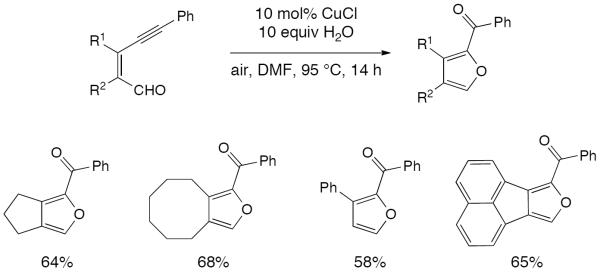
Tandem cyclization-oxidation reaction for the generation of highly substituted furans.
Scheme 259.
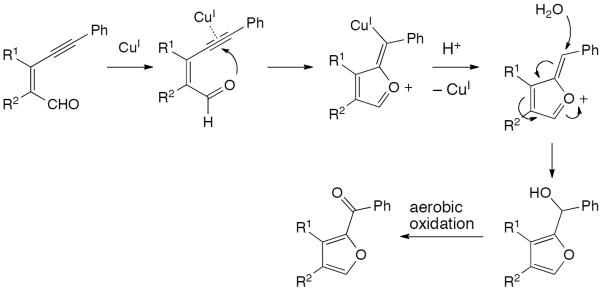
Proposed mechanism for the tandem cyclization-oxidation reaction leading to substituted furans.
With dihydronaphthalene scaffolds, an unexpected naphthofuran product is obtained, with only a minor amount of the expected 2-acetofuran (Scheme 260). The authors propose an oxidative cleavage reaction in which a molecule of oxygen is captured by a pyran ring (Scheme 261, path A). However, and an alternative pathway in which a copper complex activates the molecular oxygen is proposed in path B. This mechanism is analogous to that seen in the oxidative cleavage reactions seen in Section V.C.2.
Scheme 260.

Formation of an unexpected naphthofuran product from CuCl under air.
Scheme 261.
Two possible reaction paths in the tandem cyclization-oxidative cleavage formation of naphthofurans.
The “hydrogen-borrowing” oxidation-reduction sequence of converting alcohols into secondary amines via the aldehyde and a M–H species (Scheme 262, right) does not require the addition of a secondary oxidant like molecular oxygen when the metal is Ru or Ir. However, Deng and coworkers have determined that the copper-catalyzed N-alkylation of sulfonamides is improved by the use of an air atmosphere (Scheme 262, left). Presumably, oxygen facilitates the oxidation of benzyl alcohol, determined to be the rate-determining step.546 On the other hand, too much oxygen (up to 70% with respect to sulfonamide) shuts down the reaction by degrading the copper-hydride and thereby inhibiting the transfer hydrogenation. The reaction shows very little substituent dependence on the benzyl alcohol, though alkyl alcohols require different copper sources (Scheme 263). The reversible nature of the hydrogen-borrowing reaction requires an excess of the benzyl alcohol. A similar reaction using aluminum hydrotalcite-supported catalyst has been reported.547 An alternate mechanism that does not require a copper-hydride, which is not stable in the presence of molecular oxygen,548 is described for the next transformation below.
Scheme 262.
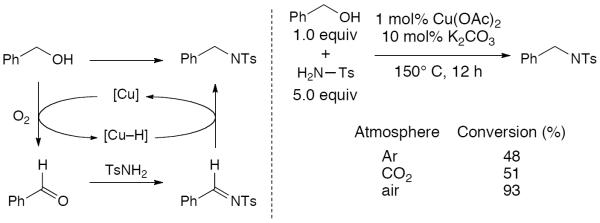
“Hydrogen-borrowing” N-alkylation of sulfamides and its dependency on atmosphere.
Scheme 263.
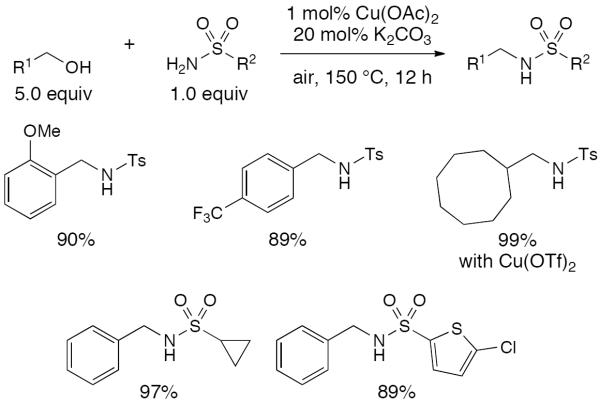
Selected substrate scope in the copper and oxygen co-catalyzed amination of benzyl alcohols.
Xu and coworkers proposed a different reaction mechanism for a similar transformation.549 This mechanism avoids the formation of the very reactive CuH intermediate, an intermediate that would be more reasonable for other hydrogen-borrowing N-alkylations catalyzed by ruthenium and iridium. Instead, the authors suggest that the copper serves as an oxidation catalyst for the rate-limiting step, the generation of benzaldehyde from benzyl alcohol (Scheme 264). Otherwise, the copper catalyst serves as a Lewis acid catalyst, first aiding in the condensation of the sulfonamide with the aldehyde, and then aiding in the hydride transfer in a Meerwein-Ponndorf-Verley reduction of the tosyl imine.
Scheme 264.
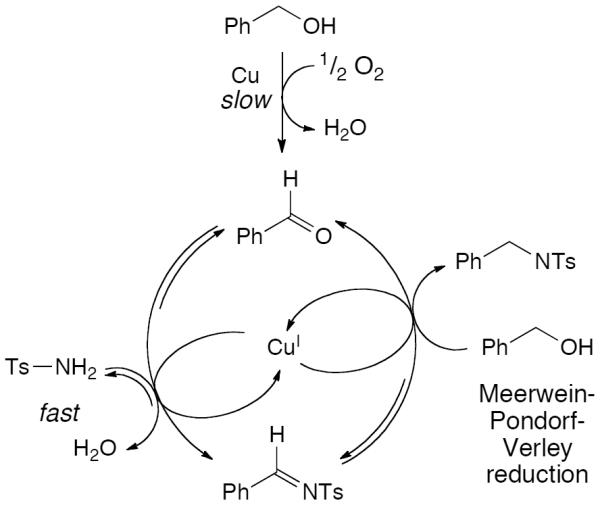
New mechanism proposed for the oxidative N-alkylation of sulfonamides.
The nitroso functional group is useful in organic synthesis due to its tendency to react in sigmatropic rearrangements. However, nitroso compounds are unstable and must be made in situ via oxidation of a hydroxamide. In the case of the ene reaction, the byproducts of this oxidation lead to decomposition of products. The copper-catalyzed oxidation of hydroxamides using molecular oxygen as the terminal oxidant is ideal because the only byproduct is water; trace peroxides formed in the reaction can be inhibited using BHT. The intramolecular (Scheme 265) and intermolecular (Scheme 266) tandem oxidation-ene reaction affords carbamates and allylic hydroxamides, respectively, in good to excellent yields.550
Scheme 265.
Mechanism and scope of the intramolecular ene reaction.
Scheme 266.
Copper-catalyzed hydroxamide oxidation and intermolecular ene reaction.
The carboxybenzyl acylnitroso can also be trapped in with a Diels-Alder reaction (Scheme 267).551 In fact, the major byproduct of the Diels-Alder trapping reaction is the ene product, formed when less hindered dienes are used. The ene byproduct can be minimized by altering the solvent, often at the expense of reaction time.
Scheme 267.
Oxidation of hydroxamides to nitrosos and in situ Diels-Alder trapping.
IV.E. Oxidation of Alcohols with Rearrangement
Under oxidative conditions, tertiary alcohols are either unreactive, undergo rearrangement or undergo oxidative cleavage. A method for the oxidative rearrangement of allylic tertiary alcohols to β-substituted enones has been reported using a TEMPO/CuCl2/O2 system in the presence of molecular sieves (Scheme 268).552
Scheme 268.
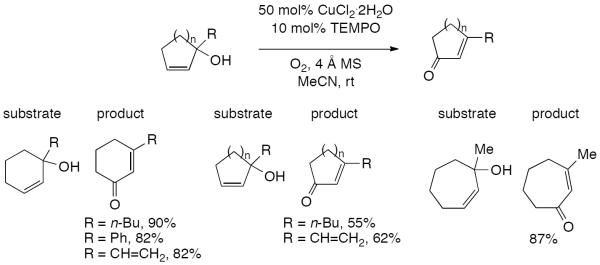
Oxidative rearrangement of tertiary alcohols.
V. Reactions of Carbonyls and Carbonyl Equivalents
V.A. Aldehydes to Acids
Many reagents and catalysts have been developed for the oxidation of aldehydes to carboxylic acids, but few methods use mild reaction conditions with green oxidants such as molecular oxygen. CuO has been found to be effective in the catalytic oxidation reaction (Scheme 269), and the reactions can be performed in water, though a small amount of cosolvent is needed for some substrates. The CuO catalyst is easily collected and regenerated for further use.553
Scheme 269.
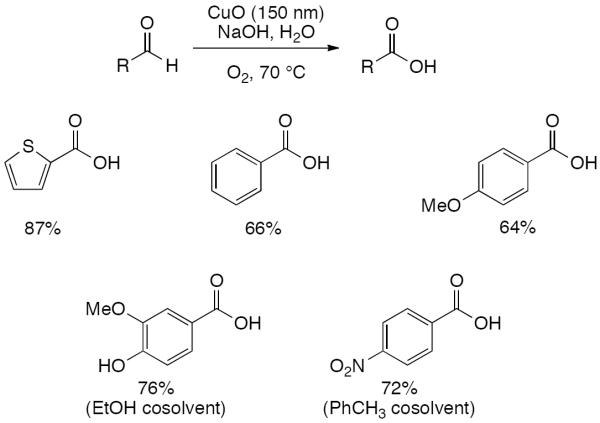
Copper catalyzed oxidation of aldehydes to carboxylic acids.
A possible mechanism for this reaction is outlined in Scheme 270. Copper-catalyzed oxidation of one equivalent of aldehyde generates a peracid,554 which reacts with another aldehyde equivalent to form two molecules of carboxylic acid. This method of peracid generation utilizing an aldehyde as a transfer oxidant is used in many alkane and alkene oxidation reactions (c.f., Section II.B and Section II.C). In spite of the great potential of such a transformation, little further work has been done with the bulk of efforts focuses on peroxide as the oxidant.555
Scheme 270.
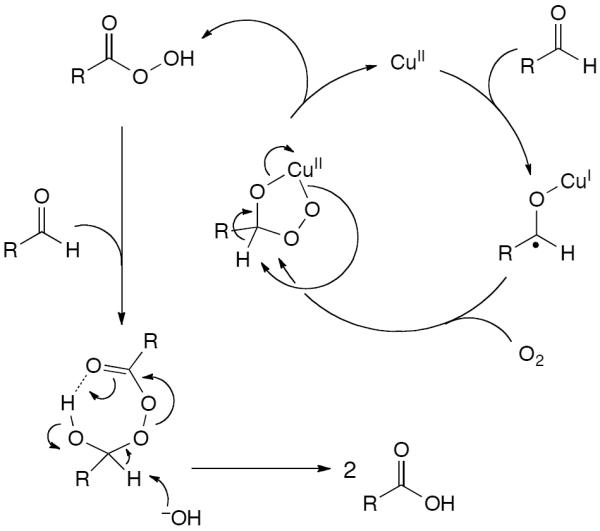
Putative mechanism of aldehyde oxidation with copper and oxygen.
Fachinetti and coworkers found that a highly reactive Cu/CuO catalytic couple results from the thermal decomposition of Cu(NO3)2 followed by exposure to alkaline formaldehyde in the presence of molecular oxygen.556 The highly exothermic oxidation process produces formate anion and fuel cell grade hydrogen (Scheme 271). This new chemical loop represents one step toward the selective oxidative reforming methanol to give clean hydrogen.
Scheme 271.

Generation of fuel cell grade hydrogen and formic acid from formaldehyde.
V.B. Aldehydes to Nitriles
Aldehydes condensed with ammonia to generate aldimines can be oxidized using copper and oxygen to form nitriles in a one-pot oxidative amination reaction (Scheme 272).557 Notably, this transformation utilizes ammonia, normally a reductant, in conjunction with oxygen. The reaction can also be conducted using alcoholic starting materials, which are subsequently oxidized by the catalyst to the aldehyde, at the expense of overall yield. Preformation of the aldimine is viable, but does not improve the overall yield.
Scheme 272.
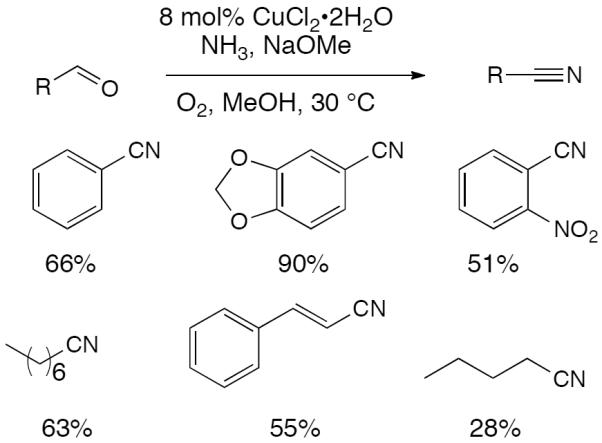
Oxidative synthesis of nitriles from aldehydes using copper and oxygen.
Mechanism studies show that the rate-determining step of this reaction is the deprotonation of the aldimine to generate the iminylcuprate complex, with the copper catalyst serving as both a Lewis acid and as an oxidant. (Scheme 273). Formation of the nitrile can result from oxidation by the copper or by a disproportionation reaction (not illustrated), which also yields an equivalent of starting material.558
Scheme 273.

Mechanism of the copper and oxygen catalyzed oxidation of aldimines to nitriles.
Maumy and coworkers have improved the yields and expanded the substrate scope to include a host of arenes and heterocycles (Scheme 274).559 CuCl2 and ammonia are generated in situ from the metal corrosion of metallic copper by ammonium chloride in the presence of oxygen. Though the copper catalyzes the reaction, a full equivalent is needed to generate the necessary ammonia. The reaction works well with aryl aldehydes but aliphatic aldehydes give lower yields due to competing enolization under the basic conditions, and halogenated arenes tend to exchange with the chloride ligands on the copper.
Scheme 274.
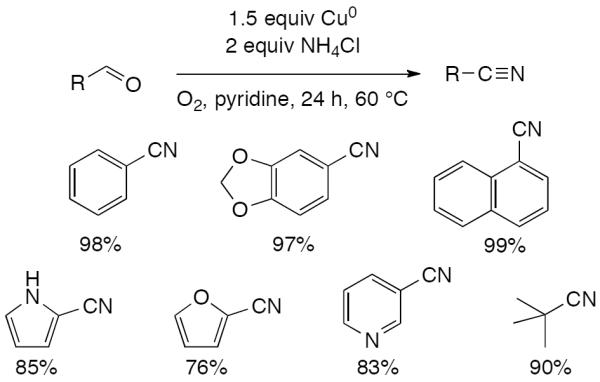
Oxidative amination of aldehydes using copper and oxygen.
V.C. Oxidation of Ketones
Ketones readily undergo oxidation with copper catalysts utilizing molecular oxygen as the oxidant. The predominant reaction mode is oxidation of the enol or enolate form of the ketone resulting oxidative coupling (C–C bond formation) or oxidative cleavage. A much rarer reaction mode is Baeyer-Villiger oxidation to form the corresponding ester.
V.C.1. Oxidative Coupling via Enolates
The coupling of enolates by means of oxidants, including stoichiometric copper reagents, is well documented.560 On the other hand, the corresponding catalytic transformation is much more difficult. With organozinc reagents, formed by a Reformatsky reaction from the corresponding α-haloketones, oxidatively homocoupling could be induced using a catalytic system of copper, oxygen, and a dinitroarene co-oxidant (Scheme 275).316 The high diastereoselectivity observed is due to equilibration, as the product ratios are similar to calculated thermodynamic ratios.
Scheme 275.
Copper catalyzed reaction of zinc enolates with oxygen.
In the proposed mechanism for this transformation, organocuprate formation to generate an anionic CuI species occurs from the zinc intermediate (Scheme 276). Oxidation by the dinitroarene co-catalyst generates a CuII species, two equivalents of which come together to eject one molecule of coupled product. Transmetallation with another organozinc complex regenerates the organocuprate. The role of molecular oxygen is to quench the radical anion dinitroarene, forming peroxide radical anion as a byproduct.
Scheme 276.
Mechanism for the oxidative coupling of α-haloketones.
More acidic malonate substrates can undergo direct oxidative enolate coupling using a system very similar to that used in Glaser-Hay couplings (see Section II.D.2 above). For example, treatment of diphenylnitrile with 1 mol% CuBr in concentrated ammonia gives the dimeric tetraphenylsuccinonitrile in quantitative yield.561 More recently, a copper TMEDA catalyst with molecular oxygen has been shown to be highly efficient in the oxidative dimerization of α-cyanoesters (Scheme 277).562 The reaction is proposed to proceed through deprotonation followed by the transfer of an electron to the copper catalyst to generate the resonance-stabilized radical that subsequently dimerizes. The para-substitution of the substrate is required, as unsubstituted compounds tend to polymerize due contribution of the para radical to the resonance form. The uniform 3:2 meso:chiral product ratio likely reflects the thermodynamic ratio, as heat effects homolytic cleavage of the formed carbon-carbon bond.
Scheme 277.
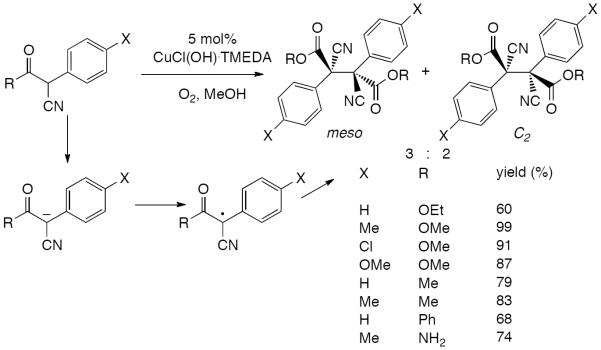
Oxidative enolate coupling of α-cyanoesters.
The addition of a chiral auxiliary to the malonate allows for the diastereoselective dimerization of α-cyanoesters (Scheme 278).563 However, the meso compound still dominates and the diastereoselection imparted by the auxiliary on the chiral product is modest. Also, the corresponding malonates undergo decarboxylation in the presence of the copper catalyst.
Scheme 278.

Diastereoselective oxidative enolate coupling of α-cyanoesters.
The copper-catalyzed aerobic coupling of 1,3-diketones with activated alkynes can provide simple access to functionalized 3-carbonyl furans (Scheme 279).564 Good yields are observed with aryl and alkyl 1,3-diones and β-ketoesters, but the alkyne must be activated by electron donating groups; diphenylacetylene gave only trace product.
Scheme 279.
Oxidative coupling of alkynoates and 1,3-diketones using copper and molecular oxygen.
A proposed mechanism for this transformation is shown in Scheme 280, but no mechanistic experiments were undertaken. Michael addition of the enol into the activated alkyne generates an intermediate that undergoes one-electron oxidative cyclization to generate a hydrofuran radical. A second one-electron oxidation then furnishes the furan product.
Scheme 280.
Postulated mechanism for the oxidative aerobic coupling of alkynes and β-diketones.
A carbonyl with an electron-donating α-group can participate in captodative stabilization of a radical. The oxidative cyclization of urea-hydrazone followed by hydrolysis offers access to 2-ketohydrazones in excellent yields (Scheme 281).565 The reaction proceeds through a disproportionation mechanism in which the starting material (I, Scheme 282), Cu(I), and molecular oxygen combine to yield a radical species (II) as well as CuI2 and Cu(OH)2. The radical species undergoes cyclization to form III followed by attack of a Cu(II) complex to generate IV, a Cu(III) intermediate. Reductive elimination followed by elimination generates the observed dihydroimidazole product VI. When R2 = Ph, the dihydroimidazole is not isolated; rather, the compound is hydrolyzed upon aqueous workup to give the isolable 2-ketohydrazone.
Scheme 281.
Oxidative cyclization and subsequent hydrolysis in the synthesis of 2-ketohydrazones.
Scheme 282.
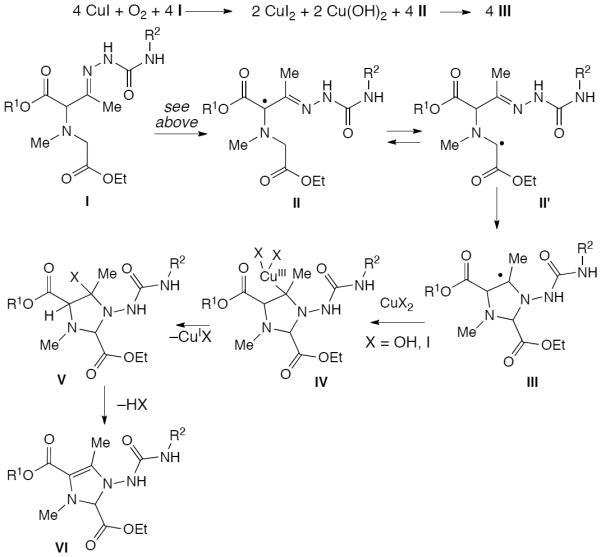
Proposed mechanism for the oxidative cyclization of urea-hydrazones.
V.C.2 Oxidative Cleavage via Enolates
Cycloalkanones have been shown to undergo regioselective oxidative cleavage in the presence of copper and molecular oxygen (Scheme 283).566 The oxidative cleavage occurs at the more substituted position, forming ketoacids in good yields and no loss of enantioselectivity in the case of enantiopure starting materials. A consequence of this trend is that starting materials without α-substitution give complex product mixtures.
Scheme 283.
Oxidative cleavage of cycloalkanones with copper and oxygen.
The reaction proceeds through the copper enolate, which accounts for the regioselection (Scheme 284). Oxidation of the enolate generates a radical that is attacked by molecular oxygen to generate a dioxetane. Homolytic ring opening of this dioxetane with concurrent C–C bond cleavage gives the ketone and the copper carboxylate; the latter is displaced by acetic acid to release the copper catalyst.
Scheme 284.
Mechanism for the oxidative cleavage of cycloalkanones by copper and oxygen.
A similar reaction occurs with cycloalkane-1,3-diones. Oxidative cleavage of the copper enolate results in the formation of α-diketoacids in good to excellent yields (Scheme 285).567 The lower-yielding reactions are caused by oxidative degradation of starting material or product. The reaction substrate must be symmetrical; if different enolate isomers can form the reaction will give a complex mixture of products.
Scheme 285.
Oxidative cleavage of cycloalkane-1,3-diones using copper and oxygen.
The reaction mechanism is similar as well (Scheme 286). Oxidation occurs from the copper enolate, followed by attack at the radical by oxygen and formation of the dioxetane. Homolytic cleavage of this ring results in the formation of a carbonyl and the copper carboxylate, which undergoes proton exchange to release the copper catalyst.
Scheme 286.
Mechanism of the catalytic oxidative cleavage of cycloalkane-1,3-diones.
Cyclic β-ketoesters undergo regioselective oxidative cleavage due to the stability of the ketone enol relative to that of the ester (Scheme 287). Higher catalyst loading is required due to the electron withdrawing nature of the ester group, corresponding to a higher oxidation potential to form the radical.
Scheme 287.

Catalytic oxidative cleavage of β-ketoesters using copper and molecular oxygen.
When combined with ammonia, the copper catalyzed aerobic oxidation of enolates can become a powerful tool for rapid synthesis of complex heterocycles. Treatment of a benzylic carbonyl with an excess of copper under air in the presence of NH4OH afforded a 2,3,5-substituted imidazole compound in good yield (Scheme 288).568
Scheme 288.

Tandem oxidation and oxidative cleavage of an α-aryl ketone to yield an imidazole.
A possible mechanism for this transformation is shown in Scheme 289. Oxidation of the enolate yields a 1,2-dioxetane intermediate that can fragment in two ways. Cleavage of the peroxide bond with concurrent hydrogen abstraction yields the 1,2-diketone (path a), while cleavage of the carbon-carbon bond yields an aldehyde and a copper(II) carboxylate (path b). Condensation of the aldehyde and the 1,2-diketone with ammonia followed by nucleophilic attack and cyclization yields the imidazole product. The copper is only necessary to generate the oxidative cleavage products; subjection of the aldehyde and 1,2-diketone to ammonia in the absence of copper and oxygen still affords the imidazole.
Scheme 289.
A possible mechanism for synthesis of imidazoles from ketone.
Sayre and coworkers also investigated the oxidative cleavage of benzylic carbonyls by treating deoxybenzil with a copper(II)-pyridine complex under an oxygen atmosphere (Scheme 290).569 The major product of the oxidation reaction was benzil (2), though oxidative cleavage products benzoic acid (3) and benzaldehyde (4) were also obtained. However, exposure of benzil to the same conditions did not lead to the formation of appreciable amounts of 3 or 4, suggesting that 2 is not an intermediate in the oxidative cleavage reaction. The yield of coupled product 5 is lessened by increasing the pressure of oxygen and probably results from anaerobic coupling of enolate radicals. The mechanism for formation of benzoin and benzaldehyde/benzoic is the same as that proposed in Scheme 289 except that the secondary amine condensation is absent.
Scheme 290.
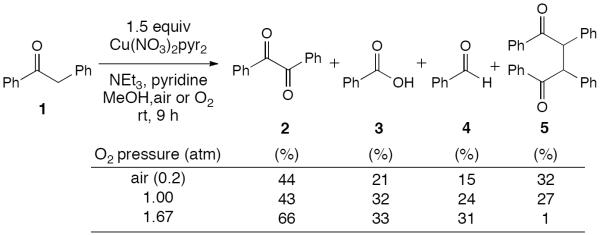
Oxidation and oxidative cleavage of deoxybenzil.
The oxidative cleavage of enolates using CuCl2 in oxygen and refluxing DMF has been utilized in the removal of the phenacyl ester protecting group to reveal carboxylic acids (Scheme 291).570 The reaction proceeds with evolution of carbon dioxide; benzoic acid and benzaldehyde byproducts are also produced.
Scheme 291.
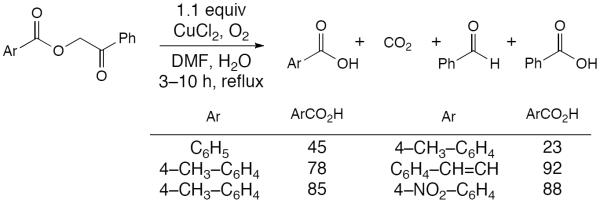
Oxidative deprotection of phenacyl esters using copper and molecular oxygen.
When phenacyl alcohol is subjected to the reaction conditions the same products are formed, suggesting that the copper(II) serves as a Lewis acid in the initial hydrolysis step. A full mechanism is shown in Scheme 292.
Scheme 292.
Mechanism for the oxidative deprotection of phenacyl esters.
A copper-catalyzed decarboxylation is employed in the oxidative cross-coupling of alkynes.231 The decarboxylation step precludes the use of an excess of one alkyne coupling partner through rapid formation of the desired alkynyl cuprate (see Section II.D.3).
Aliphatic aldehydes with an α-hydrogen can be treated with diazabicyclo[2.2.2]octane (DABCO), copper, and oxygen under mild conditions to effect oxidative decarbonylation to the ketone (Scheme 293).571 The reaction is first order in DABCO and zero order in oxygen and copper, indicating that the rate-determining step is likely enolization. The reaction does proceed in the absence of copper, though at a retarded rate; ketones are known to oxygenate under strong enolizing conditions. The mechanism of the degradation is shown in Scheme 294. After DABCO-mediated deprotonation of the aldehyde, copper(II) oxidizes the enolate to the radical which is trapped by oxygen. Abstraction of the aldehydic hydrogen gives a hydroperoxide species that is reduced by copper(I) to release carbon monoxide and the ketone.
Scheme 293.
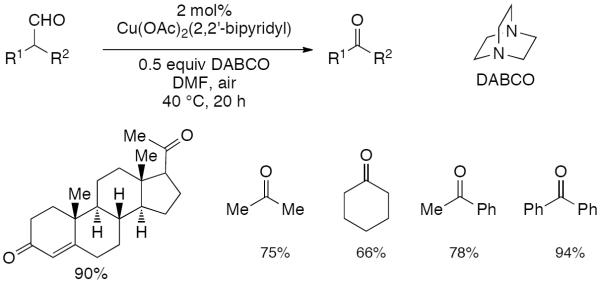
Oxidative decarbonylation of aldehydes to ketones.
Scheme 294.
Mechanism for the DABCO-mediated oxidative degradation of aldehydes.
Linear aliphatic aldehydes undergo stepwise oxidative cleavage to acetaldehyde and methyl formate in the presence of a methanolic copper-pyridine complex under molecular oxygen at 40 °C, (Scheme 295).572
Scheme 295.

Stepwise degradation of aliphatic aldehydes.
Oxidative degradation of the aldehyde with concurrent release of methyl formate continues until acetaldehyde is reached; this final product is not reactive under the oxidation conditions. The reaction is first order in substrate and half order in triethylamine. This result coupled with the lack of observable degradation intermediates suggests that initial deprotonation is the rate-limiting step.573 Ketones were much less reactive than aldehydes, and ketones without methylene groups, such as acetophenone, were unreactive. Notably, saturated aldehydes and ketones were unreactive in the absence of oxygen, in contrast to unsaturated aldehydes and ketones. This may be due to the higher oxidation potential of enolate ions compared to dienolate ions. A proposed mechanism based on these findings is outlined in Scheme 296. However, an alternate pathway for the later half of the cycle, proposed by Sayre,574 (path B) avoids formation of a high energy acyl anion (path A) in the fragmentation of the α-ketoaldehyde.
Scheme 296.
Mechanism of the oxidative degradation of linear aliphatic aldehydes.
V.C.3 Oxidation of Unsaturated Carbonyls
Enolizable unsaturated carbonyls display unique reactivity in the presence of copper and oxygen under basic conditions. Deprotonation at the γ-position in the rate determining step yields a conjugated enolate which is oxidized by copper to yield a conjugated radical;575 this radical can undergo further reactions depending on the substrate. For example, crotonaldehyde gives as oxidation product methoxysuccinaldehyde (Scheme 297, top), which is formed from methanol attack on the oxygenation product, butenedial (Scheme 298). Since the oxidation of 2-methoxybutryaldehyde is approximately nine times slower than the oxidation of crotonaldehyde, the Michael addition of methanol is thought to occur after oxidation.576
Scheme 297.
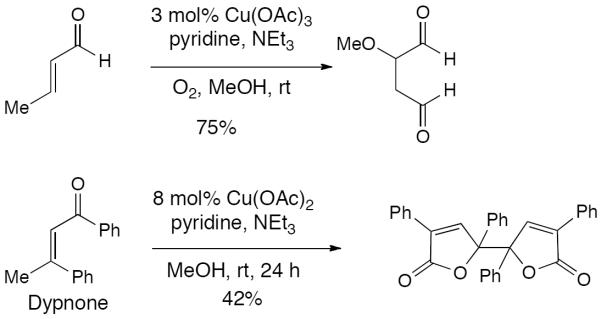
Copper-catalyzed oxygenation of crotonaldehyde and dypnone.
Scheme 298.
Mechanism of the oxygenation of crotonaldehyde with copper and molecular oxygen.
The oxygenation of dypnone (Scheme 297, bottom) is proposed to occur through a similar reaction, generating the initial aldehyde oxidation product as in crotonaldehyde. Here, however, methanol attacks the aldehyde, which closes on the ketone to form a cyclic hemiketal (Scheme 299).576 Isomerization yields the lactone, and oxidation of this lactone effects a dimerization to yield the bislactone product. The oxidation to the dimer is facile as it is much faster than the initial oxidation of dypnone to the aldehyde.
Scheme 299.

Formation of lactone dimer from the dypnone oxidation product.
Saito and co-workers increase the scope of this reaction (Scheme 300), finding that under photooxidative conditions the reaction required both oxygen and copper; exclusion of either oxidant yielded only cis-trans isomerization products.577
Scheme 300.
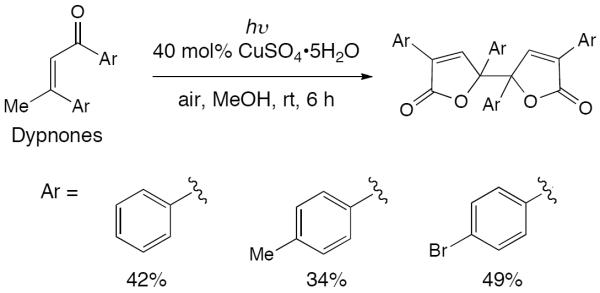
Photooxidation of dypnone in the presence of copper and molecular oxygen.
While a copper complex has been found to effect oxygenation of β-isophorone to oxophorpone under an oxygen atmosphere, the yield is low compared to other metals and only the hexadecachlorinated phthalocyanine-copper(II) complex exhibited any activity (Scheme 301).578 Again, the reaction proceeds through deprotonation of the α-position to form the dienolate anion, which results in oxygenation at the γ-position.
Scheme 301.
Oxygenation of β-isophorone by a copper(II)-phthalocyanine complex.
V.C.4 Baeyer-Villiger
The Baeyer-Villiger reaction, in which oxygen inserts into a ketone to form an ester, is a useful reaction in organic synthesis, complementing biosynthetic oxygenations. The Baeyer-Villiger reaction uses reaction conditions similar to those seen in epoxidation reactions, a fact that Bolm and coworkers capitalized on with their work on the copper-catalyzed variant using Cu(OAc)2 and molecular oxygen (Scheme 302).579 As seen in other Baeyer-Villiger reactions, the more substituted ketone carbon undergoes migration. An aldehyde additive is required, likely acting as a transfer oxidant, forming a peracid with oxygen.554 The reaction can proceed without copper in the presence of light, but copper is required if the reaction takes place in the dark. Hydrotalcite-580 and magnesium tinzanate581-supported copper catalysts have been shown to catalyze the Baeyer-Villiger transformation with moderate success.
Scheme 302.
Copper catalyzed Baeyer-Villiger reaction.
The mechanism of the copper-catalyzed Baeyer-Villiger is similar to what is seen in epoxidation reactions (cf., Section II.C.2). The copper and oxygen serve to transform the aldehyde into a peracid, which in turn effects the Baeyer-Villiger reaction, releasing an equivalent of carboxylic acid (Scheme 303).
Scheme 303.
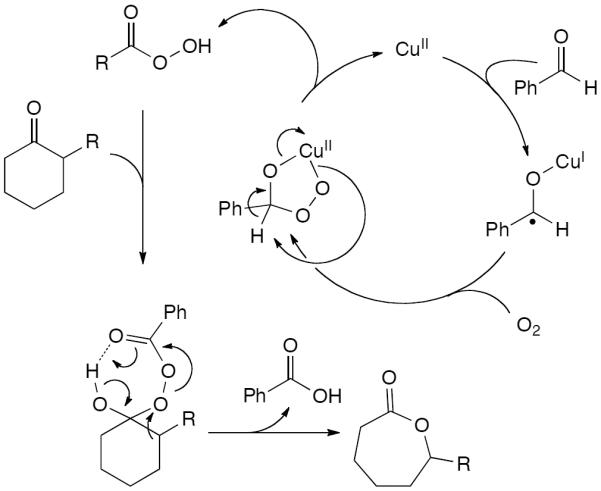
Mechanism of the aldehyde-mediated copper-catalyzed Baeyer-Villiger oxygenation.
A copper catalyst bound by chiral ligands can effect a kinetic resolution518 of racemic ketones through this mechanism (Scheme 304).582 Using 1 mol% of the copper catalyst and pivaldehyde as a transfer oxidant, 2-arylcyclohexanones afforded the corresponding lactones in up to 69% ee. An oxazoline catalyst has also been developed for this reaction, albeit with lower selectivity.583
Scheme 304.
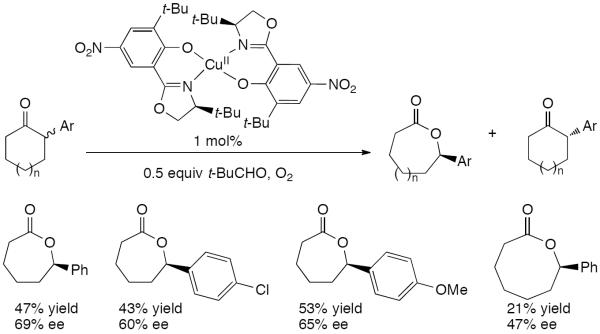
Copper catalyzed asymmetric kinetic resolution in the Baeyer-Villiger reaction.
Bolm and coworkers have also reported a parallel kinetic resolution518 with their copper catalyst via Baeyer-Villiger reaction, in which the two enantiomers a compound undergo different transformations (Scheme 305).584 Thus, the treatment of racemic cyclobutanones with 1 mol% of catalyst resulted in an enantiodivergent oxygenation reaction and two isomeric lactones in up to 95% ee were obtained. One enantiomer of the substrate interacts with the catalyst to generate the “normal” product, with migration of the most substituted carbon, whereas the other enantiomer generates the “abnormal” product, with migration of the least substituted carbon.
Scheme 305.
Parallel kinetic resolution in the copper catalyzed Baeyer-Villiger reaction.
The same catalyst has been used to effect desymmetrization of achiral cyclobutanones (Scheme 306).585 The complex meso substrate provided the product with the excellent enantiomeric excess of 91%, whereas the simple β-substituted cyclobutanone afforded poorer asymmetric induction (44% ee). This disparity suggests that the very hindered tricycle undergoes greater interaction with the catalyst, permitting better differentiation of the two prochiral substrate enantiomers.
Scheme 306.
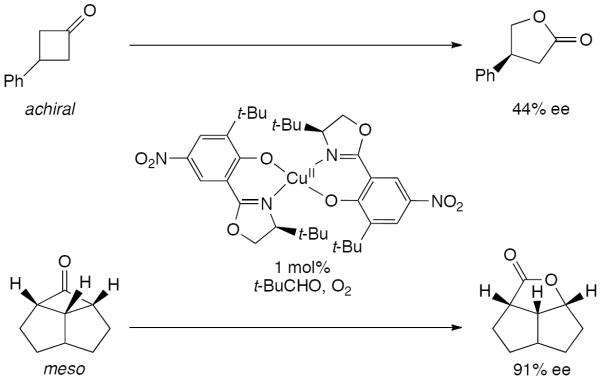
Enantioselective copper catalyzed Baeyer-Villiger reactions.
V.D. Oxidative Cleavage of 1,2-Diketones
Under oxidizing conditions in the presence of a copper catalyst, 1,2-diketones typically undergo oxidative cleavage to form two carboxylic acids (Scheme 307).526,586 The reaction is accelerated by addition of KOH, retarded by methanol, and does not require oxygen when a large excess (10 equivalents) of a copper(II) source is used.569 The oxidative cleavage is proposed to go through the ketone dihydrate (Scheme 308), which binds to two copper atoms. One-electron oxidation of the oxygens bound to the copper centers is then proposed followed by fragmentation to give the carboxylate product. More recently, Sayre has suggested the two-electron oxidation of a bridged binuclear species as a mechanism for the fragmentation step (Scheme 308, inset).569
Scheme 307.

Oxidative cleavage of benzil using a copper catalyst under oxygen.
Scheme 308.
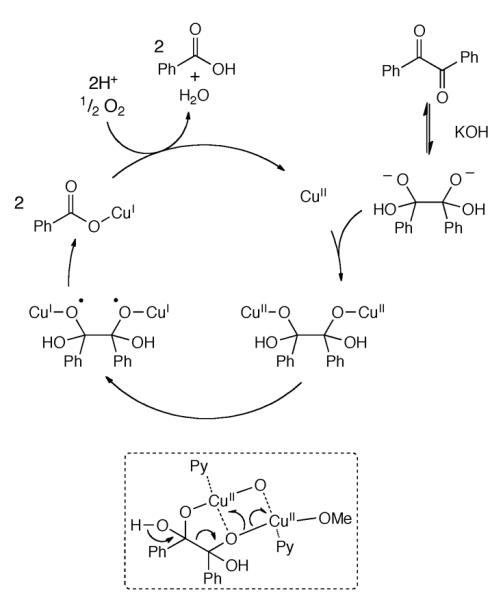
Mechanism of the copper-catalyzed oxidative cleavage of 1,2-diketones.
A different mechanism, analogous to the oxidative cleavage of catechols (see Section VII.E.2), has been proposed based on Raman scattering studies (Scheme 309).587 The copper complex first bridges the two carbonyls, and electron transfer occurs to form the ketyl radical, which has been observed using ESR spectroscopy.588 Attack of oxygen on this radical yields the bridged bicyclic adduct. This complex then fragments;589 the mechanism of this fragmentation has not been established experimentally but it may occur through attack on the carbonyl by hydroxide or by the formation of a 1,2-dioxetane followed by fragmentation to cleave the C–C bond.
Scheme 309.
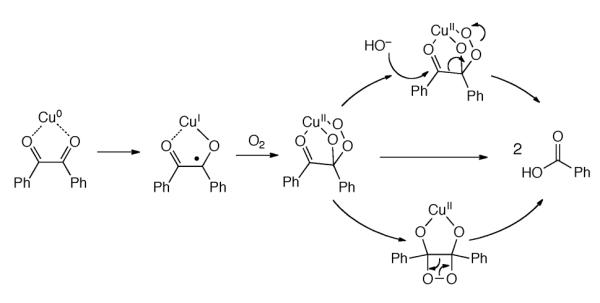
Mononuclear mechanism for the oxidative cleavage of 1,2-diketones.
When the 1,2-diketone has enolizable positions, the oxidative initially cleavage occurs across the enol double bond rather than between the two ketones (Scheme 310), similar to the oxidative cleavage of unsaturated carbonyls seen above in Section V.C.3. Here, however, an equivalent of carbon monoxide is also released, yielding a product with one less carbon atom.590 That the substrates in the last two entries give different products is notable, as an equilibrium should exist between these two starting materials.
Scheme 310.

Oxidative cleavage of enolizable 1,2-diketones.
The mechanism proposed for this transformation is similar to that proposed for the oxidative cleavage of other unsubstituted carbonyls. Oxidation of the copper enolate generates a radical that is attacked by molecular oxygen to form a peroxo radical (Scheme 311). The peroxo radical closes on the carbonyl to form a bridged bicycle system, which fragments to release the open-chain product and an equivalent of carbon monoxide.
Scheme 311.
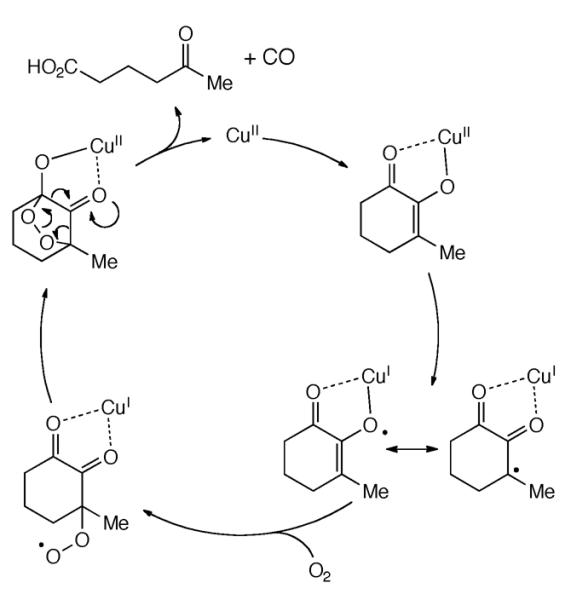
Proposed mechanism for the oxidative cleavage and decarbonylation of 1,2-diketones.
Notably, the generation of an enamine analog in situ by use of morpholine allows control of the oxidative cleavage such that a carbon is not excised (see Section VI.A.3, Scheme 354). However, oxidative cleavage with carbon excision does proceed in the absence of the morpholine (Scheme 312). The last degradation step was accomplished utilizing catalytic amounts of DABCO base and a Cu(OAc)2-2,2'-bipyridyl complex, and afforded the desired ketone in 95% (Scheme 312).632
Scheme 354.
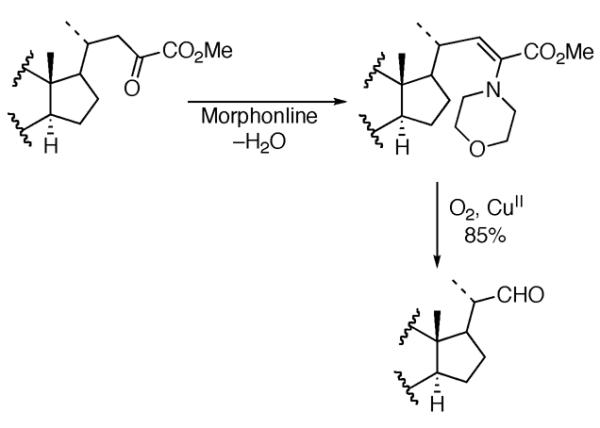
Oxidative cleavage of an α-ketoester derivative.
Scheme 312.

Oxidative degradation of a ketoester.
Flavonols are 1,2-diketones of particular commercial interest, as they are found in a wide variety of plants and are key components in a number of herbal remedies.591 The enzyme flavonol-2,4-dioxygenase (quercetinase), which contains a copper(II) atom at the active site, has been shown to catalyze the oxidative cleavage of the diketone in the presence of molecular oxygen, with release of an equivalent of carbon monoxide.592
The isolation and characterization of this enzyme has fueled interest in the elucidation of the oxygenation mechanism and the investigation of substrate scope, leading to the development of a number of biomimetic copper complexes. The first non-enzymatic oxidative cleavage of flavonols was reported by Takeda and coworkers (Scheme 313).593 The electron-rich quercetin is much more reactive than 3-hydroxyflavone, which required higher temperature and increased reaction time. The addition of a nitrogen-containing ligand allows for a much lower catalyst loading, though high reaction temperatures are still needed (Scheme 314).594
Scheme 313.
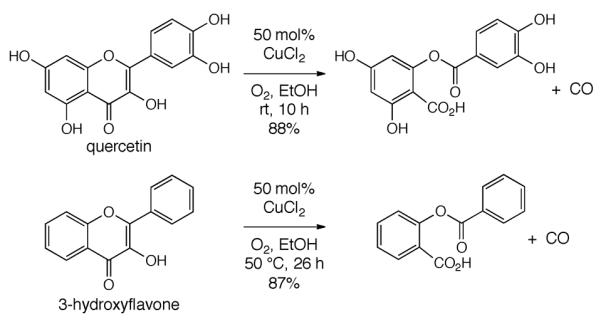
Biomimetic oxidative cleavage of flavonols using a copper complex and molecular oxygen.
Scheme 314.
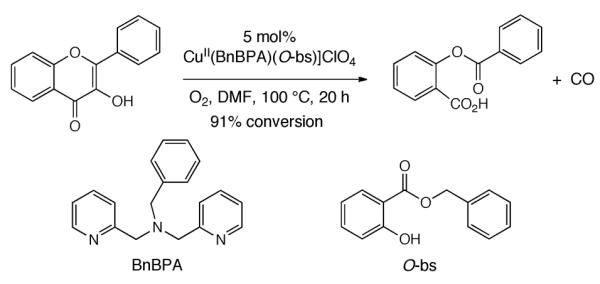
Biomimetic oxidative cleavage of 3-hydroxyflavone with lower catalyst loadings.
A stable complex is formed when 3-hydroxyflavone is treated with copper(II).595 Exposure of this complex to oxygen then effects the transformation and release of carbon monoxide.596 The exact mechanism of this step is not well understood; the reaction is proposed to go through the bridged bicyclic species seen in Scheme 311 or through a 1,2-dioxetane intermediate (cf., Scheme 309). The absence of chemiluminescence during the reaction, a common occurrence during decomposition of 1,2-dioxetanes, suggests the former is more reasonable.597
When copper(I) chloride is used as a catalyst in the presence of oxygen, only the initial flavonol-copper complex is obtained. On the other hand, an excess of copper(II) chloride in the presence of oxygen yields a furanone as the major product (Scheme 315). This material is formed by oxidation of the enol to the carbocation, which is quenched by water. The opening and subsequent closing of the hemiketal yields the observed cyclized product (Scheme 316).598
Scheme 315.

Oxidative ring contraction of 3-hydroxyflavonol with an excess of CuCl2.
Scheme 316.
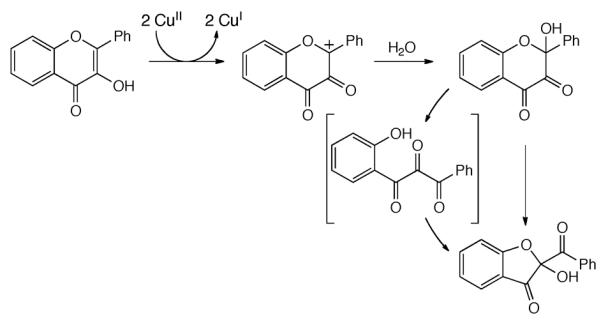
Mechanism of the oxidative ring contraction of 3-hydroxyflavonol.
When treated with copper and oxygen in the presence of ammonia, α-ketoamides undergo condensation followed by oxidative cleavage to generate nitriles and amides (Scheme 317). The latter undergo decarboxylation to reveal the free amine (Scheme 318).568 Interestingly, ammonia has been used to reduce copper(II) to copper metal,599 but is used in this oxidation reaction without complication.
Scheme 317.

Oxidative amination of an α-ketoamide by copper and oxygen.
Scheme 318.
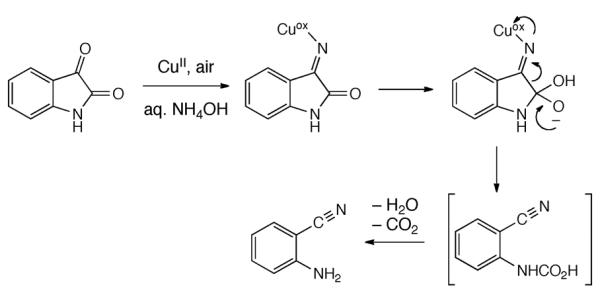
Proposed mechanism for the oxidative amination of an α-ketoamide.
V.E. α-Hydroxylation of Carboxylic Acids
The enzyme peptidylglycine-α-amidating monooxygenase (PAM) has been shown to catalyze the hydroxylation of the α-position of specific glycine residues.600 The enzyme has two subunits; in the first, peptidylglycine α-hydroxylating monooxygenase (PHM), the α-position is hydroxylated by copper and molecular oxygen. In the second subunit, petidylhydroxyglycine α-amidating lysase (PAL), the nitrogen-carbon bond is cleaved.601 Inspired by the oxidative properties of the enzyme, Capedeville and co-workers developed a model for a copper mediated α-hydroxylation of N-salicyloylglycine (Scheme 319).602 Utilizing three different copper sources and oxidants, N-salicyloylglycine was selectively hydroxylated at the alpha position in moderate to excellent conversion. The major product was the α-hydroxylated product, and oxygen was the most effective oxidant. Formation of the cleavage product 3 increased with longer reaction time.
Scheme 319.

α-Hydroxylation of N-salicyloyl-glycine.
A mechanism involving a transient copper(III) intermediate was proposed for this transformation (Scheme 320). Benzoyl glycine was unreactive under these conditions, suggesting that an arene hydroxyl group is necessary to direct the α-hydroxylation.
Scheme 320.
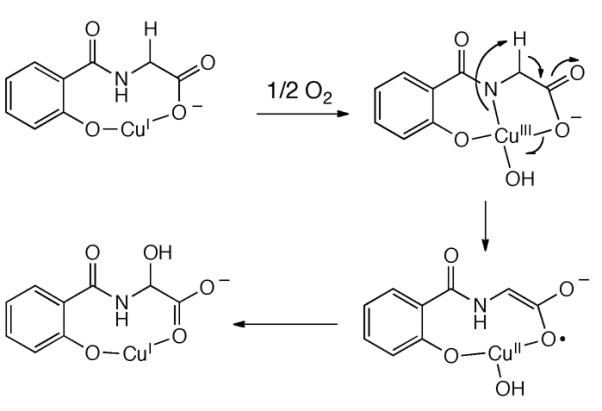
Proposed mechanism for α-hydroxylation of N-salicyloylglycine.
V.F. Reactions of Imines
Aminophenols condensed with aldehydes to generate Schiff bases undergo oxidative cyclization in the presence of copper and oxygen to generate 2-substituted benzoxazoles in good yields (Scheme 321).603 The reaction is tolerant of both electron-withdrawing and electron-donating aryl groups as well as heterocycles.
Scheme 321.
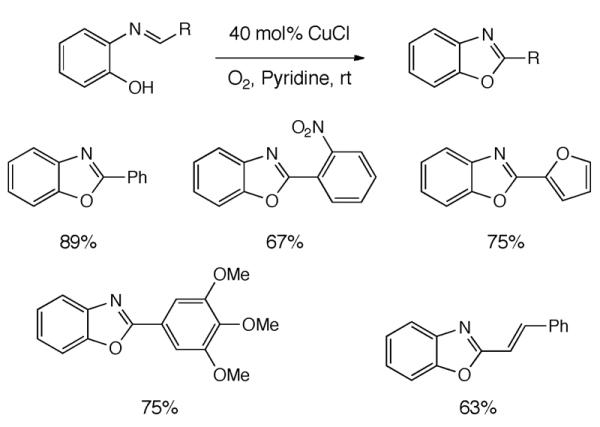
Oxidative cyclization of iminophenols with copper and molecular oxygen.
The mechanism of this oxidation has been the focus of much study.79e The rate-limiting step is the oxidation of Cu(I) to Cu(II) by oxygen. Two possible paths have been proposed for the oxidative cyclization itself (Scheme 322). In the first (path a), oxidation of the phenol generates a phenolic radical, which closes on the imine to generate an N-centered radical. Hydrogen abstraction reveals the oxazole product. In the second proposed mechanism (path b), the cyclization precedes the oxidation: attack on the imine by the phenol generates an oxazoline that is subsequently oxidized to the oxazole product.
Scheme 322.
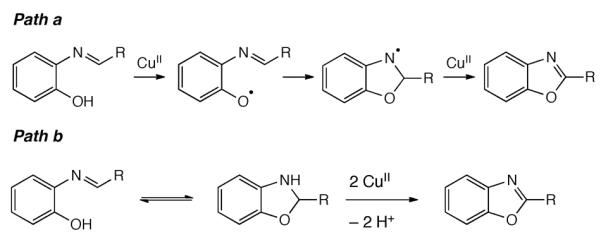
Two possible mechanisms for the oxidative cyclization of 2-iminophenols.
Ketenimines undergo degradation to the ketone when treated with copper(II) chloride in the presence of oxygen (Scheme 323).604 Isocyanate and isonitrile byproducts are also formed, though they undergo polymerization and are not easily isolated. The reaction proceeds best when electron-poor 4-subsituted anilines are condensed with the ketene; electron-rich arenes give significantly lower yields.
Scheme 323.
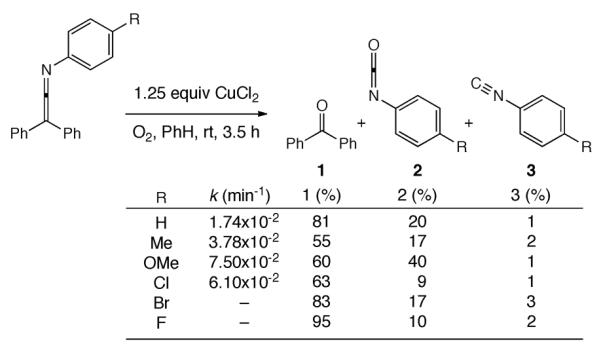
Oxygenolysis of ketenimines by copper and oxygen.
A proposed mechanism is shown in Scheme 324.605 Oxidation of the ketenimine by Cu(II) would generate a radical cation that could capture a molecule of oxygen. From here, the mechanism bifurcates. If the peroxide is oxidized further by a second equivalent of ketenimine to generate an oxyanion (path a), it closes on the radical cation to generate a 1,2-dioxetane intermediate. The opening of this ring generates an equivalent of product and isocyanate. On the other hand, if the peroxo intermediate attacks a second equivalent of ketenimine (path b), a second radical cation is formed that fragments to form an epoxide, a ketone, and a cation radical of isonitrile. Further decomposition of the epoxide generates the ketone and another equivalent of isonitrile. A high ρ–value of −2.13 indicates that an intermediate of the reaction is stabilized by electron-donating groups, supporting the proposed radical cation intermediate.
Scheme 324.
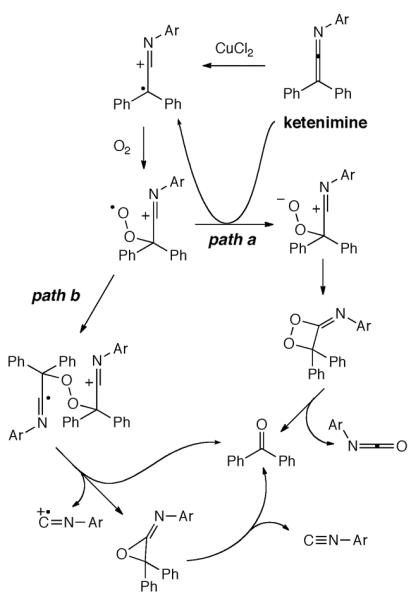
Proposed mechanism for the formation of ketones, isocyanates, and isonitriles from ketenimines.
A tandem oxidative cleavage-alcohol oxidation reaction was employed in the synthesis of α-ketoamides from aryl methyl ketones and secondary amines (Scheme 325).606 Both electron-rich and electron-poor substitution on the aryl ring is tolerated, though yields are higher in electron-poor aryls. Aryls with ortho-substitution are also successful. The amine can be cyclic or acyclic, though the unsymmetrically substituted secondary amines are isolated as a mixture of cis and trans isomers.
Scheme 325.
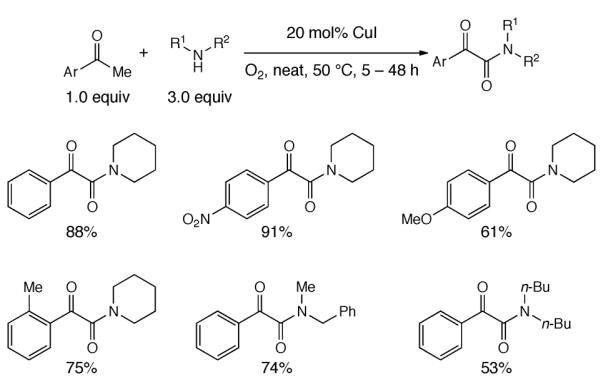
Tandem enamine oxidation-aminal oxidation toward the synthesis of α-ketoamides.
Labeling experiments show that both carbonyl oxygens in the product come from molecular oxygen. The same product is obtained when starting from an enamine. The proposed reaction mechanism proceeds first through an oxidation of the enamine followed by elimination and then nucleophilic addition of the amine (Scheme 326). A copper-catalyzed oxidation of the intermediate hemiaminal generates the observed α-ketoamide.
Scheme 326.

Proposed mechanism in the copper-catalyzed aerobic synthesis of α-ketoamides.
A similar condensation-oxidation reaction generates α-ketoamides from phenylacetaldehydes combined with primary and secondary anilines (Scheme 327).607 The reaction proceeds best with two equivalents of pyridine, generating N-aryl ketoamides in moderate to good yield. The method was applied to the synthesis of a known orexin receptor antagonist, generating the desired product in one step and in 40% yield. The reaction likely follows a mechanism similar to that seen in Scheme 326.
Scheme 327.
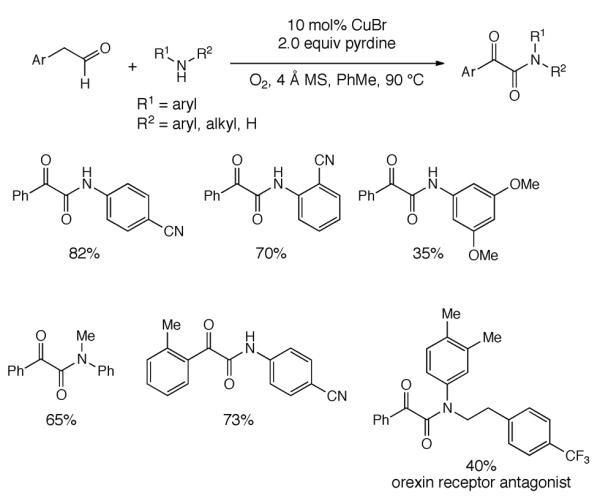
One-pot copper-catalyzed oxidative synthesis of N-aryl α-ketoamides.
Directed C–H activation has been the focus of much recent study. Primary imines generated from the nucleophilic addition of a Grignard reagent into a nitrile can facilitate copper(II) insertion into a proximal C–H bond (Scheme 114, Section II.E.3). Oxygen-mediated elimination generates the phenanthridine product.268
Scheme 114.
Copper-catalyzed oxidative formation of phenanthridines.
Taking advantage of the ability of copper to catalyze [3+2] cycloadditions and enolate oxidation, Wang and coworkers designed a tandem cycloaddition-oxidation sequence for the generation of 3-functionalized indoles in moderate to good yields (Scheme 328).608 The three component reaction requires an alkyl group at the 2-position of the indole and works best with electron-poor alkynes.
Scheme 328.

Tandem copper catalyzed cycloaddition-aerobic oxidation.
A possible reaction mechanism is shown in Scheme 329. Copper(I)-catalyzed cycloaddition followed by elimination of nitrogen gas and nucleophilic attack of the intermediate ketimine generates the tosyl imine. In the absence of oxygen, this product is isolated. Coordination of copper is followed by oxygenation to give a cyclic peroxide. Elimination of copper(I) hydroxide gives the observed product.
Scheme 329.
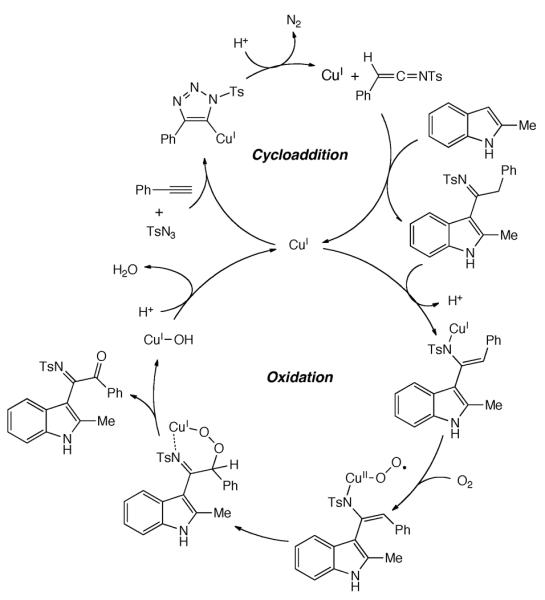
Possible mechanism for the tandem cycloaddition-aerobic oxidation reaction.
V.G. Reactions of Hydrazones
Upon treatment with copper catalysts in the presence of molecular oxygen, hydrazones are oxidized to diazo compounds. Under very mild conditions, these diazo compounds can be isolated. Otherwise, they decompose in the presence of copper to form carbene complexes; the reactivity of these carbenes depends on the substitution of the diazo compound. Highly conjugated hydrazones have been shown to participate in captodative stabilization of radical species.565
V.G.1 Formation of Diazo Compounds from Hydrazones
In their investigations of the copper-mediated oxidation products of benzil hydrazones, Tsuji and coworkers found that treating benzil monohydrazone with 2 equivalents of copper(I) chloride in the presence of air resulted in the formation of azibenzil in nearly quantitative yield (Scheme 330).609
Scheme 330.

Diazotization of benzil monohydrazone using CuCl and molecular oxygen.
Singh and coworkers, expanding on the initial results Tsuji and coworkers, have examined oxidation products formed from exposure of ketohydrazones to copper and oxygen.610 Treatment of the ketohydrazones with Cu(acac)2 in cold diethyl ether under air atmosphere affords diazoketone products in good yields. Oxidation under slightly higher temperatures in dichloromethane leads to the formation of azine products, again in good yields, with a small amount (3–7%) of benzil side product (Scheme 331).
Scheme 331.
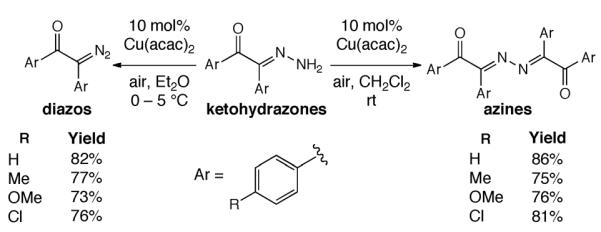
Oxidation of ketohydrazones using Cu(acac)2 and oxygen.
The authors propose that the copper acetoacetonate first oxidizes the hydrazone to the diazoketone, which can be isolated under mild reaction conditions. However, warmer reaction conditions lead to copper-mediated decomposition of the diazo compound to a carbenoid that can be trapped by a second diazoketone to furnish the azine product (Scheme 332).
Scheme 332.

Copper-catalyzed oxidation of hydrazines to diazo species and subsequent decomposition to form diazines.
Diarylhydrazones treated with Cu(acac)2 under air undergo the same reaction, forming azines in good yield (Scheme 333).611 This reaction requires higher temperatures and catalyst loading, so the transient diazo intermediate was not isolated.
Scheme 333.
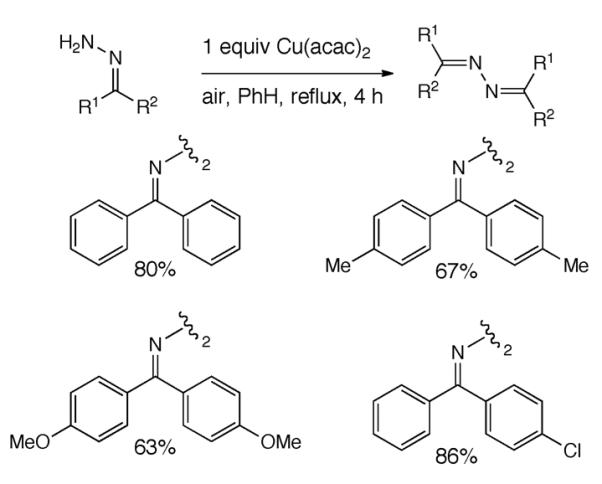
Oxidative coupling of diarylhydrazines to yield diaryldiazabutadienes.
The hydrazone can also be formed via condensation of the aldehyde with hydrazine; this intermediate can then be oxidized by Cu(acac)2 and oxygen to form azines in quantitative yields (Scheme 334).612 The authors again propose that the resulting hydrazone is oxidized to the diazo compound, which decomposes under the reaction conditions (Scheme 332). In this case, no diazo compound could be isolated, which the authors attribute to rapid decomposition of this intermediate under the reaction conditions. Though a Lewis-acid catalyzed condensation mechanism may be proposed, the short reaction times and mild conditions relative to what is needed for acid-catalyzed condensation,613 the known tendency for Cu(acac)2 to form carbenoid species,614 and the isolation of the diazo compound in the case of the ketohydrazones,610 suggest that a simple condensation is not occurring.
Scheme 334.
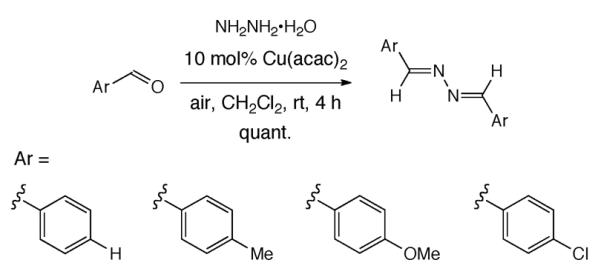
Oxidation of in situ-generated hydrazones to yield azines.
V.G.2 Formation of Alkynes from Hydrazones
Treatment of 1,2-dihydrazones with copper in the presence of molecular oxygen results in the formation of alkynes. This reaction was first observed by Tsuji and coworkers; treatment of benzil dihydrazone with two equivalent of CuCl under an oxygen atmosphere gave diphenylacetylene in 97% yield with release of nitrogen gas (Scheme 335).609
Scheme 335.

Oxidative deamination of benzil dihydrazone using copper and oxygen.
No mechanism for this transformation has been proposed, but it may follow a similar course as is seen in the oxidation of benzil monohydrazone.610 Copper-catalyzed oxidation of the hydrazone moiety likely occurs in a stepwise fashion to generate the monodiazo compound, which can then undergo a further reaction with copper to produce a stabilized carbene (Scheme 336). Oxidation of the remaining hydrazone would then initiate an elimination cascade to generate the alkyne and dinitrogen.
Scheme 336.
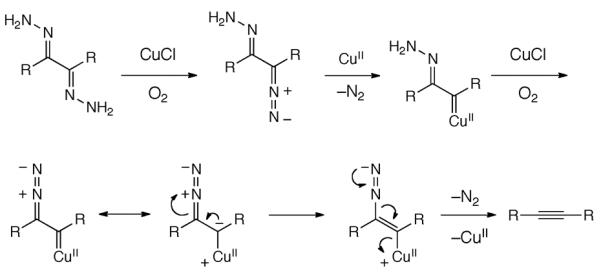
Possible mechanism for the oxidative deaminiation of 1,2-dihdyrazones to form alkynes.
Further development showed the reaction can be conducted with catalytic copper, though the yields are slightly lower (Table 15, Entries 2, 8, and 9).617 Successful oxidation requires the bubbling of oxygen through the reaction mixture.615 Benzil dihydrazone reacts well (Entries 1–3), as do thiophenes (Entries 4–5),616 though much work remains in expanding the substrate scope. Dialkyl-1,2-dihydrazones, both symmetrically (Entries 6–8) and unsymmetrically (Entries 7–11) substituted, are also suitable substrates. Interestingly, primary alcohols are not oxidized under the reaction conditions (Entry 11, R = H).
Table 15.
Oxidative deamination of 1,2-dihydrazones using copper and oxygen.
| Entry | Substrate | Product | Ligand/Complex | Reaction conditions | Yield (%) | Ref |
|---|---|---|---|---|---|---|
| 1 |
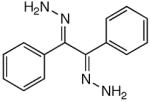
|
|
2 equiv CuCl | O2, pyridine, rt, 1.5 h same as scheme above | 97 | 609 |
| 2 |
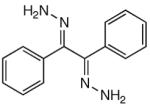
|
|
20 mol% Cu(OAc)2 | O2, MeOH, PhH, rt. 1.5 h | 78% | 617 |
| 3 |
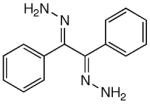
|
|
4 equiv CuCl | O2, pyridine, CH2Cl2, rt | 78 | 615 |
| 4 |

|

|
2 equiv CuCl | Air, pyridine, rt, 18 h | 87 | 616 |
| 5 |

|

|
2 equiv CuCl | Air, pyridine, rt, 18 h | 81 | 616 |
| 6 |

|
|
40 mol% CuCl | O2, pyridine, rt, 3 h | 72 | 617 |
| 7 |

|
|
50 mol% CuCl | O2, CH2Cl2, rt, 3 h | 97 | 615 |
| 8 |
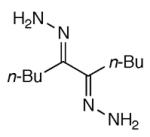
|
|
2.5 equiv CuCl | O2, pyridine, rt, 2 h | 57 | 618 |
| 9 |
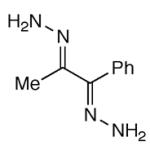
|
|
2.5 equiv CuCl | O2, pyridine, rt, 2 h | 82 | 618 |
| 10 |
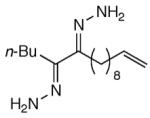
|
|
2.5 equiv CuCl | O2, pyridine, rt, 2 h | 81 | 618 |
| 11 |
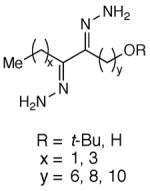
|

|
1.7 equiv CuCl | O2, pyridine, rt, 1 h | 82–88 | 619 |
The oxidation of 1,2-dihydrazones to form alkynes is a useful method for the synthesis of alkyne-containing rings. Tsuji and Mandai applied this method in their synthesis of cis-civetone, a component in palm oil and a popular perfume ingredient (Scheme 337).620 Exposure of the 1,2-dihydrazone acetal to copper and oxygen in pyridine, followed by treatment with dilute acid, afforded the cyclic alkyne in 82% yield. Subsequent Lindlar reduction generated the desired natural product in 92% yield.
Scheme 337.
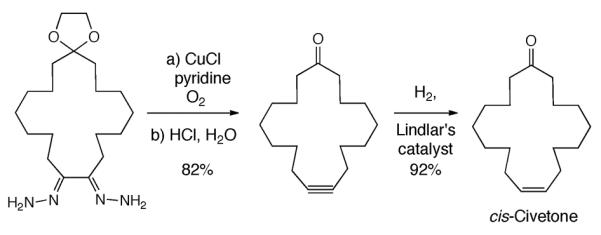
Oxidation of 1,2-dihydrazones in the total synthesis of cis-civetone.
V.G.4 Formation of Arenes from Hydrazones
Cherkaoui and Scherowsky used the oxidative deamination of 1,6-dihydrazones as the key cyclization step in their synthesis of two hexamethoxyphenanthrene isomers.621 The dialdehyde precursor, made via and Ullmann coupling, was condensed with hydrazine to yield the dihydrazone (Scheme 338). Exposure of this dihydrazone to copper and oxygen in pyridine resulted in the formation of an arene bond to give the phenanthrene system. Notably, many other conditions for ring closure were unsuccessful.
Scheme 338.
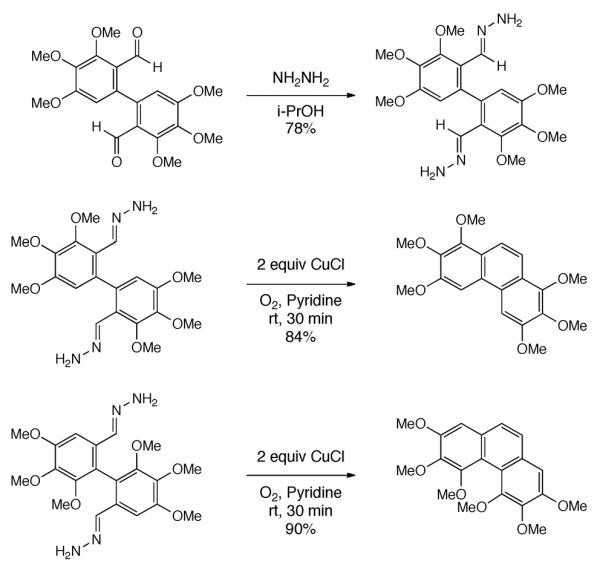
Oxidative cyclization through the copper-mediated oxidation of 1,2-dihydrazones.
V.H. Thioamides to Nitrilium Equivalents
Thioamides and selenoamides, when treated with copper and oxygen, are oxygenated to afford the corresponding amides in excellent conversion (Scheme 339).622 This reaction is similar to the oxidation of thioamides and subsequent intramolecular nucleophilic attack (Scheme 342), though this method can also employ tertiary thioamides and thioureas. Both copper and oxygen are necessary for the transformation, and highly polar solvents such as DMSO and DMF are required.
Scheme 339.
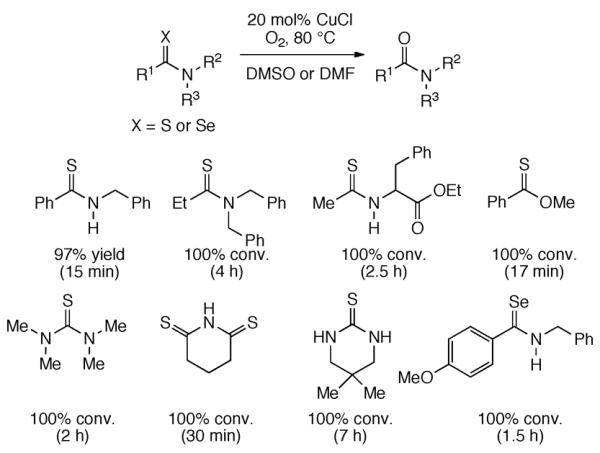
Oxidation of thioamides and selenoamides to amides.
Scheme 342.
Copper catalyzed oxidation of thioamides to oxazolines and amidines.
Labeling experiments employing 18O2 show that the oxygen atom in the product can come from both DMSO and O2. The use of DMF as solvent prevents the incorporation of the solvent oxygen. When a partially labeled amide (16O:18O = 15:85) is exposed to the optimized reaction conditions no exchange with 16O2 or DMS16O occurs. This novel 18O2 labeling method was demonstrated in the oxidation of sialic acid, which contained several other ester groups that were unaffected by the oxidation conditions. (Scheme 340).
Scheme 340.

18O labeling an amides by oxidation of the thioamide.
Though no reaction intermediates have been identified in the oxidative desulfurization, a plausible mechanism has been proposed (Scheme 341). A stepwise two-electron oxidation of the thioamide gives a sulfenylium intermediate. The reactivity of tertiary amides (R2 and R3 ≠ H) suggests the collapse of the sulfenylium to the nitrilium intermediate (cf., Scheme 342 and Scheme 343 below) is unlikely in this transformation. Rather, the sulfenylium undergoes attack from a nucleophilic oxygen species generated during the oxidation of copper(I) to copper(II) by molecular oxygen. Subsequent expulsion of elemental sulfur yields the amide product. The reaction proceeds in the dark suggesting no photochemical electron transfers are involved.
Scheme 341.
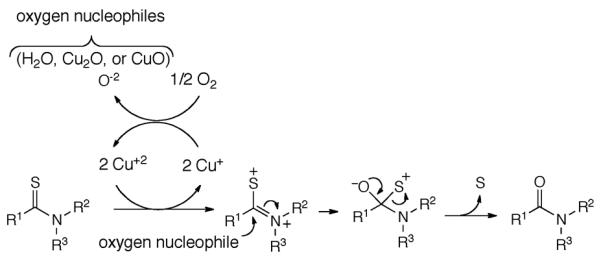
Proposed mechanism of the oxidation of thioamides to amides.
Scheme 343.
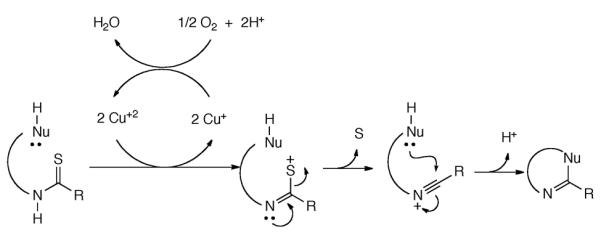
Proposed mechanism for the oxidation of thioamides to oxazolines and amidines.
This method has also been applied to the intramolecular oxidative cyclization of thioamides (Scheme 342).623 A wide range of five- to seven membered nitrogen-containing heterocycles can be synthesized in good to moderate yield. Copper and oxygen are both required for the reaction, and the only co-product is elemental sulfur.
The reaction pathway proposed for the intramolecular cyclization process (Scheme 343) is similar to that proposed for the intermolecular variant (Scheme 341). Because this reaction is less sensitive to steric conditions than a similar transformation employing the intramolecular displacement of alkylated sulfurs,624 the authors suggest that this reaction proceeds through a nitrilium intermediate, formed by expulsion of elemental sulfur prior to nucleophilic attack.
VI. Reactions of Enamines and Enol Ethers
This section covers the oxidative reactions of discrete enamines and enol ethers. Those reactions involving the enol intermediates from the corresponding dicarbonyl have been discussed above (Section V.C and Section V.E). Under oxidative conditions, enamine and enol ethers have been shown to undergo oxidative dehydrogenation, α-oxygenation, and oxidative cleavage of the C–N single bond or the C–C double bond. More recent efforts have focused on the development of methods for oxidative C—N and C—O bond formation of enamines and enol ethers respectively.
VI.A. Reactions of Enamines
VI.A.1 Oxidative Dehydrogenation of Enamines
Examples of preparatively useful oxidative dehydrogenations of enamines employing copper catalyst are scarce. Seminal work on this transformation focused on optimizing conditions for selective dehydrogenation of indoline to indole without concomitant ring scission.625 This goal could be accomplished using CuCl·pyridine in dichloromethane. Reaction kinetics were performed in an attempt to broaden the mechanistic understanding. The reaction was found to be first order with respect to indoline, dioxygen, and the reaction rate law was determined to be rate = kobs[indoline][catalyst][O2]. Radical formation was not detected by EPR spectroscopy. The dehydrogenation reaction with oxygen-containing Cu(II) species formed the desired indole product along with water as the byproduct suggesting a four electron reduction of dioxygen. The authors speculate the dehydrogenation occurs in two reactions, one with oxygen and the second with hydrogen peroxide formed from the first reaction. The first cycle of this proposed mechanism is outlined in (Scheme 344). For related reactions of amines, see Section IX.A.
Scheme 344.
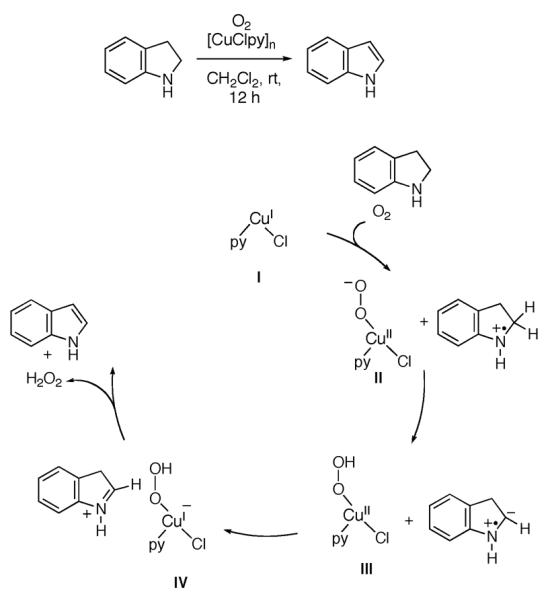
Proposed mechanism for oxidative dehydrogenation of indole.
VI.A.2 Enamine α-Oxygenation
Enamines can undergo α-oxygenation, which is also the first step in oxidative cleavage (see next Section VI.A.3). The catalytic oxygenation of air stable cyclic enamines was examined with several cases (Scheme 345).626 Enamines derived from acyclic amines afforded diketone and α-hydroxy ketone products in modest to low yield (Scheme 345a) while those from cyclic amines afforded those compounds and two amine derivatives in modest to low yields (Scheme 345b). Application of this method to acyclic enamines resulted in oxidative cleavage of the enamine which is discussed Section VI.A.3, Scheme 349. A linear relationship was observed with respect to the reaction rate and ionization potentials for enamines suggesting the rate-determining step involves one-electron oxidation of the enamine. Treatment of an equimolar amount of enamine with CuCl2 in DMF under an argon atmosphere decreased the strength of the copper(II) ESR signal after five minutes at 0 °C, providing support for a one-electron transfer from the enamine to the cupric ion. A proposed pathway for the formation of the dicarbonyl and α-hydroxy ketone is outlined in Scheme 346. Oxygenation reactivity correlates with ionization potential of the enamines rather than the nucleophilicity of the β-carbon suggesting the rate limiting step is a one electron transfer from the enamine to the copper salt. Based on the predominance of the dicarbonyl products over the α-hydroxy ketone, it appears that elimination of the peroxo intermediate occurs more readily than reductive cleavage. In addition, the hydroxy group can also be further oxidized by copper catalysts to the corresponding carbonyl (see Section IV.A).
Scheme 345.
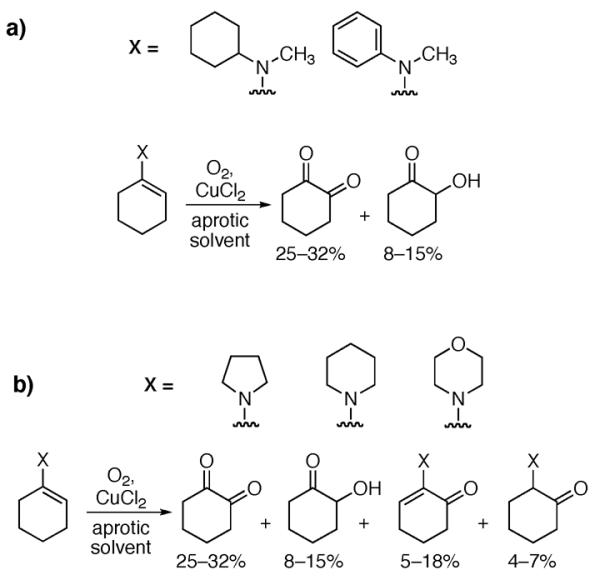
α-Oxygenation of enamines.
Scheme 349.

Baloghergovich's copper catalyzed enamine cleavage.
Scheme 346.
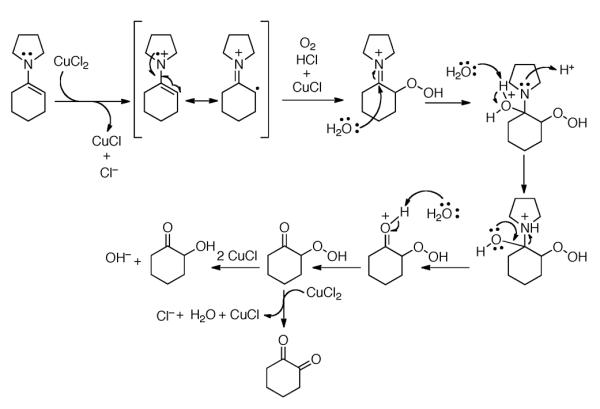
Mechanism of the α-oxygenation.
In later work, the oxygenation of enamines was examined in more detail utilizing reaction kinetics to explain the difference in reactivity between enamines derives from acyclic vs cyclic amines.627 Enamines with β-vinylic hydrogens afforded a mixture of products (Scheme 347), mostly the result of α-oxygenation. On the other hand, enamines without β-vinylic hydrogens afforded exclusive double bond cleavage. A singlet oxygen quencher (1,4-diazabicyclo[2.2.2.]octane) did not inhibit the oxygenation. A metal and halide screen revealed a metal reactivity trend of Cu > Fe > Co >> Ni and no apparent halide effect was observed. The authors concluded that the oxygenation reactivity correlates with ionization potential of the enamines rather than the nucleophilicity of the α-carbon suggesting the rate limiting step is a one electron transfer from the enamine to the copper salt.
Scheme 347.
Substrate scope for α-oxygenation of enamines.
VI.A.3 Enamine Oxidative Cleavage
Vanrheen reported the first example of copper catalyzed oxidative cleavage of enamines in 1969.628 Sterically hindered and cyclic enamines afforded ketone and amide products in good yields (Scheme 348). Diketone formation was problematic for enamines bearing a β-vinylic hydrogens. Copper(II) sources with polyatomic counterions were inefficient for this process; on the other hand, trace amounts of halogenated byproducts were observed with copper halide sources.
Scheme 348.
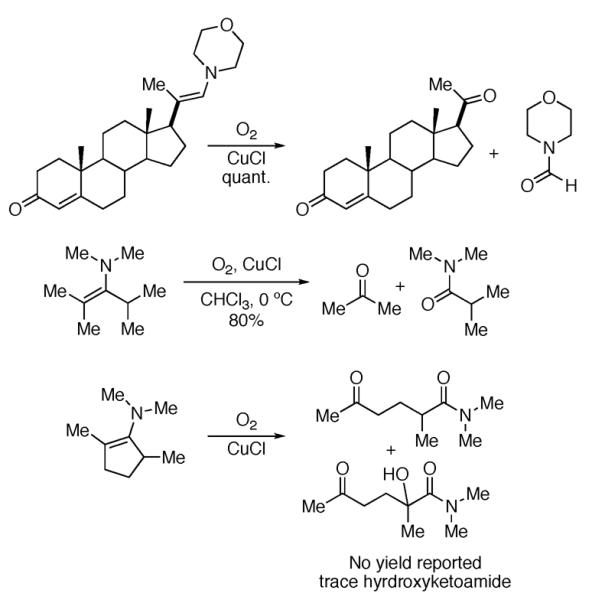
Oxidative cleavage of enamines.
A few years later, Baloghergovich and co-workers reported similar conditions for the oxidative cleavage of enamines (Scheme 349).629 The authors suggested that a binuclear copper species with a bridging oxygen atom could be the catalytically active species.
As mentioned earlier (Section VI.A.2), cupric chloride was shown to be effective for α-oxygenation as well as oxidative cleavage of enamines (Scheme 345–Scheme 347). In a modified version, a variety of enamines, including those with vinylic β-hydrogens (c.f. Scheme 347) were induced to oxidatively cleave to afford ketone and amide products (Scheme 350).626
Scheme 350.
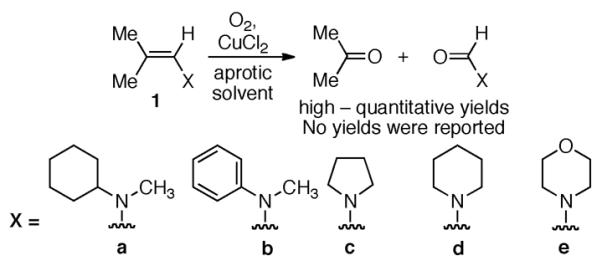
Oxidative cleavage of acyclic enamines.
For the most part, enamines lacking a β-vinylic hydrogen afforded double bond cleavage in quantitative yields (Scheme 351) with the exception of one case (last entry in Scheme 351).627 A singlet oxygen quencher (1,4-diazabicyclo[2.2.2]octane) did not inhibit the oxygenation. A linear relationship was observed between the rate of the reaction and the oxidation potential suggesting that formation of the radical cation intermediate is the rate-limiting step. The authors speculated that cupric halides behave as one electron oxidizing agents toward the enamine and oxygenation reactivity may be correlated with the ionization potential rather than nucleophilicity of the enamine. A mechanism has been outlined in by Kaneda and coworkers627 (Scheme 352). Alternately, the initial oxygenation products (Scheme 346) may form and then undergo further oxidative cleavage via enolic intermediates.
Scheme 351.
Substrate scope oxidative cleavage of enamines.
Scheme 352.
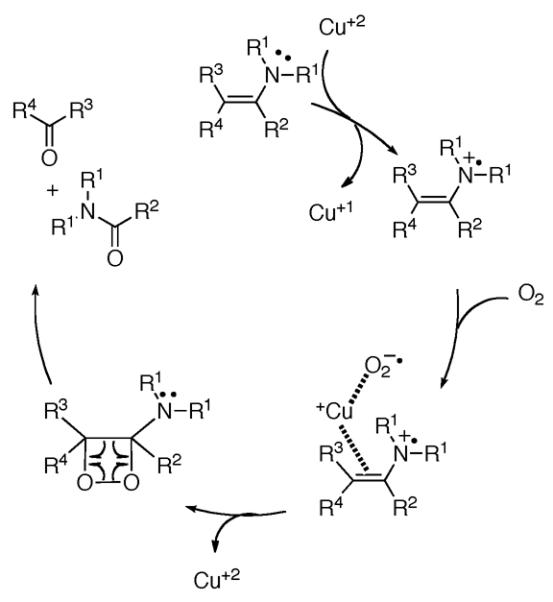
Proposed mechanism for oxidative enamine cleavage.
More recently, exploration of the catalytic abilities of zeolite X-encapsulated copper(II) chloride complexes were examined for liquid-phase oxygenation of enamines under an oxygen atmosphere (Scheme 353).630 The oxygenation rate was slower for bulky enamines compared to the homogeneous system. The difference in reactivity between the heterogeneous system and the homogeneous system could be attributed to the shape selective effect of Cu2+ species within the 3-D zeolite pores. The catalyst could be recovered without appreciable loss of activity.
Scheme 353.

Oxidative cleavage of enamines catalyzed by Cu–X zeolite complexes.
This type of oxidative cleavage is useful for the degradation of complex molecules, synthesis of isoquinolones, and the oxidative cleavage of nitrogen containing heterocycles. For example, a three-step degradation of the bile-acid side chain of a cholanic acid derivative to the C22-aldehyde was accomplished using this cleavage.631,632 Specifically, the ketoester pregnane intermediate was converted to the C22-aldehyde in 85% yield using a catalytic CuCl with morpholine under air (Scheme 354).632 For an example of an oxidative degradation resulting in loss of a further carbon, see Section V.D, Scheme 312. The mechanism of this transformation is similar to that been in detailed in Section V.C.2 and Section V.D.
Another application employing an enamine oxidative cleavage strategy for the synthesis of N-substituted isoquinolones has been reported using copper(I) chloride (Scheme 355).633 Good yields were obtained for the N-substituted isoquinolones.
Scheme 355.
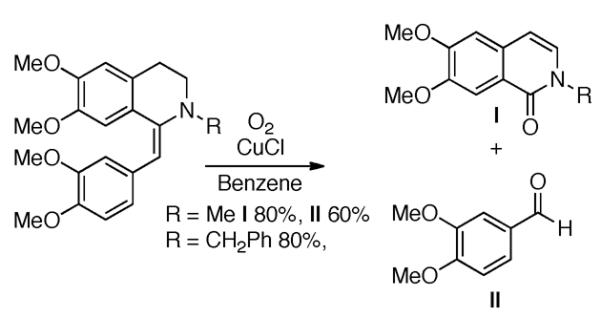
Oxidative cleavage of isoquinolone.
The first examples of copper-mediated oxidative cleavage of indoles were reported as early as 1977.634 The oxidation of 2,3-dimethylindole substrates was accomplished in good yields using the Cu–X zeolite complexes. Later, Tsuji and co-workers reported that copper(I) chloride and pyridine complex could be used to oxidatively cleave 3-methyl indole under an ambient atmosphere in up to 72% yield (Scheme 356).635
Scheme 356.
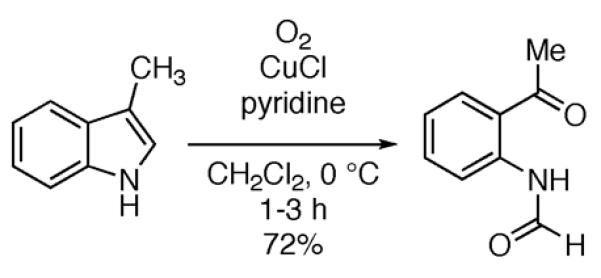
Oxidative cleavage of 3-methylindole.
A catalytic protocol for the oxidative cleavage of 3-substituted indoles was then developed (Scheme 357).636 The relative amounts of pyridine and dichloromethane were important for the efficiency of the reaction, and the oxygen uptake roughly parallels yield of cleaved product regardless of the molar ratios of substrate to catalyst. Oxygen is integral to the cleavage, as copper(II) reagents in the absence of oxygen, a dimerized indole product was the only material isolated.
Scheme 357.
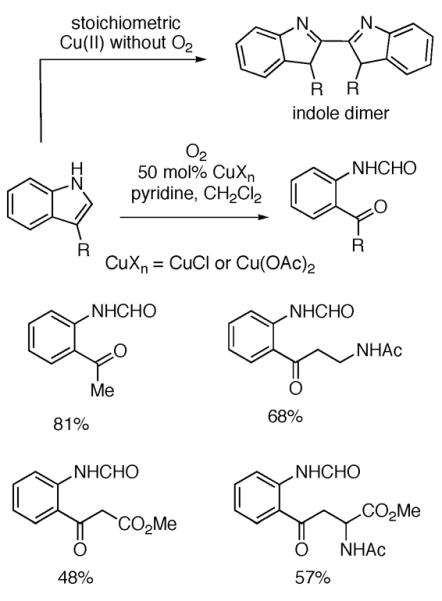
Oxidative cleavage of 3-subsituted indoles.
Sagawa and co-workers later reported that a copper(I) pyridine complex could also promote the oxidative ring cleavage of 3-methylindole in tetrahydrofuran (Scheme 358).637 Among pyridine ligands substituted with electron donating group, methyl pyridines were slightly more suitable generating product in 42–54%. Weakly basic solvents such as THF provided higher yields indicating choice of solvent is important. A mechanism was proposed and is outlined in (Scheme 359).
Scheme 358.

Oxidative cleavage of 3-methyl indole.
Scheme 359.
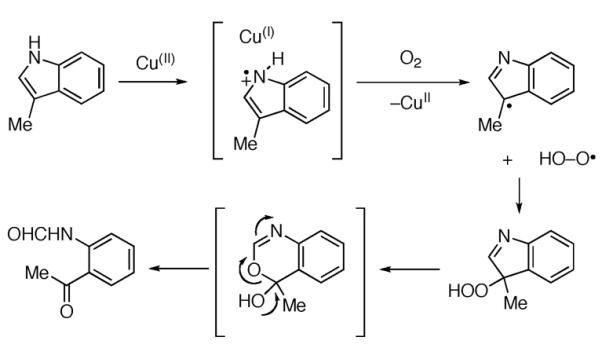
Proposed mechanism for oxidative cleavage of indoles.
VI.A.4 Enamine Oxidative C-C Bond Formation
Enamines have also been shown to undergo oxidative C–C bond formation with alkenes. One example is the cascade carbo-carbonylation of unactivated alkenes with enamines promoted by an organocatalyst and a copper catalyst to afford γ-diketones and γ-carbonyl aldehydes under air.638 The use of a co-oxdiant (MnO2) was required to increase the yields. Electron rich and electron deficient aryl alkenes reacted smoothly except for strongly electron deficient arylalkenes (Scheme 360). The pyrrolidine was proposed to act as an organocatalyst, and no experimental evidence was provided to support the proposed mechanism outline below (Scheme 361).
Scheme 360.
Substrate scope for cascade carbo-carbonylation of unactivated alkenes with enamines.
Scheme 361.
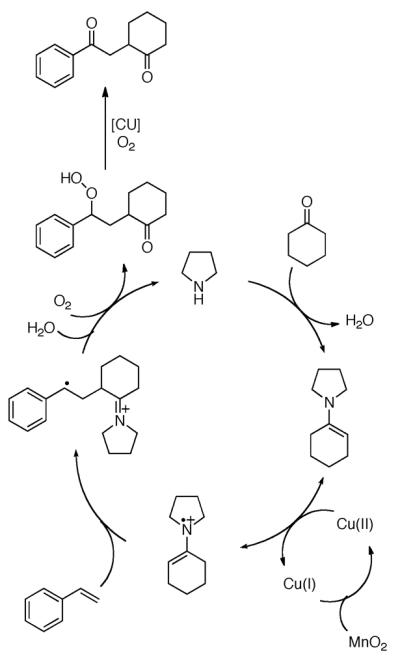
Proposed mechanism for cascade carbo-carbonylation of unactivated alkenes with enamines.
VI.A.5 Oxidative C-N Formation from Enamines
Another novel transformation recently discovered is the oxidative C–N bond formation of enamines with iminyl ynoate Michael acceptors. This transformation is very similar to the reaction of 1,3-carbonyls outlined in Section V.C.1 (see Scheme 279–Scheme 282), the main difference being that the amine adduct is utilized resulting in the corresponding enamine substrates (β-enamino carbonyls). Yan and co-workers developed a copper catalyzed oxidative cyclization of β-enamino ketones or esters and alkynoates for the synthesis of polysubstituted pyrroles under an oxygen atmosphere.639 The presence of copper is required for this transformation, and oxygen was the most efficient oxidant. The choice of solvent was crucial to the reaction, and DMF was the optimal solvent. A variety of beta enamino ketones or ester substrates were tolerated (Scheme 362). A slight decrease in yields was observed for β-enamino ketones with substituents at the meta-position of the aryl group, presumably due to electron deficiency. A plausible mechanism is outlined (Scheme 363), although no mechanistic investigations were conducted to support it.
Scheme 362.

Substrate scope for synthesis of polysubstituted pyrroles.
Scheme 363.
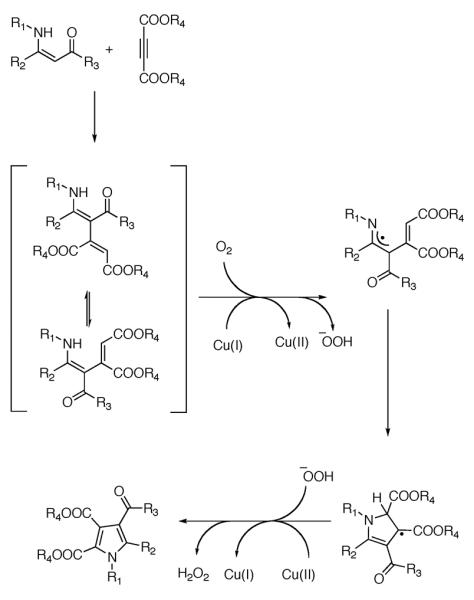
Proposed mechanism for the oxidative cyclization of β-enamino ketones or esters with alkynoates.
VI.B. Reactions of Enol Ethers
The oxidative reactions of enols and enolates generated from 1,3-dicarbonyls are discussed in Section V.C.
In Section VI.A.3, the oxidative cleavage of enamine to afford ketone and amide products was described. As in the case for enamines, Tokunaga and coworkers were able to demonstrate that enol ethers could be cleaved using a copper catalyst and oxygen (Scheme 364).640 Both a copper and oxygen are required for this transformation to occur. Notably, 1–5 mol% copper catalyst in the presence of 5 equiv of water afforded exclusive formation of the oxidative cleavage product (A) with none of the hydrolysis product (B) observed. Commencing from the enol ether is crucial as the same reaction conditions from the corresponding aldehyde, which can form the enolate in situ, provide the oxidative cleavage product with only 5% yield. The authors propose a mechanism involving a superoxide anion, but Scheme 365 outlines a mechanism similar to those invoked in the oxidative cleavage of enolates (see Section V.C.2).
Scheme 364.
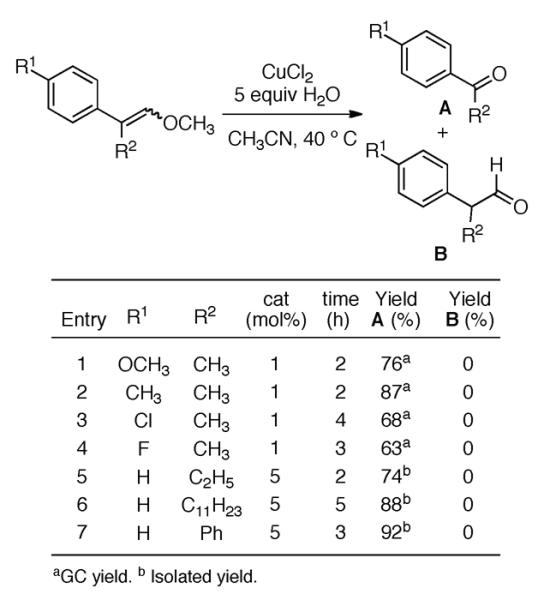
Oxidative cleavage of various enol ethers under an oxygen atmosphere.
Scheme 365.
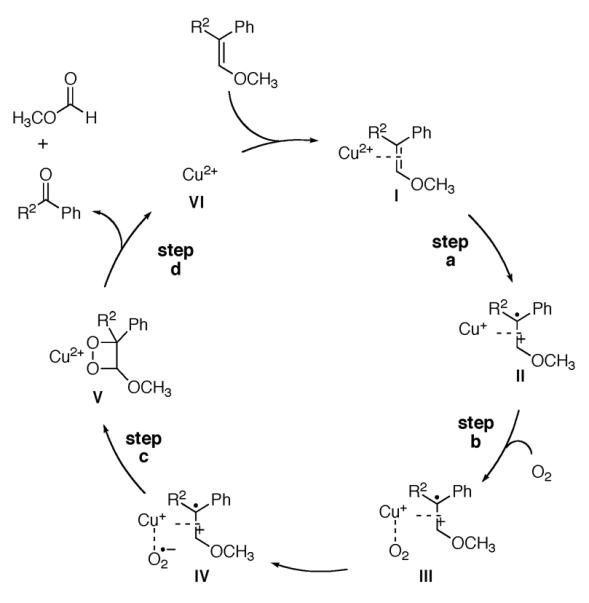
Proposed mechanism for oxidative cleavage of enol ethers.
Simple enol ethers have been shown to undergo oxidative cleavage. The 1,3-dicarbonyl congeners, which react via the enolic form undergo a broader range of oxidative cyclizations (see Section V.C) Overall, oxidative reactions simple enol ethers with catalytic copper and oxygen remains an underexplored area of research.
VII. Reactions of Phenols and Naphthols
The presence of coupled phenols and naphthols in natural products, together with their utility in materials chemistry, has fueled much research into both their biogenesis and into methods to generate them selectively.641,642,643,644 A facile one-electron oxidation of the parent phenol, carried out under mild reaction conditions, generates a resonance-stabilized radical (Scheme 366) which then undergoes coupling. This oxidation typically offers high functional group tolerance, which makes it a viable alternative other biaryl coupling methods such as Suzuki coupling, Negishi coupling, Kumada coupling, or nucleophilic aromatic substitution.324a,645 The transformations allow for functionalization at unfunctionalized centers, eliminating the need for prefunctionalized starting materials (i.e., halides, boronic acids, etc).
Scheme 366.

Radicals arising from phenols, 2-naphthols, and 1-naphthols.
A consequence of the lack of pre-functionalization, however, is a loss of regioselective control. Oxidative phenol and naphthol couplings are typically substrate-controlled, though the choice of catalyst can allow for some degree of control. The typical mechanisms invoke hydrogen radical abstraction or deprotonation and electron abstraction, generating the radical intermediates shown in Scheme 366, or metal bound version thereof. The ortho- and para-radicals have similar stability, leading to several coupling outcomes;646 direct meta-coupling is not possible. Even when the para-position is ostensibly blocked by para-substitution, formation of Pummerer ketone product occurs readily (Scheme 367).647
Scheme 367.
Different coupling patterns for phenols.
The 2-naphthols are far more well-behaved, coupling exclusively at the 1-position to give 1,1'-BINOL compounds. Comparison of the reactivities of 1-naphthols and 2-naphthols reveal that this selectivity is due to the greater stability of the intermediate ortho-1 (Scheme 366), in which aromaticity is retained in one ring and the radical is benzylic. An ongoing challenge in these oxidative coupling reactions is the selective coupling of electronically and sterically comparable positions.
VII.A. Naphthol Dimerization
VII.A.1. Racemic and Achiral Naphthol Couplings
Given the utility of the 1,1'-bis-2,2'-naphthol (BINOL) framework in catalysis and materials studies, much work has been directed toward the efficient preparation of 1,1'-binaphthols. The use of stoichiometric transition metal oxidants in 2-naphthol coupling is well established.648 The use of catalytic copper, however, required identification of an appropriate terminal oxidant, a role in which oxygen has proved particularly effective. Initial studies of naphthol oxidation by Brackman and Havinga found that copper nitrate and 2,4,6-trimethylpyridine (collidine) were effective in catalyzing the oxidation reaction (Scheme 368).649 However, the product distribution varied greatly depending on substrate structure. 2-naphthol gave biaryl products, but further oxidation also occurs to give a complex mixture.
Scheme 368.
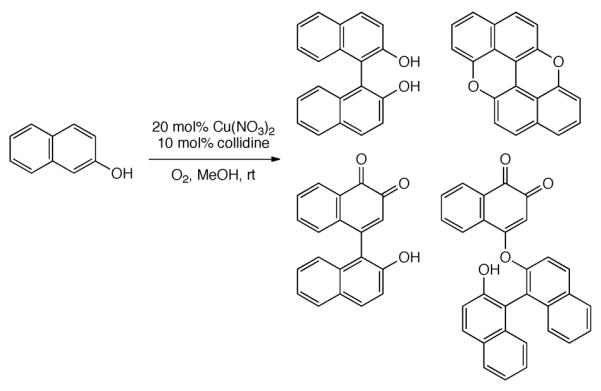
Early studies on the aerobic copper-catalyzed oxidative coupling of 2-naphthol.
Catechols and hydroquinones of naphthalene also undergo oxidative dimerization in the presence of copper catalysts (Scheme 369).650 The ease of oxidation of these compounds to their respective quinones prevents the isolation of the bisphenols. Instead, bis-ortho- and para-naphthaquinones are isolated.
Scheme 369.
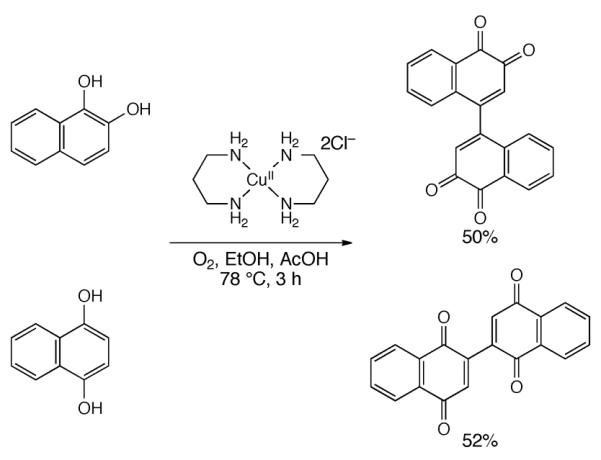
Copper-catalyzed aerobic dimerization of naphthalene catechol and hydroquinone.
Sakamoto and co-workers reported the discovery of a copper catalyst system supported on alumina. No reaction was seen without the alumina support. Furthermore, the premixing and coevaporation of the copper sulfate and alumina was required. This supported catalyst couples both electron-rich and halogen-substituted 2-naphthols, but is not successful with the more difficult to oxidize substrates containing electron- withdrawing groups (Scheme 370).651
Scheme 370.
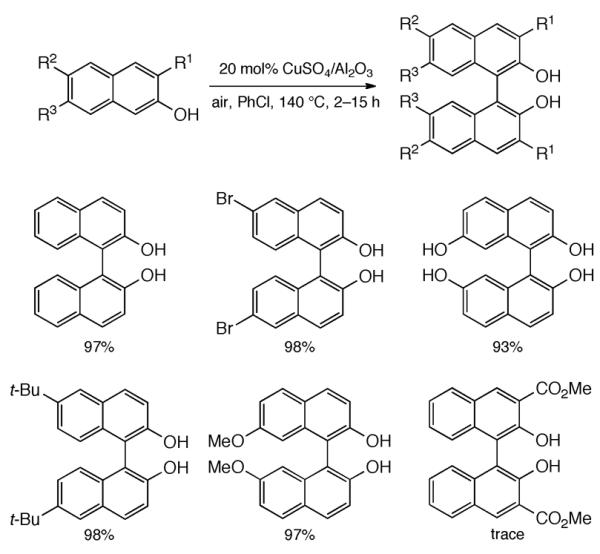
Oxidative dimerization of 2-naphthols with alumina-supported catalyst.
Copper-exchanged montmorillonite has been shown to be an effective solid-supported catalyst in the aerobic coupling of 2-naphthols. The catalyst is even effective in the coupling of phenols, albeit with just one example (Scheme 371).652
Scheme 371.
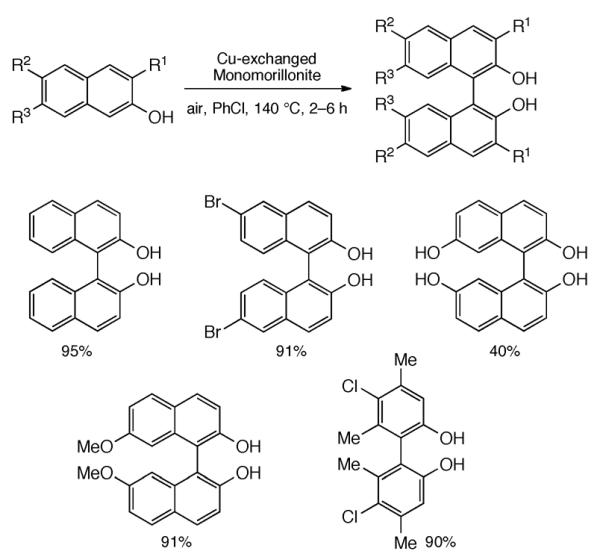
Copper-exchanged montmorillonite as a catalyst for the oxidative dimerization of 2-naphthols.
Mastrorilli and co-workers found that metal acetoacetonates, including Cu(acac)2, can effectively couple 2-naphthol under oxygen atmosphere in the presence of 3-methylbutanal, which likely forms a peracid in situ (Scheme 372).653
Scheme 372.

The oxidative coupling of 2-naphthol with Cu(acac)2.
Schiff bases of salicylaldehyde and (±)-methylbenzylamine form a complex with copper that can oxidatively dimerize 2-naphthols with low catalyst loading, though the system is not effective with electron deficient substrates (Scheme 373).654
Scheme 373.
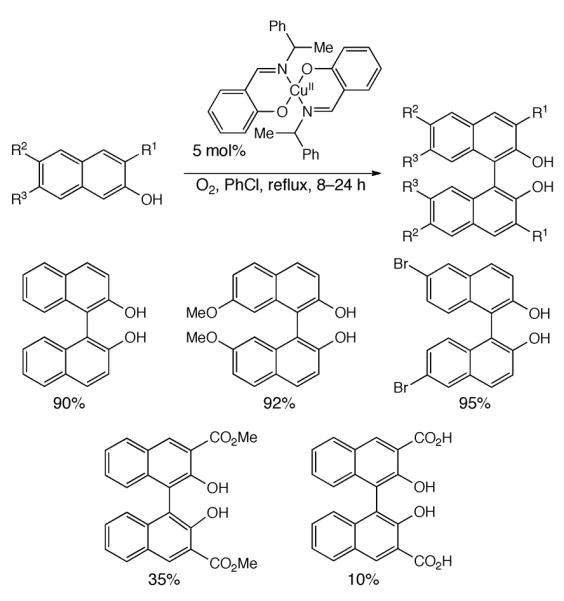
A Cu-Schiff base complex for the oxidative coupling of 2-naphthols.
A 2:1 ratio of NMI and CuCl has been found to catalyze the coupling of 2-naphthols, including those substituted with electron-withdrawing groups (Scheme 374).655
Scheme 374.
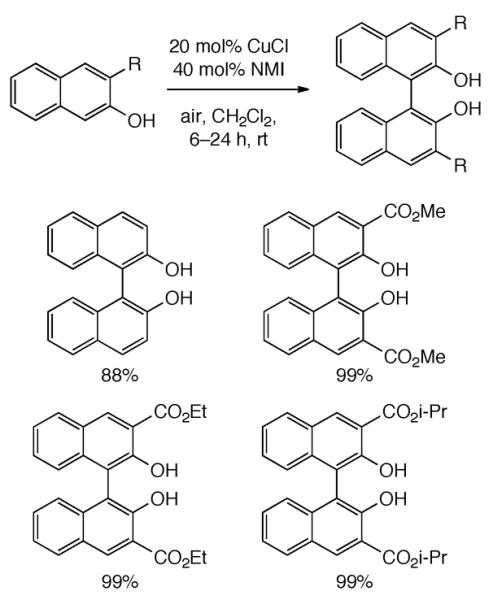
Oxidative coupling of 2-naphthols using CuCl and NMI.
A major breakthrough in the oxidative coupling of 2-naphthols came in the use of the stable Cu(OH)Cl(TMEDA) complex by Nakajima and co-workers. Good turnover with molecular oxygen was observed, allowing low catalyst loadings even with electron-poor binaphthols. Excellent yields were obtained air could also be used, but the reactions were slower (Scheme 375).322 Copper catalyzed coupling of the parent 2-naphthol is now the method of choice for preparation of racemic BINOL, which has been resolved in numerous ways.648
Scheme 375.
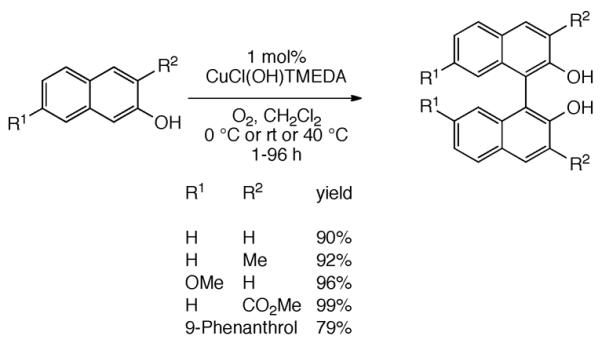
Formation of binaphthols and related compounds using Cu(OH)Cl(TMEDA) complex.
The copper(II) and molecular oxygen catalyst system has shown broad versatility, as demonstrated in the synthesis of the ligands phosphonyl BINOL656 and BICOL657 as well as the natural products amplumthrin and flavathrin (Scheme 376).658
Scheme 376.
Formation of binaphthols and related compounds via oxidative coupling with copper catalysts and oxygen.
Nakajima and co-workers have further shown that the Cu(OH)Cl(TMEDA)-catalyzed naphthol coupling does not require solvent. Grinding the substrates and catalyst with a mortar and pestle, followed by heating at 50 °C open to air, furnished binaphthol products in excellent yields (Scheme 377). The reaction displays remarkable scalability, as a 50 g reaction proceeded in 76% yield.653
Scheme 377.
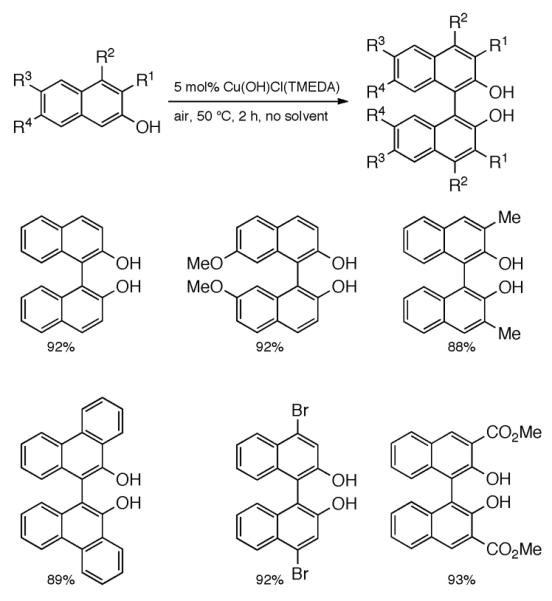
Solvent-free oxidative coupling of 2-naphthols with Cu(OH)Cl(TMEDA).
The total synthesis of bioxanthracene ES-242-4 utilized a Cu(OH)Cl(TMEDA) coupling of an elaborated 1-naphthol to produce a 1,1'-bisnaphth-4,4'-ol in excellent yield. Unfortunately, the stereochemistry of the dihydropyran ring system did not influence the diastereoselectivity of the biaryl coupling and a 1:1 ratio of diastereomers was obtained (Scheme 378).659
Scheme 378.
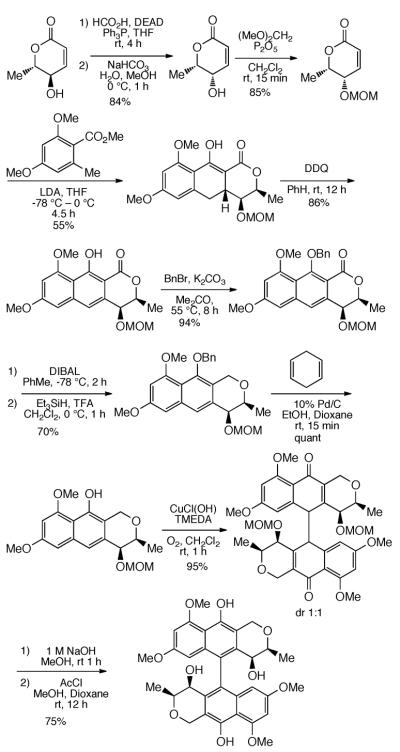
Total synthesis of bioxanthracene (−)-ES-242-4 via oxidative naphthol coupling.
In their pursuit of binaphthol-based oligomers, Chow and co-workers used Nakajima's conditions to couple 4-bromo-2-napthol in excellent yield. Subsequent resolution though the (S)-camphor sulfonate ester, column chromatography, and sulfonate cleavage yielded the two enantiomers in >98% ee (Scheme 379).660 The 4-bromo-binols were then ethynylated and subjected to Glaser-Hay coupling (for more on Glaser-Hay coupling, see Section II.D.2).
Scheme 379.
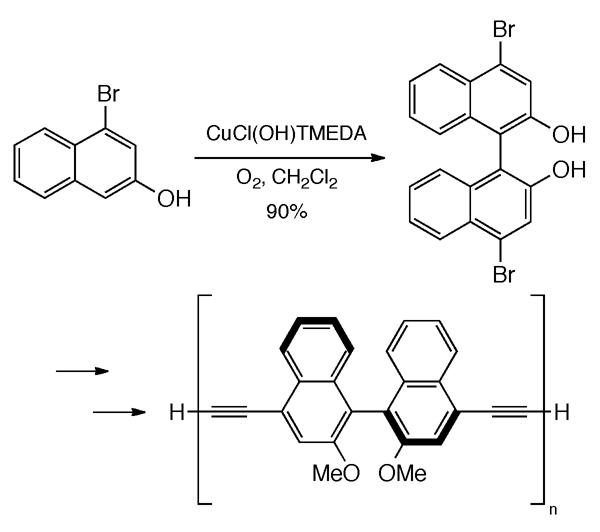
Oxidative coupling and diastereomeric resolution en route to binaphthol oligomers.
The racemic oxidative coupling and subsequent resolution of binaphthols is a popular paradigm in the development of chiral phosphines for asymmetric synthesis. Keay and co-workers used Nakajima's method to synthesize a racemic BINOL derivative (Scheme 380), and then resolved the racemates through their aminoboronated diastereomers, formed via reaction of the binaphthols first with BH3•SMe2, followed by the addition of proline.661 Subsequently, the enantiopure BINOL derivatives could be converted to the bisphosphines via O-activation and cross-coupling.
Scheme 380.
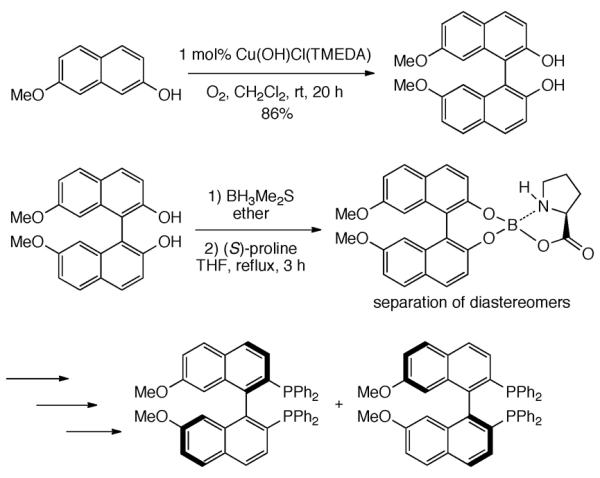
Synthesis of axially chiral phosphine ligands via racemic coupling and resolution of binaphthols.
Yudin and co-workers found Cu(OH)Cl(TMEDA) to be an effective catalyst for the cross-coupling of 2-naphthol and 5,6,7,8-tetrafluoro-2-naphthol (Scheme 381). The racemates were separated using fractional recrystallization of their menthol carbonates. This method proved less cumbersome than the Ullmann coupling for the synthesis of partially fluorinated systems.662
Scheme 381.

Cross coupling of 2-naphthol and tetrafluoronaphthol using Cu(OH)Cl(TMEDA).
Karikomi and co-workers used excess copper and an amine ligand perform aerobic oxidative coupling of hydroxybenzophenanthryl compounds (Scheme 382).663 The coupling of 3-hydroxychrysene proceeded as expected, but the coupling of 2-hydroxybenzo[c]phenanthrene yielded an overoxidized helical diphenoquinone product, the structure of which was confirmed by x-ray crystallography. While no enantioselectivity was seen in the reaction, only the (E)-isomer of the helical diphenoquinone product was formed. The origin of this stereoselection is unknown.
Scheme 382.
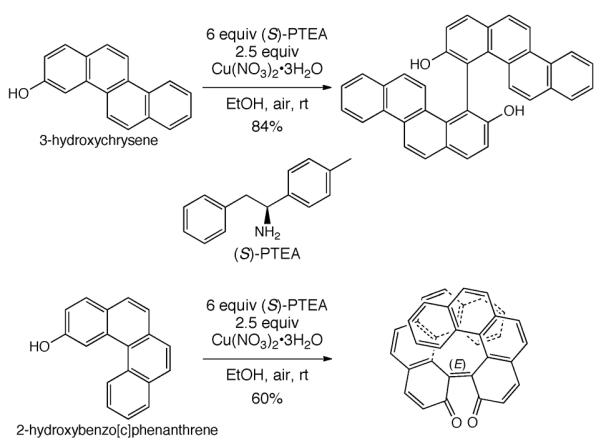
Aerobic synthesis of helical binaphthyls using stoichiometric copper.
VII.A.2. Diastereoselective Naphthol Couplings
The diastereoselective coupling of 2-naphthols is an effective method of generating axial chiral compounds with an achiral catalyst. Lipshutz and co-workers utilized a enantiopure tether to link two naphthols, which was followed by oxidative coupling with Cu(OH)Cl(TMEDA) to yield the binaphthol product as a single diastereomer (Scheme 383).664 This method has the added benefit of facilitating otherwise difficult cross-coupling reactions (see Section VII.A.4).
Scheme 383.
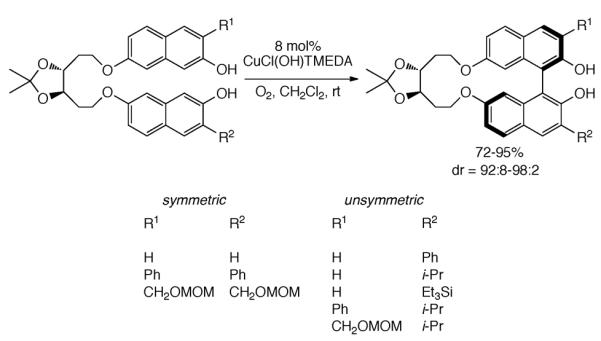
Diastereoselective intramolecular naphthol coupling.
Diastereoselective couplings can also be effected using chiral auxiliaries. Wang and co-workers used a proline methyl ester moiety to direct the copper-catalyzed coupling. The reaction proceeded in lower selectivity than in the tethered case, but chromatography of the resultant diastereomers, followed by acid hydrolysis of the auxiliaries, yielded the BINOL diacid in 97% ee and 30% overall yield (Scheme 384).665
Scheme 384.
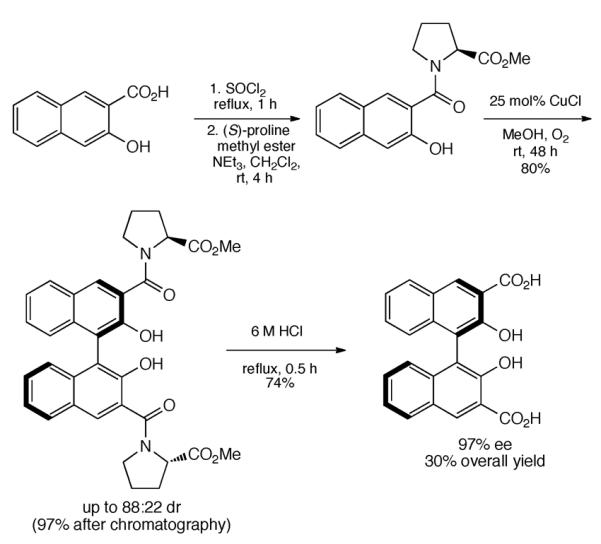
Diastereoselective coupling using a prolyl chiral auxiliary.
VII.A.3. Asymmetric Naphthol Couplings
The utility of axial chiral compounds as ligands and as precursors in biomimetic synthesis has driven the development of efficient methods for resolving these materials, especially of the parent BINOL (1,1'-binaphthalene-2,2'-diol).648 The finding that enzymatic systems can catalyze asymmetric naphthol coupling inspired the development of many small molecule catalysts.666
Stoichiometric copper-catalyzed anaerobic asymmetric biaryl couplings are known,667,668,669,670 though it is not always clear whether the initial coupling proceeds with selectivity or if a resolution of the resultant binaphthol occurs in situ.667b
Nakajima and co-workers reported the first catalytic asymmetric oxidative coupling of 2-naphthols. Building on their work using molecular oxygen with racemic copper catalysts,322 they employed a chiral copper catalyst derived from proline (Scheme 385). The selectivity could be improved by decreasing the temperature to ambient, but the coordinating group at the 3-position was needed for selectivity, a pattern that persists through much of the copper-catalyzed aerobic biaryl coupling studies. It was proposed that the copper binds through a chelated adduct (Scheme 386), as substrates without this coordinating group (e.g., 2-naphthol) gave no selectivity.671
Scheme 385.
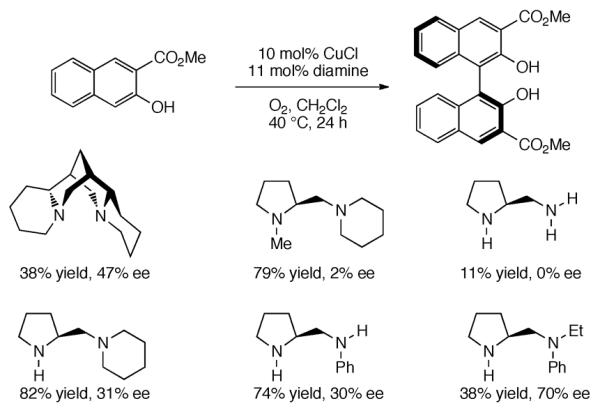
The first copper-catalyzed enantioselective naphthol coupling.
Scheme 386.

Scope of first copper-catalyzed enantioselective naphthol coupling.
Using computational chemistry methods, the Kozlowski lab identified diaza-cis-decalin as a ligand for the asymmetric oxidative coupling of 2-naphthols.672 Both enantiomers of the diaza-cis-decalin ligand could be isolated via a simple resolution, allowing for the selective synthesis of either biaryl enantiomer. Though the coordinating group at the 3-position was still needed, substantial variation in that group was tolerated (Scheme 387), allowing for the synthesis of sulfonyl- and phosphonyl-substituted BINOL compounds. Highly substituted substrates could be coupled effectively (Scheme 388), although very electron-rich substrates underwent atropisomerization in situ (Scheme 388, entries 12–13).
Scheme 387.
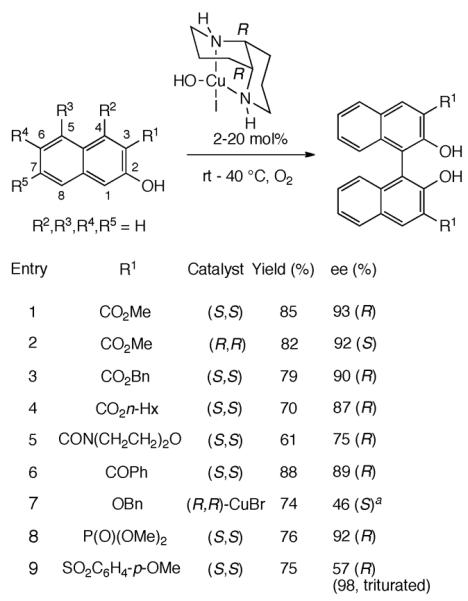
Scope of coordinating group in diaza-cis-decalin catalyzed asymmetric naphthol coupling.
Scheme 388.
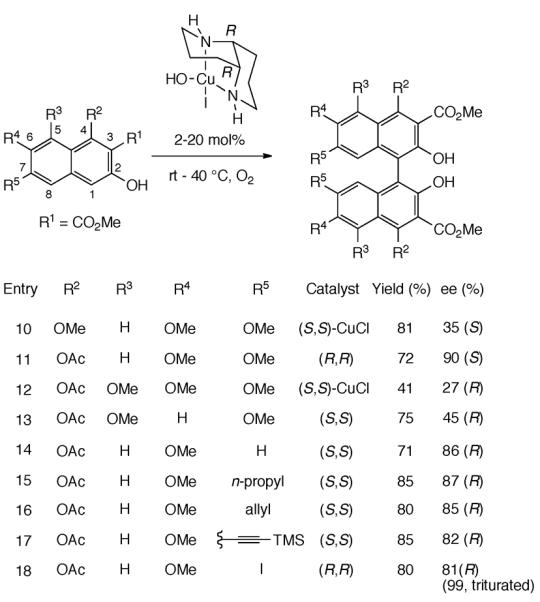
Highly substituted substrates in the diaza-cis-decalin-catalyzed asymmetric naphthol coupling.
The diaza-cis-decalin-catalyzed asymmetric coupling has been applied to the total synthesis of a number of natural products, including nigerone, several perylenequinones, and bisoranjidiol. In the total synthesis of nigerone (Scheme 389), flavasperone was synthesized and treated to oxidative coupling conditions to yield bisisonigerone. Base-mediated isomerization and trituration yielded the natural product in 50% yield and 90% ee.673
Scheme 389.
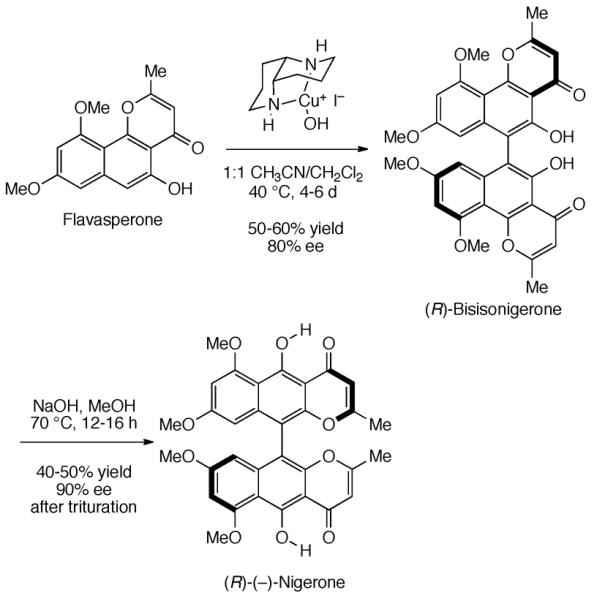
Asymmetric naphthol coupling in the synthesis of nigerone.
The oxidative coupling was also utilized in the synthesis of several perylenequinones674 and perylenequinone natural products (Scheme 390).675 The highly stereoregular asymmetric coupling could provide either enantiomer of the axial chiral bisiodide shown in Scheme 390, from which a biscuprate could be generated and added to either enantiomer of propylene oxide. This allowed for selective synthesis of the diastereomeric series leading to cercosporin, calphostin D, and phleichrome.675
Scheme 390.
Asymmetric naphthol coupling in the synthesis of perylenequinone natural products.
Incorporation of a ketone substituent into the enantiomer of the axial chiral bisiodide followed by dynamic stereochemistry aldol reaction provided the natural product hypocrellin A (Scheme 391).675 These methods allowed for the generation of enantiopure helical chiral perylenequinones devoid of other stereocenters. Atropisomerization studies of these compounds proved that they are configurationally stable at ambient temperatures.674 A number of novel perylenequinones were also generated for structure activity relationship and biological activity studies.675b
Scheme 391.
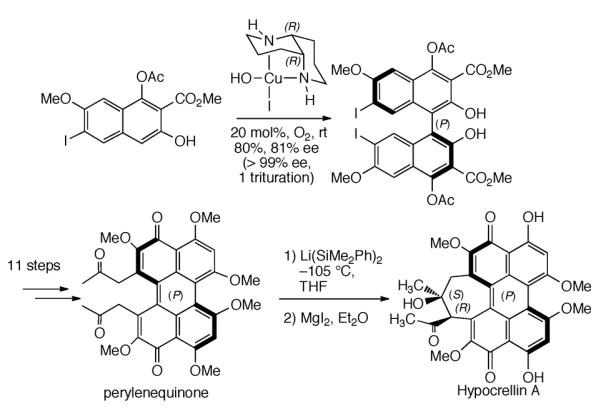
Asymmetric biaryl coupling and dynamic aldol reaction in the synthesis of hypocrellin A.
Kozlowski and Podlesny applied the asymmetric biaryl coupling using an copper(II)-diaza-cis-decalin complex to the first total synthesis of the 1,1'-linked bisanthraquinone natural product (S)-bisoranjidiol (Scheme 392).676 Enantioselective oxidative biaryl coupling of the sterically hindered 8-substituted naphthol yielded the biaryl in 62% yield and 87% ee; the enantiomeric excess was enhanced to 99% ee with a single trituration. This oxidative coupling represents the most selective coupling of a 2-naphthol with substitution in the 8-position. Further elaboration and oxidation led to the bisquinone. Subsequent halogen-directed Diels-Alder reaction followed by deprotection afforded the natural product.
Scheme 392.
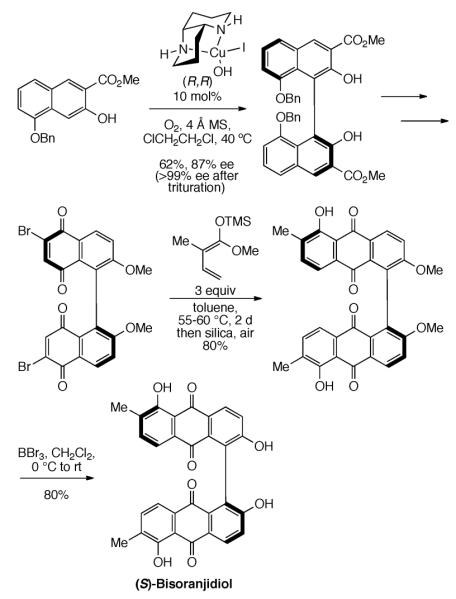
The first total synthesis of (S)-bisoranjidiol.
A mechanistic study of the diaza-cis-decalin-catalyzed biaryl coupling revealed different burst phases depending on the copper precatalyst, but the turnover-limiting step was the same oxidation step for all copper sources.677 The study showed that the copper catalyst generated a cofactor (NapHOX, Scheme 393) from a molecule of substrate, similar to what has been seen in the studies of the copper-containing enzyme amine oxidase.678 Unfortunately, the C–C bond forming step follows the turnover-limiting step, so few details are known about this portion of the process.
Scheme 393.

Mechanism of the copper diaza-cis-decalin catalyzed naphthol coupling.
A gas phase study by Roithová and co-workers showed that the CuCl(OH)TMEDA-catalyzed biaryl coupling occurs in clusters containing two copper atoms (Scheme 394). The role of the diamine is to support the dimeric clustering of copper and to weaken the Cu–OAr naphtholic bond, facilitating C–C bond formation.679 Further infrared multiphoton disassociation (IRMPD) spectroscopy and DFT calculations showed that the driving force for the coupling is the keto-enol tautomerization, which may occur while the initial adduct is still bound to copper. The DFT calculations showed that the C–O and O–O coupled side products are endothermic and thus disfavored. It is unclear if the more hindered diaza-cis-decalin complex behaves similarly in solution.
Scheme 394.
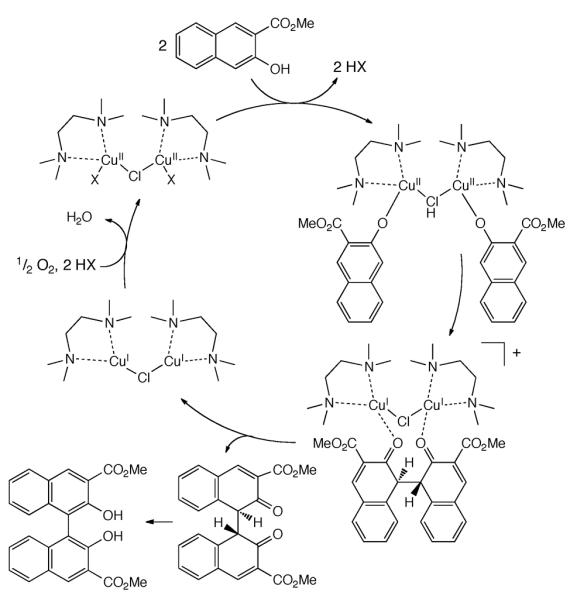
Mechanism of CuCl(OH)TMEDA-catalyzed biaryl coupling in the gas phase.
Additional copper catalysts have been developed more recently for the aerobic oxidative coupling of 2-naphthols (Scheme 395). A diamine ligand derived from BINAM provides the BINOL-3,3'-dimethyl dicarboxylate in high selectivity (Scheme 395a).680 A catalyst derived from ethylene diamine and R-(+)-camphor showed similar dependence on chelation, giving good selectivity for 3,3'-dicarboxylates but low selectivity for benzyl ethers and BINOL (Scheme 395b).681 A diamine catalyst with a ferrocenyl group gave moderate selectivity and yield for the dimethyl carboxylate (Scheme 395c)682. The diastereomeric ratio of the diamine is unknown. A proline methyl ester copper complex was used in the total synthesis of rigidanthin (Scheme 395d),683 the enantiopurity of which was ascertained by comparison of the optical rotation to that of the natural source. The absolute stereochemistry was assigned using comparison of optical rotation with that of similar compounds.684 Martell and co-workers developed the first copper catalyst to provide high selectivity in nonchelating substrates using a biscuprate salan catalyst complex (Scheme 395e).685 In their pursuit of polynaphthalenes with BINOL units, Habaue and co-workers used a copper PhBox complex to generate the methyl ether-substituted product with moderate selectivity (Scheme 395f).686
Scheme 395.
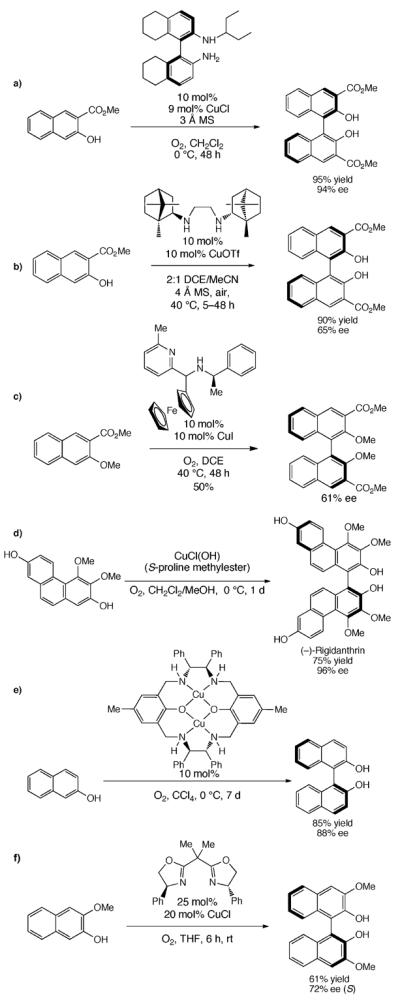
Formation of binaphthols and related compounds via oxidative coupling with other copper catalysts and oxygen.
The earliest methods of synthesizing enantiopure BINOL relied on oxidative coupling to generate the racemic dimer, followed by resolution of diastereomers.648 One of the earliest asymmetric 2-naphthol couplings with stoichiometric copper catalysts by Brussee and coworkers668a was determined to be a thermodynamic resolution.668b Wulff and coworkers have recently reported a thermodynamic kinetic resolution of BINOL and vaulted biaryls that affords enantiomerically pure biaryl in nearly quantitative yield (Scheme 396).687 Oxidation of copper(I) chloride and concurrent complexation with either (−)-sparteine or O'Brien's (+)-sparteine surrogate generates the active copper(II) complex. Treating the racemic biaryl mixture with this complex under argon, followed by either acid or base quench generates the resolved enantioenriched biaryl. Notably, the enantioselectivity is improved by using CuCl premixed with sparteine and oxygen instead of CuCl2 and sparteine without the oxygen pre-treatment.
Scheme 396.
Dynamic thermodynamic resolution of BINOL and vaulted biaryls.
The difference in thermodynamic stability between the matched and mismatched copper binaphthol adducts forms the basis for this dynamic thermodynamic resolution. Two possible pathways are proposed to account for the equilibrium between the matched and mismatched complexes (Scheme 397). Both pathways depend on the formation of an sp3-hybridized intermediate, which can allow for rotation about the biaryl axis. In pathway A, addition of HCl weakens one copper-oxygen bond, protonating an axis carbon. Rotation about the sp2–sp3 bond, followed by release of HCl, generates the matched complex. In pathway B, valence tautomerization of the copper-oxygen bond results in the formation of an sp3 carbon-copper bond and enables rotation of the biaryl axis. Further valence tautomerization regenerates the copper-oxygen bond, now in a matched complex.
Scheme 397.
Two possible pathways for the dynamic thermodynamic resolution of BINOL and vaulted biaryls.
VII.A.4. Hetero Couplings of Naphthols
The oxidative cross-coupling of two different naphthol substrates remains a significant challenge. Copper-catalyzed heterocouplings require a disparity in arene electronics, though even then the chemoselectivity and enantioselectivity are only moderate.672,688 A copper (+)-PhBox catalyst has been used to cross-couple electron rich and electron poor substrates with moderate selectivity (Scheme 398, top). However, the addition of a Lewis acid such as Yb(OTF)3 significantly improves the reaction outcome (Scheme 398, bottom).689
Scheme 398.
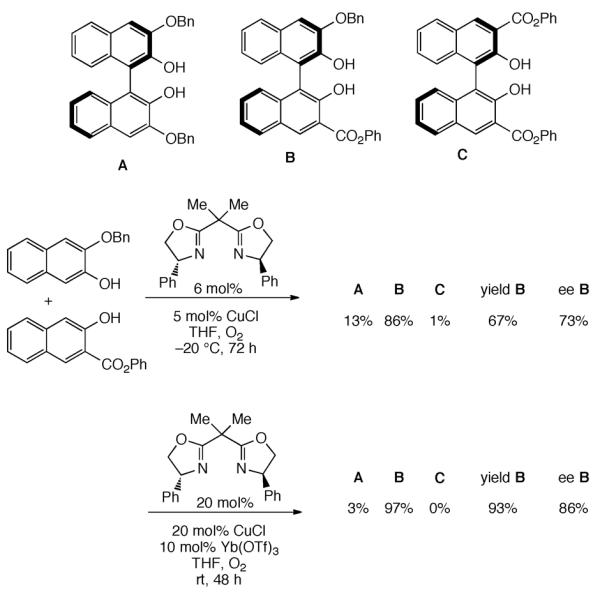
Enantioselective cross coupling of naphthols.
Interestingly, the addition of a Lewis acid also improved the selectivity of the racemic heterocoupling catalyzed by CuCl(OH)TMEDA. A mechanism that explains this improvement is outlined in Scheme 399. The Lewis acid coordinates to the chelating substrate while the copper catalyst binds and then oxidizes the more electron rich substrate. Coupling occurs, followed by single electron oxidation and keto-enol tautomerization to yield the heterobinaphthol product. Given that copper catalysts do not typically give high selectivity with nonchelating substrates (see Section VII.A.3) many questions remain about this mechanism.
Scheme 399.
Mechanism of cross-coupling with Lewis acid.
Oxidative heterocoupling has also been used by Yudin and co-workers in the synthesis of partially fluorinated BINOL ligands for asymmetric sulfide oxidations (Scheme 381).662 While the chemoselectivity was low, these conditions were still an improvement over the Ullmann coupling.
Habaue and co-workers have investigated the asymmetric cross-coupling of linked naphthol compounds as model systems for the enantioselective polymerization reaction (see Section VII.C.1.c). Treatment of two linked methoxymethylether-capped monomers of differing electronics with a copper-bisoxazoline catalyst gave excellent selectivity for the cross-coupled product though the enantioselectivity was low (Scheme 400).690 Similarly, a pivalate-capped electron-rich 2,6-naphthalene diol underwent effective cross-coupling with a linked electron-poor monomer to yield the heterocoupled product in comparable isolated yield and slightly higher enantioselectivity (Scheme 401).691
Scheme 400.
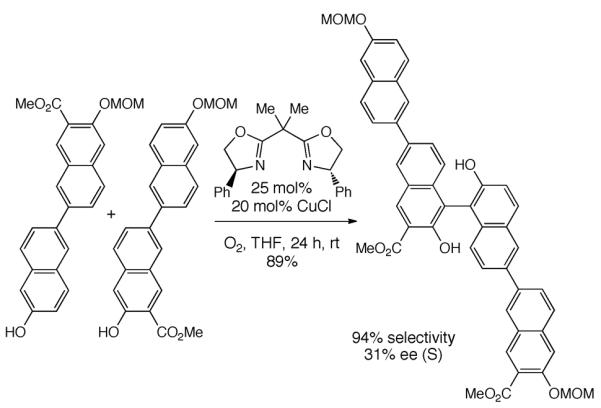
Oxidative aerobic cross-coupling of linked naphthol units.
Scheme 401.
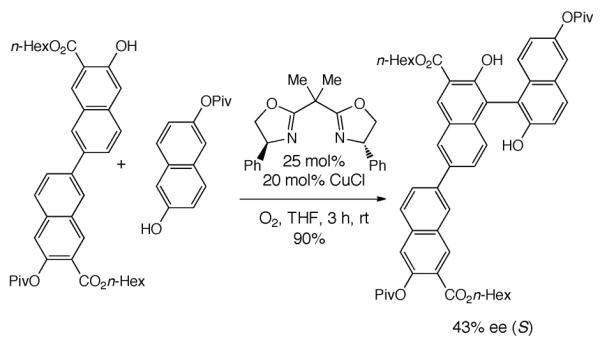
Asymmetric oxidative cross-coupling of an electron-rich capped 2,6-naphthalene diol with a linked electron-poor monomer.
VII.B. Phenol Dimerization
Compared to the oxidative dimerization of naphthols, the copper-catalyzed aerobic oxidative coupling of phenols is a much more difficult transformation. Though many bioinspired catalysts have been developed,79 much work remains in the design of catalysts that can control product ratios in substrates with multiple reactive sites.
VII.B.1 Intermolecular Phenol Couplings
The oxidative coupling of phenols grew from studies on the oxidative polymerization of 2,6-dimethylphenol.692 In early studies of this process, Hay and co-workers at General Electric isolated diphenoquinone byproducts, eventually determining reaction conditions to maximize diphenoquinone formation and minimize polymerization.693 Like the oxidative coupling of naphthols, the oxidative coupling of phenols is typically a very substrate-dependent reaction. Control of the reaction products requires careful selection of both substitution pattern and reaction conditions (Scheme 402). Due to the resonance stabilization of the phenol radical, only the para- and ortho- positions participate in coupling, so some control of reactivity can be gained by blocking these sites. Even when phenols have only one reactive site, multiple products can still arise from C-C or C-O coupling depending on the reaction conditions. Phenols with multiple reactive sites typically generate complex mixtures of products. Notably, phenol dimerization competes with phenol oxygenation under many conditions using copper catalysts with oxygen (see Section VII.D).
Scheme 402.
Product distributions on the copper-catalyzed aerobic oxidative dimerization of phenols.
Table 16 outlines the outcome of phenol dimerization by class of substrate. In general, 2,6-disubstituted phenols form diphenoquinones (Entries 1–7, 10–22) and C–O-coupled polymers (Section VII.D), the former dominating in the case of sterically bulky phenols, while careful control of conditions can allow for isolation of para-coupled phenols (Entries 8 and 9). Better chemoselectivity is seen in 2,3,6-trisubstituted phenols.709 In cases where the para-position is blocked, such as in 2,4-disubsituted phenols, ortho-coupling dominates (Entries 28–32, 38), though further oxidation of the reaction product can lead to oxidative cyclization (Entries 33–37, 39). The oxidative dimerization of monosubstituted phenols is far less common due to the higher oxidation potential of these compounds. The availability of two reactive ortho-positions can lead to oligomerization (Entries 42 and 43).
Table 16.
Oxidative dimerization of phenols using copper and molecular oxygen.
| Entry | Starting Material | Product(s) | Copper Complex | conditions | Yield (%) | ref |
|---|---|---|---|---|---|---|
| 2,6-disubstitutcd phenols | ||||||
|
| ||||||
| 1 |
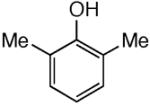
|
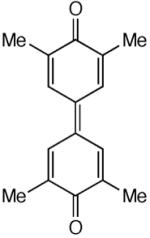
|
12 mol% CuCl | O2, DMA, 90 °C, 40 Min | 74 | 693 |
| 2 |
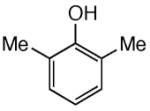
|
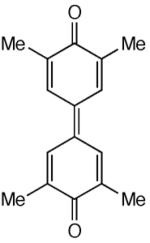
|
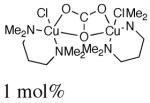
|
O2, CH2Cl2, 15 Min | not given | 694 |
| 3 |
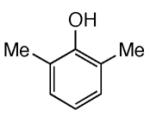
|
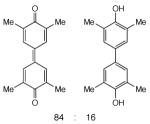
|
7.4 mol% CuC 14.8 mol% TMEDA | O2, neat, 85°C | 55 | 695, 696 |
| 4 |
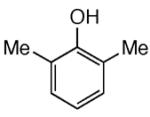
|

|
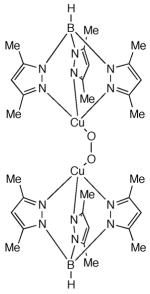
|
O2, CH2Cl2, rt, 2 h | TON = 2 h−1 | 697 |
| 5 |
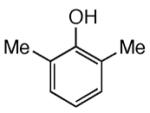
|
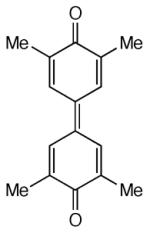
|
0.1 mol% Cu(II)-urea oligomer | air, CHCl3, rt, 3 h | 35 | 698 |
| 6 |
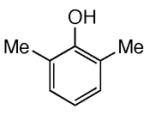
|
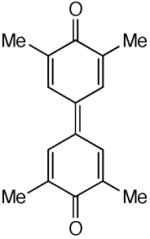
|
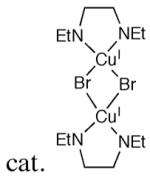
|
O2, CH2Cl2, rt | not given | 699 |
| 7 |
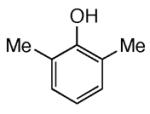
|
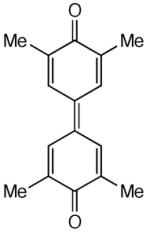
|
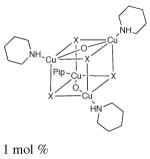
|
O2, CH2Cl2, rt | not given | 700 |
| 8 |
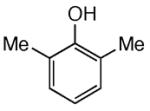
|
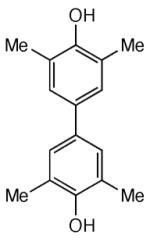
|
0.5 mol% Cu(OAc)2 0.17 mol% sodium lauryl sulfate | O2, NaHCO3 H2O, 80 °C, 6 h | 80 | 701 |
| 9 |
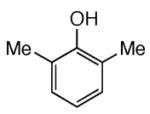
|
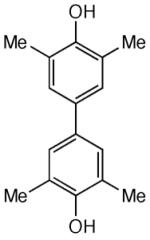
|
0.25 mol% 0.5 mol% Cu(OAc)2 | O2, 1M NaOH, H2O, 60 °C, 6 h | 62 | 702 |
| 10 |
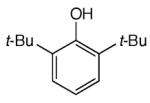
|
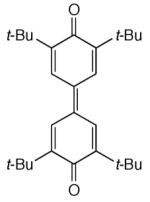
|
0.075 mol% CuCl(OH)TMEDA | O2, MeOH, 50 °C, 3.5 h | 38 | 703 |
| 11 |
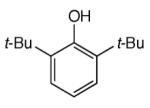
|

|
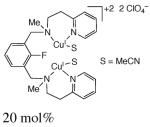
|
O2, phosphate buffer (pH=6.8), 6 h | 85 | 703 |
| 12 |

|
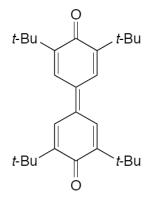
|
Cu(NO3)2 | 02, MeCN | 100 | 704 |
| 13 |

|
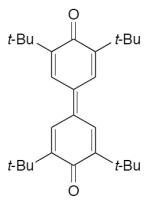
|
1.3 mol% Cu(morpholine-)2Cl2 | O2, MeOH, rt, 3 h | 90 | 715 |
| 14 |
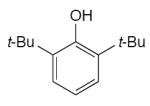
|
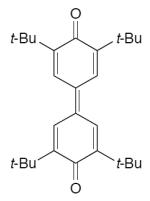
|
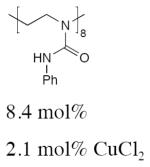
|
02, MeOH, PhH, rt, 20 h | 80 | 705 |
| 15 |

|
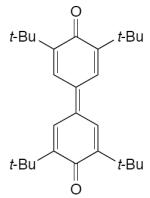
|
5 mol% Cu(OAc)2 20 mol% LiBr | 02, AcOH/Ac2O, 70 °C, 1 h | 60 | 104 |
| 16 |
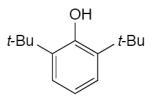
|
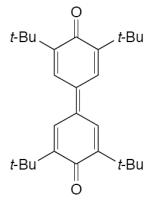
|
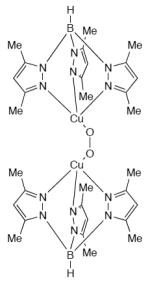
|
O2, CH2Cl2, rt, 2 h | TON = 2.3 | 697 |
| 17 |

|
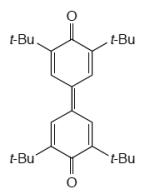
|
Cu(II)-poly(vinylpyridine) KOH | O2, CHCl3/MeOH, 30 °C | not given | 697 |
| 18 |
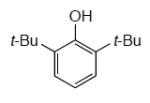
|

|
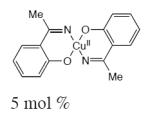
|
O2, DMF, 24 h, rt | not given | 706 |
| 19 |
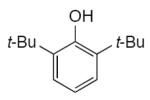
|

|
cat. CuCl cat. TMEDA | O2, 97 °C, 1 h | 47 | 707 |
| 20 |
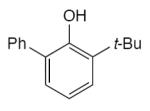
|
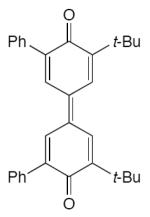
|
25 mol% CuCl 50 mol% TMEDA | O2, 95% EtOH, 2 h, rt | 86 | 708 |
| 21 |

|
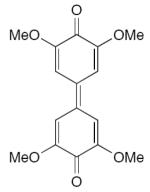
|
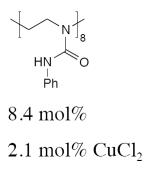
|
O2, MeOH, PhH, rt, 20 h | 91 | 705 |
| 22 |

|
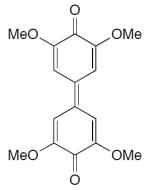
|
1.1 mol% Cu(morpholine-)2Cl2 | O2, MeOH, rt, 3 h | 85 | 715 |
|
| ||||||
| 2,3,6-trisubstituted phenols | ||||||
|
| ||||||
| 23 |
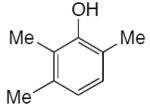
|
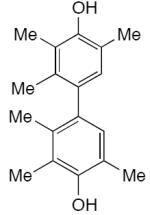
|
0.01 mol% Cu(OAc)2 sodium lauryl sulfate NaOH (ph = 13 ± 0.5) | O2, H2O, 85 °C | 89 | 709 |
|
| ||||||
| 2,4,6-trisubstituted phenols | ||||||
|
| ||||||
| 24 |
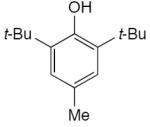
|
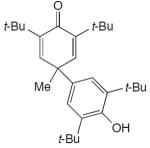
|
22 mol% CuCl morpholine | O2, MeOH, rt, 3 h | 85 | 715 |
| 25 |
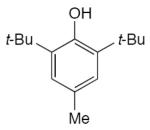
|
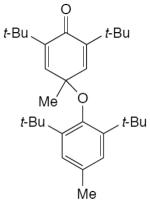
|
1.4 mol% Cu(morpholine-)2Cl2 | O2, MeOH, rt, 3 h | 90 | 715 |
| 26 |

|
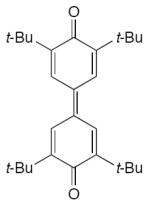
|
47 mol% CuCl morpholine | O2, MeOH, rt, 3 h | 95 | 715 |
|
| ||||||
| 2/1-disubstitutcd phenols | ||||||
|
| ||||||
| 27 |
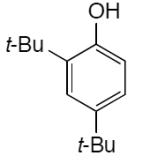
|
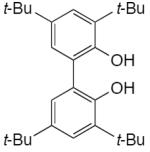
|
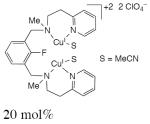
|
O2, phosphate buffer (pH=6.8), 6 h | 91 | 710 |
| 28 |
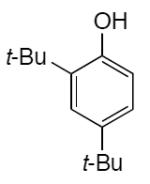
|
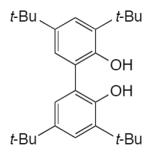
|
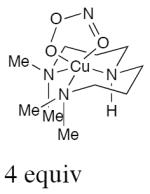
|
O2, CH2Cl2, rt, 20 min | 80 | 711 |
| 29 |
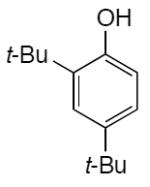
|
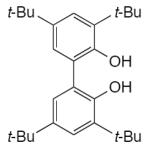
|
2.8 equiv Cu(OAc)2 7.6 equiv imidazole | CHCl3, MeOH rt, 3 h | 80 | 715 |
| 30 |
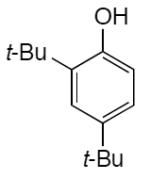
|
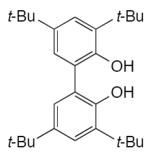
|
0.5 mol% CuCl 1 mol% TMEDA | air, o-dichlorobenzene, 40 °C, 2 h | 91 | 712 |
| 31 |

|

|
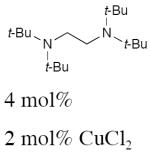
|
O2, MeOH, rt, 30 min | 86 | 713 |
| 32 |
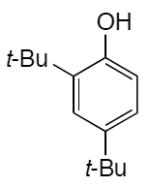
|
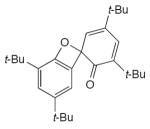
|
8 mol% CuCl 8 mol% TMEDA | air, EtOH, 40 °C, 2 h | 64 | 712 |
| 33 |
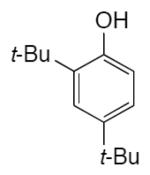
|
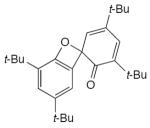
|
94 mol% Cu(morpholine)2Cl2 | O2, MeOH, MeCN, rt, 3 h | 95 | 715 |
| 34 |
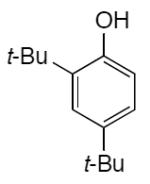
|

|
2 mol% CuCl2 4 mol% ethylene diamine | O2, MeOH, 25 °C, 24 min | 85 | 714 |
| 35 |
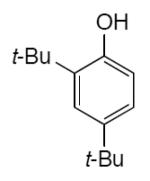
|
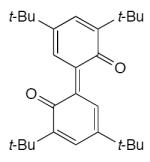
|
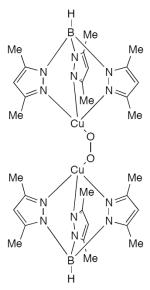
|
O2, CH2Cl2, rt, 2 h | TON = 8.5 h−1 | 697 |
| 36 |
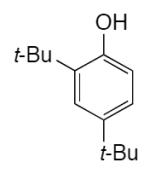
|
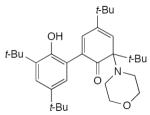
|
4.9 mol% CuCl morpholine | O2, MeOH, rt, 3 h | 60 | 715, 716 |
| 37 |
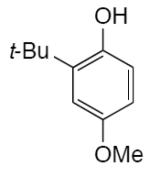
|
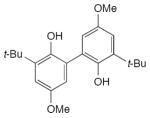
|
0.59 mol% Cu(morpholine)2Cl2 | O2, MeOH, rt, 3 h | 90 | 715 |
| 38 |
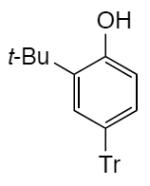
|
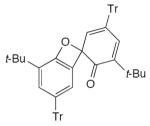
|

|
O2, KOH, MeOH, 3 Å MS, 35 °C, 4 h | 64 | 717 |
|
| ||||||
| 2,4,5-trisubstitutcd phenols | ||||||
|
| ||||||
| 39 |
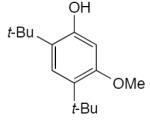
|
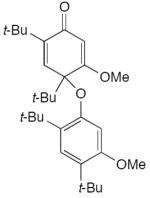
|
24 mol% CuCl pyridine | O2, MeOH, rt, 3 h | 80 | 715 |
| 40 |
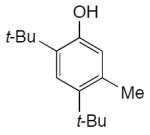
|
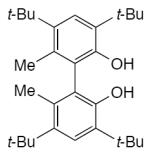
|
cat. CuCl2 cat. TMEDA | air, MeOH, 50 °C, 1 h | 84 | 707 |
|
| ||||||
| 4-substituted phenols | ||||||
|
| ||||||
| 41 |

|
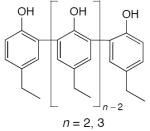
|
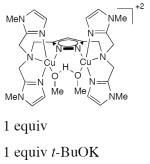
|
O2, MeCN/CH2Cl2 | 65 | 718 |
|
| ||||||
| 3/1-disubstitutcd phenols | ||||||
|
| ||||||
| 42 |
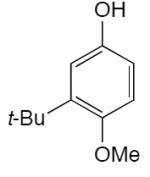
|
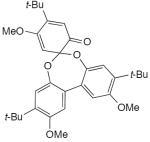
|
2.3 mol% Cu(morpholine)2Cl2 | O2, MeOH, rt, 3 h | 95 | 715 |
|
| ||||||
| catechols and hydroquinones | ||||||
|
| ||||||
| 43 |
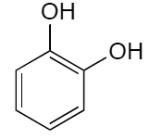
|
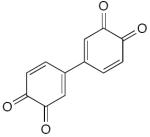
|
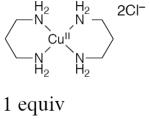
|
O2, EtOH, AcOH, 78 °C, 3 h | 75 | 650 |
| 44 |
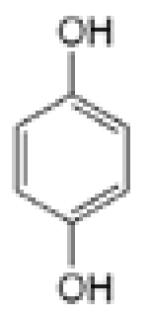
|
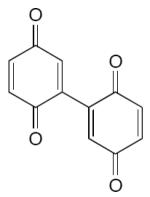
|
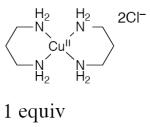
|
O2, EtOH, AcOH, 78 °C, 3 h | 75 | 650 |
| 45 |
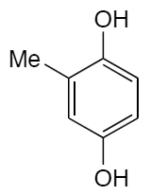
|
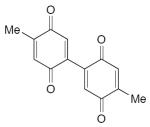
|
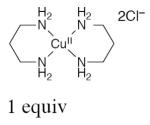
|
O2, EtOH, AcOH, 78 °C, 3 h | 75 | 650 |
| 46 |
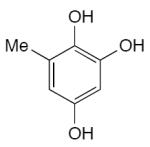
|

|
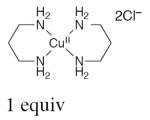
|
O2, EtOH, AcOH, 78 °C, 3 h | 65 | 650 |
The ortho-ortho-coupling of 2,4-di-tert-butylphenol is proposed to proceed through a binuclear diradical mechanism; the rate determining-step is deprotonation719 or coordination of a molecule of phenol immediately prior to the coupling step (Scheme 403).714 Note that the peroxide-bridged diradical species is unstable and likely undergoes rapid fragmentation to the copper(II) complex. However, the nature of the rate-determining step can be catalyst-dependent.720 In the presence of protic solvents the dimer formed initially undergoes further reaction, generating either an oxetane711 and or a furan tricycle714 (Scheme 404). Interestingly, substitution at the meta-position prevents this additional oxidation step.707 Treatment of the ortho-ortho-coupled product with CuCl2 and pyridine in the presence of oxygen and KOH in methanol also leads only to the benzooxetane product.715
Scheme 403.
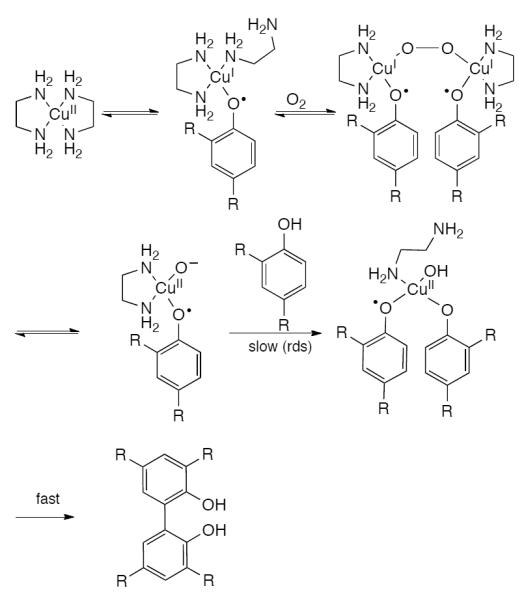
Proposed reaction mechanism to bisphenol.
Scheme 404.
Formation of a furan tricycle and oxetane from the ortho-coupled product of 2,4-di-tert-butylphenol.
Becker and Gustafsson examined the utility of the benzooxetanes formed by the aerobic copper-catalyzed oxidative coupling of 2,4-di-tert-butylphenol in alcoholic solvents.717 Treatment of these compounds with primary amines at high temperature leads to formation of unsaturated ring expanded lactams (Scheme 405). The reaction is believed to occur via a 6-amino-2,4-cyclohexadienone, (II, Scheme 406) formed by nucleophilic displacement of a spirocyclic phenol ether I. Sigmatropic ring opening followed by tautomerization yields the lactam product. In the case of secondary amines, intermediate II can be isolated in high yield (Scheme 407).
Scheme 405.
Formation of unsaturated lactams from benzooxetanes.
Scheme 406.
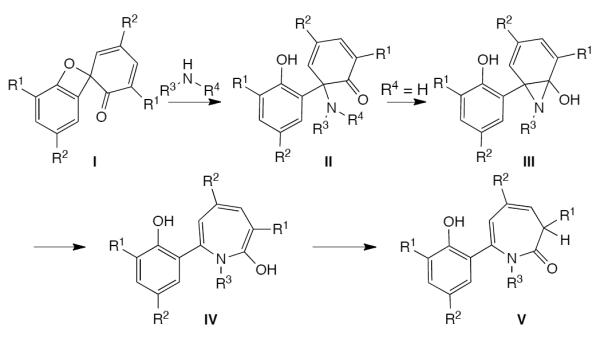
Proposed mechanism for the formation of unsaturated lactams from benzooxetanes.
Scheme 407.
Trapping of the 6-amino-2,4-dieneone intermediates with secondary amines.
VII.B.2 Intramolecular Phenol Couplings
While the intramolecular coupling of phenols and naphthols was first established as a viable synthetic transformation by Sir Derek Barton and co-workers,642a the first application of aerobic copper-catalyzed intramolecular coupling was reported by Kametani in 1976.721 The treatment of (+)-reticuline perchlorate with cuprous chloride and pyridine under O2 yielded (+)-corytuberine in 28% yield (Scheme 408). Use of the free base of (+)-reticuline resulted in an intractable tarry mixture.
Scheme 408.
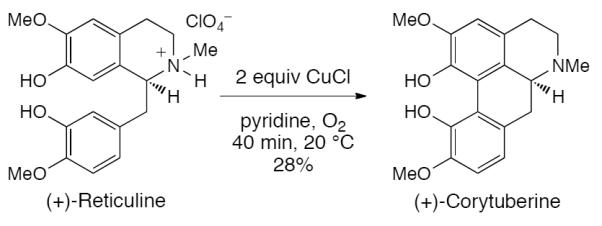
Intramolecular biomimetic phenol coupling to (+)-corytuberine with copper and oxygen.
An intramolecular oxidative coupling was employed in the total synthesis of the endothelin converting enzyme inhibitor TMC-66 (Scheme 409). Treatment of the alkyl-linked bisphenol with three equivalents of Cu-NMI complex under air in the penultimate step of the synthesis provided the coupled product in excellent yield. Notably, no other conditions were able to efficiently promote the desired transformation. Subsequent treatment with BBr3 revealed the desired natural product.722
Scheme 409.
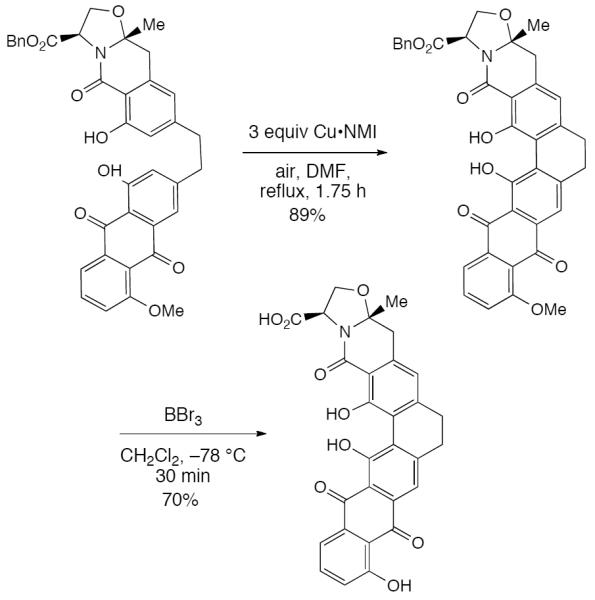
Intramolecular phenol coupling in the total synthesis of TMC-66.
VII.C. Naphthol and Phenol Polymerization
VII.C.1. C-C Naphthol Polymers
Oligomerization and polymerization of various 2-naphthol monomers and dimers has been well studied. In order to obtain polymers, two naphthol functional groups capable of oxidative coupling are required. For monomers containing a single naphthalene ring, there are three parent substitution patterns that lead to efficient coupling to form 1,2'-binaphthyl linkages (Scheme 410.a). Alternately two oxidizable naphthol units can be linked together in a number of different ways (Scheme 410.b). More rarely, two different oxidizable groups can be employed (Scheme 410.c), a scenario which requires control of homo- vs. heterocoupling in order to generate a defined oligomer or polymer. This method has usually been employed in the asymmetric oxidative polymerization (see Section VII.C.1.c below).
Scheme 410.
Monomers for naphthol polymerization.
VII.C.1.a Racemic Naphthol Polymerization
Examples of racemic products from the polymerization motifs outlined in Scheme 410 can be found in Table 17.
Table 17.
Racemic copper-catalyzed aerobic oxidative polymerization of naphthols.
| Entry | Monomer | Cu cat | Ligand | Conditions | MW | MN | MW/MN | Yield (%) | Ref |
|---|---|---|---|---|---|---|---|---|---|
| Naphthols with two reactive sites | |||||||||
|
| |||||||||
| 1 |

|
5 mol% CuCl(OH)TMEDA | - | Air, MeO(CH2)2O H, 25 °C, 3 h | - | 52,000 | 1.8 | 100 | 723 |
| 2 |
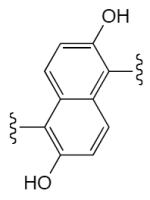
|
5 mol% Cu(EDTA)•4H2O | 14 equiv (HOCH2)3CNH2 | Air, H2O, rt, 24 h | - | 5,300 | 4.19 | 71 | 724 |
| 3 |

|
20 mol% CuCl2 |
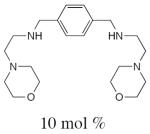
|
O2, CH2Cl2/Me0 H, rt, 48 h | - | 4,400 | 1.8 | 79 | 725 |
| 4 |
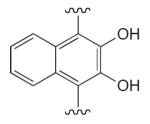
|
20 mol% CuCl2 |
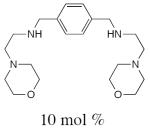
|
O2, CH2Cl2/Me0 H, rt, 48 h | - | 4,400 | 3.0 | 63 | 725 |
|
| |||||||||
| Two Linked Naphthols | |||||||||
|
| |||||||||
| 5 |
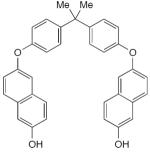
|
5 mol% CuCl(OH)TMEDA | air, CH2Cl2, rt, 24 h | 33,0 00 | 12,700 | 2.6 | 98 | 726 | |
| 6 |

|
5 mol% CuCl(OH)TMEDA | air, NMP, MeO(CH2)2O H, 18 h, rt | - | 10,500 | 4.1 | 83 | 727 | |
VII.C.1.b Diastereoselective Naphthol Polymerization
The availability of enantiopure BINOL derivatives has led to the development of methods for diastereoselective naphthol polymerization. Okamoto and co-workers found that for optimum stereocontrol of the resulting polymer, the stereochemistry of the monomer and amine ligand must be properly matched. While a matched case can give up to 84:16 (R):(S) ratio of axial stereocenters in the product, a mismatched case can drop the ratio to nearly 1:1 (Scheme 411).728 However, using the PhBox ligand completely overrides the stereochemistry of the monomer, resulting in complete ligand control (Scheme 412), an effect seen both with both binaphthol and trinaphthol monomers,686,729 as well as dihydroxyquaternaphthyl derivatives (Scheme 413).730
Scheme 411.
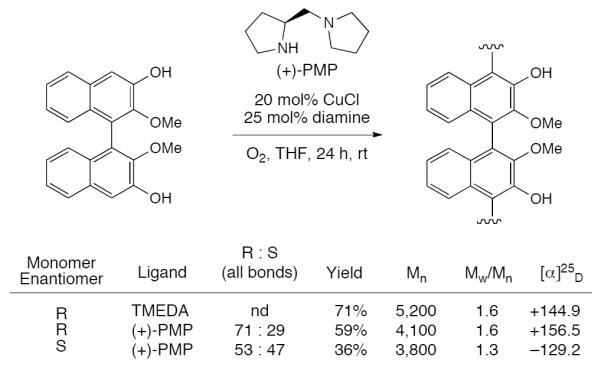
Matched and mismatched cases in the diastereoselective AOCP.
Scheme 412.
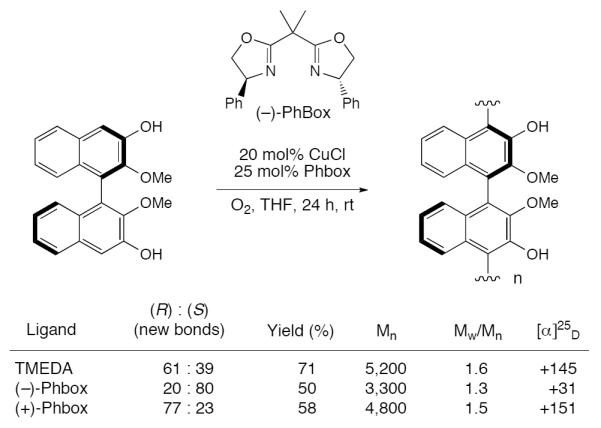
PhBox ligand overrides the stereochemistry of monomer in diastereoselective AOCP.
Scheme 413.
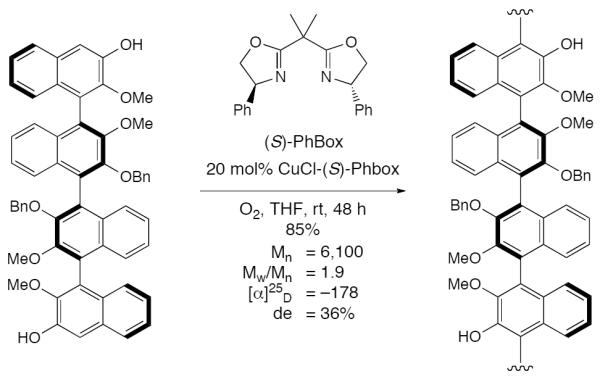
Polymerization of dihydroxyquaternaphthyl derivatives.
VII.C.1.c. Enantioselective Naphthol Polymerization
The utility of the PhBox ligand in controlling the absolute stereochemistry is illustrated in the polymerization of achiral monomers such as 2,3-dihydroxynaphthalene (Scheme 414). Though no optical rotation was reported for the larger polymers due to solubility problems, a test coupling using a capped monomer, 3-benzyloxy-2-naphthol, gave 43% ee (S), when exposed to reaction conditions.727
Scheme 414.
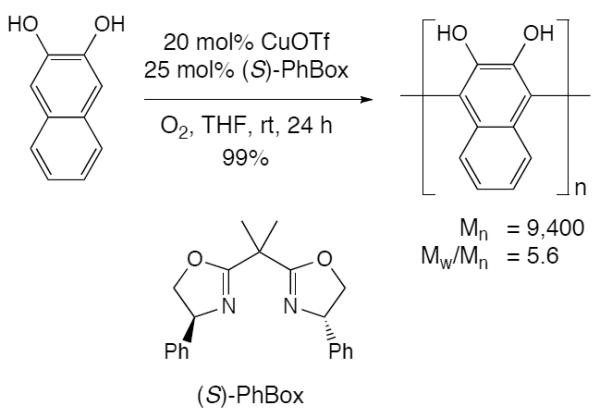
Asymmetric oxidative coupling polymerization of an achiral monomer with a chiral catalyst.
Realizing that copper-diamine complexes under aerobic conditions can catalyze both the oxidative asymmetric biaryl coupling (Section II.D.2) and the Glaser-Hay coupling (Section VII.A), Kozlowski and co-workers applied the diaza-cis-decalin catalyst to the tandem polymerization reaction. Starting from an achiral alkynyl 2-naphthol, the resulting polymer formed in 83% yield with approximately 73% ee at each biaryl bond, demonstrating a useful approach for the organized assembly of multifunctional substrates in a single operation (Scheme 415).731
Scheme 415.
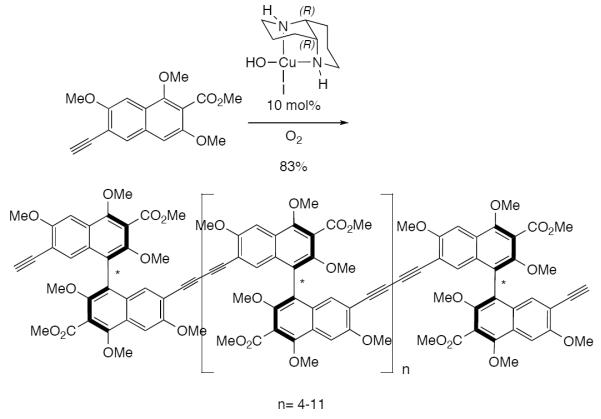
Tandem asymmetric naphthol coupling and Glaser-Hay coupling.
VII.C.1.d Hetero Coupling Naphthol Polymerization
The combined utility of the PhBox diamine ligand for the asymmetric oxidative biaryl heterocoupling (Section VII.A.4) and for oxidative polymerization (above) has led to its application in cross-coupling polymerization reactions. Again, the combination of an electron rich and electron poor substrate is crucial. As seen in Scheme 416, a very chemoselective (80%) oxidative coupling can arise.688c Since multiple axial chiral bonds are formed, diastereoselection becomes relevant. Here, the diastereoselection is poor and the enantioselection in the chiral C2 diastereomer is moderate.
Scheme 416.
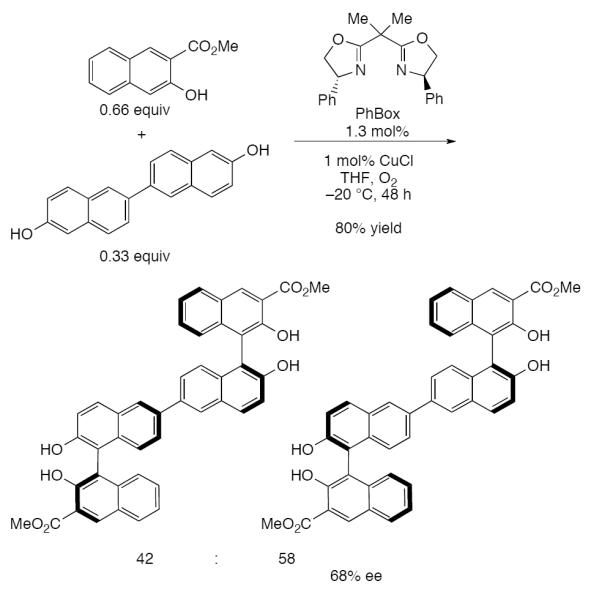
Enantioselective cross coupling oligomerization.
By varying the connectivity of the substrates, one of which contains a deactivating, but chelating electron-withdrawing group and the second of which is electron-rich an highly reactive, Habaue and coworkers have synthesized a number of interesting polymers. For example, a heterodimeric monomer consisting of one electron poor naphthol and one electron rich naphthol linked through the 6,6'-position yielded a polymer with a 96:4 selectivity for cross-coupled biaryl linkages (Scheme 417).690 The cross-coupling of symmetric 6,6'-linked monomers resulted in a polymer consisting of alternating monomeric units, with a 93:7 selectivity for cross-coupled linkages (Scheme 418). Lower selectivity (74:26) was seen when 2,6-dihydroxynaphthalene was used in place of the bi-6,6'-naphth-2-ol (Scheme 419).732 Combining both the electron-rich and the electron-poor moieties into one naphthalene unit resulted in a completely racemic polymer (Scheme 420), although a small amount of enantioselectivity was seen with higher copper loading and a full equivalent of (−)-sparteine with respect to monomer.691 A series of hyperbranched polymers were also synthesized using this method. Interestingly, the stereoselectivity in the polymerization was much lower with substrates lacking a chelating group in the C3-position (Scheme 421).733
Scheme 417.
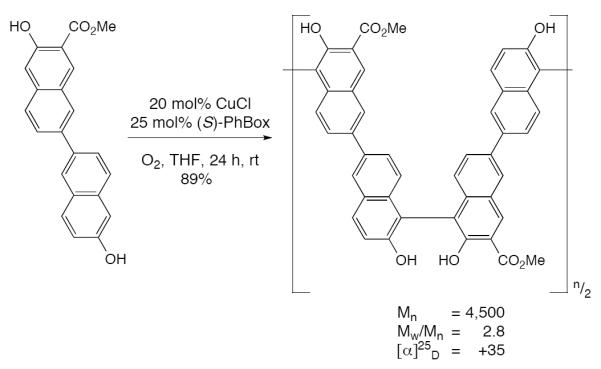
Heteropolymerization of a heterodimeric monomer using copper and molecular oxygen.
Scheme 418.
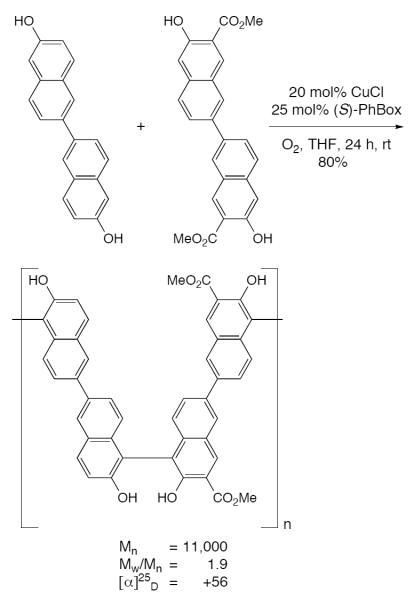
Heterocoupled polymerization of two 6,6'-homodimeric monomers.
Scheme 419.
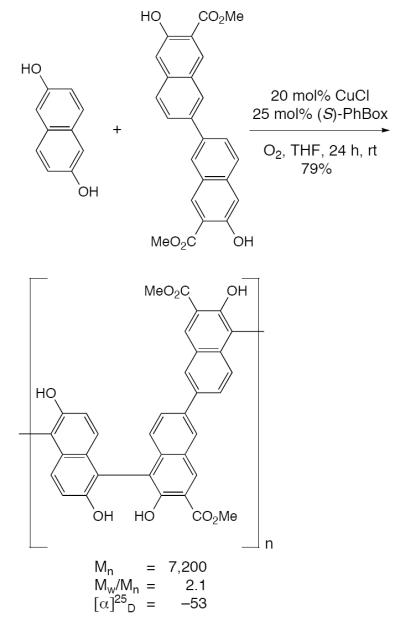
Crosspolymerization of 2,6-dihydroxynaphthalene with a homodimeric 6,6'-linked chelating monomer.
Scheme 420.
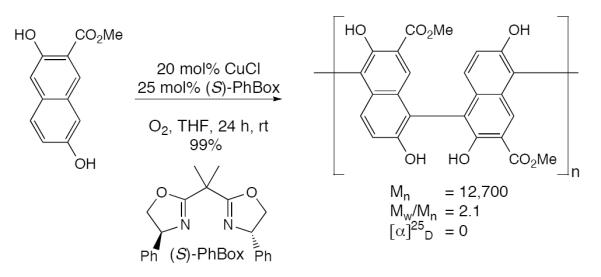
Oxidative polymerization of methyl 3,6-dihydroxy-2-naphthoate.
Scheme 421.
Synthesis of hyperbranched polymer having binaphthol units via oxidative cross-coupling polymerization.
As in the case of copper-bisoxazoline heterodimerizations (Section VII.A.4),689 the addition of the Lewis acid Yb(OTf)3 improves the chemoselectivity and stereoselectivity at the expense of yield and degree of polymerization (Scheme 422).734
Scheme 422.
Enantioselective cross coupling oligomerization with Lewis acid additive.
VII.C.2. C-C Phenol Polymers
While the vast majority of phenol polymers are C–O-coupled (see Section VII.C.3, below), a few C–C-coupled polymers are known. Taking advantage of the propensity of tert-butylphenols to form diphenoquinones instead of CO-coupled polymers, Hay synthesized a monomer consisting of two phenols linked through a biphenyl group (Scheme 423).735 Alternatively, two phenols can be linked through an ether. Upon subjection to oxidative polymerization conditions with stoichiometric copper, a polymer consisting of diphenoquinone linkages was formed. The diphenoquinone polymers can be used as oxidizing agents, and treatment of these polymers to hydrazine hydrate yields the C-C linked polyphenol, which have applications as antioxidants.736
Scheme 423.
Polymerization by formation of diphenoquinones.
By blocking the formation of C-O linked polymer through the use of a bulky tert-butyl group and blocking the formation of diphenoquinone by functionalizing the para position, Hirsch forced the formation of C-C linked polymer (Scheme 424).737 The monomer consisted of two phenols linked through a sulfide group. Exposure to oxidative aerobic polymerization conditions yielded a polymer with mass-weighted molecular weight of 1,360 amu, which corresponds to 4 monomer units.
Scheme 424.

Formation of a C-C linked phenol from a sulfide-linked monomer.
VII.C.3. C-O Naphthol and Phenol Polymers
In 1959, Alan Hay reported the first copper-catalyzed C-O polymerization of 2,6-dimethylphenol to form poly(phenylene) ether, or PPE,738 using cuprous chloride in pyridine under an oxygen atmosphere.692 The polymer thus formed is heat-resistant and durable, especially when combined with polystyrene or other polymers in post-processing. PPE and its derivatives are found in everything from printer cartridges739 to automobile fenders.740 Given its broad commercial utility, much work has been done to elucidate the mechanism of polymerization, improve the conditions for the polymerization process, and develop new substrates and catalysts for the oxidative polymerization product. This review covers only the copper-catalyzed aerobic oxidative polymerization of phenols. Commercial applications of polymer products, including post-production functionalization and the blending of polymer products, such as the formation of Noryl™, are covered elsewhere,741 as are reactions that use other metals.742
Two products are possible in the initial oxidative coupling of two molecules of 2,6-dimethylphenol using Cu(I)Cl under oxygen (Scheme 425).692 Diphenylene ether, is formed by attack of the phenolic oxygen of one monomer on the para position of another monomer. This C-O coupled dimer can react further to ultimately lead to polymer. Recent studies have suggested that this process is likely ionic rather than radical,743 but a consensus has not yet been reached. Diphenoquione arises from the para-para coupling of two monomers, followed by two-electron oxidation, and is the major contaminant resulting from the polymerization process. The amount of diphenoquinone can be reduced significantly by using a large excess of amine or hydroxide base with respect to the copper catalyst.744,745
Scheme 425.
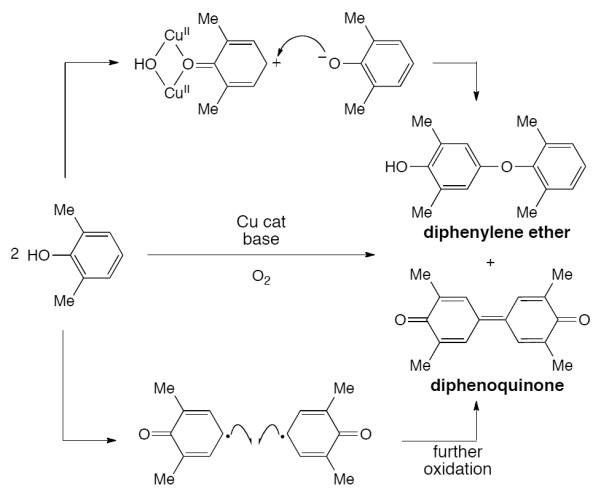
Oxidative phenol polymerization via C-O coupling.
The polymer can be extended via the mechanism shown in Scheme 425, though early mechanism studies showed that the polymerization is actually stepwise, i.e., at any given point the reaction solution contains a mixture of oligomers and unconsumed monomer (as opposed to a chain reaction, in which the reaction mixture contains only long-chain polymer and unreacted monomer).746 Studies of isolated polymerization intermediates show that they have one free phenol group per molecule.746 Two mechanisms that account for the stepwise polymerization have been proposed for the aerobic oxidative polymerization of 2,6-dimethylphenol (Scheme 426). In the ionic pathway, two atoms of copper bind to one end of the polymer. The phenol is oxidized to create a carbocation at the para-position, which is attacked by a phenolate anion. This process generates the quinone-ketal intermediate, which is common to both pathways and has been observed spectroscopically.747 In the radical pathway, two atoms of copper each bind to one phenolic oxygen.748 Oxidation occurs at both phenolic centers,749 and the phenolic radical closes on the radical at the para-position to generate the same quinone-ketal intermediate.750 Historically, the radical pathway has been accepted,751 though the ionic mechanism has gained significant ground in the past 15 years.743,752
Scheme 426.
The two possible pathways for the copper-catalyzed oxidative polymerization of phenols(n and m can equal zero).
From the quinone-ketal intermediate, redistribution occurs via one of the two mechanisms (or perhaps both) to generate elongated polymer chains. The degree of polymerization remains low through the course of the reaction, until the very end when it increases rapidly.746 Oligomers of 2,6-dimethylphenol react faster than the monomer,753 with the added benefit of forming less diphenoquinone side product,746 though some diphenoquinone is formed via redistribution.754
A consequence of the coupling-redistribution mechanism is that the polymers can degrade upon re-exposure to conditions. Treating the polymer to the Cu/pyr system with an excess of monomer results in depolymerization, forming lower molecular weight polymers without affecting the polydispersity index (PDI).755 Treatment of the polymer with an excess of copper and para-substituted phenols under oxidative conditions leads to the formation of capped polymers of lower molecular weight.
Understanding of the reaction pathway has been hampered by the fact that the reaction is first order in copper and first order in oxygen,756 indicating that the rate-limiting step is the oxidation of copper(I) to copper(II). Extensive studies have been done on the nature of the copper complex during the course of the reaction.757 The reaction proceeds in the same manner when performed with catalytic Cu(I) under oxygen or excess Cu(II) under inert atmosphere, indicating that the sole function of oxygen is to oxidize the copper(I) complex to copper(II),744 though it may also facilitate the electron transfer from the phenol to the copper.758
Much work has been performed to control the polymerization reaction, including the examination of the effect of copper source, oxygen amount, amine ligand, and additive on the yield, reaction rate, and the intrinsic viscosity (IV) of the resultant polymer.
The reaction can be performed using CuCl,692 CuBr,759 CuPh,760 or copper(II) sources.757a,c,761 The rate is increased when a high trans-effect counterion is used.762 The phenoxide monomer itself can also be used as a counterion,763 though larger counterions are not as effective as they cannot form the necessary μ-X−bridges.764
Other copper complexes have been isolated, exhaustively characterized through X-ray crystallography, and shown to catalyze the polymerization of 2,6-dimethylphenol (Scheme 427). The macrocyclic X1 forms a dinuclear copper complex.765 The tridentate bispyrazole X2 also forms a dinuclear complex with two molecules of ligand.766 Two molecules of ligand also combine in the case of the hexadentate macrocycle X3 to form a tetranuclear complex.767 The tetradentate X4 forms a binuclear complex that gives PPE in 80% conversion from 2,6-dimethylphenol.768 While the steric bulk around X5 increases the reaction rate, it is not as effective as N-methylimidazole.769 Similarly, the bidentate X6 benefits from steric bulk, but the conversion to PPE is less than 50%.770 The thiophene-containing X7 gives better results, with 80% conversion to PPE from 2,6-dimethlylphenol. Interestingly, the tripyridine ligand X8 forms a tetranuclear copper complex with five ligand molecules and bridging SO42− and μ-OH groups. A sample of the isolated crystal catalyzes the polymerization to give 82% of PPE with Mw = 10,700 amu and PDI = 2.04.771 Functionalization of the tacn ligand to make tacna (X9)772 and the dimeric X10773 increases water solubility, allowing for effective polymerization in aqueous solvent. A complex formed from the binding of copper to the dendrimer PAMAMG3 (Scheme 428) also allows for aqueous polymerization, with the polymerization itself presumably occurring within the dendrimer.774
Scheme 427.
Ligands for the oxidative polymerization of 2,6-dimethylphenol.
Scheme 428.
Dendrimeric ligand PAMAMG3 used in the aerobic copper-catalyzed oxidative polymerization of 2,6-dimethylphenol.
The catalytic reaction does not proceed under inert atmosphere.775 The catalyst and phenol can also be premixed before introduction of oxygen.776 The polymerization reaction is not sensitive to ambient air or moisture.785e,777 While air can be used as the oxygen source, the reaction proceeds faster under pure oxygen.778 Increasing the oxygen pressure accelerates the polymerization,779 while slow addition of oxygen780 or and careful monitoring of O2 pressure781 facilitates control of the reaction. The intrinsic viscosity is increased if a small amount of another oxidant such as H2O2 or K3Fe(CN)3 is added.782
The first reports of the oxidative copper-catalyzed polymerization used pyridine as the amine ligand.760 A number of additional amine ligands have also been shown to increase the reaction rate, including 1,3-diphenylguanidine,783N,N-diphenylformamidine,784 alkylamines,757b,785 bicyclic amidines, 786N-alkylimidazoles,787 bridging heterocycles,788 and 2,2-bipyridines.789,790 Polymeric pyridines, such as polyvinylpyridine (PVP), can also be used, though the effect on reaction rate is dependent on reaction conditions.791 PVP can be immobilized on silica, which allows for recycling of catalyst at the expense of reactivity.792 The addition of styrene793 or methylenebisacrylamide794 during Reversible Addition-Fragmentation chain Transfer (RAFT) polymerization of PVP creates a random copolymer with increased activity. Other polymeric catalysts such as polymer-bound 4-amino pyridine,795 poly[N-(2-ethoxycarbonylethyl)iminotrimethylene,796 and polyureas705 have been used. Non-polymerized pyridine has been supported on silica, though a large excess (160 equiv with respect to Cu) must be used.797 The use of poly(N-vinylimidazole) allows for polymerization in water.798
Numerous additives have been explored to tailor the reactivity, increase reproducibility, and control the intrinsic viscosity (IV). In particular, the degree of polymerization increases significantly near the end of the reaction due to oligomers combining together. Often, additives are employed to cap the growing chains to prevent rapid increases in IV. For example, slow addition of 2,4,6-trimethylphenol, which caps the polymer, limits the IC.799 4-Bromo-2,6-xylenol as an additive serves two roles releasing bromide ions, which controls of intrinsic viscosity,800 and generating xylenol, which is incorporated into the polymer. The addition of alkaline bromides also promotes the oxidative coupling.801 On the other hand, iodine pushes the reaction further and increases the IV.802 Another way to control the IV is to monitor it as the reaction progresses,803 and then add a complexation agent such as bisguanide or L-arginine to immediately stop the polymerization.804 The inclusion of a base, often NaOH, is pivotal in the reaction,805 though too much sodium hydroxide can inhibit the polymerization reaction due to precipitation of a bis-μ-hydroxide-biscopper complex.806
Low molecular weight alcohol additives increase molecular weight and reaction rate807 while also allowing the use of aqueous solutions of copper sources.808 The reaction reproducibility can be improved with the addition of 5% H2O in MeOH.809 The addition of a quaternary ammonium salt also improves the aqueous reaction.810 Biphasic conditions can be used,811 though an emulsifier such as sodium dodecylsulfate812 is usually necessary. In addition, an excess of copper is needed due to competitive solvation with water vs the amine.813 While EDTA can be used as a ligand for aqueous reactions,814 excess EDTA can be used to halt the reaction.815 Dialkyl sulfoxide or dialkylformamide promoters can also be used to increase polymer molecular weight and reaction rates can be increased.816 Unsaturated alkenes can increase the polymer IV.817 Rapidly halting the reaction by removal of oxygen followed by complexation of copper with sulfide results in no loss of IV in the workup.818
Original reports of the reaction used nitrobenzene as a solvent,692 but dry acetonitrile has been found to increase reaction rate.819 Running the polymerization solvent-free in liquid 2,6-xylenol with a salt additive can improve the polymer yield.820 The use of a solvent mixture of toluene and n-octane causes the polymer to precipitate, useful in industrial processes.821
Manipulation of the monomer can also be used to control the IV. For example, slow addition of the monomer over the course of the polymerization improves the IV822 and decreases the amount of diphenoquinone side product.780 The IV can also be increased by the addition of small oligomers of 2,6-xylenol.823 For production scale processes, significant work has been dedicated to optimizing reaction design824 and conditions.825,826,827
Many 4-substituted 2,6-dimethylphenol compounds can undergo oxidative degradation under oxidative polymerization conditions to form poly(phenylene ether). A sulfide-linked monomer has been shown to form PPE in the presence of CuCl and pyridine under oxygen. The resultant polymer has an intrinsic viscosity of 0.41 dl/g (Scheme 429).828 The benzylic oxidation of 2,4,6-trimethylphenol also results in a polymer consisting of 2,6-dimethylphenol units. One equivalent of formaldehyde is ejected for every equivalent of phenol that is incorporated into the polymer (Scheme 430).
Scheme 429.

Formation of PPE from a sulfide-linked monomer.
Scheme 430.
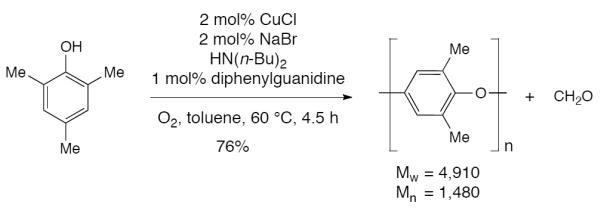
Formation of PPE from oxidative degradative polymerization of 2,4,6-trimethylphenol.
Given the commercial success of PPE, much work has been done exploring the substrate scope in the oxidative polymerization of other phenols (Table 18).829 While 2,6-dimethylphenol gives mostly polymer, 2,6-di-tert-butylphenol gives 97% diphenoquinone. Substituents of intermediate size give mixtures of diphenoquinone and polymer.830 Phenols with long-chained alkyl substituents also undergo successful polymerization,831 as does 2,6-difluorophenol, though the latter requires a bulky ligand such as 1,4,7-triisopropyl-1,4,7-triazanonane (tacn) as well as a bulky amine base.832 A dendrimer-bound copper complex has also been used to polymerize 2,6-difluorophenol.833
Table 18.
Substrates for the copper-catalyzed aerobic oxidative polymerization of substituted phenols.
| Entry | Monomer | Catalyst | Ligand | Additive | Mw (x103) | Mn (x103) | Mw/Mn | IV (dl/g) | Yield (%) | Ref |
|---|---|---|---|---|---|---|---|---|---|---|
| 1 |
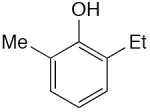
|
5 mol% CuCl | Pyridine | 25.4 | 0.40 | 82 | 830 | |||
| 2 |
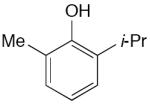
|
5 mol% CuCl | Pyridine | 15.4 | 0.24 | 62 | 830 | |||
| 3 |
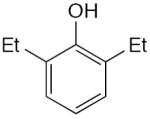
|
5 mol% CuCl | Pyridine | 32 | 0.53 | 81 | 830 | |||
| 4 |
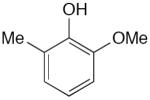
|
5 mol% CuCl | Pyridine | 13.1 | 0.47 | 60 | 830 | |||
| 5 |

|
5 mol% CuCl |
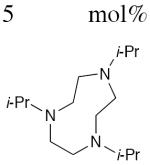
|
|
14.6 | 6.4 | 91 | 831 | ||
| 6 |
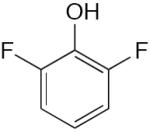
|
5 mol% CuCl2 |
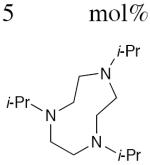
|
10 mol% 2,6-Ph2pyr | 66 | 13 | 5.1 | 100 | 832 | |
| 7 |
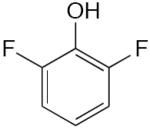
|
1.4 mol% CuCl2 | 0.3 mol% DPAG4 dendrimer | 48.4 | 7.4 | 6.5 | 82 | 833 | ||
| 8 |
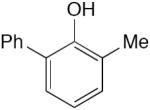
|
25 mol% CuCl | 30 equiv Pyridine | 51 | 28 | 73 | 835 | |||
| 9 |
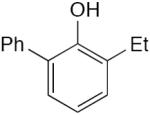
|
25 mol% CuCl | 30 equiv Pyridine | 88 | 3.8 | 35 | 835 | |||
| 10 |
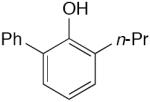
|
25 mol% CuCl | 30 equiv Pyridine | 84 | 2.8 | 62 | 835 | |||
| 11 |
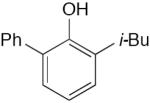
|
25 mol% CuCl | 30 equiv Pyridine | 110 | 4.1 | 68 | 835 | |||
| 12 |

|
25 mol% CuCl | 30 equiv Pyridine | 53 | 4.0 | 64 | 835 | |||
| 13 |

|
25 mol% CuCl | 30 equiv Pyridine | 73 | 2.6 | 40 | 835 | |||
| 14 |

|
25 mol% CuCl | 30 equiv Pyridine | 79 | 3.3 | 39 | 835 | |||
| 15 |
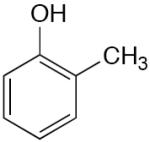
|
7 mol% CuCl |
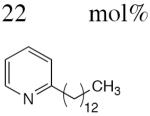
|
21.5 | 0.25 | 78 | 836 | |||
| 16 |
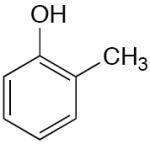
|
5 mol% CuCl2 |
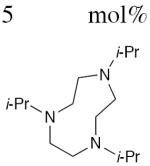
|
10.2 | 3.8 | 2.7 | 53 | 837 | ||
| 17 |
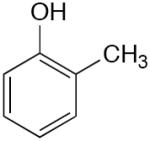
|
10 mol% CuCl |

|
25.4 | 3.8 | 6.67 | - | 838 | ||
| 18 |
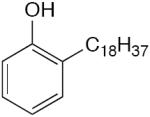
|
5 mol% CuCl |
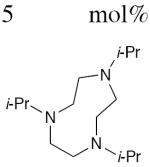
|
|
55 | 13.5 | 93 | 831 | ||
| 19 |
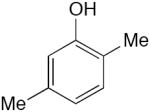
|
3 mol% CuCl |

|
8.8 | 8.1 | 91 | 839 | |||
| 20 |
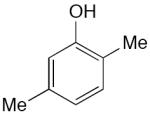
|
5 mol% CuCl2 |
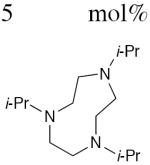
|
|
19.3 | 3.9 | 78 | 840 | ||
| 21 |
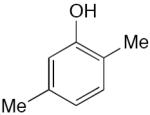
|
1 mol% CuCl | 1 mol% TMEDA | 8.5 | 5.0 | 65 | 841 | |||
| 22 |
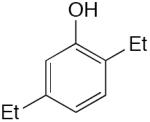
|
5 mol% CuCl2 |
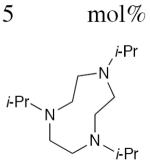
|
|
23.1 | 32.2 | 77 | 840 | ||
| 23 |

|
5 mol% CuCl2 |
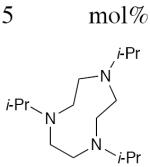
|
|
32.2 | 8.5 | 92 | 840 | ||
| 24 |
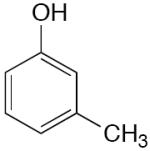
|
5 mol% CuCl2 |
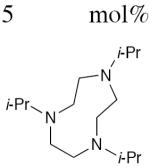
|
215 | 39 | 5.4 | 53 | 842 | ||
| 25 |
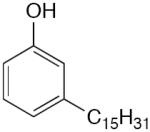
|
5 mol% CuCl |
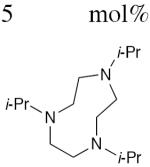
|
|
6.9 | 4.2 | 23 | 831 | ||
| 26 |
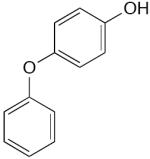
|
5 mol% CuCl | 5 mol% TEEDA | 29.1 | 5.4 | 77 | 844 | |||
| 27 |
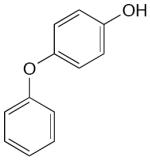
|
5 mol% CuCl2 |
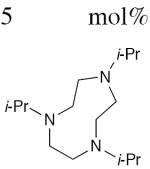
|
|
4.7 | 1.2 | 89 | 843 | ||
| 28 |
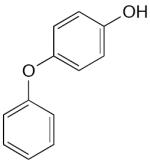
|

|
|
3.5 | 2.0 | 73 | 845 | |||
| 29 |
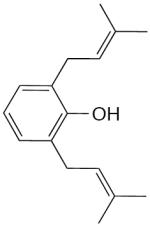
|
10 mol% CuCl | Pyridine | 1.42 | 78 | 846 | ||||
| 30 |
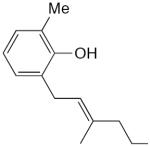
|
10 mol% CuCl | Pyridine | 0.14 | 77 | 847 | ||||
| 31 |

|
2.5 mol% CuCl | 25 mol% TMEDA | 6.9 | 2.0 | 86 | 848 | |||
| 32 |
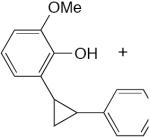
|
0.1 mol% CuBr2 | 0.2 mol% (t-Bu)2NH 1 mol% Me2(n-Bu)N 0.5 mol% (n-Bu)2NH | 26.0 | 10.2 | 80 | 849 | |||
| 33 |
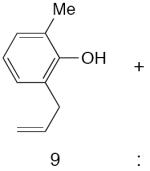
|
6 mol% CuCl | Excess pyridine | 39 | 27 | 84 | 850b | |||
| 34 |
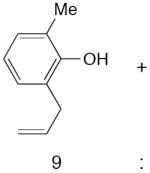
|
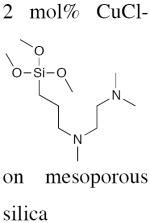
|
Excess pyridine | 22 | 2.5 | 63 | 850b | |||
| 35 |
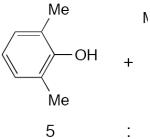
|
0.08 CuO2 mol% | 0.2 mol% (t-Bu)2NH 1 mol% Me2(n-Bu)N 0.5 mol% (n-Bu)2NH | 0.42 | - | 851 |
The synthesis and utility of 2,6-diarylphenol polymers up to 1999 is well covered in a review by Hay et al.834 and thus will not be included in this review. Yamada examined the polymerization of 2-phenyl-6-alkylphenols and found that the identity of the alkyl substituent had little effect on the electronic character of the resulting polymer.835
The use of bulky ligands allows for the polymerization of phenols with just one ortho group, including 2-alkylphenols831,836,837,838 and 2,5-dialkylphenols.839,840,841 Even 3-alkylphenols can be polymerized when the bulky ligand tacn is used.831,842
Phenol can also be used in the oxidative polymerization reaction, but the lack of substitution leads to extensive cross-linking and difficult characterization and analysis.843d The dimeric 4-phenoxyphenol is more successful, especially when bulky ligands such as tetraethylethylenediamine (TEEDA)844 or tacn843 are used. A dinucleating hexapyridine ligand has also been used for this reaction.845
Efforts have been made to synthesize functionalized polymers. Tsuchida and co-workers polymerized 2,6-diprenylphenol but found that the resulting polymer had only 1.86 double bonds per monomer unit, indicating that some prenyl groups were destroyed or reacted further under polymerization conditions. Upon exposure of the polymer to dibromination conditions, 94% of the double bonds were brominated.846 Similarly, 98% of the double bonds in the polymer made from 2-methyl-6-geranylphenol underwent dibromination.847
Cross-polymerizations are also possible, though the interdispersion of monomers is dependent on their relative rate of reaction, initial ratios, and rates of addition. The cross polymer made from 2,5- and 2,6-dimethylphenol exhibits higher thermal stability than that from 2,6-dimethylphenol alone.848 Hay and Gao incorporated 2-methoxy-6-(2-phenylcyclopropyl)phenol into PPE and found that, upon heating to 350 °C, crosslinking occurred which increased the thermal stability of the polymer.849 A copolymerization of 2-allyl-6-methylphenol with 2,6-dimethylphenol resulted in polymer with a very large poly dispersivity index (PDI), which was attributed to the formation of crosslinks during the polymerization.850a Performing the polymerization in mesoporous silica decreased the PDI by a factor of 10.850b
The polymer formed by the oxidative aerobic polymerization of 2,6-dimethylphenol has a hydroxide at one terminus of the molecule. Efforts have been made to create bifunctional polymers in which a free phenol group exists at both ends of the polymer. White found that the diphenoquinone side product formed in the oxidative polymerization reaction is itself a strong enough oxidant to react with PPE in the absence of oxygen, leading to two polymer molecules linked by a para-coupled bisphenol (Scheme 431).852
Scheme 431.
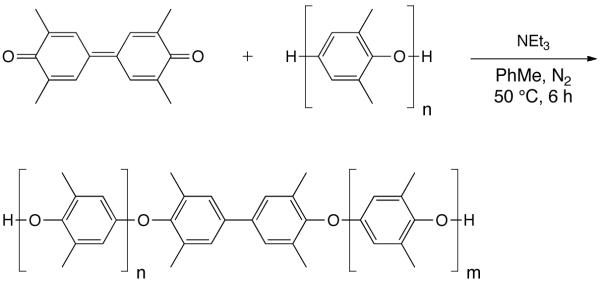
Synthesis of a bifunctional polymer linked through a hydroquinone.
Heitz and Risse determined that a bifunctional polymer can be synthesized in one step if 0.25 equivalents of a dimethylmethylene-linked dimer of 2,6-dimethylphenol is included in the reaction as a co-monomer (Scheme 432) using standard reaction conditions. Titration of the reaction product indicates the presence an average 1.87 phenolic hydroxide groups per molecule of polymer.853 The molecular weight of the resulting polymer is dependent on the molar ratio of co-monomers,854 and the reaction has been applied on production scale.855
Scheme 432.
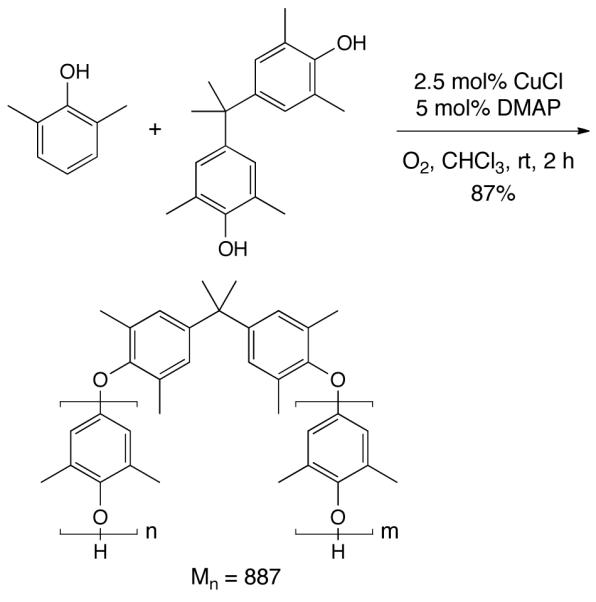
Synthesis of a bifunctional polymer linked via a linked dimer of 2,6-dimethylphenol.
Para-substituted phenols can undergo polymerization, though oxygen-rich compounds can form both C-C and C-O linkages. Using a silicon-tethered monomer, Habaue and co-workers formed a polymer consisting of repeated 4-ethoxyphenol units with C-C or a C-O linkages (Scheme 433). The ratio of C-C to C-O bonds was estimated by measuring the amount of H2 formed when the resulting polymer was treated with LiAlH4.856
Scheme 433.
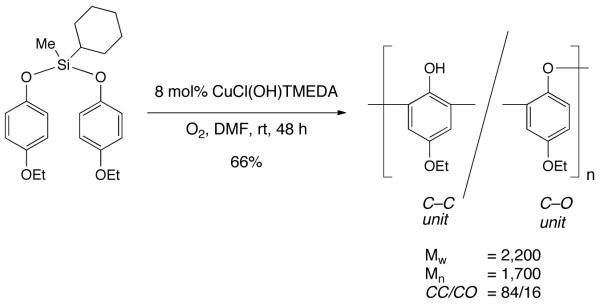
Oxidative polymerization of a silicon-tethered para-substituted phenol.
Using a variety of copper sources, Stammann and co-workers reported the polymerization of para-substituted phenols to form predominantly ortho C-O linked polymers. While all of the reactions proceeded in at least 95% conversion, the PDI of the resulting polymers were extremely high.857
Oxidative C-O polymerization of naphthols is rare. As discussed above (Section VII.A), 2-naphthols oxidize readily and undergo facile C-C coupling. On the other hand, 1-naphthols do not give rise to a single highly favored radical intermediate (see Scheme 435). Rather, they behave similarly to phenols including a proclivity for C-O polymerization (Scheme 433).858 As the case in phenol polymerization, a higher ratio of pyridine to copper results in less diphenoquinone formation.859
Scheme 435.
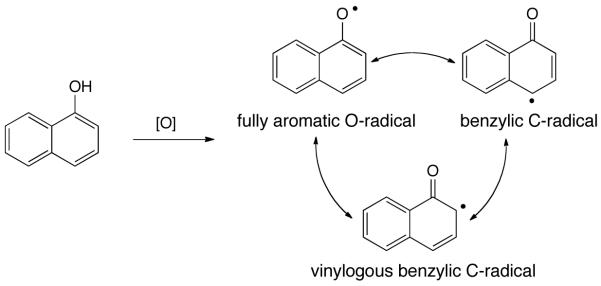
Radical intermediates in the oxidation of 1-naphthol.
VII.D. Oxygenation of Naphthols and Phenols
The enzyme tyrosinase, which contains two copper atoms at the active site, has been shown to catalyze the oxygenation of tyrosine to dopamine, and dopamine to dopamine-ortho-quinone, using molecular oxygen as the sole oxygen source.860 Tyrosinase plays a major role in the synthesis of melanin in the body, and has been linked to the growth of melanomas.861 A simplified862 tyrosinase mechanism, based on analysis of the crystal structure of the protein,863 is shown in Scheme 437.864 Recent DFT calculations support this mechanism.865
Scheme 437.
Mechanism for the oxygenation and subsequent oxidation of phenols to ortho-quinones by tyrosinase.
A significant amount of work has been done in developing biomimetic catalyst systems to probe the mechanism of this enzymatic reaction. Initial studies performed by Brackman and Havinga showed that solutions of copper salts and morpholine applied to phenols can effect oxidation to the orthoquinone.866 The morpholine addition products observed (Scheme 438) form via conjugate addition to the orthoquinone generated initially, followed by further two-electron oxidation to the quinone (see Scheme 439).
Scheme 438.
Copper-catalyzed aerobic oxygenation of naphthols and phenols.
Scheme 439.
Proposed mechanism for the oxygenation of phenols and naphthols by copper and morpholine.
Phenols react significantly slower than naphthols, and the reaction halts when the substrate concentration drops below 30 mM, making full conversion difficult.867 The reaction has a significant induction period that can be shortened with addition of trace peroxide.868 A mechanism that accounts for these observations is shown in Scheme 439.869 The first step of the reaction is reduction of molecular oxygen to peroxide, which accounts for the observed induction period in the absence of added peroxide. The dependence on phenol concentration is caused by side reactions that consume the generated peroxide.
VII.D.1 Formation of Catechols from Phenols
The oxygenation of phenol to catechol is a binuclear process.877 In cases where a mononuclear ligand is used, dimers with bridging oxygens have been shown to form in solution.878 Most of the investigations into this transformation are mechanism studies in which an equivalent of phenolate is bound to the copper complex and the resulting solution is oxygenated. The 4-carboxylate substrates are often used for these mechanistic studies because the electron-poor ring prevents further oxidation to the orthoquinone. Few synthetically useful preparations of catechol by this method exist. The proposed mechanisms closely follow that of tyrosinase (Scheme 437), with hydrolysis of the catechol preventing oxidation further oxidation to the ortho-quinone. Labeling experiments show that the oxygen in the product comes from molecular oxygen,873 and the binding of oxygen to the copper complex is reversible.879
Recent studies by Stack and co-workers with bis-tert-butylphenol suggest that the oxygenation proceeds through a copper(III) species and that the key step proceeds via electrophilic aromatic substitution (Scheme 440).877
Scheme 440.
The oxygenation of phenol to catechol via a copper(III) intermediate.
Many of the reported methods of phenolate oxygenation use alkali borohydride to form the alkali salt.880 Unfortunately, this method results in the formation of a borane byproduct, which can effect a reduction of any formed quinone to the catechol. Sayre and coworkers determined that formation of the cuprous phenolate compound with borohydride, followed by treatment of the resultant complex with oxygen, resulted in formation of the catechol. However, treatment of the same phenol with a complex incapable of forming borane resulted in a CO-coupled bisphenol that results from Michael addition to the ortho-quinone (Scheme 441).881 However, studies from Maumy and Capdevielle assert that the catechol is in fact an intermediate to the ortho-quinone.882
Scheme 441.
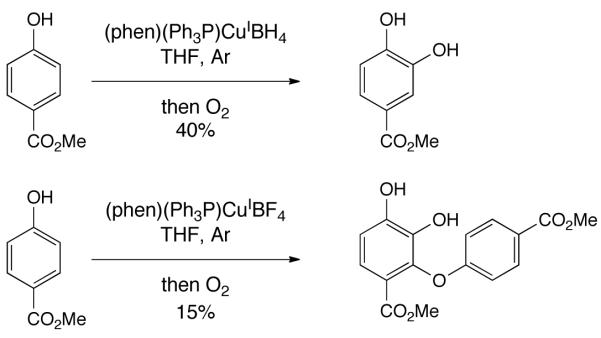
Oxygenation of phenolate complexes formed with and without borohydride.
VII.D.2 Formation of Quinones from Phenols
The oxidation of phenols to quinones is more representative of the mode of action of tyrosinase, which does not stop at the catechol product. The oxidation product ratio (ortho- vs. para-quinone) is determined by substrate substitution and, to a smaller extent, catalyst structure. Phenols with open para-positions typically yield para-quinones (see below in this Section); when the para-position is blocked, ortho-quinones are formed (Table 20).
Table 20.
Copper-catalyzed oxygenation of phenols to ortho-quinonts.
Maumy and coworkers have employed the formation of Michael-addition products from the oxidation of phenols to ortho-quinones in a number of total syntheses and methodology studies. In the total synthesis of the bactericide dihydromaesanin (Scheme 442), aerobic oxidation of para-methoxyphenol with CuCl and Cu0 in methanol afforded the dimerized product in 60% yield (96% based on recovered starting material). The resulting vinylogous aryl ester served as an excellent leaving group in a base-mediated displacement by an allylic alcohol. Subsequent Claisen rearrangement and alkene reduction afforded the natural product in 58% overall yield.885
Scheme 442.
Copper-catalyzed aerobic phenol oxidation in the total synthesis of dihydromaesanin.
The mechanism for the oxidation is shown in Scheme 443. The initial oxygenation of the phenol gives a catechol that undergoes further two-electron oxidation to afford the ortho-quinone. Nucleophilic attack of this intermediate by a second molecule of substrate gives a catechol intermediate that is quickly converted to the ortho-quinone.
Scheme 443.
Mechanism for the copper-catalyzed oxidation of para-methoxyphenol to a vinylogous ester.
The oxidation-nucleophilic displacement-Claisen rearrangement sequence was also used in the synthesis of a series of para-benzoquinones (Scheme 444). A double-displacement of two equivalents of orthoquinone with a linked diol followed by a double-Claisen rearrangement was used in the total synthesis of dihydroardisiaquinone A (Scheme 445).886
Scheme 444.
Synthesis of substituted benzoquinones from para-methoxyphenol via a dimeric orthoquinone.
Scheme 445.
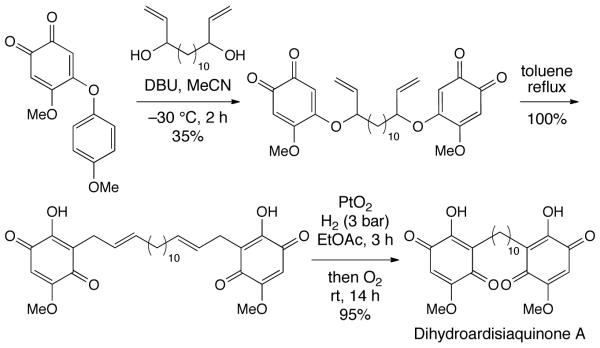
Synthesis of dihydroardisiaquinone A via an orthoquinone derived from para-methoxyphenol.
A similar method was applied to the synthesis of 2H-1-benzopyran-5,8-quinones (Scheme 446). A copper-catalyzed oxygenation/oxidation sequence afforded the dimer in 62% yield (96% based on recovered starting material). Displacement of the 4-methoxylphenol by a propargylic alcohol followed by reflux in toluene effected a Saucy-Marbet Claisen rearrangement, 1,5-hydride shift, and 6-π electrocyclization to yield the pyran ring (Scheme 447).887
Scheme 446.
Synthesis of 2H-1-benzopyran-5,8-quinones from para-methoxyphenol.
Scheme 447.
Mechanism of the tandem Saucy-Marbet Claisen, [1,5]–hydride shift, and 6-π electrocyclization.
The vinylogous aryl ester has also been used as a precursor to 5-methoxy-4-alkylamino-1,2-benzoquinones (Scheme 448). As shown above, oxidation of para-methoxyphenol affords the ortho-quinone in 62% yield. Treatment of this oxidized product with an equivalent of amine effects the displacement of just the phenoxide, affording the amino ortho-quinone in moderate to excellent yields. The amine addition is sensitive to steric effects, and N-methyltriphenylmethylamine gives no product. Primary amines can displace either the para-methoxyphenoxide or the methoxide group. Treatment of this mixture with methoxide displaces any of the remaining para-methoxyphenoxide resulting in just the illustrated product.888
Scheme 448.
Synthesis of amino ortho-quinones from para-methoxyphenol via a dimeric orthoquinone.
In an effort to determine whether an ortho-peroxide is an intermediate in the oxidation of phenols to ortho-quinones, Sayre and coworkers employed a bis-ortho-substituted phenol probe (Scheme 449). Interestingly, subjection to an equivalent of a copper(I) complex under an oxygen atmosphere resulted in an alkyl arrangement, generating a 3,6-di-tert-butyl-1,2-benzoquinone in 40% yield, with 55% recovered starting material.884 The authors account for this alkyl migration with the mechanism shown in Scheme 450. Oxygenation of the phenoxide complex generates a 1,2-dioxetane that is opened by nucleophilic attack by the copper enolate. The opening of the epoxide as well as the formation of the ortho-quinone drives the alkyl migration.
Scheme 449.

Alkyl rearrangement in the copper-mediated oxygenation of a bis-ortho-substituted phenol.
Scheme 450.
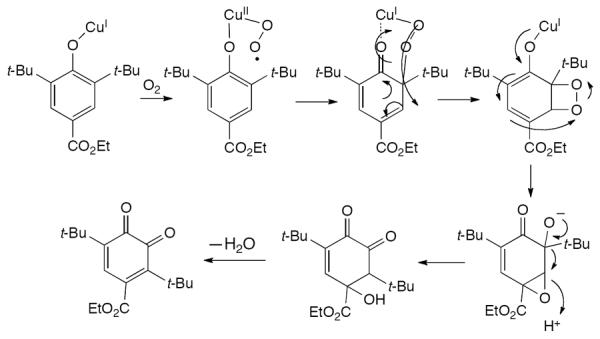
Proposed mechanism for the observed alkyl migration.
Many copper complexes have been employed to oxidize phenols to 1,4-benzoquinones (Table 21). The industrial synthesis of vitamin E uses 2,3,5-trimethyl-1,4-benzoquinone as a key intermediate.889 The utility of this compound, as well as the presence of other para-quinones in a number of herbal medicines known for their antioxidant properties,890 has driven much research into both the substrate scope of this reaction as well as the mechanism. Typical side products include diphenoquinones (see Section VII.B.1), catechols (see Section VII.D.1), and ortho-quinones (see above in this Section).
Table 21.
Copper-catalyzed aerobic oxygenation of phenols to para-quinones.
| Entry | Starting Material | Product(s) | Copper Complex | conditions | Yield (%) | ref |
|---|---|---|---|---|---|---|
| 1 |
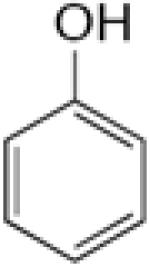
|

|
7 mol% CuBr | 70 atm O2, MeCN, 60 °C, 1 h |
74 | 891 |
| 2 |

|

|
42 mol% CuCl2 | 34 atm O2 DMF, 100 °C, 30 min |
58 | 892 |
| 3 |

|

|
7 mol% CuCl2 7 mol% BeO |
51 atm 2:3 O2/N2 MeCN, 65 °C, 3 h |
55 | 893 |
| 4 |
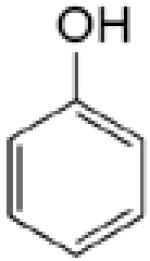
|
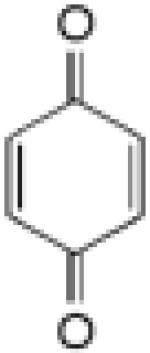
|
10 mol% CuCl | 136 atm O2 MeCN/MeOH, 100 °C, 1 h |
54 | 894 |
| 5 |
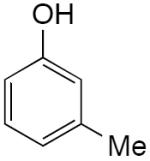
|

|
1.2 equiv CuCl2 | 30 atm O2, acetone/H2O, 60 °C, 3 h |
75 | 895 |
| 6 |
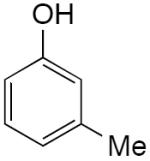
|

|
8 mol% CuCl | 95 atm O2, MeCN, 40 °C, 20 min |
67 | 891 |
| 7 |
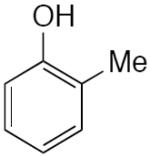
|
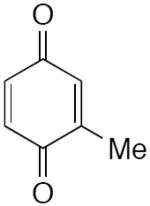
|
8 mol% CuCl | 105 atm O2, MeCN/H2O, 60 °C, 20 min |
69 | 891 |
| 8 |

|
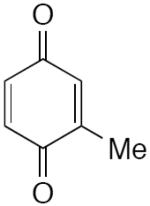
|
1.2 equiv CuCl2 | 30 atm O2, DMF, 60 °C, 3 h |
41 | 895 |
| 9 |
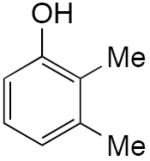
|
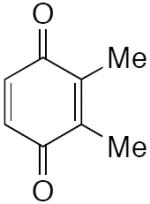
|
1.2 equiv CuCl2 | 29 atm O2, MeCN/H2O, 50 °C, 20 min |
84 | 891 |
| 10 |
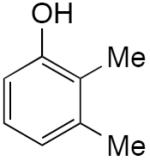
|

|
1.2 equiv CuCl2 | 30 atm O2, acetone/H2O, 60 °C, 2.5 h |
75 | 895 |
| 11 |
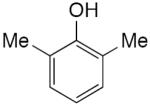
|
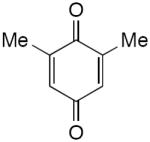
|
5 mol% CuCl2 | 33 atm O2, MeCN, 40 °C, 20 min |
86 | 891 |
| 12 |

|

|
1.2 equiv CuCl2 | 30 atm O2, DMF, 60 °C, 2 h |
77 | 895 |
| 13 |
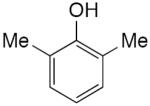
|
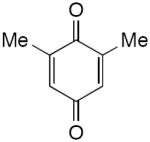
|
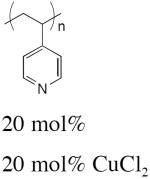
|
10 atm O2, DMSO, 60 °C |
43 | 1043 |
| 14 |

|
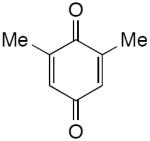
|
10 mol% CuCl | 29 atm O2, MeCN/H2O, 50 °C, 20 min |
96 | 891 |
| 15 |

|
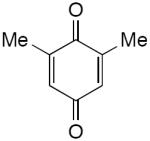
|
1.2 equiv CuCl2 | 30 atm O2, acetone/H2O, 60 °C, 2.5 h |
85 | 895 |
| 16 |
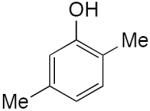
|

|
10 mol% CuCl | 29 atm O2, MeCN/H2O, 50 °C, 20 min |
82 | 891 |
| 17 |
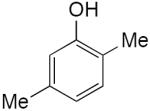
|
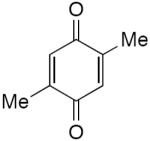
|
1.2 equiv CuCl2 | 30 atm O2, acetone/H2O, 60 °C, 2.5 h |
82 | 895 |
| 18 |

|
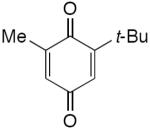
|
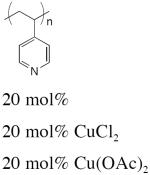
|
10 atm O2, DMSO, 60 °C |
68 | 1043 |
| 19 |

|
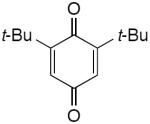
|
1 equiv KSCN | 34 atm O2, DMF, 60 °C, 7 min |
100 | 896 |
| 20 |

|
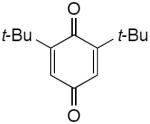
|
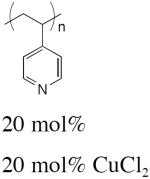
|
10 atm O2, DMSO, 60 °C |
93 | 1043 |
| 21 |

|
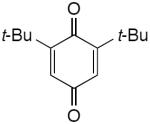
|
1 equiv CuCl | O2, MeCN, rt, | 80 | 897 |
| 22 |
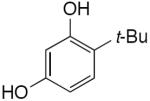
|

|
1 equiv Cu(ClO4)2 | air, MeCN/H2O, pH = 10, 30 min, rt |
53 | 898 |
| 23 |

|
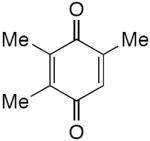
|
1.2 equiv CuCl2 | O2, DMF/H2O, 60 °C, 3 h |
99 | 895 |
| 24 |
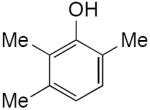
|
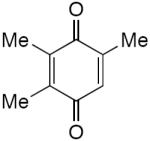
|

|
O2, n-hexanol, 75 °C, 5 h |
96 | 899 |
| 25 |
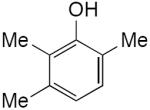
|
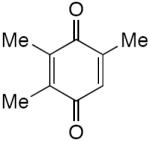
|
1.2 equiv CuCl2 | O2, acetone/H2O, 60 °C, 3 h |
96 | 895 |
| 26 |
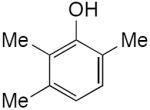
|
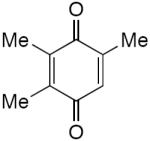
|
5 mol% CuCl2 • H2O 10 mol% NH2OH • HCl |
1.13 atm O2, t- BuOH, 40 °C, 2 h |
96 | 900, 901 |
| 27 |
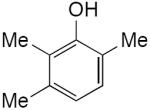
|
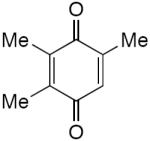
|
10 mol% CuCl2 10 mol% MgCl2 |
O2, n- dodecanol, 80 °C, 6.5 h |
95 | 902 |
| 28 |
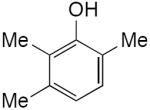
|
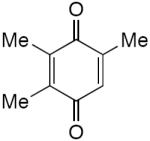
|
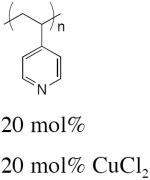
|
10 atm O2, DMSO, 60 °C |
95 | 1043 |
| 29 |
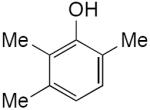
|
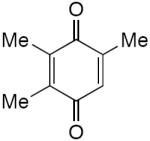
|
1 equiv Li[CuCl] • 2H2O 3 equiv LiCl |
1 atm O2, H2O/n- hexanol, 60 °C, 1 h |
95 | 889 |
| 30 |
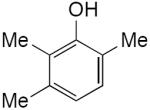
|

|
1 equiv CuCl • H2O 6 equiv LiCl |
O2, toluene/n- PrOH, 60 °C, 4 h |
95 | 903 |
| 31 |
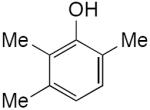
|
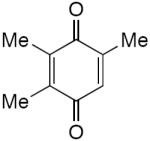
|

|
O2, 80 °C, 1 h | 89 | 904 |
| 32 |
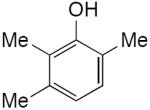
|
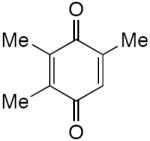
|

|
9.9 atm O2, n- BuOH, 60 °C, 5 h |
86 | 905 |
| 33 |
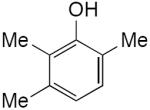
|
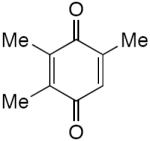
|
10 mol% CuCl2 • 2H2O 10 mol% Et2NH•HCl |
1 atm O2, n- hexanol, 60 °C, 4 h |
84 | 906 |
| 34 |
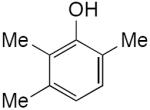
|
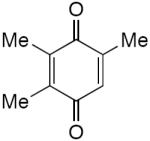
|
10 mol% Cu2O | HCl(g) then NaOMe, air, i- PrOH/MeOH, 60 °C, 21 h |
72 | 907 |
| 35 |
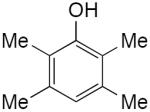
|

|
1.2 equiv CuCl2 | O2, HO(CH2)2OMe, 60 °C, 4 h |
99 | 895 |
| 36 |
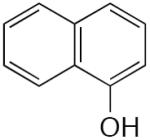
|
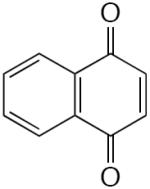
|
1 equiv CuCl | O2, MeCN, rt | 70 | 897 |
| 37 |

|
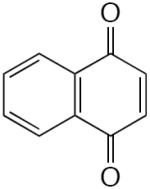
|
10 mol% CuCl | 28 atm O2, MeCN/H2O, 50 °C, 20 min |
61 | 891 |
| 38 |
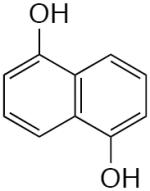
|
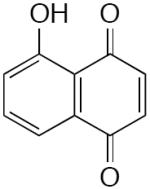
|
1 equiv CuCl | O2, MeCN, rt | 80 | 897 |
| 39 |
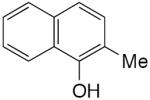
|

|

|
9.9 atm O2, n- BuOH, 60 °C, 5 h |
47 | 905 |
VII.E Reactions of Catechols
VII.E.1. ortho-Quinones from Catechols
The dinuclear copper-containing enzyme catechol oxidase has been shown to catalyze the oxidation of catechols to ortho-quinones (Scheme 451).908 Due to the low oxidation potential of this reaction, it has become a common test reaction for new bio-inspired copper complexes, and a remarkable variety of copper catalysts have been found to effect this transformation.909,910,911 For these biomimetic studies, 3,5-di-tert-butylcatechol is the most frequently used substrate (Table 22), because the ortho-quinone forms with high selectivity and can be easily monitored by UV-Vis spectroscopy.912
Scheme 451.
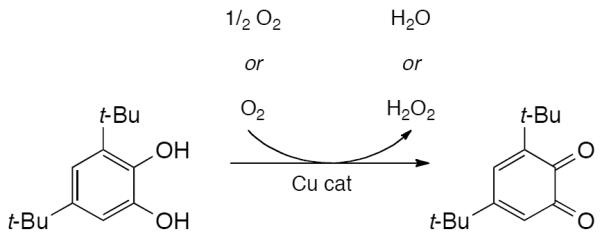
Catechol oxidation to an ortho-quinone.
Table 22.
Catalysts for the copper-catalyzed aerobic oxidation of 3,5-di-tert-butylcatechol to 3,5-di-tert-butylquinone.
| Entry | Copper Complex | Conditions | yield (%) | Rate information | Ref |
|---|---|---|---|---|---|
| 1 |
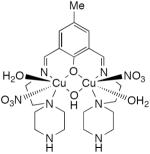
|
O2, MeOH | kcat = 32400 h−1 | 913 | |
| 2 |
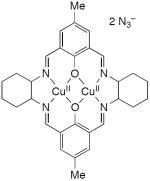
|
O2, MeOH | kcat = 7200 h−1 | 914 | |
| 3 |
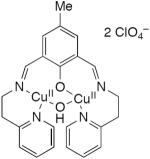
|
O2, MeCN | kcat = 5470 h−1 | 915 | |
| 4 |
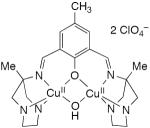
|
O2, MeOH | kcat = 12.4 h−1 | 916 | |
| 5 |

|
O2, MeOH | kcat = 941 h−1 | 917 | |
| 6 |
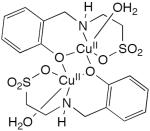
|
O2, 5% H2O, in MeOH | kcat = 5048 h−1 | 918 | |
| 7 |
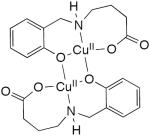
|
O2, MeOH | kcat = 3800 h−1 | 919 | |
| 8 |
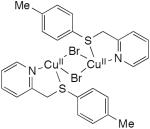
|
O2, MeOH | kcat = 3300 h−1 | 920 | |
| 9 |
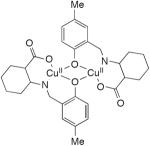
|
O2, DMF | kcat = 3120 h−1 | 921 | |
| 10 |

|
O2, MeOH | kcat = 393 h−1 | 922 | |
| 11 |
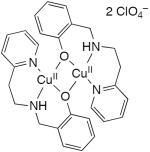
|
O2, MeOH | kcat = 283 h−1 | 923 | |
| 12 |
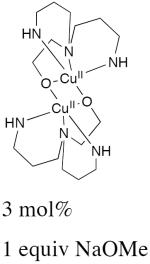
|
MeOH, NaOMe, | 99% | TON = 216 h−1 | 924 |
| 13 |
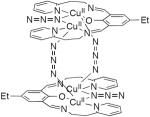
|
O2, MeCN | kcat = 215 h−1 | 925 | |
| 14 |
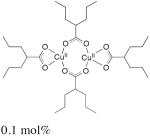
|
O2, MeOH | kcat = 109 h−1 | 926 | |
| 15 |
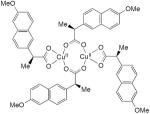
|
O2, MeOH | kcat = 81 h−1 | 927 | |
| 16 |

|
O2, MeOH | kcat = 48 h−1 | 928 | |
| 17 |

|
O2, MeOH, 100 min | 68% conv | TON = 41 h−1 | 929 |
| 18 |
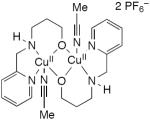
|
O2, MeOH | TON = 31.6 h−1 | 930 | |
| 19 |
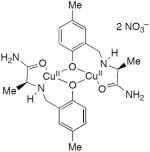
|
O2, MeOH | kcat = 28.2 h−1 | 931 | |
| 20 |
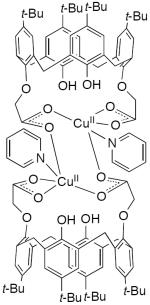
|
O2, MeOH | kcat = 18 h−1 | 932 | |
| 21 |

|
O2, MeOH, 15 °C, 6 h | 100% | kcat = 16 h−1 | 933 |
| 22 |
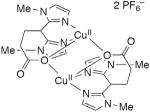
|
O2 MeOH | TON = 1.3 h−1 | 934 | |
| 23 |
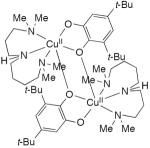
|
O2, DMF, 40 °C | kcat = 1.09 h−1 | 935 | |
| 24 |
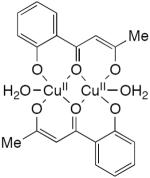
|
O2 | not given | 936 | |
| 25 |
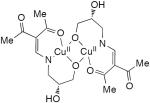
|
O2, MeOH | not given | 937 | |
| 26 |

|
O2, MeCN | kcat = 28908 h−1 | 938 | |
| 27 |
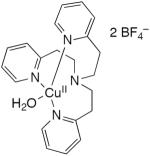
|
O2, MeOH | kcat = 2994 h−1 | 939 | |
| 28 |
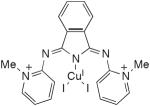
|
O2, MeOH | kcat = 64 h−1 | 940 | |
| 29 |
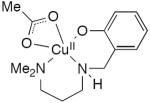
|
O2, MeOH | kcat = 41.3 h−1 | 941 | |
| 30 |

|
O2, MeOH | TON = 41 h−1 | 942 | |
| 31 |

|
O2, MeOH | kcat = 28.2 h−1 | 943 | |
| 32 |
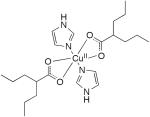
|
O2, MeOH | TON = 22 h−1 | 944 | |
| 33 |
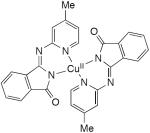
|
O2, MeOH | TON = 21.5 h−1 | 945 | |
| 34 |

|
O2 sodium dodecyl sulfate, H2O | kcat = 12.6 h−1 | 946 | |
| 35 |
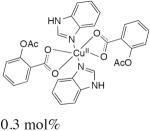
|
O2, MeOH | kcat = 12.4 h−1 | 947 | |
| 36 |

|
O2, MeOH | kcat = 6 h-2 | 948 | |
| 37 |

|
O2, MeOH, pH = 6.8 | kcat = 5.69 h−1 | 949 | |
| 38 |
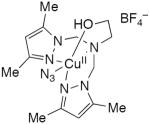
|
O2, MeOH | kcat = 5.24 h−1 | 950 | |
| 39 |

|
−80 °C, CH2Cl2 | 95% | 951 | |
| 40 |
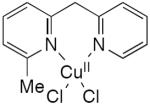
|
O2, KOH, MeOH | kobs = 0.0050 h−1 | 952 | |
| 41 |

|
O2, MeOH | not given | 953 | |
| 42 |
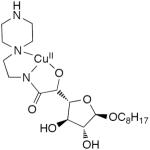
|
O2, MeOH | does not follow Michaelis-Menten | 954 | |
| 43 |

|
O2, MeOH | kcat = 6502 h−1 | 955 | |
| 44 |
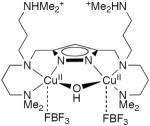
|
O2, MeOH | kcat = 2804 h−1 | 956 | |
| 45 |

|
O2, NaOH, MeOH | kcat = 576 h−1 | 957 | |
| 46 |

|
O2, MeOH | kcat = 66 h−1 | 958 | |
| 47 |

|
O2, 70% MeCN in H2O | kcat = 1.8 h−1 | 959 | |
| 48 |
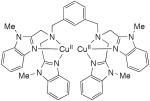
|
O2, MeOH/aq buffer pH = 5.0 | kcat = 1044 h−1 | 960 | |
| 49 |

|
O2, MeOH | kcat = 331 h−1 | 961 | |
| 50 |

|
O2, MeOH | kcat = 118 h−1 | 962 | |
| 51 |
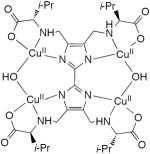
|
O2 MeOH, pH=8.5 | kcat = 23.4 h−1 | 963 | |
| 52 |
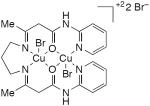
|
O2, MeCN | kcat = 23 h−1 | 964 | |
| 53 |

|
O2, MeOH | kcat = 21.2 h−1 | 965 | |
| 54 |

|
O2, MeOH | kcat = 20.5 h−1 | 966 | |
| 55 |
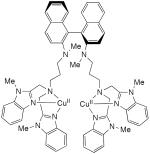
|
O2, MeOH/aq buffer pH = 5.0 | kcat = 19.8 h−1 | 967 | |
| 56 |

|
O2, MeOH, pH=8 | kcat = 11.2 h−1 | 968 | |
| 57 |
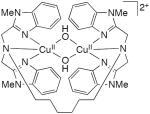
|
O2, MeOH/aq buffer pH = 5.1 | kcat = 3 h−1 | 969 | |
| 58 |

|
O2, MeOH | not given | 970 | |
| 59 |
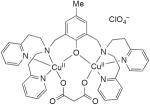
|
O2, MeCN | kcat = 900 h−1 | 971 | |
| 60 |
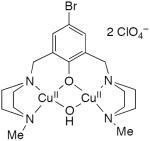
|
O2, MeOH | kcat = 214 h−1 | 972 | |
| 61 |
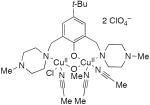
|
O2, MeOH | kcat = 189 h−1 | 973 | |
| 62 |
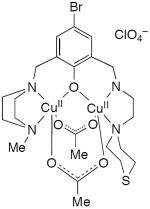
|
air, MeOH | kcat = 40.0 h−1 | 974 | |
| 63 |

|
O2, MeOH | kcat = 36.5 h−1 | 975 | |
| 64 |
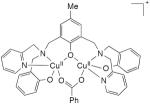
|
O2, MeOH | kcat = 25.8 h−1 | 976 | |
| 65 |
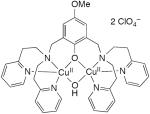
|
O2, MeOH | kcat = 21.4 h−1 | 977 | |
| 66 |

|
O2, DMF | kcat = 4.31 h−1 | 978 | |
| 67 |
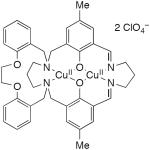
|
O2, MeCN | kcat = 3.19 h−1 | 979 | |
| 68 |
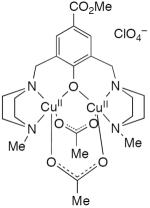
|
O2, DMF | kcat = 0.804 h−1 | 980 | |
| 69 |

|
O2, MeCN | TON = 36 h−1 | 981 | |
| 70 |
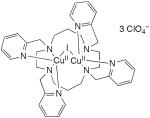
|
O2, MeOH | kcat = 24.2 h−1 | 982 | |
| 71 |

|
O2, MeOH/MeCN | 67% conv | TON = 12 h−1 | 983 |
| 72 |

|
air, DMF | kcat = 0.9511 h−1 | 984 | |
| 73 |
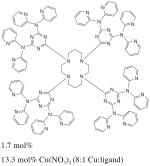
|
O2, MeOH, rt, 6 h | 65% conv | 985 | |
| 74 |
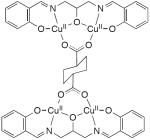
|
O2, MeOH | kcat = 10.1 h−1 | 986 | |
| 75 |
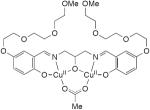
|
O2, 60% MeOH in H2O | kcat = 9.6 h−1 | 987 | |
| 76 |
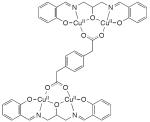
|
O2, MeOH, pH = 9.0 | kcat = 9.36 h−1 | 988 | |
| 77 |
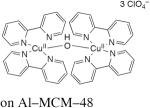
|
O2, NEt3, MeOH | TON = 174 h−1 | 989 | |
| 78 |
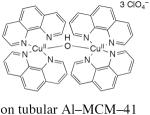
|
O2, NEt3, MeOH | TON = 137 h−1 | 990 | |
| 79 |

|
O2, MeOH, 48 h | 92.6% | kcat = 12.8 h−1 | 991 |
| 80 |

|
O2, MeOH | kcat = 2.4 h−1 | 992 |
Common structural motifs found in the catalysts include amines and pyridines to mimic the histidine ligands found in the active site of tyrosinase as well as bridging phenols to mimic the μ-hydroxide groups in the enzyme. In general, binuclear copper(II) complexes show stronger catecholase activity, with an optimum Cu–Cu interatomic distance of 3 Å.928,986,988,991 The utility of binuclear metal complexes suggests that both copper centers are involved in the formation of one ortho-quinone. This mechanism depends on catalyst structure, and smaller ligands such as TMEDA appear to react through a mononuclear species.993 The reaction is promoted by high pH, either in the form of added amine base or aqueous buffer solution.994 The rate order of the reaction varies across catalyst structures.995 Das reported the most efficient catalyst, a binuclear salen ligand, in 2008.913
A proposed mechanism for this oxidation process is shown in Scheme 452.917 Displacement of bound water molecules in I by the catechol substrate forms bridging-catechol complex II. Oxidation of the substrate gives binuclear copper(I) complex III, which is oxygenated to give peroxo complex VI. A second molecule of catechol displaces the ortho-quinone product; homolysis of the peroxo bond with concurrent hydrogen abstraction followed by departure of the second equivalent of ortho-quinone regenerates the active catalyst I.
Scheme 452.
Proposed mechanism for the aerobic oxidation of 3,5-di-tert-butylcatechol with a binuclear copper complex.
Though the catechol oxidase enzymatic reaction forms water as its only byproduct,908 some copper complexes do not effect the full reduction of molecular oxygen, forming hydrogen peroxide as a byproduct. Uzu and Sasaki took advantage of this difference by utilizing the peroxide formed in the oxidation of ascorbic acid to effect the chemiluminescence of luminol (Scheme 453).937 When binuclear complex I is treated with hydrogen peroxide, a red shift occurs, suggesting that the peroxide binds to the copper to form complex II. Oxidation of luminol and subsequent chemiluminescence regenerates the active catalyst I. Notably, no chemiluminescence was observed using Cu(OAc)2 or a mixture of Cu(OAc)2 and ligand, indicating that the pre-formed complex is required for proper catecholase activity. The copper catalyst displayed activity comparable to that of the standard luminal substrate hemin, an iron-containing porphyrin.
Scheme 453.
Mechanism of the oxidation of ascorbic acid with concurrent luminol chemiluminescence.
Other substrates have been examined for the catalytic oxidation of catechol by copper(II) complexes (Table 23). However, complex mixtures of products are common, and a singular product is seldom isolated. Instead, rates of ortho-quinone formation are monitored using the UV-visible spectroscopy.
Table 23.
Other catechols examined in the copper-catalyzed aerobic oxidation reaction.
| Entry | Starting Material | Product(s) | Copper Complex | conditions | rate info | ref |
|---|---|---|---|---|---|---|
| 1 |
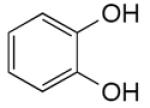
|
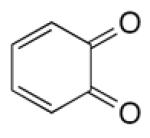
|

|
kobs = 349 h−1 | 996 | |
| 2 |
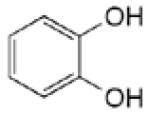
|
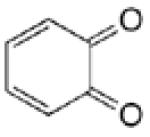
|

|
air, water, pH = 7.05 | kobs = 15.6 h−1 | 1003 |
| 3 |
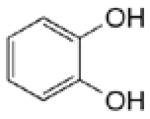
|
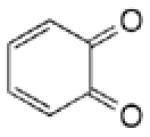
|
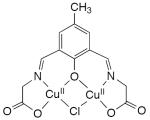
|
air, H2O | kobs = 2.28 h−1 | 1002 |
| 4 |
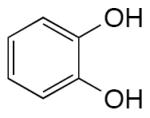
|
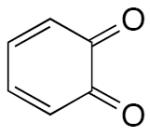
|
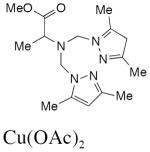
|
O2, MeOH | kobs = 1.08 h−1 | 997 |
| 5 |
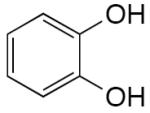
|
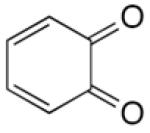
|

|
O2, DMF | kobs = 0.804 h−1 | 998 |
| 6 |
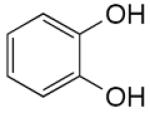
|

|
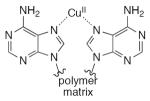
|
O2, MeOH/H2O | kcat = 0.047 h−1 | 999 |
| 7 |
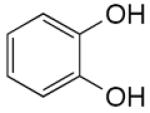
|
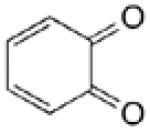
|
Cu(NO3)2•3H2O | O2, H2O, pH = 5.3 | kobs = 5.28×105 M−1/2 s−1 | 1000 |
| 8 |

|

|
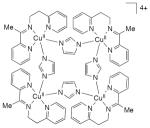
|
O2, MeOH | kobs = 1.44 h−1 | 1001 |
| 9 |

|

|

|
air, H2O | kobs = 1.44 h−1 | 1002 |
| 10 |

|

|

|
air, water, pH = 7.05 | kobs = 0.54 h−1 | 1003 |
| 11 |

|

|
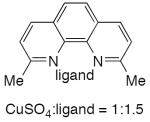
|
O2, 70% Dioxane in H2O | none given | 1004 |
| 12 |

|

|

|
air, water, pH = 7.05 | kobs = 32.4 h−1 | 1003 |
| 13 |

|

|
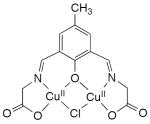
|
air, H2O | kobs = 2.16 h−1 | 1002 |
| 14 |

|

|

|
air, H2O, pH = 6.5 | kobs = 1.14 h−1 | 1005 |
| 15 |

|

|

|
air, water, pH = 7.05 | kobs = 6.06 h−1 | 1003 |
| 16 |

|

|
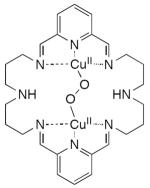
|
O2, MeOH | TON = 4 h−1 | 983 |
| 17 |

|

|

|
O2, MeOH/H2O | kcat = 0.0058 h−1 | 999 |
| 18 |

|

|
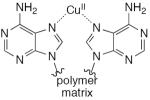
|
O2, MeOH/H2O | kcat = 0.0058 h−1 | 999 |
| 19 |
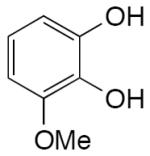
|
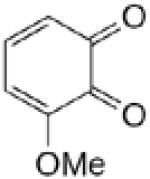
|

|
air, water, pH = 7.05 | kobs = 47.4 h−1 | 1003 |
| 20 |

|
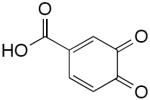
|
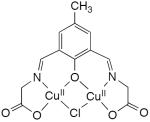
|
air, H2O | kcat = 0.78 h−1 | 1002 |
| 21 |

|

|
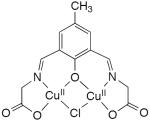
|
air, H2O | kcat = 0.48 h−1 | 1002 |
| 22 |
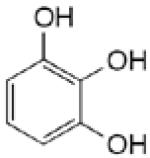
|
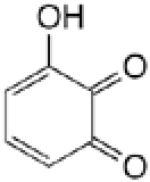
|

|
O2, DMF, pH = 8.0 | kcat = 750 h−1 | 1006 |
The facile formation of ortho-quinones has also been leveraged to provide a means of separating racemic catechols. The first kinetic resolution of dopamine by a copper complex under an aerobic atmosphere was reported in 1970, using a polymeric (S)-lysine catalyst (Scheme 454).1007 The krel value, calculated as the ratio of initial rates using either enantiomer of dopamine, was found to be 1.5, in favor of D-dopamine. The catalyst is believed to arrange itself into a helix into solution, and the enantiodifferentiation comes from differences in the interaction of the dopamine with this helical structure.
Scheme 454.
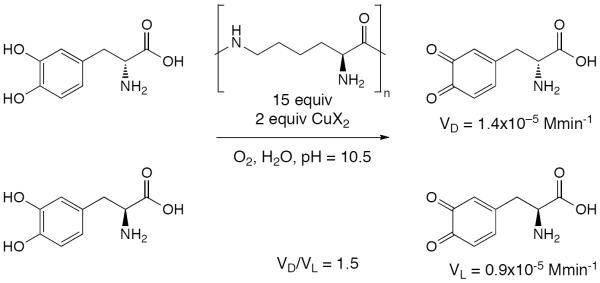
The first oxidative kinetic resolution of dopamine using copper and molecular oxygen.
BINAM-linked tetraimidazole catalysts have been shown to effect an enantioselective aerobic oxidative kinetic resolution of dopamine methyl ester (Scheme 455).967,1008 The krel of the transformation, taken as the ratios of the kcat/KM values for each enantiomer, is 3.96. The difference in reactivity between enantiomers is attributed to the much stronger binding of D-dopa to the catalyst and a slightly faster reaction for the D-dopa–catalyst adduct. Lysine-linked tetrabenzimidazole catalysts give better overall reaction rates by almost an order of magnitude at the expanse of selectivity (krel = 2.34). Unfortunately, this high selectivity does not carry over to the unprotected acid, in which case the krel is just 1.36. In general, the quinone products from these reactions are unstable and prone to further reaction, so they are trapped through condensation with 3-methyl-2-benzothiazoline hydrazone (MBTH, Scheme 456).
Scheme 455.
Oxidative kinetic resolution of dopamine methyl ester.
Scheme 456.
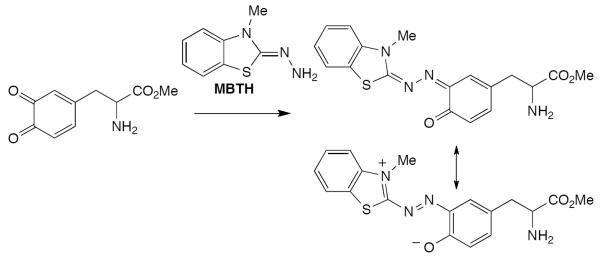
In situ trapping of the quinone product with 3-methyl-2-benzothiazoline hydrazone (MBTH).
A similar catalyst has been found to effect a diastereoselective kinetic resolution of catechin and epicatechin (Scheme 457).1009 Again, the selectivity comes more from the stronger binding of the reactive diastereomer than the faster rate of the subsequent oxidation. A krel of 4.04 was observed for this transformation.
Scheme 457.
Kinetic resolution of catechin and epicatechin.
The copper-catalyzed aerobic oxidative kinetic resolution has also been performed in micelles using a long-chain alkyl-substituted histidine catalyst.1010 Enantiomerically pure L-dopamine is treated with either an L- or a D-histamine catalyst using a micellar solution of cetyltrimethylammonium bromide in water/methanol. (Scheme 458). A krel as high as 2.5 was observed at 10 °C. Increasing the temperature increased the reaction rate by a factor of 10 but decreased the krel to 1.42.
Scheme 458.
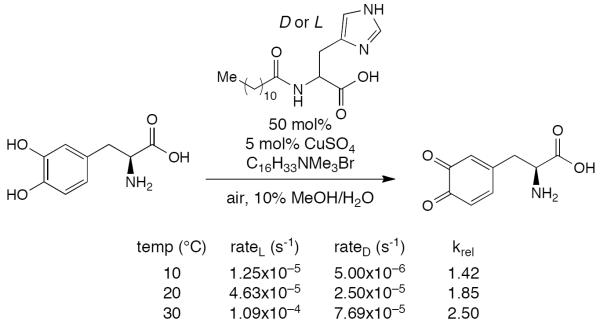
Effect of temperature on the krel of a diastereoselective aerobic oxidation of L-dopamine with a chiral copper complex.
VII.E.2. Oxidative Cleavage of Catechols
The oxidative cleavage of catechols to cis-cis-muconate esters is catalyzed by the iron-containing enzyme pyrocatechase.1011,1012 This same transformation can be effected by stoichiometric copper under an oxygen atmosphere (Scheme 459).1013 The reaction can also use phenol as a starting material, though a greater excess of copper (4 equiv) is required. In this case oxidative cleavage follows oxygenation of the phenol to catechol.1014 The reaction does not work without the alcohol solvent, and only one carboxylate is esterified in the reaction. When conducted in the presence of ammonia, the reaction yields a nitrile in place of the ester.1015
Scheme 459.

Oxidative cleavage of catechols by stoichiometric copper under oxygen.
Oxygen labeling experiments showed that the atmospheric oxygen is incorporated into the carboxylic acid of the product as well as the water byproduct.1016 The reaction mechanism, shown in Scheme 460, is analogous to that of the oxidative cleavage of 1,2-diketones (Section V.D). The catechol forms a chelated complex with an equivalent of copper; the intermediacy of this species has been shown by oxidation studies of the isolated complex.1017 Oxidation of the catechol by copper(II) forms a semiquinone radical that captures oxygen with concurrent copper oxidation. The exact mechanism of the cleavage step is not well understood, but it may proceed through methanol-mediated ring opening of the peroxo complex.1018 Binuclear mechanisms have also been proposed.1019 Later studies showed that the reaction can be performed using excess copper(II) under a nitrogen atmosphere, suggesting the oxygen is only required to oxidize the copper(I) to copper(II) and that the incorporated oxygen comes from that initial catalyst oxidation.1020 The mechanism shown in Scheme 460 does not account for this observation, and no mechanism has been reported for the stoichiometric oxidation under inert atmosphere.
Scheme 460.
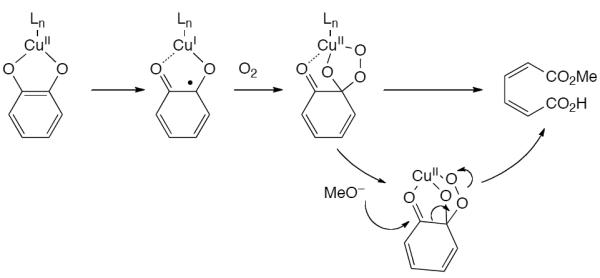
Possible mechanism for the copper-mediated oxidative cleavage of catechols under oxygen atmosphere.
The substrate scope of this reaction is limited to electron-rich catechols (Scheme 461).1021 Halogenated substrates give low yields. Unsymmetrical starting materials give mixtures of isomeric products. The reaction works best with methanol, and larger alcohols give lower yields. The reaction requires high dilution and slow addition of catechol to prevent polymerization. The yield of some substrates can be improved through the use of supported copper catalyst such as polystyrene-polyvinylpyridine (PSP) copper complexes.1022
Scheme 461.
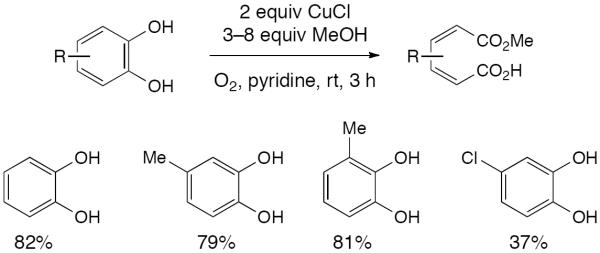
Substrate scope in the oxidative cleavage of catechols.
VII.F. Reactions of Hydroquinones
VII.F.1 para-Quinone Formation from Hydroquinones
When treated with copper catalysts under aerobic conditions, hydroquinones undergo facile oxidation to para-quinones. This reaction is not as well studied as the oxidation of catechols to ortho-quinones, presumably due to the lack of a similar enzymatic reaction and the poor stability of hydroquinones, which undergo autooxidation in alkali solutions under air.1023 Copper nanoparticles embedded in AlO/OH show a good substrate scope, with most substrates giving good yields of the para-quinone (Scheme 462).1024 The method is successful in the case of both electron-rich alkyl-substituted and electron-poor halogenated hydroquinones. An alumina-supported copper complex,651b a copper valproate complex,944 and a metal-organic framework (MOF) complex1025 have also been shown to oxidize hydroquinone to para-quinone, albeit in lower yield. Stoichiometric copper(II) can be employed under anaerobic conditions, but the reaction is much slower.1026
Scheme 462.
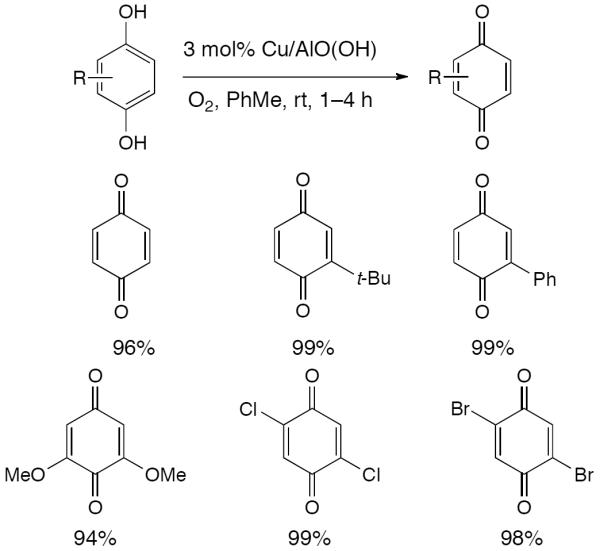
Oxidation of 1,4-hydroquinones to para-quinones using embedded copper nanoparticles.
Myers and coworkers applied a very mild copper-mediated aerobic oxidation of hydroquinones to para-quinones in the total synthesis of the sensitive enediyne (+)-dynemicin A (Scheme 463). Treatment of a Diels-Alder adduct model system with 4 equivalents of CuCl in the presence of HF-pyridine under an oxygen atmosphere resulted in selective cleavage of phenolic silyl ethers with concurrent oxidation to the para-quinone.1027
Scheme 463.
Copper-mediated aerobic oxidation to a para-quinone in the total synthesis of (+)-dynemicin A.
Love and coworkers applied a copper-catalyzed oxidation of a bisphenol in the total synthesis of oosporein (Scheme 464).1028 The four step synthesis was completed in 24% overall yield and required no column chromatography. Notably, the one-step oxidation procedure produced fewer byproducts than a two-step process that utilized both copper(II) and iron(III) oxidants.
Scheme 464.
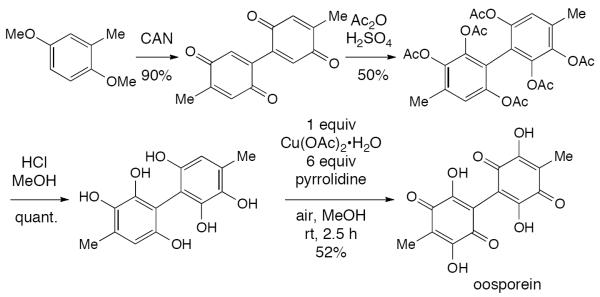
Quinone oxidation in the total synthesis of oosporein.
VII.F.2 Substitution and Oxidation of Hydroquinones to para-Quinones
In the presence of alcohols under oxidative conditions, para-hydroquinones rapidly form para-quinones, which are subject to nucleophilic attack to form substituted hydroquinones that oxidize back to the para-quinone. The utility of this transformation was demonstrated in the synthesis of 2-acyl-3-alkoxyl-para-quinones from 2-acylhydroquinones (Scheme 465).1029 No oxidation of the alcohols is observed, which is notable in the case of the benzyl alcohol, a common substrate for alcohol oxidation (see Section IV.A.1). The mechanism of this reaction is shown in Scheme 466. The regioselectivity observed comes from the greater electrophilicity of the position ortho to the acyl group.
Scheme 465.
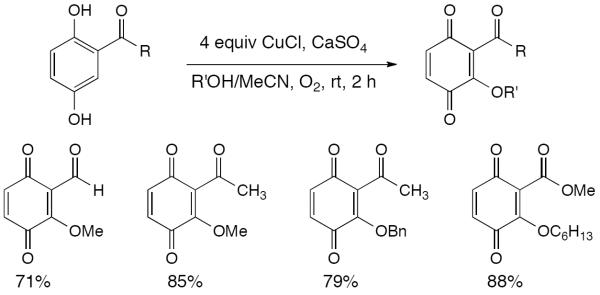
Preparation of 2-acyl-3-alkyoxy-para-quinones via oxidation, nucleophilic addition, and oxidation.
Scheme 466.
Mechanism for the sequential oxidation, nucleophilic addition, and oxidation.
The same type of transformation occurs with other nucleophiles, such as amines. Treatment of hydroquinone with two equivalents of a primary or a secondary amine in the presence of catalytic copper nanoparticle-embedded aluminum oxyhydroxide under an oxygen atmosphere yields the bisaminoquinone product in excellent yield (Scheme 467).1024
Scheme 467.
Oxidative bisamination of hydroquinones to 2,5-diamino-para-quinones.
VII.G. Reactions of Quinones via the Hydroquinones
Amine nucleophiles can also be employed in the oxidation, substitution, oxidation sequence. In 1948 it was determined the use of copper salts in the double addition of dimethylamine to benzoquinone allows for much higher reaction yields, as the starting quinone was no longer responsible for oxidizing the nucleophilic addition products.1030 Further investigation of this method showed that the reaction was amenable to a number of dialkyl secondary amines (Scheme 468).1031
Scheme 468.
Substrate scope of the nucleophilic addition of dialkyl amines to quinones under oxidizing conditions.
In the case of unsymmetrically substituted quinones, the amine adds to the more electrophilic site on the quinone. For example, in Scheme 469, the 1-position can be considered as a vinylogous ester, while the 2-position, which leads to the major product, can be considered as a vinylogous ketone.1032
Scheme 469.

Amine addition to unsymmetrically substituted quinones under oxidative conditions.
The addition of amines to unsymmetrical quinones was employed in the synthesis of functionalized helicenes (Scheme 470).1033 Treatment of a racemic mixture of helical chiral bisquinones with (S)-2-prolinol in the presence of Cu(OAc)2 and oxygen resulted in regioselective bisamination. The diastereomers thus formed can be separated, and an X-ray crystal structure confirmed the absolute configuration of the helicene as well as the regioselectivity of the amination reaction. The selectivity is believed be guided by the phenol ethers on neighboring rings.
Scheme 470.
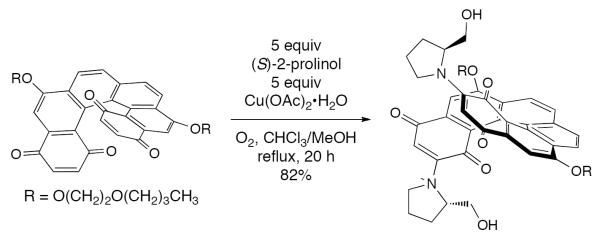
Oxidative bisamination in the synthesis of functionalized helicenes.
Anilines can also be used in the nucleophilic oxidative addition to quinones (Scheme 471).1034 The reaction tolerates one ortho-substituent on the aniline, but lower yields are seen in bis-ortho-substituted nucleophiles. Both electron-withdrawing and electron-donating groups are tolerated on the aniline, as is N-methylaniline.
Scheme 471.
Oxidative addition of anilines to naphthoquinone.
Liu and Sun have reported a multicomponent coupling featuring an oxidative nucleophilic amination reaction. Treatment of a naphthoquinone with an α-bromocarbonyl and three equivalents of pyridine results in incorporation of one pyridine into a fused tetracycle.1035 A representative sample of the substrate scope is shown in Scheme 472. The reaction tolerates pyridine, 4-alkylpyridine, and isoquinoline nucleophiles. The α-bromocarbonyl cannot have any other enolizable positions; for R2, both alkoxy groups and sterically unencumbered arenes work well.
Scheme 472.
Multicomponent coupling via oxidative addition to 1,4-naphthoquinone.
A proposed mechanism for this transformation is shown in Scheme 473. Nucleophilic addition of pyridine followed by oxidation of the intermediate hydroquinone generates a pyridinium salt. Nucleophilic displacement of the bromide followed by deprotonation generates a zwitterionic nucleophile that attacks the quinone. Proton transfer and a nucleophilic attack on the pyridinium followed by elimination of pyridine and oxidation of the hydroquinone gives the fused tetracyclic product.
Scheme 473.
Proposed mechanism for the oxidative multicomponent coupling of naphthoquinone, pyridine, and α-bromoacetophenone.
VII.H. Tandem Reactions of Phenols and Naphthols
VII.H.1. Ring Contraction of Phenols
While investigating the copper-catalyzed oxidation of phenol in the presence of methanolic solvent, Rossi and coworkers observed an unexpected ring contraction (Scheme 474). At ambient temperatures, phenol yielded the expected 4,5-dimethoxyl-ortho-quinone. However, increasing the temperature to 70 °C resulted in the formation of a substituted cyclopentenone. A crystal structure, as well as 1H and 13C NMR confirmed the structure. The mechanism of this reaction is not known, but the intermediacy of the expected dimethoxy-ortho-quinone was confirmed, as re-exposure of this compound to reaction conditions results in the same ring-contracted product.1036 The reaction may proceed through an oxidative ring cleavage (see Section VII.E.2). This method was extended to a series of substrates incorporating different alcohols (Scheme 475).
Scheme 474.
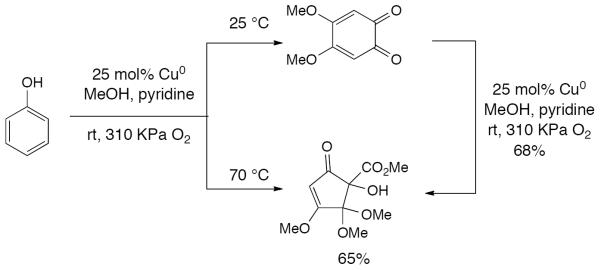
Unexpected ring contraction in the aerobic copper-catalyzed oxidation of phenol.
Scheme 475.
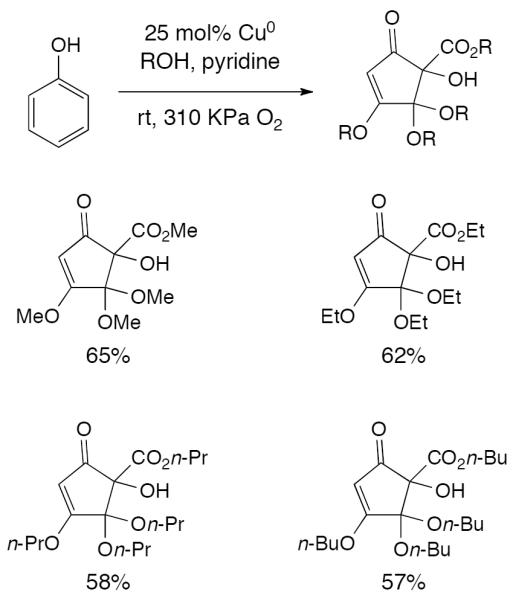
Screening various alcohols in theoxidative ring contraction of phenols.
VII.H.2. Quinone Formation and Condensation of Phenols
Aminophenols undergo different transformations upon treatment with copper catalysts in the presence of molecular oxygen, depending on the substitution pattern.1037Para-aminophenol undergoes additions and oxidations to form a complex mixture of products; the only identifiable product is shown in Scheme 476. meta-Substituted aminophenol gives an unsymmetrically substituted quinone formed by oxygenation para to the phenol followed by oxidative nucleophilic addition to the quinone (cf., Sections VII.F.1 and VII.D.2). The ortho-aminophenol undergoes a series of additions, condensations, and oxidations to form an oxidized dimeric product in excellent yield. The mechanism for the formation of this product is shown in Scheme 477.
Scheme 476.
The effect of substitution pattern on the oxidation of aminophenol.
Scheme 477.
Mechanism for the formation of an oxidized dimer of ortho-aminophenol.
VII.I. Phenol Functionalization via Reactant Oxidation
VII.I.1. Halogenation of Phenols
Most electrophilic halogenation reactions require a brominating reagent such as Br2 or N-bromosuccinimide, in which the anionic leaving group is formed as a byproduct. The aerobic copper-catalyzed oxidative bromination reaction uses bromide anions as the bromine source and results in no formation of byproducts (Scheme 478).1038 Through extensive mechanism and substrate scope investigations, Stahl and coworkers have determined that the copper catalyst serves to oxidize the bromide anions to Br2, which then undergoes electrophilic bromination. The molecular oxygen then oxidizes the copper(I) back to the active copper(II) catalyst, completing a catalytic cycle similar to that seen in Section II.F.1.1039
Scheme 478.
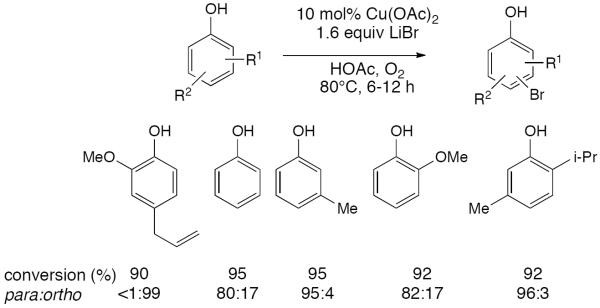
Oxidative halogenation of phenols.
A similar method has been reported for the oxidative chlorination of phenols, using CuCl2 and molecular oxygen.1040 This reaction displays similar regioselectivity and substrate scope, but it is unlikely that CuCl2 oxidizes the chloride to chlorine. Rather, it is more likely that the phenol undergoes oxidation to the phenol radical, which is chlorinated by a chlorine radical.
The regioselective oxidative bromination with low copper catalyst loading and hydrobromic acid as the sole bromine source is very successful with phenolic substrates (see Section II.E.2 for non-phenolic substrates).258 The phenol oxygen itself is not oxidized in the reaction; rather, the phenol acts to direct the electrophilic aromatic substitution of the small amount of molecular bromine generated in situ by the copper catalyst. The reaction is selective for monobromination at the para position of the phenol when both the ortho- and para-positions are open (Scheme 479).
Scheme 479.
Aqueous copper catalyzed oxidative bromination of phenols.
VII.I.2. Nitration of Phenols
Karlin and coworkers have demonstrated an oxidative nitration of 2,4-di-tert-butylphenol. Treatment of a copper complex with nitric oxide gas, followed by removal of the gas and bubbling oxygen to give the peroxynitrite complex. This complex is added to a substoichiometric of phenol with 5 equivalents of t-Bu4NCl at −80 °C, and then warmed to room temperature to give 55% yield of the nitrated phenol and 12% of the ortho-coupled bisphenol (Scheme 480).711
Scheme 480.
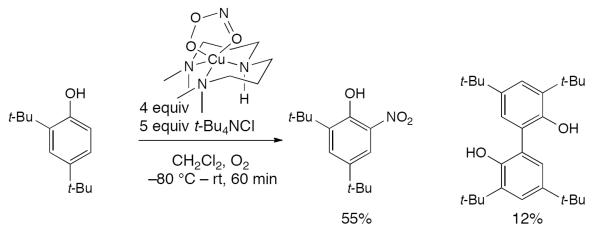
Oxidative nitration of a phenol.
VII.J. Reactions of 4-Alkylphenols
VII.J.1 Aldehyde from 4-Alkylphenols
Upon treatment of 2,4,6-trimethylphenol to oxidative conditions using CuCl2 and molecular oxygen, an aldehyde is isolated in good yield.1041 The yield of the reaction can be improved with addition of acetone oxime, and the ratio of products can be controlled by moderation of the reaction time (Scheme 481).1042 The reaction is believed to proceed via an ortho-quinone methide that undergoes nucleophilic attack by the alcohol solvent (Scheme 482). A second oxidation/addition sequence gives an acetal that can be hydrolyzed to give the aldehyde product. Further oxidation of this compound gives a radical that captures molecular oxygen. Elimination of formic acid gives the observed para-quinone product. Alternatively, the para-quinone can be formed from protonation of the initial peroxy radical followed by rearrangement to expel methanol.
Scheme 481.
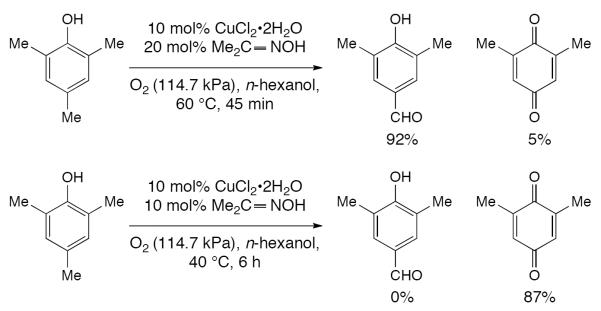
Oxidation of 2,4,6-trimethylphenol to 3,5-dimethyl-4-hydroxybenzaldehyde or 2,6-dimethyl-para-quinone.
Scheme 482.
Mechanism for the oxidation of 2,4,6-trimethylphenol to a benzaldehyde and a para-quinone.
The substrate scope can be improved considerably through the use of a polymer supported bipyridyl ligand (Scheme 483). The polymer catalyst can be recovered and reused at least 3 times without appreciable loss of activity.1043
Scheme 483.
Oxidative benzylic C-O coupling of a phenol using a supported catalyst.
Matsushima and coworkers found that the addition of copper(II) salts to the autooxidation of α-tocopherol, vitamin E, greatly accelerated the rate of oxidation and allowed for the isolation of appreciable amounts of 5-formyl-7,8-dimethyltocol (5-FTD) and α-tocoquinone. Interestingly, the product ratio is greatly affected by the solubilizing agent used (Scheme 484). When tetradecyltrimethylammonium bromide is used the major product is the formylated benzopyran (5-FTD). On the other hand, when sodium dodecyl sulfate is used, the major product is the ring-opened quinone (α-tocoquinone).1044 Both products are proposed to come from the same phenol radical intermediate (Scheme 485).
Scheme 484.
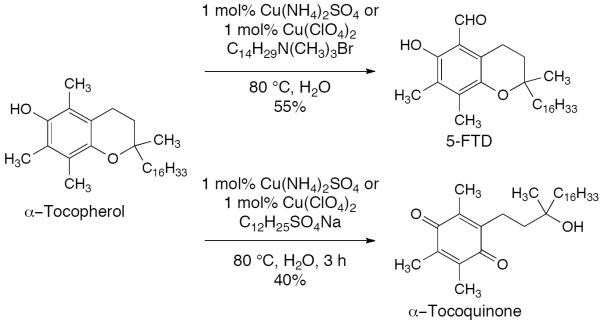
Oxidation of α-tocopherol in the presence of solubilizing agents.
Scheme 485.
A common intermediate in the oxidation of α-tocopherol to 5-FTD and α-tocoquinone.
VII.J.2 Benzylic Coupling of 4-Alkylphenols
The oxidation of 2,4,6-trimethylphenol with copper catalysts in the presence of alcohol solvents results in the formation of benzaldehydes (Scheme 481). When no alcohol solvent is present, the phenol undergoes benzylic coupling to give stilbenequinone products (Scheme 486).1045 The reaction is proposed to proceed through a benzyl radical; the high selectivity for the para-position is presumed to originate from the thermodynamic stability of the product formed. In the absence of oxygen only the stilbenequinone and unreacted starting material are obtained, suggesting that the oxidation of the initial coupling product occurs rapidly. A bioinspired binuclear copper complex1046 and a copper-urea oligomer have been shown to effect the same transformation in lower yield.698
Scheme 486.
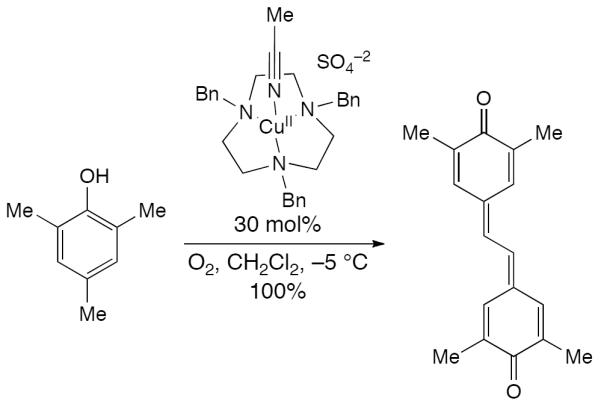
Oxidation of 2,4,6-trimethylphenol to yield stilbenequinone in the absence of alcohol.
VII.J.3 para-Quinone Formation from 4-Alkylphenols
As discussed in Section VII.J.1 (Scheme 481), oxidation of 2,4,6-trimethylphenol for an extended period of time results in oxidation to the para-quinone. As is common in phenol oxidations, slightly different conditions are required for the oxidation of each 2,4,6-trisubstituted compound to the para-quinone. The oxidation of 2,6-di-tert-butyl-4-methylphenol with copper(II) chloride requires slightly higher catalyst loading than 2,4-di-tert-butyl-6-methylphenol (Scheme 487).715
Scheme 487.
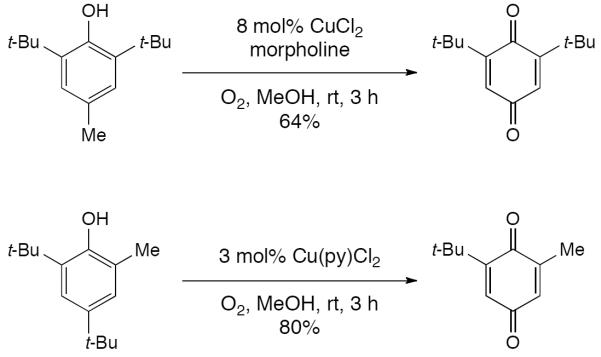
Oxidation of two isomers of di-tert-butyl-methylphenol
The oxidation of 2,6-di-tert-butyl-4-methylphenol with copper(I) is less clean, with 6 identified products formed with 5.5 mol% CuCl in four hours.1047 The major product of this reaction is 2,6-dimethyl-para-quione, formed in 27% yield (Scheme 488). The oxidation of 2,4,6-tri-tert-butylphenol yields the same para-quinone product with low catalyst loading and high temperatures, though the yield was not reported.1048
Scheme 488.
Products obtained in the copper-catalyzed aerobic oxidation of 2,6-di-tert-butyl-4-methylphenol.
VII.K. Alkenylphenol Coupling
Alkenylphenols can also undergo copper-catalyzed coupling. Here, however, the presence of the conjugated alkene allows for radical migration beyond the aromatic ring, leading to β,β-phenolic coupling (Scheme 489). The linked intermediate thus formed is perfectly aligned for an intramolecular hetero-Diels-Alder cycloaddition, leading to a complex tetracyclic structure. Using catalytic CuCl2 and (−)-sparteine, the reaction displays remarkable diastereoselectivity, affording the natural product carpanone as well as a series of congeners as single diastereomers in excellent yield.1049 Unfortunately, extensive reaction optimization resulted in <5% ee, suggesting that the chiral complex exerts no influence on the stereoselectivity in the initial carbon-carbon bond formation.
Scheme 489.
Oxidative alkenylphenol coupling to carpanone.
VII.L. Dearomatization of Phenols and Naphthols
In addition to the dearomatization reactions discussed above (i.e., formation of para-quinones, Sections VII.D.2 and VII.F, and formation of ortho-quinones, Section VII.E.1), the copper-catalyzed oxidation of phenols can generate sp3 centers on aromatic rings. For example, treatment of 1-methoxyl-2-naphthol with CuCl2 and pyridine under oxygen in methanol generates a dimethyl quinone ketal in excellent yield (Scheme 490).1050
Scheme 490.

Oxidative dearomatization of 1-methoxy-2-naphthol.
Phenols require forcing conditions to achieve oxidative dearomatization. Treatment of methylated hydroquinones with CuCl-pyridine in methanol under oxygen results in oxidative nucleophilic addition of solvent to generate a ketal (Scheme 491).715 When the reaction is conducted in the presence of a secondary amine such as morpholine, the oxidative dearomatization results in a aminal. When no ortho- or para-methoxy group is present relative the phenol, the oxidative dearomatization reaction results in addition of solvent to the least hindered ortho- or para-position (Scheme 492). No mechanism has been reported for this transformation.
Scheme 491.
Oxidative dearomatization of dialkyl-monomethoxyphenols.
Scheme 492.

Oxidative dearomatization by addition of solvent to the least hindered position.
Inspired by the investigation of Stack and coworkers on oxygenated copper complexes from sterically hindered bidentate amine ligands, and the use of these complex as tyrosinase mimics (see Section VII.D),79e,419,1051,1052 Porco and coworkers utilized a chiral bis-copper(II)-peroxo complex from (−)-sparteine (Scheme 493). This complex was applied to the oxidative dearomatization of a highly substituted alkynylphenol to form a vinylogous carboxylic acid. The treatment of this intermediate with mild acid resulted in the formation of azaphilones in good yield with excellent enantioselectivity (Scheme 494).1053 The addition of base facilitates the reaction through formation of a phenolate anion that is oxidized by the copper complex. This oxidation reaction was applied to the enantioselective total synthesis of (S)-15183a1053 and (−)-mitrorubin (Scheme 495).1054
Scheme 493.

(−)-Sparteine derived tyrosinase mimic.
Scheme 494.
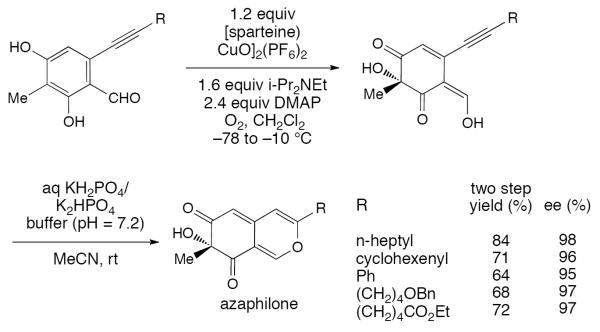
Asymmetric dearomatization of bisphenols en route to azaphilones.
Scheme 495.
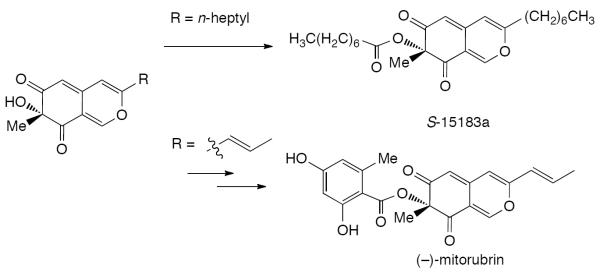
Total syntheses using asymmetric dearomatization as a key step.
Sparteine exists as only one enantiomer in nature and its synthesis is not trivial, so Porco and coworkers utilized the (+)-sparteine surrogates developed by O'Brien and coworkers1055 to achieve the total syntheses of (+)-sclerotiorin and (+)-8-O-methylsclerotiorinamine, as well as a series of natural product congeners (Scheme 496).1056
Scheme 496.
Utilization of a (+)-sparteine surrogate in an oxidative dearomatization.
The copper(II)-(−)-sparteine reagent (Scheme 493) was applied to the synthesis of oxidized dimers of 5-substituted-2-methylphenols. Treatment of the phenol with the oxidized reagent leads to formation of a quaternary allylic alcohol which undergoes facile [4+2] cycloaddition to yield complex adducts in good yield and excellent enantioselectivity (Scheme 497).1057 This biomimetic oxidative dimerization was employed in the late stages of the total synthesis of aquaticol. Here, a chiral catalyst was added to a chiral substrate to provide the product as a single diastereomer (Scheme 498).
Scheme 497.
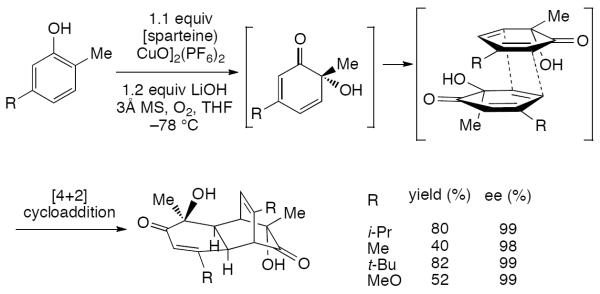
Tandem asymmetric dearomatization.
Scheme 498.
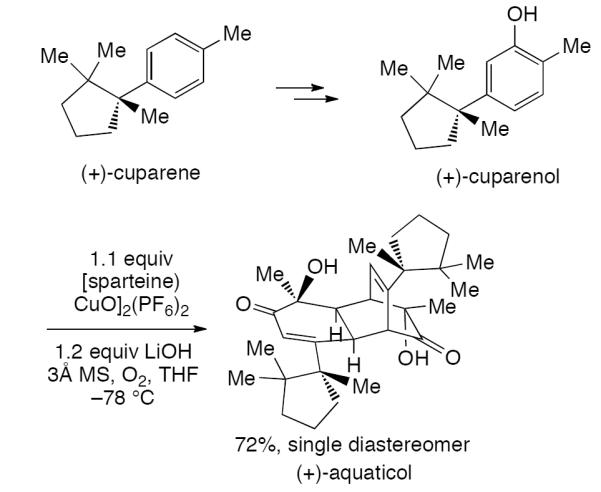
Total synthesis of aquaticol via asymmetric dearomatization.
The Diels-Alder adducts formed in the oxidative dimerization reaction can be employed as masked ortho-benzoquinones in further reactions. Heating the adducts results in a retro-Diels-Alder reaction, revealing a diene that can be treated with different dienophiles to yield new [4+2] cycloaddition products. This method was applied to the total synthesis of (+)-chamaecypanone C (Scheme 499).1058 To generate the desired Diels-Alder adduct enantiomer, lithium 4-isopropyl-2-methylphenolate was subjected the oxidative dearomatization conditions followed by reflux in benzene to effect an α-ketol rearrangement. Dimerization of the rearranged benzoquinone afforded the necessary (+)-adduct in 47% yield and >99% ee over two steps. Oxidation of a cyclopentenone with DDQ affords a cylopentadieneone, which undergoes a Diels-Alder reaction with the diene that arises from retro-Diels-Alder reaction of the dimer from the prior step. Subsequent removal of methyl ethers afforded the enantiopure natural product in 53% yield.
Scheme 499.
Oxidative Diels-Alder and retro-Diels-Alder in the total synthesis of (+)-chamaecypanone C.
VIII. Reactions of Anilines
Anilines are similar to phenols in that an electron rich aromatic ring can undergo oxidation in the presence of copper and oxidation. However, two distinct differences, a much less acidic heteroatom that does not spontaneously deprotonate and coordinate to copper along with a more nucleophilic heteroatom, give rise to much different outcomes. As a consequence, C-C coupling of anilines is rare compare to phenols. More often, N-N coupling resulting in diazo compounds or C-N coupling resulting in iminoquinones or polymerization occurs. Depending on the specific nature of the substrate, other oxidative pathways can occur, such as intramolecular cyclization to afford various heterocycles or oxidative cleavage of the aromatic ring.
VIII.A. C-C Couplings of Anilines
While the effective oxidative coupling of naphthols and phenols has been accomplished with copper catalysts using oxygen (see Section VII), the equivalent transformation of anilines and naphthylamines has been met with limited success. Anilines tend to undergo other oxidative pathways when treated with copper and oxygen, such as diazo formation or polymerization (see Sections VIII.B and VIII.C). However, a small number of methods to produce binaphthyls via C–C bond formation from naphthylamines have been reported. The use of stoichiometric copper with amine ligands has been described for the homocoupling of 2-naphthylamine as well as heterocoupling with naphthols in moderate yields; the use of chiral ligands (sparteine, α-methylbenzylamine provides the adduct in moderate enantiomeric excess, but low yield).670,1059 Unfortunately, extension of this method to other substrates is complicated by carbazole formation and other pathways.1060 A similar method has been reported utilizing stoichiometric amounts of a CuCl2(BnNH2)2 complex to oxidatively couple 2-naphthylamine in good yield (Scheme 501).1061 Performing the reaction with or without air provided similar reaction efficiency. Notably, lowering the catalyst loading to 50 mol% afforded the product in 56% yield.
Scheme 501.

Oxidative coupling of 2-naphthylamine with a benzylamine-copper catalyst.
Perhaps the most successful example of an aerobic, copper-catalyzed aniline coupling utilizes copper(I)iodide with sparteine as ligand in the coupling of 3-methyl-2-aminonaphthalene.1062 The desired product was obtained in moderate yield and low selectivity along with significant amounts of byproducts from C-N bond forming pathways (Scheme 502). In the presence of equal amounts of a naphthol substrate, heterocoupling could also be effected, with the dimeric naphthol produced as the major byproduct (Scheme 503). Interestingly, better results were afforded with slow addition of oxygen into the reaction as opposed to an oxygen atmosphere, and no reaction was observed without oxygen.
Scheme 502.
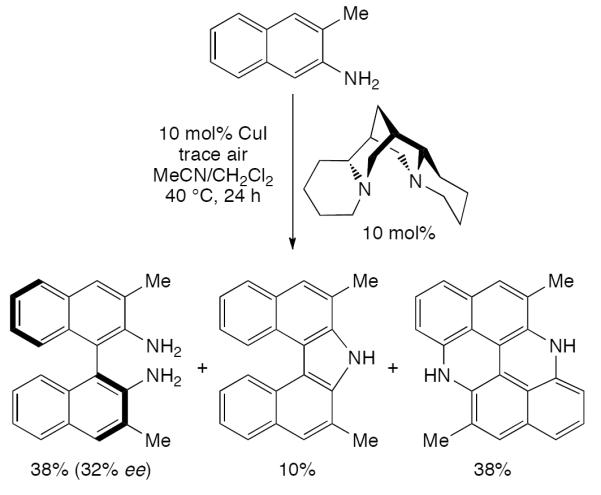
Asymmetric, catalytic, oxidative coupling of a 2-naphthylamine.
Scheme 503.
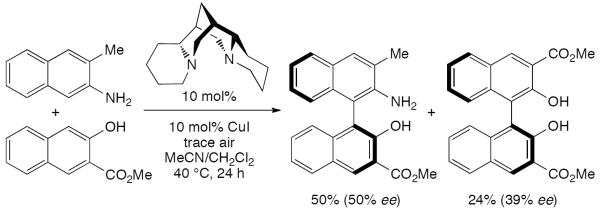
Asymmetric oxidative cross-coupling of a 2-naphthylamine and a 2-naphthol.
VIII.B. N-N Couplings of Anilines: Azo Formation
In contrast to the C–C biaryl bond formation discussed above, primary, unhindered anilines react with copper and oxygen predominantly via N–N bond formation to afford the diazene derivative, which is typically referred to as the azo dimer. A useful review on recent advances of azobenzene chemistry was published in 2009.1063 Intramolecular versions of oxidative N–N bond formation can occur to form a variety of heterocycles, and are discussed in Section VIII.D.
Initial work in the 1950's by Terent'ev and coworkers described the use of catalytic amounts of CuCl in pyridine to afford azo compounds in high yield for a small number of primary anilines (Scheme 504).1064 Other copper sources, including CuBr, CuI, and CuCl2 as well as other solvents were ineffective, supporting the notion of a CuCl-pyridine complex as the active catalyst.
Scheme 504.
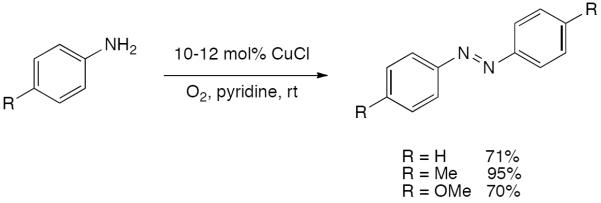
Early example of copper-catalyzed azo formation.
Concurrent work by Kinoshita described a similar system, also utilizing CuCl and pyridine in air to form azo compounds in high yield (Scheme 505).586,1065 Several key features of the reaction were established. While para-substitution was well tolerated, substitution at the ortho-position inhibited azo formation and allowed other reaction pathways. Additionally, the increased reactivity of electron rich substrates was determined by the selective formation of 4,4'-azoanisole in the reaction of equimolar amounts of aniline and p-anisidine. Subjecting hydrazobenzene (see Section IX.D for oxidation of hydrazines) to the standard oxidation conditions led to rapid azobenzene formation in nearly quantitative yield (Scheme 506). This result supports the intermediacy of hydrazobenzenes in the reaction.
Scheme 505.
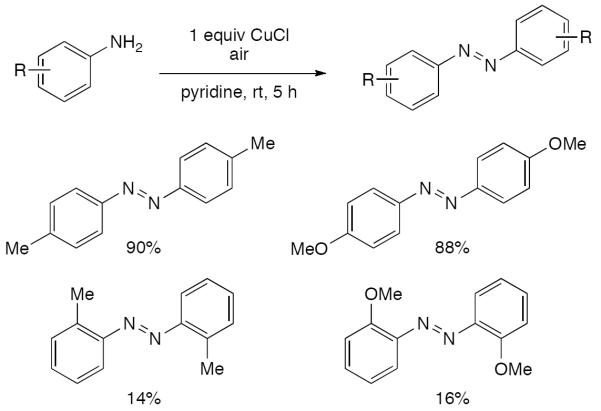
Effect of ortho-substitution on azo formation from anilines.
Scheme 506.

Copper-mediated oxidation of hydrazobenzene to azobenzene.
A later report by Terent'ev and Mogilyanskii further established the effects of substrate substitution on azo formation (Scheme 507).1066 Poor yields were observed with electron-withrawing or meta-substitution. While primary aliphatic amines and N-alkyl secondary anilines did not undergo oxidation, phenylhydroxylamine rapidly oxidized to form azoxybenzene (for further discussion, see below).
Scheme 507.
Substrate effect on copper-mediated oxidative diazo formation.
In 2008, nearly 50 years later, a study of aniline oxidation demonstrated that acetonitrile gave similar results in place of pyridine, although greater amounts of the CuCl catalyst (20 mol% vs 10 mol%) were needed and yields were slightly lower.1067 Very recently, Jaio and coworkers utilized catalytic amounts of CuBr with pyridine ligand in toluene and mild heating to produce an array of symmetric azobenzenes in good to excellent yields (Scheme 508).1068 Similar amine ligands, such as 2,2'-bipyridine and 1,10-phenanthroline were shown to be ineffective in the reaction. Notably, reaction with 2 equivalents of CuCl under a nitrogen atmosphere afforded none of the desired product, confirming the necessity of oxygen for product formation.
Scheme 508.
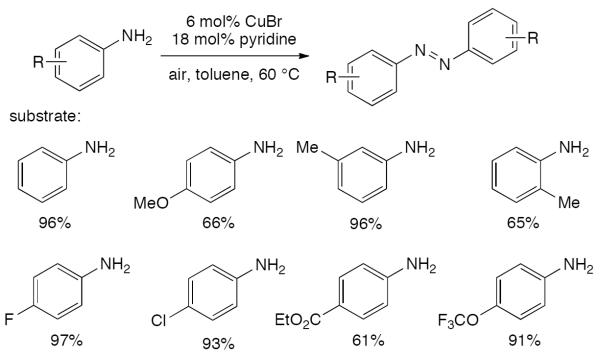
Catalytic, oxidative formation of azobenzenes.
Significantly, the formation of unsymmetrical azo compounds was also successful using this method.1068 Because homocoupling of the more electron-rich aniline occurs rapidly, a large excess of the electron-deficient coupling partner is necessary. Anilines containing ortho-, meta-, or para-substitution could be used as the limiting partner to afford the cross-coupled products in moderate to good yield (Scheme 509). This method offers a convenient alternative to the commonly employed azo coupling of aryldiazonium compounds with electron rich arenes.
Scheme 509.

Copper-catalyzed formation of unsymmetric azobenzenes.
The use of Grignard reagents as strong bases has been reported in the copper-catalyzed formation of azo compounds.1069 The process utilizes catalytic CuCl2 at rt, and a coordinating ligand, such as pyridine, is not required. Although only a limited substrate scope was explored, the described method afforded the desired azo compounds in excellent yield from even ortho-substituted substrates (Scheme 510). A nitroaniline, however, afforded no product, instead undergoing nucleophilic aromatic substitution with the Grignard reagent.
Scheme 510.
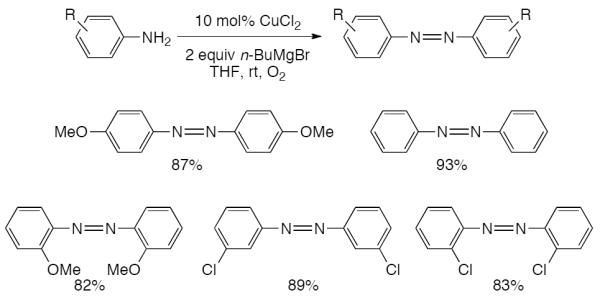
Copper-catalyzed formation of azo compounds with strong base.
A mechanistic proposal for the formation of azo compounds from anilines proceeds through initial oxidation of the substrate with copper to produce an aniline radical. Subsequent reaction with molecular oxygen could then afford nitrosobenzene after further oxidation. Condensation with unreacted aniline substrate then affords the azo product. However, subjecting nitrosobenzene and ethyl 4-aminobenzoate to typical coupling conditions did not afford any of the heterocoupled product (Scheme 511). Thus, intervention of a nitroso intermediate does not appear to be consistent with empirical data.
Scheme 511.

Postulated formation of azo compounds from nitroso intermediates.
In an alternate approach, support for the intermediacy of a nitrosobenzyl radical, which could form directly from aniline radical and oxygen, has been reported through EPR studies of the reaction.1070 This species is postulated to then dimerize and subsequently expel dioxygen after two-electron reduction from copper. In this mechanism, the role of oxygen is formation of the nitrosobenzyl radical as opposed to oxidation of a reduced copper species.
However, the most commonly invoked mechanism for azo formation proceeds through the aniline radical via one electron oxidation by a copper species (Scheme 512). The resulting radical undergoes N–N bond formation to produce the dimeric hydrazobenzene intermediate. The increased reactivity of electron rich substrates supports this mechanism. Improved yields with para-substitution can be rationalized based on sterics that prevent competitive “head-to-tail” C–N bond forming processes.1067 As demonstrated by Kinoshita and others, further oxidation of the hydrazobenzene under the reaction conditions rapidly produces the oxidized azo product. Oxygen not only oxidizes the reduced copper species to close the catalytic cycle, but also appears to play a role in generation of the initial aniline radical, possibly via formation of a peroxodicopper(II) complex as the active catalyst.1068
Scheme 512.

Mechanism of azo formation via oxidative N-N bond formation.
Oxidative N–N bond formation with secondary aniline species can also occur to yield hydrazine compounds. Tsuji and coworkers reported that treatment of diphenylamine with stoichiometric amounts of CuCl and oxygen in pyridine afforded the dimerized tetraphenylhydrazine product in excellent yield (Scheme 513).1071 However, extension of the method was limited as significant substrate effects were observed. For example, N-methylaniline afforded the hydrazine product in 52% yield. However, N-ethylaniline and di-2-naphthylamine did not form the product in significant yield, and other oxidation pathways including polymerization were noted.
Scheme 513.
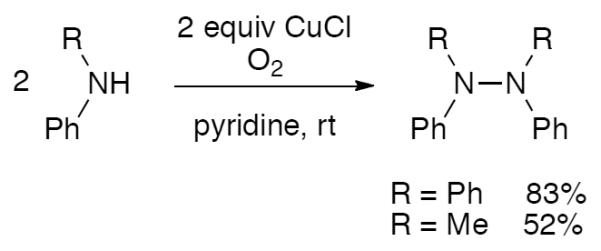
Copper-mediated formation of hydrazines from secondary anilines.
Later work by Huang and coworkers showed that addition of TMEDA as a ligand greatly expanded the scope of secondary aniline couplings using oxygen and CuBr as catalyst.1072 The use of CuO as a cocatalyst was also found to greatly enhance product yields. Reaction under a nitrogen atmosphere yielded trace product, and other oxidants, including TBHP and DDQ, also afforded poor yields. Under the optimized conditions, an array of N-alkylanilines containing alkyl, ether, and halogen substitution could be coupled in good yields (Scheme 514). Electron-rich substrates exhibited enhanced reactivity and yields, while substrates possessing strong electron-withdrawing groups, such as para-nitroaniline, did not undergo coupling under the reaction conditions. Steric hindrance, such as ortho-substitution, or use of N-isopropylaniline, also inhibited reaction. Interestingly, when employing anilines possessing ethers at the para-position, none of the anticipated N-N coupled product was formed. Instead, coupling occurred at the ortho-position, affording the C-N coupling products in high yields (Scheme 515). It is unclear at this time, why the para-alkyoxy anilines behave differently.
Scheme 514.
Copper-catalyzed formation of hydrazines from secondary anilines.
Scheme 515.
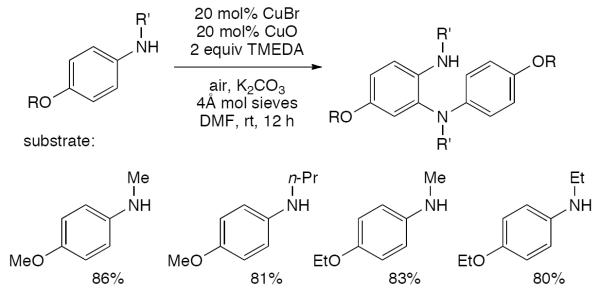
Oxidative formation of ortho-semidines from secondary anilines.
As first noted by Terent'ev during mechanistic studies on azo formation,1066 phenylhydroxylamine undergoes oxidation with copper and oxygen to afford azoxybenzene in high yield. A report by Hall and coworkers described the same process using small amounts of CuCl in pyridine with two N-hydroxyanilines. (Scheme 516).1073
Scheme 516.

Copper-catalyzed formation of azoxyarenes from N-hydroxyanilines.
The process was later applied to the polymerization of poly(azoxyarylene)s (see Section VIII.C). However, further investigation of the optimization and scope of this oxidative process have not been reported. Presumably, the process proceeds via an aniline radical similar to azo formation. After N–N bond formation, dehydration can afford the azoxy product. Alternatively, initial oxidation of the substrate could afford a nitroso compound that can undergo dehydration with unreacted starting material to directly afford the product. Further studies are needed to confirm the exact mechanism for this transformation.
VIII.C. Polymerization of Anilines
Many catalysts and oxidants have been studied for the synthesis of the conducting polyaniline polymers from the corresponding anilines. However, the oxidative polymerization using copper catalysts and oxygen remains relatively underexplored. A comprehensive review of oxidative polymerization of aromatic diamines was reported in 2002.1074
A report in 1994 by Toshima and coworkers described the use of copper(II) salts under oxygen to catalytically polymerize aniline in modest yield (Scheme 517).1075 The use of a 1:1 mixture of acetonitrile and water as solvent was critical to higher turnover frequency. The polymer obtained by this method was found to be of the emeraldine form, although analysis by NMR indicated small amounts of additional branching structures. These unwanted byproducts are putatively formed via incorporation of an additional aniline unit at the ortho-position rather than via the normal head-to-tail pathway.
Scheme 517.

Copper(II)-catalyzed polymerization of aniline.
Xylidine isomers were studied under the polymerization conditions to determine the steric effects of methyl substitution on the outcome (Scheme 518). The reaction of 2,6-dimethylaniline smoothly produced the polymer, indicating no change in reactivity due to sterics at the ortho-position. In contrast, 3,5-dimethylaniline did not polymerize, but rather afforded a stable copper dimer complex. As expected, substitution at the para-position also blocked the polymerization pathway, and instead led to azo formation (see Section VIII.B).
Scheme 518.
Effect of substitution on the oxidative polymerization of dimethylanilines.
Bicak and Karagoz have described the oxidative formation of polyaniline using catalytic Cu(NO3)2 and oxygen under aqueous emulsion conditions (Scheme 519).1076 The polymerized material obtained in this fashion is in the emeraldine base form and is soluble in many organic solvents. Use of chloroform as the cosolvent afforded much higher number-average molecular weights and lower polydispersity index (PDI = 3.17). This method has been utilized to form polyaniline coatings on polystyrene surfaces.1077
Scheme 519.

Oxidative polymerization of aniline under biphasic conditions.
The polymerization of aniline using a layered copper phosphonate, a heterogeneous system, has been described. However, yields of the polymer are not reported, and the catalyst materials are destroyed in the process.1078
In another report, the dimer of aniline [N-(4-aminophenyl)aniline] was successfully converted to the highly conducting emeraldine salt using oxygen as the oxidant in aqueous solution under mild conditions.1079 Notably, the uncatalyzed oxidation by O2 takes place only to a small extent (13%) while a strong catalytic effect was observed with various copper salts, allowing yields of up to 89%.
As discussed briefly in the previous section (Section VIII.B), arylhydroxylamines are capable of undergoing oxidative dimerization process to afford the corresponding arylazoxy compounds. This unique reactivity was extended to the synthesis of a poly(arylazoxy) polymer using a monomer derived from nitrated bisphenol A (Scheme 521).1073 Treatment of this bis(N-hydroxyaniline) species with CuCl and pyridine afforded the polymer in excellent yields under mild conditions. Interestingly, subjecting the simpler monoarene N,N'-dihydroxyl-1,4-phenylenediamine to the oxidation conditions failed to afford any polymerized material.
Scheme 521.
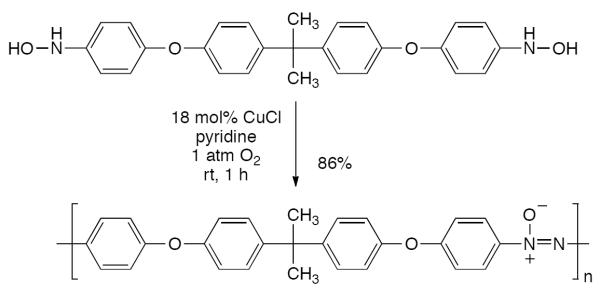
Oxidative polymerization to form a poly(azoxyarelene).
VIII.D. Heterocycle Formation from Anilines
Certain aniline-containing substrates are capable of undergoing either intramolecular or intermolecular oxidative C–N or N–N bond formation to provide a range of heterocycles. For example, the synthesis of benzimidazoles via copper-mediated oxidative cyclization of in situ formed N-benzylidene-ortho-phenylenediamines was reported as early as 1936 (Scheme 522).1080 Stoichiometric amounts of copper were necessary due to product inhibition. Despite this limitation, a large variety of 2-substituted benzimidazoles could be formed in good to excellent yield.
Scheme 522.

Copper-mediated oxidative cyclization to afford benzimidazoles.
In a more recent report, Speier and Parkanyi disclosed the formation of 1,1'-bibenzimidazole through copper-mediated oxidation of the starting o-benzilidine anilines (Scheme 523).1081 Notably, this process effects both oxidative cyclization via C–N bond formation as well as oxidative dimerization via N–N bond formation. The exact reason for the disparity in products in comparison to the previous process is unclear, although differences in concentration as well as the use of preformed imine substrate should be noted. In the present method, dimerization did not occur with substrates containing ortho-substitution, likely due to sterics. Surprisingly, the para-methoxy-containing substrate did not undergo cyclization, but rather afforded the azo compound (see Section VIII.B) in minor amounts.
Scheme 523.
Copper-mediated oxidative dimerization to afford 1,1'-bibenzimidazoles.
Notably, 2-phenylbenzimidazole, a potential reaction intermediate, was inert under the reaction conditions (Scheme 524). This behavior excludes a mechanism invoking a final oxidative N–N biaryl coupling. Additionally, a bis(o-benzilidine) azo compound did not undergo cyclization to the bisbenzimidazole product (Scheme 525). A plausible reaction scheme explaining the observed products and reactivity is shown below (Scheme 526). Initial oxidation of the aniline nitrogen affords a reduced copper species and the aniline radical species II. Subsequent N–N bond dimerization (path a) may occur directly to afford III, which can undergo further oxidation to form azo byproduct IV via path c, or undergo cyclization to afford VI. Alternatively, the initial radical II can undergo intramolecular cyclization (path b) to form radical V and subsequent N–N bond formation, yielding dimer VI. This common intermediate can then undergo facile oxidative aromatization to afford product VII.
Scheme 524.
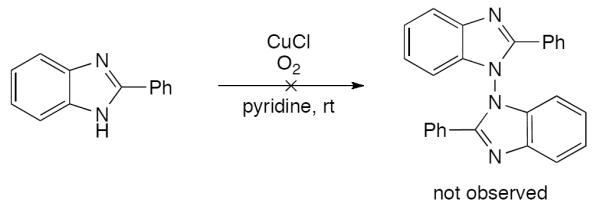
Benzimidazoles not productive intermediates under the copper oxidation conditions.
Scheme 525.
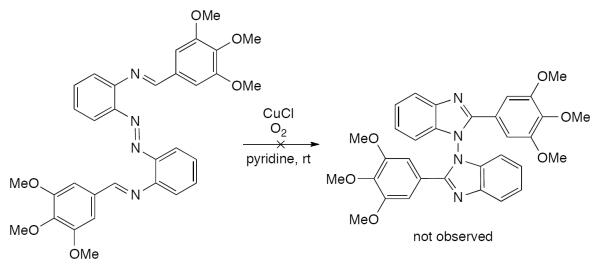
Azo not a productive intermediate under the copper oxidation conditions.
Scheme 526.
Possible mechanism for copper-mediated bisbenzimidazole formation.
Anilines with ortho-azo substitution can undergo intramolecular oxidative N–N bond formation to produce triazoles. Examples using stoichiometric amounts of CuSO4 appeared as early as the 1920s, reporting the synthesis of a limited number of products but in excellent yields (Scheme 527).1082
Scheme 527.
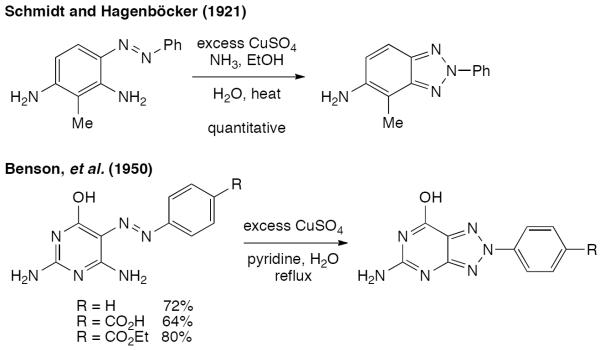
Early examples of copper-mediated cyclization to afford triazoles.
A catalytic variant for the synthesis of benzotriazoles from 2-aminoazobenzenes utilizing CuCl and pyridine under oxygen was later disclosed (Scheme 528).1083 The method requires only mild conditions, and the products are formed in excellent yields. Other copper salts, such as CuCl2, Cu(NO3)2, and, surprisingly, CuSO4 were ineffective catalysts for the reaction. Pyridine was also necessary for conversion, although other ligands were not tested.
Scheme 528.
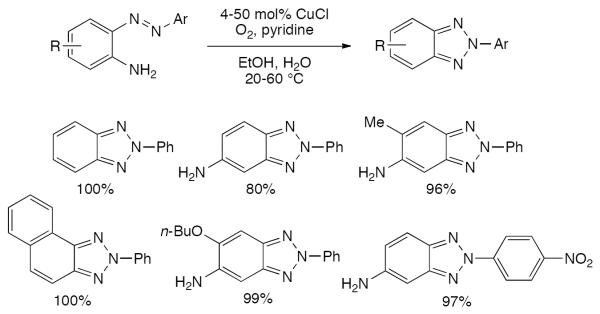
Copper-catalyzed oxidative cyclization to afford triazoles.
A mechanism for triazole formation may proceed via initial coordination of the substrate with the copper catalyst (Scheme 529). Single electron oxidation affords a reduced copper species and an aniline radical. After intramolecular cyclization, another single electron oxidation affords the triazole product. Oxidation by molecular oxygen regenerates the active copper species and closes the catalytic cycle.
Scheme 529.
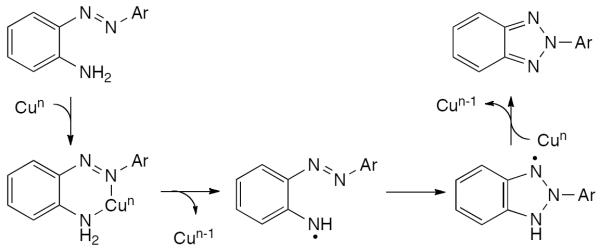
Potential mechanism for the oxidative cyclization to afford triazoles.
VIII.E. Iminoquinone Formation from Anilines
Under certain conditions, anilines can undergo self-condensation reactions to give rise to iminoquinones accompanied by dearomatization of the initial substrate. Oxygenation of the substrate may also occur, leading to additional condensation pathways. Although this type of reactivity can quickly build complex structures, control of selectivity is challenging, and the substrate scope is highly restricted.
An early example of this reactivity was discovered upon treatment of aniline with Cu(OAc)2 and oxygen in alcoholic solvents (Scheme 530).1084 The major product of the resulting reaction was determined to be 2-amino-5-anilinoparaquinone monoanil. This product is believed to form via initial ortho-oxygenation and subsequent oxidation/condensation events (see below), although the exact mechanism is unknown. Smaller amounts of azo and phenoxazine dimers were also isolated. Reaction in other solvents, such as benzene, dioxane, and ethyl acetate, did not yield oxidized products.
Scheme 530.
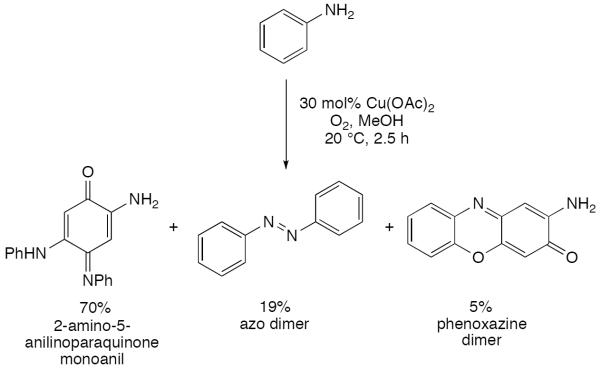
Copper-catalyzed oxygenative dimerization of aniline.
A less complex dearomatization process was described in the oxidation of 2,6-dialkyl substituted anilines with CuCl and air (Scheme 531).1067 This substitution pattern was demonstrated to promote head-to-tail dimerization, as opposed to the N–N coupling to form azo dimers under identical conditions with most anilines (see Section VIII.B). Selective isolation of the anil or quinone anil was achieved through basic or acidic workup, respectively.
Scheme 531.
Iminoquinone formation from 2,6-dialkylanilines.
Aminophenols are susceptible to oxidation to afford intermediate iminoquinone species. In a key study of this reactivity, Rossi and coworkers subjected the three isomers of aminophenol to various copper catalysts under oxygen (Scheme 532).1037 With catalytic CuCl, ortho-aminophenol was cleanly transformed into 2-aminophenoxazin-3-one in excellent yield. While less active than the other isomers, meta-aminophenol also provided a quinone dimer in high yield. Oxidation of the para-isomer afforded a mixture of products, including a tetrameric iminoquinone in small amounts.
Scheme 532.
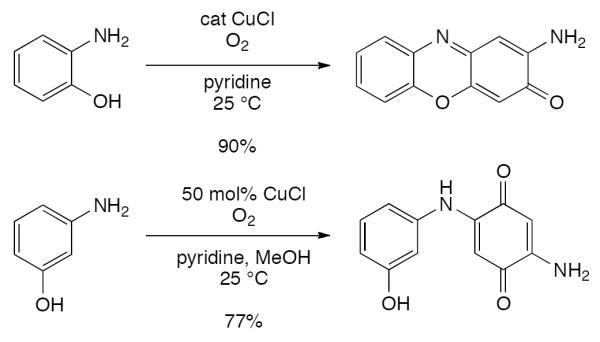
Copper-catalyzed oxidation of aminophenol isomers.
A thorough investigation of copper source and ligand effects on phenoxazine formation from ortho-aminophenol was later reported by Speier and coworkers, revealing Cu(NO3)2 or CuCl with 1,10-phenanthroline as optimal conditions.1085 Kinetic studies with the copper-phenanthroline system established the reaction to be first order in copper, oxygen, and aminophenol. A mechanism for the reaction was proposed to occur through formation of oxidized o-iminoquinone and addition of a molecule of aniline (Scheme 533). Further oxidation and conjugate addition of the phenol can afford the tricyclic system. In contrast, meta-aminophenol is postulated to undergo ortho-oxygenation and oxidation to form 2-aminobenzoquinone (Scheme 534). Conjugate addition of the aniline starting material can afford the dimerized product.
Scheme 533.
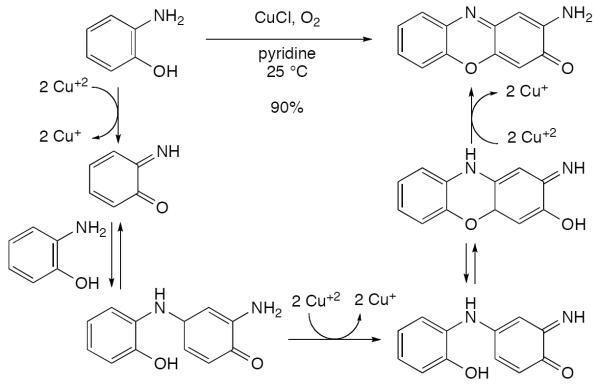
Possible mechanism for phenoxazine formation from o-aminophenol.
Scheme 534.

Possible mechanism for quinone formation from meta-aminophenol.
A heterogeneous catalyst, bis(2-[α-hydroxyethyl]benzyimidazolato)copper(II) anchored onto chloromethylated polystyrene, has also been utilized for the transformation of ortho-aminophenol into 2-aminophenoxazin-3-one.1086 However, increased temperatures were required, and yields were moderate (48%).
While attempting to couple 3-aminocarbazole with a 3-iodoindole via Ullman-Goldberg condensation, the desired quinoline product was not observed.1087 Rather, the aminocarbazole had undergone an oxidative cyclodimerization event to afford a bisindolophenazine product. The process was found to be applicable to a variety of 3-aminocarbazole and 5-aminoindole substrates through treatment with catalytic CuBr in DMSO under air (Scheme 535).
Scheme 535.
Copper-catalyzed oxidative dimerization to construct phenazine-containing heterocycles.
Simple anilines were noted to form azo compounds under these conditions (see Section VIII.B, Scheme 504). However, the absence of azo byproducts here makes a mechanism proceeding through initial N–N coupling and subsequent [3,3]-sigmatropic rearrangement unlikely. The reaction is proposed to occur through initial oxidation of the aniline to the radical and dimerization to form the ortho C–N bond. A series of subsequent oxidations via copper can occur with concomitant cyclization to afford the phenazine-containing product. Alternately, the compound may dimerize via an iminoquinone (see Scheme 533). Mechanistic studies are needed to clarify the reaction pathways here.
An elegant method incorporating intramolecular cyclization with concomitant dearomatization to generate complex ring systems has been discovered by Chiba and coworkers.1088 In this reaction, α-azido-N-arylamides react with catalytic Cu(OAc)2, K3PO4, and molecular oxygen to afford azaspirocyclohexadienones in good to excellent yield (Scheme 536). Key to this reactivity is the ability of the substrate to undergo intramolecular cyclization with the proximal aryl ring and induce oxygenation. Here, the azide functionality undergoes initial copper-catalyzed denitrogenation to form an iminyl copper species (for oxidation of azides see Section X). Subsequent oxidative aminocyclization onto the aromatic aniline nucleus generates a para-quinone aminal containing a newly constructed quaternary center. Treatment of the para-substituted tolylamide substrate (bottom right of Scheme 536) to the reaction conditions did not form the ortho-quinone aminal, but rather to an azaspirocyclohexadienol, since the tertiary alcohol cannot oxidize to the quinone.
Scheme 536.
Copper catalyzed synthesis of azaspirocyclohexadienones.
Mechanistic investigations revealed the necessity of molecular oxygen for reactivity, and one oxygen atom of 18O2 is incorporated in the cyclohexadienone product via a labeling study (Scheme 537). The proposed mechanism proceeds via initial denitrogenative formation of an iminyl copper species and subsequent reaction with molecular oxygen to form a peroxycopper intermediate. The reaction of the para-tolylamide substrate (bottom right of Scheme 536) suggests the possibility of an intramolecular imino-cupration of the aniline ring, with concomitant C-N and C-Cu bond formation at the ipso and para positions. Finally, isomerization to a peroxydiene may occur, followed by elimination to reform the active copper species in addition to the azospirodienone product.
Scheme 537.
Proposed mechanism of copper catalyzed azaspirocyclohexadienone formation.
Dearomatization is a powerful synthetic strategy that allows for rapid construction of complex systems containing quaternary stereocenters from relatively simple aromatic materials. As nature is known to exploit similar reactivities, development of these reactions provides opportunities for biomimetic routes towards natural products and their analogs.
VIII.F. Halogenation of Anilines
Analogous to the halogenation of phenols (see Section VII.I.1), copper-catalyzed oxidative chlorination and bromination of anilines has been reported.1089 In this method, Cu(OAc)2 is used as catalyst under oxygen, and LiBr serves as the source of bromide ions. Good selectivity for monobromination can be achieved, particularly with deactivated anilines, as their initial products are less prone to undergo further halogenation (Scheme 538). Surprisingly, N-methylaniline provided only minimal conversion under the reaction conditions, indicating that the method is restricted to primary anilines. Oxychlorination under analogous conditions with LiCl proceeded much slower and in low selectivity (Scheme 539). Interestingly, N-acetylated products, which could also undergo chlorination, were the major products of these reactions. For example, 4-n-butylaniline afforded the corresponding acetamide in 80% selectivity as determined by gas chromatographic analysis.
Scheme 538.
Oxybromination of primary anilines.
Scheme 539.
Oxychlorination of primary anilines.
In contrast to oxidation to form the dihalogen as postulated for arene oxyhalogenation (see Section II.E.2), the reaction is proposed to proceed through an aniline radical (Scheme 540), similar to that of phenol radical halogenation (see Section VII.I.1). Following initial coordination of the substrate to copper, single electron oxidation and loss of proton can afford the key aniline radical. Reaction with copper(II)bromide then affords the halogenated product and a reduced copper species. Oxidation with molecular oxygen regenerates the copper(II) species.
Scheme 540.
Postulated mechanism of the oxybromination of primary anilines.
VIII.G. Oxidative Cleavage of Anilines
A different mode of aniline reactivity can be exploited using controlled concentration of substrate and copper. Namely, oxidation of ortho-phenylenediamines at high dilutions can avoid dimerization processes and instead yield the corresponding bis-nitriles through an oxidative cleavage mechanism. A series of reports by Tsuji and coworkers in the 1970's investigated this unique process.617,1090 Treatment of o-phenylenediamine with stiochiometric amounts of nickel peroxide or lead tetraacetate was known to afford the bis-nitrile product, albeit in low yields. Similar reactivity was observed using CuCl with pyridine and oxygen under very mild conditions (Scheme 541). The reaction is conducted by slow addition of the substrate to the reaction mixture to achieve a low diamine:copper ratio and inhibit polymerization pathways otherwise seen. While ortho-phenylenediamines with various donating groups were transformed into the corresponding cis,cis-mucononitriles in high yields, electron-withdrawing substitution such as acyl or nitro groups instead produced polymeric materials. Smooth cleavage of 1,2-naphthalenediamine also afforded the corresponding bis-nitrile product in good yield.
Scheme 541.
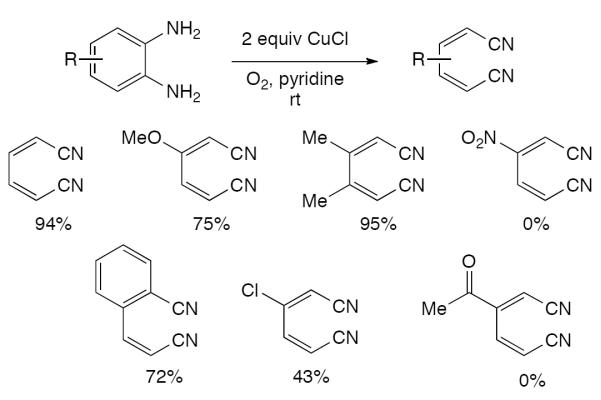
Oxidative cleavage of ortho-phenylenediamines.
Although a high copper to substrate ratio was critical for avoiding polymerization, treatment of ortho-phenylenediamine with just 12 mol% CuCl afforded the product in 90% yield, albeit with increased reaction time. A large-scale procedure for this substrate was later described in an Organic Syntheses report.1091 Although a definitive mechanism for the reaction is unknown, the process is believed to operate via coordination of the substrate to an initially formed pyr-CuCl-O2 complex. Through a series of electron transfers, a bis-iminyl radical species can be formed, which then undergoes ring cleavage to stereoselectively afford the cis,cis-bis-nitrile (Scheme 542). Molecular oxygen may assist or activate copper for electron transfer in addition to oxidizing copper(II) to copper(I).
Scheme 542.

Possible mechanism of the oxidative cleavage of ortho-phenylenediamines.
IX. Reactions of Amines
This section covers the oxidative reaction of amines with copper. Those reactions involving the coupling of boronic acids with amines species have been discussed above since they formally involve oxidation of boronic acid nucleophilic component (Section III.C.1). As electron rich species, amines are very susceptible to oxidation and the combination of copper with oxygen has proved potent for this class of compounds. Typically, amines oxidize to form a radical cation, which is often transformed into an iminium ion. The iminium ions subsequently undergo reaction with many weak nucleophiles (alkynes, nitroalkanes, malonates, methyl ketones, silyl ketene acetals, silyl enol ethers, enamines, aryl boronic acids, and phosphines), even under oxidizing conditions. Use of internal nucleophiles give rise to several interesting intramolecular cyclization processes. Deprotonation of the iminium intermediate leads to symmetrical and unsymmetrical imines, themselves useful precursor for further reactions such as formation of nitriles or precursors for one-pot cascade processes. Cleavage of iminiums with the copper catalyst can also provide copper amides, which can be used in further cross-coupling reactions. For the iminium processes, key mechanistic studies have clarified the nature of many of the intermediates. Hydrazines, with two nucleophilic nitrogens, undergo mechanistically related transformations giving rise to neutral diazo compounds. Hydrazides can react similarly, but give rise to acylated diazo species, which undergo displacement reactions to provide amides and carboxylic acids.
IX. A. via Iminiums
IX.A.1. Nucleophilic Addition to Iminiums from Tertiary Amines
The oxidative coupling of amines by formation of a bond with one of the carbons residing on the nitrogen has received much attention recently.1092 In these reactions, amines are generally believed to be oxidized to iminium ions (Scheme 543), similar to the action of amine oxidases (see Section IX.A.3). Subsequent reaction with nucleophiles can occur via a Mannich-like process. While many metals have been employed in conjunction with a variety of oxidants, only the copper-catalyzed processes using molecular oxygen as an oxidant are summarized here.
Scheme 543.

Oxidative coupling of amines with nucleophiles.
Seminal work on this type of reaction was described by Miura and coworkers who showed that N,N-dimethylanilines would couple with alkynes in the presence of oxygen and a copper(I) chloride catalyst.1093,1094 While formation of other byproducts was problematic (Scheme 544), this work firmly established that copper and oxygen are a functional pair for this type of transformation.
Scheme 544.
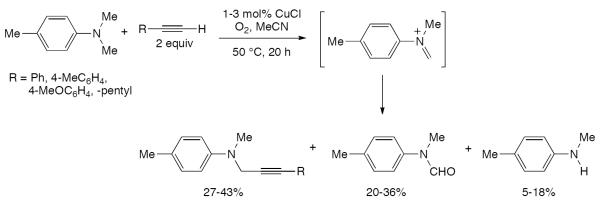
Oxidative coupling of amines with alkynes.
Later work on copper-catalyzed amine to iminium oxidation predominantly focused on tert-butyl hydroperoxide (TBHP) as the oxidant with a variety of nucleophiles, but has also recently shown high selectivities with oxygen.625a The oxidation of trimethylamine to the imminium ion induced by copper or amine N-oxide conversion to amines was also examined briefly.1095
The reaction of tetrahydroisoquinolines and anilines with nitroalkanes is illustrative (Scheme 545).1096 This transformation can also take place in ionic liquids with the benefit that the ionic liquid and copper catalyst could be recycled nine times before loss in activity was observed.1097 Experiments were conducted to verify that the oxidative coupling could be done electrochemically.
Scheme 545.
Oxidative coupling of amines and nitroalkanes.
Other nucleophiles proved effective in trapping the iminium generated by the copper catalyst and oxygen from tetrahydroisoquinoline. In particular, nucleophiles derived from very acidic compounds such as malonates worked well (Scheme 546).1096
Scheme 546.

Oxidative coupling of amines and malonates.
The use of less acidic nucleophiles such as ketones has also been documented (Scheme 547).1098 Slightly higher yields were obtained using O2 vs TBHP with acetone, but only O2 was effective with butanone. The addition of 3 equiv of acetic acid and molecular sieves increased yields even further. to 72%. Interestingly, CoCl2 and RuCl3 could also be used as catalysts, but the reactions were less efficient. For the methyl alkyl ketones, there was a general downward trend in the product yield as the alkyl chain became longer. Even with oxygen, diethyl ketone gave poor yield (24%) and poor diastereoselection (1.1:1).
Scheme 547.
Oxidative coupling of amines and ketones.
Highly nucleophilic silyl ketene acetals, for which in situ deprotonation was not required, were also highly effective nucleophiles in this type of transformation (Scheme 548).1099 In contrast to the direct coupling of the ketones outlined above (Scheme 547), no acid was needed for the transformation. In this case, the reduction product from O2 must be a silanol instead of water.
Scheme 548.
Oxidative coupling of amines and silyl ketene acetals.
Further work with the silyl ketene acetals along with the less nucleophilic silyl enol ethers is outlined in Scheme 549.625b Even dienol ethers could be employed to good effect. In this case, CuCl2, was found to be the catalyst of choice providing good yields of the coupled products at a 10 mol% loading. In the cases where two stereocenters are formed, low diastereoselection is observed. Interestingly, the reaction was viable with an N-substituted pyrrolidine whereas none of the product was observed with the corresponding piperidines.
Scheme 549.
Oxidative coupling of amines with silyl enol ethers and silyl ketene acetals.
Similarly, enamine nucelophiles have also been oxidatively coupled with tetrahydroisoquinolines using catalytic amount of copper and tert-butyl hydroperoxide under an ambient atmosphere (Scheme 550).1100 This coupling occurs selective at the 3-position of the indole when the C-2 and C-3 position are unsubstituted and selectively couples at the 2-position when C-3 is substituted. The indole nitrogen does not need to be protected and a diverse array of functional groups are tolerated.
Scheme 550.
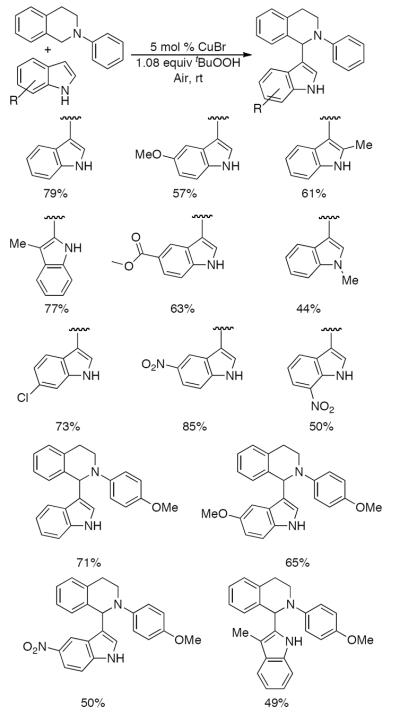
Cross-dehydrogenative coupling reaction of indoles with tetrahydroisoquinolines.
Aryl boronic acids have also been successfully employed as nucleophiles in the reaction of copper-generated iminiums (Scheme 551).1101 The higher reactivity under O2 in the presence of water is consistent with activation of the boronic acid. It is likely that copper is playing more than one role in this transformation including oxidizing the aniline to an iminium and transmetalating the aryl boronic acid in manner similar to that described in Section II.C on boronic acid couplings.
Scheme 551.
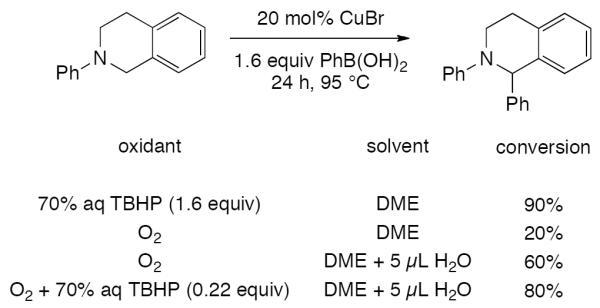
Copper catalyzed oxidative coupling of an amine with an aryl boronic acid.
Copper-generated imminiums have also been successfully coupled with phosphine nucleophiles. Basle and co-workers reported the first example of oxidative C–P bond formation using a copper catalyst and molecular oxygen for the synthesis of α-aminophosphonates.1102 Diethyl- dimethyl, diisopropyl, and dibenzyl-phosphites were all employed with high efficiency. The reaction failed when changing dialkyl phosphite to trialkyl phosphite. Notably, p-methoxyphenyltetrahydroisoquinoline provided good yield offering a nice alternative to N-phenyltetrahydroisoquinoline since the protecting group can be removed more easily to afford the secondary amine. This transformation is regioselective for the benzylic position, and requires the presence of oxygen. Molecular uptakes experiments revealed oxygen is involved in both the oxidation of diethyl phosphite and of the amine; one equivalent of oxygen is required to form one full equivalent of product. Half an equivalent of oxygen consumed in the presence of one equivalent of substrate and one equivalent of phosphite affords 70% product and 30% trialkyl phosphate. A mechanism was proposed based on these findings and is outlined in (Scheme 553).
Scheme 553.
Proposed mechanism for the copper catalyzed aerobic phosphonation.
To explore the reaction mechanism of the oxidative transformations of amines with copper and oxygen, measurement of the molecular oxygen uptake was undertaken in the coupling with nitroalkanes1096 (see Scheme 545) and ketones1098 (see Scheme 547). Studies showed that half an equivalent of oxygen was consumed during the oxidation of the aniline under standard conditions. The reactions also proceed in the presence of two equivalents of BHT, a free radical inhibitor, strongly suggesting that the reaction does not involve a radical process.625b,1099,1101,1103 This assertion is further supported by a lack of reactivity when the single electron oxidant TEMPO is employed.625b These result suggests a two electron oxidation of the amine by the copper to produce an iminium intermediate that may still interact with the copper center (Scheme 554). The iminium can reversibly react with water produced during the reduction of O2 to generate the hemiaminal, which is supported by the formation of byproducts or alternate products under different conditions (Scheme 555).1098,1103 At this time, the oxidation state couple for the copper has not been reported. However, under these conditions, it is highly probable that much of the copper is in the copper(II) oxidation state. Such a copper(II) species would also be able to act as a Lewis acid to facilitate deprotonation with the nitroalkane, ketone, and malonate substrates (Scheme 554).
Scheme 554.
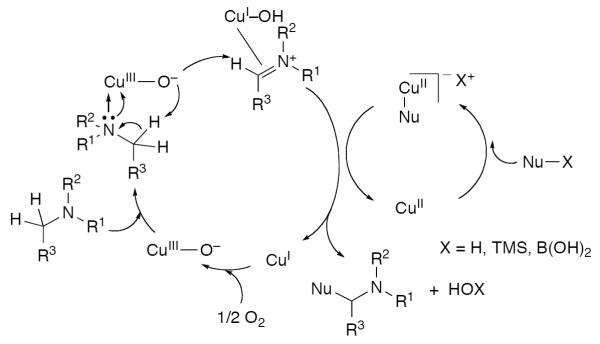
Copper catalyzed oxidation of an amine to an iminium using oxygen followed by nucleophilic trapping.
Scheme 555.
Experiments supporting formation of an iminium in the copper-catalyzed amine oxidative couplings.
Further studies by Klussman and co-workers on reaction of N-phenyl-tetrahydroisoquinoline with a trimethyl silyl enol ether (Scheme 556a) provided support for key intermediates in the proposed mechanism.1104 Subjecting N-phenyl-tetrahydroisoquinoline to the optimized reaction conditions in the absence of a nucleophile (Scheme 556b) generated a white precipitate, later identified to be Cu(II)ClOH, an iminium ion 4, and an acetal 5 were isolated in a 40:60 ratio (Scheme 556b). Crystallography revealed that the counterion to imminium ion 4 was a dihalocuprate ion as shown in 4a. Thus, the copper species is bound ionically, not covalently. NMR studies also revealed intermediates 4 and 6 could exchange with the imminium salt 4a and not with the isoquinolinium salt 7. Reaction of the silyl enol ether with just 4a provided product 3 in 85% isolated yield after 3 h (Scheme 556c). The methanol adduct 5 was synthesized from 1 in the presence of copper catalyst in methanol and subsequent addition of 2 provided 3 in 68% yield after 18 h instead of 1 h. A similar slower reaction profile was observed for 6 (Scheme 556d) indicating that the enol ether does not add directly to either 5 or 6. Compound 4a is proposed as the reactive electrophile since the rate observed with it was comparable to the rates of the oxidative coupling reaction (Scheme 556a). A tentative mechanism has been proposed based on these mechanistic findings (Scheme 557). The authors propose that MeOH is favored as a solvent due to stabilization of the ion pair.
Scheme 556.
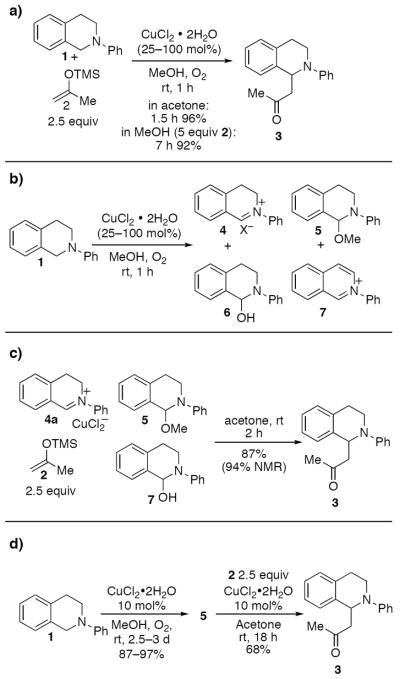
Mechanism experiments of the amine oxidations.
Scheme 557.
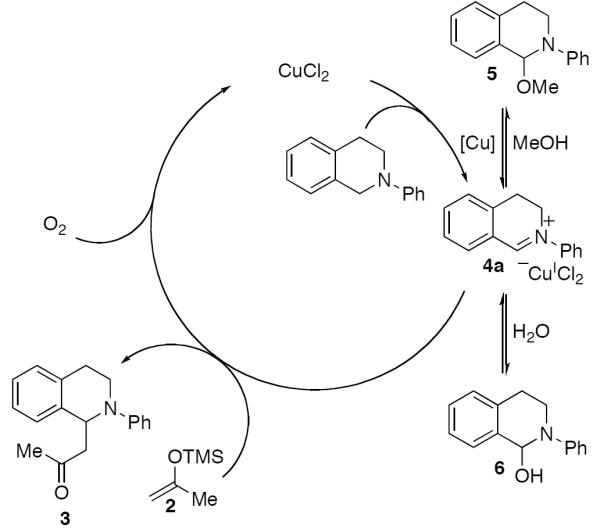
Proposed mechanism of the copper-catalyzed amine to iminium oxidation.
IX.A.2. Imines from Secondary Amines
All of the examples in the prior section are for tertiary amines, which form iminiums that then react further with nucleophiles. The above mechanism (Scheme 557) implies that it should be possible to oxidize primary or secondary amines to the corresponding neutral imines. An example, illustrating deprotonation of the iminium intermediate that is formed during the oxidation reaction is outlined in (Scheme 558).1105
Scheme 558.
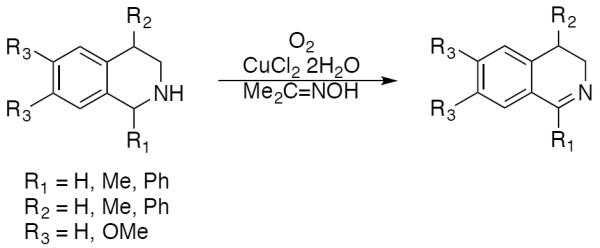
Oxidation of tetrahydroisoquinolines to dihydroisoquinolines.
Acyclic secondary amines can also undergo this type of transformation, although avoiding hydrolysis is more problematic (Scheme 559).1106 Copper(I) and copper(II) salts were effective for oxidizing a range of acyclic and cyclic amines to the imines in good yields. In this case, the presence of oxygen and 3 Å molecular sieves were required for the oxidation to occur. Uptake experiments found that an equivalent amount of dioxygen is consumed to the product, which would correspond to conversion to hydrogen peroxide in the two-electron oxidation of the substrate. Under these conditions primary amines are converted into the nitriles (see Section IX.A.4 below).
Scheme 559.
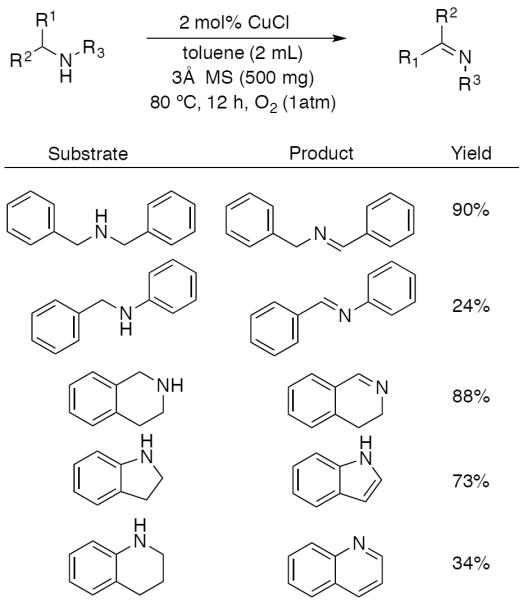
Oxidation of acyclic and cyclic amines to imines.
IX.A.3. Imines or Aldehydes from Primary Amines
Primary amines can also be been aerobically oxidized to the imines. In fact, the oxidative deamination of amines to form aldehydes is a classic example of a reaction catalyzed by copper containing enzymes, the amine oxidases. The preceding sections showed numerous examples of the oxidation of tertiary and secondary amines. This section gives an overview the copper catalyzed conversion of amines to carbonyls or their equivalents.
Several early studies established that copper and oxygen were a potent combination for the oxidative deamination of amines.1107 Kinetic studies for the oxidation of primary aliphatic amines to aldehydes by Cu(0)/acetic acid/oxygen system in acetonitrile (Scheme 560) were examined to probe the mechanism.1108
Scheme 560.
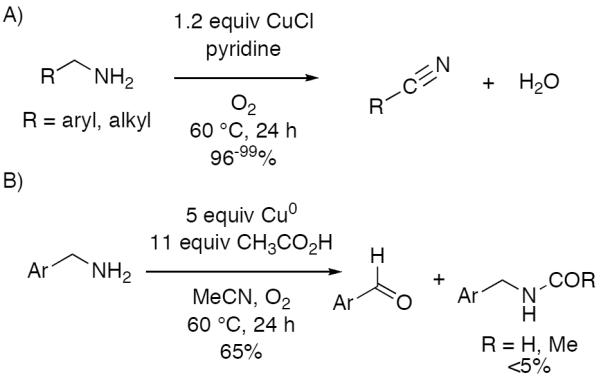
Oxidation of primary aliphatic amines by copper in acidic medium.
Two mechanisms have been proposed for this transformation in basic Scheme 561 and acidic medium Scheme 562. For the mechanism outlined in Scheme 561 the formation of H· was ruled out since a primary isotope effect greater than one and a rate acceleration on moving from R = alkyl to R = alkyl aryl were not observed. For the mechanism with an acidic medium (Scheme 562), the use of copper turnings was necessary for slow release of Cu(I) via corrosion. A primary deuterium isotope effect of kH/kD = 3.6 was observed consistent with α C–H (C–D) cleavage as the rate-determining step accompanied by two electron oxidation of the amine to imine.
Scheme 561.
Proposed mechanism for primary aliphatic amines by copper(II) species (basic conditions).
Scheme 562.
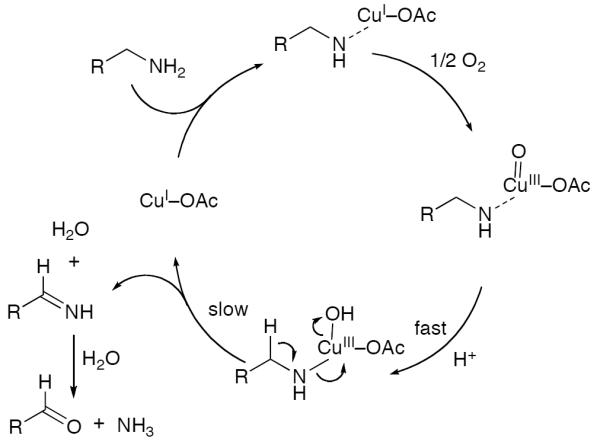
Proposed mechanism for primary aliphatic amines by copper(I) species (acidic conditions).
Considerable effort has been devoted to developing more efficient catalysts for these transformations by synthesis of small molecular copper complexes as mimics of the highly efficient enzyme amine oxidase.678 A survey of the literature reveals the substrate scope of small molecule copper catalysts mimicking the reactivity of copper-containing amine oxidase (CuAO) enzymes is limited in substrate scope. Only select cases describing the use of small molecule copper catalysts for oxidative deamination of amines have been described below.1109,1110,1111
An example providing mechanistic insight for the oxidative deamination of (p-sulfonphenyl)glycine utilizing molecular oxygen, Cu(II) metal ion catalyst, vitamin B6 coenzyme pyridoxal 5`-phosphate, and the synthetic analogue 5`-deoxypyridoxal was reported in 1991 by Martell and Shanbhag.1109 Two reasonable mechanisms (Scheme 563 and Scheme 564) were in line with the experimental data obtained from 18O2 labeling, kinetic, and spectroscopic studies from the four previously proposed mechanisms described. Additionally, the authors were able to demonstrate the facile conversion of Cu(II) complex of the Schiff base to the oxime of the coenzyme.
Scheme 563.
Proposed mechanism I Vitamin B6 catalyzed oxidative deamination.
Scheme 564.
Proposed mechanism II Vitamin B6 catalyzed oxidative deamination.
An example of a small molecule amine oxidase mimic is outlined in Scheme 565. Here, a bridging biscopper(II) complex converts primary amines with at least one α-hydrogen atom into the aldehyde which subsequently condenses with additional substrate to provide the illustrated imine.510 Notably, the reaction conditions are very mild (ambient temperature, under air). The development of a simple inexpensive copper catalyst with the same reactivity would have broad utility in organic synthesis.
Scheme 565.
Oxidative deamination of amines.
By using benzylamine selectively deuterated at the α-carbon as substrate (C6H5CD2NH2), a kinetic isotope effect (KIE) under turnover conditions of 4 was observed. This result implies that an oxygen radical abstracts the hydrogen atom abstraction from the α-carbon atom of the coordinated benzylamine is the rate- determining step. Together with other evidence, this data supports the mechanistic proposal in Scheme 566. The imine-copper intermediate is similar to the reactive species proposed in the amine α-functionalizations described in Section IX.A (see Scheme 554).
Scheme 566.
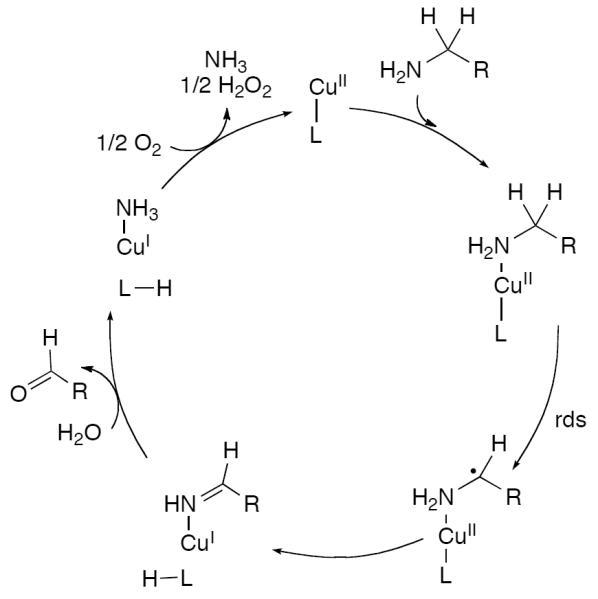
Mechanism of an amine oxidase mimic.
The catalytic properties of a copper-polymer system were investigated for the oxidation of primary and secondary amines to aldehydes in high preparative yield.1112 The oxidase reactivity for a series of Cu(I) complexes containing 2,2-biquinolyl or 2,2`quinolyl pyridine ligand fragments in the polymer backbone were examined for the oxidation of primary and secondary amines. A mechanism similar to that of amine oxidase is proposed for this transformation (Scheme 568).
Scheme 568.
Proposed mechanism for the polymer bound copper catalyst.
Conditions have been identified wherein the products from the oxidation of amines undergo condensation with a second equivalent of the primary amine precursor to generate symmetric imines.1113 The benzylic, aliphatic, cyclic, heteroaromatic amines proceed well with catalytic and stoichiometric amounts of copper (Scheme 569).
Scheme 569.
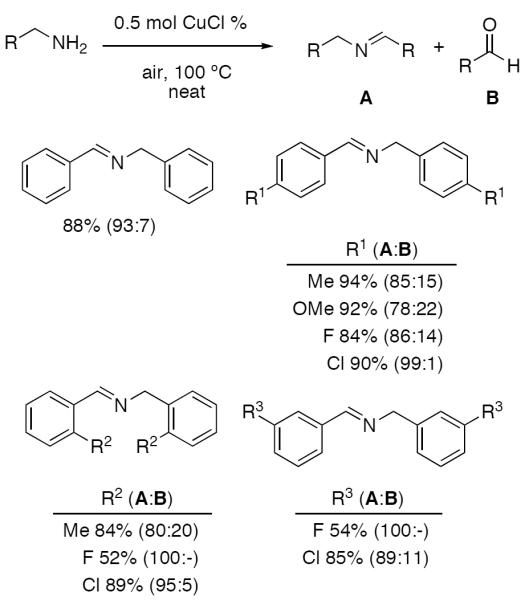
Oxidation of primary amines in the synthesis of symmetrical imines.
The synthesis of unsymmetrical imines by condensation of the initially formed imine with a different amine nucleophile was more challenging affording the products in good to excellent yields and moderate selectivity (Scheme 570).1113 As would be expected, poorly nucleophilic amines, such as the heteroaromatic amines and benzylamines with strong electron-withdrawing groups, did not compete favorably with the starting primary amine in adding to the imine intermediate. The authors proposed that the imine forms by β-hydride elimination of a copper-amine adduct accompanied by two-electron oxygen mediated reoxidation of the copper.1113
Scheme 570.
Oxidation of primary amines in the synthesis of unsymmetrical imines.
An alternate mechanism in agreement with the mechanistic data described earlier in this section (see Scheme 554–Scheme 557) is outlined in Scheme 571. The catalytic cycle is initiate by a one-electron oxidation of Cu(I)Cl to Cu(II)XCl. The amine then undergoes a one-electron oxidation with Cu(II)XCl to afford a radical cation ion intermediate III. Deprotonation of III forms intermediate V which undergoes another one-electron oxidation to afford the imminium intermediate VI. This species may directly condense with another primary amine (path 1) or may hydrolyze and then condense with another primary amine (path 2).
Scheme 571.
Proposed mechanism for copper-catalyzed oxidation of primary amines to imines.
Similarly, a copper(II) bromide and TEMPO system under an oxygen atmosphere was reported to efficiently oxidize primary and secondary amines to imines in aqueous acetonitrile.1114 The synthesis of unsymmetrical imines by condensation of the initially formed imine with a different amine nucleophile was also viable under these conditions. Steric and electron factors influenced the efficiency and selectivity of the reaction. Interestingly, aldehyde byproducts were not detected by GC analysis of the reaction mixtures. Electron rich anilines were also shown to undergo dehydrogenative coupling affording azo product (See Section VIIIB).
In contrast to methods described above without TEMPO (Scheme 559, Scheme 570), the selectivity was not affected by the electronic properties of the substituents of the primary and secondary benzyl amines. Notably, the addition of a ligand is not necessary. The authors speculate that water and acetonitrile solubilize the copper species formed throughout the catalytic cycle. A mechanism has been proposed and is outlined in Scheme 572.
Scheme 572.
Proposed mechanism for copper catalyzed oxidation of amine to imines with TEMPO.
A very different approach to oxidative deamination with a copper catalyst utilizes dehydroascorbic acid (dehydroAsc) as the oxidizing agent. This reagent is known to oxidize amines to the corresponding aldehydes easily. In this case, however, the dehydroAsc is generated in situ from a stoichiometric amount of ascorbic acid (Asc) via a copper catalyzed aerobic oxidation. Under these conditions, a variety of amines could be oxidized under very mild conditions (Scheme 573).1115
Scheme 573.
Dehydroascorbic acid mediated, copper catalyzed oxidation of amines.
Omission of either the Asc or the copper catalyst from the reaction mixture abrogated the activity indicating that each plays a critical role as outline in the proposed mechanism (Scheme 574). Although Asc or its derivative could be, in theory, reoxidized a number of times, thus rendering Asc catalytic, two equivalents were needed to obtain the full conversion of amine into the desired carbonyl product. The likely culprit of this stoichiometry requirement is the reaction of the amine-containing byproduct with dehydroAsc.
Scheme 574.
Mechanism of the dehydroascorbic acid mediated oxidation of amines.
In addition to proceeding under mild conditions, the dehydroAsc oxidation exhibits very high chemoselectivity. Since alcohols cannot form the requisite imine required by the mechanism, the selectivity for amines versus alcohols is very high (Scheme 575).
Scheme 575.

Chemoselectivity of the dehydroascorbic acid mediated oxidation.
IX.A.4. Nitriles from Primary Amines
Section IX.A.3 illustrated that imines or aldehydes can be formed from primary amines by copper initiated oxidation to the iminyl radical cation. Further reaction of the imine to the nitrile is also possible, but is complicated by a competing hydrolysis of the imine intermediate to the aldehyde. Kametani and co-workers reported the oxidation of amines to nitriles using copper and oxygen in 1977.1116 Oxidation of amines to nitriles or aldehydes was achieved using copper(I) chloride in pyridine under an oxygen atmosphere. This method suffered from poor yields ranging in 22–35% yields (Scheme 576).
Scheme 576.

Oxidation of various alkyl amines to aryl nitriles.
Efforts for further developing this type of chemistry lapsed for 12 years before a new report appeared. Capdevielle and co-workers reported an improved method based on Kametani's earlier work for oxidation of primary amine to nitriles using copper(I) salt and pyridine under an oxygen atmosphere in 1989.1117 The improved protocol differs from Kametani's work in that the reaction is carried out at higher temperatures and 4 Å molecular sieves were added to minimize hydrolysis of the imine. Catalytic amounts of copper could also be employed; however, stoichiometric amounts of copper were preferred to push the reaction to completion. The method has a broad substrate scope providing a diverse array of nitrile in nearly quantitative yield (Scheme 579). However, the oxidation of 2-phenylethylamine was problematic affording a mixture of products.
Scheme 579.

Catalytic oxidation of primary amines to imines and nitriles.
Later, Capdeveille examined the mechanism of primary aliphatic amine oxidation to nitriles by copper chloride.1118 The oxidation rates of several aliphatic and arylalkyl amines were examined. A secondary isotope effect (KH/KD = 1.25 ± 0.1) suggesting that no C–H (or C–D) bond is broken in the rate-limiting step. Catalytic amounts of copper under an oxygen atmosphere could be utilized for this transformation. The authors speculate that electron-donating groups can stabilize the imminium species thus explaining the rate enhancement observed in the oxidation of dodecylamine vs benzylamine vs veratrylamine. In the case of the veratrylamine oxidation, veratronitrile was isolated in 65% yield with 15% hydrolysis product suggesting that oxidation of ketimine is faster than competitive addition into the imine intermediate. A mechanism consistent with these observations is outlined in Scheme 578.
Scheme 578.
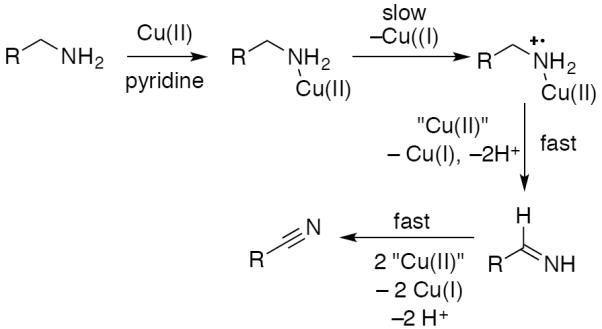
Proposed mechanism of primary aliphatic amine oxidation to nitriles.
Minakata and co-workers reported that catalytic amounts of binuclear copper(II) complexes of 7-azaindole (Scheme 579) could effectively oxidize an amine to an imine in moderate yield (65%) accompanied by nitrile formation (21% yield).1119
In a further advance Uemura and coworkers developed a system similar to that of Kametani (Scheme 577), but lacking the base additive. Under these conditions, a variety of primary amines are converted to the nitriles with just 2 mol% of a copper catalyst (Scheme 580).1106 The method proves useful for electron-poor and electron-rich benzyl amines as well as for alkyl amines. When the radical scavenger, galvinoxyl, was employed with benzylamine or isoamylamine, the nitrile did not form. For the former, 92% of the imine, N-benzylidienebenzylamine was obtained instead. On this basis, the authors propose that an alkylideneaminyl radical is an intermediate en route to the nitriles.
Scheme 577.
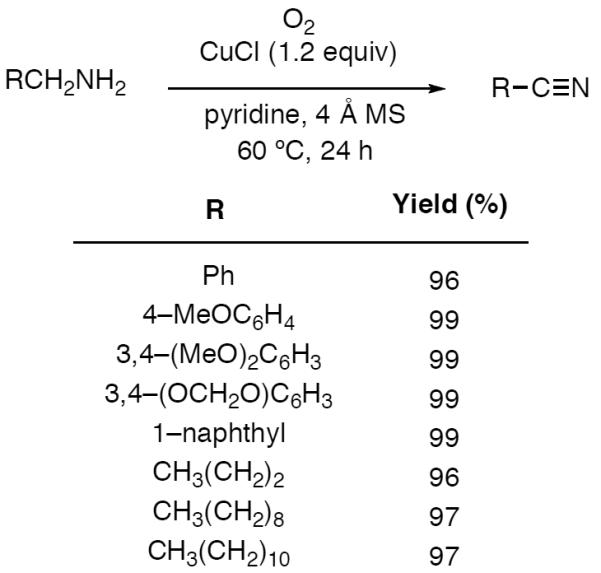
Oxidation of primary amines to nitriles.
Scheme 580.
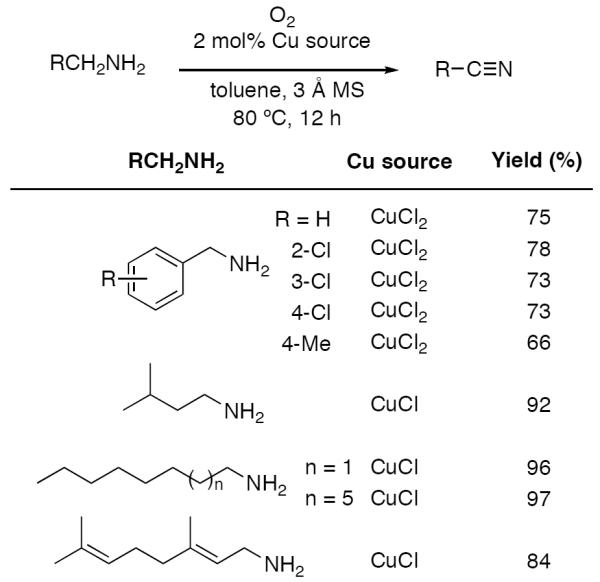
Catalytic oxidation of primary amines to nitriles.
IX.A.5. Enamine Generation and Reactions
In all of the above reactions, amines are converted to iminium (from tertiary amines) or imine intermediates (from primary and secondary amines), which subsequently act as electrophiles for various nucleophilic partners (alkynyl anions, malonate anions, nitroalkane anions, enolates, enol ethers, indoles, aryl boronic acids, phosphites, amines, water, etc.). In this section, work is described, which exploits the oxidation of amines to generate an enamine source after proton transfer of the initially formed iminium. For example, an unexpected by-product was isolated in 8% yield in the reaction of N-(2-alkynylbenzylidene) hydrazide with 4–nitrophenylaldimine during the exploration of new approaches for the synthesis of novel isoquinolines using imines.1120 The formation of H-pyrazolo[5,1-a]isoqunoline did not incorporate the aldimine, but did include two carbons, presumably from N,N-diisopropylethylamine. The reaction required oxygen suggesting that the N,N-diisopropylethylamine underwent oxidation of the aliphatic C–H bond similar to the work described above. Indeed, the addition of 10 mol% CuBr2 improved the yield to 75%. The authors speculated that selective incorporation of the ethyl into the final product may be due to steric effects and kinetic acidity. Various tertiary aliphatic amines with para- and meta- substituted N-(2-alkynylbenzylidene)hydrazides afforded the desired product in good yields (Scheme 581). Poor yields were obtained when electron donating groups were installed on the aryl ring. A mechanism was proposed based on previously reported protocols (Scheme 582).
Scheme 581.
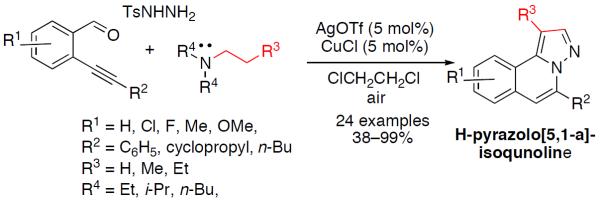
Substrate scope for the three-component reaction.
Scheme 582.
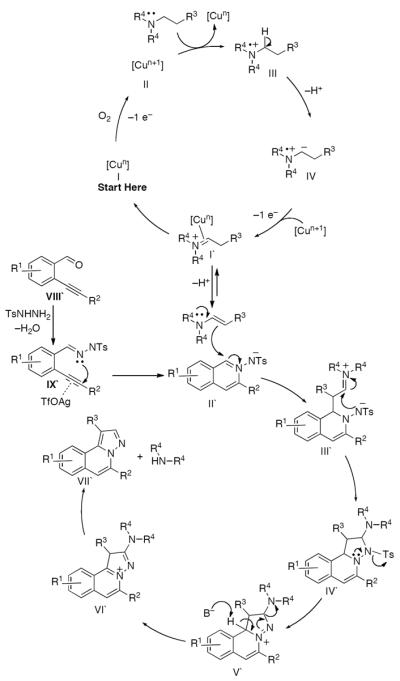
Proposed mechanism for silver(I)-catalyzed intramolecular cyclization and copper(II)-catalyzed oxidation of tertiary amines.
IX.A.6. Amide Anion Generation and Reactions
Aerobic oxidation of amines has also been exploited to generate a source of a copper amide in situ. For example, Guo and co-workers demonstrated that an imminium ion, derived from oxidation of a tertiary amine, can undergo C–N bond cleavage via hydrolysis to afford a copper amide species (LnCu–NR1R2) which can react further with benzoxazole via a copper mediated C–H insertion to afford the desired aminated product.1121 Alkyl tertiary amines bearing α–hydrogens reacted efficiently while amines without an α–H failed to react. An increase in yield was observed when a phenyl substituent was installed at the α–position of the amine. Both of these last two observations are fully consistent with oxidation of the amine to the iminium. The substrate scope is, however, limited to tertiary amines and hindered amines were sluggish. Alkyl amines with two types of α–hydrogens provided a mixture of products in nearly 1:1 ratio. Exclusive exocyclic C–N bond cleavage was observed for morpholine derived tertiary amines. Benzoxazoles with electron donating and electron withdrawing groups were coupled in moderate to good yields with triethylamine (Scheme 583).
Scheme 583.
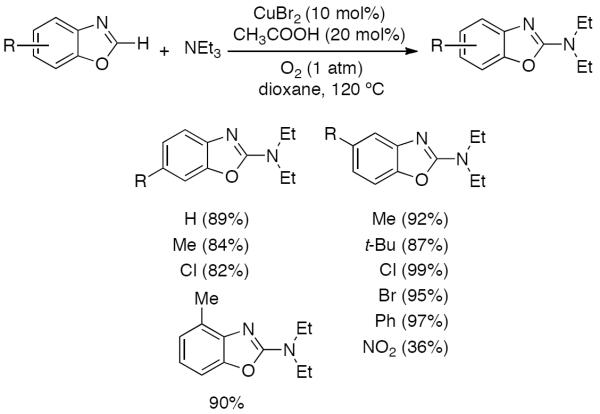
Substrate scope for various substituted azoles with triethylamine.
A gram scale reaction of 4-benzylmorpholine and benzoxazole was explored to gain an understanding of the mechanism. Isolation of benzaldehyde in 87% yield and the aminated product in 75% yield suggest that C–N bond cleavage may occur prior to the C–N bond formation step between the amine and benzoxazole. A free radical pathway was ruled out since the product formed in a 62% and 82% yield in the presence of TEMPO and 1,1-diphenylethylene, respectively. Isotope labeling experiments with 18O2 and H218O revealed that the aldehyde oxygen comes from the water produced during hydrolysis leading to C–N bond cleavage. Cleavage of the C–H bond of the azole was determined to not be involved in the rate limiting step based on the kinetic isotope effect of 1.4 between a competition experiment for 5-methylbenzoxazole and 2-deutero-5-methylbenzoxazole. In the case of 4-benzylmorpholine, a value of 2.7 for the kinetic isotope effect indicates the C–H bond cleavage of the tertiary amine may be rate limiting. A mechanism with modifications for forming the amide-copper intermediate is outlined in Scheme 584. The proposal that the reduced copper species remains bound to the imminium ion via a nitrogen coordination is unlikely based on the X-ray crystal structure obtained by Klussman and co-workers. An alternative pathway for imminium hydrolysis involves nucleophilic attack by water to afford a hemiaminal II`. Coordination of the CuLn to the nitrogen of the hemiaminal facilitates the C–N bond cleavage for elimination of the copper-amide intermediate IV` and the corresponding aldehyde. Deprotonation of the C–H bond of the benzoxazole followed by a copper mediated rearrangement affords intermediate V`, which undergoes a one-electron oxidation to afford a Cu(III) intermediate VIII`. Reductive elimination of VIII` afford the aminated product and a Cu(I)Ln species that can re-enter the catalytic cycle.
Scheme 584.
Proposed mechanism for oxidative C–H amination.
IX.A.7. Aza Allyl Cations from Imines
For imines, oxidation can give rise to aza-allyl cations, which can participate in further processes. A protocol to form complex heterocycles has been reported implementing such an oxidative cyclization strategy.1122 Several new heterocycles were synthesized in poor to moderate yield (Scheme 585). Three coordination sites (pyridyl, imine nitrogen, and a heteroatom incorporated into an arene at R1 or R2) are required for the catalytic reaction while only two are necessary for the stoichiometric reaction. Other oxidants such as Fe3+, Mn4+, and Pb4+ failed to form the product. A mechanism for this reaction consistent with the chemistry described above is outlined in Scheme 586.
Scheme 585.
Substrate scope for synthesis of complex heterocycles from benzylic amines.
Scheme 586.
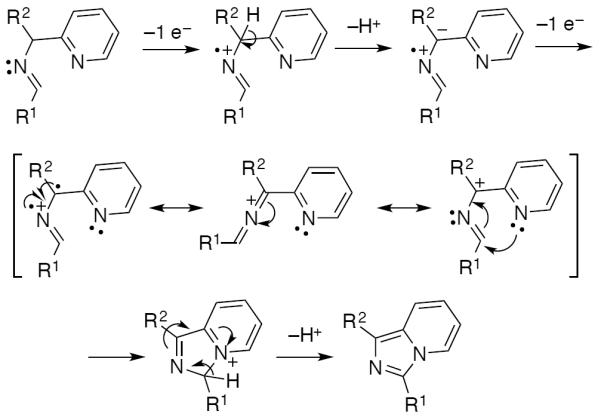
Mechanism of the synthesis of complex heterocycles from benzylic amines.
IX.A.8. Tandem Reactions Involving Iminiums
Tandem reactions combining the basic transformations outlined above are also possible. For example, Loh and co-workers reported an elegant copper-catalyzed rearrangement of tertiary amines via oxidation of aliphatic C–H bonds under air or oxygen atmosphere for the synthesis of α-amino acetals Scheme 587.1123 This more complex reaction is a result of a four electron oxidation, which is proposed to occur via four single electron transfers. Specifically, an amine of an alkyl amine underwent both an oxidation and an oxidative migration from C1 to C2 via an aziridine as outlined in Scheme 588. Support for this mechanism includes validating the involvement of an enamine intermediate, which was accomplished by a trapping and control experiment. A hydrolysis byproduct, Cy2NH2Br, which would arise from this enamine, was also confirmed by crystallography. Deuterium labeling experiments revealed that the α- and the β-carbon of the aliphatic chain are involved and that methanol is not oxidized under the reaction conditions. In this experiment all of the positions underwent proton exchange with methanol as judged by 1H NMR suggesting reversible steps for protonation and deprotonation. Three expected by-products were isolated in low yields when the product was re-subjected to the reaction conditions also indicating many of the steps are reversible.
Scheme 587.
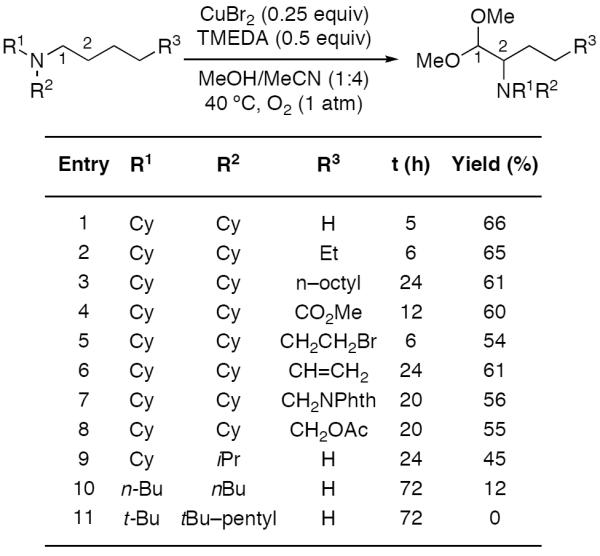
Substrate scope oxidative rearrangement of tertiary amines.
Scheme 588.
Proposed mechanism for oxidative rearrangement of tertiary amines.
A copper-catalyzed domino reaction was employed in the synthesis of substituted pyrroles from α-diazoketones, nitroalkenes, and primary amines (Scheme 589).1124 The amine component must be activated toward oxidation (i.e., benzylic or allylic). The α-diazoketone must be aryl, and electron-poor aryls give improved yields.
Scheme 589.
Aerobic copper-catalyzed domino reaction for the synthesis of substituted pyrroles.
The catalytic copper first acts to catalyze the carbene addition into the amine N–H bond (Scheme 590). The secondary amine thus formed is oxidized to the imine, and the coordinated copper assists in the formation of an enolate. A [3+2] cycloaddition between this zwitterion and the nitroalkene closes the substituted pyrrolidine. Oxidative dehydrogenation and elimination of HNO2 gives the observed substituted pyrrole.
Scheme 590.
Mechanism of the copper-catalyzed domino synthesis of pyrroles.
Grimaud and coworkers reported a tandem cyclization-oxidation of hydrazones to pyrazolidinones.1125 Treatment of hydrazono amides to oxidative conditions resulted in a cycloaddition and subsequent oxidation, giving the pyrazolidinone products in moderate to good yield (Scheme 591). The amide nitrogen can support either allyl or methyl groups, while the hydrazone aryl is limited to ortho-xylenyl and para-chloro phenyl rings. When run open to air, the reaction yields are much lower due to oxidative decomposition. Instead, the reaction is run under an argon atmosphere, with the necessary oxygen coming either from the solvents or through air diffusion into the reaction flask.
Scheme 591.
Tandem copper-catalyzed cyclization-aerobic oxidation to pyrazolidinones.
The reaction proceeds through a copper-mediated [3+2] cycloaddition to give the fused 5,5-ring system (Scheme 592). In the presence of BF3•Et2O, only this initial cycloadduct is isolated. In the presence of copper(II) and trace molecular oxygen, the hydrazine is oxidized and traps water to form a hemiaminal which is further oxidized to the hydrazide.
Scheme 592.
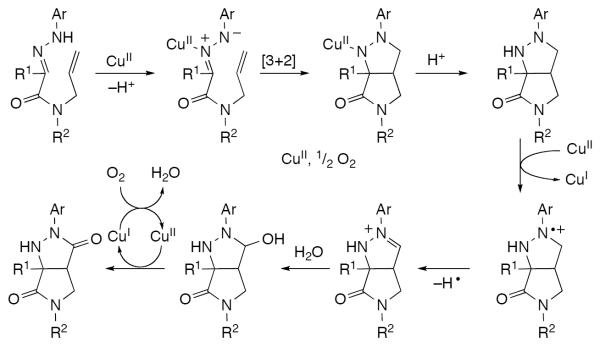
Mechanism for the tandem cyclization-oxidation.
IX.B Iminyl Radical Reactions
An intermediate in all of the chemistry described above in this subsection is the iminyl radical formed by one electron oxidation of the amine. The copper catalyzed oxygenolysis of cycloproplyamines to epoxy ketones was described in 1975.1126 The method yielded the epoxy ketones, but suffered from poor yields (Scheme 593).
Scheme 593.
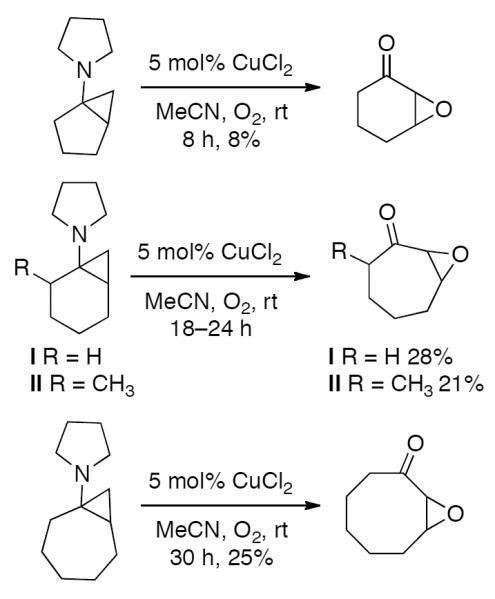
Oxygenolysis of cyclopropylamines to epoxy ketones.
The mechanism (Scheme 594) is proposed to involve the iminyl radical which initiates fragmentation of the cyclopropane ring. Alpha cleavage (Scheme 594, A) is proposed for the fragmentation leading to imminium ion radical II which is trapped by dioxygen forming a 1,2-dioxolane intermediate V. Intermediate V then undergoes an O–O bond cleavage and hydrolysis to form the corresponding epoxy ketone VII. An alternate pathway proceeds through beta-bond cleavage (Scheme 594, B), affording a primary imminium radical III`. Upon oxygenation of intermediate III` an oxaspiro epoxy ketone IV` can form. The authors speculate it is unlikely that beta-bond cleavage occurs due to exclusive formation of the ring expanded epoxy ketone VII. Furthermore the, cation radical III` is speculated to be less stable then cation radial III formed from the alpha-cleavage pathway. Interestingly, the oxygen atoms are proposed to arise from dioxygen. However, further experiments were not conducted to support this hypothesis.
Scheme 594.
Mechanism of the oxygenolysis of cyclopropylamines.
In contrast to this early case, a recent example of a copper catalyzed oxidative intermolecular cyclization, which intercepts an iminyl radical, has been found to proceed in high yields.1127 Specifically, N-methylanilines couple with electron deficient alkenes (Scheme 595). Using various N-methyl anilines a broad array of tetrahydroquinolines could be generated in moderate to good yields (Scheme 596). The process only works for tertiary anilines with at least one N-methyl group; attempts to couple N-methyl-3,4-dimethylaniline or N,N-diethylaniline were unsuccessful. This process has been proposed to proceed via the radical cation intermediate (II, Scheme 597) instead of an iminium intermediate (VIII). Experimental evidence supporting this mechanism is the regioselectivity observed for preferential coupling at the ortho-position of the arene (I). The authors speculate trapping of II occurs faster than the second one-electron oxidation to form imminium ion VIII (Scheme 596) even though secondary and benzyl radicals are more stable.
Scheme 595.

Oxidative cyclization of iminyl radicals with alkenes.
Scheme 596.
Substrate scope of the oxidative cyclization of iminyl radicals with alkenes.
Scheme 597.
Mechanism of the oxidative cyclization of iminyl radicals with alkenes.
IX.C. N-S Bond Formation from Amines
Taniguchi and co-workers have reported a copper-catalyzed synthesis of sulfenamides from diaryl disulfides.1128 Primary and secondary alkyl amines were reacted efficiently with diphenyl disulfide (Scheme 598) and aryl disulfides (Scheme 599) to afford the desired sulflenamide in moderate to good yields. Anilines were unreactive under these conditions and oxygen was required for this transformation to occur. Additional transformations involving further oxygenation of the sulfur atom combined with N-coupling are described in Section XII.B.
Scheme 598.
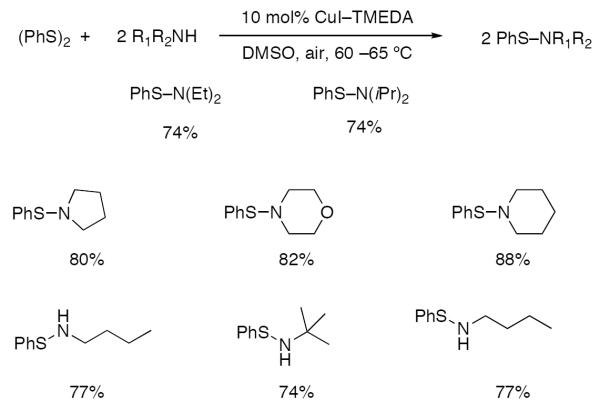
Copper–catalyzed coupling of diphenyl disulfide with various alkyl amines.
Scheme 599.
Copper–catalyzed coupling of various aryl disulfides with alkyl amines.
In an effort to understand the mechanism, tert-butyl amine was treated with PhSCu to determine its possible role as an intermediate. The desired sulfenamide was obtaind in a 59% isolateld yield suggesting PhSCu forms in the course of the reaction. A decrease in yield was observed in the absence of oxygen. The authors speculate the copper acts as Lewis acid and co-oxidant with air. A mechanism was proposed based on these findings (Scheme 600).
Scheme 600.
Proposed mechanism of the sulfonylation reaction.
IX.D. Reactions of Hydrazines
A survey of the literature has revealed the chemistry of hydrazine oxidation mediated by copper has remained largely unexplored to date. One example of a copper-mediated oxidation of a hydrazine derivative to the corresponding azo compound in quantitative yields was reported by Fodor and Wein (Scheme 601).1129 Further examples where hydrazine compounds are intermediates in the couplings of arylamines to form azo species are presented in Section VIIIB.
Scheme 601.

Oxidation of a hydrazine to an azo compound
IX.E. Reactions of Hydrazides
The difficulty in hydrolysis of hydrazides has led to examination of numerous oxidative protocols including those employing copper and oxygen. While the reactions of hydrazides has been studied more than those of hydrazine, this area also remains underdeveloped. The driving force for these oxidations is rapid elimination of nitrogen followed by oxidation of the carbonyl carbon (Scheme 602).
Scheme 602.
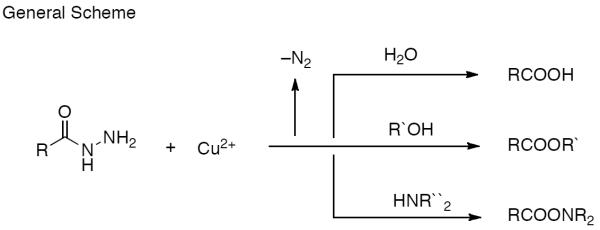
Copper mediated oxidation of hydrazides.
Tsuji and co-workers reported the first example of hydrazide oxidation for the synthesis of carboxylic acids, esters, and amides using oxygen activated by copper salts in 1975 (Scheme 603).1130 The choice of copper source is important for promoting oxidative cleavage of the hydrazide, and excess amounts of copper are used. Cu(NO3)2, CuCl2, and copper oxide showed no activity while Cu(acac)2 was similar in reactivity to Cu(OAc)2. Benzoic acid was synthesized selectively while the synthesis of esters required in-situ formation of Cu(OMe) by treatment CuCl with sodium methoxide to achieve good selectivity. A mixture of products was obtained for ester synthesis when pyridine and methanol was used. An amine solution of Cu(OAc)2 was required for the synthesis of amides. The authors speculate that a stepwise oxidation of the hydrazide to form an acyl cation with liberation of nitrogen water occurs. The acyl cation can then be trapped by the alcohol, amine, or water nucleophile to afford the desired product.
Scheme 603.
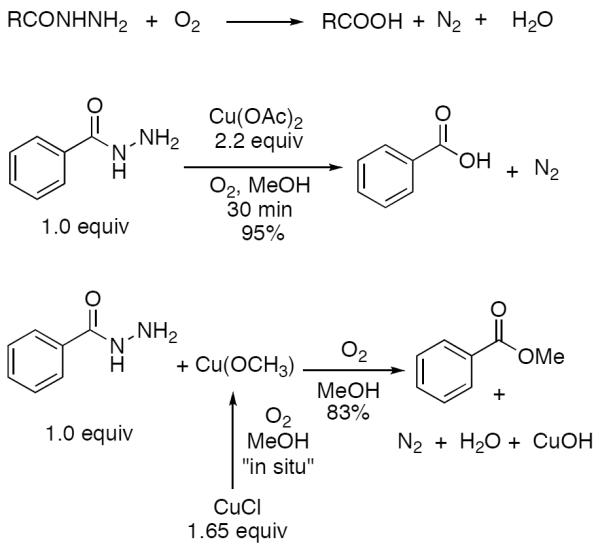
Oxidation of hydrazide to carbonyl derivatives.
A copper catalyzed oxidation of hydrazide to carboxylic acids under an oxygen atmosphere was subsequently developed.617 Although the amount of copper was decreased significantly from earlier work, only one example was provided for the synthesis of benzoic acid (Scheme 604).
Scheme 604.

Synthesis of benzoic acid from phenyl hydrazide.
Tsuji and co-workers attempted to broaden the scope of the catalytic protocol for the synthesis of acids, esters, and amides.1131 Catalytic amounts of Cu(OAc)2 with continuous bubbling of oxygen through a methanol solution proved to be effective only for the synthesis of carboxylic acids. For the esters and amides, stoichiometric amounts of copper were required. Aromatic and aliphatic hydrazides could be oxidized efficiently (Scheme 605). Oxidation of para-nitrobenzohydrazide was problematic affording the ester as the major product.
Scheme 605.
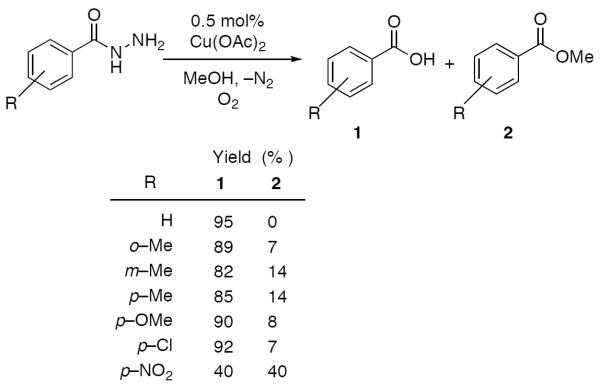
Synthesis of various aromatic carboxylic acids and esters.
A possible mechanism for these transformations involves a diazoacyl species which rapidly expels nitrogen to generate an acyl cation that is trapped by exogenous nucleophiles (Scheme 606).
Scheme 606.
Mechanism of copper catalyzed conversion of hydrazides to carboxylic acids.
IX.E. Oxidative N–N Bond Formation from Amines
The earliest example of an oxidative coupling of secondary amines to the corresponding hydrazines in good yields using excess copper was reported by Kajimoto (Scheme 607).1132 Secondary amines such as di-2-naphthylamine and N-ethylamine were not efficient (yields were not reported). Since there are several other reaction pathways available to amines (see Section IX.A –Section IX.B above), control to achieve high N-N selectivity is difficult.
Scheme 607.

Oxidative coupling of secondary amines.
The authors speculate the secondary amine undergoes a copper mediated one-electron oxidation to form an amino radical (Scheme 608). The amino radical undergoes coupling with another amino radical generating the N–N bond. This mechanisms is similar to the oxidation of anilines to the corresponding azo compounds as described in Section VIII.B.
Scheme 608.

Proposed mechanism for oxidative coupling of secondary amines.
In a different approach than that outlined above, a catalytic amount of copper is utilized to first activate a nitrile for addition by 2-aminopyridine in a non-oxidative amidine forming reaction. Subsequent copper-catalyzed oxidative N–N bond formation then provides the 1,2,4-triazole product (Scheme 609).1133 Other copper sources, such as CuCl, CuBr2, and Cu(OAc)2 could be used with similar results. An array of aryl- and heteroarylnitriles could be employed under the reaction conditions to afford the triazolopyridines in good to excellent yield.
Scheme 609.
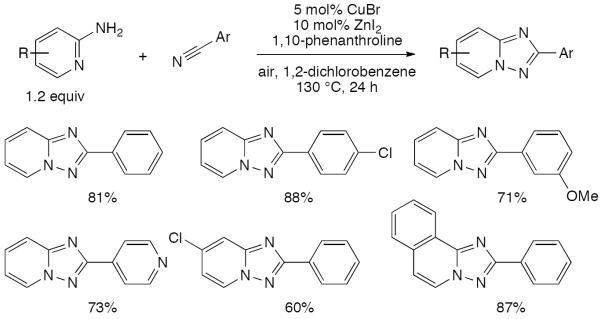
Tandem amidine formation and oxidative cyclization to afford triazolopyridines.
Control studies afforded no product in the absence of copper. The triazole product was also formed when utilizing the amidine addition intermediate, confirming N–N bond formation subsequent to aniline addition to the nitrile. This step could also be effected in the absence of oxygen with stoichiometric copper to give similar yields as the catalytic process. With these results, a mechanistic proposal is suggested with initial copper activation of the nitrile and nucleophilic attack by the aniline nitrogen (Scheme 610). Oxidation of the resulting amidine constructs the N–N bond and affords the triazolopyridine product. The reduced copper species is oxidized by molecular oxygen to close the catalytic cycle. Since the final cyclization event occurs in good yield in the absence of zinc, zinc is thought to aid in initial amidine formation.
Scheme 610.
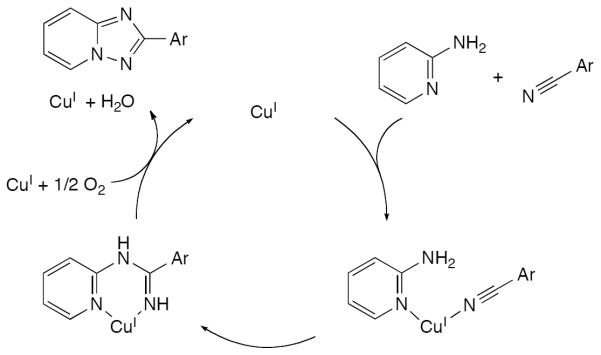
Mechanistic proposal for the tandem addition/oxidative cyclization of benzonitriles with 2-aminopyridines.
The process could also be extended to the formation of 1,2,4-triazoles by replacing the 2-aminopyridyl substrate with alkyl or aryl amidines. This variant employs stoichiometric base but does not require the zinc co-catalyst.
X. Reactions of Azides
Transition metal catalyzed β–carbon elimination of iminyl metal species has been explored recently for the activation of C–C bonds using Rh, Pd, and Mn metals (Scheme 612).
Scheme 612.

Metal catalyzed β–carbon elimination of iminyl metal species.
Examples employing copper catalysts for C–C bond cleavage of a transient iminyl copper species have recently been pioneered by Chiba and co-workers for the synthesis of nitriles.1134 A diverse array of aliphatic and aryl nitriles containing halogens, electron donating, and electron withdrawing groups were synthesized in moderate to good yields from α-azido esters (Scheme 613). Efforts to elucidate the mechanism revealed that the oxygen atom incorporated into the beta fragment of the carboxylic acid originates from molecular oxygen. This result provided an explanation for the dramatic increase in reaction rate observed under an oxygen atmosphere. A proposed mechanism based on these observations is shown in Scheme 614.
Scheme 613.
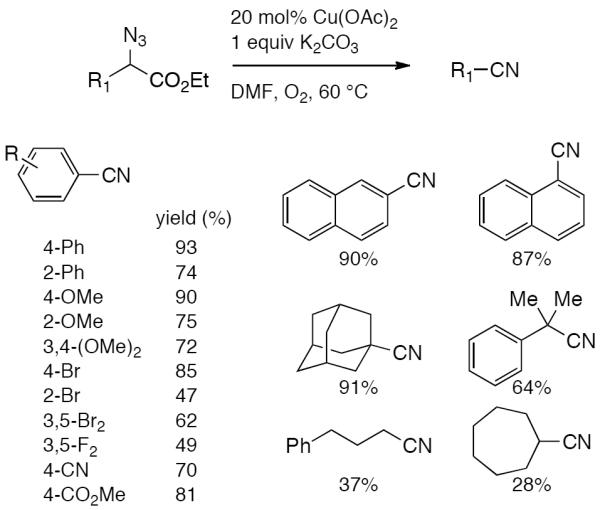
Substrate scope for synthesis of nitriles from azidoesters.
Scheme 614.
Proposed mechanisms for the synthesis of nitriles from azidoesters.
Formation of benzoic acid and nitrile product from the reaction of azide with 1.0 equiv Cu(OAc)2 under an inert atmosphere was hypothesized to arise from fragmentation of the iminyl copper species (center of catalytic cycle in Scheme 614) followed by air oxidation of acyl copper species during work up. The oxygen mediated beta–fission (outer cycle in Scheme 614) may be faster than the non-oxygen process thus accounting for the increased rate observed under an aerobic conditions.
While exploring the scope of the previous reaction, the catalytic conditions were applied to α-azido-amides for the synthesis of nitriles.1088 Initial studies employed α-azido-morpholine amide, which provided the desired nitrile product in 73% yield (Scheme 615a). However, subjecting an α-azido-aryl amide to the reaction conditions instead formed an unexpected azaspirocyclohexadienone product instead of the anticipated aryl nitrile (Scheme 615b). The process was found to be general for a variety of substrates, affording moderate to good yields when aryl substituents containing electron donating and electron withdrawing groups were installed at the α-position (see Section VIII.E for complete discussion, substrate scope, and mechanistic proposal).
Scheme 615.
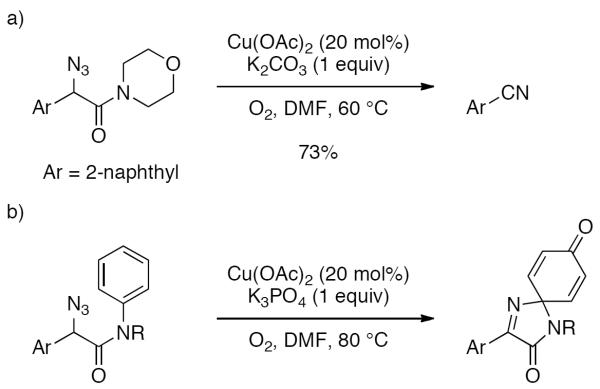
Orthogonal oxidation products of α-azido amides.
While examining the reactivity of α-azido–amides, 2-formyl pyrazinone was isolated from the reaction of N-allyl-N-phenylamide in 18% yield along with formation of the desired azaspirodienone in 42% yield (Scheme 616). Chiba and co-workers further developed this chemistry for the synthesis of 2-formyl pyrazinones from α-azido–N-allylamides.1135 Studies with α-azido–N-allyl-N-benzylamide provided the 2-formyl pyrazinone in 62% isolated yield. Under an inert atmosphere none of this material was detected; instead, a dihydropyrazinone by-product was isolated in 14% yield suggesting that oxygen is critical for this transformation (Scheme 617).
Scheme 616.

Reaction of N-allyl-N-phenylamide.
Scheme 617.

Reaction of α-azido–N-allyl-N-benzylamide.
Using this method, a variety of pyrazinones were synthesized containing electron-rich aryl groups and halogens in moderate to good yields. Substrates with a nitrile-substituted aryls reacted in poor yield, and alkyl groups were not tolerated at the R1 position. Substrates with alkyl, benzyl and aryl groups on the amide nitrogen provided moderate yields (Scheme 618).
Scheme 618.
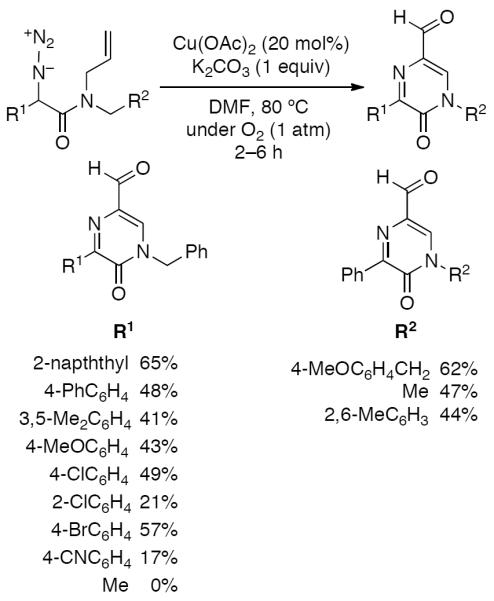
Substrate scope for synthesis of pyrazinones from α-azido–N-allylamides.
To determine if an iminyl species intermediate is involved in the reaction mechanism, a transient N-H imine species A was synthesized using basic conditions and subjected to the optimized reaction conditions (Scheme 619a). Only α-keto amides were isolated indicating that a copper iminyl species was not formed. Subsequently, α-azido–N-ally-N-benzylamide was heated at reflux under toluene in the absence of copper catalyst to afford an aziridine product (Scheme 619b). The formation of the aziridine product was proposed to arise from 1,3-dipolar cycloaddition of the α-azido–N-allyl-N-benzylamide to afford bicyclic intermediate B, which undergoes rapid denitrogenation. The desired pyrazinone was formed in 46% yield upon exposure of the aziridine to the optimized reaction conditions.
Scheme 619.
Control experiments investigated to elucidate mechanism of pyrazinone formation.
Based on these control experiments a mechanism has been proposed (Scheme 620). First, the α-azido–N-allyl-N-benzylamide undergoes a 1,3-dipolar cycloaddition to afford II, which undergoes rapid denitrogenation to form III. Single electron oxidation of III affords a radical cation intermediate IV. Deprotonation of IV and subsequent opening of the aziridine ring forms a primary radial intermediate V. A copper peroxy species then traps the primary radical to afford VI, which is further oxidized to form the formyl group. Copper mediated oxidation of VII affords the desired pyrazinone.
Scheme 620.
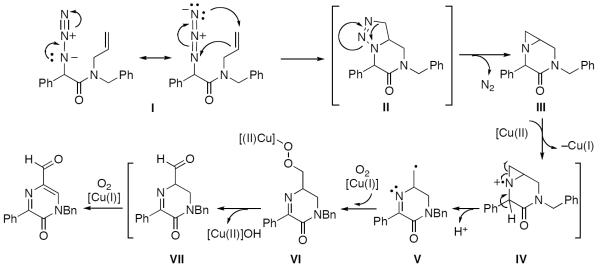
Proposed mechanism for the synthesis of pyrazinones from α-azido–N-allylamides.
XI. Reactions of Ethers
In general, the radical abstraction at the position alpha to oxygen is less favorable than alpha to an amine (see Section IX.A). For this reason, the copper catalyzed oxidations of ethers were typically not useful, giving rise to mixtures. For example, early work surveying the catalytic activity of a binuclear copper(II) complex with 7-azaindole in the oxidation of benzyl ethers to esters showed modest turnover, and low isolated yields (Scheme 621).1136 An increase in yield was observed with larger alkyl substituents (tertiary > secondary > primary) implying that coordination of the ether to copper species is not crucial to oxidation.
Scheme 621.

Oxidation of benzyl ethers.
In an effort to further understand the effects of ligand tuning on the equilibrium of copper bishydroxo species, Zhang and co-workers synthesized several Cu(I) complexes containing tridentate bis[2-(2-prdiyl)ethyl]methyl amine ligands. Varying the electronics of these ligands by modification of the 4-substituent influenced the reactivity of the copper complexes in the 2-electron oxidations of tetrahydrofuran, N-methylaniline, and primary alcohols (Scheme 622).1137 Notably, these reactions are not catalytic. Experiments employing 18O2 indicated that hydroxylation of tetrahydrofuran involves transfer of an oxygen atom from the copper bishydroxo complex.
Scheme 622.
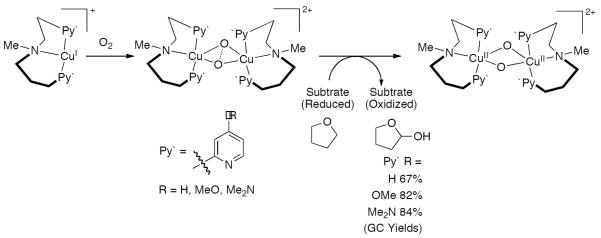
Oxidation of tetrahydrofuran.
More recent discoveries have shown that use of a catalytic oxidant, such as N-hydroxyphthalimide (NHPI) can facilitate the process to a useful level. Due to the stronger bonds in ethers vs amines (see Section IX.A), stronger oxidants than oxygen are typically required in the copper catalyzed oxidations of ethers.1092a,1138 However, this problem can be overcome by using a catalytic oxidant, such as N-hydroxyphthalimide (NHPI) (Scheme 623).1139 Under these conditions, cyclic benzyl ethers can be oxidatively coupling with a range of malonate and ketone nucleophiles. With the exception of ethyl phenyl ketone, couplings to the ethyl group of ketones do not proceed well.
Scheme 623.
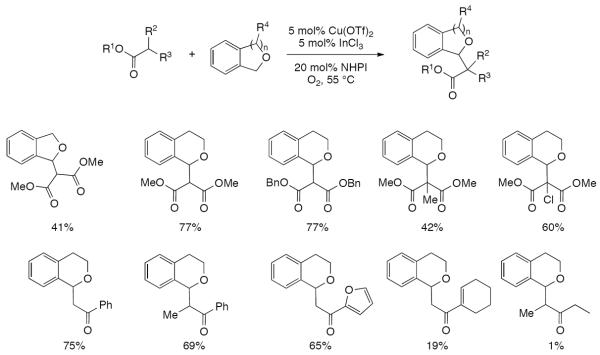
Oxidative coupling of ethers and ketones using the cooxidant, NHPI.
The mechanism proposed for this transformation (Scheme 624) is similar to that proposed for the amine oxidation (see Section IX.A). Key differences include a single electron oxidation catalyzed by NHPI which is in turn reoxidized by dioxygen. The resultant radical traps oxygen to form a peroxyketal which is then reduced by the copper or indium to provide a hemiketal. The oxocarbenium formed from the hemiketal can than trap a nucleophile. The copper/indium plays an additional role as a Lewis acid to facilitate deprotonation of the nucleophile.
Scheme 624.
Mechanism of the oxidative coupling of ethers and ketones.
Another example of two oxidants working in tandem can be found in Scheme 625 where both TBHP and O2 are required to achieve the products.1140 This tandem process is comprised of a hydroxyalkylation of an alkene followed by further oxidation to the ketone. A plausible mechanism for this reaction is outlined in Scheme 626.
Scheme 625.
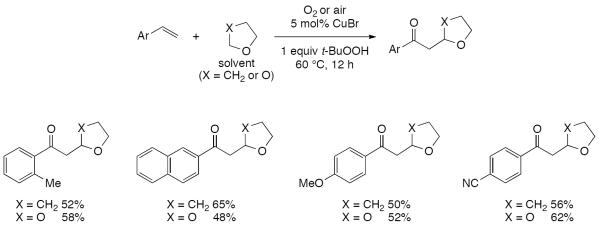
Oxidative coupling of ethers and alkenes.
Scheme 626.
Possible mechanism the copper catalyzed coupling of ethers and alkenes.
XII. Reactions of Thiols
XII.A. Sulfoxidation
Sulfoxides are key intermediates in organic synthesis and medicinal chemistry and many methods have been reported for their synthesis. Even so, the majority uses peroxide or peracid oxidants. For example, copper catalyzed oxidations of sulfides to sulfoxides with tert-butyl hydroperoxide (TBHP) have been reported as highly effective.1141 However, the corresponding reaction with oxygen has lagged due to overoxidation of the sulfides. Some progress has been made as shown in Scheme 627 suggesting that a general aerobic copper catalyzed oxidation is viable.1142,1143
Scheme 627.
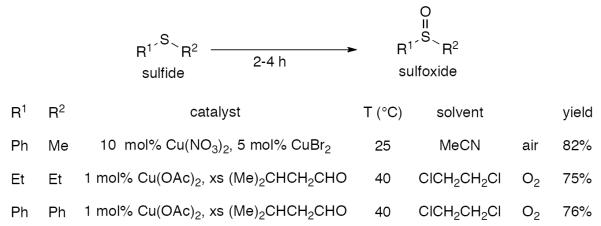
Copper catalyzed oxidation of sulfides to sulfoxides.
Gamba and co-workers demonstrated that dinuclear copper complexes could be used for oxygenation of thioanisole in 93% yield (Scheme 628).1144 Isotope labeling experiments demonstrated that direct oxygen transfer occurs from the copper complex and that binding of the thioanisole to the copper species is not needed. The reaction was found to be sensitive to sterics and electronics. A mechanism for this transformation has been outlined in (Scheme 628).
Scheme 628.
Sulfoxidation by a dinuclear copper complex.
XII.B. S-N Bond Formation
Several protocols involving the formation of sulfur–nitrogen bonds have been reported (see also N–S bond formation, Section IX.C). The first example involving copper mediated S–N bond formation was described in 2007 for the synthesis of sulfenamides from diaryl disulfides (see Scheme 598 and Scheme 599 in Section IX.C).1128
Later, Taniguchi reported the copper-mediated of thiols with amines for the preparation of sulfenamides, sulfinamides, and sulfonamides. Under very mild conditions using air, dehydrocoupling occurred to provide the sulfenamides in good yields with a variety of amine donors (Scheme 629).1145 Aryl amines afforded slightly lower yields in this process due to competing oxidation of the anilines.
Scheme 629.
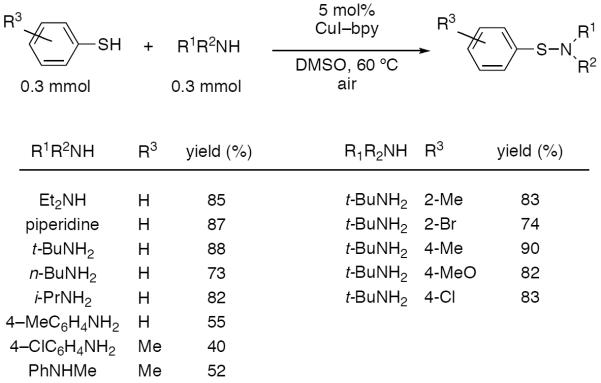
Sulfenylation of thiols.
By employing oxygen instead of air and larger amounts of the copper catalyst (10 mol% vs 5 mol%) it was possible to initiate further oxygenation of the sulfur center to generate the sulfonamides (Scheme 630, top). The reaction could be controlled by using of 30 mol% PdCl2, 5 mol% CuI, and air resulting in mono-oxygenation to the sulfinamides (Scheme 630, bottom). Product formation was not observed under an inert atmosphere indicating that oxygen is integral to the reaction. A mechanism for the first step in these transformations, N–S bond formation, is outlined in Scheme 631.
Scheme 630.
Sulfonamides and sulfinamides by coupling of amines and thiols followed by sulfur oxygenation.
Scheme 631.
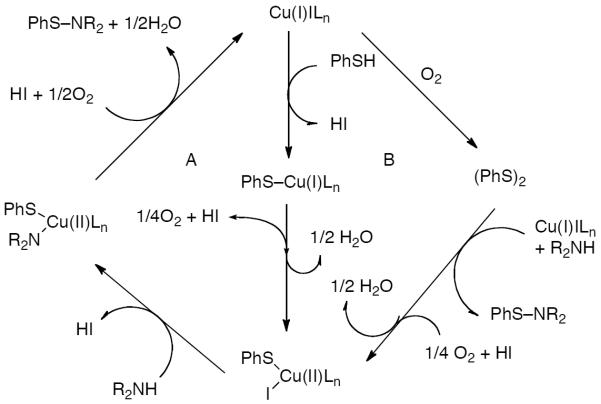
Mechanism for formation of the N–S bond.
XII.C. S-C Bond Formation
Several other copper catalyzed oxidation reactions utilizing oxygen have been reported for sulfur and selenium substrates resulting in formation of S-C and Se-C bonds, respectively. However, in these cases, the oxidation state of the sulfur and selenium remains unchanged over the reaction course. As a consequence, these transformations are discussed in Sections II.D.4, which focus on the oxidation the carbon partners, alkynes and alkenes. The corresponding couplings of heteroarenes such as azoles, thiazoles, and benzimidazoles with sulfur nucleophiles to afford thioethers are described in Section II.E.4.
XIII. Oxidation of Phosphorus Compounds
Processes employing copper and oxygen for the oxidation of phosphorus compounds are rare. In particular, oxygenase reactions to afford P-O bonds have received only limited attention. Instead, the majority of reports focus on the coupling of H-phosphonates with various partners in a C-P bond forming process. H-Phosphonates are known to exhibit tautomeric behavior between the favored phosphonate form and the more nucleophilic phosphite,1146 which in turn participates in these oxidative couplings.1147 In the context of copper-oxygen catalysis, however, oxidation at phosphorus is concomitant with carbon-phosphorus bond formation. In spite of this issue, successful coupling with tetrahydroisoquinolines,1102 arylboronic acids,1148 and alkynes234 have been achieved (Scheme 77).
In some of these processes, other phosphorus oxidation products are observed. For example, trialkyl phosphates are observed as byproducts in the coupling with tetrahydroisoquinolines, and oxidative dimerization to form diphosphates was observed when using an oxygen atmosphere (rather than air) involving coupling with aryl boronic acids. For additional details as well as mechanistic discussion, see the sections noted in Scheme 77.
Phosphines are more often used as ligands in copper catalyzed reactions than substrates. However, the oxidation of triphenylphosphine has been effected in quantitative yield to afford the phosphine oxide with a copper(I)-tris(pyrazolyl)borate catalyst, oxygen, and a peroxide additive (Scheme 633).35 The authors note that under concentrated conditions, reaction inhibition was observed due to competitive binding of the active catalyst with the phosphine substrate.
Scheme 633.

Oxidation of triphenylphosphine with copper, oxygen, and peroxide additive.
XIV. Summary
Much is still unknown about copper and, in particular, its reaction with molecular oxygen under different sets of conditions. However, it is clear that copper is highly versatile with different ligand spheres and different reaction conditions giving rise to a large range of reaction chemistries useful in organic synthesis. Molecular oxygen is readily available and the byproduct from its use, water, is benign. Copper is also an inexpensive metal that is readily available. With the drive toward sustainable and environmentally benign synthetic methods, oxidative and oxygenation reactions with copper catalysts and reagents that employ O2 as the terminal oxidant are logical targets for further development.
This review provides comprehensive coverage through 2011 and a testament to the attention that this area of research is receiving can be found in the 108 papers that have appeared in the period from January 2012 to Feburary 2013. These reports include: reviews (Section I),1149,1150,1151,1152 oxygenation of unactivated benzylic substrates (Section IIA.2),1153,1154,1155 alkane oxidation (Section II.B),1156,1157,1158 epoxidation of alkenes (Section II.C.2),1159 oxidation difunctionalization of alkenes (Section II.C.3),1160,1161,1162,1163,1164 cross coupling with alkynes (Section II.D.3),1165 oxidation difunctionalization of alkynes (Section II.D.4),1166,1167,1168 arene hydroxylation (Section II.E.1),1169 reactions involving nucleophilic arenes (Section II.E.2),1170 direction insertion of arenes (Section II.E.3), 1171,1172,1173,1174,1175 functionalization of acidic arene positionos (Section II.E.4),1176,1177,1178 coupling of carbanion equivalents with boronic acids (Section III.C),1179,1180,1181,1182,1183,1184,1185 alcohol oxidation (Section IV.A.1),1186,1187,1188,1189,1190,1191,1192,1193,1194,1195,1196,1197,1198,1199 tandem reaction with alcohol oxidation (Section IV.D),1200,1201,1202,1203,1204,1205,1206,1207,1208 oxidation of aldehydes to amides (Section V.A),1209 enolate oxiation without cleavage (Section V.C),1210,1211 oxidative coupling of enolates (Section V.C.1),1212 α-oxygenation of carboxylic acids (Section V.E),1213 reaction of hydrazones (Section V.G),1214 oxidation of hydrazones with cyclization (Section V.G),1215,1216 reactions of enamines (Section VI.A),1217,1218,1219,1220 α-oxidation of enamines (Section VI.A.2),1221,1222,1223 intermolecular phenol coupling (Section VII.B.1),1224 C-O naphthol polymerization (Section VII.C.3),1225,1226,1227 formation of catechols from phenols (Section VII.D.1),1228,1229 formation of quinones from phenols (Section VII.D.2),1230 formation of ortho-quinones from catechols (Section VII.E.1),1231,1232,1233,1234 (Section VII.B.1), C-C couplings of anilines (Section VIII.A),1235 heterocycle formation from anilines (Section VIII.D),1236,1237,1238 reaction of amines via iminiums (Section IX.A),1239,1240,1241,1242,1243,1244,1245,1246,1247,1248,1249,1250,1251,1252 reactions of ethers (Section XI),1253 S–C bond formation from thiols (Section XII.C),1254,1255 and oxidation of phosphorous compounds (Section XIII).,1256
Many of the above transformations are biomimetic. Even with the successes achieved to date, considerable work remains to reach the levels of reactivity and selectivity seen in many of the enzymatic counterparts. A wealth of non-biomimetic copper catalyzed processes have also been discovered. As the understanding of the fundamental mechanisms of copper improves in both of these spheres, the prospects for achieving new or improved oxidative processes with this highly versatile metal is very promising.
Chart 1.
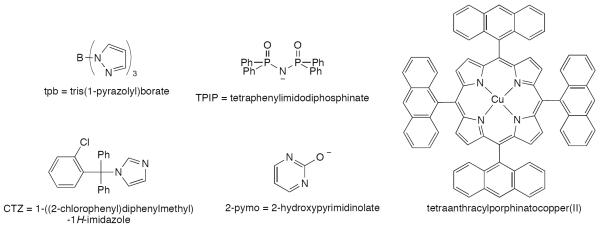
Ligands utilized in Table 1.
Chart 2.
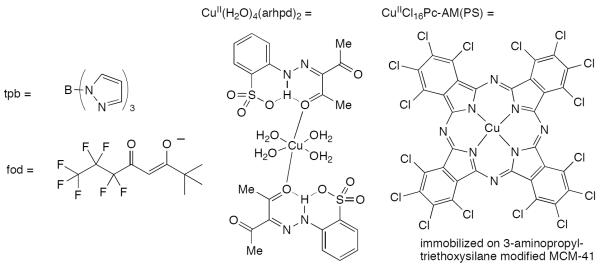
Ligands utilized in Table 2.
Chart 3.
Ligands utilized in Table 3.
Chart 4.

Ligands utilized in Table 4.
Scheme 20.
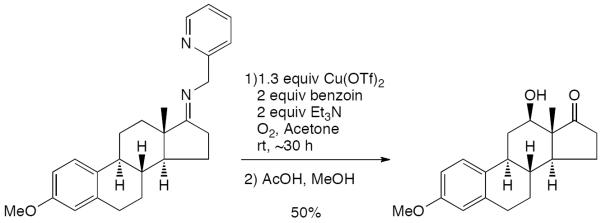
Directed alkane oxidation of a steroid.
Scheme 58.

Hay coupling with hindered amine additive.
Scheme 102.
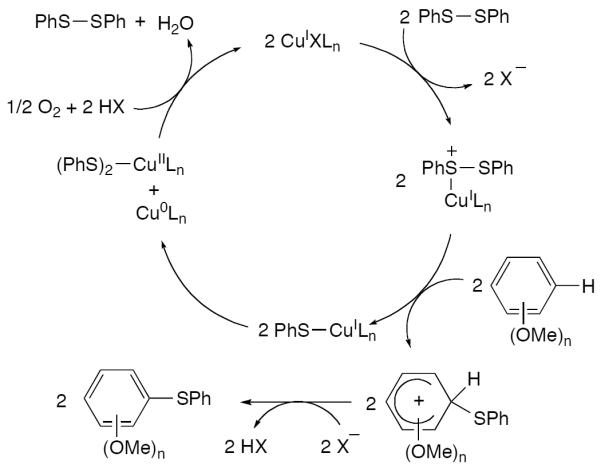
Proposed mechanism for arene thiolation.
Scheme 115.
Possible mechanism for the oxidative formation of phenanthridines.
Scheme 128.
Ortho-hydroxylation of toluic acid isomers.
Scheme 217.
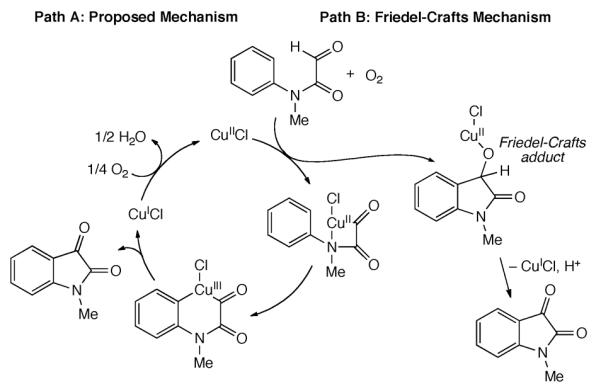
Two possible mechanisms for the oxidative cyclization to afford isatins.
Scheme 434.
Oxidative polymerization of para-substituted phenols to obtain predominantly C-O coupled product.
Scheme 436.

Oxidative polymerization of 1-naphthol.
Scheme 500.
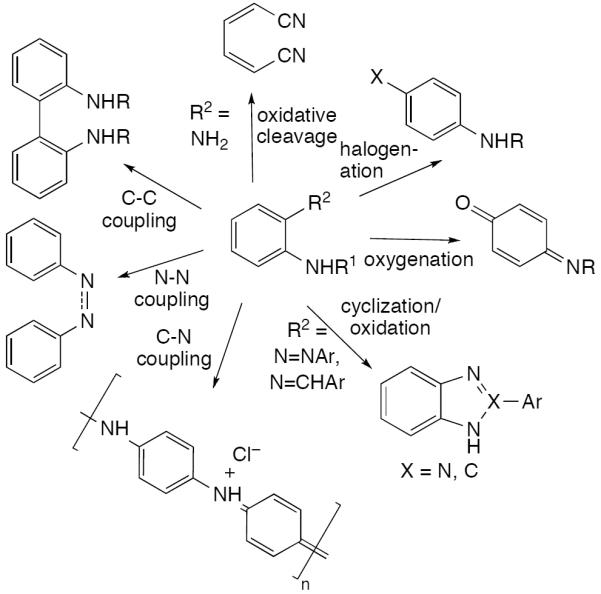
Potential oxidation pathways of anilines.
Scheme 520.
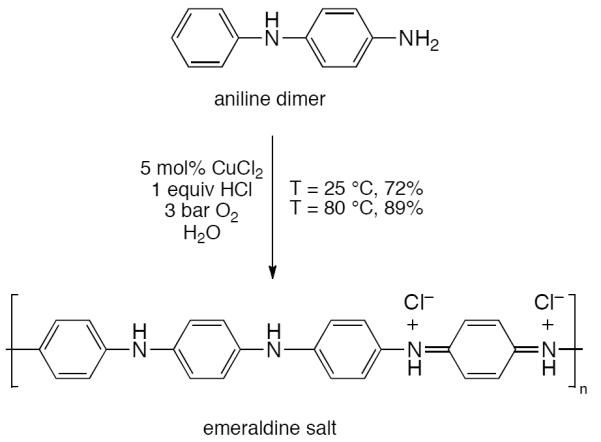
Oxidative polymerization to form polyaniline.
Scheme 552.
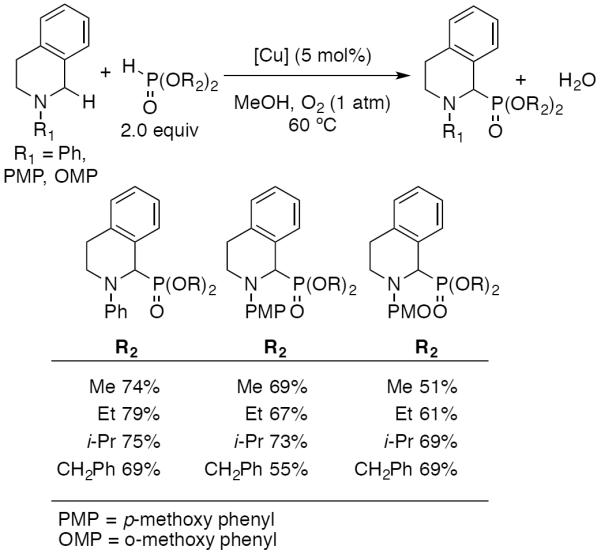
Substrate scope for copper catalyzed aerobic phosphination.
Scheme 567.

Oxidation of primary and secondary amines using polymer bound copper catalyst.
Scheme 611.
Oxidative cyclization of amidines to afford triazoles.
Scheme 632.
Oxidative coupling of H-phosphonates to form C-P bonds.
Table 8.
N-Arylation conditions.
| Entry | Coupling Partner | Copper Source | Nitrogen Nucleophile | Number of Examples | Base | Conditions | Yield (%) | Ref |
|---|---|---|---|---|---|---|---|---|
|
Catalytic Copper
| ||||||||
| 1 | Aryl boronic acids | CuBr | Hydroxylamine hydrochloride | 13 | K2CO3, | MeCN, 70 °C | 40–84 | 326 |
| 2 | 5 mol% CuCl | imidazole | 8 | – | MeOH (or water), reflux, air | 92–99 | 327a | |
| 3 | Cu(OAc)2 | Imidazoles, imides, primary and secondary amines, amides, anilines, sulfonamides | > 20 | – | [bmim][BF4] 70 °C | 30–95 | 328a | |
| 4 | aniline, primary and secondary alkyl amines | 23 | lutidine | 10–40 mol% myristic acid, toluene, air, rt | 51–91 | 328c | ||
| 5 | Cu(OAc)2 anhydrous | Inosine and guanosine | 18 | 2.0 equiv Pyridine | 2.0 equiv pyridine N-oxide, 4 Å MS, CH2Cl2, rt O2 |
32–100 | 329 | |
| 6 | Sulfoximines | 10 | — | MeOH, rt | 62–93 | 330 | ||
| 7 | Cu(OAc)2·H2O | Aqueous ammonia | 8 | 50 mol% Benzoic acid, ethyl, propionate, 80 °C, air | 57–85 | 331 | ||
| 8 | Cu(OAc)2·H2O | cytosine, adenine, uracil, thymine | 20 > | — | 2.0 equiv TMEDA, MeOH, H2O, rt, air | 28–90 | 332 | |
| 9 | CuSO4·5H2O | Aqueous ammonia | 11 | NaOH | aqueous NH3, rt air | 55–92 | 333 | |
| 10 | Cu2O | Aqueous ammonia | 21 | — | MeOH, 20 °C, air | 65–93 | 334 | |
| 11 | Cu2O | Imidazole, benzimidazole, pyrazole, primary and secondary alkyl amines, and aniline | 23 | — | MeOH, rt, air | 80–95 | 335 | |
| 12 | Cu(NO3)2 | Imidazole, benzimidazole, 2-substituted imidazole, 2-substitued benzimidazole | 22 | — | TMEDA, MeOH, rt O2 |
48–99 | 325 | |
| 13 | 5 mol% [Cu(II)(OH)(ligand)]2Cl2 | imidazole | 8 | — | (1:1 v/v) NMP/H2O, 20 °C, air ligand = TMEDA, substituted bipyridine, amino alcohols, substituted phenanthroline | 10–99% | 336 | |
| 14 | CuCl2 | Imidazole, 2- and 4-substituted imidazole, benzimidazole | 10 | — | TMEDA, CH2Cl2, rt, O2 or air | 58–98 | 321 | |
| 15 | Cu(OAc)2 50 mol% | Anilines and aliphatic amines | 17 | — | Ethyl acetate, O2 (1.01·105 PA), rt | 40–80 | 337 | |
| 16 | CuFAP (FAP = fluor-apatite) 100 mg | Imidazole, benzimidazole, anilines, primary alkyl amines | > 20 | — | MeOH, rt | 78–93 | 328b | |
| 17 | Silica supported copper catalyst 10 mol% | Imidazole, benzimidazole, phthalimide | 10 | — | MeOH, 70 °C | 78–98 | 338 | |
| 18 | Silica tethered Copper complex | Imidazole benzimidazole | 10 | — | MeOH, 80 °C air | 88–94 | 327 | |
| 19 | Cellulose supported Cu(0) catalyst | Imidazole | 8 | Et3N | MeOH, reflux, air | 77–98 | 339 | |
| 20 | Cu–Al Hydrotalcite catalytic | Imide | 10 | — | MeOH, air (continuous bubbling), reflux | 87–91 | 340 | |
| 21 | Aryl and heteroaryl boronic acids | Sulfonato Cu(II) salen) complex | Imidazole | 20 | — | H2O, 100 °C, air | 43–95 | 341 |
| 22 | Cu-NHC (Cu powder) 0.5 mol% | Imidazole, 2-substituted imidazole, benzimidazole, aromatic amines | 15 | — | MeOH, rt, air | 51–98 | 342 | |
| 23 | Aryl, heteroaryl, alkenyl boronic acids | Copper fluorapatite | Pyrazoles, imidazole, benzimidazole | 20 > | — | MeOH, rt, air | 30–96 | 343 |
| 24 | Aryl and alkenyl boronic acids | Cu(OAc)2 | Benzimidazolinone, benzimidazole, isatine, phthalamide, piperidine, indazole, aniline, pyridone, sulfonamide, acylsulfonamide | >20 | Et3N or Pyridine | 4 Å MS, 1.1 equiv TEMPO, CH2Cl2, air, (Several conditions) | 3–97 | 328e |
| 25 | N3–protected thymine and uracil, cytosine and uracil precursor, bis-Boc-adenine, guanine precursor | 20 > | Pyridine | 3 Å MS, CH2Cl2, rt, air | 40–98 | 344 | ||
| 26 | CuSO4 | NaN3 | 8 | — | MeOH, rt, air | 70–98 | 345 | |
| 27 | Alkenyl boronic acids | Cu(OAc)2 | Benzimidazolinone, 2–pyridinone, benzimidazole, indazole, phthalimide | 18 | Et3N | 4 Å MS, TEMPO, rt, air | 5–99 | 346 |
| 28 | Cyclopropy 1 boronic acid | Cu(OAc)2 | Indole, azoles (imidazole, benimidazole, 2-acetylpyrrole, benzotriazole, carbazole, oxazolidinone), amides, and sulfonamides | 19 | NaHMDS, DMAP | toluene, 95 °C, air | 36–87 | 347 |
| 29 | Aryl boronic acids and boronate esters | CuCl | TMS–N3 | 26 | — | 1.2 equiv TBAF, MeOH, reflux, air | 67–100 | 348 |
| 30 | Aryl boronic acids, boronate esters, boroxines | Cu(OAc)2·H2O | benzimidazole | 7 | Pyridine | DMF, 1.0 equiv H2O, 30 °C, air | 48–99 | 349a |
| 31 | Alkoxydien yl and alkoxystyry 1 boronate esters | Cu(OAc)2 | Imidazole, pyrrole, pyrazole, indazole, benzimidazole | 15 | t-BuOK | CsF, CH2Cl2, air | 5 < – 89 | 350 |
| 32 | Aryl boronic acids, aryl trifluoroborates | Cu(OAc)2·H2O | Primary and secondary alkyl amines, anilines, ammonium salts | >20 | — | 4 Å MS, rt – 40 °C, CH2Cl2, O2, | 26–34 | 351 |
| 33 | Aryl trifluoroborates | Cu(OAc)2 | Aniline | 16 | Pyridine | MW, air (solvent free) | 42–87 | 352 |
| 34 | Aryl trifluoroborates | Cu(II) ethyl acetoacetate | Imidazole | 15 | — | H2O, 40 °C, air | 41–92 | 353 |
| 35 | Alkenyl trifluoroborates | Cu(OAc)2 | Cyclic and acyclic amides | 17 | — | 4 Å MS, CH2Cl2 or CH2Cl2/DMSO, O2 | 25–97 | 354 |
| 36 | Cu(OAc)2 | Amide, heterocyclic amides, imides, carbamates, benzamides, and acetamides | > 20 | — | 4 Å MS, CH2Cl2 or CH2Cl2/DMSO, 40 °C, O2 | 22–quant. | 325, 355 | |
| 37 | Aryl trialkoxyborates | Cu(OAc)2 | Primary and secondary alkyl amines, anilines, amide, imide, imidazole | >20 (10) | — | 4 Å MS, toluene, O2, some experiments: 1.1 equiv Et3N N-oxide | 53–98 (43–95) | 349b |
| 38 | ArPb(OAc)3 | Cu(OAc)2 | Pyrazole, indazole, imidazole, benzimidazole, 1,2,4–triazole anion | 8 | — | CH2Cl2 or CH2Cl2/DMF, 25–140 °C | 24–98 | 323 |
| 39 | Ph3Bi(OAc)2 | Cu(OAc)2 | Imidazole, benzimidazoles, pyrazole, 1H-indazole, tetrazole | 6 | — | THF, 50 °C, air N,N,N',N'-tetramethylguanidin e | 33–93 | 356 |
| 40 | Aryl and vinyl trimethoxysilanes | Cu/FeCl3 | Imidazole and triazole | 12 | — | 3.0 equiv TBAF3H2O, 50 °C, air | 33–96 | 357 |
|
| ||||||||
|
Stoichiometric Copper
| ||||||||
| 41 | Aryl boronic acids | Cu(OAc)2 | N-nucleobases (adenine and cytosine) | 14 | — | TMEDA, MeOH/H2O, rt, air | 50–90 | 327b |
| 42 | Cu(OAc)2 | Protected guanine and adenine derivatives | 11 | — | 2.0 equiv TMEDA/o-phenanthroline, 4 Å MS, CH2Cl2 or MeOH, CaCl2 tube | 60–95 | 358 | |
| 43 | Cu(OAc)2 | Purine | 11 | — | 1.0 equiv phenanthroline, 4 Å MS, CH2Cl2, rt, air | 41–81 | 359 | |
| 44 | Cu(OAc)2 | Quinazolin-4(3H)-ones | 15 | Et3N, | CH2Cl2, rt, air | 55–88 | 360 | |
| 45 | Cu(OAc)2 1.1 equiv | α–aminoester | 15 | Et3N | CH2Cl2, air | 17–67 | 361 | |
| 46 | 1.5 equiv | Imidazole, pyrazole, indazole, benzimidazole, triazoles | 7 | Pyridine, | 4 Å MS, CH2Cl2, rt, air | 6–88 | 320a | |
| 47 | Cu(OAc)2 1.5 equiv | Pyrrole | 19 | Pyridine | CH2Cl2, air | 14–99 | 362 | |
| 48 | Cu(OAc)2 1.5 equiv | Aminotriazole nucleoside | 19 | Pyridine | 4 Å MS, CH2Cl2, air | 24–77 | 363 | |
| 49 | Cu(OAc)2 1.5 equiv | 3-trimethyl-silylindazole | 12 | Pyridine, | 4 Å MS, CH2Cl2, air, rt | 82–99 | 364 | |
| 50 | Cu(OAc)2 1.5 equiv | Secondary amines, Pyridines, N-hydroxybenzotriazole | 19 | Pyridine or Et3N, | 4 Å MS, CH2Cl2, air | 19–75 | 365 | |
| 51 | Cu(OAc)2 2.0 equiv | Pyrazinone | 8 | Et3N/Pyridine | CH2Cl2, MW, 0 °C, air | 83–97 | 366 | |
| 52 | Polymer–supported Cu(OAc)2 (catalytic) | Aniline | 7 | Et3N | 4 Å MS, CH2Cl2, air | 43–93 | 367 | |
| 53 | Cyclopropy 1 boronic acid | Cu(OAc)2 | Indole, cyclic amides | 15 | Na2CO3 | 1.0 equiv bipyridine, DCE, air 70 °C | 15–93 | 368 |
| 54 | Cu(OAc)2 (1 equiv) | Anilines, primary and secondary aliphatic amines | 17 | Na2CO3 | Air, DCE, 70 °C | 36–99 | 369 | |
| 55 | Aryl boronate esters | Cu(OAc)2 3.0 equiv | Cyclic imides | 4 | Et3N | 4 Å MS, CH2Cl2, 40 – 45 °C, O2 | 43–97 | 370 |
| 56 | Aryl boronic acids or tetraphenyl borate | Cu(OAc)2 | Primary alkyl amine, aromatic amine | 14 | KF-alumina, MW (160 W), air | 64–88 | 371 | |
| 57 | Aryl boronic acids, boronate esters, boroxines | Cu(OAc)2 1.5 equiv | Amines, urea | 22 | Pyridine, | CH2Cl2, air, rt | 6–76 | 326 |
| 58 | Aryl boronic acids and triarylbismuth | Cu(OAc)2 2.1 equiv | Imide | 20 > | Pyridine | CH2Cl2, O2 (5 min), rt | 8–98 | 372 |
| 59 | Aryl and vinyl siloxanes | Cu(OAc)2 | Benzimidazole, aniline, benzimidazolidinone, piperidine, 2–picolinamide | 22 | pyridine, Et3N, or no base | 2.0 equiv TBAF, CH2Cl2 or DMF. air, rt | 27–98 | 320b |
Microwave (MW), NHC, molecular sieves (MS), N-heterocyclic carbene (NHC), 2,2,6,6,–tetramethylpiperidinooxy (TEMPO), tetrabutylammonium fluoride (TBAF), dimethyl formamide (DMF), dichloroethane (DCE), `N,`N,`N,N–tertramethylethylenediamine (TMEDA).
Table 19.
Aerobic copper-catalyzed oxygenation of phenols to catechols.
| Entry | Starting Material | Product(s) | Copper Complex | conditions | Yield (%) | ref |
|---|---|---|---|---|---|---|
| 1 |
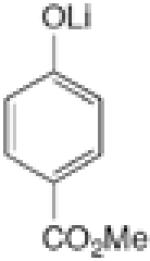
|
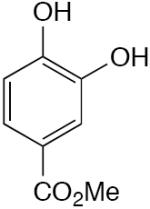
|
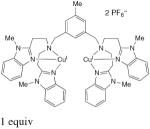
|
O2, acetone, then phenolate, −55 °C, 0.5 h | 90 | 870 |
| 2 |
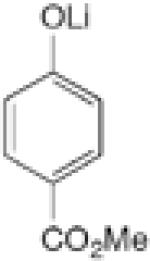
|

|

|
Ar, pH 5.1, then O2, 20 °C, 1 h | 83 | 871 |
| 3 |
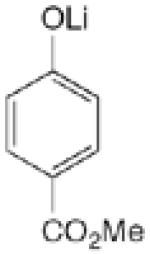
|

|

|
O2, acetone, then phenolate | 60 | 872 |
| 4 |
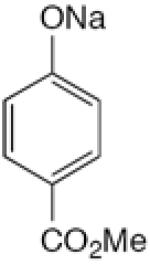
|
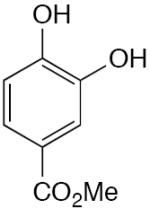
|
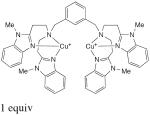
|
Ar, MeCN, 2 h, then O2, 2 h −23 °C | 37 | 873,874 |
| 5 |
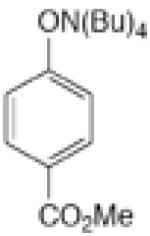
|

|
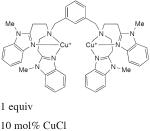
|
Ar, MeCN, 2 h, then O2, 2 h, rt | 76 | 874 |
| 6 |
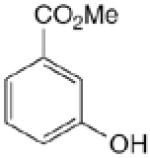
|

|
Cu0 | O2, MeCN, 50 °C | 100 | 875 |
| 7 |

|
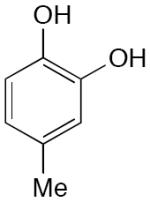
|
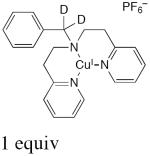
|
O2, acetone, then phenolate | 69 | 872 |
| 8 |
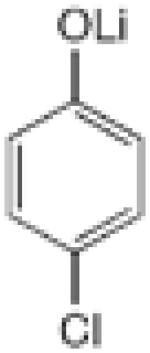
|

|
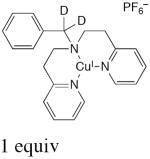
|
O2, acetone, then phenolate | 90 | 872 |
| 9 |
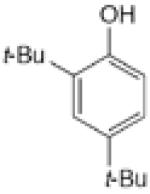
|
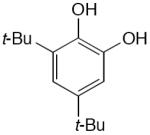
|
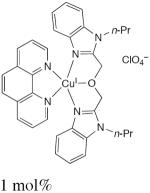
|
O2, 5:1 CH2Cl2:MeCN, rt, 14 d | 68 | 876 |
ACKNOWLEDGEMENTS
The support of the NSF (CHE-0911713, CHE-1213230) and the NIH (CA-109164) for research efforts in this area is gratefully acknowledged.
Biographies




Footnotes
The authors declare no competing financial interest.
REFERENCES
- 1).a) Sheldon RA. Chem. Ind. 1992;903 [Google Scholar]; b) Constable DJC, Dunn PJ, Hayler JD, Humphrey GR, Leazer JL, Jr., Linderman RJ, Lorenz K, Manley J, Pearlman BA, Wells A, Zaks A, Zhang TY. Green Chem. 2007;9:411. [Google Scholar]
- 2).Roduner E, Kaim W, Sarkar B, Urlacher VB, Pleiss J, Gläser R, Einicke W-D, Sprenger GA, Beifuß U, Klemm E, Liebner C, Hieronymus H, Hsu S-F, Plietker B, Sabine Laschat S. ChemCatChem. 2013;5:82. [Google Scholar]
- 3).a) Cavani F, Teles JH. ChemSusChem. 2009;2:508–534. doi: 10.1002/cssc.200900020. [DOI] [PubMed] [Google Scholar]; b) Kuppinger M, Obermüller I, Peterhans B. Chimia. 2005;59:693. [Google Scholar]
- 4).a) Roby AK, Kingsley JP. Chemtech. 1996;26:39. b) [Google Scholar]; b) Weber M. Process Safety Process. 2006;25:326. [Google Scholar]; c) Caron S, Dugger RW, Ruggeri SG, Ragan JA, Ripin DHB. Chem. Rev. 2006;106:2943. doi: 10.1021/cr040679f. [DOI] [PubMed] [Google Scholar]
- 5).Crescitelli S, Meli S, Russo G, Tufano V. J. Hazadarous Materials. 1980;3:293. [Google Scholar]
- 6).Chen J-R. Process Safety Process. 2004;23:72. [Google Scholar]
- 7).Shelley S. C&E News. 1997;104:128. one page. [Google Scholar]
- 8).a) Gläser R, Josl R, Williardt J. Topics in Catalysis. 2003;22:31. [Google Scholar]; b) Chapman AO, Akien GR, Arrowsmith NJ, Licence P, Poliakoff M. Green. Chem. 2010;12:310. [Google Scholar]
- 9).For general overviews of flow chemistry: Anderson NG. Org. Proc. Res. Dev. 2001;5:613. Roberge DA, Zimmerman B, Rainone F, Gottsponer M, Eyholzer M, Kockmann N. Org. Proc. Res. Dev. 2008;12:905.
- 10).a) Ye X, Johnson MD, Diao T, Yates MH, Stahl SS. Green Chem. 2010;12:1180. doi: 10.1039/c0gc00106f. [DOI] [PMC free article] [PubMed] [Google Scholar]; b) LaPorte TL, Hamedi M, DePue JS, Shen L, Watson D, Hsieh D. Org. Process Res. Dev. 2008;12:956. [Google Scholar]; c) Bolk JW, Westerterp KR. AIChE Journal. 1999;45:124. [Google Scholar]
- 11).a) Fischer J, Liebner C, Hieronymus H, Klemm E. Chem. Eng. Sci. 2009;64:2951. [Google Scholar]; b) Jevtic R, Ramachadran PA, Dudukovic MP. Chem. Eng. Res. Des. 2010;88:255. [Google Scholar]
- 12).a) Ge H, Chen G, Yuan Q, Li H. Catalysis Today. 2005;110:171. [Google Scholar]; b) Jähnisch K, Hessel V, Löwe H, Baerns M. Angew. Chem. Int. Ed. 2004;43:406. doi: 10.1002/anie.200300577. [DOI] [PubMed] [Google Scholar]; c) Wang N, Matsumoto T, Ueno M, Miyamura H, Kobayashi S. Angew. Chem. Int. Ed. 2009;48:4744. doi: 10.1002/anie.200900565. [DOI] [PubMed] [Google Scholar]
- 13).Lapkin AA, Bokaya B, Plucinski PK. Ind. Eng. Chem. Res. 2006;45:2220. [Google Scholar]
- 14).Kozlowski MC. In: Reactive Intermediates in Chemistry and Biology. Copper-Oxygen Chemistry. Rokita Steven E., Karlin Kenneth D., Itoh Shinobu., editors. Wiley; 2011. [Google Scholar]
- 15).Wendlandt AE, Suess AM, Stahl SS. Angew. Chem. Int. Ed. 2011;50:11062. doi: 10.1002/anie.201103945. [DOI] [PubMed] [Google Scholar]
- 16).(a) Punniyamurthy T, Velusamy S, Iqbal J. Chem. Rev. 2005;105:2329. doi: 10.1021/cr050523v. [DOI] [PubMed] [Google Scholar]; (b) Punniyamurthy T, Rout L. Coord. Chem. Rev. 2008;252:134. [Google Scholar]; (c) Hayashi M, Kawabata H. Adv. Chem. Res. 2006;1:45. [Google Scholar]
- 17).(a) van Eldik R, Reedijk J, editors. Advances in Organic Chemistry, Volume 58: Homogeneous Biomimetic Oxidation Catalysts. Elsevier; Amsterdam: 2006. [Google Scholar]; (b) Mijs WJ. In: Organic Syntheses by Oxidation with Metal Compounds. de Jonge CRHI, editor. Plenum Press; New York: 1986. [Google Scholar]; (c) Sheldon RA, Kochi JK. Metal-Catalyzed Oxidations of Organic Compounds. Academic Press; New York: 1981. [Google Scholar]; (d) Trahnovsky WS, editor. Oxidation in Organic Chemistry, Part B. Academic Press; New York: 1973. [Google Scholar]
- 18).Song X, She Y, Ji H, Zhang Y. Org. Process Res. Dev. 2005;9:297. [Google Scholar]
- 19).Zhao X, Kong A, Shan C, Wang P, Zhang X, Shan Y. Catal. Lett. 2009;131:526. [Google Scholar]
- 20).Allara DL. J. Org. Chem. 1972;37:2448. [Google Scholar]
- 21).Sprecher CA, Zuberbühler AD. Angew. Chem. Int. Ed. Engl. 1977;16:189. doi: 10.1002/anie.197701891. [DOI] [PubMed] [Google Scholar]
- 22).Urbach FL, Knopp U, Zuberbühler AD. Helv. Chim. Acta. 1978;61:1097. [Google Scholar]
- 23).Dhakshinamoorthy A, Alvaro M, Garcia H. J. Catal. 2009;267:1. [Google Scholar]
- 24).(a) Klinman JP. Chem. Rev. 1996;96:2541–2561. doi: 10.1021/cr950047g. [DOI] [PubMed] [Google Scholar]; (b) Klinman JP. J. Biol. Chem. 2006;281:3013. doi: 10.1074/jbc.R500011200. [DOI] [PubMed] [Google Scholar]
- 25).Lucas HR, Li L, Sarjeant AAN, Vance MA, Solomon EI, Karlin KD. J. Am. Chem. Soc. 2009;131:3230. doi: 10.1021/ja807081d. [DOI] [PMC free article] [PubMed] [Google Scholar]
- 26).Würtele C, Sander O, Lutz V, Waitz T, Tuczek F, Schindler S. J. Am. Chem. Soc. 2009;131:7544. doi: 10.1021/ja902327s. [DOI] [PubMed] [Google Scholar]
- 27).Andersson SLT. J. Chem. Soc., Faraday Trans. 1992;88:83. [Google Scholar]
- 28).Rudler H, Denise B. J. Mol. Catal. A: Chem. 2000;154:277. [Google Scholar]
- 29).Stec Z, Kulicki Z. Pol. J. Chem. 1983;57:941. [Google Scholar]
- 30).Orlinska B. Tetrahedron Lett. 2010;51:4100. [Google Scholar]
- 31).Gardner LE. US 4208352. 1975. p. 6. [Google Scholar]
- 32).Weber M, Weber M, Kleine-Boymann M. Ullmann's Encyclopedia of Industrial Chemistry. 6th ed. Vol. 26. Wiley-VCH Verlag GmbH & Co. KGaA: Weinheim; Germany: 2004. p. 503. [Google Scholar]
- 33).Hsu YF, Yen MH, Cheng CP. J. Mol. Cat. A: Chem. 1996;105:137. [Google Scholar]
- 34).(a) Komiya N, Naota T, Murahashi S-I. Tetrahedron Lett. 1996;37:1633. [Google Scholar]; (b) Komiya N, Naota T, Oda Y, Murahashi S-I. J. Mol. Catal. A: Chem. 1997;117:21. [Google Scholar]; (c) Murahashi S-I, Komiya N, Hayashi Y, Kumano T. Pure Appl.Chem. 2001;73:311. [Google Scholar]
- 35).Costas M, Llobet A. J. Mol. Catal. A: Chem. 1999;142:113. [Google Scholar]
- 36).Navarro M, Escobar A, Landaeta VR, Visbal G, Lopez-Linares F, Luis ML, Fuentes A. Appl. Catal., A. 2009;363:27. [Google Scholar]
- 37).Llabres i Xamena FX, Casanova O, Tailleur RG, Garcia H, Corma A. J. Catal. 2008;255:220. [Google Scholar]
- 38).Small RJ. US 4960944. 1990. p. 5. [Google Scholar]
- 39).Coltrin ME, Wu Y. US 4202992. 1980. p. 5. [Google Scholar]
- 40).Coltrin ME, Wu Y. US 4269734. 1981. p. 6. [Google Scholar]
- 41).Orlinska BJ, Zawadiak JM. Cent. Eur. J. Chem. 2010;8:285. [Google Scholar]
- 42).Murahashi S-I, Komiya N, Hayashi Y. Eur. Pat. Appl. 2002:7. EP1174410. [Google Scholar]
- 43).Zhang Q, Chen C, Xu J, Wang F, Gao J, Xia C. Adv. Synth. Catal. 2011;353:226. [Google Scholar]
- 44).Zhang L, Ang GY, Chiba S. Org. Lett. 2011;13:1622. doi: 10.1021/ol200425c. [DOI] [PubMed] [Google Scholar]
- 45).For recent ammoxidation reviews see: Martin A, Kalevaru VN. ChemCatChem. 2010;2:1504. Lücke B, Narayana KV, Martin A, Jähnisch K. Adv. Synth. Catal. 2004;346:1407. Grasselli RK. Catal. Today. 1999;49:141.
- 46).Pollak P, Romeder G, Hagedorn F, Gelbke H-P. Ullmann's Encyclopedia of Industrial Chemistry. 6th ed. Vol. 24. Wiley-VCH Verlag GmbH & Co. KGaA: Weinheim; Germany: 2000. p. 251. [Google Scholar]
- 47).Fu J, Ferino I, Monci R, Rombi E, Solinas V, Fornib L. Appl. Catal., A. 1997;154:241. [Google Scholar]
- 48).Beschmann K, Riekert L. Chem. Ing. Tech. 1993;65:1231. [Google Scholar]
- 49).Kim SH, Chon H. Appl. Catal. A: Gen. 1992;85:47. [Google Scholar]
- 50).Musser MT. Ullmann's Encyclopedia of Industrial Chemistry. 6th ed. Vol. 11. Wiley-VCH Verlag GmbH & Co. KGaA: Weinheim; Germany: 2011. p. 49. [Google Scholar]
- 51).Barton DHR, Beviere SD, Hill DR. Tetrahedron. 1994;50:2665. [Google Scholar]
- 52).Schuchardt U, Pereira R, Rufo M. J. Mol. Catal. A: Chem. 1998;135:257. [Google Scholar]
- 53).Murahashi S-I, Oda Y, Naota T, Komiya N. J. Chem. Soc., Chem. Commun. 1993:139. [Google Scholar]
- 54).Glatz G, Schmalz T, Kraus T, Haarmann F, Motz G, Kempe R. Chem. Eur. J. 2010;16:4231. doi: 10.1002/chem.200902836. [DOI] [PubMed] [Google Scholar]
- 55).Evangelisti C, Vitulli G, Schiavi E, Vitulli M, Bertozzi S, Salvadori P, Bertinetti L, Martra G. Catal. Lett. 2007;116:57. [Google Scholar]
- 56).Balandina TA, Larina T. Yu., Kuznetsova NI, Bal'zhinimaev BS. Kinet. Catal. 2008;49:499. [Google Scholar]
- 57).(a) Shul'pin GB, Nizova GV. Petrol. Chem. 1993;33:107. [Google Scholar]; (b) Shul'pin GB, Bochkova MM, Nizova GV. J. Chem. Soc., Perkin Trans. 1995;2:1465. [Google Scholar]; (c) Takaki K, Yamamoto J, Matsushita Y, Morii H, Shishido T, Takehira K. Bull. Chem. Soc. Jpn. 2003;76:393. [Google Scholar]; (d) Takaki K, Yamamoto J, Komeyama K, Kawabata T, Takehira K. Bull. Chem. Soc. Jpn. 2004;77:2251. [Google Scholar]
- 58).Li Y, Wu M, Liu W, Yi Z, Zhang J. Catal. Lett. 2008;123:123. [Google Scholar]
- 59).Markó IE, Gautier A, Chellé-Regnaut I, Giles PR, Tsukazaki M, Urch CJ, Brown SM. J. Org. Chem. 1998;63:7576. [Google Scholar]
- 60).Kurusu Y, Neckers DC. J. Org. Chem. 1991;56:1981. [Google Scholar]
- 61).Karandikar P, Chandwadkar AJ, Agashe M, Ramgir NS, Sivasanker S. Appl. Catal., A. 2006;297:220. [Google Scholar]
- 62).Kopylovich MN, Nunes ACC, Mahmudov KT, Haukka M, Mac Leod TCO, Martins LMDRS, Kuznetsov ML, Pombeiro JL. Dalton Trans. 2011;40:2822. doi: 10.1039/c0dt01527j. [DOI] [PubMed] [Google Scholar]
- 63).(a) Schönecker B, Lange C, Zheldakova T, Günther W, Görls H, Vaughan G. Tetrahedron. 2005;61:103. [Google Scholar]; (b) Schönecker B, Zheldakova T, Liu Y, Kötteritzsch M, Günther W, Görls H. Angew. Chem. Int. Ed. 2003;42:3240. doi: 10.1002/anie.200250815. [DOI] [PubMed] [Google Scholar]; (c) Schönecker B, Zheldakova T, Lange C, Güunther W, Görls H, Bohl M. Chem. Eur. J. 2004;10:6029. doi: 10.1002/chem.200306054. [DOI] [PubMed] [Google Scholar]
- 64).Groothaert MH, Smeets PJ, Sels BF, Jacobs PA, Schoonheydt RA. J. Am. Chem. Soc. 2005;127:1394. doi: 10.1021/ja047158u. [DOI] [PubMed] [Google Scholar]
- 65).(a) Murphy EF, Mallat T, Baiker A. Catal. Today. 2000;57:115–126. [Google Scholar]; (b) Muzart J. Bull. Soc. Chim. Fr. 1986;1:65. [Google Scholar]
- 66).Arntz D, Fischer A, Höpp M, Jacobi S, Sauer J, Ohara T, Sato T, Shimizu N, Schwind H. In Ullmann's Encyclopedia of Industrial Chemistry. 6th ed. Vol. 1. Wiley-VCH Verlag GmbH & Co. KGaA: Weinheim; Germany: 2007. p. 329. [Google Scholar]
- 67).Wood BJ, Wise H, Yolles RS. J. Catal. 1969;15:355. [Google Scholar]
- 68).Inui T, Ueda T, Suehiro M. J. Catal. 1980;65:166. [Google Scholar]
- 69).Tüysüz H, Galilea JL, Schüth F. Catal. Lett. 2009;131:49. [Google Scholar]
- 70).Pozzi G, Cavazzini M, Quici S. Tetrahedron Lett. 1997;38:7605. [Google Scholar]
- 71).Contel M, Izuel C, Laguna M, Villuendas PR, Alonso PJ, Fish RH. Chem. Eur. J. 2003;9:4168. doi: 10.1002/chem.200304771. [DOI] [PubMed] [Google Scholar]
- 72).Malumbazo N, Mapolie SF. J. Mol. Catal. A: Chem. 2009;312:70. [Google Scholar]
- 73).Bownstein AM, Kerr DL. US 4028423. 1970. p. 4. [Google Scholar]
- 74).Nobumasa Kitajima N, Koda T, Iwata Y, Moro-oka Y. J. Am. Chem. Soc. 1990;112:8833. [Google Scholar]
- 75).Yun X, Hu X, Jin Z, Hu J, Yan C, Yao J, Li H. J. Mol. Catal. A: Chem. 2010;327:25. [Google Scholar]
- 76).Chang Y, Lv Y, Lu F, Zha F, Lei Z. J. Mol. Catal. A: Chem. 2010;320:56. [Google Scholar]
- 77).Jiang D, Mallat T, Meier D, Urakawa A, Baiker A. J. Catal. 2010;270:26. [Google Scholar]
- 78).Larock RC. Comprehensive Organic Transformations. VCH Publishers; New York: 1989. [Google Scholar]
- 79).Biologically inspired catalysts: Himes RA, Karlin KD. Curr. Opin. Chem. Biol. 2009;13:119. doi: 10.1016/j.cbpa.2009.02.025. van der Vlugt JI, Meryer F. Top. Organomet. Chem. 2007;22:191. Cramer CJ, Tolman WB. Acc. Chem. Res. 2007;40:601. doi: 10.1021/ar700008c. Chaudhuri P, Wieghardt K, Weyhermüller T, Paine TK, Mukherjee S, Mukherjee C. Biol. Chem. 2005;386:1023. doi: 10.1515/BC.2005.118. Mirica LM, Ottenwaelder X, Stack TDP. Chem. Rev. 2004;104:1013. doi: 10.1021/cr020632z. Kim E, Chufan EE, Kamaraj K, Karlin KD. Chem. Rev. 2004;104:1077. doi: 10.1021/cr0206162. Zhang CX, Liang H-C, Humphreys KJ, Karlin KD. Catal. Met. Complexes. 2003;26:79.
- 80).Vaughan OPH, Kyriakou G, Macleod N, Tikhov M, Lambert RM. J. Catal. 2005;236:401. [Google Scholar]
- 81).(a) Chu H, Yang L, Zhang Q, Wang Y. J. Catal. 2006;241:225–228. [Google Scholar]; (b) Wang Y, Chu H, Zhu W, Zhang Q. Catal. Today. 2008;131:496. [Google Scholar]
- 82).(a) Zhu W, Zhang Q, Wang Y. J. Phys. Chem. C. 2008;112:7731–7734. [Google Scholar]; (b) Su W, Wang S, Ying P, Feng Z, Li C. J. Catal. 2009;268:165. [Google Scholar]
- 83).Chisem J, Chisem IC, Rafelt JS, Macquarrie DJ, Clark JH. Chem. Commun. 1997:2203. [Google Scholar]
- 84).Karandikar P, Agashe M, Vijayamohanan K, Chandwadkar AJ. Appl. Cat. A. 2004;257:133. [Google Scholar]
- 85).Gerbeleu NV, Palanciuc SS, Simonov Yu. A., Dvorkin AA, Bourosh PN, Reetz MT, Arion VB, Töllner K. Polyhedron. 1995;14:521. [Google Scholar]
- 86).Meng X, Lin K, Yang X, Sun Z, Jiang D, Xiao F-S. J. Catal. 2003;218:460. [Google Scholar]
- 87).a) Cowell JJ, Santra AK, Lindsay R, Lambert RM, Baralki A, Goldoni A. Surf. Sci. 1999;437:1. [Google Scholar]; b) Cowell JJ, Santra AK, Lambert RM. J. Am. Chem. Soc. 2000;122:2381. [Google Scholar]; c) Santra AK, Cowell JJ, Lambert RM. Catal. Lett. 2000;67:87. [Google Scholar]; Cropley RL, Williams FJ, Urquhart AJ, Vaughan OPH, Tikhov MS, Lambert RM. J. Am. Chem. Soc. 2005;127:6069. doi: 10.1021/ja042758e. [DOI] [PubMed] [Google Scholar]; e) Cropley RL, Williams FJ, Vaughan OPH, Urquhart AJ, Tikhov MS, Lambert RM. Surf. Sci. 2005;578:85. [Google Scholar]
- 88).Rousselet G, Chassagnard C, Capdevielle P, Maumy M. Tetrahedron Lett. 1996;37:8497. [Google Scholar]
- 89).Petrov LV, Solyanikov VM. Neftekhimiya. 2001;41:449. [Google Scholar]
- 90).Bewick A, Mellor JM, Milano D, Owton WM. J. Chem. Soc., Perkin Trans. 1985;1:1045. [Google Scholar]
- 91).Taniguchi N. J. Org. Chem. 2006;71:7874. doi: 10.1021/jo060834l. [DOI] [PubMed] [Google Scholar]
- 92).Taniguchi N. Synlett. 2011;9:1308. [Google Scholar]
- 93).Raja R, Ratnasamy P. J. Catal. 1997;170:244. [Google Scholar]
- 94).Yang L, Lu Z, Stahl SS. Chem. Commun. 2009:6460. doi: 10.1039/b915487f. [DOI] [PubMed] [Google Scholar]
- 95).Chemler SR. Org. Biomol. Chem. 2009;7:3009. doi: 10.1039/B907743J. [DOI] [PMC free article] [PubMed] [Google Scholar]
- 96).Paderes MC, Chemler SR. Org. Lett. 2009;11:1915. doi: 10.1021/ol9003492. [DOI] [PMC free article] [PubMed] [Google Scholar]
- 97).Paderes MC, Chemler SR. Eur. J. Org. Chem. 2011:3679. doi: 10.1002/ejoc.201100444. [DOI] [PMC free article] [PubMed] [Google Scholar]
- 98).Fuller PH, Kim J-W, Chemler SR. J. Am. Chem. Soc. 2008;130:17638. doi: 10.1021/ja806585m. [DOI] [PMC free article] [PubMed] [Google Scholar]
- 99).Huang L, Jiang H, Qi C, Liu X. J. Am. Chem. Soc. 2010;132:17652. doi: 10.1021/ja108073k. [DOI] [PubMed] [Google Scholar]
- 100).Toh KK, Wang Y-F, Ng EPJ. J. Am. Chem. Soc. 2011;133:13942. doi: 10.1021/ja206580j. [DOI] [PubMed] [Google Scholar]
- 101).Wang H, Wang Y, Liang D, Liu L, Zhang J, Zhu Q. Angew. Chem. Int. Ed. 2011;50:5678. doi: 10.1002/anie.201100362. [DOI] [PubMed] [Google Scholar]
- 102).Lu J, Jin Y, Liu H, Jiang Y, Fu H. Org. Lett. 2011;13:3694. doi: 10.1021/ol2013395. [DOI] [PubMed] [Google Scholar]
- 103).Mamalis IN, Grandjean J, Noels AF, Puentes E, Waddan D, Hubert AJ, Teyssie P. Catal. Today. 1987;1:59. [Google Scholar]
- 104).Mamalis I, Noels AF, Tihange G, Warin R, Teyssie P. J. Mol. Catal. 1988;45:327. [Google Scholar]
- 105).Waddan DY, Puentes E, Noels AF, Warin R, Hubert AJ, Teyssie P. J. Catal. 1989;116:415. [Google Scholar]
- 106).Sakaguchi S, Takase T, Iwahama T, Ishii Y. Chem. Commun. 1998:2037. [Google Scholar]
- 107).Cadiot W. In: Chemistry of Acetylenes. Viehe HG, editor. Dekker; New York: 1969. p. 597. [Google Scholar]
- 108).Siemsen P, Livingston RC, Diederich F. Angew. Chem. Int. Ed. 2000;39:2632. [PubMed] [Google Scholar]
- 109).Stefani HA, Guarezemini AS, Cella R. Tetrahedron. 2010;66:7871. [Google Scholar]
- 110).Glaser C. Ber. Dtsch. Chem. Ges. 1869;2:422. [Google Scholar]
- 111).a) Eglinton G, Galbraith AR. Chem. Ind. 1956:737. [Google Scholar]; b) Eglington G, Galbraith AR. J. Chem. Soc. 1959:889. [Google Scholar]
- 112).(a) Hay AS. J. Org. Chem. 1960;25:1275–1276. [Google Scholar]; (b) Hay AS. J. Org. Chem. 1962;27:3320. [Google Scholar]
- 113).Jones GE, Kendrick DA, Holmes AB. Org. Syn. Coll. Vol. 1993;8:63. [Google Scholar]
- 114).Adimurthy S, Malakar CC, Beifuss U. J. Org. Chem. 2009;74:5648. doi: 10.1021/jo900246z.. For a later, related study see: Zhang S, Liu X, Wang T. Adv. Synth. Catal. 2011;353:1463..
- 115).Yin W, He C, Chen M, Zhang H, Lei A. Org. Lett. 2009;11:709. doi: 10.1021/ol8027863. [DOI] [PubMed] [Google Scholar]
- 116).Selected examples from recent reports using a Ni/Cu system: Bedard A-C, Collins SK. J. Am. Chem. Soc. 2011;133:19976. doi: 10.1021/ja208902t.. Crowley JD, Goldup SM, Gowans ND, Leigh DA, Ronaldson VE, Slawin AMZ. J. Am. Chem. Soc. 2010;132:6243. doi: 10.1021/ja101121j.. Muesmann TWT, Wickleder MS, Christoffers J. Synthesis. 2011;17:2775..
- 117).Meng X, Li C, Han B, Wang T, Chen B. Tetrahedron. 2010;66:4029. [Google Scholar]
- 118).Selected examples from recent reports using a Pd/Cu system: Li J-H, Liang Y, Xie Y-X. J. Org. Chem. 2005;70:4393. doi: 10.1021/jo0503310.. Batsanov AS, Collings JC, Fairlamb IJS, Holland JP, Howard JAK, Lin Z, Marder TB, Parsons AC, Ward RM, Zhu J. J. Org. Chem. 2005;70:703. doi: 10.1021/jo048428u.. Merkul E, Urselmann D, Müller TJJ. Eur. J. Org. Chem. 2011:238.. Hoshi M, Okimoto M, Nakamura S, Takahashi S. Synthesis. 2011;23:3839..
- 119).Zheng Q, Hua R, Wan Y. Appl. Organomet. Chem. 2010;24:314. [Google Scholar]
- 120).Wang D, Li J, Li N, Gao T, Hou S, Chen B. Green Chem. 2010;12:45. [Google Scholar]
- 121).Li Y-N, Wang J-L, He L-N. Tetrahedron Lett. 2011;52:3485. [Google Scholar]
- 122).Yadav JS, Reddy BVS, Reddy KB, Gayathri KU, Prasad AR. Tetrahedron Lett. 2003;44:6493. [Google Scholar]
- 123).Oishi T, Katayama T, Yamaguchi K, Mizuno N. Chem. Eur. J. 2009;15:7539. doi: 10.1002/chem.200901080. [DOI] [PubMed] [Google Scholar]
- 124).(a) Kuhn P, Alix A, Kumarraja M, Louis B, Pale P, Sommer J. Eur. J. Org. Chem. 2009:423. [Google Scholar]; (b) Kuhn P, Pale P, Sommer J, Louis B. J. Phys. Chem. C. 2009;113:2903. [Google Scholar]; (c) Chassaing S, Alix A, Boningari T, Sido KSS, Keller M, Kuhn P, Louis B, Sommer J, Pale P. Synthesis. 2010:1557. [Google Scholar]
- 125).Yamaguchi K, Kamata K, Yamaguchi S, Kotani M, Mizuno N. J. Catal. 2008;258:121. [Google Scholar]
- 126).(a) Schmidt R, Thorwirth R, Szuppa T, Stolle A, Ondruschka B, Hopf H. Chem. Eur. J. 2011;17:8129. doi: 10.1002/chem.201100604. [DOI] [PubMed] [Google Scholar]; (b) Stolle A, Ondruschka B. Pure Appl. Chem. 2011;83:1343. [Google Scholar]
- 127).Yamaguchi M, Park H-J, Hirama M, Torisu K, Nakamura S, Minami T, Nishihara H, Hiraoka T. Bull. Chem. Soc. Jpn. 1994;67:1717. [Google Scholar]
- 128).For select reviews see: Diederich F. Chem. Commun. 2001:219.. Nielsen MB, Diederich F. Synlett. 2002:544.. Zhao D, Moore JS. Chem. Commun. 2003:807. doi: 10.1039/b207442g.. Kim S. Angew. Chem. Int. Ed. 2009;48:7740. doi: 10.1002/anie.200904145..
- 129).Tykwinski RR, Zhao Y. Synlett. 2002:1939. [Google Scholar]
- 130).(a) Chalifoux WA, McDonald R, Ferguson MJ, Tykwinski RR. Angew. Chem. Int. Ed. 2009;48:7915. doi: 10.1002/anie.200902760. [DOI] [PubMed] [Google Scholar]; (b) Tykwinski RR, Chalifoux W, Eisler S, Lucotti A, Tommasini M, Fazzi D, Zoppo MD, Zerbi G. Pure Appl. Chem. 2010;82:891. [Google Scholar]; (c) Chalifoux WA, Tykwinski RR. Chimie. 2009;12:341. [Google Scholar]
- 131).Nielsen MB. Lett. Org. Chem. 2006;3:3–9. and references therein. [Google Scholar]
- 132).(a) Nielsen MB, Utesch NF, Moonen NNP, Boudon C, Gisselbrecht J-P, Concilio S, Piotto SP, Seiler P, Günter P, Gross M, Diederich F. Chem. Eur. J. 2002;8:3601. doi: 10.1002/1521-3765(20020816)8:16<3601::AID-CHEM3601>3.0.CO;2-N. [DOI] [PubMed] [Google Scholar]; (b) Nielsen MB, Moonen NNP, Boudon C, Gisselbrecht J-P, Seiler P, Gross M, Diederich F. Chem. Commun. 2001:1848. [PubMed] [Google Scholar]; (c) Andersson AS, Kilsa K, Hassenkam T, Gisselbrecht J-P, Boudon C, Gross M, Nielsen MB, Diederich F. Chem. Eur. J. 2006;12:8451. doi: 10.1002/chem.200600986. [DOI] [PubMed] [Google Scholar]
- 133).Maraval V, Chauvin R. Chem. Rev. 2006;106:5317. doi: 10.1021/cr050964e. [DOI] [PubMed] [Google Scholar]
- 134).Bähr A, Droz AS, Püntener M, Neidlein U, Anderson S, Seiler P, Diederich F. Helv. Chim. Acta. 1998;81:1931. [Google Scholar]
- 135).McCallien DWJ, Sanders JKM. J. Am. Chem. Soc. 1995;117:6611. [Google Scholar]
- 136).Zhao Y, Campbell K, Tykwinski RR. J. Org. Chem. 2002;67:336. doi: 10.1021/jo015810n. [DOI] [PubMed] [Google Scholar]
- 137).Campbell K, McDonald R, Ferguson MJ, Tykwinski RR. Organometallics. 2003;22:1353. [Google Scholar]
- 138).Gallagher ME, Anthony JE. Tetrahedron Lett. 2001;42:7533. [Google Scholar]
- 139).Bunz UHF. Synlett. 1997:1117. [Google Scholar]
- 140).Moritz BC, Johannes H, Mecking S. J. Am. Chem. Soc. 2009;131:14267. doi: 10.1021/ja905077c. [DOI] [PubMed] [Google Scholar]
- 141).Nielsen MB, Diederich F. Chem. Rec. 2002;2:189. doi: 10.1002/tcr.10022. [DOI] [PubMed] [Google Scholar]
- 142).Martin RE, Gubler U, Boudon C, Bosshard C, Gisselbrecht J-P, Günter P, Gross M, Diederich F. Chem. Eur. J. 2000;6:4400. doi: 10.1002/1521-3765(20001201)6:23<4400::aid-chem4400>3.0.co;2-a. [DOI] [PubMed] [Google Scholar]
- 143).Siemsen P, Gubler U, Bosshard C, Günter P, Diederich F. Chem. Eur. J. 2001;7:1333. doi: 10.1002/1521-3765(20010316)7:6<1333::aid-chem1333>3.0.co;2-9. [DOI] [PubMed] [Google Scholar]
- 144).Morgan BJ, Xie X, Phuan P-W, Kozlowski MC. J. Org. Chem. 2007;72:6171. doi: 10.1021/jo070636+. [DOI] [PubMed] [Google Scholar]
- 145).Ding L, Olesik SV. Chem. Mater. 2005;17:2353. [Google Scholar]
- 146).Rougeau L, Picq D, Rastello M, Frantz Y. Tetrahedron. 2008;64:9430. [Google Scholar]
- 147).Sathyamoorthy B, Axelrod A, Farwell V, Bennett SM, Calitree BD, Benedict JB, Sukumaran DK, Detty MR. Organometallics. 2010;29:3431. [Google Scholar]
- 148).Deschamps J, Balog M, Boury B, Yahia MB, Filhol J-S, van der Lee A, Choueiry AA, Barisien T, Legrand L, Schot M, Dutremez SG. Chem. Mater. 2010;22:3961. [Google Scholar]
- 149).(a) Rodriguez D, Castedo L, Saa C. Synlett. 2004:377. [Google Scholar]; (b) Martinez-Esperon MF, Rodriguez D, Castedo L, Saa C. Tetrahedron. 2006;62:3843. [Google Scholar]
- 150).Lee AWM, Yeung ABW, Yuen MSM, Zhang H, Zhao X, Wong WY. Chem. Commun. 2000:75. [Google Scholar]
- 151).van Assema SGA, de Jong GB, Ehlers AW, de Kanter FJJ, Schakel M, Spek AL, Lutz M, Lammertsma K. Eur. J. Org. Chem. 2007:2405. [Google Scholar]
- 152).de Meijere A, Kozhushkov SI. Chem. Eur. J. 2002;8:3195. doi: 10.1002/1521-3765(20020715)8:14<3195::AID-CHEM3195>3.0.CO;2-J. [DOI] [PubMed] [Google Scholar]
- 153).Umezawa H, Okada S, Oikawa H, Matsuda H, Nakanishi H. J. Phys. Org. Chem. 2005;18:468. [Google Scholar]
- 154).Matsuo H, Okada S, Nakanishi H, Matsuda H, Takaragi S. Polym. J. 2002;34:825. [Google Scholar]
- 155).Tykwinski RR, Kendall J, McDonald R. Synlett. 2009:2068. [Google Scholar]
- 156).Chalifoux WA, Tykwinski RR. Nat. Chem. 2010;2:967. doi: 10.1038/nchem.828. [DOI] [PubMed] [Google Scholar]
- 157).Baier M, Gleiter R, Rominger F. Eur. J. Org. Chem. 2006:5264. [Google Scholar]
- 158).Klyatskaya SV, Tretyakov EV, Vasilevsky SF. Russ. Chem. Bull. 2001;50:868. [Google Scholar]
- 159).Mössinger D, Jester S-S, Sigmund E, Müller U, Höger S. Macromolecules. 2009;42:7974. [Google Scholar]
- 160).Nierengarten J-F, Gu T, Hadziioannou G, Tsamouras D, Krasnikov V. Helv. Chim. Acta. 2004;87:2948. [Google Scholar]
- 161).Vestergaard M, Jennum K, Sørensen JK, Kilsa K, Nielsen MB. J. Org. Chem. 2008;73:3175. doi: 10.1021/jo702735d. [DOI] [PubMed] [Google Scholar]
- 162).(a) Zhou N, Zhao Y. J. Org. Chem. 2010;75:1498. doi: 10.1021/jo9021748. [DOI] [PubMed] [Google Scholar]; (b) Zhou N, Merschrod S. EF, Zhao Y. J. Am. Chem. Soc. 2005;127:14154. doi: 10.1021/ja054669n. [DOI] [PubMed] [Google Scholar]
- 163).Morisaki Y, Chujo Y. Polym. Bull. 2002;49:209. [Google Scholar]
- 164).Tobe Y, Utsumi N, Kawabata K, Nagano A, Adachi K, Araki S, Sonoda M, Hirose K, Naemura K. J. Am. Chem. Soc. 2002;124:5350. doi: 10.1021/ja012458m. [DOI] [PubMed] [Google Scholar]
- 165).Wettach H, Höger S, Chaudhuri D, Lupton JM, Liu F, Lupton EM, Tretiak S, Wang G, Li M, Feyter SD, Fischer S, Förster S. J. Mater. Chem. 2011;21:1404. [Google Scholar]
- 166).Baytekin B, Zhu SS, Brusilowskij B, Illigen J, Ranta J, Huuskonen J, Russo L, Rissanen K, Kaufmann L, Schalley CA. Chem. Eur. J. 2008;14:10012. doi: 10.1002/chem.200801289. [DOI] [PubMed] [Google Scholar]
- 167).(a) Droz AS, Diederich F. J. Chem. Soc., Perkin Trans. 1. 2000:4224. [Google Scholar]; (b) Bähr A, Felber B, Schneider K, Diederich F. Helv. Chim. Acta. 2000;83:1346. [Google Scholar]; (c) Droz AS, Neidlein U, Anderson S, Seiler P, Deiderich F. Helv. Chim. Acta. 2001;84:2243. [Google Scholar]
- 168).Lehnherr D, Murray AH, McDonald R, Tykwinski RR. Angew. Chem. Int. Ed. 2010;49:6190. doi: 10.1002/anie.201000555. [DOI] [PubMed] [Google Scholar]
- 169).Costa AI, Prata JV. Supramol. Chem. 2008;20:95. [Google Scholar]
- 170).(a) Morisaki F, Kurono M, Hirai K, Tomioka H. Org. Biomol. Chem. 2005;3:431. doi: 10.1039/b409095k. [DOI] [PubMed] [Google Scholar]; (b) Itoh T, Morisaki F, Hirai K, Tomioka H. J. Org. Chem. 2004;69:5870. doi: 10.1021/jo0494026. [DOI] [PubMed] [Google Scholar]
- 171).(a) Baxter PNW, Dali-Youcef R. J. Org. Chem. 2005;70:4935. doi: 10.1021/jo040276f. [DOI] [PubMed] [Google Scholar]; (b) Baxter PNW. J. Org. Chem. 2001;66:4170. doi: 10.1021/jo001777d. [DOI] [PubMed] [Google Scholar]
- 172).Tobe Y, Nagano A, Kawabata K, Sonoda M, Maemura K. Org. Lett. 2000;2:3265. doi: 10.1021/ol006318d. [DOI] [PubMed] [Google Scholar]
- 173).(a) Zhao Y, McDonald R, Tykwinski RR. J. Org. Chem. 2002;67:2805. doi: 10.1021/jo015995y. [DOI] [PubMed] [Google Scholar]; (b) Zhao Y, McDonald R, Tykwinski RR. Chem. Commun. 2000:77. [Google Scholar]
- 174).Zhao Y, Ciulei SC, Tykwinski RR. Tetrahedron Lett. 2001;42:7721. [Google Scholar]
- 175).Eisler S, McDonald R, Loppnow GR, Tykwinksi RR. J. Am. Chem. Soc. 2000;122:6917. [Google Scholar]
- 176).Nielsen MB, Schreiber M, Baek YG, Seiler P, Lecomte S, Boudon C, Tykwinski RR, Gisselbrecht J-P, Gramlich V, Skinner PJ, Bosshard C, Günter P, Gross M, Diederich F. Chem. Eur. J. 2001;7:3263. doi: 10.1002/1521-3765(20010803)7:15<3263::aid-chem3263>3.0.co;2-3. [DOI] [PubMed] [Google Scholar]
- 177).Moonen NNP, Pomerantz WC, Gist R, Boudon C, Gisselbrecht J-P, Kawai Y, Kishioka A, Gross M, Irie M, Diederich F. Chem. Eur. J. 2005;11:3325. doi: 10.1002/chem.200500082. [DOI] [PubMed] [Google Scholar]
- 178).Ryhding T, Petersen MA, Kilsa K, Nielsen MB. Synlett. 2007:913. [Google Scholar]
- 179).Ringenbach C, Nicola AD, Ziessel R. J. Org. Chem. 2003;68:4708. doi: 10.1021/jo020679k. [DOI] [PubMed] [Google Scholar]
- 180).Odermatt S, Alonso-Gomez JL, Seiler P, Cid MM, Diederich F. Angew. Chem. Int. Ed. 2005;44:5074. doi: 10.1002/anie.200501621. [DOI] [PubMed] [Google Scholar]
- 181).Takayama Y, Delas C, Muraoka K, Uemura M, Sato F. J. Am. Chem. Soc. 2003;125:14163. doi: 10.1021/ja037975e. [DOI] [PubMed] [Google Scholar]
- 182).Burri E, Diederich F, Nielsen MB. Helv. Chim. Acta. 2001;84:2169. [Google Scholar]
- 183).Tobe Y, Umeda R, Iwasa N, Sonoda M. Chem. Eur. J. 2003;9:5549. doi: 10.1002/chem.200305051. [DOI] [PubMed] [Google Scholar]
- 184).Shanks D, Preus S, Qvortrup K, Hassenkam T, Nielsen MB, Kilsa K. New J. Chem. 2009;33:507. [Google Scholar]
- 185).Sae-Lim C, Sandman DJ, Foxman BM, Sukwattanasinitt M. J. Macromol. Sci., Part A: Pure Appl. Chem. 2006;43:1929. [Google Scholar]
- 186).Callahan JF, Khatana SS, Bhatnagar PK. Synth. Commun. 2000;30:1213. [Google Scholar]
- 187).Vasilevsky SF, Klyatskaya SV, Tretyakov JE, Elguero J. Heterocycles. 2003;60:879. [Google Scholar]
- 188).Hocek M, Votruba I. Bioorg. Med. Chem. Lett. 2002;12:1055. doi: 10.1016/s0960-894x(02)00077-x. [DOI] [PubMed] [Google Scholar]
- 189).Wu Y-M, Deng J, Chen Q-Y. Synlett. 2006:645. [Google Scholar]
- 190).Vyazmin SY, Berezina SE, Remizova LA, Domnin IN, Gleiter R. Russ. J. Org. Chem. 2002;38:775. [Google Scholar]
- 191).Jahnke E, Weiss J, Neuhaus S, Hoheisel TN, Frauenrath H. Chem. Eur. J. 2009;15:388. doi: 10.1002/chem.200801668. [DOI] [PubMed] [Google Scholar]
- 192).Nierengarten J-F. Helv. Chim. Acta. 2004;87:1357. [Google Scholar]
- 193).Peterle T, Ringler P, Mayor M. Adv. Funct. Mater. 2009;19:3497. [Google Scholar]
- 194).Herzog A, Jalisatgi SS, Knobler CB, Wedge TJ, Hawthorne MF. Chem. Eur. J. 2005;11:7155. doi: 10.1002/chem.200500339. [DOI] [PubMed] [Google Scholar]
- 195).(a) Paquette LA, Tae J. J. Am. Chem. Soc. 2001;123:4974. doi: 10.1021/ja010103x. [DOI] [PubMed] [Google Scholar]; (b) Paquette LA, Tae J, Gallucci JC. Org. Lett. 2000;2:143. doi: 10.1021/ol9903436. [DOI] [PubMed] [Google Scholar]
- 196).Minakawa N, Ono Y, Matsuda A. J. Am. Chem. Soc. 2003;125:11545. doi: 10.1021/ja036055t. [DOI] [PubMed] [Google Scholar]
- 197).Bergeron-Brlek M, Shiao TC, Trono MC, Roy R. Carbohydr. Res. 2011;346:1479. doi: 10.1016/j.carres.2011.03.041. [DOI] [PubMed] [Google Scholar]
- 198).Murty KV, Vasella A. Helv. Chim. Acta. 2001;84:939. [Google Scholar]
- 199).a) Gan Z, Roy R. Can. J. Chem. 2002;80:908. [Google Scholar]; b) Gan Z, Roy R. Tetrahedron Lett. 2000;41:1155. [Google Scholar]
- 200).Adams RD, Qu B, Smith MD. Organometallics. 2002;21:3867. [Google Scholar]
- 201).Classen J, Gleiter R, Rominger F. Eur. J. Inorg. Chem. 2002:2040. [Google Scholar]
- 202).Lopez-Alberca MP, Mancheno MJ, Fernandez I, Gomez-Gallego M, Sierra MA. Org. Lett. 2008;10:365. doi: 10.1021/ol702464r. [DOI] [PubMed] [Google Scholar]
- 203).Maya EM, Vazquez P, Torres T, Gobbi L, Diederich F, Pyo S, Echegoyen L. J. Org. Chem. 2000;65:823. [Google Scholar]
- 204).Blanchette HS, Brand SC, Naruse H, Weakley TJR, Haley MM. Tetrahedron. 2000;56:9581. [Google Scholar]
- 205).Sun S-S, Lees AJ. Organometallics. 2001;20:2353. [Google Scholar]
- 206).Campbell K, McDonald R, Tykwinski RR. J. Org. Chem. 2002;67:1133. doi: 10.1021/jo0159744. [DOI] [PubMed] [Google Scholar]
- 207).Manini P, Amrein W, Gramlich V, Diederich F. Angew. Chem. Int. Ed. 2002;41:4339. doi: 10.1002/1521-3773(20021115)41:22<4339::AID-ANIE4339>3.0.CO;2-8. [DOI] [PubMed] [Google Scholar]
- 208).Shanmugam P, Madhavan S, Selvakumar K, Vaithiyanathan V, Viswambharan B. Tetrahedron Lett. 2009;50:2213. [Google Scholar]
- 209).Lincke K, Christensen MA, Diederich F, Nielsen MB. Helv. Chim. Acta. 2011;94:1743. [Google Scholar]
- 210).Campbell K, Tiemstra NM, Prepas-Strobeck NS, McDonald R, Ferguson MJ, Tykwinski RR. Synlett. 2004:182. [Google Scholar]
- 211).(a) Nielsen MB, Peterson JC, Thorup N, Jessing M, Andersson AS, Jepsen AS, Gisselbrecht J-P, Boudon C, Gross M. J. Mater. Chem. 2005;15:2599. [Google Scholar]; (b) Nielsen MB. Synlett. 2003:1423. [Google Scholar]
- 212).Qvortrup K, Andersson AS, Mayer J-P, Jepsen AS, Nielsen MB. Synlett. 2004:2818. [Google Scholar]
- 213).Wong W-Y, Lu G-L, Choi K-H, Guo Y-H. J. Organomet. Chem. 2005;690:177. [Google Scholar]
- 214).Schenning A, Arndt J-D, Ito M, Stoddart A, Schreiber M, Siemsen P, Martin RE, Boudon C, Gisselbrecht J-P, Gross M, Gramlich V, Diederich F. Helv. Chim. Acta. 2001;84:296. [Google Scholar]
- 215).Akiike T, Patz M, Takahashi M, Goto K, Nishikawa M, Okada T, Yamada K. US 6528605 B1. 2003. p. 20. [Google Scholar]
- 216).Shi C, Yang K, Cao Y. Synth. Met. 2005;154:121. [Google Scholar]
- 217).Peleter A, Jones DE. J. Chem. Soc., Perkin Trans 1. 2000:2289. [Google Scholar]
- 218).Kim SW, Shim SC, Kim DY, Kim CY. Synth. Met. 2001;122:363. [Google Scholar]
- 219).Boileau S, Bouteiller L, Kowalewska A. Polym. Int. 2004;53:191. [Google Scholar]
- 220).Wang R, Fang L, Xu C. Eur. Polym. J. 2010;46:465. [Google Scholar]
- 221).Huerta G, Fromina L, Rumsh L, Zolotukhin MG. Polym. Bull. 2006;57:433. [Google Scholar]
- 222).Soules A, Ameduri B, Boutevin B, Calleja G. Macromolecules. 2010;43:4489. [Google Scholar]
- 223).a) Edelmann MJ, Estermann MA, Gramlich V, Diederich F. Helv. Chim. Acta. 2001;84:473. [Google Scholar]; b) Edelmann MJ, Odermatt S, Diederich F. Chimia. 2001;55:132. [Google Scholar]
- 224).Peng H, Chang D, Tang B-Z. Chin. J. Polym. Sci. 2008;26:195. [Google Scholar]
- 225).Lin S, Liu S, Zou H, Zeng W, Wang L, Beuerman R, Cao D. J. Polym. Sci., Part A: Polym. Chem. 2011;49:3882. [Google Scholar]
- 226).Fomina L, Vazquez B, Tkatchouk E, Fomine S. Tetrahedron. 2002;58:6741. [Google Scholar]
- 227).Hoan HM, Brailovskii SM, Temkin ON. Kinet. Catal. (Engl. Transl.) 1994;35:242. [Google Scholar]
- 228).Chodkiewicz W, Cadiot P. C. R. Hebd. Sceances Acad. Sci. 1955;241:1055. [Google Scholar]
- 229).Balaraman K, Kesavan V. Synthesis. 2010:3461. [Google Scholar]
- 230).Maue M, Bernitzki K, Ellermann M, Schrader T. Synthesis. 2008:2247. [Google Scholar]
- 231).Yu M, Pan D, Jia W, Chen W, Jiao N. Tetrahedron Lett. 2010;51:1287. [Google Scholar]
- 232).Chu L, Feng-Ling Qing F-L. J. Am. Chem. Soc. 2010;132:7262. doi: 10.1021/ja102175w. [DOI] [PubMed] [Google Scholar]
- 233).Hamada T, Ye X, Stahl SS. J. Am. Chem. Soc. 2008;130:833. doi: 10.1021/ja077406x. [DOI] [PubMed] [Google Scholar]
- 234).Gao Y, Wang G, Chen L, Xu P, Zhao Y, Zhou Y, Han L-B. J. Am. Chem. Soc. 2009;131:7956. doi: 10.1021/ja9023397. [DOI] [PubMed] [Google Scholar]
- 235).Taniguchi N. Synlett. 2008;6:849. [Google Scholar]
- 236).Taniguchi N. Tetrahedron. 2009;65:2782. [Google Scholar]
- 237).Barluenga J, Riesgo L, Vicente R, Lopez LA, Tomas M. J. Am. Chem. Soc. 2008;130:13528. doi: 10.1021/ja8058342. [DOI] [PubMed] [Google Scholar]
- 238).For a DFT study on acyloxy migrations of propargylic ester with gold catalysis see: Correa A, Marion N, Fensterbank L, Malacria M, Nolan SP, Cavallo L. Angew. Chem. Int. Ed. 2008;47:718. doi: 10.1002/anie.200703769.
- 239).Cao H, Jiang H, Yao W, Liu X. Org. Lett. 2009;11:1931. doi: 10.1021/ol900364y. [DOI] [PubMed] [Google Scholar]
- 240).Cao H, Jiang H, Huang H. Synthesis. 2011;7:1019. [Google Scholar]
- 241).Wang Z-Q, Zhang W-W, Gong L-B, Tang R-Y, Yang X-H, Liu Y, Li J-H. Angew. Chem. Int. Ed. 2011;50:8968. doi: 10.1002/anie.201104082. [DOI] [PubMed] [Google Scholar]
- 242).Hachiya H, Hirano K, Satoh T, Miura M. Org. Lett. 2011;13:3076. doi: 10.1021/ol200975j. [DOI] [PubMed] [Google Scholar]
- 243).Zhang C, Jaio N. J. Am. Chem. Soc. 2010;132:28. doi: 10.1021/ja1035495. [DOI] [PMC free article] [PubMed] [Google Scholar]
- 244).(a) Ribas X, Jackson DA, Donnadieu B, Mahía J, Parella T, Xifra R, Britt Hedman B, Hodgson KO, Llobet A, Stack TDP. Angew. Chem. Int. Ed. 2002;41:2991. doi: 10.1002/1521-3773(20020816)41:16<2991::AID-ANIE2991>3.0.CO;2-6. [DOI] [PubMed] [Google Scholar]; (b) Xifra R, Ribas X, Llobet A, Poater A, Duran M, Solà M, Stack TDP, Benet-Buchholz J, Donnadieu B, Mahía J, Parella T. Chem. Eur. J. 2005;11:5146. doi: 10.1002/chem.200500088. [DOI] [PubMed] [Google Scholar]
- 245).Diaz-Requejo MM, Perez PJ. Chem. Rev. 2008;108:3379. doi: 10.1021/cr078364y. [DOI] [PubMed] [Google Scholar]
- 246).Zhang M. Appl. Organometal. Chem. 2010;24:269. [Google Scholar]
- 247).Spodine E, Manzur J. Coord. Chem. Rev. 1992;119:171. [Google Scholar]
- 248).Heck RF. US 3718629. 1968. p. 3. [Google Scholar]
- 249).(a) Sasaki K, Ito S, Saheki Y, Kinoshita T, Yamasaki T, Harada J. Chem. Lett. 1983:37. [Google Scholar]; (b) Ito S, Yamasaki T, Okada H, Okino S, Sasaki K. J. Chem. Soc., Perkin Tans. II. 1988:285. [Google Scholar]
- 250).Kunai A, Hata S, Ito S, Sasaki K. J. Org. Chem. 1986;51:3471. doi: 10.1021/ja00279a057. [DOI] [PubMed] [Google Scholar]
- 251).(a) Sasaki K, Ito S, Kinoshita T, Harada J. Chem. Lett. 1983:445. [Google Scholar]; (b) Kinoshita T, Harada J, Ito S, Sasaki K. Angew. Chem. Int. Ed. Eng. 1983;22:502. [Google Scholar]; (c) Ito S, Okada H, Katayama R, Kunai A, Sasaki K. J. Electrochem. Soc. 1988;135:2996. [Google Scholar]
- 252).Orita H, Hayakawa T, Shimizu M, Takehira K. J. Mol. Catal. 1987;42:99. [Google Scholar]
- 253).(a) van Gent J, Wismeijer AA, Peters Rit AWPG, van Bekkum H. Tetrahedron Lett. 1986;27:1059–1062. [Google Scholar]; (b) Ito S, Kunai A, Okada H, Sasaki K. J. Org. Chem. 1988;53:296. [Google Scholar]
- 254).(a) Ohtani T, Nishiyama S, Tsuruya S, Masai M. Stud. Surf. Sci. Catal. 1993;75:1999. [Google Scholar]; (b) Ohtani T, Nishiyama S, Tsuruya S, Masai M. J. Catal. 1995;155:158. [Google Scholar]; (c) Okamura J, Nishiyama S, Tsuruya S, Masai M. J. Mol. Catal. A: Chem. 1998;135:133. [Google Scholar]; (d) Miyahara T, Kanzaki H, Hamada R, Kuroiwa S, Nishiyama S, Tsuruya S. J. Mol. Catal. A: Chem. 2001;176:141. [Google Scholar]; (e) Liu Y, Murata K, Inaba M. Catal. Commun. 2005;6:679. [Google Scholar]
- 255).(a) Mori M, Nakai T, Yahiro H, Nitta M, Sasaki K. Bull. Chem. Soc. Jpn. 1995;68:1747. [Google Scholar]; (b) Yamanaka H, Hamada R, Nibuta H, Nishiyama S, Tsuruya S. J. Mol. Catal. A: Chem. 2002;178:89. [Google Scholar]; (c) Hamada R, Shibata Y, Nishiyama S, Tsuruya S. Phys. Chem. Chem. Phys. 2003;5:956. [Google Scholar]; (d) Shibata Y, Hamada R, Ueda T, Ichihashi Y, Nishiyama S, Tsuruya S. Ind. Eng. Chem. Res. 2005;44:8765. [Google Scholar]; (e) Ichihashi Y, Kamizaki Y-H, Terai N, Taniya K, Tsuruya S, Nishiyama S. Catal. Lett. 2009;134:324. [Google Scholar]; (f) Bahidsky M, Hronec M. Catalysis Today. 2005;99:187. [Google Scholar]
- 256).Okunowski JK, van Dam HE, van Bekkum H. Recl. Trav. Chim. Pays-Bas. 1990;109:103. [Google Scholar]
- 257).Ban I, Sudo T, Taniguchi T, Kenichiro Itami K. Org. Lett. 2008;10:3607. doi: 10.1021/ol8013717. [DOI] [PubMed] [Google Scholar]
- 258).Wang J, Wang W, Li J-H. Green Chem. 2010;12:2124. [Google Scholar]
- 259).Subramanian MA, Manzer LE. Science. 2002;297:1665. doi: 10.1126/science.1076397. [DOI] [PubMed] [Google Scholar]
- 260).Subramanian MA. U.S. Patent 6166273. 2000 Dec.
- 261).Zhang S, Qian P, Zhang M. J. Org. Chem. 2010;75:6732. doi: 10.1021/jo1014849. [DOI] [PubMed] [Google Scholar]
- 262).Holland PL, Rodgers KR, Tolman WB. Angew. Chem. Int. Ed. 1999;38:1139. doi: 10.1002/(SICI)1521-3773(19990419)38:8<1139::AID-ANIE1139>3.0.CO;2-0. [DOI] [PubMed] [Google Scholar]
- 263).Chen X, Hao X-S, Goodhue CE, Yu J-Q. J. Am. Chem. Soc. 2006;128:6790. doi: 10.1021/ja061715q. [DOI] [PubMed] [Google Scholar]
- 264).Wang W, Luo F, Zhang S, Cheng J. J. Org. Chem. 2010;75:2415. doi: 10.1021/jo1000719. [DOI] [PubMed] [Google Scholar]
- 265).Wang W, Pan C, Chen F, Cheng J. Chem. Commun. 2011;47:3970. doi: 10.1039/c0cc05557c. [DOI] [PubMed] [Google Scholar]
- 266).John A, Nicholas KM. J. Org. Chem. 2011;76:4158. doi: 10.1021/jo200409h. [DOI] [PubMed] [Google Scholar]
- 267).Zhang L, Liu Z, Li H, Fang G, Barry B-D, Belay T-A, Bi X, Liu Q. Org. Lett. 2011;13:6536. doi: 10.1021/ol2028288. [DOI] [PubMed] [Google Scholar]
- 268).Zhang L, Ang GY, Chiba S. Org. Lett. 2010;12:3682. doi: 10.1021/ol101490n. [DOI] [PubMed] [Google Scholar]
- 269).Mizuhara T, Inuki S, Oishi S, Fujii N, Ohno H. Chem. Commun. 2009:3413. doi: 10.1039/b905586j. [DOI] [PubMed] [Google Scholar]
- 270).Brasche G, Buchwald SL. Angew. Chem. Int. Ed. 2008;47:1932. doi: 10.1002/anie.200705420. [DOI] [PubMed] [Google Scholar]
- 271).(a) Ueda S, Nagasawa H. Angew. Chem. Int. Ed. 2008;47:6411. doi: 10.1002/anie.200801240. [DOI] [PubMed] [Google Scholar]; (b) Ueda S, Nagasawa H. J. Org. Chem. 2009;74:4272. doi: 10.1021/jo900513z. [DOI] [PubMed] [Google Scholar]
- 272).Huffman LM, Stahl SS. J. Am. Chem. Soc. 2008;130:9196. doi: 10.1021/ja802123p. [DOI] [PubMed] [Google Scholar]
- 273).Huffman LM, Casitas A, Font M, Canta, Merce C, Costas M, Ribas X, Stahl SS. Chem. Eur. J. 2011;17:10643. doi: 10.1002/chem.201100608. [DOI] [PubMed] [Google Scholar]
- 274).(a) Yao B, Wang D-X, Huang Z-T, Wang M-X. Chem. Commun. 2009:2899. doi: 10.1039/b902946j. [DOI] [PubMed] [Google Scholar]; (b) Wang Z-L, Zhao L, Wang M-X. Org. Lett. 2011;13:6560. doi: 10.1021/ol202874n. [DOI] [PubMed] [Google Scholar]
- 275).King AE, Huffman LM, Casitas A, Costas M, Ribas X, Stahl SS. J. Am. Chem. Soc. 2010;132:12068. doi: 10.1021/ja1045378. [DOI] [PubMed] [Google Scholar]
- 276).(a) Casitas A, Poater A, Sola M, Stahl SS, Costas M, Ribas X. Dalton Trans. 2010;39:10458. doi: 10.1039/c0dt00284d. [DOI] [PubMed] [Google Scholar]; (b) Casitas A, King AE, Parella T, Costas M, Stahl SS, Ribas X. Chem. Sci. 2010;1:326. [Google Scholar]; (c) Huffman LM, Stahl SS. Dalton Trans. 2011;40:8959. doi: 10.1039/c1dt10463b. [DOI] [PubMed] [Google Scholar]
- 277).a) Ettling Ann. 1845;53:77. [Google Scholar]; b) Stenhouse J. Ann. 1845;53:91. [Google Scholar]; c) List K, Limplicht H. Ann. 1854;90:190. [Google Scholar]
- 278).(a) Kinney CR, Langlois DP. J. Am. Chem. Soc. 1931;53:2189. [Google Scholar]; (b) Moser W. Helv. Chim. Acta. 1931;14:971. [Google Scholar]; (c) Kanewskaya SJ, Schemjakin MM. Ber. Dtsch. Chem. Ges. 1936;69:2152. [Google Scholar]
- 279).(a) Toland WG. US Patent 2762838. 1951:3.; (b) Pearlman MB. US Patent 2727924. 1955:2.; (c) Barndard RD, Meyer RH. US Patent 2852567. 1958:3.; d) Toland WG. US Patent 2766294. 1956:4.
- 280).(a) Toland WG. J. Am. Chem. Soc. 1961;83:2507. [Google Scholar]; (b) Kaeding WW, Lindblom RO, Temple RG. Ind. Eng. Chem. 1961;53:805. [Google Scholar]
- 281).Birtill JJ. J. Mol. Catal. A: Chem. 2009;305:183. [Google Scholar]
- 282).Kaeding WW. J. Org. Chem. 1961;26:3144. [Google Scholar]
- 283).Fraga-Dubreuil J, Garcia-Serna J, Garcia-Verdugo E, Dudd LM, Aird GR, Thomas WB, Poliakoff M. J. Supercrit. Fluids. 2006;39:220. [Google Scholar]
- 284).Kaeding WW, Collins GR. J. Org. Chem. 1965;30:3750. [Google Scholar]
- 285).Kaeding WW, Lindblom RO, Temple RG, Mahon HI. Ind. Eng. Chem. Process Des. Dev. 1965;4:97. [Google Scholar]
- 286).a) Durrani AA, Tyman JHP. J. Chem. Soc., Perkin Trans. 1. 1979:2069. [Google Scholar]; b) Watanabe T, Furukawa N, Oae S. Bull. Chem. Soc. Jpn. 1968;41:242. [Google Scholar]
- 287).Buijs W. J. Mol Catal. A: Chem. 1999;146:237. [Google Scholar]
- 288).Schoo W, Veenland JU, Bigot JA, Sixma FLJ. Recl. Trav. Chim. Pays-Bas. 1961;80:134. [Google Scholar]
- 289).Oae S, Watanbe T, Furukawa N. Bull. Chem. Soc. Jpn. 1966;39:1329. [Google Scholar]
- 290).(a) Albright DM, Perlaky C, Masciantonio PX. Ind. Eng. Chem. Process Des. Dev. 1966;5:71. [Google Scholar]; (b) Gurowitz WD. Ind. Eng. Chem. Process Des. Dev. 1968;7:122. [Google Scholar]
- 291).Schoo W, Veenland JU, van Velzen JC, DeBoer TJ, Sixma FLJ. Recl. Trav. Chim. Pays-Bas. 1963;82:959. [Google Scholar]
- 292).(a) Reinaud O, Capdevielle P, Maumy M. J. Chem. Soc., Chem. Commun. 1990:566. [Google Scholar]; (b) Reinaud O, Capdevielle P, Maumy M. Synthesis. 1990;7:612. [Google Scholar]
- 293).Buijs W, Comba P, Corneli D, Pritzkow H. J. Organomet. Chem. 2002;641:71. [Google Scholar]
- 294).Monguchi D, Fujiwara T, Furukawa H, Mori A. Org. Lett. 2009;11:1607. doi: 10.1021/ol900298e. [DOI] [PubMed] [Google Scholar]
- 295).Wang Q, Schreiber SL. Org. Lett. 2009;11:5178. doi: 10.1021/ol902079g. [DOI] [PMC free article] [PubMed] [Google Scholar]
- 296).Miyasaka M, Hirano K, Satoh T, Kowalczyk R, Bolm C, Miura M. Org. Lett. 2011;13:359. doi: 10.1021/ol102844q. [DOI] [PubMed] [Google Scholar]
- 297).Li Y, Xie Y, Zhang R, Jin K, Wang X, Duan C. J. Org. Chem. 2011;76:5444. doi: 10.1021/jo200447x. [DOI] [PubMed] [Google Scholar]
- 298).Zhao H, Wang M, Su W, Hong M. Adv. Synth. Catal. 2010;352:1301. [Google Scholar]
- 299).Fukuzawa S-I, Shimizu E, Atsuumi Y, Haga M, Ogata K. Tetrahedron Lett. 2009;50:2374. [Google Scholar]
- 300).Zhou A-X, Liu X-Y, Yang K, Zhao S-C, Liang Y-M. Org. Biomol. Chem. 2011;9:5456. doi: 10.1039/c1ob05395g. [DOI] [PubMed] [Google Scholar]
- 301).Ranjit S, Lee R, Heryadi D, Shen C, Wu J, Zhang P, Huang K-W, Liu X. J. Org. Chem. 2011;76:8999. doi: 10.1021/jo2017444. [DOI] [PubMed] [Google Scholar]
- 302).Wei Y, Zhao H, Kan J, Su W, Hong M. J. Am. Chem. Soc. 2010;132:2522. doi: 10.1021/ja910461e. [DOI] [PubMed] [Google Scholar]
- 303).Matsuyama N, Kitahara M, Hirano K, Satoh T, Miura M. Org. Lett. 2010;12:2358. doi: 10.1021/ol100699g. [DOI] [PubMed] [Google Scholar]
- 304).Kitahara M, Hirano K, Tsurugi H, Satoh T, Miura M. Chem. Eur. J. 2010;16:1772. doi: 10.1002/chem.200902916. [DOI] [PubMed] [Google Scholar]
- 305).Monguchi D, Yamamura A, Fujiwara T, Somete T, Mori A. Tetrahedron Lett. 2010;51:850. [Google Scholar]
- 306).Li Y, Jin J, Qian W, Bao W. Org. Biomol. Chem. 2010;8:326. doi: 10.1039/b919396k. [DOI] [PubMed] [Google Scholar]
- 307).Zhu M, Fujita K, Yamaguchi R. Chem. Commun. 2011;47:12876. doi: 10.1039/c1cc15363c. [DOI] [PubMed] [Google Scholar]
- 308).Cho SH, Kim JY, Lee SY, Chang S. Angew. Chem. Int. Ed. 2009;48:9127. doi: 10.1002/anie.200903957. [DOI] [PubMed] [Google Scholar]
- 309).Bordwell FG. Acc. Chem. Res. 1988;21:456. [Google Scholar]
- 310).(a) Streitwieser A, Jr., Scannon PJ, Niemeyer HM. J. Am. Chem. Soc. 1972;94:7936. pKa in cyclohexylamine: [Google Scholar]; (b) Shen K, Fu Y, Li J-N, Liu L, Guo Q-X. Tetrahedron. 2007;63:1568. calculated pKa in DMSO: [Google Scholar]
- 311).(a) Whitesides GM, San Filippo J, Casey CP, Panek EJ. J. Am. Chem. Soc. 1967;89:5302. [Google Scholar]; (b) Whitesides GM, Fischer WF, San Filippo J, Bashe RW, House HO. J. Am. Chem. Soc. 1969;91:4871. [Google Scholar]
- 312).(a) Lipshutz BH, Siegmann K, Garcia E. J. Am. Chem. Soc. 1991;113:8161. [Google Scholar]; (b) Lipshutz BH, Siegmann K, Garcia E, Kayser F. J. Am. Chem. Soc. 1993;115:9276. [Google Scholar]; (c) Lipshutz BH, Kayser F, Maullin N. Tetrahedron Lett. 1994;35:815. [Google Scholar]
- 313).Lipshutz BH, Kayser F, Zi-Ping Liu Z-P. Angew. Chem. Int. Ed. 1994;33:1842. [Google Scholar]
- 314).(a) Lin G-Q, Zhong M. Tetrahedron Lett. 1997;38:1087. [Google Scholar]; (b) Michaud G, Bulliard M, Ricard L, Genet J-P, Marinetti A. Chem. Eur. J. 2002;8:3327. doi: 10.1002/1521-3765(20020802)8:15<3327::AID-CHEM3327>3.0.CO;2-F. [DOI] [PubMed] [Google Scholar]; (c) Spring DR, Krishnan S, Schreiber SL. J. Am. Chem. Soc. 2000;122:5656. doi: 10.1021/ja017248o. [DOI] [PubMed] [Google Scholar]
- 315).(a) Coleman RS, Grant EB. J. Am. Chem. Soc. 1994;116:8795. [Google Scholar]; (b) Coleman RS, Grant EB. J. Am. Chem. Soc. 1995;117:10889. [Google Scholar]
- 316).Su X, Fox DJ, Blackwell DT, Tanaka K, Spring DR. Chem. Commun. 2006:3883. doi: 10.1039/b610218b. [DOI] [PubMed] [Google Scholar]
- 317).Do H-Q, Daugulis O. J. Am. Chem. Soc. 2009;131:17052. doi: 10.1021/ja907479j. [DOI] [PMC free article] [PubMed] [Google Scholar]
- 318).Chan DMT, Monaco KL, Wang R-P, Winters MP. Tetrahedron Lett. 1998;39:2933. [Google Scholar]
- 319).Evans DA, Katz JL, West TR. Tetrahedron Lett. 1998;39:2937. [Google Scholar]
- 320).(a) Lam PYS, Clark CG, Saubern S, Adams J, Winters MP, Chan DMT, Combs A. Tetrahedron Lett. 1998;39:2941. [Google Scholar]; (b) Lam PYS, Deudon S, Averill KM, Li R, He MY, DeShong P, Clark CG. J. Am. Chem. Soc. 2000;122:7600. [Google Scholar]
- 321).Collman JP, Zhong M. Org. Lett. 2000;2:1233. doi: 10.1021/ol000033j. [DOI] [PubMed] [Google Scholar]
- 322).Noji M, Nakajima M, Koga K. Tetrahedron Lett. 1994;35:7983. [Google Scholar]
- 323).Lopez-Alvarado P, Avendaño C, Menendez JC. J. Org. Chem. 1995;60:5678. [Google Scholar]
- 324).(a) Hassan J, Sévignon M, Gozzi C, Schulz E, Lemaire M. Chem. Rev. 2002;102:1359. doi: 10.1021/cr000664r. [DOI] [PubMed] [Google Scholar]; (b) Ley SV, Thomas AW. Angew. Chem., Int. Ed. 2003;42:5400. doi: 10.1002/anie.200300594. [DOI] [PubMed] [Google Scholar]; (c) Kunz K, Scholz U, Ganzer D. Synlett. 2003;15:2428. [Google Scholar]; (d) Beletskaya IP, Cheprakov AV. Coord. Chem. Rev. 2004;248:2337. [Google Scholar]; (e) Evano G, Blanchard N, Toumi M. Chem. Rev. 2008;108:3054. doi: 10.1021/cr8002505. [DOI] [PubMed] [Google Scholar]; (f) Qiao JX, Lam PYS. Synthesis. 2011;6:829. [Google Scholar]
- 325).Wentzel MT, Kamble R, Wall P, Hewgley JB, Kozlowski MC. Adv. Synth. Cat. 2009;351:931. [Google Scholar]
- 326).Zhou C, Yang D, Jia X, Zhang L, Cheng J. Synlett. 2009;14:3198. [Google Scholar]
- 327).(a) Lan J-B, Chen L, Yu X-Q, You J-S, Xie R-G. Chem. Comm. 2004:188. doi: 10.1039/b307734a. [DOI] [PubMed] [Google Scholar]; (b) Yue Y, Zheng ZG, Wu B, Xia CQ, Yu XQ. Eur. J. Org. Chem. 2005:5154. [Google Scholar]; (c) Likhar RR, Roy S, Roy M, Kantama ML, De RL. J. Mol. Cat. A. 2007;271:57. [Google Scholar]; (d) Hosseinzadeh R, Tajbakhsh M, Alikarami M. Tetrahedron Lett. 2006;47:5203. [Google Scholar]
- 328).(a) Kantam ML, Neelima B, Reddy CV, Neeraja V. J. Mol. Cat. A. 2006;249:201. [Google Scholar]; (b) Kantam ML, Venkanna GT, Sridhar C, Sreedhar B, Choudary BM. J. Org. Chem. 2006;71:9522. doi: 10.1021/jo0614036. [DOI] [PubMed] [Google Scholar]; (c) Antilla JC, Buchwald SL. Org. Lett. 2001;3:2077. doi: 10.1021/ol0160396. [DOI] [PubMed] [Google Scholar]; (d) Lan J-B, Zhang G-L, Yu X-Q, You J-S, Chen L, Yan M, Xie R-G. Synlett. 2004:1095. [Google Scholar]; (e) Lam PYS, Vincent G, Clark CG, Deudon S, Jadhav PK. Tetrahedron Lett. 2001;42:3415. [Google Scholar]
- 329).Strouse JJ, Jeselnik M, Tapaha F, Jonsson CB, Parker WB, Arterburn JB. Tetrahedron Letters. 2005;46:5699. [Google Scholar]
- 330).Moessner C, Bolm C. Org. Lett. 2005;7:2667. doi: 10.1021/ol050816a. [DOI] [PubMed] [Google Scholar]
- 331).Zhou C, Chen F, Yang D, Jia X, Zhang L, Cheng J. Chem. Lett. 2009;38:708. [Google Scholar]
- 332).Tao L, Yue Y, Zang J, Chen S, Yu X. Helv. Chim. Acta. 2008;91:1008. [Google Scholar]
- 333).Jiang Z, Wu Z, Wang L, Wu D, Zhou X. Can. J. Chem. 2010;88:964. [Google Scholar]
- 334).Rao H, Fu H, Jiang Y, Zhao Y. Angew. Chem. Int. Ed. Engl. 2009;48:1114. doi: 10.1002/anie.200805424. [DOI] [PubMed] [Google Scholar]
- 335).Sreedhar B, Venkanna GT, Kumar KBS, Balasubrahmanyam V. Synthesis. 2008:795. [Google Scholar]
- 336).Van Berkel SS, Hoogenband AV, Terpstra JW, Tromp M, van Leeuwen PWNM, van Strijdonck GPF. Tetrahedron Lett. 2004;45:7659. [Google Scholar]
- 337).Zhong W, Liu Z, Yu C, Su W. Synlett. 2008:2888. [Google Scholar]
- 338).Li–Yuan Z, Lei W. Chin. J. Chem. 2006;24:1605. [Google Scholar]
- 339).Reddy KR, Kumar NS, Sreedhar B, Kantam ML. J. Mol. Catal. A: Chem. 2006;252:136. [Google Scholar]
- 340).Kantam ML, Prakash BV, Reddy Ch. V. J. Mol. Catal. A: Chem. 2005;241:162. [Google Scholar]
- 341).Wang L, Jiang Z, Yu L, Li L, Li Z, Zhou X. Chem. Lett. 2010;39:764. [Google Scholar]
- 342).Liu B, Liu B, Zhou Y, Chen W. Organometallics. 2010;29:1457. [Google Scholar]
- 343).Kantam ML, Venkanna GT, Kumar KBS, Subrahmanyam VB. Helv. Chim. Acta. 2010;93:974. [Google Scholar]
- 344).Jacobsen MF, Knudsen MM, Gothelf KV. J. Org. Chem. 2006;71:9183. doi: 10.1021/jo061694i. [DOI] [PubMed] [Google Scholar]
- 345).Tao C, Cui X, Li J, Liu A, Liu L, Guo Q. Tetrahedron Lett. 2007;48:3535. [Google Scholar]
- 346).Lam PYS, Vincent G, Bonne D, Clark CG. Tetrahedron Lett. 2003;44:4927. [Google Scholar]
- 347).Tsuritani T, Strotman NA, Yamamoto Y, Kawasaki M, Yasuda N, Mase T. Org. Lett. 2008;10:1653. doi: 10.1021/ol800376f. [DOI] [PubMed] [Google Scholar]
- 348).Li Y, Gao L, Han F. Chem. Eur. J. 2010;16:7969. doi: 10.1002/chem.201000971. [DOI] [PubMed] [Google Scholar]
- 349).(a) Yu X-Q, Yamamoto Y, Miyaura N. Chem. Asian J. 2008;3:1517. doi: 10.1002/asia.200800135. [DOI] [PubMed] [Google Scholar]; (b) Nishiura K, Urawa Y, Soda S. Adv. Synth. Catal. 2004;346:1679. [Google Scholar]
- 350).Deagostino A, Prandi C, Zavattaro C, Venturello P. Eur. J. Org. Chem. 2007:1318. [Google Scholar]
- 351).Quach TD, Robert A. Batey RA. Org. Lett. 2003;5:4397. doi: 10.1021/ol035681s. [DOI] [PubMed] [Google Scholar]
- 352).Kabalka GW, Zhou L. Lett. Org. Chem. 2006;3:320. [Google Scholar]
- 353).Joubert N, Baslé E, Vaultier M, Pucheault M. Tetrahedron Lett. 2010;51:2994. [Google Scholar]
- 354).Bolshan Y, Batey RA. Angew. Chem., Int. Ed. 2008;47:2109. doi: 10.1002/anie.200704711. [DOI] [PubMed] [Google Scholar]
- 355).Bolshan Y, A. R. Tetrahedron. 2010;66:5283. [Google Scholar]
- 356).Fedorov AY, Finet JP. Tetrahedron Lett. 1999;40:2747. [Google Scholar]
- 357).Song R, Deng C, Xie Y, Li J. Tetrahedron Lett. 2007;48:7845. [Google Scholar]
- 358).Keder R, Dvorváková H, Dvorvák D. Eur. J. Org. Chem. 2009:1522. [Google Scholar]
- 359).Bakkestuen AK, Gundersen L. Tetrahedron Lett. 2003;44:3359. [Google Scholar]
- 360).BeÅLnard S, Neuville L, Zhu J. Chem. Commun. 2010;46:3393. doi: 10.1039/b925499d. [DOI] [PubMed] [Google Scholar]
- 361).Lam PYS, Bonne D, Vincent G, Clark CG, Combs AP. Tetrahedron Lett. 2003;44:1691. [Google Scholar]
- 362).Yu S, Saenz J, Srirangam JK. J. Org. Chem. 2002;67:1699. doi: 10.1021/jo016131f. [DOI] [PubMed] [Google Scholar]
- 363).Li W, Fan Y, Xia Y, Rocchi P, Zhu R, Qu F, Neyts J, Iovanna JL, Peng L. Helv. Chim. Acta. 2009;92:1503. [Google Scholar]
- 364).Hari Y, Shoji Y, Aoyama T. Tetrahedron Lett. 2005;46:3771. [Google Scholar]
- 365).Lam PYS, Clark CG, Saubern S, Adams J, Averill KM, Chan DMT. Synlett. 2000;5:674. [Google Scholar]
- 366).Singh BK, Appukkuttan P, Claerhout S, Parmar VS, Eycken V. Org. Lett. 2006;8:1863. doi: 10.1021/ol060422z. [DOI] [PubMed] [Google Scholar]
- 367).Chiang GCH, Olsson T. Org. Lett. 2004;6:3079. doi: 10.1021/ol048943e. [DOI] [PubMed] [Google Scholar]
- 368).BeÅLnard B, Neuville L, Zhu J. Chem. Commun. 2010;46:3363. [Google Scholar]
- 369).Bénard S, Neuville L, Zhu J. J. Org. Chem. 2008;73:6441. doi: 10.1021/jo801033y. [DOI] [PubMed] [Google Scholar]
- 370).Chernick ET, Ahrens MJ, Scheidt KA, Wasielewski MR. J. Org. Chem. 2005;70:1486. doi: 10.1021/jo0481351. [DOI] [PubMed] [Google Scholar]
- 371).Das P, Basu B. Synth. Commun. 2004;34:2177. [Google Scholar]
- 372).Hügel HM, Rix CJ, Flec K. Synlett. 2006;14:2290. [Google Scholar]
- 373).Kianmehr E, Baghersad H. Adv. Syn. Catal. 2011;353:2599. [Google Scholar]
- 374).Strieter ER, Blackmond DG, Buchwald SL. J. Am. Chem. Soc. 2005;127:4120. doi: 10.1021/ja050120c. [DOI] [PubMed] [Google Scholar]
- 375).Tromp M, van Strijdonck GPF, van Berkel SS, van den Hoogenband A, Feiters MC, de Bruin B, Fiddy SG, van der Eerden AMJ, van Bokhoven JA, van Leeuwen P, Koningsberger DC. Organometallics. 2010;29:3085. [Google Scholar]
- 376).Chan DMT, Monaco KL, Li R, Bonne D, Clark; CG, Lam PYS. Tetrahedron Lett. 2003;44:3863. [Google Scholar]
- 377).Simon J, Salzbrunn S, Prakash GK. J. Org. Chem. 2001;66:633. doi: 10.1021/jo0015873. [DOI] [PubMed] [Google Scholar]
- 378).Feng X, Zhang G, Chen C, Yang M, Xu X, Huang G. Synth. Commun. 2009;39:1768. [Google Scholar]
- 379).Zhang L, Zhang G, Zhang M, Cheng J. J. Org. Chem. 2010;75:7472. doi: 10.1021/jo101558s. [DOI] [PubMed] [Google Scholar]
- 380).Quach TD, Batey RA. Org. Lett. 2003;5:1381. doi: 10.1021/ol034454n. [DOI] [PubMed] [Google Scholar]
- 381).Decicco CP, Song Y, Evans DA. Org. Lett. 2001;3:1029. doi: 10.1021/ol015572i. [DOI] [PubMed] [Google Scholar]
- 382).Evans DA, Katz JL, Peterson GS, Hintermann T. J. Am. Chem. Soc. 2001;123:12411. doi: 10.1021/ja011943e. [DOI] [PubMed] [Google Scholar]
- 383).Tzschucke CC, Murphy JM, Hartwig JF. Org. Lett. 2007;9:761. doi: 10.1021/ol062902w. [DOI] [PubMed] [Google Scholar]
- 384).Hitotsuyanagi Y, Ishikawa H, Naito S, Takeya K. Tetetrahedron Lett. 2003:5901. [Google Scholar]
- 385).Cherney RJ, Duan JJ, Voss ME, Chen L, Wang L, Meyer DT, Wasserman ZR, Hardman KD, Liu R, Covington MB, Qian M, Mandlekar S, Christ DD, Trzaskos JM, Newton RC, Magolda RL, Wexler RR, Decicco CP. J. Med. Chem. 2003;46:1811. doi: 10.1021/jm020475w. [DOI] [PubMed] [Google Scholar]
- 386).Petrassi HM, Sharpless KB, Kelly JW. Org. Lett. 2001;3:139. doi: 10.1021/ol0003533. [DOI] [PubMed] [Google Scholar]
- 387).Wang ZL, Zhang J. Tetrahedron Lett. 2005;46(30):4997. [Google Scholar]
- 388).Villalobos JM, Srogl J, Liebeskind LS. J. Am. Chem. Soc. 2007;129:15734. doi: 10.1021/ja074931n. [DOI] [PMC free article] [PubMed] [Google Scholar]
- 389).Deng H, Jung J, Liu T, Kuntz KW, Snapper ML, Hoveyda AH. J. Am. Chem. Soc. 2003;125:9032. doi: 10.1021/ja030249r. [DOI] [PubMed] [Google Scholar]
- 390).McKinley NF, O'Shea DF. J. Org. Chem. 2004;69:5087. doi: 10.1021/jo049314l. [DOI] [PubMed] [Google Scholar]
- 391).Voisin AS, Bouillon A, Lancelot J, Lesnard A, Rault S. Tetrahedron. 2006;62:6000. [Google Scholar]
- 392).Xu JM, Wang XY, Shao CW, Su DY, Cheng GL, Hu YF. Org. Lett. 2010;12:1964. doi: 10.1021/ol1003884. [DOI] [PubMed] [Google Scholar]
- 393).Inamoto K, Nozawa K, Yonemoto M, Kondo Y. Chem. Commun. 2011;47:11775. doi: 10.1039/c1cc14974a. [DOI] [PubMed] [Google Scholar]
- 394).Zhang LL, Zhang GY, Zhang ML, Cheng JA. J. Org. Chem. 2010;75:7472. doi: 10.1021/jo101558s. [DOI] [PubMed] [Google Scholar]
- 395).Shade RE, Hyde AM, Olsen JC, Merlic CA. J. Am. Chem. Soc. 2010;132:1202. doi: 10.1021/ja907982w. [DOI] [PubMed] [Google Scholar]
- 396).Winternheimer DJ, Merlic CA. Org. Lett. 2010;12:2508. doi: 10.1021/ol100707s. [DOI] [PubMed] [Google Scholar]
- 397).Chan DG, Winternheimer DJ, Merlic CA. Org. Lett. 2011;13:2778. doi: 10.1021/ol2009297. [DOI] [PubMed] [Google Scholar]
- 398).King AE, Brunold TC, Stahl SS. J. Am. Chem. Soc. 2009;131:5044. doi: 10.1021/ja9006657. [DOI] [PubMed] [Google Scholar]
- 399).Biffis A, Gardan M, Corain B. J. Mol. Catal. A: Chem. 2006;250:1. [Google Scholar]
- 400).(a) Ikegai K, Fukumoto K, Mukaiyama T. Chem. Lett. 2006;35:612. [Google Scholar]; (b) Mukaiyama T, Sakurai N, Ikegai K. Chem. Lett. 2006;35:1140. [Google Scholar]
- 401).Herradura PS, Pendola KA, Guy RK. Org. Lett. 2000;2:2019. doi: 10.1021/ol005832g. [DOI] [PubMed] [Google Scholar]
- 402).Savarin C, Srogl J, Liebeskind LS. Org. Lett. 2002;4:4309. doi: 10.1021/ol026948a. [DOI] [PubMed] [Google Scholar]
- 403).Huang F, Batey RA. Tetrahedron. 2007;63:7667. [Google Scholar]
- 404).Taniguchi N. Synlett. 2006:1351. [Google Scholar]
- 405).Taniguchi N. J. Org. Chem. 2007;72:1241. doi: 10.1021/jo062131+. [DOI] [PubMed] [Google Scholar]
- 406).Luo PS, Wang F, Li JH, Tang RY, Zhong P. Synthesis. 2009:921. [Google Scholar]
- 407).Yu CM, Jin BB, Liu ZY, Zhong WH. Can. J. Chem. 2010;88:485. [Google Scholar]
- 408).Wang L, Wang M, Huang F. Synlett. 2005;13:2007. [Google Scholar]
- 409).Alves D, Pena JM, Vieira AS, Botteselle GV, Guadagnin RC, Stefani HA. J. Braz. Chem. Soc. 2009;20:988. [Google Scholar]
- 410).Demir AS, Reis O, Emrullahoglu M. J. Org. Chem. 2003;68:10130. doi: 10.1021/jo034680a. [DOI] [PubMed] [Google Scholar]
- 411).Kirai N, Yamamoto Y. Eur. J. Org. Chem. 2009:1864. [Google Scholar]
- 412).Rao HH, Fu H, Jiang YY, Zhao YF. Adv. Synth. Catal. 2010;352 [Google Scholar]
- 413).Yasukawa T, Miyamura H, Kobayashi S. Org. Biomol. Chem. 2011;9:6208. doi: 10.1039/c1ob05915g. [DOI] [PubMed] [Google Scholar]
- 414).Zhuang R, Xu J, Cai Z, Tang G, Fang M, Zhao Y. Org. Lett. 2011;13:2110. doi: 10.1021/ol200465z. [DOI] [PubMed] [Google Scholar]
- 415).(a) Ito N, Phillips SEV, Stevens C, Ogel ZB, McPherson MJ, Keen JN, Yadav KDS, Knowles PF. Nature. 1991;350:87. doi: 10.1038/350087a0. [DOI] [PubMed] [Google Scholar]; (b) Ito N, Phillips SEV, Yadav KDS, Knowles PF. J. Mol. Biol. 1994;238:704. doi: 10.1006/jmbi.1994.1335. [DOI] [PubMed] [Google Scholar]; (c) Firbank SJ, Rogers MS, Wilmot CM, Dooley DM, Halcrow DM, Halcrow MA, Knowles PF, McPherson MJ, Phillips SEV. Proc. Natl. Acad. Sci. U.S.A. 2001;98:12932. doi: 10.1073/pnas.231463798. [DOI] [PMC free article] [PubMed] [Google Scholar]
- 416).(a) Whittaker MM, Whittaker JW. Biochemistry. 2001;40:7140. doi: 10.1021/bi010303l. [DOI] [PubMed] [Google Scholar]; (b) Whittaker MM, Whittaker JW. Biophys. J. 1993;64:762. doi: 10.1016/S0006-3495(93)81437-1. [DOI] [PMC free article] [PubMed] [Google Scholar]
- 417).Semmelhack MF, Schmid CR, Cortés DA, Chou CS. J. Am. Chem. Soc. 1984;106:3374. [Google Scholar]
- 418).(a) Markó IE, Giles PR, Tsukazaki M, Brown SM, Urch C. Science. 1996;274:2044. doi: 10.1126/science.274.5295.2044. [DOI] [PubMed] [Google Scholar]; (b) Markó IE, Giles PR, Tsukazaki M, Chellé-Regnaut I, Gautier A, Brown SM, Urch CJ. J. Org. Chem. 1999;64:2433. [Google Scholar]
- 419).Lewis EA, Tolman WB. Chem. Rev. 2004;104:1047. doi: 10.1021/cr020633r. [DOI] [PubMed] [Google Scholar]
- 420).Sakharov AM, Skibida IP. J. Mol. Catal. 1988;48:157. [Google Scholar]
- 421).Brackman W, Gaasbeek CJ. Rec. Trav. Chim. Pays-Bas. 1966;85:242. [Google Scholar]
- 422).Capdevielle P, Sparfel D, Baranne-Lafont J, Cuong NK, Maumy M. J. Chem Res., Synop. 1993:10. [Google Scholar]
- 423).Lahtinen P, Lankinen E, Leskelä M, Repo T. Appl. Catal., A. 2005;295:177. [Google Scholar]
- 424).Munakata M, Nishibayashi S, Sakamoto H. J. Chem. Soc. Chem. Commun. 1980:219. [Google Scholar]
- 425).Liu X, Qiu A, Sawyer DT. J. Am. Chem. Soc. 1993;115:3239. [Google Scholar]
- 426).Shaduri S, Sapre NY. J. Chem. Soc., Dalton Trans. 1981:2585. [Google Scholar]
- 427).Korpi H, Figiel PJ, Lankinen E, Ryan P, Leskelä M, Repo T. Eur. J. Inorg. Chem. 2007:2465. [Google Scholar]
- 428).Mahadevan V, DuBois JL, Hedman B, Hodgson KO, Stack TDP. J. Am. Chem. Soc. 1999;121:5583. [Google Scholar]
- 429).Sakharov AM, Mazaletskaya LI, Skibida IP. Kinet. Catal. 2001;42:662. [Google Scholar]
- 430).Lippits MJ, Iwema R. R. H. Boer, Nieuwenhuys BE. Catal. Today. 2009;145:27. [Google Scholar]
- 431).Liang L, Rao G, Sun H-L, Zhang J-L. Adv. Synth. Catal. 2010;352:2371. [Google Scholar]
- 432).Lahtinen P, Ahmad JU, Lankinen E, Pihko P, Leskelä M, Repo T. J. Mol. Catal. A: Chem. 2007;275:228. [Google Scholar]
- 433).Han C, Yu M, Sun W, Yao X. Synlett. 2011:2363. [Google Scholar]
- 434).Magdesieva TV, Dolganov AV, Latyshev GV, Yakimanskii AV, Goikhman M. Ya., Podeshvo IV, Lukashev NV. Russ. J. Org. Chem. 2011;47:62. [Google Scholar]
- 435).Jallabert C, Riviere H. Tetrahedron Lett. 1977;18:1215. [Google Scholar]
- 436).Jallabert C, Riviere H. Tetrahedron. 1980;36:1191. [Google Scholar]
- 437).Jallabert C, Lapinte C, Riviere H. J. Mol. Catal. 1982;14:75. [Google Scholar]
- 438).Lahtinen P, Korpi H, Haavisto E, Leskelä, Repo T. J. Comb. Chem. 2004;6:967. doi: 10.1021/cc0499136. [DOI] [PubMed] [Google Scholar]
- 439).Tang B-X, Song R-S, Wu C-Y, Liu Y, Zhou M-B, Wei W-T, Deng G-B, Yin D-L, Li J-H. J. Am. Chem. Soc. 2010;132:8900. doi: 10.1021/ja103426d. [DOI] [PubMed] [Google Scholar]
- 440).(a) Brackman W, Gaasbeek CJ. Rec. Trav. Chim. Pays-Bas. 1966;85:221. [Google Scholar]; (b) Brackman W, Gaasbeek CJ. Rec. Trav. Chim. Pays-Bas. 1966;85:257. [Google Scholar]
- 441).Hoover JM, Stahl SS. J. Am. Chem. Soc. 2011;133:16901. doi: 10.1021/ja206230h. [DOI] [PMC free article] [PubMed] [Google Scholar]
- 442).(a) Betzemeier B, Cavazzini M, Quici S, Knochel P. Tetrahedron Lett. 2000:4343. [Google Scholar]; (b) Ragagnin G, Betzemeier B, Quici S, Knochel P. Tetrahedron. 2002;58:3985. [Google Scholar]
- 443).Hossain MM, Shyu S-G. Adv. Synth. Catal. 2010;352:3061. [Google Scholar]
- 444).Gamez P, Arends IWCE, Reedijk J, Sheldon RA. Chem. Commun. 2003:2414. doi: 10.1039/b308668b. [DOI] [PubMed] [Google Scholar]
- 445).(a) Velusamy S, Srinivasan A, Punniyamurthy T. Tetrahedron Lett. 2006;47:923. [Google Scholar]; (b) Roy BN, Singh GP, Lathi PS. World Patent 2011/030350 A1. 2011 Mar 11;
- 446).Lu N, Lin Y-C. Tetrahedron Lett. 2007;48:8823. [Google Scholar]
- 447).Kumpulainen ETT, Koskinen AMP. Chem. Eur. J. 2009;15:10901. doi: 10.1002/chem.200901245. [DOI] [PubMed] [Google Scholar]
- 448).Lu Z, Ladrak T, Roubeau O, van der Toorn J, Teat SJ, Massera C, Gamez P, Reedijk J. Dalton Trans. 2009:3559. doi: 10.1039/b820554j. [DOI] [PubMed] [Google Scholar]
- 449).Gamez P, Arends IWCE, Sheldon RA, Reedijk J. Adv. Synth. Catal. 2004;346:805. [Google Scholar]
- 450).Gassama A, Hoffmann N. Adv. Synth. Catal. 2008;350:35. [Google Scholar]
- 451).(a) Knaus GH, Paust J. U. S. Patent 5,118,866. 1992 Jun.; (b) Krause W, Paust J. V European Patent 0718283A1. 1996 Jun.; (c) Ernst H. Pure Appl. Chem. 2002;74:1369. [Google Scholar]
- 452).Geißlmeir D, Jary WG, Falk H. Monatsch. Chem. 2005;136:1591. [Google Scholar]
- 453).Jiang N, Ragauskas AJ. Org. Lett. 2005;7:3689. doi: 10.1021/ol051293+. [DOI] [PubMed] [Google Scholar]
- 454).Jiang N, Ragauskas AJ. J. Org. Chem. 2006;71:7087. doi: 10.1021/jo060837y. [DOI] [PubMed] [Google Scholar]
- 455).Chung CWY, Toy PH. J. Comb. Chem. 2007;9:115. doi: 10.1021/cc060111f. [DOI] [PubMed] [Google Scholar]
- 456).Ahmad JU, Figiel PJ, Räisänen MT, Leskelä M, Repo T. App. Catal., A. 2009;371:17. [Google Scholar]
- 457).Gartshore CJ, Lupton DW. Adv. Synth. Catal. 2010;352:3321. [Google Scholar]
- 458).Ansari IA, Gree R. Org. Lett. 2002;4:1507. doi: 10.1021/ol025721c. [DOI] [PubMed] [Google Scholar]
- 459).Mase N, Mizumori T, Tatemoto Y. Chem. Commun. 2011;47:2086. doi: 10.1039/c0cc04377j. [DOI] [PubMed] [Google Scholar]
- 460).Wang Q, Zhang Y, Zheng G, Tian Z, Yang G. Catal. Commn. 2011;14:92. [Google Scholar]
- 461).Contel M, Villuendas PR, Fernández-Gallardo J, Alonso PJ, Vincent J-M, Fish RH. Inorg. Chem. 2005;44:9771. doi: 10.1021/ic051220m. [DOI] [PubMed] [Google Scholar]
- 462).Figiel PJ, Leskelä M, Repo T. Adv. Synth. Catal. 2007;349:1173. [Google Scholar]
- 463).Mannam S, Alamsetti SK, Sekar G. Adv. Synth. Catal. 2007;349:2253. [Google Scholar]
- 464).Lin L, Juanjuan M, Liuyan J, Yunyang W. J. Mol. Catal. A: Chem. 2008;291:1. [Google Scholar]
- 465).Lin L, Liuyan J, Yunyang W. Catal. Commun. 2008;9:1379. [Google Scholar]
- 466).Jiang N, Vinci D, Liotta CL, Eckert CA, Ragauskas AJ. Ind. Eng. Chem. Res. 2008;47:627. [Google Scholar]
- 467).Jiang N, Ragauskas AJ. ChemSusChem. 2008;1:823. doi: 10.1002/cssc.200800144. [DOI] [PubMed] [Google Scholar]
- 468).Dhakshinamoorthy A, Alvaro M, Garcia H. ACS Catal. 2011;1:48. [Google Scholar]
- 469).Akagawa K, Takigawa S, Mano E, Kudo K. Tetrahedron Lett. 2011;52:770. [Google Scholar]
- 470).Figiel PJ, Kirillov AM, Karabach YY, Kopylovich MN, Pombeiro AJL. J. Mol. Catal. A: Chem. 2009;305:178. [Google Scholar]
- 471).Figiel PJ, Sibaouih A, Ahmad JU, Nieger M, Räisänen MT, Leskelä M, Repo T. Adv. Synth. Catal. 2009;351:2625. [Google Scholar]
- 472).Mahmudov KT, Kopylovich MN, da Silva MFCG, Figiel PJ, Karabach YY, Pombeiro AJL. J. Mol. Catal. A: Chem. 2010;318:44. [Google Scholar]
- 473).Figiel PJ, Kirilov AM, da Silva MFCG, Lasri J, Pombeiro AJL. Dalton Trans. 2010;39:9879. doi: 10.1039/c0dt00472c. [DOI] [PubMed] [Google Scholar]
- 474).Kopylovich MN, Mahmudov KT, da Silva MFCG, Figiel PJ, Karabach YY, Kuznetsov ML, Luzyanin KV, Pombeiro AJL. Inorg. Chem. 2011;50:918. doi: 10.1021/ic101516k. [DOI] [PubMed] [Google Scholar]
- 475).Kopylovich MN, Mahmudov KT, Haukka M, Figiel PJ, Mizar A, da Silva JAL, Pombeiro AJL. Eur. J. Inorg. Chem. 2011:4175. [Google Scholar]
- 476).Zhu M, Li B, He P, Wei X, Yuan Y. Tetrahedron. 2008;64:9239. [Google Scholar]
- 477).Uber JS, Vogels Y, van den Helder D, Mutikainen I, Turpeinen U, Fu WT, Roubeau O, Gamez P, Reedijk J. Eur. J. Inorg. Chem. 2007:4197. [Google Scholar]
- 478).Dijksman A, Arends IWCE, Sheldon RA. Synlett. 2001:102. [Google Scholar]
- 479).Lu Z, Costa JS, Roubeau O, Mutikainen I, Turpeinen U, Teat SJ, Gamez P, Reedijk J. Dalton Trans. 2008:3567. doi: 10.1039/b802109k. [DOI] [PubMed] [Google Scholar]
- 480).Striegler S. Tetrahedron. 2006;62:9109. [Google Scholar]
- 481).Dijksman A, Arends IWCE, Sheldon RA. Org. Biomol. Chem. 2003;1:3232. doi: 10.1039/b305941c. [DOI] [PubMed] [Google Scholar]
- 482).Zhao M, Li J, Mano E, Song Z, Tschaen DM, Grabowski EJJ, Reider PJ. J. Org. Chem. 1999;64:2564. [Google Scholar]
- 483).Cheng L, Wang J, Wang M, Wu Z. Inorg. Chem. 2010;49:9392. doi: 10.1021/ic100996b. [DOI] [PubMed] [Google Scholar]
- 484).Sheldon RA, Arends IWCE. J. Mol. Catal. A: Chem. 2006;251:200. [Google Scholar]
- 485).Kobertz WR, Essigmann JM. J. Am. Chem. Soc. 1996;118:7101. [Google Scholar]
- 486).(a) Li C, Bardhan S, Pace EA, Liang M-C, Gilmore TD, Porco JA., Jr. Org. Lett. 2002;4:3267. doi: 10.1021/ol026513n. [DOI] [PubMed] [Google Scholar]; (b) Li C, Porco JA., Jr. J. Org. Chem. 2005;70:6053. doi: 10.1021/jo050897o. [DOI] [PubMed] [Google Scholar]
- 487).Kuwahara S, Imada S. Tetrahedron Lett. 2005;46:547. [Google Scholar]
- 488).Bobbitt J. J. Org. Chem. 1998;63:9367. [Google Scholar]
- 489).Kleinke AS, Li C, Rabasso N, Porco JA., Jr. Org. Lett. 2006;8:2847. doi: 10.1021/ol060954f. [DOI] [PubMed] [Google Scholar]
- 490).Mehta G, Islam K. Org. Lett. 2004;6:807. doi: 10.1021/ol036521j. [DOI] [PubMed] [Google Scholar]
- 491).Mehta G, Pan SC. Org. Lett. 2004;6:811. doi: 10.1021/ol0499699. [DOI] [PubMed] [Google Scholar]
- 492).Mehta G, Pan SC. Tetrahedron Lett. 2005;46:3045. [Google Scholar]
- 493).Mehta G, Kumar YCS, Khan TB. Tetrahedron Lett. 2010;51:5112. [Google Scholar]
- 494).Mehta G, Pan SC. Org. Lett. 2004;6:3985. doi: 10.1021/ol0483551. [DOI] [PubMed] [Google Scholar]
- 495).(a) Mehta G, Ramesh SS. Tetrahedron Lett. 2004;45:1985–1987. [Google Scholar]; (b) Mehta G, Islam K. Tetrahedron Lett. 2004;45:7683. [Google Scholar]
- 496).Mehta G, Roy S. Tetrahedron Lett. 2008;49:1458. [Google Scholar]
- 497).Mehta G, Bhat BA, Kumara THS. Tetrahedron Lett. 2010;51:4069. [Google Scholar]
- 498).Nonappa, Maitra U. Eur. J. Org. Chem. 2007:3331. [Google Scholar]
- 499).Aitken DJ, Faure S, Roche S. Tetrahedron Lett. 2003;44:8827. [Google Scholar]
- 500).Fürstner A, Aïssa C, Chevrier C, Teplý F, Nevado C, Tremblay M. Angew. Chem. Int. Ed. 2006;45:5832. doi: 10.1002/anie.200601859. [DOI] [PubMed] [Google Scholar]
- 501).Koripelly G, Saak W, Christoffers J. Eur. J. Org. Chem. 2007:5840. [Google Scholar]
- 502).Shen H-Y, Ying L-Y, Jiang H-L, Judeh ZMA. Int. J. Mol. Sci. 2007;8:505. [Google Scholar]
- 503).(a) Markó IE, Gautier A, Mutonkole J-L, Dumeunier R, Ates A, Urch CJ, Brown SM. J. Organomet. Chem. 2001;624:344. [Google Scholar]; (b) Marko IE, Gautier A, Dumeunier R, Doda K, Philippart F, Brown SM, Urch CJ. Angew. Chem. Int. Ed. 2004;43:1588. doi: 10.1002/anie.200353458. [DOI] [PubMed] [Google Scholar]
- 504).Gao S, Liu Y, Ma S. Beilstein J. Org. Chem. 2011;7:396. doi: 10.3762/bjoc.7.51. [DOI] [PMC free article] [PubMed] [Google Scholar]
- 505).Rahimi R, Gholamrezapor E, Naimi-jamal MR. Inorg. Chem. Commun. 2011;14:1561. [Google Scholar]
- 506).Mukherjee C, Pieper U, Bothe E, Bachler V, Bill E, Weyhermüller T, Chaudhuri P. Inorg. Chem. 2008;47:8943. doi: 10.1021/ic8009767. [DOI] [PubMed] [Google Scholar]
- 507).Maheswari PU, Hartl F, Quesada M, Buda F, Lutz M, Spek AL, Gamez P, Reedijk J. Inorg. Chim. Acta. 2011;374:406. [Google Scholar]
- 508).Chaudhuri P, Hess M, Flörke U, Wieghardt K. Angew. Chem. Int. Ed. 1998;37:2217. doi: 10.1002/(SICI)1521-3773(19980904)37:16<2217::AID-ANIE2217>3.0.CO;2-D. [DOI] [PubMed] [Google Scholar]
- 509).Chaudhuri P, Hess M, Weyhermüller T, Wieghardt K. Angew. Chem. Int. Ed. 1999;38:1095. doi: 10.1002/(SICI)1521-3773(19990419)38:8<1095::AID-ANIE1095>3.0.CO;2-I. [DOI] [PubMed] [Google Scholar]
- 510).Paine TK, Weyhermüller T, Wieghardt K, Chaudhuri P. J. Chem. Soc., Dalton Trans. 2004;2092 doi: 10.1039/B403953J. [DOI] [PubMed] [Google Scholar]
- 511).Kitajima N, Whang K, Moro-oka Y, Uchida A, Sasada Y. J. Chem. Soc., Chem. Commun. 1986;1504 [Google Scholar]
- 512).Thomas F, Gellon G, Gautier-Luneau I, Saint-Aman E, Pierre J-L. Angew. Chem. Int. Ed. 2002;41:3047. doi: 10.1002/1521-3773(20020816)41:16<3047::AID-ANIE3047>3.0.CO;2-W. [DOI] [PubMed] [Google Scholar]
- 513).Chaudhuri P, Hess M, Müller J, Hildenbrand K, Bill E, Weyhermüller T, Wieghardt K. J. Am. Chem. Soc. 1999;121:9599. [Google Scholar]
- 514).(a) van Eldik R, Reedijk J, editors. Advances in Organic Chemistry, Volume 58: Homogeneous Biomimetic Oxidation Catalysts. Elsevier; Amsterdam: 2006. [Google Scholar]; (b) Mijs WJ, de Jonge CRHI, editors. Organic Syntheses by Oxidation with Metal Compounds. Plenum Press; New York: 1986. [Google Scholar]; (c) Sheldon RA, Kochi JK. Metal-Catalyzed Oxidations of Organic Compounds. Academic Press; New York: 1981. [Google Scholar]; (d) Trahnovsky WS, editor. Oxidation in Organic Chemistry, Part B. Academic Press; New York: 1973. [Google Scholar]
- 515).(a) Wang Y, Stack TDP. J. Am. Chem. Soc. 1996;118:13097. [Google Scholar]; (b) Wang Y, DuBois JL, Hedman B, Hodgson KO, Stack TDPC. Science. 1998;279:537. doi: 10.1126/science.279.5350.537. [DOI] [PubMed] [Google Scholar]
- 516).(a) Itoh S, Taki M, Takayama S, Nagatomo S, Kitagawa T, Sakurada N, Arakawa R, Fukuzumi S. Angew. Chem. Int. Ed. 1999;38:2774. doi: 10.1002/(sici)1521-3773(19990917)38:18<2774::aid-anie2774>3.0.co;2-e. [DOI] [PubMed] [Google Scholar]; (b) Itoh S, Fukuzumi S. Bull. Chem. Soc. Jpn. 2002;75:2081. [Google Scholar]
- 517).Cheng L, Wang J, Wanga M, Wu Z. Dalton Trans. 2009;3286 doi: 10.1039/b817985a. [DOI] [PubMed] [Google Scholar]
- 518).Walsh PJ, Kozlowski MC. Fundamentals of Asymmetric Catalysis. Ch 8. University Science Books; Sausalito, CA: 2009. [Google Scholar]
- 519).Mannam S, Sekar G. Tetrahedron Asymm. 2009;20:497. [Google Scholar]
- 520).Alamsetti SK, Mannam S, Mutupandi P, Sekar G. Chem. Eur. J. 2009;15:1086. doi: 10.1002/chem.200802064. [DOI] [PubMed] [Google Scholar]
- 521).Clarke HT, Dreger EE. Org. Synth. 1926;6:6. [Google Scholar]
- 522).Bordner CA. U. S. Patent 2,377,749. 1945 Jun 5;
- 523).Gampp H, Haspra D, Spieler W, Zuberbühler AD. Helv. Chim. Acta. 1984;67:1019. [Google Scholar]
- 524).Singh G, Mahajan DS. Ox. Cummun. 2005;28:555. [Google Scholar]
- 525).Speier G. Inorg. Chim. Acta. 1975;13:L3–L4. [Google Scholar]
- 526).Kinoshita K. Bull. Chem. Soc. Jpn. 1959;32:783. [Google Scholar]
- 527).Prati L, Rossi M. J. Mol. Catal. A: Chem. 1996;110:221. [Google Scholar]
- 528).Weijlard J. US Patent 2,773,078. Merck & Co, Inc; Rahway, NJ, USA: Dec 4, 1956. [Google Scholar]
- 529).Lewbart ML, Mattox VR. J. Org. Chem. 1964;29:521. [Google Scholar]
- 530).Lewbart ML. J. Org. Chem. 1973;38:2335. doi: 10.1021/jo00953a013. [DOI] [PubMed] [Google Scholar]
- 531).Oh S, Monder C. J. Org. Chem. 1976;41:2477. doi: 10.1021/jo00876a029. [DOI] [PubMed] [Google Scholar]
- 532).Rapi G, Ginanneschi M, Chelli M, Chimichi S. J. Chem. Res., Synop. 1986;322 [Google Scholar]
- 533).Conrow RE, Dillow GW, Bian L, Xue L, Papadopoulou O, Baker JK, Scott BS. J. Org. Chem. 2002;67:6835. doi: 10.1021/jo020282g. [DOI] [PubMed] [Google Scholar]
- 534).Lewbart ML, Schneider JJ. J. Biol. Chem. 1966;241:5325. [PubMed] [Google Scholar]
- 535).Lee JW, Lee HJ. J. Steriod Biochem. Mol. Bio. 1985;23:943. doi: 10.1016/0022-4731(85)90051-2. [DOI] [PubMed] [Google Scholar]
- 536).Driscoll JJ, Kosman DJ. J. Am. Chem. Soc. 1987;109:1765. [Google Scholar]
- 537).Lewbart ML, Mattox VR. Nature. 1959;183:820. doi: 10.1038/183820b0. [DOI] [PubMed] [Google Scholar]
- 538).Lewbart ML, Mattox VR. J. Org. Chem. 1963;28:2001. [Google Scholar]
- 539).Hosoda H, Yokohama H, Nambara T. Chem. Pharm. Bull. 1984;32:1359. doi: 10.1248/cpb.32.4023. [DOI] [PubMed] [Google Scholar]
- 540).Sedai B, Díaz-Urrutia C, Baker RT, Wu R, Silks LA, Hanson SK. ACS Catal. 2011;1:794. [Google Scholar]
- 541).(a) Dömling A. Chem. Rev. 2006;106:17–89. doi: 10.1021/cr0505728. [DOI] [PubMed] [Google Scholar]; (b) Hall DG, Touré BB. Chem. Rev. 2009;109:4439–4486. doi: 10.1021/cr800296p. [DOI] [PubMed] [Google Scholar]; (c) Shiri M. Chem. Rev. 2012;112:3508. doi: 10.1021/cr2003954. [DOI] [PubMed] [Google Scholar]
- 542).Brioche J, Masson G, Zhu J. Org. Lett. 2010;12:1432. doi: 10.1021/ol100012y. [DOI] [PubMed] [Google Scholar]
- 543).Davi M, Lebel H. Org. Lett. 2009;11:41. doi: 10.1021/ol802299d. [DOI] [PubMed] [Google Scholar]
- 544).Cheng G, Hu Y. J. Org. Chem. 2008;73:4732. doi: 10.1021/jo800439y. [DOI] [PubMed] [Google Scholar]
- 545).Jana R, Paul S, Biswas A, Ray JK. Tetrahedron Lett. 2010;51:273. [Google Scholar]
- 546).(a) Shi F, Tse MK, Cui X, Gördes D, Michalik D, Thurow K, Deng Y, Beller M. Angew. Chem. Int. Ed. 2009;48:5912. doi: 10.1002/anie.200901510. [DOI] [PubMed] [Google Scholar]; (b) Cui X, Shi F, Tse MK, Gördes D, Thurow K, Beller M, Deng Y. Adv. Synth. Catal. 2009;351:2949. [Google Scholar]
- 547).Likhar PR, Arundhati R, Kantam ML, Prathima PS. Eur. J. Org. Chem. 2009;5383 [Google Scholar]
- 548).Daeuble JF, Stryker JM. Hexa-hydrohexakis(triphenylphosphine)hexacopper e-EROS Encycl. Reagents Org. Synth. 2001 DOI: 10.1002/047084289X.rh011m. [Google Scholar]
- 549).Li Q, Fan S, Sun Q, Tian H, Yu X, Xu Q. Org. Biomol. Chem. 2012;10:2966. doi: 10.1039/c1ob06743e. [DOI] [PubMed] [Google Scholar]
- 550).Frazier CP, Engelking JR, de Alainz JR. J. Am. Chem. Soc. 2011;133:10430. doi: 10.1021/ja204603u. [DOI] [PubMed] [Google Scholar]
- 551).Chaiyaveij D, Cleary L, Batsanov AS, Marder TB, Shea KJ, Whiting A. Org. Lett. 2011;13:3442. doi: 10.1021/ol201188d. [DOI] [PubMed] [Google Scholar]
- 552).Vatèle JM. Synlett. 2009:2143. [Google Scholar]
- 553).Tian Q, Shi D, Sha Y. Molecules. 2008;13:948. doi: 10.3390/molecules13040948. [DOI] [PMC free article] [PubMed] [Google Scholar]
- 554).Phillips B, Frostick FC, Jr., Starcher PS. J. Am. Chem. Soc. 1957;79:5982. [Google Scholar]
- 555).Mannam S, Sekar G. Tetrahedron Lett. 2007;49:1083. [Google Scholar]
- 556).Preti D, Squarcialupi S, Fachinetti G. Angew. Chem. Int. Ed. 2009;48:4763. doi: 10.1002/anie.200805860. [DOI] [PubMed] [Google Scholar]
- 557).Brackman W, Smit PJ. Recl. Trav. Chim. Pays-Bas. 1963;82:757. [Google Scholar]
- 558).(a) Misono A, Osa T, Koda S. Bull. Chem. Soc. Jpn. 1967;40:912–919. [Google Scholar]; (b) Misono A, Osa T, Koda S. Bull. Chem. Soc. Jpn. 1968;41:735. [Google Scholar]
- 559).Capdevielle P, Lavigne A, Maumy M. Synthesis. 1989:451. [Google Scholar]
- 560).For reviews on oxidative coupling of enols and enolates see: Csákÿ AG, Plumet J. Chem. Soc. Rev. 2001;30:313.. Schmittel M, Haeuseler A. J. Organomet. Chem. 2002;661:169.. Baran PS, Ambhaikar NB, Guerrero CA, Hafensteiner BD, Lin DW, Richter JM. ARKIVOC. 2006;7:310.. DeMartino MP, Chen K, Baran PS. J. Am. Chem. Soc. 2008;130:11546. doi: 10.1021/ja804159y.
- 561).Kharasch MS, Sosnovsky G. Tetrahedron. 1958;3:97. [Google Scholar]
- 562).a) De Jongh HAP, De Jongh CRH, Mijs WJ. J. Org. Chem. 1971;36:3160. [Google Scholar]; b) De Jongh HAP, De Jongh CRH, Sinnigew JM, De Klein J, Huysmnasn WGB, Mijs WJ, van den Hoek WJ, Smidt J. J. Org. Chem. 1972;37:1960. [Google Scholar]
- 563).Kozlowski MC, DiVirgilio ES, Malolanarasimhan K, Mulrooney CA. Tetrahedron: Asymmetry. 2005;16:3599–3605. [Google Scholar]
- 564).Yan R, Huang J, Luo J, Wen P, Huang G, Liang Y. Synlett. 2010;7:1071. [Google Scholar]
- 565).(a) Arcadi A, Attanasi OA, Crescentini LD, Rossi E. Tetrahedron Lett. 1997;38:2329. [Google Scholar]; (b) Abbiati G, Arcadi A, Attanasi OA, Crescentini LD, Rossi E. Tetrahedron. 2001;57:2031. [Google Scholar]
- 566).(a) Atlamsani A, Brégeault J-M. Synthesis. 1993:79. [Google Scholar]; (b) Brégeault J-M, Launay F, Atlamsani A. C. R. Acad. Sci. Paris, Série IIc, Chimie. 2001;4:11. [Google Scholar]
- 567).Cossy J, Belotti D, Bellosta V, Brocca D. Tetrahedron Lett. 1994;35:6089. [Google Scholar]
- 568).Arora PK, Sayre LM. Tetrahedron Lett. 1991;32:1007. [Google Scholar]
- 569).Sayre LM, Jin SJ. J. Org. Chem. 1984;49:3498. [Google Scholar]
- 570).Ram RN, Singh L. Tetrahedron Lett. 1995;36:5401. [Google Scholar]
- 571).van Rheenen V. Tetrahedron Lett. 1969:985. [Google Scholar]
- 572).Brackman W, Gaasbeek CJ, Smit PJ. Recl. Trav. Chim. Pays-Bas. 1966;85:437. [Google Scholar]
- 573).Brackman W, Volger HC. Recl. Trav. Chim. Pays-Bas. 1966;85:446. [Google Scholar]
- 574).Jin SJ, Arora PK, Sayre LM. J. Org. Chem. 1990;55:3011. [Google Scholar]
- 575).Volger HC, Brackman W. Recl. Trav. Chim. Pays-Bas. 1966;85:817. [Google Scholar]
- 576).Volger HC, Brackman W, Lemmers JWFM. Recl. Trav. Chim. Pays-Bas. 1965;84:1203. [Google Scholar]
- 577).(a) Sato T, Tamura K, Maruyama K, Ogawa O. Tetrahedron Lett. 1973;14:4221. [Google Scholar]; (b) Sato T, Tamura K, Maruyama K, Ogawa O, Imamura T. J. Chem. Soc., Perkin Trans. 1. 1976:779. [Google Scholar]
- 578).Ito N, Etoh T, Hagiwara H, Kato M. Synthesis. 1997:153. [Google Scholar]
- 579).Bolm C, Schlingloff G, Weickhardt K. Tetrahedron Lett. 1993;34:3405. [Google Scholar]
- 580).Kaneda K, Ueno S, Imanaka T. J. Mol. Catal. A: Chem. 1995;102:135. [Google Scholar]
- 581).Yan Y.-y., Dong L.-m., Guo J.-p., Huang M.-y., Jiang Y.-y. J. Macromol. Sci., Pure Appl. Chem. 1997;34:1097. [Google Scholar]
- 582).Bolm C, Schlingloff G, Weickhardt K. Angew. Chem. Int. Ed. 1994;33:1848. [Google Scholar]
- 583).Peng Y, Feng X, Yu K, Li Z, Jiang Y, Yeung C-H. J. Organomet. Chem. 2001;619:204. [Google Scholar]
- 584).Bolm C, Schlingloff G. J. Chem. Soc., Chem. Commun. 1995:1247. [Google Scholar]
- 585).Bolm C, Schlingloff G, Bienewald F. J. Mol. Cat. A. 1997;117:347. [Google Scholar]
- 586).Kinoshita K. Bull. Chem. Soc. Jpn. 1959;32:777. [Google Scholar]
- 587).Xue G, Shen Q, Dong J. J. Chem. Soc. Faraday Trans. 1991;87:1021. [Google Scholar]
- 588).Speier G, Tyeklár Z. J. Chem. Soc. Dalton Trans. 1988:2663. [Google Scholar]
- 589).Speier G, Tyeklár Z. Transition Met. Chem. 1992;17:348. [Google Scholar]
- 590).Utaka M, Hojo M, Fujii Y, Takeda A. Chem. Lett. 1984:635. [Google Scholar]
- 591).(a) Cook NC, Samman S. J. Nutr. Biochem. 1996;7:66–76. [Google Scholar]; (b) Iwashina T. J. Plant Res. 2000;113:287. [Google Scholar]
- 592).Hund H-K, Breuer J, Lingens F, Hüttermann J, Kappl R, Fetzner S. Eur. J. Biochem. 1999;263:871. doi: 10.1046/j.1432-1327.1999.00574.x. [DOI] [PubMed] [Google Scholar]
- 593).Utaka M, Takeda A. J. Chem. Soc., Chem. Commun. 1985:1825. [Google Scholar]
- 594).Kaizer J, Góger S, Speier G, Réglier M, Giorgi M. Inorg. Chem. Commun. 2006;9:251. [Google Scholar]
- 595).(a) Balogh-Hergovich É, Kaizer J, Speier G. Inorg. Chim. Acta. 1997;256:9. [Google Scholar]; (b) Balogh-Hergovich É, Kaiser J, Speier G, Fülöp V, Párkányi L. Inorg. Chem. 1999;38:3787. [Google Scholar]; (c) Balogh-Hergovich É, Kaizer J, Speier G. J. Mol. Catal. A: Chem. 2000;159:215. [Google Scholar]
- 596).Balogh-Hergovich É, Kaizer J, Pap J, Speier G, Huttner G, Zsolnai L. Eur. J. Inorg. Chem. 2002:2287. [Google Scholar]
- 597).Barhács L, Kaizer J, Pap J, Speier G. Inorg. Chim. Acta. 2001;320:83. [Google Scholar]
- 598).Balogh-Hergovich É, Speier G. J. Mol. Catal. 1992;71:1. [Google Scholar]
- 599).(a) Dresvyannikov AF, Grigor'eva IO. Russ. J. Appl. Chem. 2006;79:752–760. [Google Scholar]; (b) Cruz R, Vazquez J. ECS Trans. 2006;2:355. [Google Scholar]
- 600).Bradbury AF, Finnie MDA, Smyth DG. Nature. 1982;298:686. doi: 10.1038/298686a0. [DOI] [PubMed] [Google Scholar]
- 601).Perkins SN, Husten EJ, Eipper BA. Biochem. Biophys. Res. Commun. 1990;171:926. doi: 10.1016/0006-291x(90)90772-f. [DOI] [PubMed] [Google Scholar]
- 602).Capdevielle P, Maumy M. Tetrahedron Lett. 1991;32:3831. [Google Scholar]
- 603).Speier G. J. Mol. Catal. 1987;41:253. [Google Scholar]
- 604).Barker MW, Perumal SI. Tetrahedron Lett. 1976;349 [Google Scholar]
- 605).Barker MW, Perumal SI. Ind. J. Chem. 1982;21B:549. [Google Scholar]
- 606).Du F-T, Ji J-X. Chem. Sci. 2012;3:460. [Google Scholar]
- 607).Zhang C, Xu Z, Zhang L, Jiao N. Angew. Chem. Int. Ed. 2011;50:11088. doi: 10.1002/anie.201105285. [DOI] [PubMed] [Google Scholar]
- 608).Wang J, Wang J, Zhu Y, Lu P, Wang Y. Chem. Commun. 2011;47:3275. doi: 10.1039/c0cc04922k. [DOI] [PubMed] [Google Scholar]
- 609).Tsuji J, Takayanagi H, Kajimoto T. Tetrahedron Lett. 1973;4573 [Google Scholar]
- 610).Ibata T, Singh GS. Tetrahedron Lett. 1994;35:2581. [Google Scholar]
- 611).Singh GS, Kopo K. Ind. J. Chem. 2002;41B:1736. [Google Scholar]
- 612).Singh GS, Sajwan S. Nat. Acad. Sci. Letters. 2001;24:90. [Google Scholar]
- 613).Mobbs DB, Suschitzky H. J. Chem. Soc. C. 1971;175 [Google Scholar]
- 614).Doyle MP. Chem. Rev. 1986;86:919. [Google Scholar]
- 615).Tsuji J, Kezuka H, Toshida Y, Takayanagi H, Yamamoto K. Tetrahedron. 1983;39:3279. [Google Scholar]
- 616).Belen'kii LI, Shirinyan VZ, Gromova GP, Kolotaev AV, Strelenko YA, Tandura SN, Shumskii AN, Krayushkin MM. Chem. Heterocycl. Compd. 2003;39:1570. [Google Scholar]
- 617).Tsuji J, Takayanagi H, Toshida Y. Chem. Lett. 1976;147 [Google Scholar]
- 618).Bestmann HJ, Kumar K, Kisielowski L. Chem. Ber. 1983;16:2378. [Google Scholar]
- 619).Oprean I, Ciupe H, Gansca L, Hodosan F. J. Prakt. Chem. 1987;329:283. [Google Scholar]
- 620).Tsuji J, Mandai T. Tetrahedron Lett. 1977:3285. [Google Scholar]
- 621).Cherkaoui MZ, Scherowsky G. New J. Chem. 1997;21:1203. [Google Scholar]
- 622).Shibahara F, Suenami A, Yoshida A, Murai T. Chem. Commun. 2007:2354. doi: 10.1039/b701048f. [DOI] [PubMed] [Google Scholar]
- 623).Shibahara F, Yoshida A, Murai T. Chem. Lett. 2008;37:646. [Google Scholar]
- 624).Murai T, Sano H, Kawai H, Aso H, Shibahara F. J. Org. Chem. 2005;70:8148. doi: 10.1021/jo051378o. [DOI] [PubMed] [Google Scholar]
- 625).Baloghhergovich E, Speier G. J. Mol. Catal. 1986;37:309. [Google Scholar]
- 626).Itoh T, Kaneda K, Watanabe I, Ikeda S, Teranishi S. Chem. Lett. 1976:227. [Google Scholar]
- 627).Kaneda K, Itoh T, Kii N, Jitsukawa K, Teranishi S. J. Mol. Catal. 1982;15:349. [Google Scholar]
- 628).Vanrheen V. J. Chem. Soc. D. 1969;3:314. [Google Scholar]
- 629).Baloghhergovich E, Speier G. React. Kinet. Catal. Lett. 1975;3:139. [Google Scholar]
- 630).Ebitani K, Nagashima K, Mizugaki T, Kaneda K. Chem. Commun. 2000:869. [Google Scholar]
- 631).Barton DHR, Wozniak J, Zard SZ. J. Chem. Soc., Chem. Commun. 1987:1383. [Google Scholar]
- 632).Barton DHR, Wozniak J, Zard SZ. Tetrahedron. 1989;45:3741. [Google Scholar]
- 633).Ruchirawat S, Borvornvinyanant U, Hantawong K, Thebtaranonth Y. Heterocycles. 1977;6:1119. [Google Scholar]
- 634).Baloghnehergovich E, Speier G. Magy. Kem. Foly. 1977;83:188. [Google Scholar]
- 635).Tsuji J, Takayanagi H. Chem. Lett. 1980:65. [Google Scholar]
- 636).Tsuji J, Kezuka H, Takayanagi H, Yamamoto K. Bull. Chem. Soc. Jpn. 1981;54:2369. [Google Scholar]
- 637).Sagawa T, Ohkubo K, Takano K, Hata T, Kobayashi H. J. Coord. Chem. 1994;33:39. [Google Scholar]
- 638).Xie J, Huang ZZ. Chem. Commun. 2010;46:1947. doi: 10.1039/b921310d. [DOI] [PubMed] [Google Scholar]
- 639).Yan RL, Luo J, Wang CX, Ma CW, Huang GS, Liang YM. J. Org. Chem. 2010;75:5395. doi: 10.1021/jo101022k. [DOI] [PubMed] [Google Scholar]
- 640).Tokunaga M, Shirogane Y, Aoyama H, Obora Y, Tsuji Y. J. Organomet. Chem. 2005;690:5378. [Google Scholar]
- 641).For a general review: Whiting DA. Oxidative Coupling of Phenols and Phenol Ethers. In: Trost BM, Fleming I, Pattenden G, editors. Comprehensive Organic Synthesis. Vol 3. Pergamon; Oxford: 1991. p. 659.
- 642).(a) Barton DHR, Cohen T. Festschrift Arthur Stoll. Birkhauser A.G.; Basel: 1956. p. 117. [Google Scholar]; (b) Pal T, Pal A. Current Science. 1996;71:106. [Google Scholar]; (c) Keseru GM, Nogradi M. In: Natural Products by Oxidative Phenolic Coupling: Phytochemistry, Biosynthesis and Synthesis in Studies in Natural Products Chemistry. Atta-ur-Rahman, editor. Vol 20. Elsevier Science; 1998. p. 263. [Google Scholar]; (d) Quideau S, Feldman KS, editors. Tetrahedron. 2001;57(The entire issue No. 2) [Google Scholar]
- 643).Kozlowski MC, Morgan BJ, Linton EC. Chem. Soc. Rev. 2009;38:3193. doi: 10.1039/b821092f. [DOI] [PMC free article] [PubMed] [Google Scholar]
- 644).Hudlicky T, Butora G, Fearnley SP, Gum AG, Stabile MR. Stud. Nat. Prod. Chem. 1996;18:43. [Google Scholar]
- 645).For general reviews of biaryl bond forming methods: Sainsbury M. Tetrahedron. 1980;36:3327.. Bringmann G, Walter R, Weirich R. Angew. Chem., Int. Ed. 1990;29:977.
- 646).Armstrong DR, Cameron C, Nonhebel DC, Perkins PG. J. Chem. Soc. Perkin Trans. II. 1983:58. [Google Scholar]
- 647).(a) Pummerer R, Puttfarcken H, Schopflocher P. Chem. Ber. 1925;58:1808–1820. [Google Scholar]; (b) Barton DHR, Parekh SI. Half a Century of Free Radical Chemistry. Cambridge University Press; Cambridge: 1993. Correct structure of Pummerer's ketone: [Google Scholar]
- 648).Brunel JM. Chem. Rev. 2005;105:857. doi: 10.1021/cr040079g. [DOI] [PubMed] [Google Scholar]
- 649).Brackman W, Havinga E. Recl. Trav. Chim. Pays-Bas. 1955;74:1021. [Google Scholar]
- 650).Paraskevas SM, Konstantinidis D, Vassilara G. Synthesis. 1988:897. [Google Scholar]
- 651).(a) Sakamoto T, Yonehara H, Pac G. J. Org. Chem. 1994;59:6859–6861. [Google Scholar]; (b) Sakamoto T, Yonehara H, Pac G. J. Org. Chem. 1997;62:3194. doi: 10.1021/jo961377j. [DOI] [PubMed] [Google Scholar]
- 652).Kantam ML, Santhi PL. Synth. Commun. 1996;26:3075. [Google Scholar]
- 653).Nakajima M, Hashimoto S, Noji M, Koga K. Chem. Pharm. Bull. 1998;46:1814. [Google Scholar]
- 654).Sharma VB, Jain SL, Sain B. J. Mol. Catal. A: Chem. 2004;219:61. [Google Scholar]
- 655).Chen L, Lan JB, Mao ZH, Yu X-Q, Xie RG. Chin. Chem. Lett. 2004;15:903. [Google Scholar]
- 656).Jaffres P-A, Bar N, Villemin D. J. Chem. Soc., Perkin Trans. 1. 1998:2083. [Google Scholar]
- 657).Botman PNM, Postma M, Fraanje J, Goubitz K, Schenk H, van Maarseveen JH, Hiemstra H. Eur. J. Org. Chem. 2002:1952. [Google Scholar]
- 658).Majumder PL, Rahaman B, Roychowdhury M, Dhara KP. J. Indian Chem. Soc. 2008;85:192. [Google Scholar]
- 659).Tatsuta K, Yamazaki T, Mase T, Yosimoto T. Tetrahedron Lett. 1998;39:1771. [Google Scholar]
- 660).Ng M-K, Chow HF, Chan TL, Mak TCW. Tetrahedron Lett. 1996;37:2979. [Google Scholar]
- 661).Che D, Andersen NG, Lau SYW, Parvez M, Keay BA. Tetrahedron: Asymmetry. 2000;11:1919. [Google Scholar]
- 662).Yekta S, Krasnova LB, Mariampillai B, Picard CJ, Chen G, Pandiaraju S, Yudin AK. J. Fluorine Chem. 2004;125:517. [Google Scholar]
- 663).Karikomi M, Yamada M, Ogawa Y, Houjou H, Seki K, Hiratani K, Haga K, Uyehara T. Tetrahedron Lett. 2005;46:5867. [Google Scholar]
- 664).(a) Lipshutz BH, James B, Vance S, Carrico I. Tetrahedron Lett. 1997;38:753. [Google Scholar]; (b) Lipshutz BH, Shin Y-J. Tetrahedron Lett. 1998;39:7017. [Google Scholar]
- 665).Xin Z-Q, Da C-S, Dong S-L, Liu D-X, Wei J, Wang R. Tetrahedron: Asymm. 2002;13:1937. [Google Scholar]
- 666).(a) Sridhar M, Vadivel SK, Bhalerao UT. Tetrahedron Lett. 1997;38:5695. [Google Scholar]; (b) Takemoto M, Suzuki Y, Tanaka K. Tetrahedron Lett. 2002;43:8499. [Google Scholar]
- 667).Feringa B, Wynberg H. Bioorg. Chem. 1978;7:397. [Google Scholar]
- 668).(a) Brussee J, Jansen ACA. Tetrahedron Lett. 1983;31:3261. [Google Scholar]; (b) Brussee J, Groenendijk JLG, te Koppele JM, Jansen ACA. Tetrahedron. 1985;41:3313. [Google Scholar]
- 669).Yamamoto K, Fukushima H, Nakazaki M. J. Chem. Soc., Chem. Commun. 1984:1490. [Google Scholar]
- 670).(a) Smrcina M, Lorenc M, Hanus V, Sedmera P, Kocovsky P. J. Org. Chem. 1992;57:1917. [Google Scholar]; (b) Smrcina M, Polakova J, Vyskocil S, Kocovsky P. J. Org. Chem. 1993;58:4534. [Google Scholar]
- 671).(a) Nakajima M, Kanayama K, Miyoshi I, Hashimoto S. Tetrahedron Lett. 1995;36:9519. [Google Scholar]; (b) Nakajima M, Miyoshi I, Kanayama K, Hashimoto S-I, Noji M, Koga K. J. Org. Chem. 1999;64:2264. [Google Scholar]
- 672).(a) Li X, Yang J, Kozlowski MC. Org. Lett. 2001;3:1137. doi: 10.1021/ol015595x. [DOI] [PubMed] [Google Scholar]; (b) Li X, Hewgley JB, Mulrooney C, Yang J, Kozlowski MC. J. Org. Chem. 2003;68:5500. doi: 10.1021/jo0340206. [DOI] [PubMed] [Google Scholar]
- 673).(a) DiVirgilio ES, Dugan EC, Mulrooney CA, Kozlowski MC. Org. Lett. 2007;9:385. doi: 10.1021/ol062468y. [DOI] [PubMed] [Google Scholar]; (b) Kozlowski MC, Dugan EC, DiVirgilio ES, Maksimenka K, Bringmann G. Adv. Synth. Cat. 2007;349:583. [Google Scholar]
- 674).Mulrooney CA, Li X, DiVirgilio ES, Kozlowski MC. J. Am. Chem. Soc. 2003;125:6856. doi: 10.1021/ja027745k. [DOI] [PubMed] [Google Scholar]
- 675).(a) O'Brien EM, Morgan BJ, Kozlowski MC. Angew. Chem., Int. Ed. 2008;47:6877. doi: 10.1002/anie.200800734. [DOI] [PubMed] [Google Scholar]; (b) Morgan BJ, Dey S, Johnson SW, Kozlowski MC. J. Am. Chem. Soc. 2009;131:9413. doi: 10.1021/ja902324j. [DOI] [PMC free article] [PubMed] [Google Scholar]; (c) Mulrooney CA, Morgan BJ, Li X, Kozlowski MC. J. Org. Chem. 2010;75:16. doi: 10.1021/jo9013832. [DOI] [PMC free article] [PubMed] [Google Scholar]; (d) Morgan BJ, Mulrooney CA, O'Brien EM, Kozlowski MC. J. Org. Chem. 2010;75:30. doi: 10.1021/jo901384h. [DOI] [PMC free article] [PubMed] [Google Scholar]; (e) Morgan BJ, Mulrooney CA, Kozlowski MC. J. Org. Chem. 2010;75:44. doi: 10.1021/jo9013854. [DOI] [PMC free article] [PubMed] [Google Scholar]; (f) O'Brien EM, Morgan BJ, Mulrooney CA, Kozlowski MC. J. Org. Chem. 2010;75:57. doi: 10.1021/jo9013854. [DOI] [PMC free article] [PubMed] [Google Scholar]
- 676).Podlesny EE, Kozlowski MC. Org. Lett. 2012;14:1408. doi: 10.1021/ol3001365. [DOI] [PMC free article] [PubMed] [Google Scholar]
- 677).(a) Kozlowski MC, Li X, Carroll PJ, Xu Z. Organometallics. 2002;21:4513. [Google Scholar]; (b) Hewgley JB, Stahl SS, Kozlowski MC. J. Am. Chem. Soc. 2008;130:12232. doi: 10.1021/ja804570b. [DOI] [PMC free article] [PubMed] [Google Scholar]
- 678).(a) Brazeau BJ, Johnson BJ, Wilmot CM. Arch. Biochem. Biophys. 2004;428:22. doi: 10.1016/j.abb.2004.03.034. [DOI] [PubMed] [Google Scholar]; (b) Mure M. Acc. Chem. Res. 2004;37:131. doi: 10.1021/ar9703342. [DOI] [PubMed] [Google Scholar]; (c) DuBois JL, Klinman JP. Arch. Biochem. Biophys. 2005;433:255. doi: 10.1016/j.abb.2004.08.036. [DOI] [PubMed] [Google Scholar]
- 679).Roithová J, Milko P. J. Am. Chem. Soc. 2010;132:281. doi: 10.1021/ja907291d. [DOI] [PubMed] [Google Scholar]
- 680).Kim KH, Lee D-W, Lee Y-S, Ko D-H, Ha D-C. Tetrahedron. 2004;60:9037. [Google Scholar]
- 681).Caselli A, Giovenzana GB, Palmisano G, Sista M, Pilati T. Tetrahedron: Asymmetry. 2003;14:1451. [Google Scholar]
- 682).Grach G, Pieters G, Dinut A, Terrasson V, Medimagh R, Bridoux A, Razafimahaleo V, Gaucher A, Marque S, Marrot J, Prim D, Gil R, Planas JG, Viñas C, Thomas I, Roblin J-P, Troin Y. Organometallics. 2011;30:4047. [Google Scholar]
- 683).Majumder PL, Bandyopadhyay S, Pal S. J. Indian Chem. Soc. 2008;85:1116. [Google Scholar]
- 684).Takizawa S, Rajesh D, Katayama T, Sasai H. Synlett. 2009:1667. [Google Scholar]
- 685).Gao J, Reibenspies JH, Martell AE. Angew. Chem. Int. Ed. 2003;42:6008. doi: 10.1002/anie.200351978. [DOI] [PubMed] [Google Scholar]
- 686).Habaue S, Ajiro H, Yoshii Y, Hirasa T. J. Polym. Sci., Part A: Polym. Chem. 2004;42:4528. [Google Scholar]
- 687).(a) Zhang Y, Yeung S-M, Wu H, Heller DP, Wu C, Wulff WD. Org. Lett. 2003;5:1813. doi: 10.1021/ol0275769. [DOI] [PubMed] [Google Scholar]; (b) Hu G, Holmes D, Gendhar BF, Wulff WD. J. Am. Chem. Soc. 2009;131:14355. doi: 10.1021/ja903820m. [DOI] [PubMed] [Google Scholar]
- 688).(a) Temma T, Habaue S. Tetrahedron Lett. 2005;46:5655. [Google Scholar]; (b) Habaue S, Takahashi Y, Temma T. Tetrahedron Lett. 2007;48:7301. [Google Scholar]; (c) Temma T, Hatano B, Habaue S. Tetrahedron. 2006;62:8559. [Google Scholar]
- 689).Habaue S, Temma T, Sugiyama Y, Yan P. Tetrahedron Lett. 2007;48:8595. [Google Scholar]
- 690).Temma T, Habaue S. J. Polym. Sci., Part A: Polym. Chem. 2005;43:6287. [Google Scholar]
- 691).Temma T, Takahashi Y, Yoshii Y, Habaue S. Polym. J. 2007;39:524. [Google Scholar]
- 692).(a) Hay AS, Stafford HS, Endres GF, Eustance JW. J. Am. Chem. Soc. 1959;81:6335. [Google Scholar]; (b) Hay AS. U.S. Patent 3,306,875. 1967 Feb.
- 693).Hay AS. U.S. Patent 3210384. 1965 Oct.
- 694).Churchill MR, Davies G, El-Sayed MA, El-Shazly MF, Hutchinson JP, Rupich MW, Watkins KO. Inorg. Chem. 1979;18:2296. [Google Scholar]
- 695).Cliffton MD, Carter SJ. U.S. Patent 4851589. 1989 Jul.
- 696).Cliffton MD, Carter SJ. U.S. Patent 4965384. 1990 Oct.
- 697).Kitajima N, Koda T, Iwata Y, Moro-oka Y. J. Am. Chem. Soc. 1990;112:8833. [Google Scholar]
- 698).Araki T, Tanaka N, Hinokimori T, Hotta K, Tateiski K, Kubo Y, Yamaguchi T, Watanabe K, Fukuda H, Asa H. J. Mol. Catal. 1992;75:21. [Google Scholar]
- 699).El-Sayed MA, El-Wakil H, Ismail KZ, El-Zayat TA. Transition Met. Chem. 1998;23:795. [Google Scholar]
- 700).El-Sayed MA, Salam AHA, El-Zayat TA, El-Dissouky A, Ismail KZ. Inorg. Chim. Acta. 2004;357:4057. [Google Scholar]
- 701).(a) Rutledge TF. U.S. Patent 4,070,383. 1978 Jan.; (b) Rutledge TF. U.S. Patent 4,130,504. 1978 Dec.; (c) Rutledge TF. U.S. Patent 4,132,722. 1979 Jan.
- 702).(a) Rutledge TF. U.S. Patent 4,101,561. 1978 Jul.; (b) Rutledge TF. U.S. Patent 4,139,544. 1979 Feb.
- 703).Kaplan G. World Patent 2004/018401A1. 2004 Mar.
- 704).Tsuruya S, Kuse T, Masai M, Imamura S. J. Mol. Catal. 1981;10:285. [Google Scholar]
- 705).(a) Maruyama K, Tsukube H, Araki T. Chem. Lett. 1979:499. [Google Scholar]; (b) Tsukube H, Maruyama K, Araki T. J. Chem. Soc., Perkin Trans. 2. 1983:1485. [Google Scholar]
- 706).Pui A. Synth. React. Inorg. Met.-Org. Chem. 2006;36:523. [Google Scholar]
- 707).(a) Cliffton MD, Carter SJ. US 4851589. 1989. p. 6. [Google Scholar]; (b) Inui N, Kikuchi T, Tanaka S. WO 9946227. 1999. p. 29. [Google Scholar]; (c) Takuma Y, Tanaka Y, Nakashima I, Kasuga Y, Urata T. JP 2002069022. 2002. p. 11. [Google Scholar]
- 708).Hay AS. J. Org. Chem. 1969;34:1160. [Google Scholar]
- 709).Ishii K, Hiramatsu K, Miyamoto M, Norisue Y, Yanagida K. U.S. Patent 6,689,920B2. 2004 Feb.
- 710).Gupta R, Mukherjee R. Tetrahedron Lett. 2000;41:7763. [Google Scholar]
- 711).Park GY, Deepalatha S, Puiu SC, Lee D-H, Mondal B, Sarjeant AAN, del Rio D, Pau MYM, Solomon EI, Karlin KD. J. Biol. Inorg. Chem. 2009;12:1301. doi: 10.1007/s00775-009-0575-8. [DOI] [PMC free article] [PubMed] [Google Scholar]
- 712).Inui N, Kikuchi T, Tanaka S. World Patent 99/46227A1. 1999 Sept.
- 713).Kushioka K. J. Org. Chem. 1983;48:4948. [Google Scholar]
- 714).Kushioka K. J. Org. Chem. 1984;49:4456. [Google Scholar]
- 715).Hewitt DG. J. Chem. Soc. C. 1971:2967. [Google Scholar]
- 716).Hewitt DG. J. Chem. Soc. D. 1970:227. [Google Scholar]
- 717).Becker H-D, Gustafsson K. J. Org. Chem. 1977;42:2966. [Google Scholar]
- 718).Prokofieva A, Dechert S, Große C, Sheldrick GM, Meyer F. Chem. Eur. J. 2009;15:4994. doi: 10.1002/chem.200900424. [DOI] [PubMed] [Google Scholar]
- 719).(a) Ochiai E. Tetrahedron. 1964;20:1831. [Google Scholar]; (b) Fujiasawa K, Iwata Y, Kitajima N, Higashimura H, Kubota M, Miyashita Y, Yamada Y, Okamoto K, Moro-oka Y. Chem. Lett. 1999:739. [Google Scholar]
- 720).(a) Taki M, Teramae S, Nagatomo S, Tachi Y, Kitagawa T, Itoh S, Fukuzumi S. J. Am Chem. Soc. 2002;124:6367. doi: 10.1021/ja026047x. [DOI] [PubMed] [Google Scholar]; (b) Segoviano-Garfias JJN, Moreno-Esparza R, Mendoza-Díaz G. Inorg. Chim. Acta. 2010;363:3461. [Google Scholar]
- 721).Kametani T, Satoh Y, Takemura M, Ohta Y, Ihara M, Fukumoto K. Heterocycles. 1976;5:175. [Google Scholar]
- 722).Hosokawa S, Fumiyama H, Fukuda H, Fukuda T, Seki M, Tatsuta K. Heterocycles. 2008;76:699. [Google Scholar]
- 723).Sasada Y, Shibasaki Y, Suzuki M, Ueda M. Polymer. 2003;44:355. [Google Scholar]
- 724).Tsutsui Y, Numao N, Suzuki M. Polym. J. 2006;38:234. [Google Scholar]
- 725).Habaue S, Muraoka R, Aikawa A, Murakami S, Higashimura H. J. Polym. Sci., Part A: Polym. Chem. 2005;43:1635. [Google Scholar]
- 726).Amou S, Takeuchi K, Asai M, Niizeki K, Okada T, Seino M, Haba O, Ueda M. J. Polym. Sci., Part A: Polym. Chem. 1999;37:3702. [Google Scholar]
- 727).Matsumoto K, Shibasaki Y, Ando S, Ueda M. Polymer. 2006;47:3043. [Google Scholar]
- 728).Habaue S, Seko T, Okamoto Y. Macromolecules. 2002;35:2437. [Google Scholar]
- 729).Habaue S, Seko T, Isonaga M, Ajiro H, Okamoto Y. Polym. J. 2003;35:592. [Google Scholar]
- 730).Habaue S, Ishikawa K, Aikawa A, Murakami S, Hatano B. Polym. Bull. 2006;57:305. [Google Scholar]
- 731).(a) Xie X, Phuan P-W, Kozlowski MC. Angew. Chem., Int. Ed. 2003;42:2168. doi: 10.1002/anie.200250325. [DOI] [PubMed] [Google Scholar]; (b) Morgan BJ, Xie X, Phuan P-W, Kozlowski MC. J. Org. Chem. 2007;72:6171. doi: 10.1021/jo070636+. [DOI] [PubMed] [Google Scholar]
- 732).Temma T, Hatano B, Habaue S. Polymer. 2006;47:1845. [Google Scholar]
- 733).Temma T, Habaue S. J. Polym. Sci., Part A: Polym. Chem. 2008;46:1034. [Google Scholar]
- 734).(a) Yan P, Sugiyama Y, Takahashi Y, Kinemuchi H, Temma T, Habaue S. Tetrahedron. 2008;64:4325. [Google Scholar]; (b) Yan P, Temma T, Habaue S. Polymer J. 2008;40:710. [Google Scholar]
- 735).Hay AS. U.S. Patent 3,959,223. 1976 May 25;
- 736).Hay AS. U.S. Patent 4,061,617. 1977 Dec.
- 737).(a) Hirsch RH. U.S. Patent 4,097,534. 1978 Jun.; (b) Hirsch RH. U.S. Patent 4,170,702. 1979 Oct.
- 738).The original name of the polymer was poly(phenylene) oxide, or PPO. Both PPE and PPO are used, with the former being the technically correct name
- 739).Bell BV, Craft CA, Fannin BT, Joyner BL, II, Weaver ST. U.S. Patent 7,784,917 B2. 2010 Aug.
- 740).Marijnissen K, Gilsing R. U.S. Patent 7,210,732 B2. 2007 May 1;
- 741).Hay AS. J. Polym. Sci., Part A: Polym. Chem. 1998;36:505. [Google Scholar]
- 742).(a) Jayakannan M, Ramakrishnan S. Macromol. Rapid Commun. 2001;22:1463. [Google Scholar]; (b) Kobayashi S, Higashimura H. Prog. Polym. Sci. 2003;28:1015. [Google Scholar]
- 743).Gamez P, Gupta S, Reedijk J. C. R. Chimie. 2007;10:295. [Google Scholar]
- 744).(a) Endres GF, Hay AS, Eustance JW. J. Org. Chem. 1963;28:1300. [Google Scholar]; (b) Finkbeiner H, Hay AS, Blanchard HS, Endres GF. J. Org. Chem. 1966;31:549. [Google Scholar]; (c) Tsuchida E, Kaneko M, Nishide H. Makromol. Chem. 1972;151:221. [Google Scholar]; (d) Viersen FJ, Challa G, Reedijk J. Recl. Trav. Chim. Pays-Bas. 1990;109:97. [Google Scholar]; (e) Viersen FJ, Challa G, Reedijk J. Polymer. 1990;31:1361. [Google Scholar]
- 745).Baesjou PJ, Driessen WL, Challa G, Reedijk J. J. Mol. Catal. A: Chem. 1998;135:273. [Google Scholar]
- 746).Endres GF, Kwiatek J. J. Polym. Sci. 1962;58:593. [Google Scholar]
- 747).Gupta S, van Dijk JAPP, Gamez P, Challa G, Reedijk J. Appl. Catal., A. 2007;319:163. [Google Scholar]
- 748).Koch W, Risse W, Heitz W. Makromol. Chem. Suppl. 1985;12:105. [Google Scholar]
- 749).Blanchard HS, Finkbeiner HL, Endres GF. SPE Trans. 1962;2:110. [Google Scholar]
- 750).van Aert HAM, van Genderen MHP, van Steenpaal GJML, Nelissen L, Meijer EW. Macromolecules. 1997;30:6056. [Google Scholar]
- 751).(a) Butte WA, Jr., Price CC. J. Am. Chem. Soc. 1962;84:3567–3570. [Google Scholar]; (b) Ogata Y, Morimoto T. Tetrahedron. 1965;21:2791. [Google Scholar]
- 752).(a) Viersen FJ, Challa G, Reedijk J. Polymer. 1990;31:1368. [Google Scholar]; (b) Baesjou PJ, Driessen WL, Challa G, Reedijk J. J. Am. Chem. Soc. 1997;119:12590. [Google Scholar]; (c) Boccuzzi F, Marta G, Papalia CP, Ravasio N. J. Catal. 1999;184:327. [Google Scholar]; (d) Tkatchouk E, Fomina L, Rumsh L, Fomine S. Macromolecules. 2003;36:5607. [Google Scholar]; (e) Kubota M, Shiga A, Higashimura H, Fujiasawa K, Moro-oka Y, Uyama H, Kobayashi S. Bull. Chem. Soc. Jpn. 2004;77:813. [Google Scholar]
- 753).(a) Mobley DP. J. Polym. Sci.: Polym. Chem. Ed. 1984;22:3203. [Google Scholar]; (b) Talsi EP, Shaikhutdinova NI, Shubin AA, Chinakov VD, Khlebnikov BM, Yudkin BI, Nekipelov VM, Zamaraev KI. J. Mol. Catal. 1990;57:325. [Google Scholar]; (c) Baesjou PJ, Driessen WL, Challa G, Reedijk J. J. Mol. Catal. A: Chem. 1999;140:241. [Google Scholar]
- 754).(a) Viersen FJ, Renkema J, Challa G, Reedijk J. J. Polym. Sci., Part A: Polym. Chem. 1992;1992:901. [Google Scholar]; (b) Baesjou PJ, Driessen WL, Challa G, Reedijk J. Macromolecules. 1999;32:270. [Google Scholar]
- 755).Saito K, Masuyama T, Oyaizu K, Nishide H. Chem. Eur. J. 2003;9:4240. doi: 10.1002/chem.200204669. [DOI] [PubMed] [Google Scholar]
- 756).Price CC, Nakaoka K. Macromolecules. 1971;4:363. [Google Scholar]
- 757).(a) Davies G, El-Shazly MF, Rupich MW. Inorg. Chem. 1981;20:3757. [Google Scholar]; (b) Davies G, El-Sayed MA, Henary M. Inorg. Chem. 1987;26:3266. [Google Scholar]; (c) El-Sayed MA, Abu-Raqabah A, Davies G, El-Toukhy A. Inorg. Chem. 1989;28:1909. [Google Scholar]
- 758).Tsuchida E, Kaneko M, Nishide H. Makromol. Chem. 1972;151:235. [Google Scholar]
- 759).Cooper GD, Bennett JG. U.S. Patent 3,900,445. 1975 Aug.; (b) Bartmann M, Bax H-J, Burzin K, Ribbing W. U.S. Patent 4,537,948. 1985 Aug.
- 760).Bussink J, van Klaveren JP. U.S. Patent 3,337,499. 1967 Aug.
- 761).(a) Floryan DE. U.S. Patent 4,385,167. 1983 May 24;; (b) Bartmann M, Bax HJ, Burzin K, Ribbing W. U.S. Patent 4,440,923. 1984 Apr.; (c) Bennett J,JG, Floryan DE. European Patent 0111722A1. 1984 Jun 27;; (d) Tsuruya S, Nakagawa K, Masai M. J. Polym. Sci., Part A: Polym. Chem. 1987;25:995. [Google Scholar]
- 762).Ionescu M, Mihis B, Topciu E, Stoenescu F. J. Macromol. Sci. Part A Pure Appl. Chem. 1985;22:679. [Google Scholar]
- 763).(a) Haitko D. U.S. Patent 4,594,405. 1986 Jun.; (b) Haitko DA. U.S. Patent 4,598,140. 1986 Jul.
- 764).Viersen FJ, Challa G, Reedijk J. Recl. Trav. Chim. Pays-Bas. 1989;108:247. [Google Scholar]
- 765).Driessen WL, Baesjou PJ, Bol JE, Kooijman H, Spek AL, Reedijk J. Inorg. Chim. Acta. 2001;324:16. [Google Scholar]
- 766).Gamez P, von Harras J, Roubeau O, Driessen WL, Reedijk J. Inorg. Chim. Acta. 2001;324:27. [Google Scholar]
- 767).Gao J, Reibenspies JH, Martell AE. Inorg. Chim. Acta. 2002;338:157. [Google Scholar]
- 768).Schuitema AM, Aubel PG, Koval IA, Engelen M, Driessen WL, Reedijk J, Lutz M, Spek AL. Inorg. Chim. Acta. 2003;355:374. [Google Scholar]
- 769).Aromí G, Gamez P, Kooijman H, Spek AL, Driessen WL, Reedijk J. Eur. J. Inorg. Chem. 2003:1394. doi: 10.1021/ic0200491. [DOI] [PubMed] [Google Scholar]
- 770).Guieu SJA, Lanfredi AMM, Massera C, Pachón LD, Gamez P, Reedijk J. Catal. Today. 2004;96:259. [Google Scholar]
- 771).Wu J, How H-W, Guo Y-X, Fan Y-T, Wang X. Eur. J. Inorg. Chem. 2009:2796. [Google Scholar]
- 772).Pant S, Hearn MTW, Saito K. Aust. J. Chem. 2010;63:502. [Google Scholar]
- 773).Saito K, Pant S, Hearn MTW. J. Appl. Polym. Sci. 2011;122:2174. [Google Scholar]
- 774).Gu C, Xiong K, Shentu B, Zhang W, Weng Z. Macromolecules. 2010;43:1695. [Google Scholar]
- 775).Tsuruya S, Nakamae K, Yonezawa T. J. Catal. 1976;44:40. [Google Scholar]
- 776).Mobley DP. U.S. Patent 4,477,650. 1984 Oct.
- 777).Haitko D. U.S. Patent 4,668,810. 1987 May 26;
- 778).Tsuruya S, Shirai T, Kawamura T, Yonezawa T. Makromol. Chem. 1970;132:57. [Google Scholar]
- 779).(a) Bennett JG, Cooper GD. U.S. Patent 4,032,512. 1977 Jun 28;; (b) Tsai I-T, Li K-T. J. Polym. Sci., Part A: Polym. Chem. 2000;34:3213. [Google Scholar]
- 780).White DM, Loucks GR. World Patent 83/03833. 1983 Nov.
- 781).Mitsui A, Takeda Y. U.S. Patent Appl. 2002/0010314 A1. 2002 Jan.
- 782).Borman WFH. U.S. Patent 3,313,776. 1967 Apr.
- 783).Katchman A, Cooper GD. U.S. Patent 3,544,515. 1970 Dec.
- 784).Cooper GD, Bennett JG. U.S. Patent 3,544,516. 1970 Dec.
- 785).(a) Bennett JG, Cooper GD. U.S. Patent 3,639,656. 1972 Feb.; (b) Haitko DA. U.S. Patent 4,471,068. 1984 Sep.; (c) Haitko DA. U.S. Patent 4,482,697. 1984 Nov.; (d) Haitko DA. Eur. Pat. Appl. 0,150,022. 1985 Oct.; (e) Haitko DA. U.S. Patent 4,587,327. 1986 May 6;; (f) Yonemitsu E, Akitoshi S, Tomita T, Yoshii T, Ito A. U.S. Patent 3,989,671. 1976 Nov.; (g) Muench V, Hambrect J, Himmele W, Echte A, Swoboda J. U.S. Patent 4,618,668. 1986 Oct.; (h) Tsuruya S, Kinumi K, Hagi K, Masai M. J. Mol. Catal. 1983;22:47. [Google Scholar]; (i) Mahajan SS, Idage BB, Sarawade BD, Chaven NN, Sivaram S. J. Macromol. Sci. Part A Pure Appl. Chem. 1991;28:7. [Google Scholar]; (j) Li K-T, Shieh D-C. Ind. Eng. Chem. Res. 1994;33:1107. [Google Scholar]
- 786).Wieden H, Bahr U, Opladen-Lutzenkirchen, Nischk G. Dormagen U.S. Patent 3,442,885. 1969 May 6;
- 787).(a) Naarmann H, Hambrecht J, Rieber N. U.S. Patent 4,404,359. 1983 Sep.; (b) Chen W, Challa G. Eur. Polym. J. 1990;26:1211. [Google Scholar]; (c) Baesjou PJ, Driessen WL, Challa G, Reedijk J. J. Mol. Catal. A: Chem. 1996;110:195. [Google Scholar]; (d) Gamez P, Simons C, Aromí G, Driessen WL, Challa G, Reedijk J. Appl. Catal., A. 2001;214:187. [Google Scholar]; (e) Murugavel R, Pothiraja R, Gogoi N, Clérac R, Lecren L, Butcher RJ, Nethaji M. Dalton Trans. 2007:2405. doi: 10.1039/b618559b. [DOI] [PubMed] [Google Scholar]
- 788).Sacconi L, Foá M, Bencini E, Sabarino G. U.S. Patent 4,639,506. 1987 Jan.
- 789).Camus A, Garozzo MS, Marisch N, Mari M. J. Mol. Catal. A: Chem. 1996;112:353. [Google Scholar]; (b) Gao J, Zhong SH, Zingaro RA. J. Mol. Catal. A: Chem. 2004;207:15. [Google Scholar]
- 790).Aubel PG, Khokhar SS, Driessen WL, Challa G, Reedijk J. J. Mol. Catal. A: Chem. 2001;175:27. [Google Scholar]
- 791).(a) Tsuchida E, Kaneko M, Nishide H. Makromol. Chem. 1973;164:203. [Google Scholar]; (b) Tsuchida E, Nishide H, Nishiyama T. J. Polym. Sci. Polym. Symp. 1974;47:35. [Google Scholar]
- 792).(a) Nishide H, Suzuki Y, Tsuchida E. Eur. Polym. J. 1981;17:573. [Google Scholar]; (b) Verlaan JPJ, Bootsma JPC, Challa G. J. Mol. Catal. 1982;14:211. [Google Scholar]; (c) Challa G, Reedijk J, van Leeuwen PWNM. Polym. Adv. Technol. 1998;7:625. [Google Scholar]
- 793).Zhao Y, Wu L, Li B-G, Zhu S. J. Appl. Polym. Sci. 2010;117:3473. [Google Scholar]
- 794).Selvaraj PC, Mahadevan V. Polymer. 1998;39:1741. [Google Scholar]
- 795).Verlaan JPJ, Alferink PJT, Challa G. J. Mol. Catal. 1984;24:235. [Google Scholar]
- 796).Koning CE, Hiemstra BL, Challa G, Van De Velde M, Goethals EJ. J. Mol. Catal. 1985;32:309. [Google Scholar]
- 797).Shibasaki Y, Nakamura M, Ishimaru R, Kondo JN, Ueda M. Chem. Lett. 2005;34:662. [Google Scholar]
- 798).Zhang W, Wang H, Shentu B, Gu C, Weng Z. J. Appl. Polym. Sci. 2011;120:109. [Google Scholar]
- 799).Faurote P. U.S. Patent 3,440,217. 1969 Apr.
- 800).(a) Hay AS. U.S. Patent 4,028,341. 1977 Jun.; (b) Shaffer TD, Bennet JG, Jr, Denniston MR. U.S. Patent 5,084,551. 1992 Jan.
- 801).Cooper GD, Bennett JG. U.S. Patent 3,733,299. 1973 May 15;
- 802).Tomita T, Yoshii T, Ito A. U.S. Patent 4,067,851. 1978 Jan.
- 803).Penczek I, Bialy J, Dobkowski Z. U.S. Patent 4,607,085. 1986 Aug.
- 804).Bennett JG, Cooper GD. U.S. Patent 4,097,458. 1978 Jun.; (b) Berger R, Dreher H, Hambrect J, Heil E, Reffert RW, Swoboda J, Echte A, Siebel P. U.S. Patent 4,654,418. 1987 Mar.; (c) Braat AJFM, Ingelbrecht H, Trion R. U.S. Patent 6,303,748B2. 2001 Oct.
- 805).(a) Tsuruya S, Takaki T, Masai M. J. Catal. 1984;89:511. [Google Scholar]; (b) Liu Q, Shentu B, Gu C, Weng Z. Eur. Polym. J. 2009;45:1080. [Google Scholar]
- 806).Viersen FJ, Challa G, Reedijk J. Recl. Trav. Chim. Pays-Bas. 1989;108:167. [Google Scholar]
- 807).(a) Hori T, Kataoka S, Kodama H. U.S. Patent 3,384,619. 1968 May 21;; (b) Cooper GD, Bennett JG. U.S. Patent 3,642,699. 1972 Feb.
- 808).(a) Cooper GD, Bennett JG. U.S. Patent 3,661,848. 1972 May 9;; (b) Bennett JG, Katchman A. U.S. Patent 3,787,362. 1974 Jan.
- 809).(a) Cooper GD. U.S. Patent 4,059,568. 1977 Nov.; (b) Bennett JG, Cooper GD. U.S. Patent 4,092,294. 1978 May 30;
- 810).(a) Bennett JG, Cooper GD. U.S. Patent 3,988,297. 1976 Oct.; (b) Bennett JG, Cooper GD. U.S. Patent 4,042,564. 1977 Aug.
- 811).(a) Dautenhahn PC, Lim PK. Ind. Eng. Chem. Res. 1992;31:463. [Google Scholar]; (b) Chung YM, Ahn WS, Lim PK. J. Mol. Catal. A: Chem. 1999;148:117. [Google Scholar]
- 812).(a) Zhong Y, Abrams CF, Lim PK. Ind. Eng. Chem. Res. 1995;34:1529. [Google Scholar]; (b) Chung YM, Ahn WS, Lim PK. Appl. Catal., A. 2000;192:165. [Google Scholar]; (c) Saito K, Masuyama T, Nishide H. Green Chem. 2003;5:535. [Google Scholar]
- 813).Gamez P, van Dijk JAPP, Driessen WL, Challa G, Reedijk J. Adv. Synth. Catal. 2002;344:890. [Google Scholar]
- 814).Liu Q, Shentu B, Gu C, Zhu J, Weng Z. AIChE J. 2009;55:2716. [Google Scholar]
- 815).Edema JJH. U.S. Patent 5,621,066. 1997 Apr.
- 816).Bennett JG, Katchman A. U.S. Patent 3,730,944. 1973 May 1;
- 817).Shaffer TD. U.S. Patent 5,068,310. 1991 Nov.
- 818).Bartmann M, Burzin K, Bevers K. U.S. Patent 4,746,723. 1988 May 24;
- 819).Gamez P, Simons C, Steensma R, Driessen WL, Challa G, Reedijk J. Eur. Polym. J. 2001;37:1293. [Google Scholar]
- 820).(a) Woodruff DW, Blohm ML, White DM, Brown SB. European Patent 0714927A1. 1995 Nov.; (b) White DM, Blohn ML, Woodruff DW, Brown SB. U.S. Patent 5,693,742. 1997 Dec.; (c) White DM. U.S. Patent 5,659,006. 1997 Aug.
- 821).Dalton WO, Rinehart MK, Sugio A. U.S. Patent 4,463,164. 1984 Jul.
- 822).Bennett J, J. G., Cooper GD. U.S. Patent 4,196,278. 1980 Apr.
- 823).White DM. U.S. Patent 5,629,405. 1997 May 13;
- 824).Bialy J, Penczek I, Maczenski S, Borenztajn M. U.S. Patent 4,556,699. 1985 Dec.
- 825).(a) Brandt H, Fischer H, Heil E, Hambrecht J, Naarmann H, Echte A, Gausepohl H, Siebel P, Swoboda J, Schwoebel G, Nikles A. U.S. Patent 4696996. 1987 Sep.; (b) Braat AJFM, Ingelbrecht H, Gerard E. World Patent 02/12370A1. 2002 Feb.; (c) Li K-T. J. Appl. Polym. Sci. 1994;54:1339. [Google Scholar]; (d) Li K-T, Lin C-C. J. Appl. Polym. Sci. 1995;58:1199. [Google Scholar]
- 826).Hedtmann-Rein C, Czauderna B, von Deessen M, Hennig K. U.S. Patent 5,171,825. 1992 Dec.
- 827).Mobley DP. U.S. Patent 4,578,449. 1986 Mar.
- 828).Kwiatek J, Seyler JK. U.S. Patent 3,133,899. 1964 May 19;
- 829).Tsuchida E, Nishide H, Nishiyama T. Makromol. Chem. 1975;176:1349. [Google Scholar]
- 830).Hay AS. J. Polym. Sci. 1962;58:581. [Google Scholar]
- 831).Higashimura H, Kobayashi S. U.S. Patent 2002/8907A1. 2002 Mar.
- 832).Oyaizu K, Kumaki Y, Saito K, Tsuchida E. Macromolecules. 2000;33:5766. [Google Scholar]
- 833).(a) Yamamoto K, Kawana Y, Tsuji M, Hayashi M, Imaoka T. J. Am. Chem. Soc. 2007;129:9256. doi: 10.1021/ja0727518. [DOI] [PubMed] [Google Scholar]; (b) Imaoka T, Kawana Y, Tsuji M, Yamamoto K. Chem. Eur. J. 2010;16:11003. doi: 10.1002/chem.201001516. [DOI] [PubMed] [Google Scholar]
- 834).Hay AS. Prog. Polym. Sci. 1999;24:45. [Google Scholar]
- 835).Seike Y, Okude Y, Iwakura I, Chiba I, Ikeno T, Yamada T. Macromol. Chem. Phys. 2003;204:1876. [Google Scholar]
- 836).Hay AS, Endres GF. Polym. Lett. 1965;3:887. [Google Scholar]
- 837).Higashimura H, Fujisawa K, Moro-oka Y, Kubota M, Shiga A, Uyama H, Kobayashi S. Appl. Catal., A. 2000;194–195:427. [Google Scholar]
- 838).Li L-X, Oriel PJ, Grulke EA. U.S. Patent 5,571,887. 1996 Nov.
- 839).Shibasaki Y, Suzuki Y, Ueda M. Macromolecules. 2007;40:5322. [Google Scholar]
- 840).Higashimura H, Fujiasawa K, Moro-oka Y, Namekawa S, Kubota M, Shiga A, Uyama H, Kobayashi S. Macromol. Rapid Commun. 2000;21:1121. [Google Scholar]
- 841).Suzuki Y, Shibasaki Y, Ueda M. Chem. Lett. 2007;36:1234. [Google Scholar]
- 842).Higashimura H, Fujisawa K, Moro-oka Y, Kubota M, Shiga A, Uyama H, Kobayashi S. J. Mol. Catal. A: Chem. 2000;155:201. [Google Scholar]
- 843).(a) Higashimura H, Fujisawa K, Moro-oka Y, Namekawa S, Kubota M, Shiga A, Uyama H, Kobayashi S. Polym. Adv. Technol. 2000;11:733. [Google Scholar]; (b) Higashimura H, Kubota M, Shiga A, Fujisawa K, Moro-oka Y, Uyama H, Kobayashi S. Macromolecules. 2000;33:1986. [Google Scholar]; (c) Higashimura H, Fujisawa K, Namekawa S, Kubota M, Shiga A, Moro-oka Y, Uyama H, Kobayashi S. J. Polym. Sci., Part A: Polym. Chem. 2000;38:4792. [Google Scholar]; (d) Higashimura H, Fujisawa K, Kubota M, Kobayashi S. J. Polym. Sci., Part A: Polym. Chem. 2005;43:1955. [Google Scholar]
- 844).Higashimura H, Fujisawa K, Moro-oka Y, Kubota M, Shiga A, Terahara A, Uyama H, Kobayashi S. J. Am. Chem. Soc. 1998;120:8529. [Google Scholar]
- 845).Higashimura H, Kubota M, Shiga A, Kodera M, Uyama H, Kobayashi S. J. Mol. Catal. A: Chem. 2000;161:233. [Google Scholar]
- 846).(a) Yamada S, Nishide H, Tsuchida E. Makromol. Chem., Rapid Commun. 1980;1:647. [Google Scholar]; (b) Nishide H, Suzuki Y, Tsuchida E. Makromol. Chem. 1981;182:2361. [Google Scholar]
- 847).Hyun SH, Nishide H, Tsuchida E, Yamada S. Polym. Bull. 1987;18:283. [Google Scholar]
- 848).Shibasaki Y, Hoshi K, Suzuki E, Shiraishi Y, Norisue Y, Oishi Y. Polym. J. 2009;41:1136. [Google Scholar]
- 849).Gao C, Hay AS. Polymer. 1995;36:5051. [Google Scholar]
- 850).(a) Fukuhara T, Shibasaki Y, Ando S, Ueda M. Polymer. 2004;45:843. [Google Scholar]; (b) Shibasaki Y, Nakamura M, Kondo JN, Ueda M. Macromol. Symp. 2006;245–246:87. [Google Scholar]
- 851).Birsak J, Ingelbrecht HGE, Parrillo D, Parthasarathy M, Singh P. World Patent Appl. WO 03/042282 A1. 2003 May 22;
- 852).White DM. J. Polym. Sci.: Polym. Chem. Ed. 1981;19:1367. [Google Scholar]
- 853).Heitz W, Risse W. U.S. Patent 4,521,584. 1985 Jun.
- 854).Risse W, Heitz W, Freitag D, Bottenbruch L. Makromol. Chem. 1985;186:1835. [Google Scholar]
- 855).Carrillo A, Delsman ER, Kruglov A, Peters EN. U.S. Patent 2007/0106051A1. 2007 May 10;
- 856).Habaue S, Ohnuma M, Mizoe M, Temma T. Catalyst Polym. J. 2005;37:625. [Google Scholar]
- 857).Stammann G, Grolig J, Waldmann H. U.S. Patent 4,705,843. 1987 Nov.
- 858).Mukherjea RN, Bandyopadhyay AK. Polymer. 1974;15:392. [Google Scholar]
- 859).Mukherjea RN, Bandyopadhyay AK. Polymer. 1977;18:1081. [Google Scholar]
- 860).Solomon EI, Sundaram UM, Machonkin TE. Chem. Rev. 1996;96:2563. doi: 10.1021/cr950046o. [DOI] [PubMed] [Google Scholar]
- 861).Brichard V, Van Pel A, Wölfel T, Wölfel c., De Plaen E, Lethé B, Coulie P, Boon T. J. Exp. Med. 1993;178:489. doi: 10.1084/jem.178.2.489. [DOI] [PMC free article] [PubMed] [Google Scholar]
- 862).For a full discussion on the mechanism of Tyrosinase see: Ferrer-Sánchez Á, Rodríguez-López JN, Garcia-Cánovas F, Garcia-Carmona F. Biochim. Biophys. Acta. 1995;1247:1. doi: 10.1016/0167-4838(94)00204-t.
- 863).Decker H, Schweikardt T, Tuczek F. Angew. Chem. Int. Ed. 2006;45:4546. doi: 10.1002/anie.200601255. [DOI] [PubMed] [Google Scholar]
- 864).(a) Wilcox DE, Porras AG, Hwang YT, Lerch K, Winkler ME, Solomon EI. J. Am. Chem. Soc. 1985;107:4015. [Google Scholar]; (b) Matoba Y, Kumagai T, Yamamto A, Yoshitsu H, Sugiyama M. J. Biol. Chem. 2006;281:8981. doi: 10.1074/jbc.M509785200. [DOI] [PubMed] [Google Scholar]
- 865).Güell M, Luis JM, Solá M, Siegbahn EM. J. Biol. Inorg. Chem. 2009;14:229. doi: 10.1007/s00775-008-0443-y. [DOI] [PubMed] [Google Scholar]
- 866).Brackman W, Havinga E. Rec. Trav. Chim. Pays-Bas. 1955;74:937. [Google Scholar]
- 867).Brackman W. Recl. Trav. Chim. Pays-Bas. 1955;74:1070. [Google Scholar]
- 868).Brackman W, Havinga E. Recl. Trav. Chim. Pays-Bas. 1955;74:1100. [Google Scholar]
- 869).Brackman W, Havinga E. Recl. Trav. Chim. Pays-Bas. 1955;74:1107. [Google Scholar]
- 870).Palavicini S, Granata A, Monzani E, Casella L. J. Am. Chem. Soc. 2005;127:18031. doi: 10.1021/ja0544298. [DOI] [PubMed] [Google Scholar]
- 871).Monzami E, Quinti L, Perotti A, Casella L, Gullotti M, Randaccio L, Geremia S, Nardin G, Faleschini P, Tabbì G. Inorg. Chem. 1998;37:553. doi: 10.1021/ic970996n. [DOI] [PubMed] [Google Scholar]
- 872).Itoh S, Kumei H, Taki M, Nagatomo S, Kitagawa T, Fukuzumi S. J. Am. Chem. Soc. 2001;123:6708. doi: 10.1021/ja015702i. [DOI] [PubMed] [Google Scholar]
- 873).Casella L, Gullotti M, Radaelli R, Di Gennaro P. J. Chem. Soc., Chem. Commun. 1991;1611 [Google Scholar]
- 874).Casella L, Monzami E. Inorg. Chem. 1996;35:7516. [Google Scholar]
- 875).Capdevielle P, Maumy M. Tetrahedron Lett. 1982;23:1577. [Google Scholar]
- 876).Cheng Y-T, Chen H-L, Tsai S-Y, Su C-C, Tsang H-S, Kuo T-S, Tsai Y-C, Liao F-L, Wang S-L. Eur. J. Inorg. Chem. 2004;2180 [Google Scholar]
- 877).Mirica LM, Vance M, Rudd DJ, Hedman B, Hodgson KO, Solomon EI, Stack TDP. Science. 2005;308:1890. doi: 10.1126/science.1112081. [DOI] [PubMed] [Google Scholar]
- 878).(a) Battaini G, De Carolis M, Monzani E, Tuczek F, Casella L. Chem. Commun. 2003;726 doi: 10.1039/b212683d. [DOI] [PubMed] [Google Scholar]; (b) Rolff M, Schottenheim J, Peters G, Tuczek F. Angew. Chem. Int. Ed. 2010;49:6438. doi: 10.1002/anie.201000973. [DOI] [PubMed] [Google Scholar]
- 879).Santagostini L, Gullotti M, Monzani E, Casella L, Dillinger R, Tuczek F. Chem. Eur. J. 2000;6:519. doi: 10.1002/(sici)1521-3765(20000204)6:3<519::aid-chem519>3.0.co;2-i. [DOI] [PubMed] [Google Scholar]
- 880).Chioccara F, Chiodini G, Farina F, Orlandi M, Rindone B, Sebastino R. J. Mol. Catal. A: Chem. 1995;1995:187. [Google Scholar]
- 881).Sayre LM, Nadkarni DV. J. Am. Chem. Soc. 1994;116:3157. [Google Scholar]
- 882).(a) Capdevielle P, Maumy M. Tetrahedron Lett. 1982;23:1573. [Google Scholar]; (b) Maumy M, Capdevielle P. J. Mol. Catal. A: Chem. 1996;113:159. [Google Scholar]
- 883).Réglier M, Jorand C, Waegell B. J. Chem. Soc., Chem. Commun. 1990;1752 [Google Scholar]
- 884).Mandal S, Macikenas D, Protasiewicz JD, Sayre LM. J. Org. Chem. 2000;65:4804. doi: 10.1021/jo991625m. [DOI] [PubMed] [Google Scholar]
- 885).Reinaud O, Capdevielle P, Maumy M. Tetrahedron Lett. 1985;26:3993. [Google Scholar]
- 886).Reinaud O, Capdevielle P, Maumy M. Synthesis. 1988;293 [Google Scholar]
- 887).Reinaud O, Capdevielle P, Maumy M. Synthesis. 1987;790 [Google Scholar]
- 888).Viallon L, Reinaud O, Capdevielle P, Maumy M. Synthesis. 1995;1534 [Google Scholar]
- 889).(a) Isshiki T, Yui T, Uno H, Abe M. European Patent 0127888A1. 1984 Dec.; (b) Isshiki T, Yui T, Abe M, Jono M. European Patent 0167153A1. 1986 Jan.; (c) Isshiki T, Yui T, Abe M, Jono M, Uno H. U.S. Patent 4828762. 1989 May 9;
- 890).Cai Y, Luo Q, Sun M, Corke H. Life Sciences. 2004;74:2157. doi: 10.1016/j.lfs.2003.09.047. [DOI] [PMC free article] [PubMed] [Google Scholar]
- 891).Reilly EL. U.S. Patent 3987068. 1976 Oct.
- 892).Beltrame P, Beltrame PL, Carniti P. Ind. Eng. Chem. Prod. Res. Dev. 1979;18:208. [Google Scholar]
- 893).(a) Hsu C-Y, Lyons JE. European Patent 0070665A1. 1982 Jan.; (b) Hsu C-Y, Lyons JE. European Patent 0105067A2. 1984 Apr.; (c) Hsu C-Y, Lyons JE. U.S. Patent 4478752. 1984 Oct.; (d) Hsu C-Y, Lyons JE. U.S. Patent 4522757. 1985 Jun.
- 894).Reilly EL. U.S. Patent 4257968. 1981 Mar.
- 895).Brenner W. U.S. Patent 3796732. 1974 Mar.
- 896).Hutchings DA. U.S. Patent 3870731. 1975 Mar.
- 897).Capdevielle P, Maumy M. Tetrahedron Lett. 1983;24:5611. [Google Scholar]
- 898).Ling K-Q, Lee Y, Macikenas D, Protasiewicz JD, Sayre LM. J. Org. Chem. 2003;68:1358. doi: 10.1021/jo020582y. [DOI] [PubMed] [Google Scholar]
- 899).Wang C, Guan W, Xie P, Yun X, Li H, Hu X, Wang Y. Catal. Commun. 2009;10:725. [Google Scholar]
- 900).(a) Takehira K, Shimizu M, Watanabe Y, Orita H, Hayakawa T. J. Chem. Soc., Chem. Commun. 1989;1705 [Google Scholar]; (b) Takehira K, Orita H, Shimizu M, Hayakawa T. European Patent 0369823A1. 1990 May 23;
- 901).Shimizu M, Watanabe Y, Orita H, Hayakawa T, Takehira K. Bull. Chem. Soc. Jpn. 1992;65:1522. [Google Scholar]
- 902).Hoercher U, Jessel B, Bockstiegel B, Grafen P, Laas H. U.S. Patent 5041572. 1991 Aug.
- 903).(a) Hirose N, Hamamura K, Inai Y, Ema K, Banba T, Kijima S. European Patent 0294584A1. 1988 Dec.; (b) Hirose N, Hamamura K, Inai Y, Ema K, Banba T, Kijima S. U.S. Patent 5104996. 1992 Apr.
- 904).Guan W, Wang C, Yun X, Hu X, Wang Y, Li H. Catal. Commun. 2008;9:1979. [Google Scholar]
- 905).(a) Sun H, Harms K, Sundermeyer J. J. Am. Chem. Soc. 2004;126:9550. doi: 10.1021/ja0391964. [DOI] [PubMed] [Google Scholar]; (b) Sun H, Li X, Sundermeyer J. J. Mol. Catal. A: Chem. 2005;240:119. [Google Scholar]
- 906).Takehira K, Shimizu M, Watanabe Y, Orita H, Hayakawa T. Tetrahedron Lett. 1989;30:6691. [Google Scholar]
- 907).Thoemel F, Hoffmann W. U.S. Patent 4491545. 1985 Jan.
- 908).Gerdemann C, Eicken C, Krebs B. Acc. Chem. Res. 2002;35:183. doi: 10.1021/ar990019a. [DOI] [PubMed] [Google Scholar]
- 909).Selmeczi K, Réglier M, Giorgi M, Speier G. Coord. Chem. Rev. 2003;2003:191. [Google Scholar]
- 910).Koval IA, Gamez P, Belle C, Selmeczi K, Reedijk J. Chem. Soc. Rev. 2006;35:814. doi: 10.1039/b516250p. [DOI] [PubMed] [Google Scholar]
- 911).Sreenivasulu B. Aust. J. Chem. 2009;62:968. [Google Scholar]
- 912).Speier G. J. Mol. Catal. 1986;37:259. [Google Scholar]
- 913).Banu KS, Chattopadhyay T, Banerjee A, Bhattacharya S, Suresh E, Nethaji M, Zangrando E, Das D. Inorg. Chem. 2008;47:7083. doi: 10.1021/ic701332w. [DOI] [PubMed] [Google Scholar]
- 914).(a) Srinivas B, Arulsamy N, Zacharias PS. Polyhedron. 1991;10:731. [Google Scholar]; (b) Banu KS, Chattopadhyay T, Banerjee A, Bhattacharya S, Zangrando E, Das D. J. Mol. Catal. A: Chem. 2009;310:34. [Google Scholar]
- 915).Mukherjee J, Mukherjee R. Inorg. Chim. Acta. 2002;337:429. [Google Scholar]
- 916).Rey NA, Neves A, Bortoluzzi AJ, Pich CT, Terenzi H. Inorg. Chem. 2007;46:348. doi: 10.1021/ic0613107. [DOI] [PubMed] [Google Scholar]
- 917).(a) Wegner R, Gottschaldt M, Görls H, Jäger E-G, Klemm D. Chem. Eur. J. 2001;7:2143. doi: 10.1002/1521-3765(20010518)7:10<2143::aid-chem2143>3.0.co;2-d. [DOI] [PubMed] [Google Scholar]; (b) Wegner R, Gottschaldt M, Poppitz W, Jäger E-G, Klemm D. J. Mol. Catal. A: Chem. 2003;201:93. [Google Scholar]; (c) Gottschaldt M, Wegner R, Görls H, Klüfers P, Jäger E-G, Klemm D. Carbohydr. Res. 2004;339:1941. doi: 10.1016/j.carres.2004.05.018. [DOI] [PubMed] [Google Scholar]
- 918).Sreenivasulu B, Vetrichelvan M, Zhao F, Gao S, Vittal JJ. Eur. J. Inorg. Chem. 2005;4635 [Google Scholar]
- 919).Yang C-T, Vetrichelvan M, Yang X, Moubaraki B, Murray KS, Vittal JJ. Dalton Trans. 2004;113 doi: 10.1039/b310262a. [DOI] [PubMed] [Google Scholar]
- 920).Malachowski MR, Adams ME, Murray D, White R, Elia N, Rheingold AL, Zakharov LN, Kelly RS. Inorg. Chim. Acta. 2009;362:1247. [Google Scholar]
- 921).Sreenivasulu B, Zhao F, Gao S, Vittal JJ. Eur. J. Inorg. Chem. 2006;2656 [Google Scholar]
- 922).Wegner R, Dubs M, Görls H, Robl C, Schönecker B, Jäger E-G. Steroids. 2002;67:835. doi: 10.1016/s0039-128x(02)00053-3. [DOI] [PubMed] [Google Scholar]
- 923).Martins LR, Souza ET, Fernandez TL, de Souza B, Rachinski S, Pinheiro CB, Faria RB, Casellato A, Machado SP, Mangrich AS, Scarpellini M. J. Braz. Chem. Soc. 2010;21:1218. [Google Scholar]
- 924).Jocher C, Pape T, Seidel WW, Gamez P, Reedijk J, Hahn FE. Eur. J. Inorg. Chem. 2005;4914 [Google Scholar]
- 925).Majumder S, Sarkar S, Sasmal S, Sañudo EC, Mohanta S. Inorg. Chem. 2011;50:7540. doi: 10.1021/ic200409d. [DOI] [PubMed] [Google Scholar]
- 926).Abuhijleh AL, Woods C. J. Inorg. Biochem. 1996;64:55. [Google Scholar]
- 927).Abuhijleh AL, Khalaf J. Eur. J. Med. Chem. 2010;45:3811. doi: 10.1016/j.ejmech.2010.05.031. [DOI] [PubMed] [Google Scholar]
- 928).(a) Kao C-H, Wei H-H, Liu Y-H, Lee G-H, Wang Y, Lee C-J. J. Inorg. Biochem. 2001;84:171. doi: 10.1016/s0162-0134(01)00170-2. [DOI] [PubMed] [Google Scholar]; (b) Cheng S-C, Wei H-H. Inorg. Chim. Acta. 2002;340:105. [Google Scholar]
- 929).Kaizer J, Csonka R, Speier G, Giorgi M, Réglier M. J. Mol. Catal. A: Chem. 2005;235:81. [Google Scholar]
- 930).Gentschev P, Möller N, Krebs B. Inorg. Chim. Acta. 2000;300–302:442. [Google Scholar]
- 931).Wang X, Ding J, Vittal JJ. Inorg. Chim. Acta. 2006;359:3481. [Google Scholar]
- 932).Ali A, Salunke-Gawali S, Rao CP, Linares J. Ind. J. Chem. 2006;45A:853. [Google Scholar]
- 933).Oishi N, Nishida Y, Ida K, Kida S. Bull. Chem. Soc. Jpn. 1980;53:2847. [Google Scholar]
- 934).Bruijnincx PCA, Viciano-Chumillas M, Lutz M, Spek AL, Reedijk J, van Koten G, Gebbink RJMK. Chem. Eur. J. 2008;14:5567. doi: 10.1002/chem.200701878. [DOI] [PubMed] [Google Scholar]
- 935).Kaizer J, Pap J, Speier G, Párkányi L, Korecz L, Rockenbauer A. J. Inorg. Biochem. 2002;91:190. doi: 10.1016/s0162-0134(02)00459-2. [DOI] [PubMed] [Google Scholar]
- 936).Casellato U, Tamburini S, Vigato PA, de Stefani A. Inorg. Chim. Acta. 1983;69:45. [Google Scholar]
- 937).Uzu T, Sasaki S. Org. Lett. 2007;9:4383. doi: 10.1021/ol702002e. [DOI] [PubMed] [Google Scholar]
- 938).Midões ACD, Aranha PE, dos Santos MP, Tozzo E, Romera S, de A. Santos RH, Dockal ER. Polyhedron. 2008;27:59. [Google Scholar]
- 939).Malachowski MR, Huynh HB, Tomlinson LJ, Kelly RS, Furbee JW. J. Chem. Soc., Dalton Trans. 1995;31 [Google Scholar]
- 940).Kupán A, Kaizer J, Speier G, Giorgi M, Réglier M, Pollreisz F. J. Inorg. Biochem. 2009;103:389. doi: 10.1016/j.jinorgbio.2008.11.015. [DOI] [PubMed] [Google Scholar]
- 941).Bhardwaj VK, Aliaga-Alcalde N, Corbella M, Hundal G. Inorg. Chim. Acta. 2010;363:97. [Google Scholar]
- 942).Bakshi R, Rossi M, Caruso F, Mathur P. Inorg. Chim. Acta. 2011;376:175. [Google Scholar]
- 943).Malachowski MR, Tomlinson LJ, Davidson MG, Hall MJ. J. Coord. Chem. 1992;25:171. [Google Scholar]
- 944).Abuhijleh AL. Polyhedron. 1996;15:285. [Google Scholar]
- 945).Kaizer J, Csay T, Speier G, Giorgi M. J. Mol. Catal. A: Chem. 2010;329:71. [Google Scholar]
- 946).(a) Lim YY, Tan EHL. J. Mol. Catal. 1993;81:L1–L5. [Google Scholar]; (b) Lim YY, Tan EHL, Foong PC. J. Mol. Catal. 1993;85:173. [Google Scholar]
- 947).Abuhijleh AL, Woods C, Bogas E, Le Guenniou G. Inorg. Chim. Acta. 1992;195:67. [Google Scholar]
- 948).Panda MK, Shaikh MM, Butcher RJ, Ghosh P. Inorg. Chim. Acta. 2011;372:145. [Google Scholar]
- 949).Subramanian PS, Suresh E, Shukla RS. Inorg. Chim. Acta. 2005;358:2651. [Google Scholar]
- 950).(a) Malachowski MR, Davidson MG, Hoffman JN. Inorg. Chim. Acta. 1989;157:91. [Google Scholar]; (b) Malachowski MR, Dorsey BT, Sackett JG, Kelly RS, Ferko AL, Hardin RN. Inorg. Chim. Acta. 1996;249:85. [Google Scholar]
- 951).Mahadevan V, DuBois JL, Hedman B, Hodgson KO, Stack TDP. J. Am. Chem. Soc. 1999;121:5583. [Google Scholar]
- 952).Manzur J, Garcia AM, Rivas V, Atria AM, Valenzuela J, Spodine E. Polyhedron. 1997;16:2299. [Google Scholar]
- 953).Gupta M, Mathur P, Butcher RJ. Inorg. Chem. 2001;40:878. doi: 10.1021/ic000313v. [DOI] [PubMed] [Google Scholar]
- 954).Allam A, Dechamps-Olivier I, Behr J-B, Dupont L, Plantier-Royon R. Inorg. Chim. Acta. 2011;366:310. [Google Scholar]
- 955).Ackermann J, Buchler S, Meyer F. C. R. Chimie. 2007;10:421. [Google Scholar]
- 956).Ackermann J, Meyer F, Kaifer E, Pritzkow H. Chem. Eur. J. 2002;8:247. doi: 10.1002/1521-3765(20020104)8:1<247::aid-chem247>3.0.co;2-p. [DOI] [PubMed] [Google Scholar]
- 957).(a) Manzur J, Garcia AM, Gómez B, Spodine E. Polyhedron. 2000;19:2367. [Google Scholar]; (b) Manzur J, Garcia AM, Córdova C, Pizarro O, Acuňa V, Spodine E. Polyhedron. 2002;21:181. [Google Scholar]
- 958).Chyn J-P, Urbach FL. Inorg. Chim. Acta. 1991;189:157. [Google Scholar]
- 959).Leven ABP, Ramaswamy BS, Pickens SR. Inorg. Chim. Acta. 1980;46:L59. [Google Scholar]
- 960).Granata A, Monzani E, Casella L. J. Biol. Inorg. Chem. 2004;9:903. doi: 10.1007/s00775-004-0595-3. [DOI] [PubMed] [Google Scholar]
- 961).Monzani E, Casella L, Zoppellaro G, Gullotti M, Pagliarin R, Bonomo RP, Tabbi G, Nardin G, Randaccio L. Inorg. Chim. Acta. 1998;282:180. [Google Scholar]
- 962).Selmeczi K, Réglier M, Speier G, Peintler G. React. Kinet. Catal. Lett. 2004;81:143. [Google Scholar]
- 963).Mijangos E, Reedijk J, Gasque L. Dalton Trans. 2008:1857. doi: 10.1039/b714283h. [DOI] [PubMed] [Google Scholar]
- 964).Parimala S, Gita KN, Kandaswamy M. Polyhedron. 1998;17:3445. [Google Scholar]
- 965).Malachowski MR, Davidson MG. Inorg. Chim. Acta. 1989;162:199. [Google Scholar]
- 966).(a) Neves A, Rossi LM, Bortoluzzi AJ, Mangrich AS, Haase W, Werner R. J. Braz. Chem. Soc. 2001;12:747. [Google Scholar]; (b) Neves A, Rossi LM, Bortoluzzi AJ, Szpoganicz B, Wiezbicki C, Schwingel E. Inorg. Chem. 2002;41:1788. doi: 10.1021/ic010708u. [DOI] [PubMed] [Google Scholar]
- 967).Mimmi MC, Gullotti M, Santagostini L, Saladino A, Casella L, Monzani E, Pagliarin R. J. Mol. Catal. A: Chem. 2003;204:381. [Google Scholar]
- 968).Fernandes C, Neves A, Bortoluzzi AJ, Mangrich AS, Rentschler E, Szpoganicz B, Schwingel E. Inorg. Chim. Acta. 2001;320:12. [Google Scholar]
- 969).(a) Monzani E, Battaini G, Perotti C, Gullotti M, Santagostini L, Nardin G, Randaccio L, Geremia S, Zanello P, Opromolla G. Inorg. Chem. 1999;38:5359. [Google Scholar]; (b) Battaini G, Monzani E, Casella L, Santagostini L, Pagliarin R. J. Biol. Inorg. Chem. 2000;5:262. doi: 10.1007/s007750050370. [DOI] [PubMed] [Google Scholar]
- 970).Zippel F, Ahlers F, Werner R, Haase W, Nolting H-F, Krebs B. Inorg. Chem. 1996;35:3409. doi: 10.1021/ic9513604. [DOI] [PubMed] [Google Scholar]
- 971).Smith SJ, Noble CJ, Palmer RC, Hanson GR, Schenk G, Gahan LR, Riley MJ. J. Biol. Inorg. Chem. 2008;13:499. doi: 10.1007/s00775-007-0334-7. [DOI] [PubMed] [Google Scholar]
- 972).Reim J, Krebs B. J. Chem. Soc., Dalton Trans. 1997:3793. [Google Scholar]
- 973).Anekwe J, Hammerschmidt A, Rompel A, Krebs B. Z. Allorg. Allg. Chem. 2006;632:1057. [Google Scholar]
- 974).Merkel M, Möller N, Piacenza M, Grimme S, Rompel A, Krebs B. Chem. Eur. J. 2005;11:1201. doi: 10.1002/chem.200400768. [DOI] [PubMed] [Google Scholar]
- 975).Banerjee A, Sarkar S, Chopra D, Colacio E, Rajak KK. Activity Inorg. Chem. 2008;47:4023. doi: 10.1021/ic7015935. [DOI] [PubMed] [Google Scholar]
- 976).Banerjee A, Singh R, Colacio E, Rajak KK. Eur. J. Inorg. Chem. 2009:277. doi: 10.1021/ic802206q. [DOI] [PubMed] [Google Scholar]
- 977).(a) Torelli S, Belle C, Gautier-Luneau I, Pierre JL, Saint-Aman E, Latour JM, Le Pape L, Luneau D. Inorg. Chem. 2000;39:3526. doi: 10.1021/ic991450z. [DOI] [PubMed] [Google Scholar]; (b) Belle C, Beguin C, Gautier-Luneau I, Hamman S, Philouze C, Pierre JL, Thomas F, Torelli S, Saint-Aman E, Bonin M. Inorg. Chem. 2002;41:479. doi: 10.1021/ic010534g. [DOI] [PubMed] [Google Scholar]; (c) Torelli S, Belle C, Hamman S, Pierre J-L. Inorg. Chem. 2002;41:3983. doi: 10.1021/ic025599d. [DOI] [PubMed] [Google Scholar]
- 978).Sreedaran S, Bharathi KS, Rahiman AK, Jagadish L, Kaviyarasan V, Narayanan V. Polyhedron. 2008;27:2931. [Google Scholar]
- 979).(a) Thirumavalavan M, Akilan P, Kandaswamy M, Chinnakali K, Kumar GS, Fun HK. Inorg. Chem. 2003;42:3308. doi: 10.1021/ic020633+. [DOI] [PubMed] [Google Scholar]; (b) Akilan P, Thirumavalavan M, Kandaswamy M. Polyhedron. 2003;22:3483. doi: 10.1021/ic020633+. [DOI] [PubMed] [Google Scholar]; (c) Thirumavalavan M, Akilan P, Kandaswamy M. Supramol. Chem. 2004;16:137. [Google Scholar]
- 980).(a) Bharathi KS, Sreedaran S, Rahiman AK, Rajesh K, Narayann V. Polyhedron. 2007;26:3993. [Google Scholar]; (b) Bharathi KS, Rahiman AK, Rajesh K, Sreedaran S, Aravindan PG, Velmurugan DV. Polyhedron. 2006;25:2859. [Google Scholar]
- 981).(a) Koval IA, Belle C, Selmeczi K, Philouze C, Saint-Aman E, Schuitema AM, Gamez P, Pierre JL, Reedijk J. J. Biol. Inorg. Chem. 2005;10:739. doi: 10.1007/s00775-005-0016-2. [DOI] [PubMed] [Google Scholar]; (b) Koval IA, Selmeczi K, Belle C, Philouze C, Saint-Aman E, Gautier-Luneau I, Schuitema AM, van Vliet M, Gamez P, Roubeau O, Lüken M, Krebs B, Lutz M, Spek AL, Pierre J-L, Reedijk J. Chem. Eur. J. 2006;12:6138. doi: 10.1002/chem.200501600. [DOI] [PubMed] [Google Scholar]
- 982).Malachowski MR, Dorsey BT, Parker MJ, Adams ME, Kelly RS. Polyhedron. 1998;17:1289. [Google Scholar]
- 983).(a) Rockcliffe DA, Martell AE. J. Mol. Catal. 1995;99:101. [Google Scholar]; (b) Rockcliffe DA, Martell AE. J. Mol. Catal. A: Chem. 1996;106:211. [Google Scholar]; (c) Martell AE, Motekatitis RJ, Menif R, Rockcliffe DA, Llobet A. J. Mol. Catal. A: Chem. 1997;117:205. [Google Scholar]
- 984).Sreedaran S, Bharathi KS, Rahiman AK, Rajesh K, Nirmala G, Narayanan V. J. Coord. Chem. 2008;61:3594. [Google Scholar]
- 985).Gamez P, de Hoog P, Lutz M, Spek AL, Reedijk J. Inorg. Chim. Acta. 2003;351:319. [Google Scholar]
- 986).Chen C-Y, Lu J-W, Wei H-H. J. Chin. Chem. Soc. 2009;56:89. [Google Scholar]
- 987).Gichinga MG, Striegler S. J. Am. Chem. Soc. 2008;130:5150. doi: 10.1021/ja078057+. [DOI] [PubMed] [Google Scholar]
- 988).Weng C-H, Cheng S-C, Wei H-M, Wei H-H, Lee C-J. Inorg. Chim. Acta. 2006;359:2029. [Google Scholar]
- 989).Lee C-H, Lin H-C, Cheng S-H, Lin T-S, Mou C-Y. J. Phys. Chem. C. 2009;113:16058. [Google Scholar]
- 990).Lee C-H, Wong S-T, Lin T-S, Mou C-Y. J. Phys. Chem. B. 2005;109:775. doi: 10.1021/jp046066o. [DOI] [PubMed] [Google Scholar]
- 991).Zois D, Vartzouma C, Deligiannakis Y, Hadjiliadis N, Casella L, Monzani E, Louloudi M. J. Mol. Catal. A: Chem. 2007;261:306. [Google Scholar]
- 992).Striegler S, Gichinga MG, Dittel M. Org. Lett. 2008;10:241. doi: 10.1021/ol702672k. [DOI] [PubMed] [Google Scholar]
- 993).Kodera M, Kawata T, Kano K, Tachi Y, Itoh S, Kojo S. Bull. Chem. Soc. Jpn. 2003;76:1957. [Google Scholar]
- 994).Kamau P, Jordon RB. Inorg. Chem. 2002;41:3076. doi: 10.1021/ic010978c. [DOI] [PubMed] [Google Scholar]
- 995).(a) Tsuruya S, Kuwahara H, Masai M. J. Catal. 1987;108:369. [Google Scholar]; (b) Miyagi A, Nishiyama S, Tsuruya S, Masai M. J. Mol. Catal. 1989;55:379. [Google Scholar]
- 996).El-Mehasseb IM, Ramadan A, El-M. M, Issa RM. Transition Met. Chem. 2006;31:730. [Google Scholar]
- 997).Boussalah N, Touzani R, Bouabdallah I, Kadiri SE, Ghalem S. J. Mol. Catal. A: Chem. 2009;306:113. [Google Scholar]
- 998).Sengottuvelan N, Saravanakumar D, Narayanan V, Kandaswamy M, Chinnakali K, Senthilkumar G. Bull. Chem. Soc. Jpn. 2004;77:1153. [Google Scholar]
- 999).Srivatsan SG, Nigam P, Rao MS, Verma S. Appl. Catal., A. 2001;209:327. [Google Scholar]
- 1000).Balla J, Kiss T, Jameson RF. Inorg. Chem. 1992;31:58. [Google Scholar]
- 1001).(a) Alves WA, Bagatin IA, Ferreira AMDC. Inorg. Chim. Acta. 2001;321:11. [Google Scholar]; (b) Alves WA, de Almeida-Filho SA, de Almeida MV, Paduan-Filho A, Becerra CC, Ferreira AMDC. J. Mol. Catal. A: Chem. 2003;198:63. [Google Scholar]
- 1002).Bolus D, Vigee GS. Inorg. Chim. Acta. 1982;67:19. [Google Scholar]
- 1003).Moore K, Vigee GS. Inorg. Chim. Acta. 1982;66:125. [Google Scholar]
- 1004).Isaka S. J. Biochem. 1960;47:733. [Google Scholar]
- 1005).Vigee GS, Eduok EE. Inorg. Nucl. Chem. 1981;43:2171. [Google Scholar]
- 1006).Zhang Y, Meng XG, Liao ZR, Li DF, Liu CL. J. Coord. Chem. 2009;62:876. [Google Scholar]
- 1007).(a) Hatano M, Nozawa T, Yoneyama M. Bull. Chem. Soc. Jpn. 1970;43:295. [Google Scholar]; (b) Hatano M, Nozawa T, Ikeda S, Yamamoto T. Makromol. Chem. 1971;141:11. [Google Scholar]; (c) Nozawa T, Hatano M. Makromol. Chem. 1971;141:31. [Google Scholar]
- 1008).(a) Santagostini L, Gullotti M, Pagliarin R, Monzani E, Casella L. Chem. Commun. 2003:2186. doi: 10.1039/b307349a. [DOI] [PubMed] [Google Scholar]; (b) Mimmi MC, Gullotti M, Santagostini L, iuseppe Battaini G, Monzani E, Pagliarin R, Zoppellaro G, Casella L. Dalton Trans. 2004:2192. doi: 10.1039/B402539C. [DOI] [PubMed] [Google Scholar]; (c) Gullotti M, Santagostini L, Pagliarin R, Granata A, Casella L. J. Mol. Cat. A. 2005;235:271. [Google Scholar]; (d) Mutti FG, Zoppellaro G, Gullotti M, Santagostini L, Pagliarin R, Andersson KK, Casella L. Eur. J. Inorg. Chem. 2009;554 [Google Scholar]
- 1009).Mutti FG, Pievo R, Sgobba M, Gullotti M, Santagostini L. Bioinorg. Chem. Appl. 2008 doi: 10.1155/2008/762029. Article ID 762029. [DOI] [PMC free article] [PubMed] [Google Scholar]
- 1010).Yamada K, Shosenji H, Otsubo Y, Ono S. Tetrahedron Lett. 1980;21:2649. [Google Scholar]
- 1011).(a) Hayaishi O, Katagiri M, Rothberg S. J. Am. Chem. Soc. 1955;77:5450. [Google Scholar]; (b) Kojima Y, Fujisawa H, Nakazawa A, Nakazawa T, Kanetsuna F, Taniuchi H, Nozaki M, Hayaishi O. J. Biol. Chem. 1967;242:3270. [PubMed] [Google Scholar]
- 1012).Mander LN, Williams CM. Tetrahedron. 2003;59:1105. [Google Scholar]
- 1013).(a) Tsuji J, Takayanagi H. J. Am. Chem. Soc. 1974;96:7349. doi: 10.1021/ja00830a029. [DOI] [PubMed] [Google Scholar]; (b) Bankston D. Org. Synth. 1988;66:180. [Google Scholar]
- 1014).Tsuji J, Takayanagi H. Tetrahedron Lett. 1976:1365. [Google Scholar]
- 1015).Demmin TR, Rogić MM. J. Org. Chem. 1980;45:2737. [Google Scholar]
- 1016).Tsuji J, Takayanagi H, Sakai I. Tetrahedron Lett. 1975:1245. [Google Scholar]
- 1017).(a) Speier G, Tyleklár Z, Tóth P, Speier E, Tisza S, Rockenbauer A, Whalen AM, Alkire N, Pierpont CG. Inorg. Chem. 2001;40:5653. doi: 10.1021/ic010373g. [DOI] [PubMed] [Google Scholar]; (b) Kaizer J, Zsigmond Z, Ganszky I, Speier G, Giorgi M, Réglier M. Inorg. Chem. 2007;46:4660. doi: 10.1021/ic062309a. [DOI] [PubMed] [Google Scholar]
- 1018).Speier G. New J. Chem. 1994;18:143. [Google Scholar]
- 1019).Demmin TR, Swerdloff MD, Rogić MM. J. Am. Chem. Soc. 1981;103:5795. [Google Scholar]
- 1020).(a) Rogić MM, Demmin TR, Hammond WB. J. Am. Chem. Soc. 1976;98:7441. doi: 10.1021/ja00439a065. [DOI] [PubMed] [Google Scholar]; (b) Rogić MM, Demmin TR. J. Am. Chem. Soc. 1978;100:5472. [Google Scholar]
- 1021).Tsuji J, Takayanagi H. Tetrahedron. 1978;34:641. [Google Scholar]
- 1022).Nishide H, Minakata T, Tsuchida E. J. Mol. Catal. 1982;15:327. [Google Scholar]
- 1023).La Mer VK, Rideal EK. J. Am. Chem. Soc. 1924;46:223. [Google Scholar]
- 1024).Kim S, Kim D, Park J. Adv. Synth. Catal. 2009;351:2573. [Google Scholar]
- 1025).Wu Y, Qiu L-G, Wang W, Li Z-Q, Xu T, Wu Z-Y, Jiang X. Transition Met. Chem. 2009;34:263. [Google Scholar]
- 1026).Mandal S, Kazmi NH, Sayre LM. Arch. Biochem. Biophys. 2005;435:21. doi: 10.1016/j.abb.2004.11.025. [DOI] [PubMed] [Google Scholar]
- 1027).Myers AG, Tom NJ, Fraley ME, Cohen SB, Madar DJA. J. Am. Chem. Soc. 1997;119:6072. [Google Scholar]
- 1028).Love BE, Bonner-Stewart J, Forrest LA. Tetrahedron Lett. 2009;50:5050. [Google Scholar]
- 1029).Capdevielle P, Maumy M. Tetrahedron. 2001;57:379. [Google Scholar]
- 1030).Baltzly R, Lorz E. J. Am. Chem. Soc. 1948;70:861. doi: 10.1021/ja01182a502. [DOI] [PubMed] [Google Scholar]
- 1031).Crosby AH, Lutz RE. J. Am. Chem. Soc. 1956;78:1233. [Google Scholar]
- 1032).Luly JR, Rapoport H. J. Org. Chem. 1981;46:2745. [Google Scholar]
- 1033).Katz TJ, Liu L, Willmore ND, Fox JM, Rheingold AL, Shi S, Nuckolls C, Rickman BH. J. Am. Chem. Soc. 1997;119:10054. [Google Scholar]
- 1034).Lisboa C. d. S., Santos V, Vaz BG, de Lucas NC, Eberlin MN, Garden SJ. J. Org. Chem. 2011;76:5264. doi: 10.1021/jo200354u. [DOI] [PubMed] [Google Scholar]
- 1035).Liu Y, Sun J-W. J. Org. Chem. 2012;77:1191. doi: 10.1021/jo2023312. [DOI] [PubMed] [Google Scholar]
- 1036).Lanfranchi M, Prati L, Rossi M, Tiripicchio A. J. Mol. Catal. A: Chem. 1995;101:75. [Google Scholar]
- 1037).Prati L, Rossi M, Ravasio N. J. Mol. Catal. 1992;75:347. [Google Scholar]
- 1038).Menini L, Parreira LA, Gusevskaya EV. Tetrahedron Lett. 2007;48:6401. [Google Scholar]
- 1039).Yang L, Lub Z, S. Stahl SS. Chem. Commun. 2009:6460. doi: 10.1039/b915487f. [DOI] [PubMed] [Google Scholar]
- 1040).(a) Menini L, Gusevskaya EV. Chem. Commun. 2006:209. doi: 10.1039/b513329g. [DOI] [PubMed] [Google Scholar]; (b) Menini L, Gusevskaya EV. Appl. Catal. A. 2006;309:122. [Google Scholar]
- 1041).Takehira K, Shimizu M, Watanabe Y, Orita H, Hayakawa T. Tetrahedron Lett. 1990;31:2607. [Google Scholar]
- 1042).Shimizu M, Watanabe Y, Orita H, Hayakawa T, Takehira K. Bull. Chem. Soc. Jpn. 1993;66:251. [Google Scholar]
- 1043).Takaki K, Shimasaki Y, Shishido T, Takehira K. Bull. Chem. Soc. Jpn. 2002;75:311. [Google Scholar]
- 1044).Nagata Y, Miyamoto C, Matsushima Y, Matsumoto S. Chem. Pharm. Bull. 2000;48:71. doi: 10.1248/cpb.48.71. [DOI] [PubMed] [Google Scholar]
- 1045).Oyaizu K, Saito K, Tsuchida E. Chem. Lett. 2000:1318. [Google Scholar]
- 1046).Prokofieva A, Prikhod'ko AI, Dechert S, Meyer F. Chem. Commun. 2008:1005. doi: 10.1039/b718162k. [DOI] [PubMed] [Google Scholar]
- 1047).Orlando JCM. J. Org. Chem. 1968;33:2516. [Google Scholar]
- 1048).Braxton J,HG, Closson RD. U.S. Patent 3213114. 1965 Oct.
- 1049).a) Daniels RN, Fadeyi OO, Lindsley CW. Org. Lett. 2008;10:4097. doi: 10.1021/ol801643t. [DOI] [PubMed] [Google Scholar]; b) Liron F, Fontana F, Zirimwabagabo JO, Prestat G, Rajabi J, Rosa C, Poli G. Org. Lett. 2009;11:4378. doi: 10.1021/ol9017326. [DOI] [PubMed] [Google Scholar]
- 1050).Barton DHR, Bergé-Lurion R-M, Lusinchi X, Pinto BM. J. Chem. Soc., Perkin Trans. 1. 1984:2077. [Google Scholar]
- 1051).(a) Mirica LM, Vance M, Rudd DJ, Hedman B, Hodgson KO, Solomon EI, Stack TDP. J. Am. Chem. Soc. 2002;124:9332. doi: 10.1021/ja026905p. [DOI] [PubMed] [Google Scholar]; (b) Stack TDP. J. Chem. Soc., Dalton Trans. 2003:1881. [Google Scholar]
- 1052).Review of tyrosinase: Hatcher LQ, Karlin KD. J. Biol. Inorg. Chem. 2004;9:669. doi: 10.1007/s00775-004-0578-4.
- 1053).Zhu J, Grigoriadis NP, Lee JP, Porco JA., Jr. J. Am. Chem. Soc. 2005;127:9342. doi: 10.1021/ja052049g. [DOI] [PubMed] [Google Scholar]
- 1054).Zhu J, Porco JA. Org. Lett. 2006;8:5169. doi: 10.1021/ol062233m. [DOI] [PubMed] [Google Scholar]
- 1055).O'Brien P. Chem. Commun. 2008:655. doi: 10.1039/b711420f. [DOI] [PubMed] [Google Scholar]
- 1056).Germain AR, Bruggemeyer DM, Zhu J, Genet C, O'Brien P, Porco JA., Jr. J. Org. Chem. 2011;76:2577. doi: 10.1021/jo102448n. [DOI] [PMC free article] [PubMed] [Google Scholar]
- 1057).Dong S, Zhu J, Porco JA., Jr. J. Am. Chem. Soc. 2008;130:2738. doi: 10.1021/ja711018z. [DOI] [PMC free article] [PubMed] [Google Scholar]
- 1058).Dong S, Hamel E, Bai R, Covell DG, Beutler JA, Porco JA., Jr. Angew. Chem. Int. Ed. 2009;48:1494. doi: 10.1002/anie.200805486. [DOI] [PMC free article] [PubMed] [Google Scholar]
- 1059).(a) Smrcina M, Lorenc M, Hanus V, Kocovsky P. Synlett. 1991:231. [Google Scholar]; (b) Smrcina M, Vyskocil S, Maca B, Polasek M, Claxton TA, Abbott AP, Kocovsky P. J. Org. Chem. 1994;59:2156. [Google Scholar]
- 1060).Vyskocil S, Smrcina M, Lorenc M, Tislerova I, Brooks RD, Kulagowski JJ, Langer V, Farrugia LJ, Kocovsky P. J. Org. Chem. 2001;66:1359. doi: 10.1021/jo005691w. [DOI] [PubMed] [Google Scholar]
- 1061).Zi G, Xiang L, Zhang Y, Wang Q, Zhang Z. Appl. Organometal. Chem. 2007;21:177. [Google Scholar]
- 1062).Yusa Y, Kaito I, Akiyama K, Mikami K. Chirality. 2010;22:224. doi: 10.1002/chir.20731. [DOI] [PubMed] [Google Scholar]
- 1063).Hamon F, Djedaini-Pilard F, Barbot F, Len C. Tetrahedron. 2009;65:10105. [Google Scholar]
- 1064).Terent'ev AP, Mogilianskii Ia. D. J. Gen. Chem. USSR. 1958;28:2002. [Google Scholar]
- 1065).Kinoshita K. Bull. Chem. Soc. Jpn. 1959;32:780. [Google Scholar]
- 1066).Terent'ev AP, Mogilyanskii Ya. D. J. Gen. Chem. USSR. 1961;31:298. [Google Scholar]
- 1067).Lu W, Xi C. Tetrahedron Lett. 2008;49:4011. [Google Scholar]
- 1068).Zhang C, Jiao N. Angew. Chem. Int Ed. 2010;49:6174. doi: 10.1002/anie.201001651. [DOI] [PubMed] [Google Scholar]
- 1069).Zhang M, Zhang R, Zhang A-Q, Li , Liang H. Synth. Commun. 2009;39:3428. [Google Scholar]
- 1070).Derouane EG, Braham JN, Hubin R. J. Catal. 1974;35:196. [Google Scholar]
- 1071).Kajimoto T, Takahashi H, Tsuji J. Bull. Chem. Soc. Jpn. 1982;55:3673. [Google Scholar]
- 1072).Yan X-M, Chen Z-M, Yang F, Huang Z-Z. Synlett. 2011:569. [Google Scholar]
- 1073).Ding Y, Padias AB, Hall HK., Jr. Polym. Bull. 1999;42:689. [Google Scholar]
- 1074).Li X-G, Huang M-R, Duan W. Chem. Rev. 2002;102:2925. doi: 10.1021/cr010423z. [DOI] [PubMed] [Google Scholar]
- 1075).Toshima N, Yan H, Ishiwatari M. Bull. Chem. Soc. Jpn. 1994;67:1947. [Google Scholar]
- 1076).Bicak N, Karagoz K. J. Polym. Sci., Part A: Polym. Chem. 2006;44:6025. [Google Scholar]
- 1077).Girginer B, Karagoz B, Urgen M, Bicak N. Surf. Coat. Tech. 2008;202:4176. [Google Scholar]
- 1078).Hix GB, Maddocks VC, Harris KDM. Polyhedron. 2000;19:765. [Google Scholar]
- 1079).Chen Z, Pina CD, Falletta E, Rossi M. J. Catal. 2009;267:93. [Google Scholar]
- 1080).Weidenhagen R. Ber. Dtsch. Chem. Ges. 1936;69:2263. [Google Scholar]
- 1081).Speier G, Parkanyi L. J. Org. Chem. 1986;51:218. [Google Scholar]
- 1082).(a) Schmidt MP, Hagenböker A. Ber. Dtsch.Chem. Ges. 1921;54:2201. [Google Scholar]; (b) Benson FR, Hartzel LW, Savell WL. J. Am. Chem. Soc. 1950;72:1816. doi: 10.1021/ja01171a501. [DOI] [PubMed] [Google Scholar]
- 1083).Terpugova MP, Amosov YI, Kotlyarevskii IL. Izv. Akad. Nauk SSSR. Ser. Khim. 1982;31:1040. [Google Scholar]
- 1084).Engelsma G, Havinga E. Tetrahedron. 1958;2:289. [Google Scholar]
- 1085).Horvath T, Kaizer J, Speier G. J. Mol. Catal. A: Chem. 2004;215:9. [Google Scholar]
- 1086).Maurya MR, Sikarwar S, Joseph T, Halligudi SB. J. Mol. Catal. A: Chem. 2005;236:132. [Google Scholar]
- 1087).Meesala R, Nagarajan R. Synlett. 2010;18:2808. [Google Scholar]
- 1088).Chiba S, Zhang L, Lee J-Y. J. Am. Chem. Soc. 2010;132:7266. doi: 10.1021/ja1027327. [DOI] [PubMed] [Google Scholar]
- 1089).Menini L, da Cruz Santos JC, Gusevskaya EV. Adv. Synth. Catal. 2008;350:2052. [Google Scholar]
- 1090).(a) Takahashi H, Kajimoto T, Tsuji J. Synth. Commun. 1972;2:181. [Google Scholar]; (b) Kajimoto T, Takahashi H, Tsuji J. J. Org. Chem. 1976;41:1389. [Google Scholar]
- 1091).Tsuji J, Takayanagi H. Org. Synth. 1988;6:662. [Google Scholar]
- 1092).(a) Li C-J. Acc. Chem. Res. 2009;42:335. doi: 10.1021/ar800164n. [DOI] [PubMed] [Google Scholar]; (b) Sureshkumar D, Sud A, Klussmann M. Synlett. 2009:1558. [Google Scholar]; See references in:
- 1093).Murata S, Teramoto K, Miura M, Nomura M. J. Chem. Res. (S) 1993:434. [Google Scholar]
- 1094).Murata S, Suzuki K, Tamatani A, Miura M, Nomura M. J. Chem. Soc., Perkin Trans. 1. 1992:1387. [Google Scholar]; For an initial description of the amine to iminium transformation with copper, see:
- 1095).Rousselet G, Capdevielle P, Maumy M. Tett. Lett. 1995;36:4999. [Google Scholar]
- 1096).Basle O, Li C-J. Green Chem. 2007;9:1047. [Google Scholar]
- 1097).Basle O, Borduas N, Dubois P, Chapuzet JM, Chan TH, Lessard J, Li CJ. Chem. Eur. J. 2010;16:8162. doi: 10.1002/chem.201000240. [DOI] [PubMed] [Google Scholar]
- 1098).Shen Y, Li M, Wang S, Zhan T, Tan Z, Guo C-C. Chem. Commun. 2009:953. doi: 10.1039/b819657e. [DOI] [PubMed] [Google Scholar]
- 1099).Shen Y, Tan Z, Chen D, Feng X, Li M, Guo C-C, Zhu C. Tetrahedron. 2009;65:158. [Google Scholar]
- 1100).Li ZP, Li CJ. J. Am. Chem. Soc. 2005;127:6968. doi: 10.1021/ja0516054. [DOI] [PubMed] [Google Scholar]
- 1101).Basle O, Li C-J. Org. Lett. 2008;10:3661. doi: 10.1021/ol8012588. [DOI] [PubMed] [Google Scholar]
- 1102).Basle O, Li CJ. Chem. Commun. 2009:4124. doi: 10.1039/b905275e. [DOI] [PubMed] [Google Scholar]
- 1103).Li Z, Bohle S, Li C-J. Proc. Natl. Acad. Sci. 2006;103:8928. doi: 10.1073/pnas.0601687103. [DOI] [PMC free article] [PubMed] [Google Scholar]
- 1104).Boess E, Sureshkumar D, Sud A, Wirtz C, Fares C, Klussman M. J. Am. Chem. Soc. 2011;133:8106. doi: 10.1021/ja201610c. [DOI] [PubMed] [Google Scholar]
- 1105).Shimizu M, Orita H, Hayakawa T, Suzuki K, Takehira K. Heterocycles. 1995;41:773. [Google Scholar]
- 1106).Maeda Y, Nishimura T, Uemura S. Bull. Chem. Soc. Jpn. 2003;76:2399. [Google Scholar]
- 1107).(a) Blaschko H, Richter D, Schlossmann H. Biochem. J. 1937;31:2187. doi: 10.1042/bj0312187. [DOI] [PMC free article] [PubMed] [Google Scholar]; (b) Pfeiffer P, Offermann W. J. Prakt Chem. 1941;159:313. [Google Scholar]; (c) Metzler DE, Snell EE. J. Biol. Chem. 1952;198:353. [PubMed] [Google Scholar]; (d) Ikawa M, Snell EE. J. Am. Chem. Soc. 1954;76:4900. [Google Scholar]; (e) Ikawa M, Snell EE. Fed. Proc. 1954;13:235. [Google Scholar]; (f) Yamada H, Yasunobu KT. J. Biol. Chem. 1962;237:3077. [PubMed] [Google Scholar]; (g) Yamada H, Yasunobo KT. J. Biol. Chem. 1962;237:1511. [PubMed] [Google Scholar]; (h) Zeller EA. Helv. Chem. Acta. 1981;21:880. [Google Scholar]; (i) Mondovi B, Riccio P. Adv. Inorg. Biochem. 1984;6:225. [PubMed] [Google Scholar]; (j) Tatsumoto K, Haruta M, Martell AE. Inorg. Chim. Acta.-Biochemistry. 1987;138:231. [Google Scholar]
- 1108).Capdevielle P, Lavigne A, Maumy M. Tetrahedron. 1990;46:2835. [Google Scholar]
- 1109).Shanbhag VM, Martell AE. J. Am. Chem. Soc. 1991;113:6479. [Google Scholar]
- 1110).Lee Y, Sayre LM. J. Am. Chem. Soc. 1995;117:3096. [Google Scholar]
- 1111).Martell E, Shanhag VM. J. Chem. Soc., Chem. Commun. 1990;4:352. [Google Scholar]
- 1112).Magdesieva TV, Dolganov AV, Yakimansky AV, Goikhman MY, Podeshvo IV. Electrochim. Acta. 2009;54:1444. [Google Scholar]
- 1113).Patil RD, Adimurthy S. Adv. Syn. Catal. 2011;353:1695. [Google Scholar]
- 1114).Hu Z, Kerton FM. Org. Biomol. Chem. 2012;10:1618. doi: 10.1039/c2ob06670j. [DOI] [PubMed] [Google Scholar]
- 1115).Srogl J, Voltrova S. Org. Lett. 2009;11:843. doi: 10.1021/ol802715c. [DOI] [PubMed] [Google Scholar]
- 1116).Kametani T, Takahashi K, Ohsawa T, Ihara M. Synthesis. 1977:245. [Google Scholar]
- 1117).Capdevielle P, Lavigne A, Maumy M. Synthesis-Stuttgart. 1989:453. [Google Scholar]
- 1118).Capdevielle P, Lavigne A, Sparfel D, Baranne-Lafont J, Cuong NK, Maumy M. Tetrahedron Lett. 1990;31:3305. [Google Scholar]
- 1119).Minakata S, Ohshima Y, Takemiya A, Ryu I, Komatsu M, Ohshiro Y. Chem. Lett. 1997:311. [Google Scholar]
- 1120).Li S, Wu J. Org. Lett. 2011;13:712. doi: 10.1021/ol102939r. [DOI] [PubMed] [Google Scholar]
- 1121).Guo S, Qian B, Xie Y, Xia C, Huang H. Org. Lett. 2011;13:522. doi: 10.1021/ol1030298. [DOI] [PubMed] [Google Scholar]
- 1122).Bluhm ME, Ciesielski M, Görls H, Döring M. Angew. Chem. Int. Ed. 2002;41:2962. doi: 10.1002/1521-3773(20020816)41:16<2962::AID-ANIE2962>3.0.CO;2-6. [DOI] [PubMed] [Google Scholar]
- 1123).Tian JS, Loh TP. Angew. Chem. Int. Ed. 2010;49:8417. doi: 10.1002/anie.201003646. [DOI] [PubMed] [Google Scholar]
- 1124).Hong D, Zhu Y, Li Y, Lin X, Lu P, Wang Y. Org. Lett. 2011;13:4668. doi: 10.1021/ol201891r. [DOI] [PubMed] [Google Scholar]
- 1125).Dos Santos A, El Kaïm L, Grimaud L, Ronsseray C. Eur. J. Org. Chem. 2011:3117. doi: 10.3762/bjoc.7.153. [DOI] [PMC free article] [PubMed] [Google Scholar]
- 1126).Itoh T, Kaneda K, Teranishi S. Tetrahedron Lett. 1975:2801. [Google Scholar]
- 1127).Nishino M, Hirano K, Satoh T, Miura M. J. Org. Chem. 2011;76:6447. doi: 10.1021/jo2011329. [DOI] [PubMed] [Google Scholar]
- 1128).Taniguchi N. Synlett. 2007:1917. [Google Scholar]
- 1129).Fodor R, Wein J. J. Chem. Soc., London. 1948:684. doi: 10.1039/jr9480000684. [DOI] [PubMed] [Google Scholar]
- 1130).Tsuji J, Hayakawa S, Takayanagi H. Chem. Lett. 1975:437. [Google Scholar]
- 1131).Tsuji J, Nagashima T, Qui NT, Takayanagi H. Tetrahedron. 1980;36:1311. [Google Scholar]
- 1132).Kajimoto T, Takahashi H, Tsuji J. Bull. Chem. Soc. Jpn. 1982;55:3673. [Google Scholar]
- 1133).Ueda S, Nagasawa H. J. Am. Chem. Soc. 2009;131:15080. doi: 10.1021/ja905056z. [DOI] [PubMed] [Google Scholar]
- 1134).Chiba S, Zhang L, Ang GY, Hui BWQ. Org. Lett. 2010;12:2052. doi: 10.1021/ol100522z. [DOI] [PubMed] [Google Scholar]
- 1135).Zhang L, Lee J, Yamazaki N, Chiba S. Synlett. 2011;15:2167. [Google Scholar]
- 1136).Minakata S, Imai E, Ohshima Y, Inaki K, Ryu I, Komatsu M, Ohshiro Y. Chem. Lett. 1996:19. [Google Scholar]
- 1137).Zhang CX, Liang HC, Kim EI, Shearer J, Helton ME, Kim E, Kaderli S, Incarvito CD, Zuberbuhler AD, Rheingold AL, Karlin KD. J. Am. Chem. Soc. 2003;125:634. doi: 10.1021/ja028779v. [DOI] [PubMed] [Google Scholar]
- 1138).Huang L, Cheng K, Yao B, Zhao J, Zhang Y. Synthesis. 2009:3504. [Google Scholar]
- 1139).Yoo W-J, Correia CA, Zhang Y, Li C-J. Synlett. 2009:138. [Google Scholar]
- 1140).Cheng K, Huang L, Zhang Y. Org. Lett. 2009;11:2908. doi: 10.1021/ol900947d. [DOI] [PubMed] [Google Scholar]
- 1141).Punniyamurthy T, Rout L. Coord. Chem. Rev. 2008;252:134. [Google Scholar]
- 1142).Song G, Wang F, Zhang H, Lu X.; Wang C. Synth. Commun. 1998;28:2783. [Google Scholar]
- 1143).Martin SE, Rossi LI. Tetrahedron Lett. 2001;42:7147. [Google Scholar]
- 1144).Gamba I, Palavicini S, Monzani E, Casella L. Chem. Eur. J. 2009;15:12932. doi: 10.1002/chem.200902451. [DOI] [PubMed] [Google Scholar]
- 1145).Taniguchi N. Eur. J. Org. Chem. 2010:2670. [Google Scholar]
- 1146).Doak GO, Freedman LD. Chem. Rev. 1961;61:31. [Google Scholar]
- 1147).Zhao D, Wang R. Chem. Soc. Rev. 2012;41:2095. doi: 10.1039/c1cs15247e. [DOI] [PubMed] [Google Scholar]
- 1148).Zhuang R, Xu J, Cai Z, Tang G, Fang M, Zhao Y. Org. Lett. 2011;13:2110. doi: 10.1021/ol200465z. [DOI] [PubMed] [Google Scholar]
- 1149).Shi Z, Zhang C, Tang C, Jiao N. Chem. Soc. Rev. 2012;41:3381. doi: 10.1039/c2cs15224j. [DOI] [PubMed] [Google Scholar]
- 1150).Zhang C, Tang C, Jiao N. Chem. Soc. Rev. 2012;41:3464. doi: 10.1039/c2cs15323h. [DOI] [PubMed] [Google Scholar]
- 1151).Silavi R, Divsalar A, Saboury AA. J. Biomol. Struct. Dyn. 2012;30:752. doi: 10.1080/07391102.2012.689704. [DOI] [PubMed] [Google Scholar]
- 1152).Guo F, Clift MD, Thomson RJ. Eur. J. Org. Chem. 2012:4881. doi: 10.1002/ejoc.201200665. [DOI] [PMC free article] [PubMed] [Google Scholar]
- 1153).Wang Y-F, Zhang F-L, Chiba S. Synthesis. 2012;44:1526. [Google Scholar]
- 1154).Houwer JD, Tehrani KA, Maes BUW. Angew. Chem. Int. Ed. 2012;51:2745. [Google Scholar]
- 1155).Zhao Q, Zhang P, Antonietti M, Yuan J. J. Am. Chem. Soc. 2012;134:11852. doi: 10.1021/ja303552p. [DOI] [PubMed] [Google Scholar]
- 1156).Goberna-Ferron S, Lillo V, Galan-Mascaros JR. Catal. Commun. 2012;23:30. [Google Scholar]
- 1157).Kopylovich MN, Gajewska MJ, Mahmudov KT, Kirillova MV, Figiel PJ, da Silva MFCG, Gil-Hernandez B, Sanchiz J, Pombeiro AJL. New J. Chem. 2012;36:1646. [Google Scholar]
- 1158).Song R-J, Wu J-C, Liu Y, Deng G-B, Wu C-Y, Wei W-T, Li J-H. Synlett. 2012;23:2491. [Google Scholar]
- 1159).Moure MJ, SanMartin R, Dominguez E. Angew. Chem. Int. Ed. 2012;51:3220. doi: 10.1002/anie.201108513. [DOI] [PubMed] [Google Scholar]
- 1160).Karyakarte SD, Smith TP, Chemler SR. J. Org. Chem. 2012;77:7755. doi: 10.1021/jo3013226. [DOI] [PMC free article] [PubMed] [Google Scholar]
- 1161).Paderes MC, Keister JB, Chemler SR. J. Org. Chem. 2013;78:506. doi: 10.1021/jo3023632. [DOI] [PMC free article] [PubMed] [Google Scholar]
- 1162).Sequeira FC, Bovino MT, Chipre AJ, Chemler SR. Synthesis. 2012;44:1481. doi: 10.1055/s-0031-1289762. [DOI] [PMC free article] [PubMed] [Google Scholar]
- 1163).Wang Y-F, Zhu X, Chiba S. J. Am. Chem. Soc. 2012;134:3679. doi: 10.1021/ja2120629. [DOI] [PubMed] [Google Scholar]
- 1164).Wang Y-F, Chen H, Chiba S. J. Am. Chem. Soc. 2012;134:11980. doi: 10.1021/ja305833a. [DOI] [PubMed] [Google Scholar]
- 1165).Jin X, Yamaguchi K, Mizuno N. Chem. Commun. 2012;48:4974. doi: 10.1039/c2cc31159c. [DOI] [PubMed] [Google Scholar]
- 1166).Toh KK, Sanjaya S, Sahnoun S, Chong SY, Chiba S. Org. Lett. 2012;14:2290. doi: 10.1021/ol3007106. [DOI] [PubMed] [Google Scholar]
- 1167).Li X, Huang L, Chen H, Wu W, Huang H, Jiang H. Chem. Sci. 2012;3:3463. [Google Scholar]
- 1168).Xia X-F, Zhang L-L, Song X-R, Liu X-Y, Liang Y-M. Org. Lett. 2012;14:2480. doi: 10.1021/ol300896h. [DOI] [PubMed] [Google Scholar]
- 1169).Liu Q, Wu P, Yang Y, Zeng Z, Liu J, Yi H, Lei A. Angew. Chem. Int. Ed. 2012;51:4666. doi: 10.1002/anie.201200750. [DOI] [PubMed] [Google Scholar]
- 1170).Liu A-H, Ma R, Zheng M, He L-N. Catal. Today. 2012;194:38. [Google Scholar]
- 1171).Tnay YL, Chen. C.; Chua YY, Zhang L, Chiba S. Org. Lett. 2012;14:3550. doi: 10.1021/ol301583y. [DOI] [PubMed] [Google Scholar]
- 1172).Wang Z-L, Zhao L, Wang M-X. Chem. Commun. 2012;48:9418. doi: 10.1039/c2cc35067j. [DOI] [PubMed] [Google Scholar]
- 1173).Jin J, Wen Q, Lu P, Wang Y. Chem. Commun. 2012;48:9933. doi: 10.1039/c2cc35046g. [DOI] [PubMed] [Google Scholar]
- 1174).Zhao J, Wang Y, He Y, Liu L, Zhu Q. Org. Lett. 2012;14:1078. doi: 10.1021/ol203442a. [DOI] [PubMed] [Google Scholar]
- 1175).Zhao J, Wang Y, Zhu Q. Synthesis. 2012;44:1551. [Google Scholar]
- 1176).Xu H, Fu H. Chem. Eur. J. 2012;18:1180. doi: 10.1002/chem.201102794. [DOI] [PubMed] [Google Scholar]
- 1177).Wagh YS, Bhanage BM. Tetrahedron Lett. 2012;53:6500. [Google Scholar]
- 1178).Oda Y, Hirano K, Satoh T, Miura M. Org. Lett. 2012;14:664. doi: 10.1021/ol203392r. [DOI] [PubMed] [Google Scholar]
- 1179).Niu L, Yang H, Yang D, Fu H. Adv. Synth. Catal. 2012;354:2211. [Google Scholar]
- 1180).Bhadra S, Dzik WI, Goossen LJ. J. Am. Chem. Soc. 2012;134:9938. doi: 10.1021/ja304539j. [DOI] [PubMed] [Google Scholar]
- 1181).Qi Q, Shen Q, Lu L. J. Am. Chem. Soc. 2012;134:6548. doi: 10.1021/ja301705z. [DOI] [PubMed] [Google Scholar]
- 1182).Varela-Alvarez A, Liebeskind LS, Musaev DG. Organometallics. 2012;31:7958. doi: 10.1021/om300612u. [DOI] [PMC free article] [PubMed] [Google Scholar]
- 1183).Liesen AP, Silva AT, Sousa JC, Menezes PH, Oliveira RA. Tetrahedron Lett. 2012;53:4240. [Google Scholar]
- 1184).King AE, Ryland BL, Brunhold TC, Stahl SS. Organometallics. 2012;31:7948. doi: 10.1021/om300586p. [DOI] [PMC free article] [PubMed] [Google Scholar]
- 1185).Li J, Benard S, Neuville L, Zhu J. Org. Lett. 2012;14:5980. doi: 10.1021/ol3028847. [DOI] [PubMed] [Google Scholar]
- 1186).Requies J, Güemez MB, Maireles P, Iriondo A, Barrio VL, Cambra JF, Arias PL. Appl. Catal., A. 2012;423–424:185. [Google Scholar]
- 1187).Requies J, Güemez MB, Iriondo A, Barrio VL, Cambra JF, Arias PL. Catal. Lett. 2012;142:417–426. [Google Scholar]
- 1188).Hu Z, Kerton FM. Appl. Catal., A. 2012;413–414:332. [Google Scholar]
- 1189).Balaghi SE, Safaei E, Rafiee M, Kowsari MH. Polyhedron. 2012;47:94. [Google Scholar]
- 1190).Shen S-S, Kartika V, Tan YS, Webster RD, Narasaka K. Tetrahedron Lett. 2012;53:986. [Google Scholar]
- 1191).Das O, Paine TK. Dalton Trans. 2012;41:11476. doi: 10.1039/c2dt31134h. [DOI] [PubMed] [Google Scholar]
- 1192).Kopylovich MN, Karabach YY, da Silva MFCG, Figiel PJ, Lasri J, Pombeiro AJL. Chem. Eur. J. 2012;18:899. doi: 10.1002/chem.201101688. [DOI] [PubMed] [Google Scholar]
- 1193).Ahmad JU, Räisänen MT, Kemell M, Heikkilä MJ, Leskelä M, Repo T. Appl. Catal., A. 2012;449:153. [Google Scholar]
- 1194).Soni K, Kumar A, Sah AK. Catal. Commun. 2012;17:95. [Google Scholar]
- 1195).Sah AK, Soni K. Catal. Commun. 2012;28:120. [Google Scholar]
- 1196).Hoover JM, Steves JE, Stahl SS. Nat. Protoc. 2012;7:1161. doi: 10.1038/nprot.2012.057. [DOI] [PMC free article] [PubMed] [Google Scholar]
- 1197).Nishii T, Ouchi T, Matsuda A, Matsubara Y, Haraguchi Y, Kawano T, Kaku H, Horikawa M, Tsunoda T. Tetrahedron Lett. 2012;53:5880. [Google Scholar]
- 1198).Yang G, Wang L, Li J, Zhang Y, Dong X, Lv Y, Gao S. Res. Chem. Intermed. 2012;38:775. [Google Scholar]
- 1199).Kalbasi RJ, Nourbakhsh AA, Zia M. J. Inorg. Organomet. Polym. 2012;22:536. [Google Scholar]
- 1200).Ho X-H, Oh H-J, Jang H-Y. Eur. J. Org. Chem. 2012:5655. [Google Scholar]
- 1201).Flanagan JCA, Dornan LM, McLaughlin MG, McCreanor NG, Cook MJ, Muldoon MJ. Green Chem. 2012;14:1281. [Google Scholar]
- 1202).Sandoval D, Frazier CP, Bugarin A, de Alainz JR. J. Am. Chem. Soc. 2012;134:18948. doi: 10.1021/ja310784f. [DOI] [PubMed] [Google Scholar]
- 1203).Frazier CP, Bugarin A, Engelking JR, de Alainz JR. Org. Lett. 2012;14:3620. doi: 10.1021/ol301414k. [DOI] [PubMed] [Google Scholar]
- 1204).Tian H, Yu X, Li Q, Wang J, Xu Q. Adv. Synth. Catal. 2012;354:2671. [Google Scholar]
- 1205).Li Q, Fan S, Sun Q, Tian H, Yu X, Xu Q. Org. Biomol. Chem. 2012;10:2966. doi: 10.1039/c1ob06743e. [DOI] [PubMed] [Google Scholar]
- 1206).Liao S, Yu K, Li Q, Tian H, Zhang Z, Yu X, Xu Q. Org. Biomol. Chem. 2012;10:2973. doi: 10.1039/c1ob06739g. [DOI] [PubMed] [Google Scholar]
- 1207).Kang Q, Zhang Y. Green Chem. 2012;14:1016. [Google Scholar]
- 1208).Too PC, Chiba S. Chem. Commun. 2012;48:7634. doi: 10.1039/c2cc33426g. [DOI] [PubMed] [Google Scholar]
- 1209).Zhang C, Zong X, Zhang L, Jiao N. Org. Lett. 2012;14:3280. doi: 10.1021/ol301130u. [DOI] [PubMed] [Google Scholar]
- 1210).Menendez C, Gau S, Ladeira S, Lherbet C, Baltas M. Eur. J. Org. Chem. 2012:409. [Google Scholar]
- 1211).Yu J, Yang H, Jiang Y, Fu H. Chem. Eur. J. 2013;19:4271. doi: 10.1002/chem.201204169. [DOI] [PubMed] [Google Scholar]
- 1212).Do H-Q, Tran-Vu H, Daugulis O. Organometallics. 2012;31:7816. doi: 10.1021/om300393m. [DOI] [PMC free article] [PubMed] [Google Scholar]
- 1213).Dawsey AC, Li V, Hamilton KC, Wang J, Williams TJ. Dalton Trans. 2012;41:7994. doi: 10.1039/c2dt00025c. [DOI] [PubMed] [Google Scholar]
- 1214).Guru MM, Punniyamurthy T. J. Org. Chem. 2012;77:5063. doi: 10.1021/jo300592t. [DOI] [PubMed] [Google Scholar]
- 1215).Zhang G, Miao J, Zhao Y, Ge H. Angew. Chem. Int. Ed. 2012;51:8318. doi: 10.1002/anie.201204339. [DOI] [PubMed] [Google Scholar]
- 1216).Zhang G, Zhao Y, Ge H. Angew. Chem. Int. Ed. 2013;52:2559. doi: 10.1002/anie.201209618. [DOI] [PubMed] [Google Scholar]
- 1217).Toh KK, Wang Y, Ng EPJ, Chiba S. J. Am. Chem. Soc. 2011;133:13942. doi: 10.1021/ja206580j. [DOI] [PubMed] [Google Scholar]
- 1218).Toh KK, Sanjaya S, Sahnoun S, Chong SY, Chiba S. Org. Lett. 2012;14:2290. doi: 10.1021/ol3007106. [DOI] [PubMed] [Google Scholar]
- 1219).Xu Z, Zhang C, Jiao N. Angew. Chem. Int. Ed. 2012;51:11367. doi: 10.1002/anie.201206382. [DOI] [PubMed] [Google Scholar]
- 1220).Cai Z, Wang S, Ji S. Org. Lett. 2012;14:6068. doi: 10.1021/ol302955u. [DOI] [PubMed] [Google Scholar]
- 1221).Zhang G, Miao J, Zhao Y, Ge H. Angew. Chem. Int. Ed. 2012;51:8318. doi: 10.1002/anie.201204339. [DOI] [PubMed] [Google Scholar]
- 1222).Zhang C, Zhang L, Jiao N. Adv. Synth. Catal. 2012;354:1293. doi: 10.1002/adsc.201100831. [DOI] [PMC free article] [PubMed] [Google Scholar]
- 1223).Zhang J, Wei Y, Lin S, Liang F, Liu P. Org. Biomol. Chem. 2012;10:9237. doi: 10.1039/c2ob26586a. [DOI] [PubMed] [Google Scholar]
- 1224).Liao B-S, Liu Y-H, Peng S-M, Liu S-T. Dalton Trans. 2012;41:1158. doi: 10.1039/c1dt11065a. [DOI] [PubMed] [Google Scholar]
- 1225).Kim NC, Kim YT, Nam SW, Jeon BS, Kim YJ. Polym. Bull. 2013;70:23. [Google Scholar]
- 1226).Wan L-M, Li H-X, Zhao W, Ding H-Y, Fang Y-Y, Ni P-H, Lang J-P. J. Polym. Sci., Part A: Polym. Chem. 2012;50:4864. [Google Scholar]
- 1227).Wang H, Shentu B, Zhang W, Gu C, Weng Z. Eur. Polym. J. 2012;48:1205. [Google Scholar]
- 1228).Garcia-Bosch I, Ribas X, Costas M. Chem. Eur. J. 2012;18:2113. doi: 10.1002/chem.201102372. [DOI] [PubMed] [Google Scholar]
- 1229).Magpolie SF, van Wyk JL. Inorg. Chim. Acta. 2013;394:649. [Google Scholar]
- 1230).Ahuja G, Mathur P. Inorg. Chem. Commun. 2012;17:42. [Google Scholar]
- 1231).Marion R, Saleh NM, Poul NL, Floner D, Lavastre O, Geneste F. New J. Chem. 2012;36:1828. [Google Scholar]
- 1232).Biwas A, Das LK, Drew MGB, Diaz C, Ghosh A. Inorg. Chem. 2012;51:10111. doi: 10.1021/ic300319s. [DOI] [PubMed] [Google Scholar]
- 1233).Mandal S, Mukherjee J, Lloret F, Mukherjee R. Inorg. Chem. 2012;51:13148. doi: 10.1021/ic3013848. [DOI] [PubMed] [Google Scholar]
- 1234).Osório REHMB, Peralta RA, Bortoluzzi AJ, de Almeida VR, Szpoganicz B, Fischer FL, Terenzi H, Mangrich AS, Mantovani KM, Ferreira DEC, Rocha WR, Haase W, Tomkowicz Z, dos Anjos A, Neves A. Inorg. Chem. 2012;51:1569. doi: 10.1021/ic201876k. [DOI] [PubMed] [Google Scholar]
- 1235).Sang P, Xie Y, Zou J, Zhang Y. Adv. Synth. Catal. 2012;354:1873. [Google Scholar]
- 1236).Huang P-C, Parthasarathy K, Cheng C-H. Chem. Eur. J. 2013;19:460. doi: 10.1002/chem.201203859. [DOI] [PubMed] [Google Scholar]
- 1237).Wang X, Jin Y, Zhao Y, Zhu L, Fu H. Org. Lett. 2012;14:452. doi: 10.1021/ol202884z. [DOI] [PubMed] [Google Scholar]
- 1238).Chen L, Li C, Bi X, Liu H, Qiao R. Adv. Synth. Catal. 2012;354:1773. [Google Scholar]
- 1239).Patil RD, Adimurthy S. RSC Adv. 2012;2:5119. [Google Scholar]
- 1240).Chen J, Liu B, Liu D, Liu S, Cheng J. Adv. Synth. Catal. 2012;354:2438. [Google Scholar]
- 1241).Xu W, Jiang Y, Fu H. Synlett. 2012;23:801. [Google Scholar]
- 1242).Sonobe T, Oisaki K, Kanai M. Chem. Sci. 2012;3:3249. [Google Scholar]
- 1243).Hu Z, Kerton FM. Org. Biomol. Chem. 2012;10:1618. doi: 10.1039/c2ob06670j. [DOI] [PubMed] [Google Scholar]
- 1244).Boess E, Schmitz C, Klussman M. J. Am. Chem. Soc. 2012;134:5317. doi: 10.1021/ja211697s. [DOI] [PubMed] [Google Scholar]
- 1245).Largeron M, Fleury M. Angew. Chem. Int. Ed. 2012;51:5409. doi: 10.1002/anie.201200587. [DOI] [PubMed] [Google Scholar]
- 1246).Largeron M, Fleury M. Science. 2013;339:43. doi: 10.1126/science.1232220. [DOI] [PubMed] [Google Scholar]
- 1247).Zhang G, Ma Y, Wang S, Zhang Y, Wang R. J. Am. Chem. Soc. 2012;134:12334. doi: 10.1021/ja303333k. [DOI] [PubMed] [Google Scholar]
- 1248).Zhu M, Fujita K, Yamaguchi R. J. Org. Chem. 2012;77:9102. doi: 10.1021/jo301553v. [DOI] [PubMed] [Google Scholar]
- 1249).Zang P, Xie Y, Zou J, Zhang Y. Org. Lett. 2012;14:3894. doi: 10.1021/ol3016435. [DOI] [PubMed] [Google Scholar]
- 1250).Xu M, Zhang X, Shao Y, Han J, Zhong P. Adv. Synth. Catal. 2012;354:2665. [Google Scholar]
- 1251).Sreenivas DK, Ramkumar N, Nagarajan R. Org. Biomol. Chem. 2012;10:3417. doi: 10.1039/c2ob07179g. [DOI] [PubMed] [Google Scholar]
- 1252).Yan R, Yan H, Ma C, Ren Z, Gao X, Huang G. Liang, Y. J. Org. Chem. 2012;77:2024. doi: 10.1021/jo202447p. [DOI] [PubMed] [Google Scholar]
- 1253).Liu Z, Zhao L, Shang X, Cui Z. Org. Lett. 2012;14:3218. doi: 10.1021/ol301220s. [DOI] [PubMed] [Google Scholar]
- 1254).Xu H, Zhao Y, Feng T, Feng Y. J. Org. Chem. 2012;77:2878. doi: 10.1021/jo300100x. [DOI] [PubMed] [Google Scholar]
- 1255).Yuan G, Zheng J, Gao X, Li X, Huang L, Chen H, Jiang H. Chem. Commun. 2012;48:7513. doi: 10.1039/c2cc32964f. [DOI] [PubMed] [Google Scholar]
- 1256).Chu L, Qing F-L. Synthesis. 2012;44:1521. [Google Scholar]



